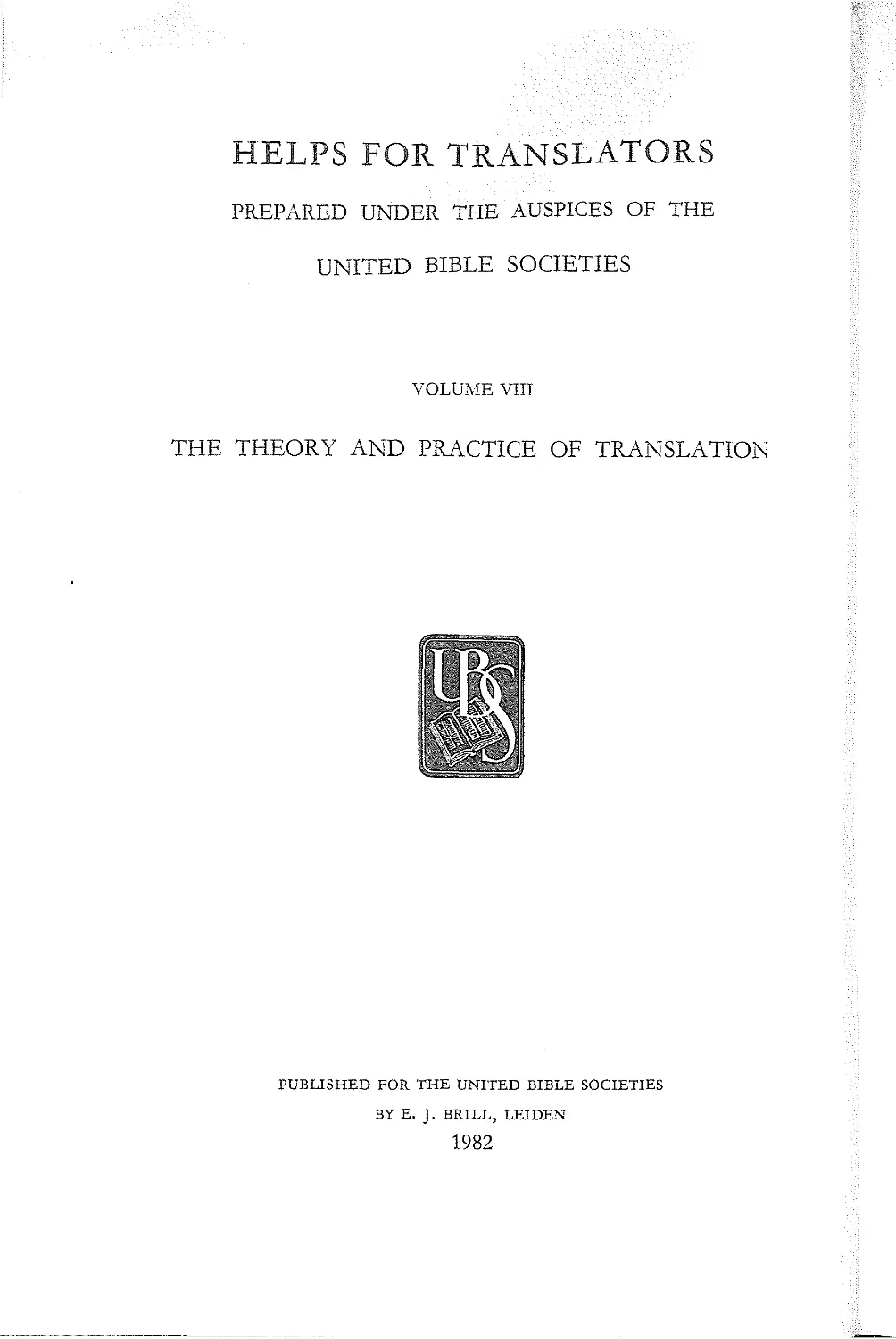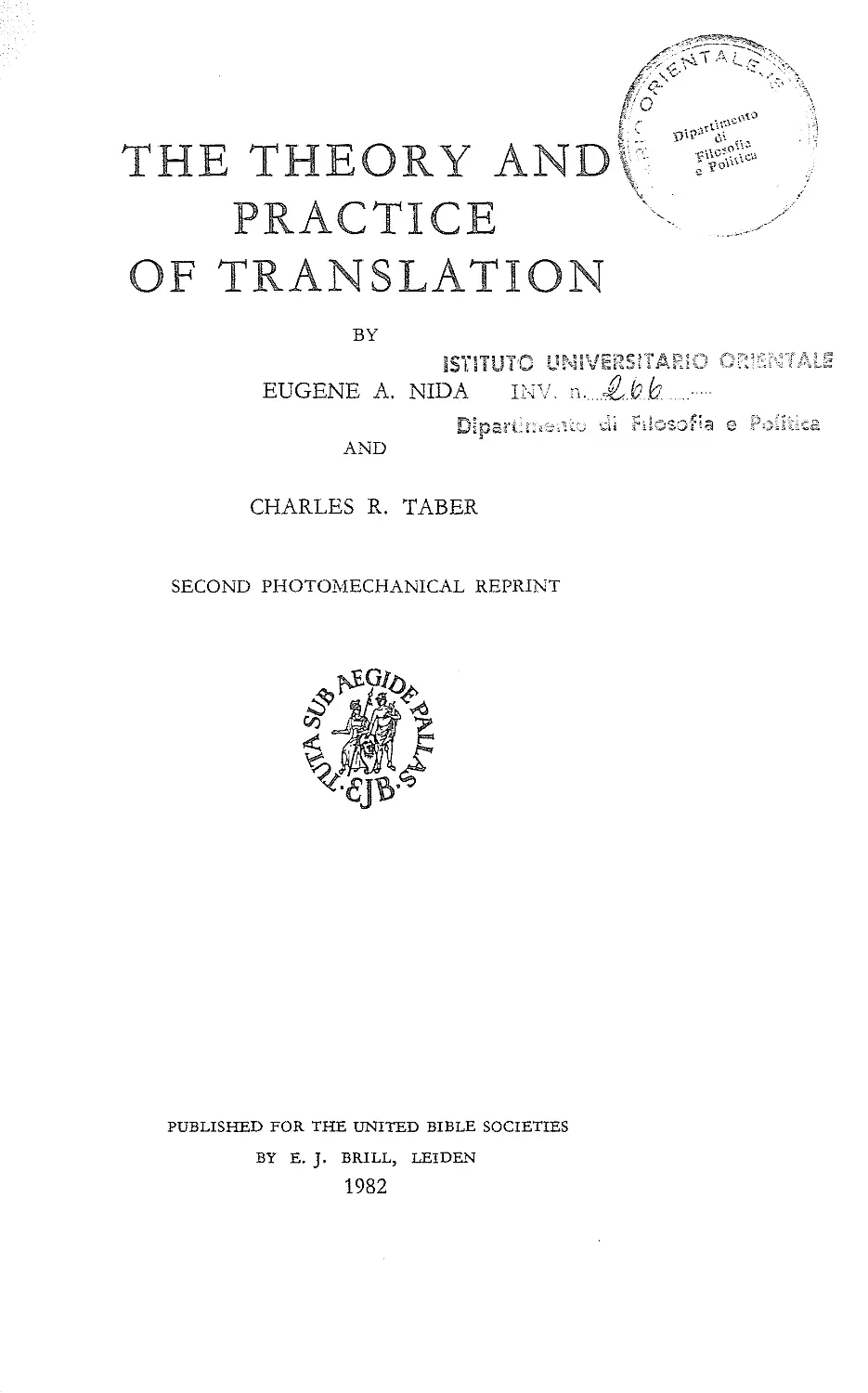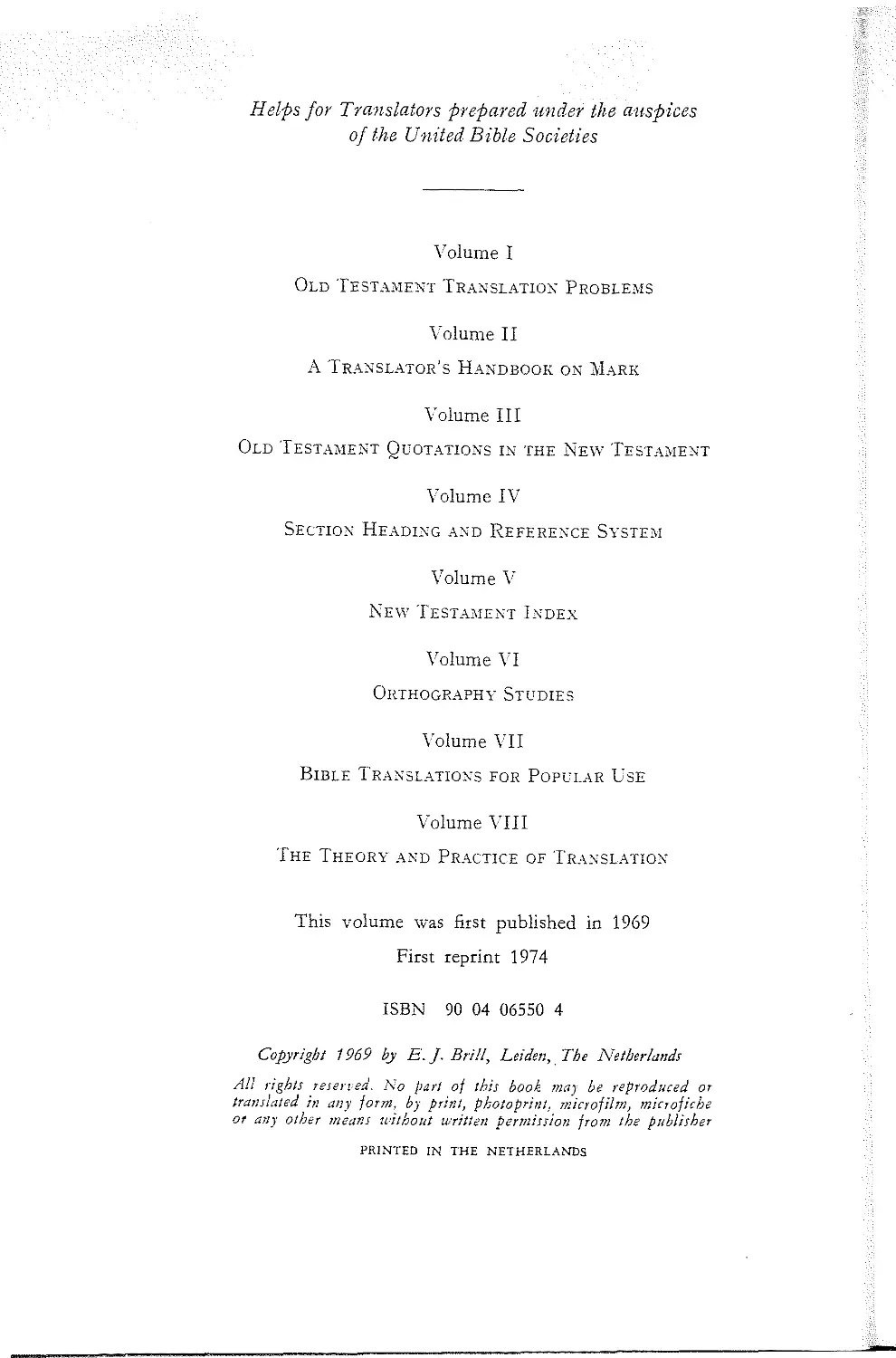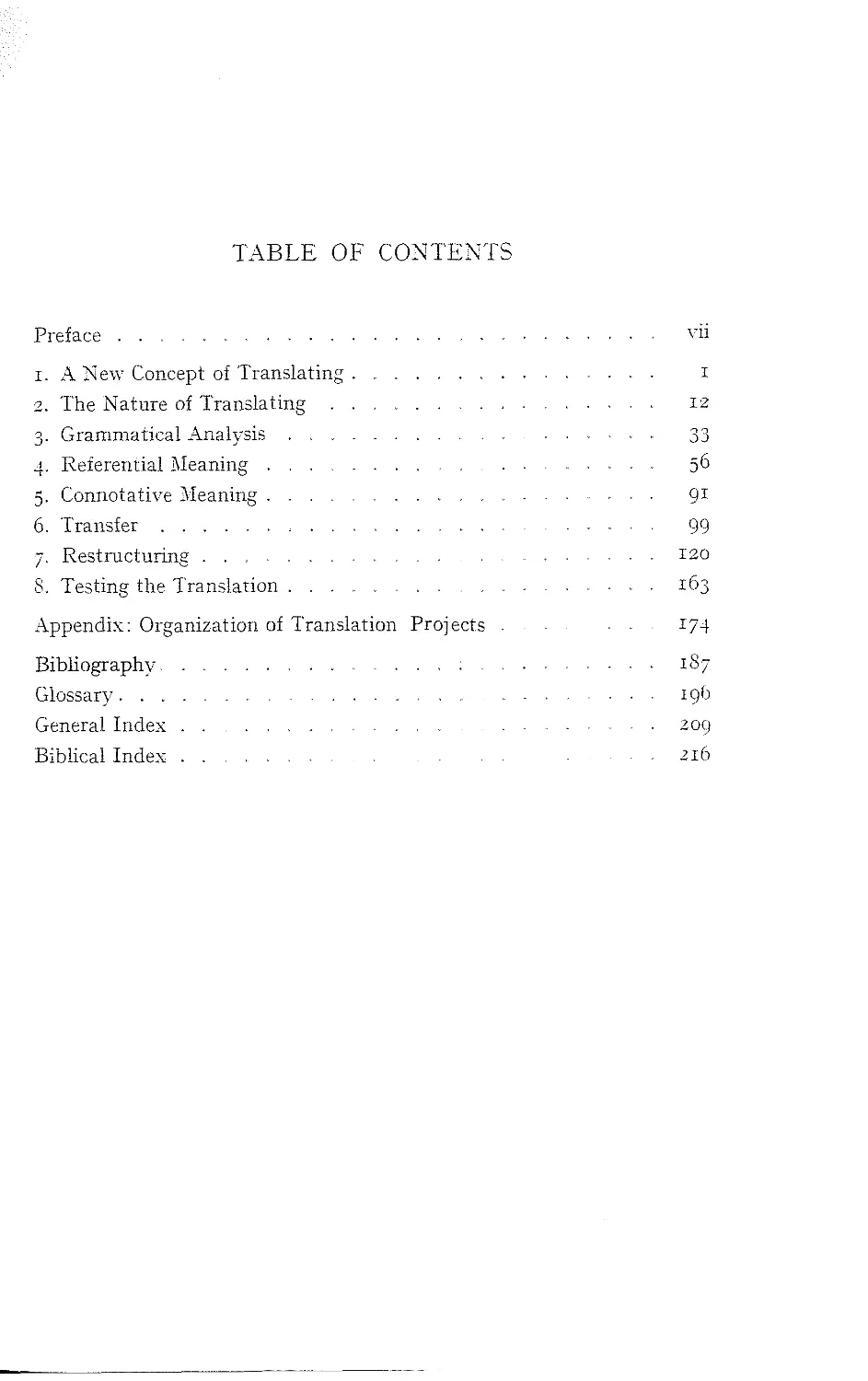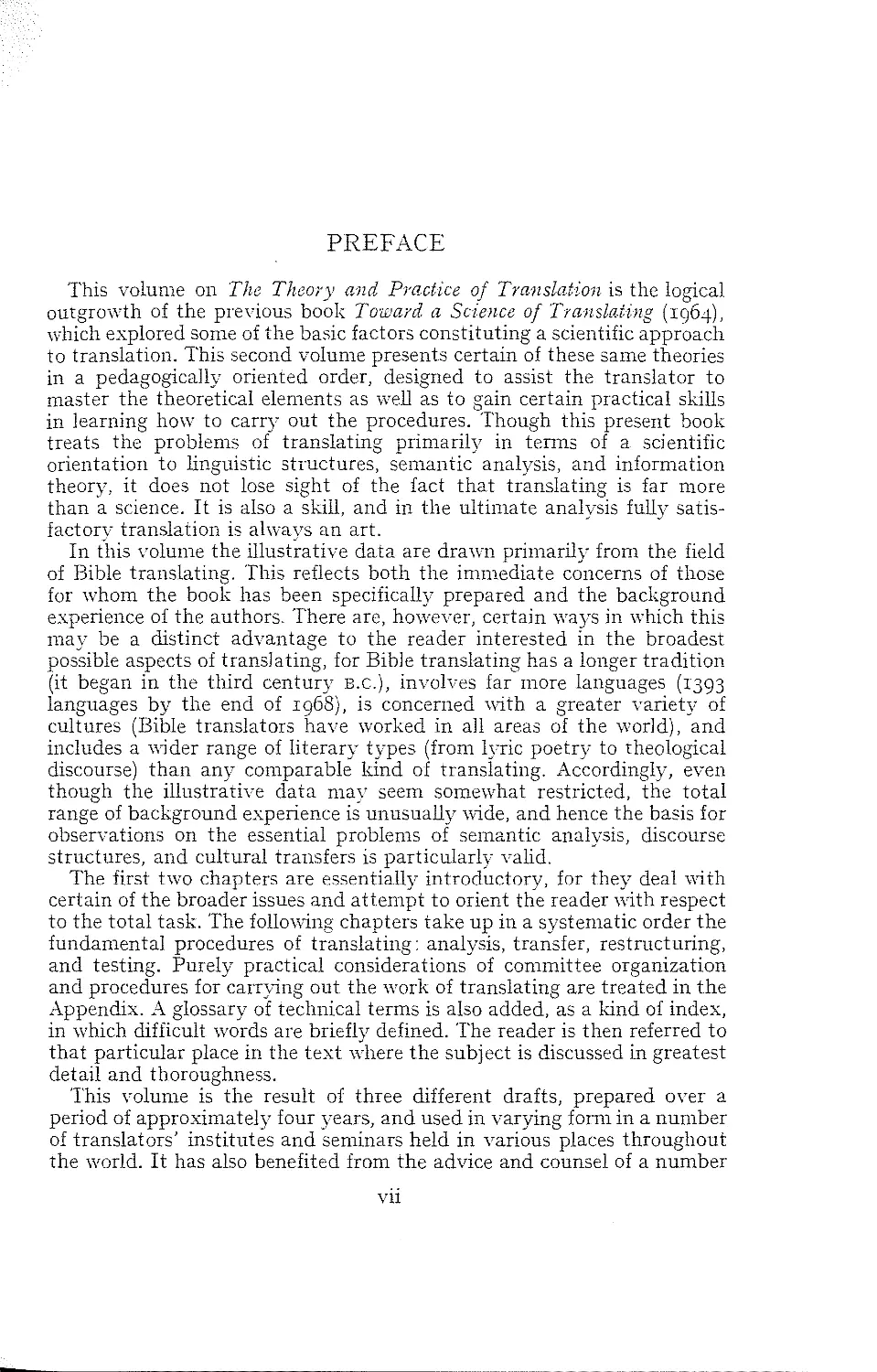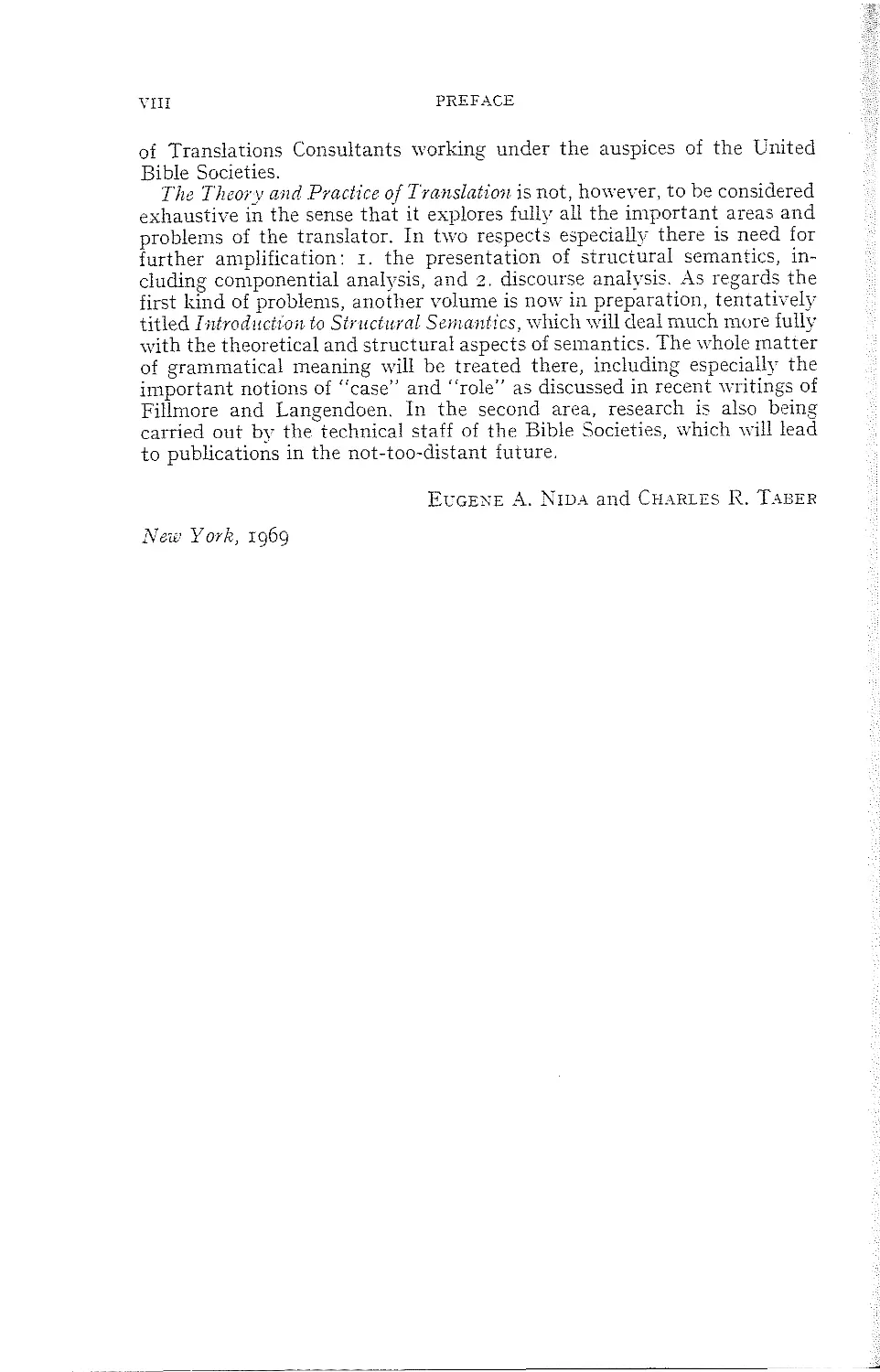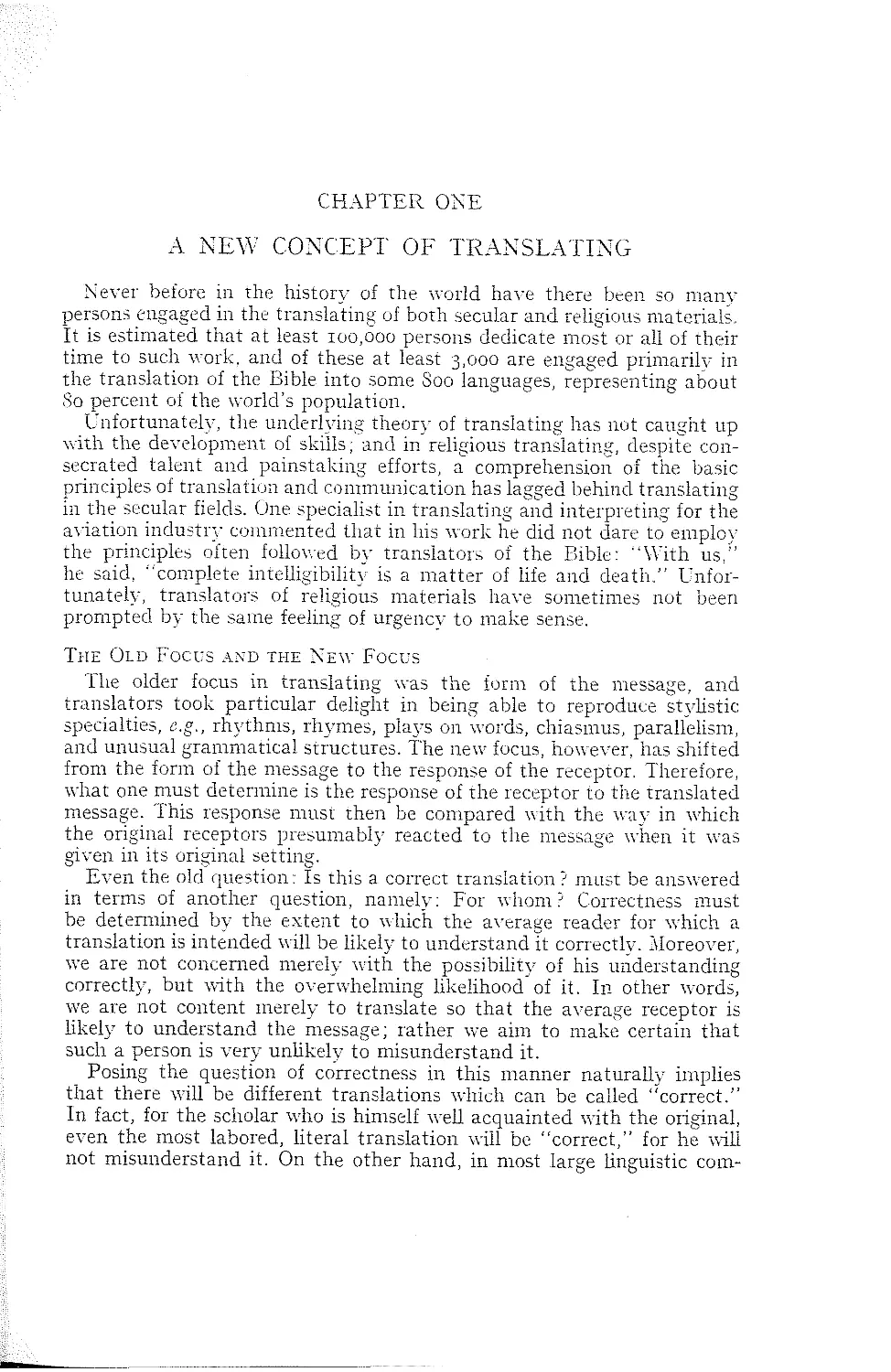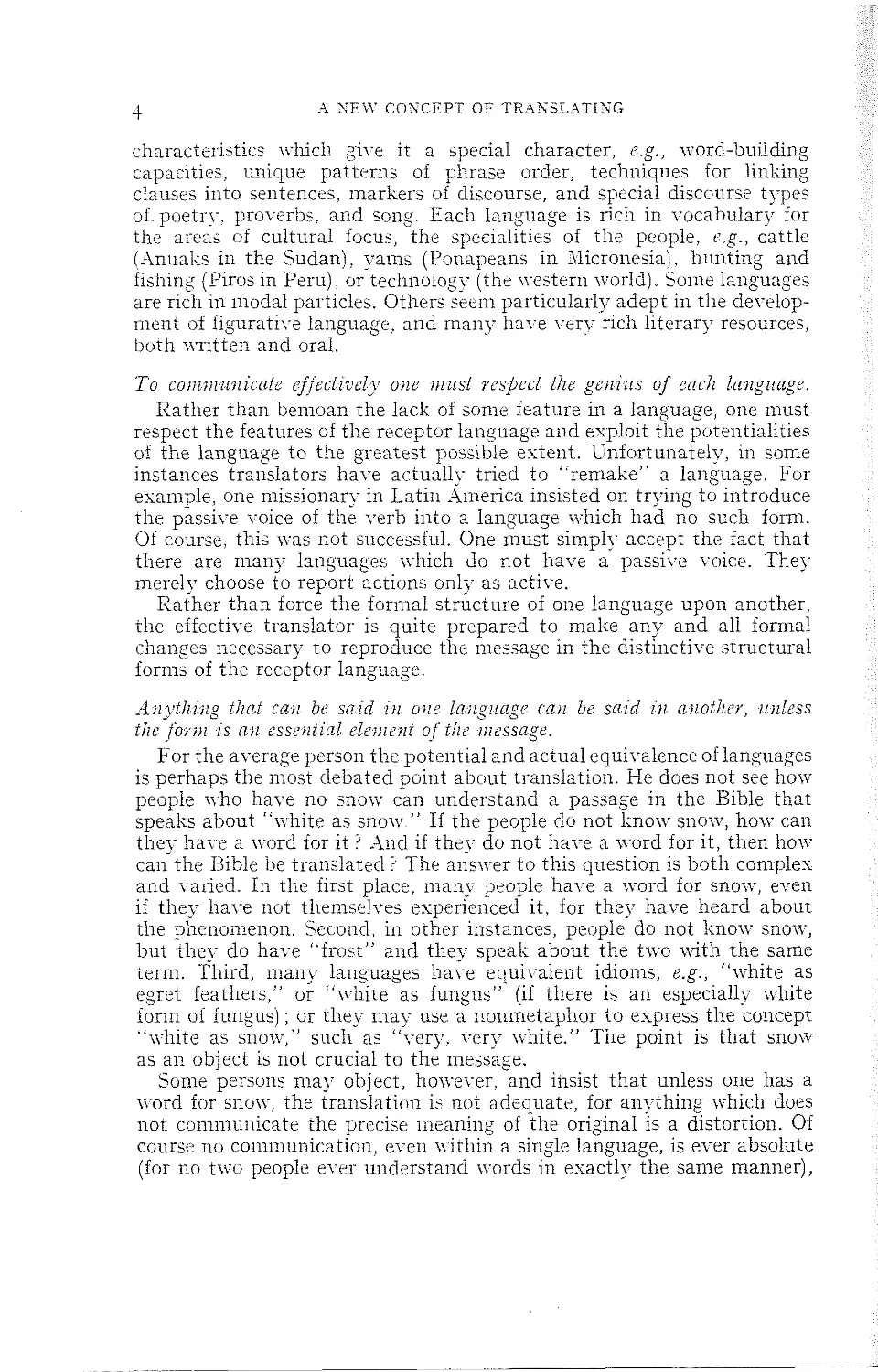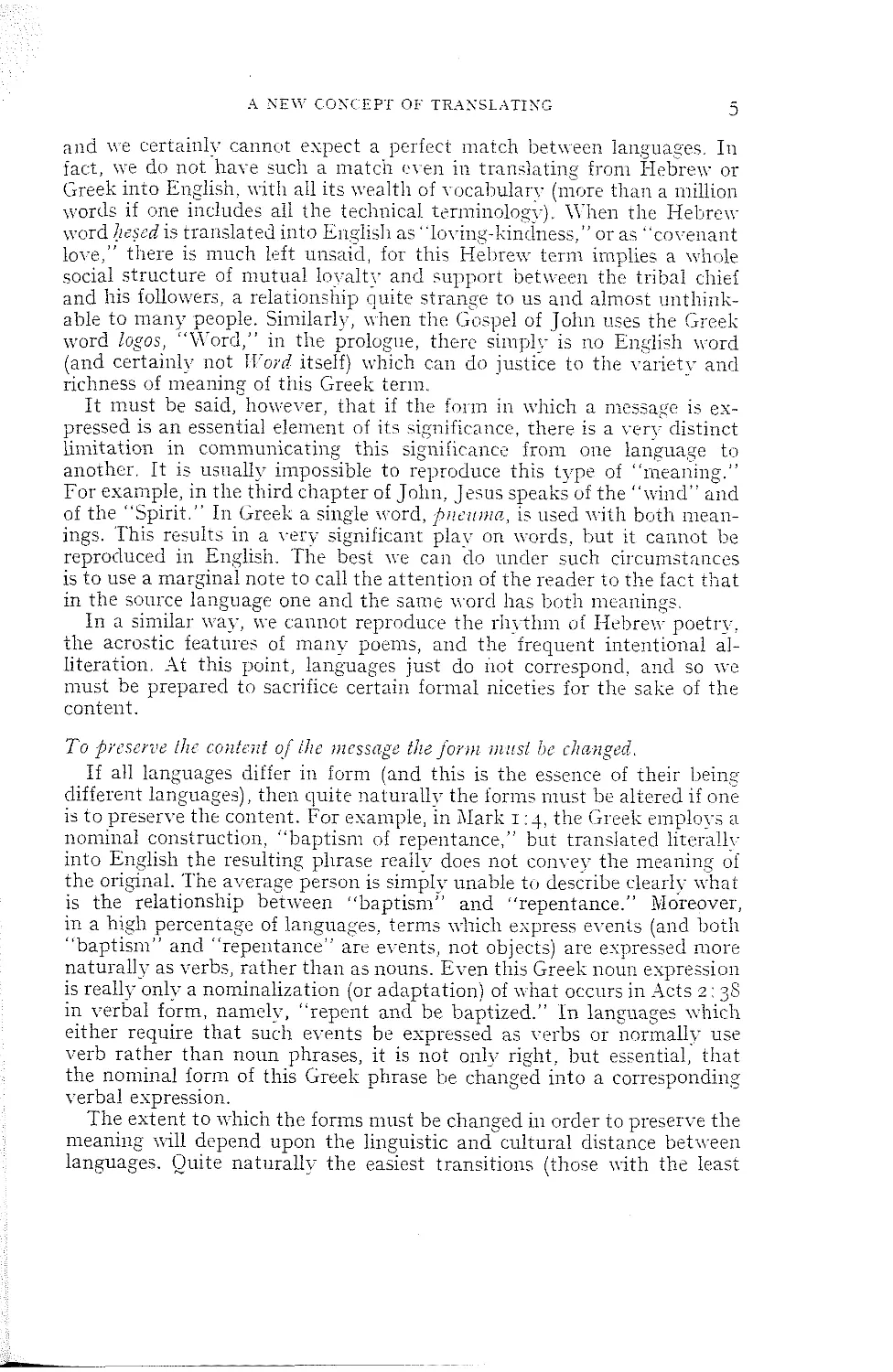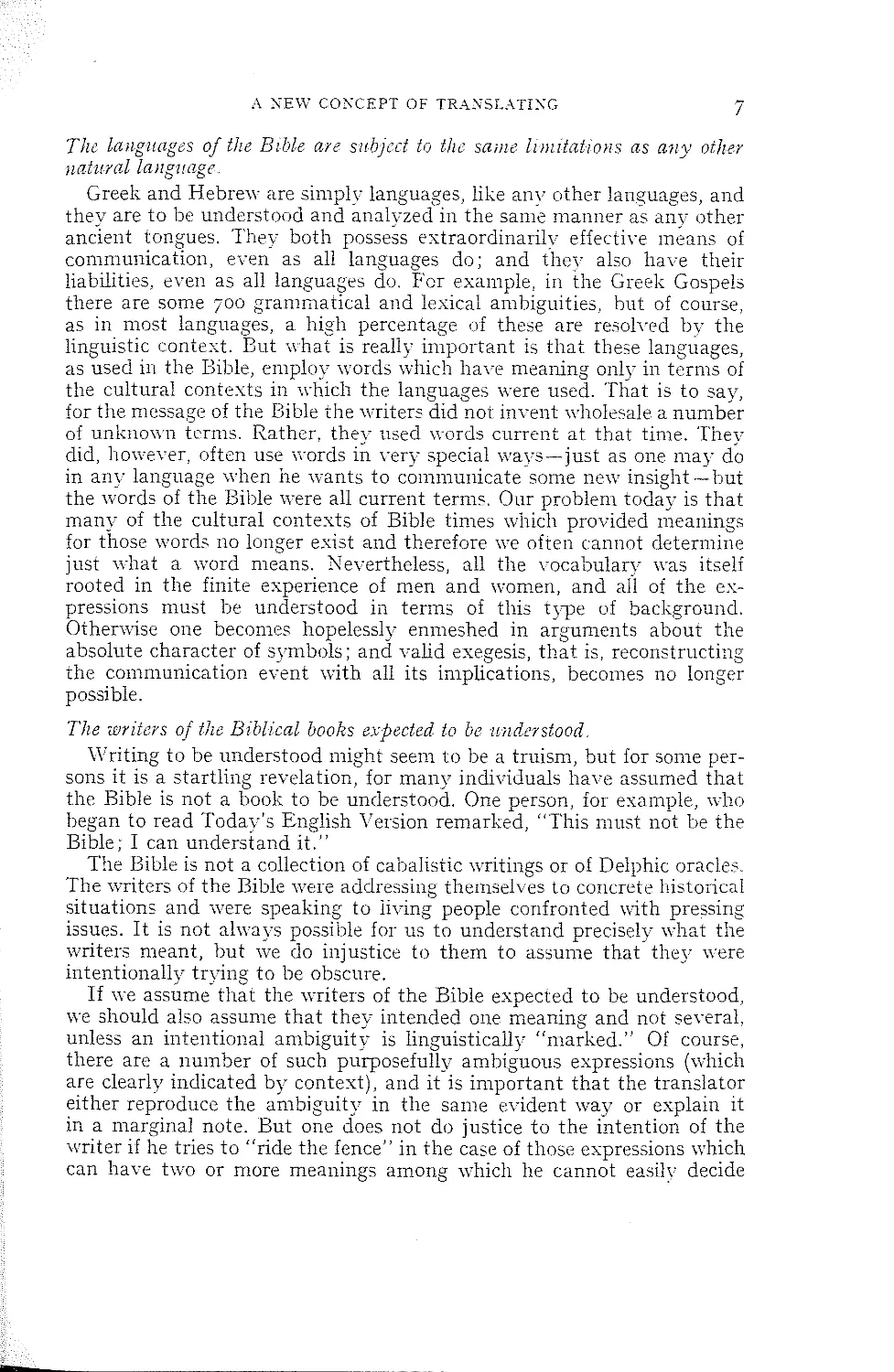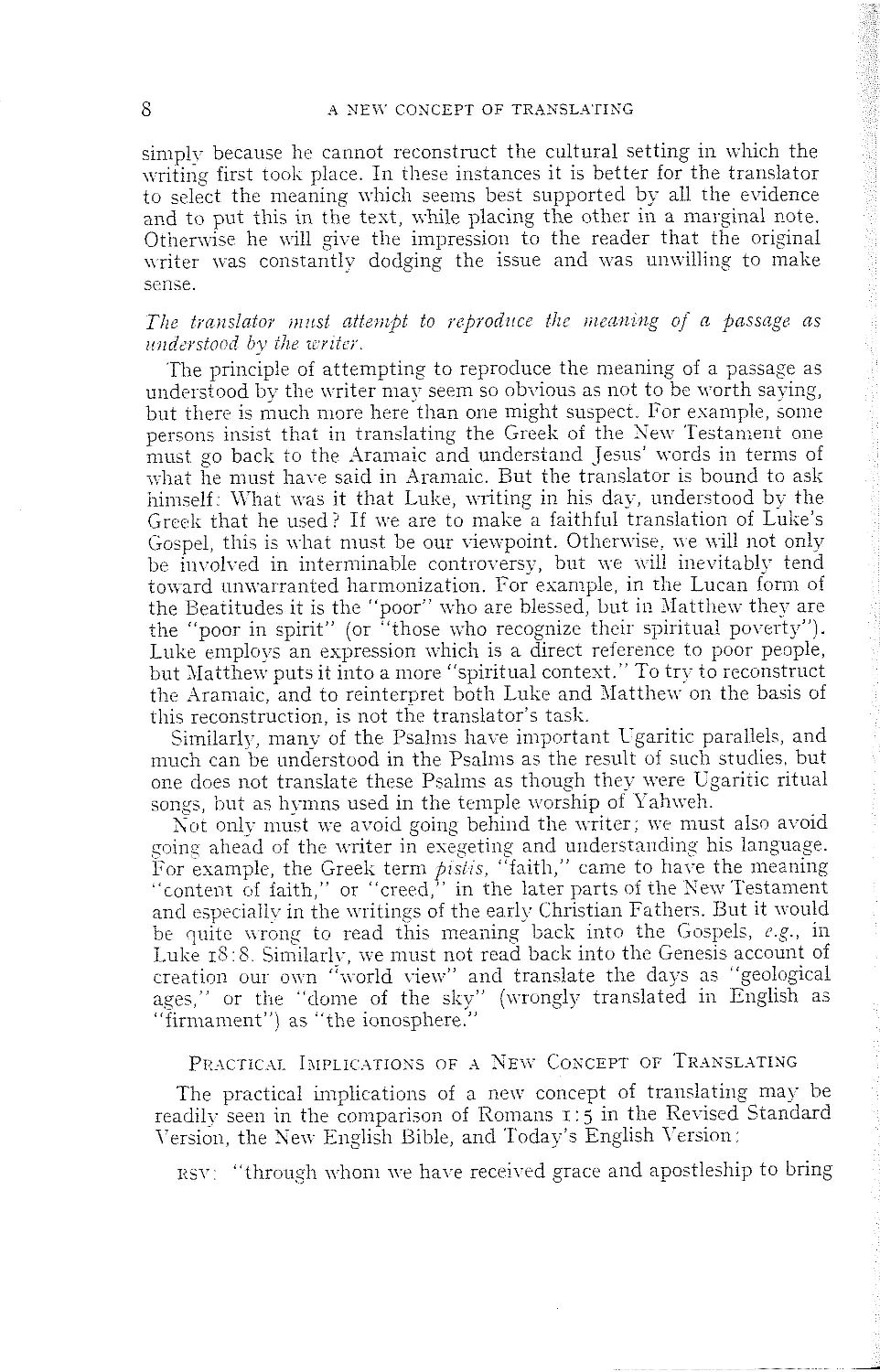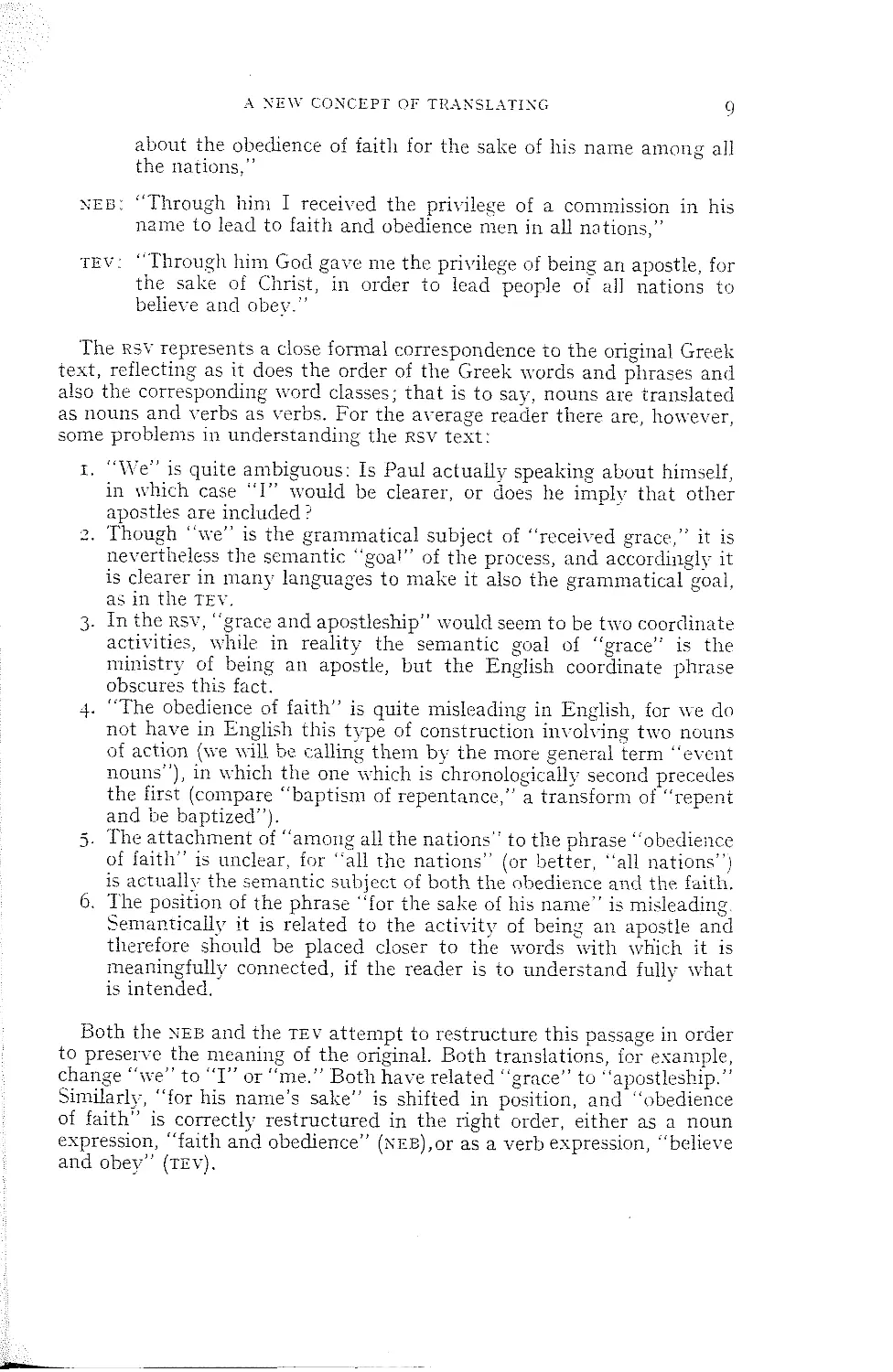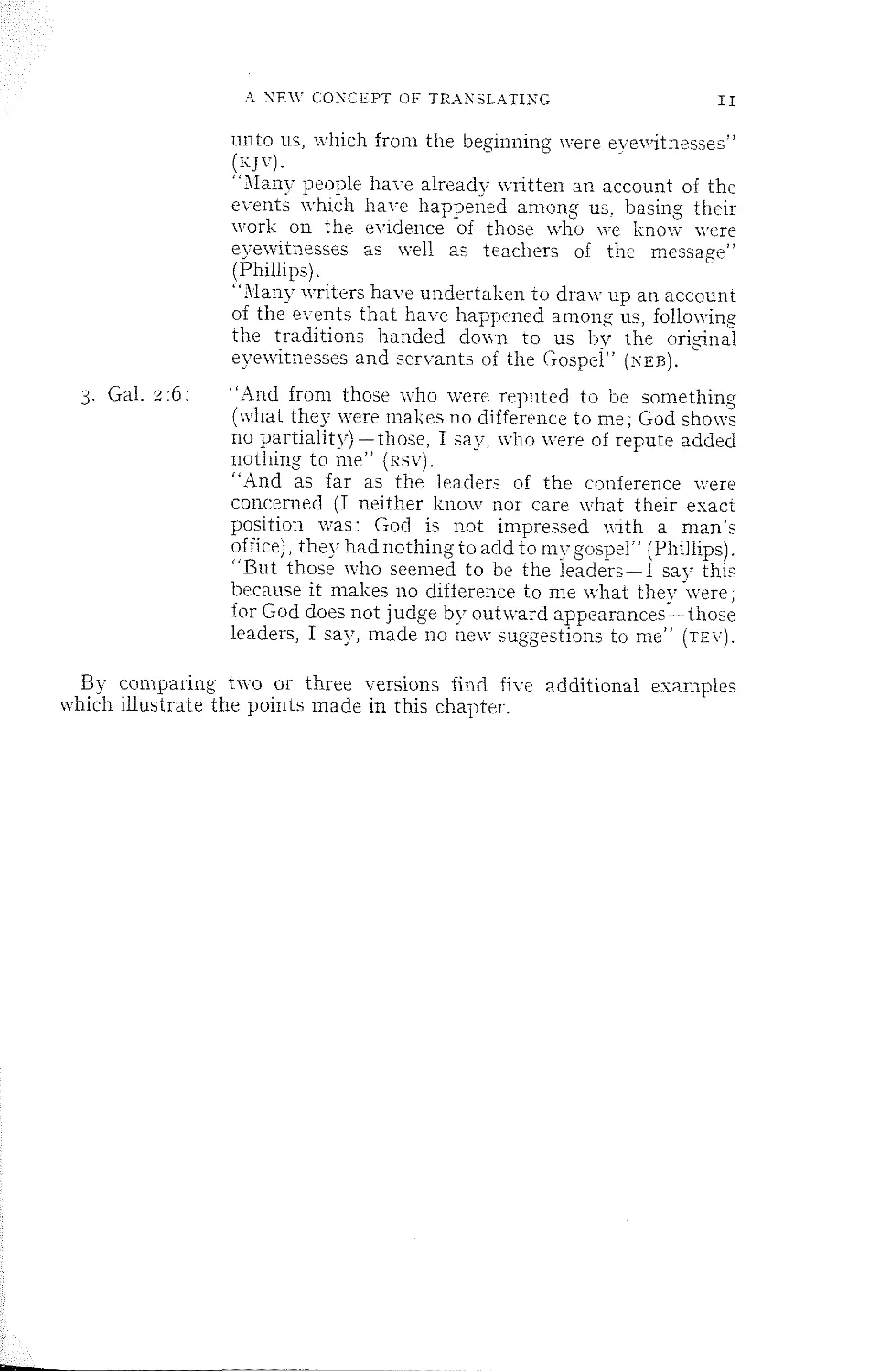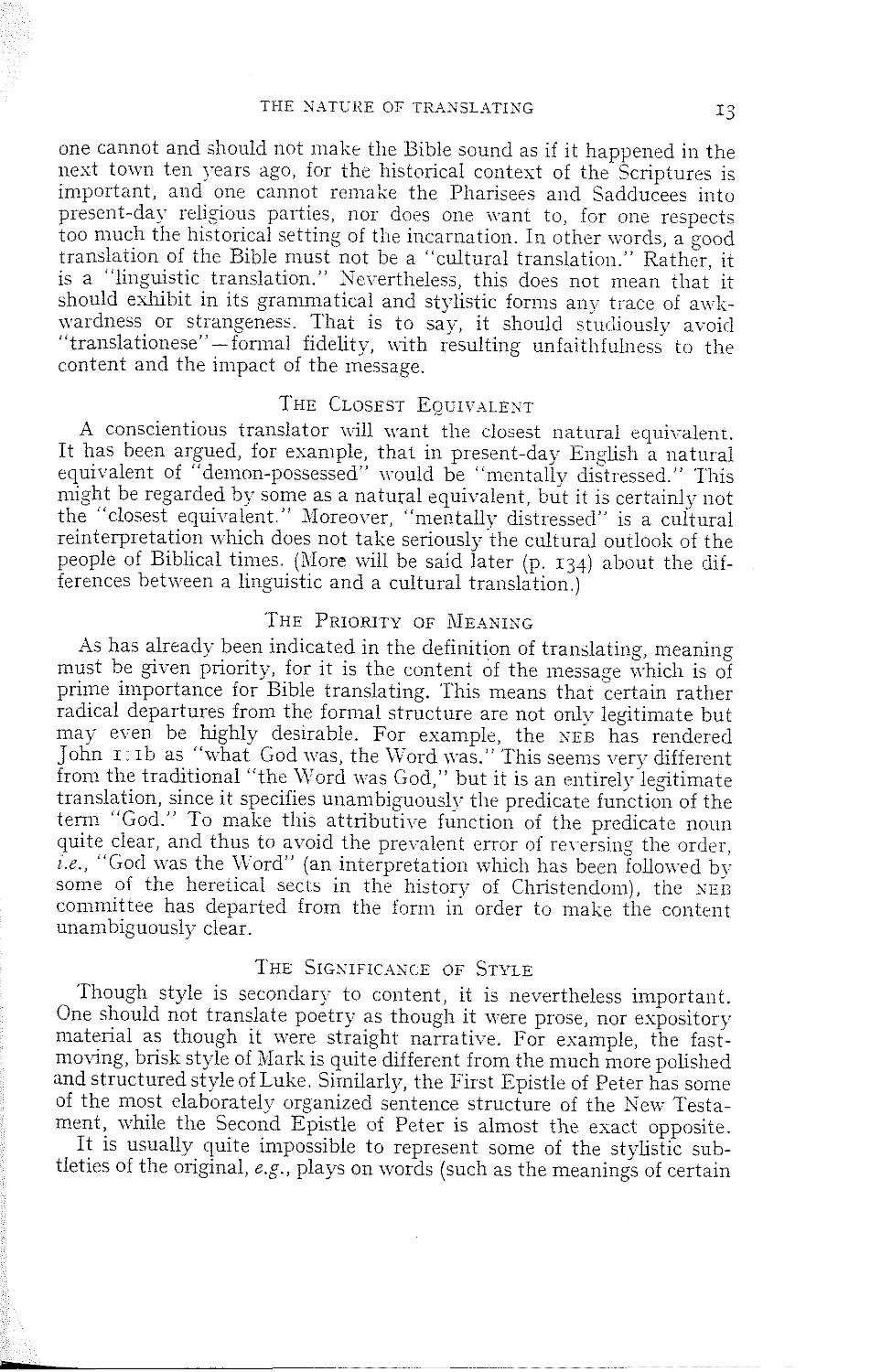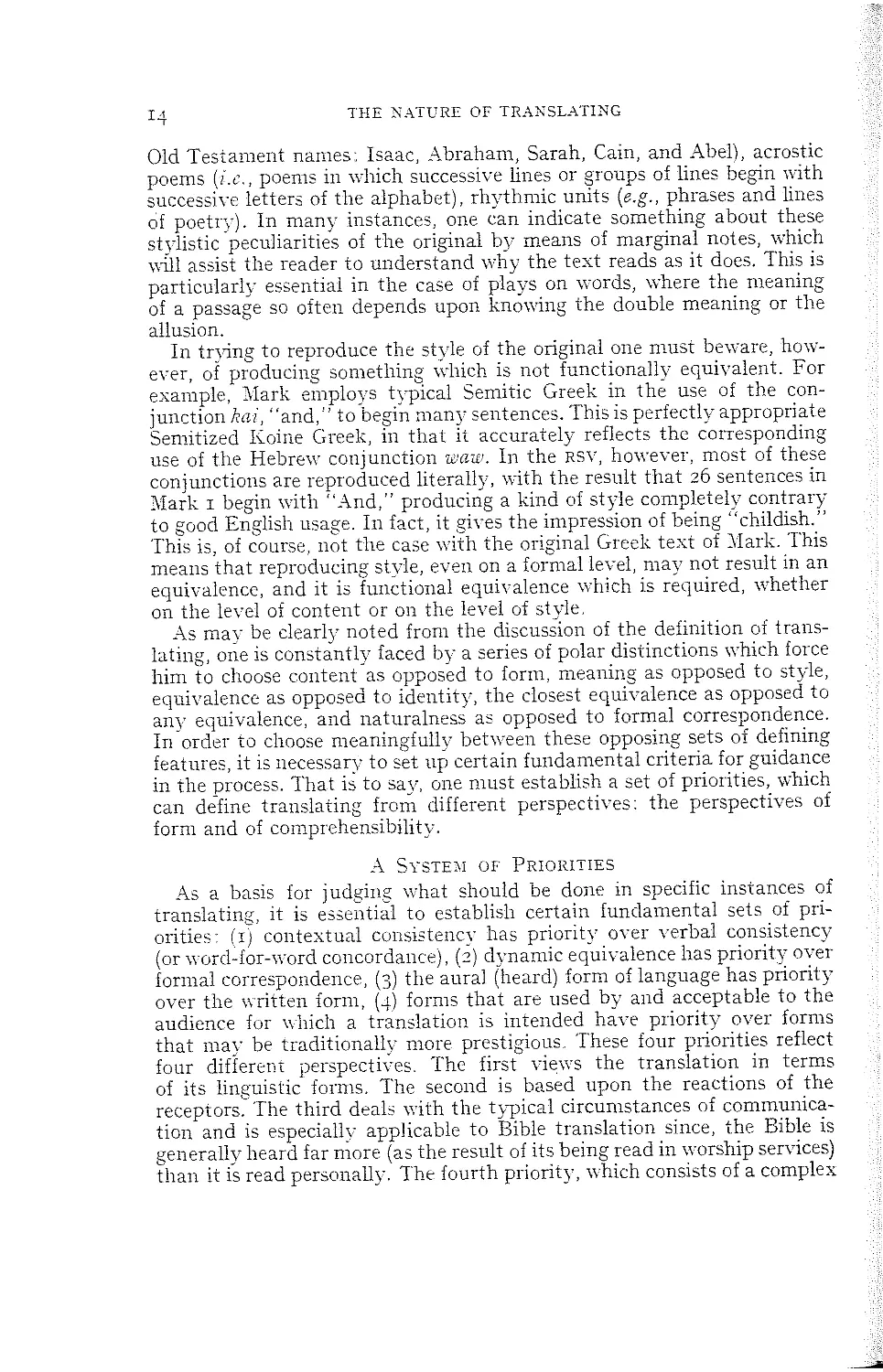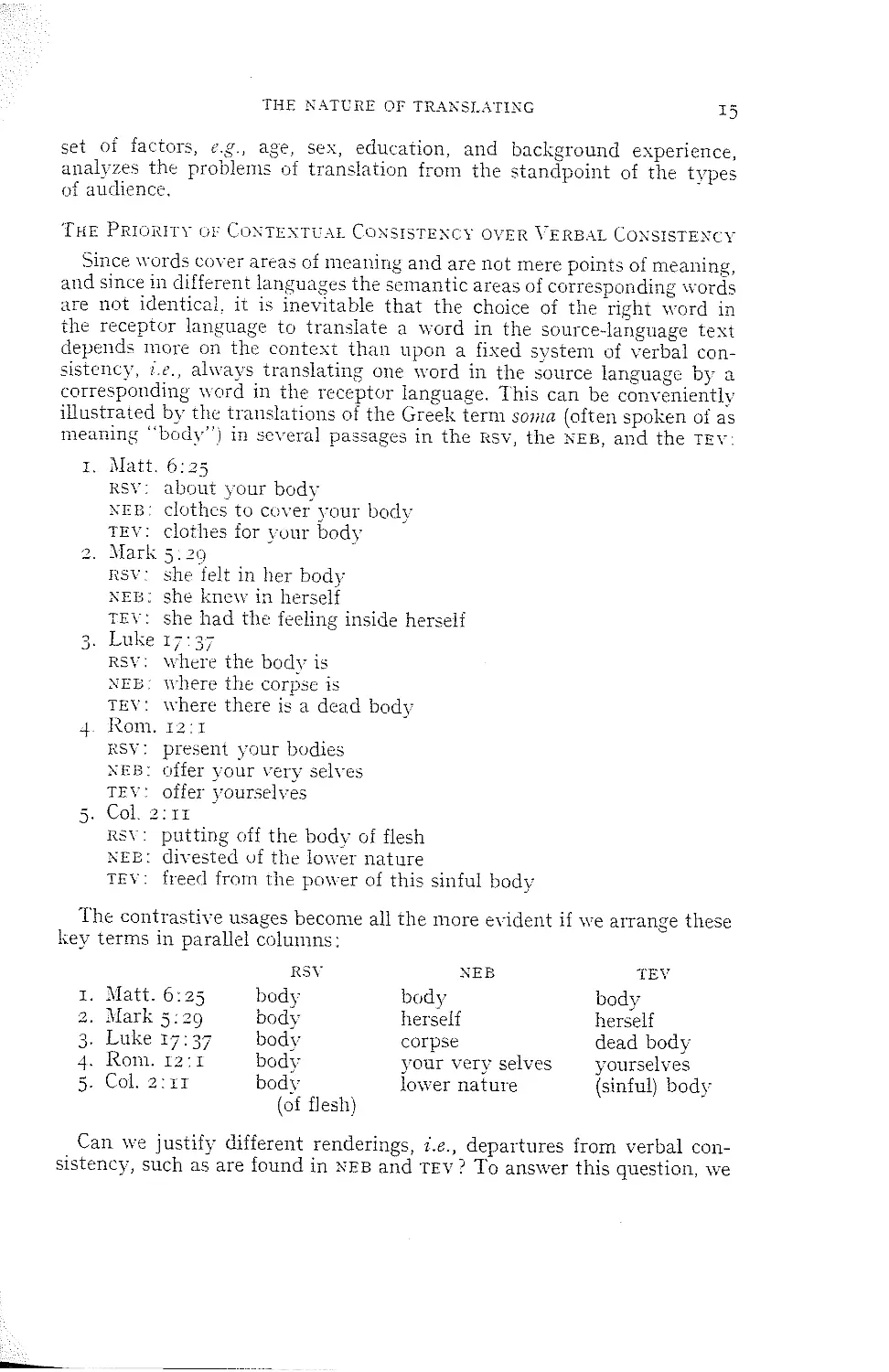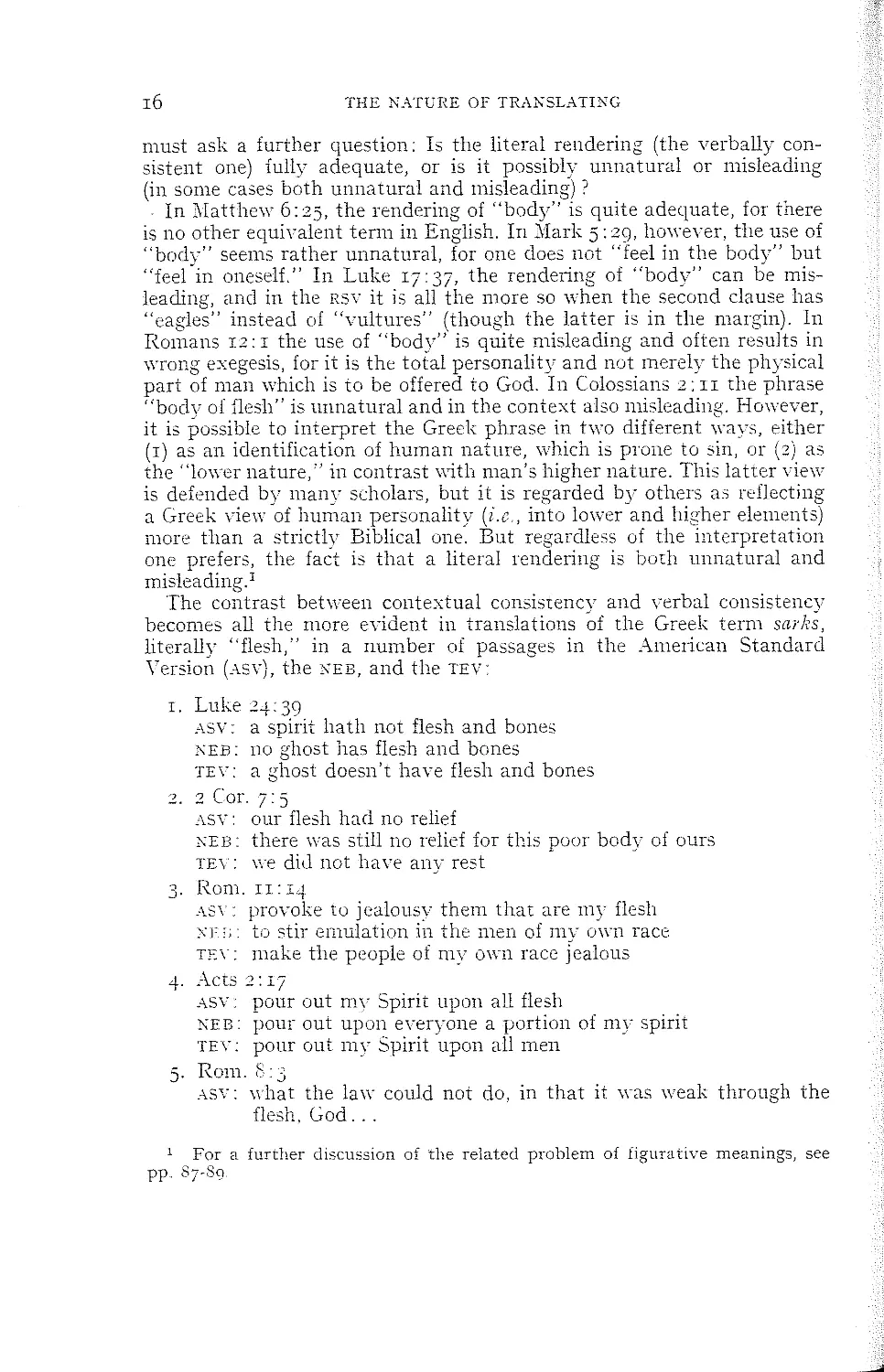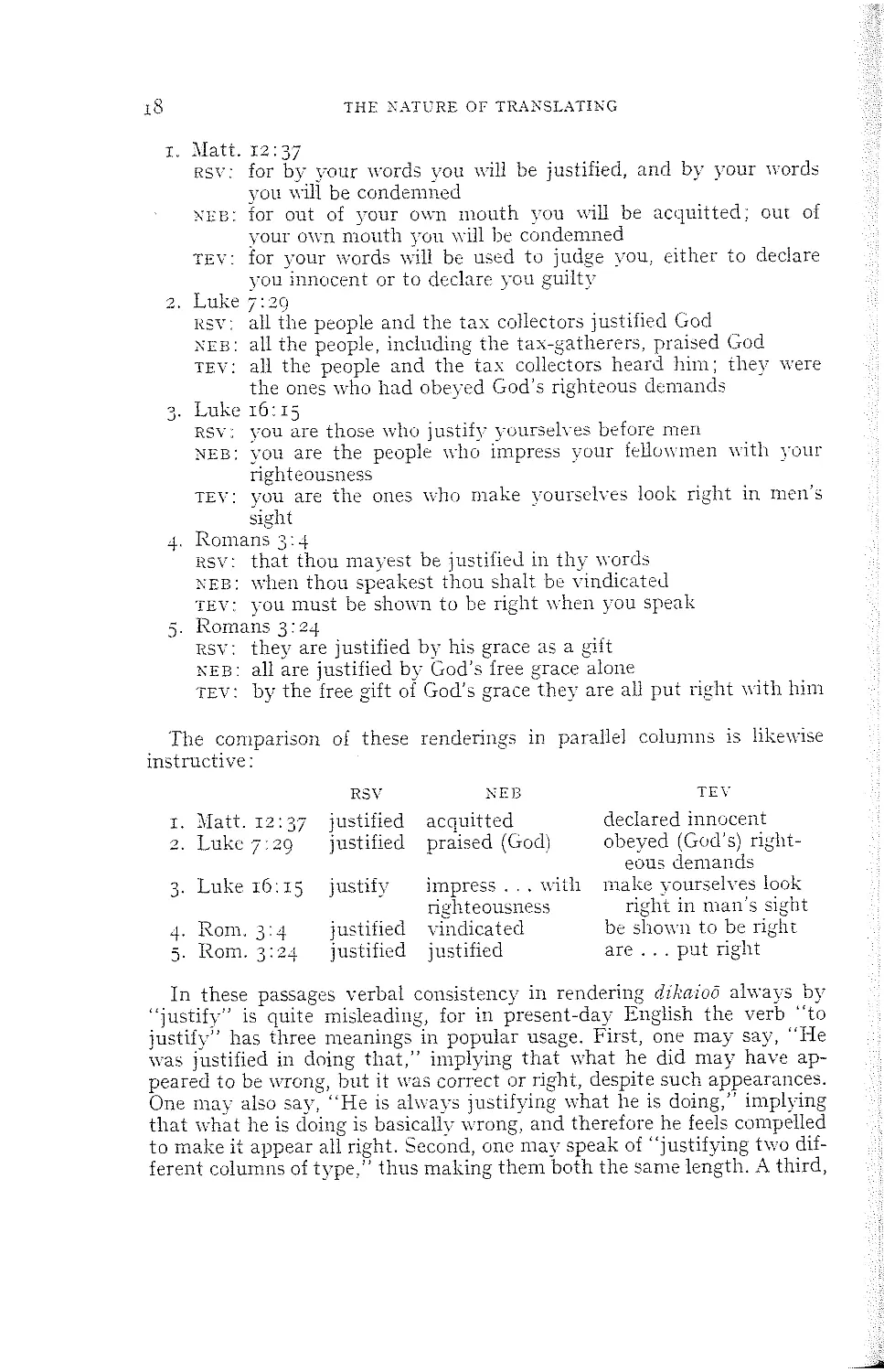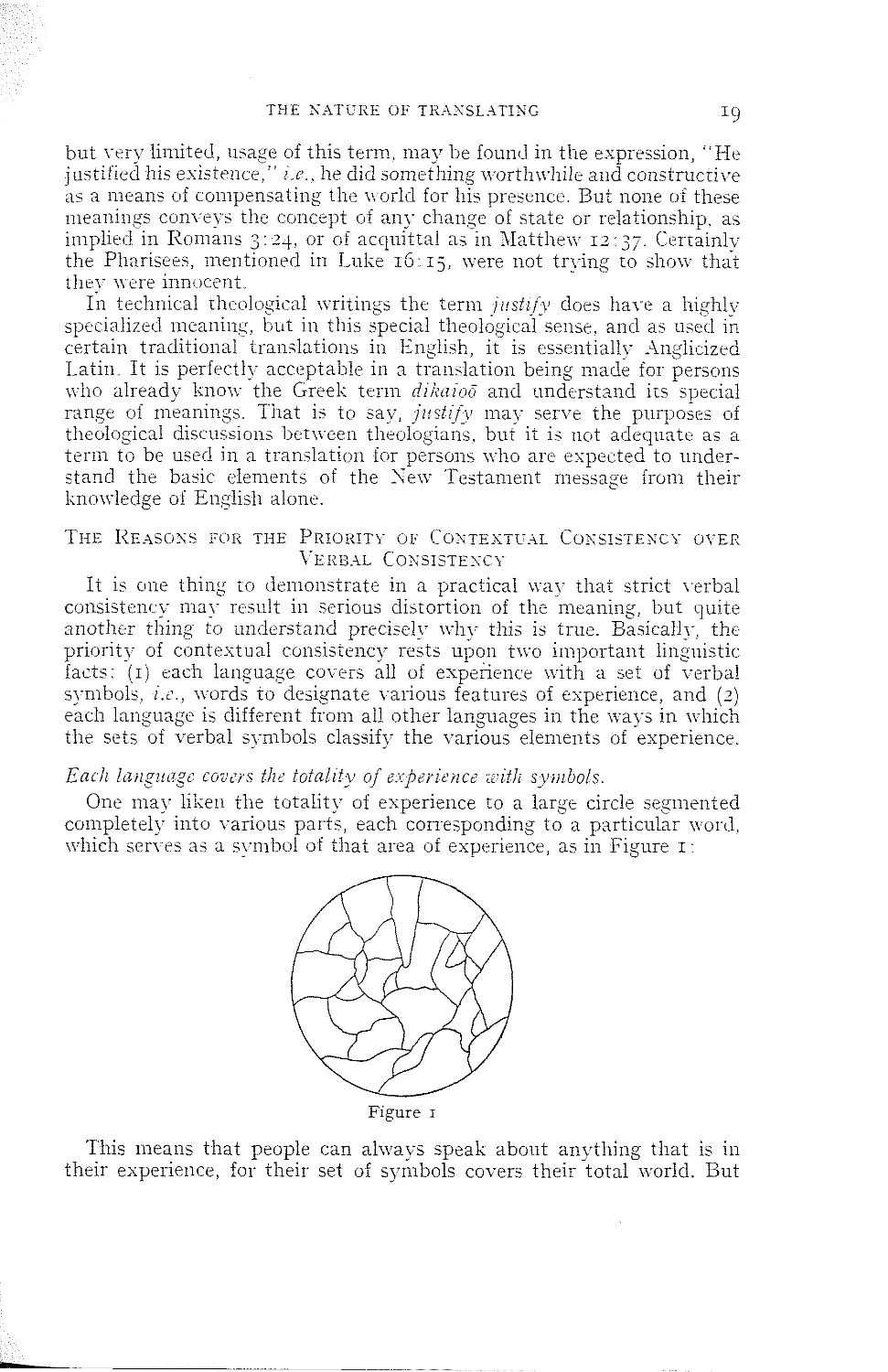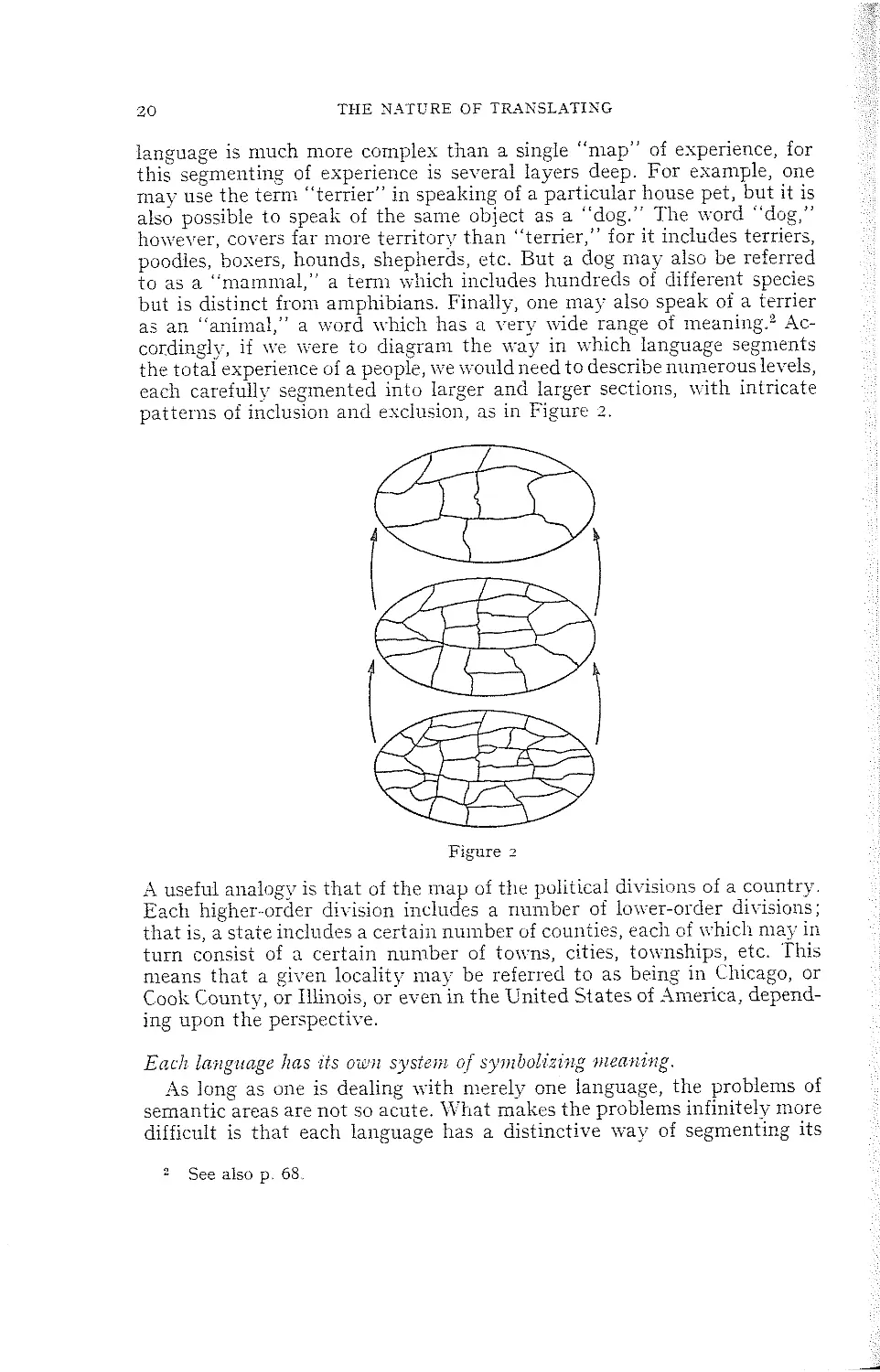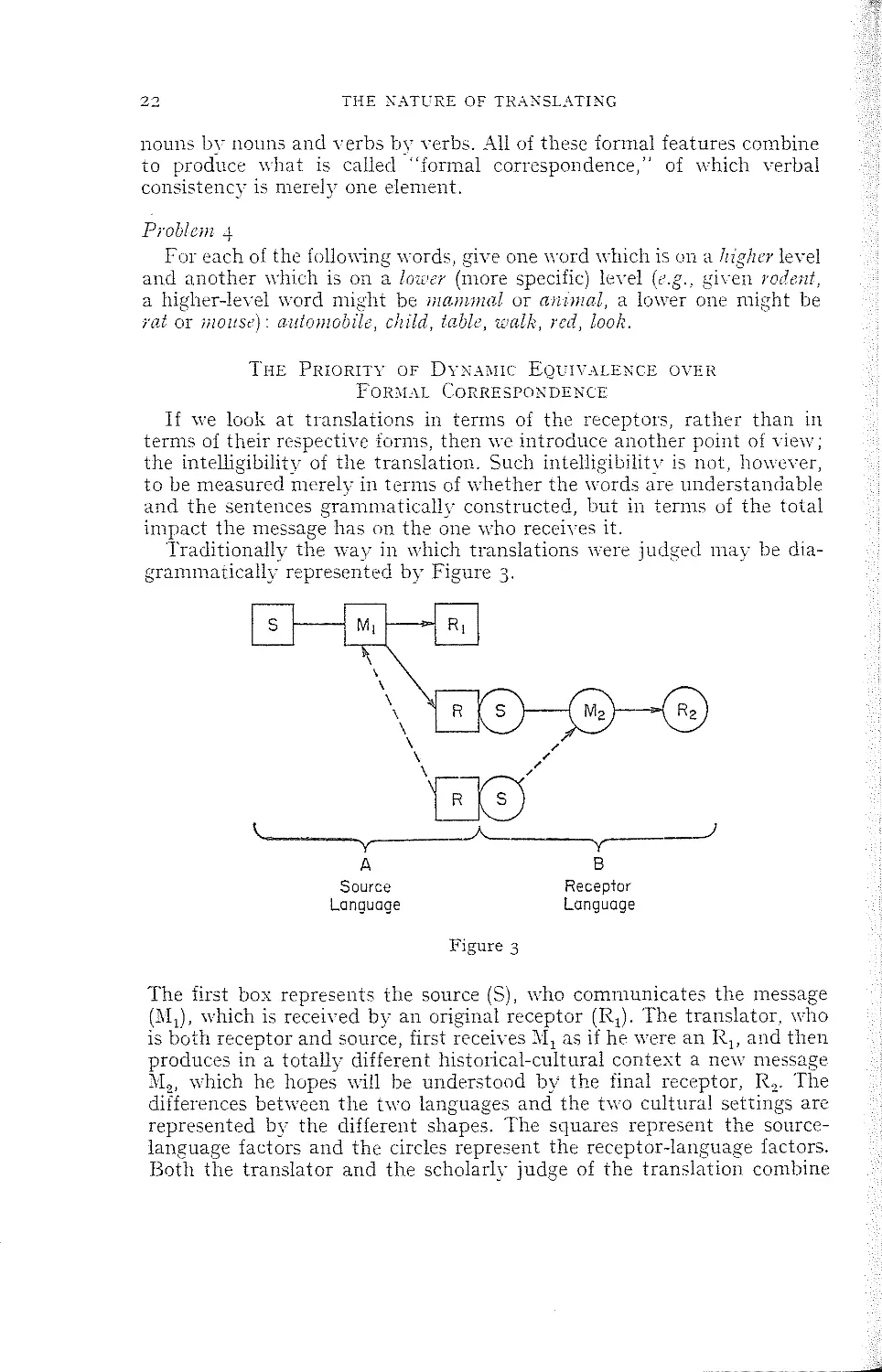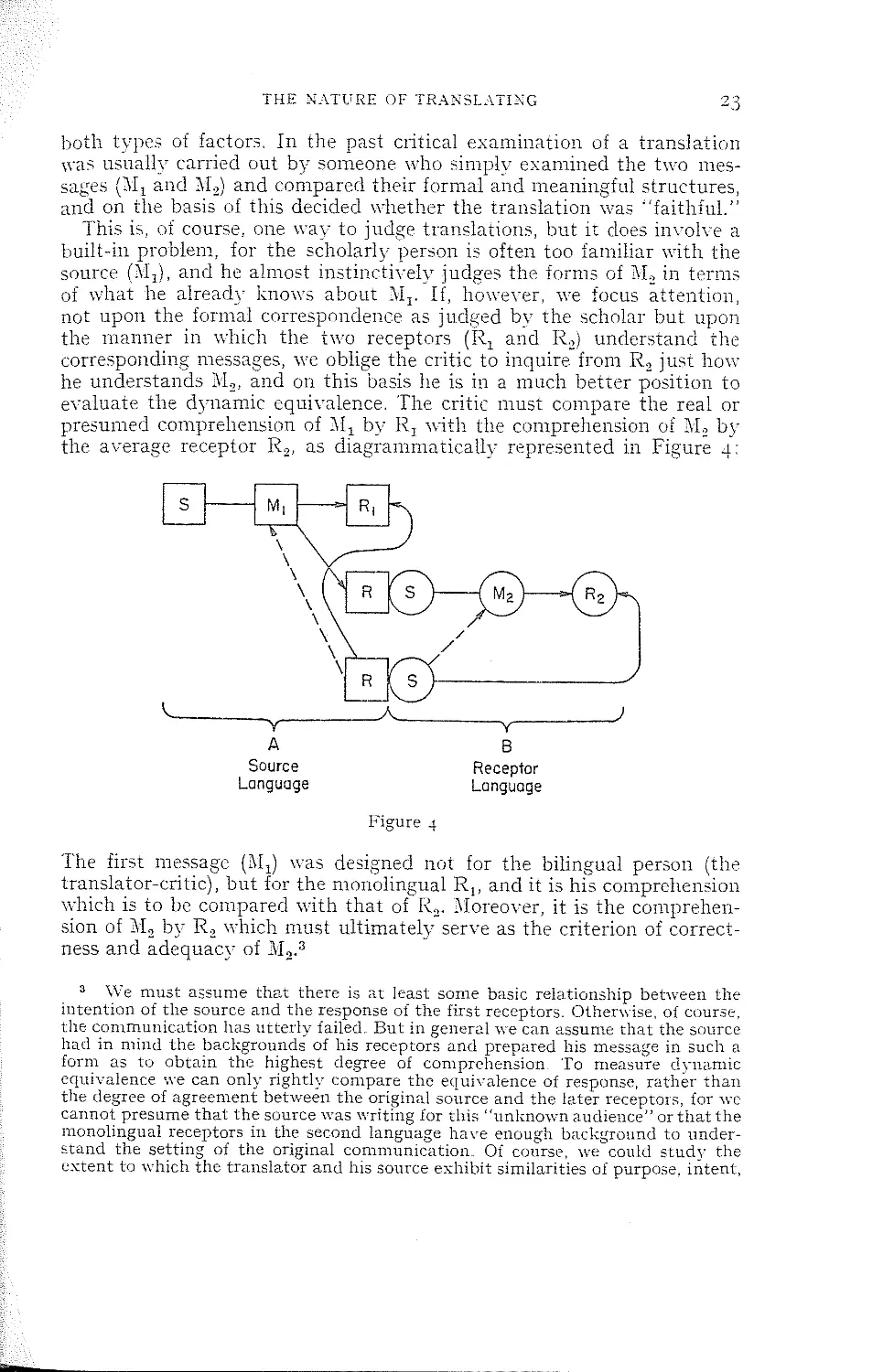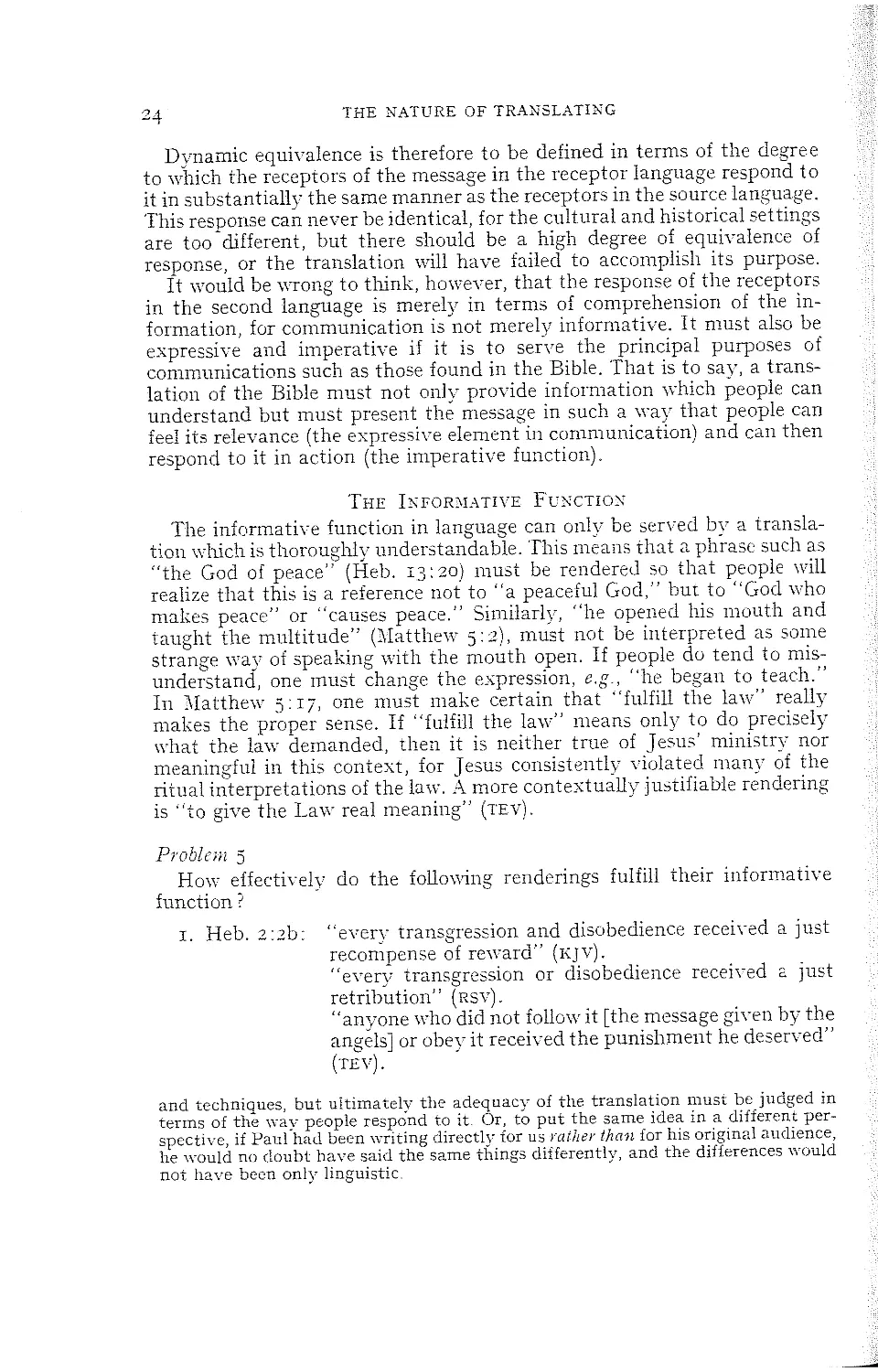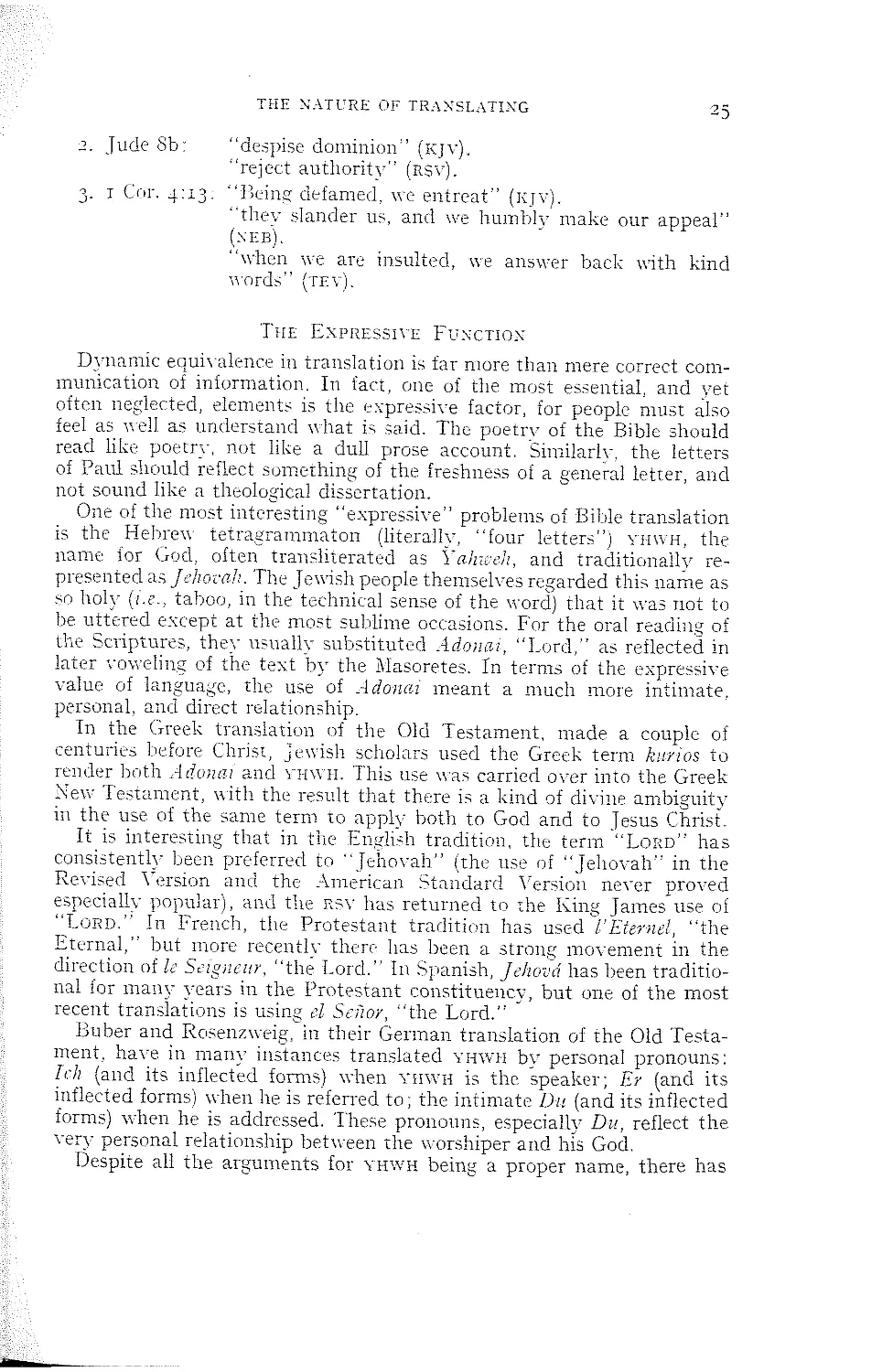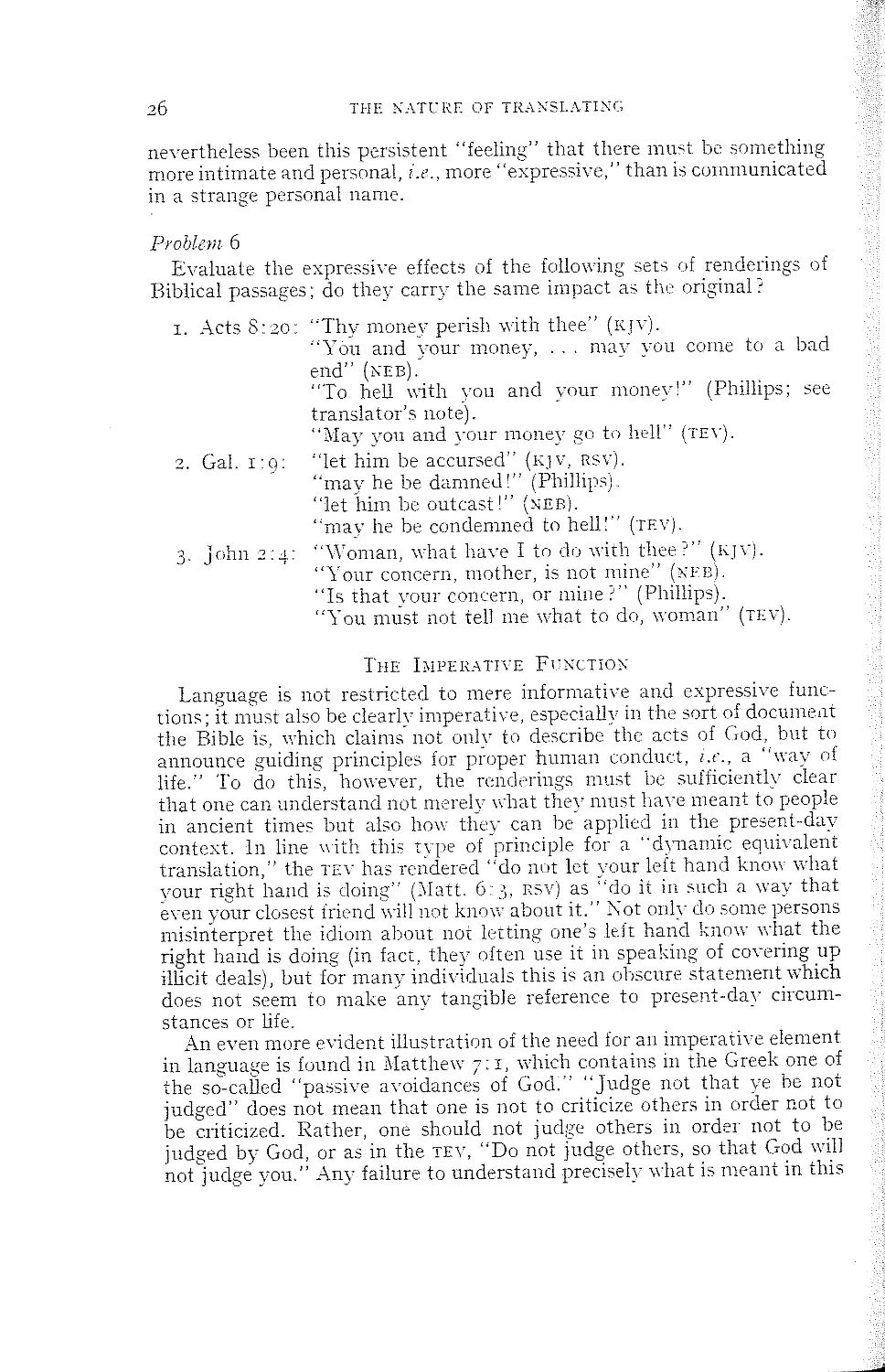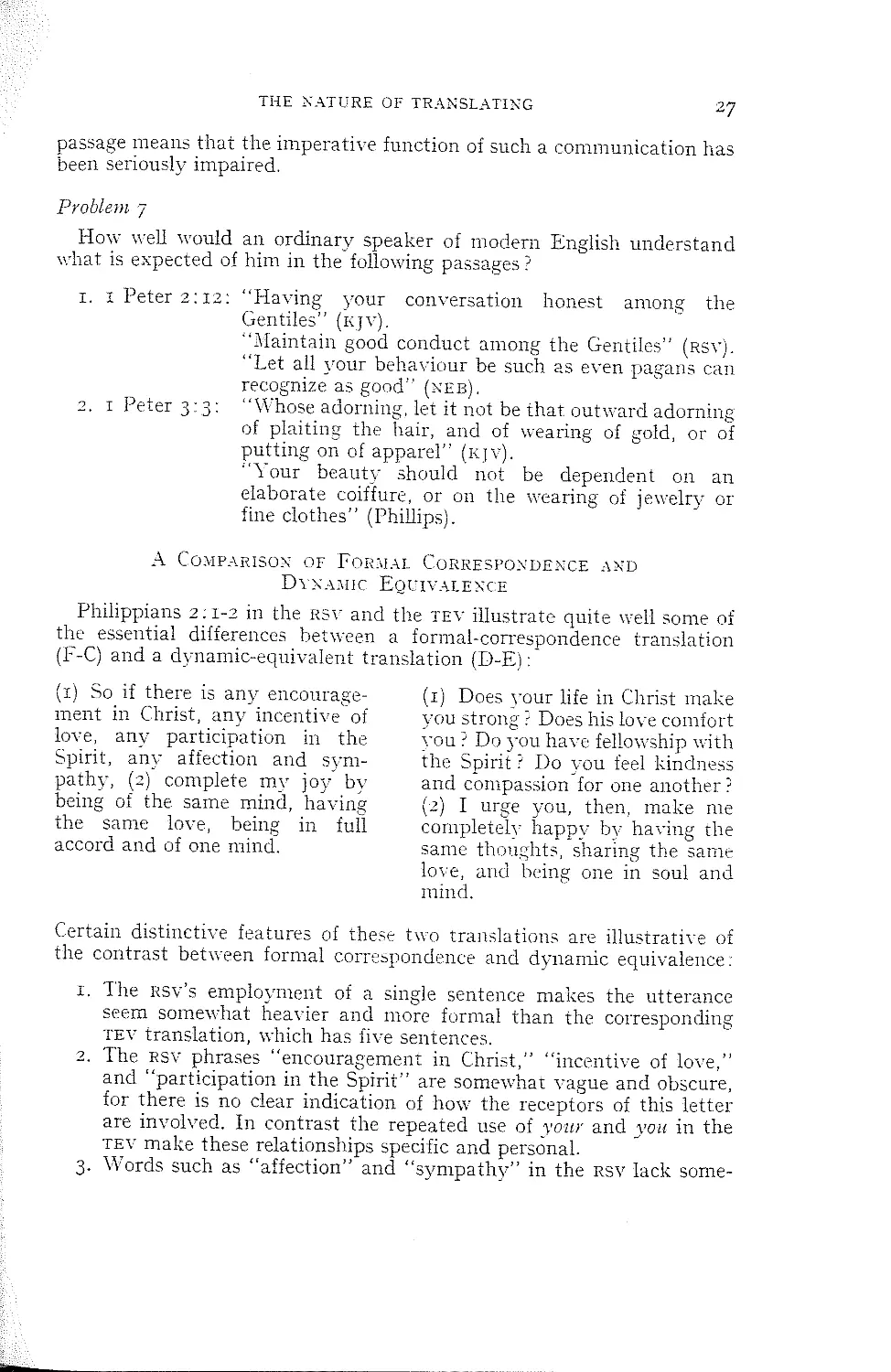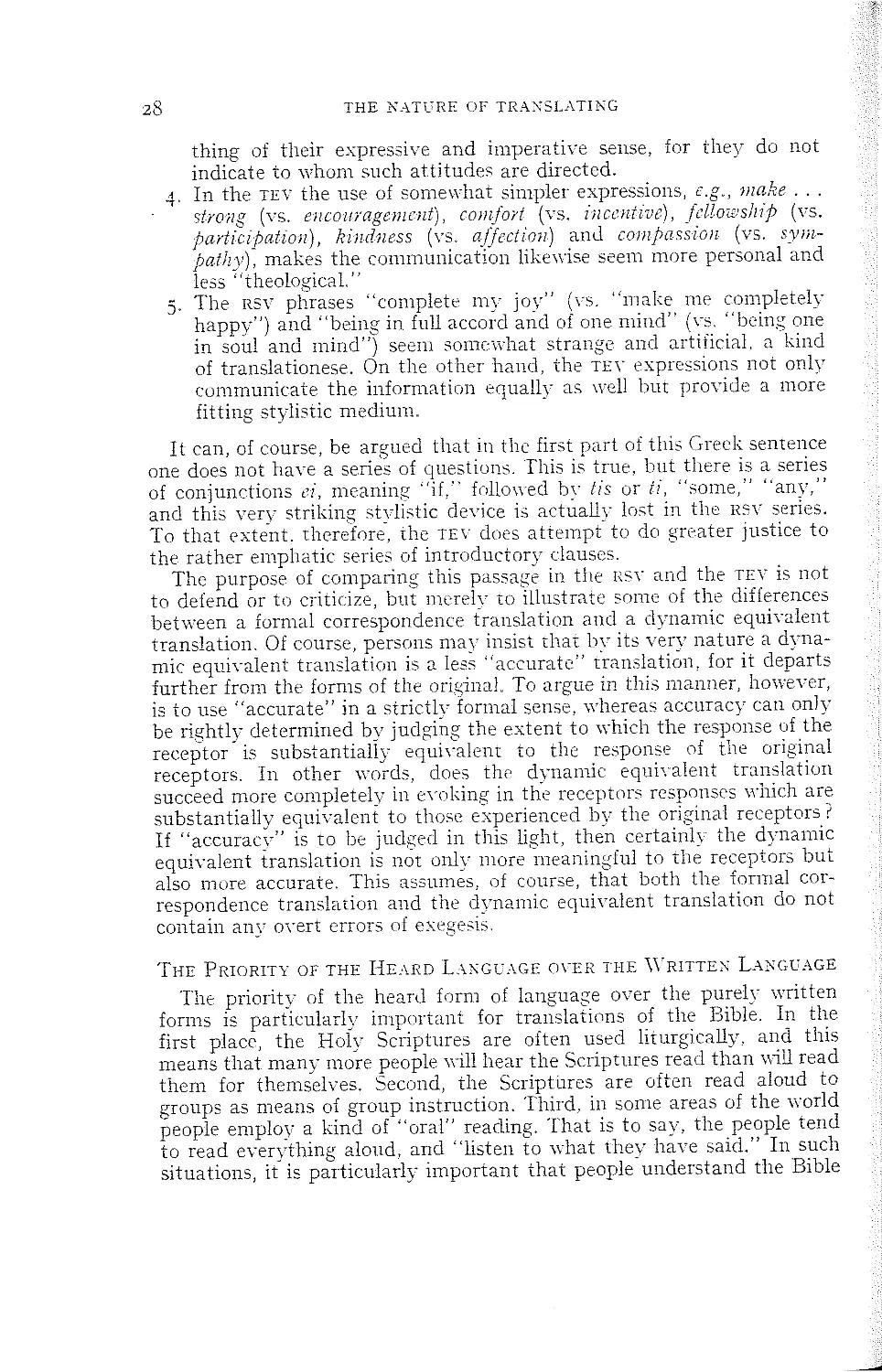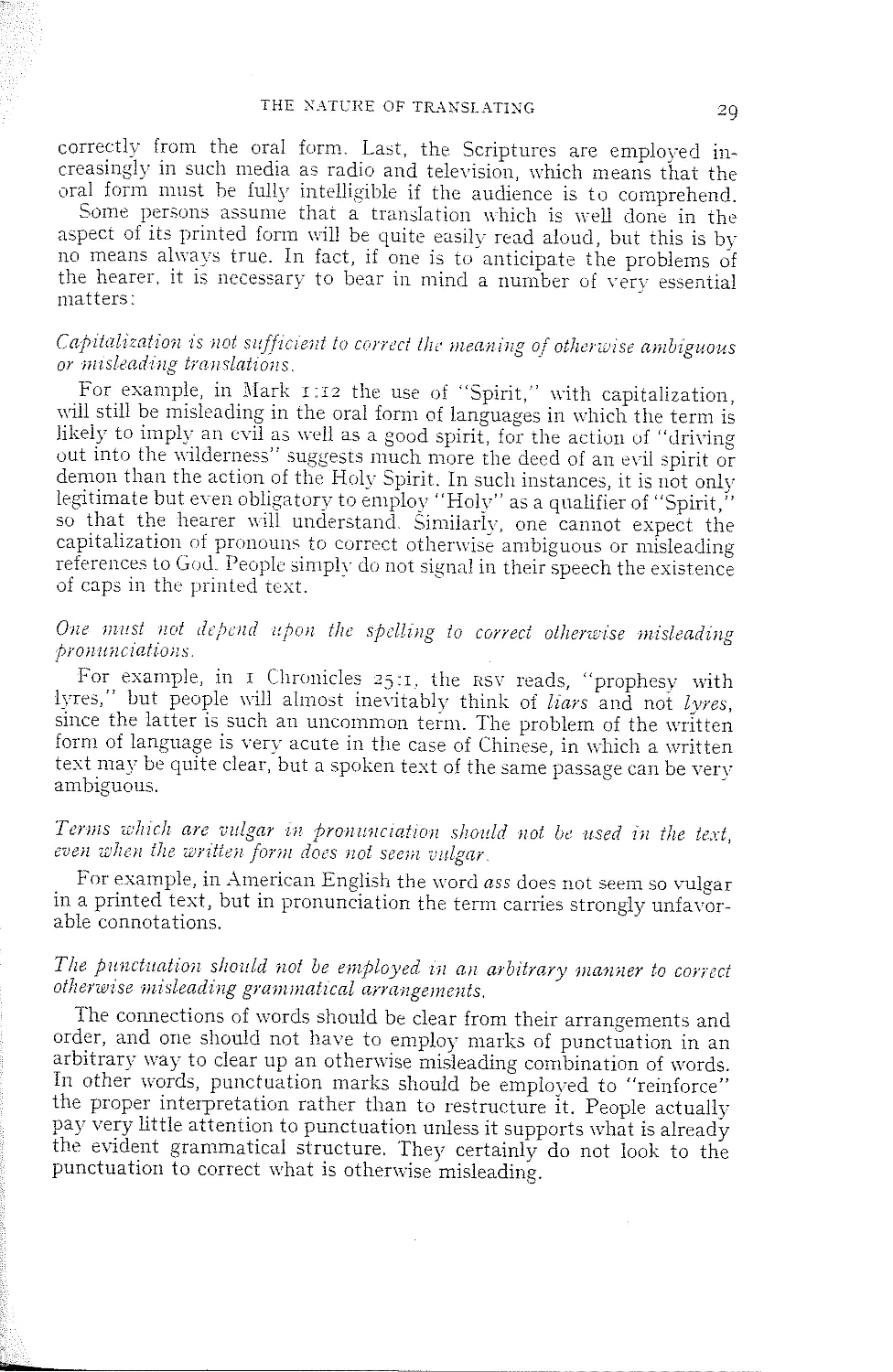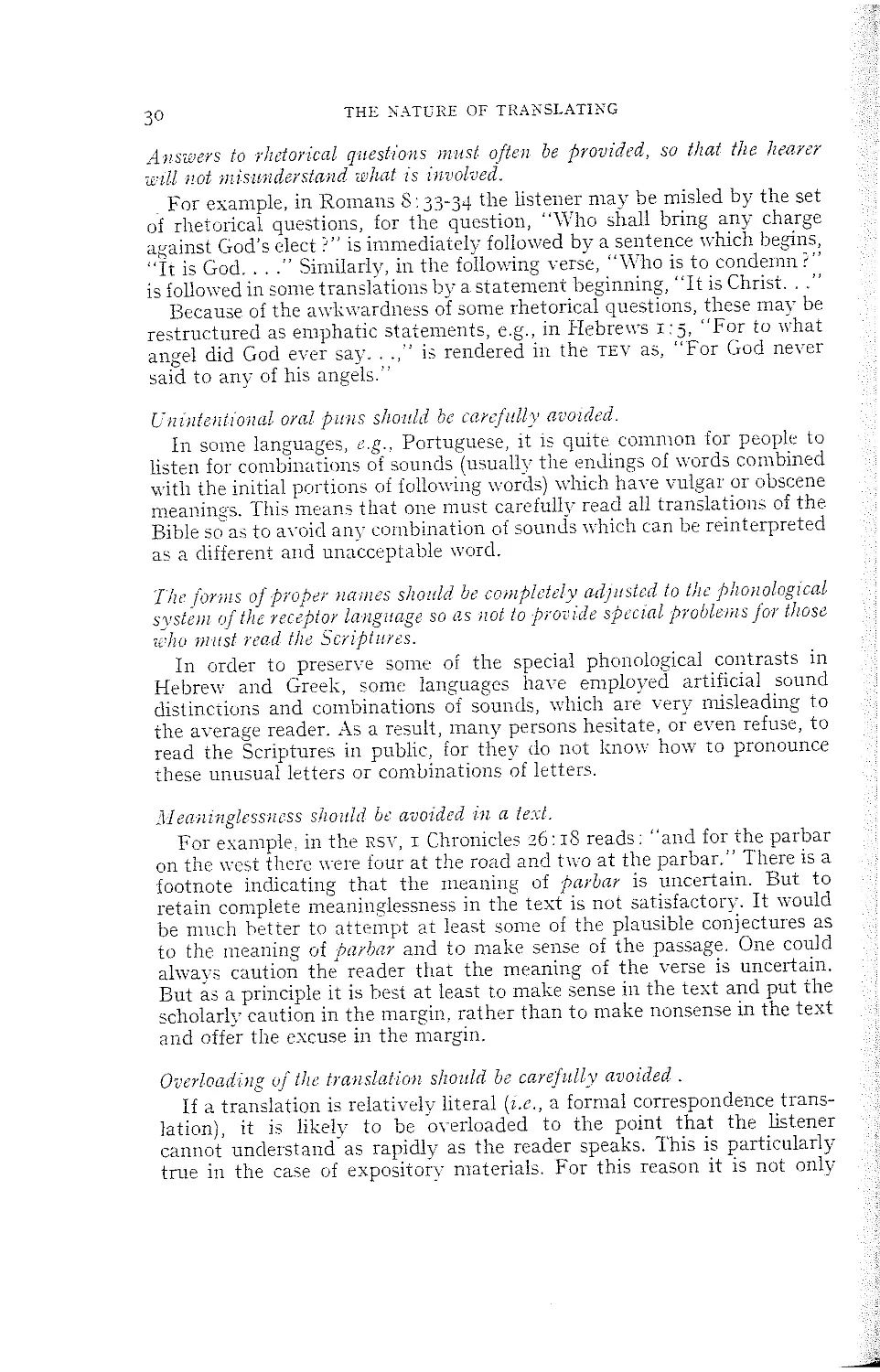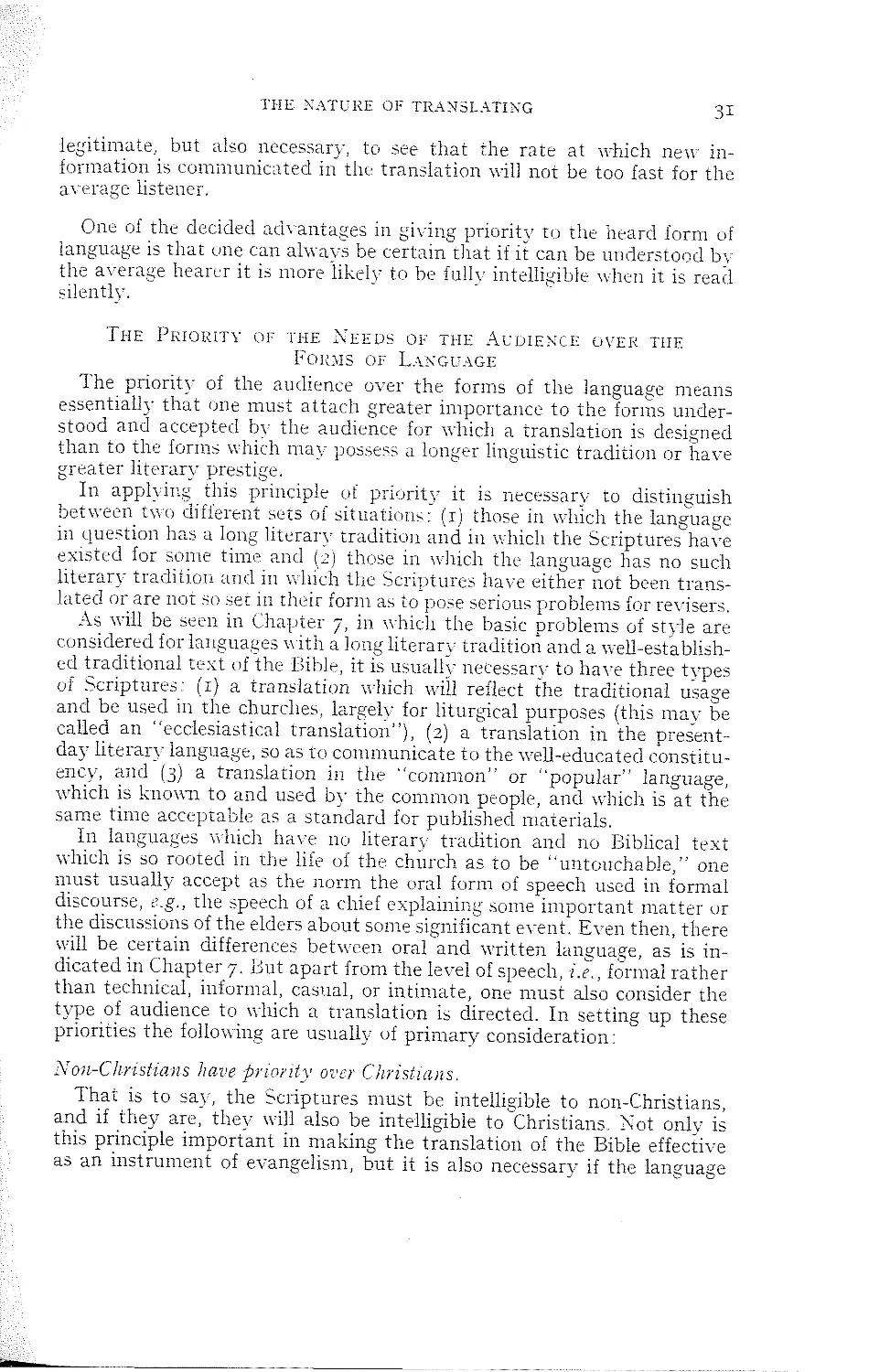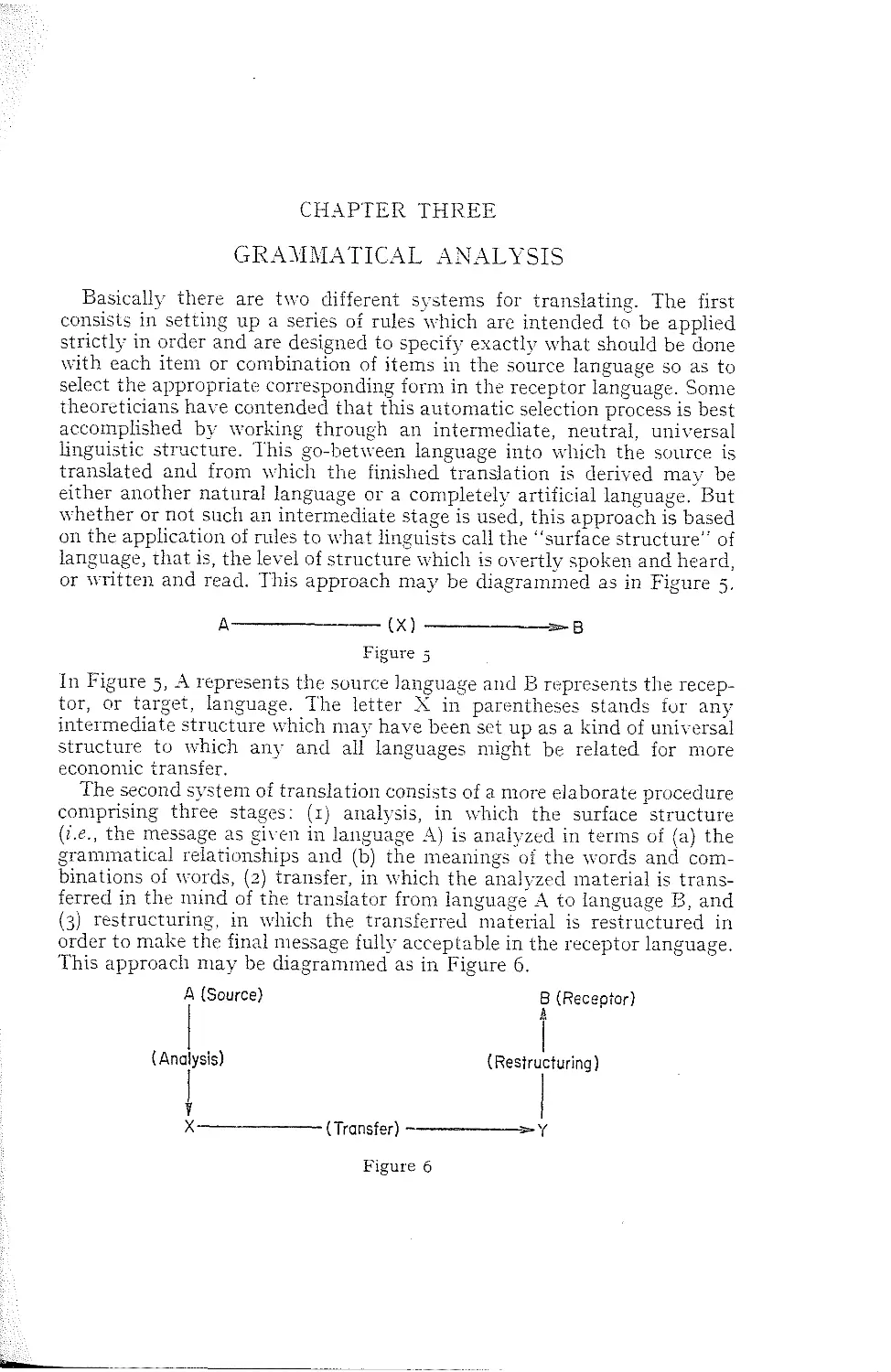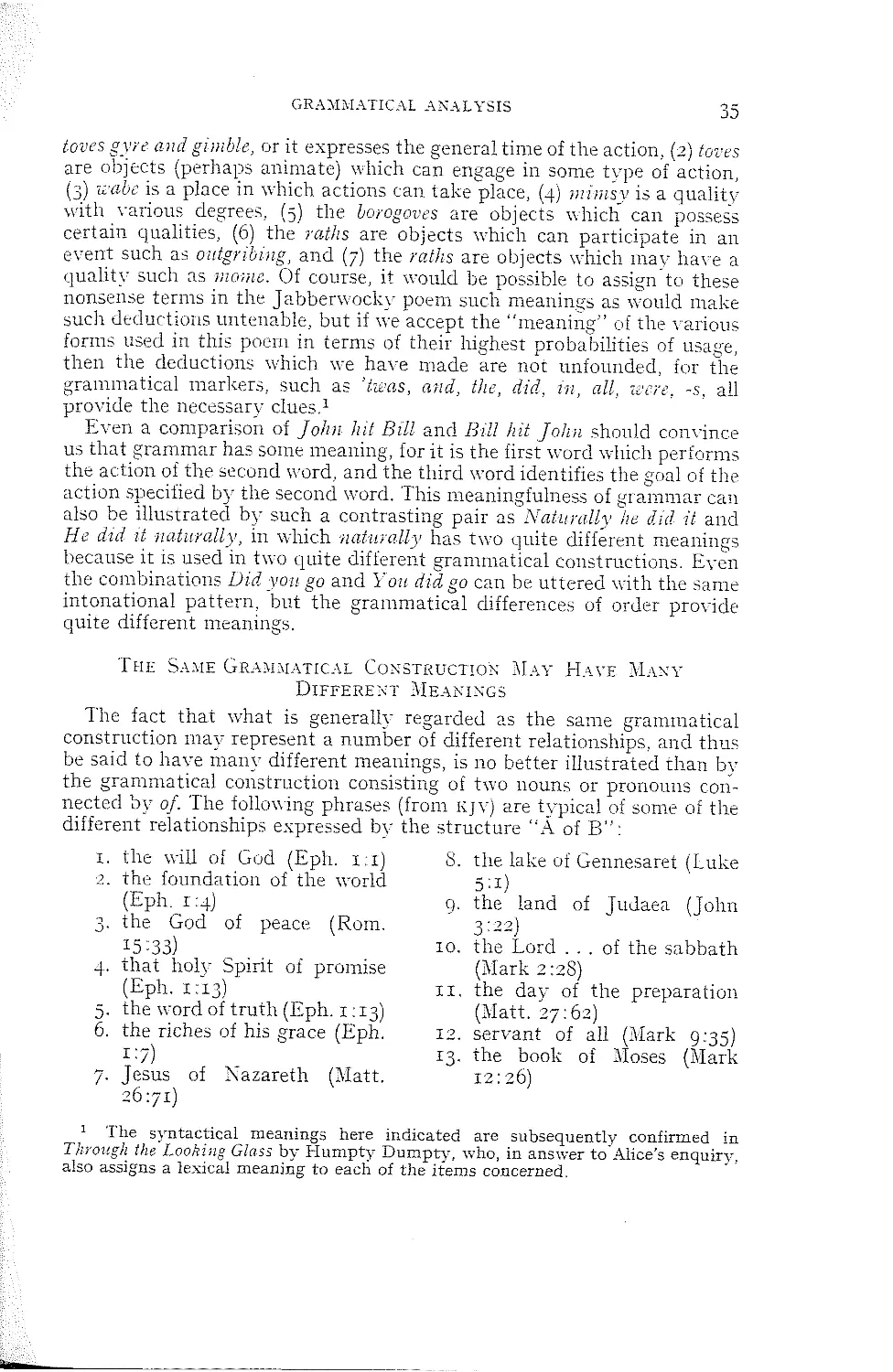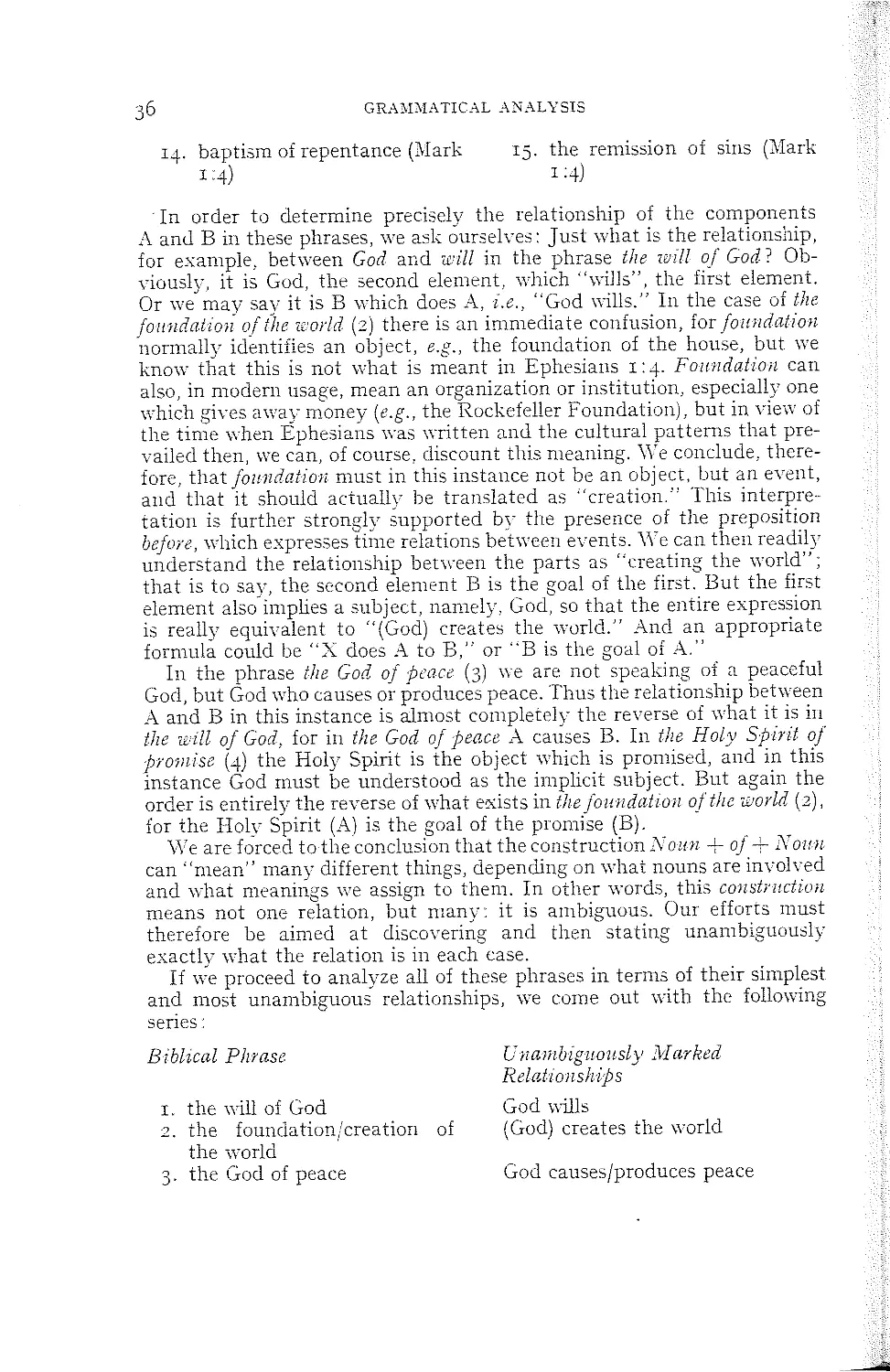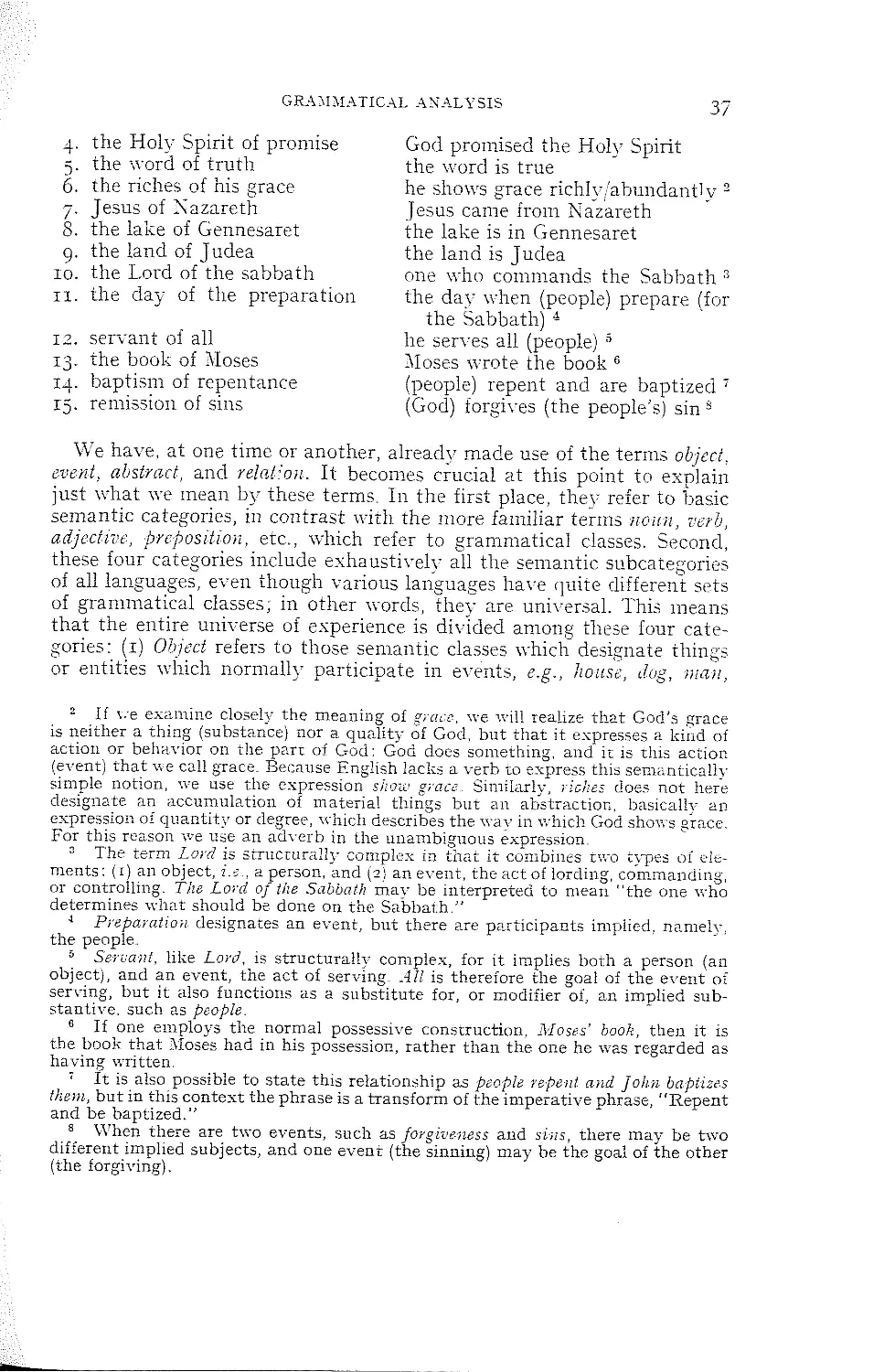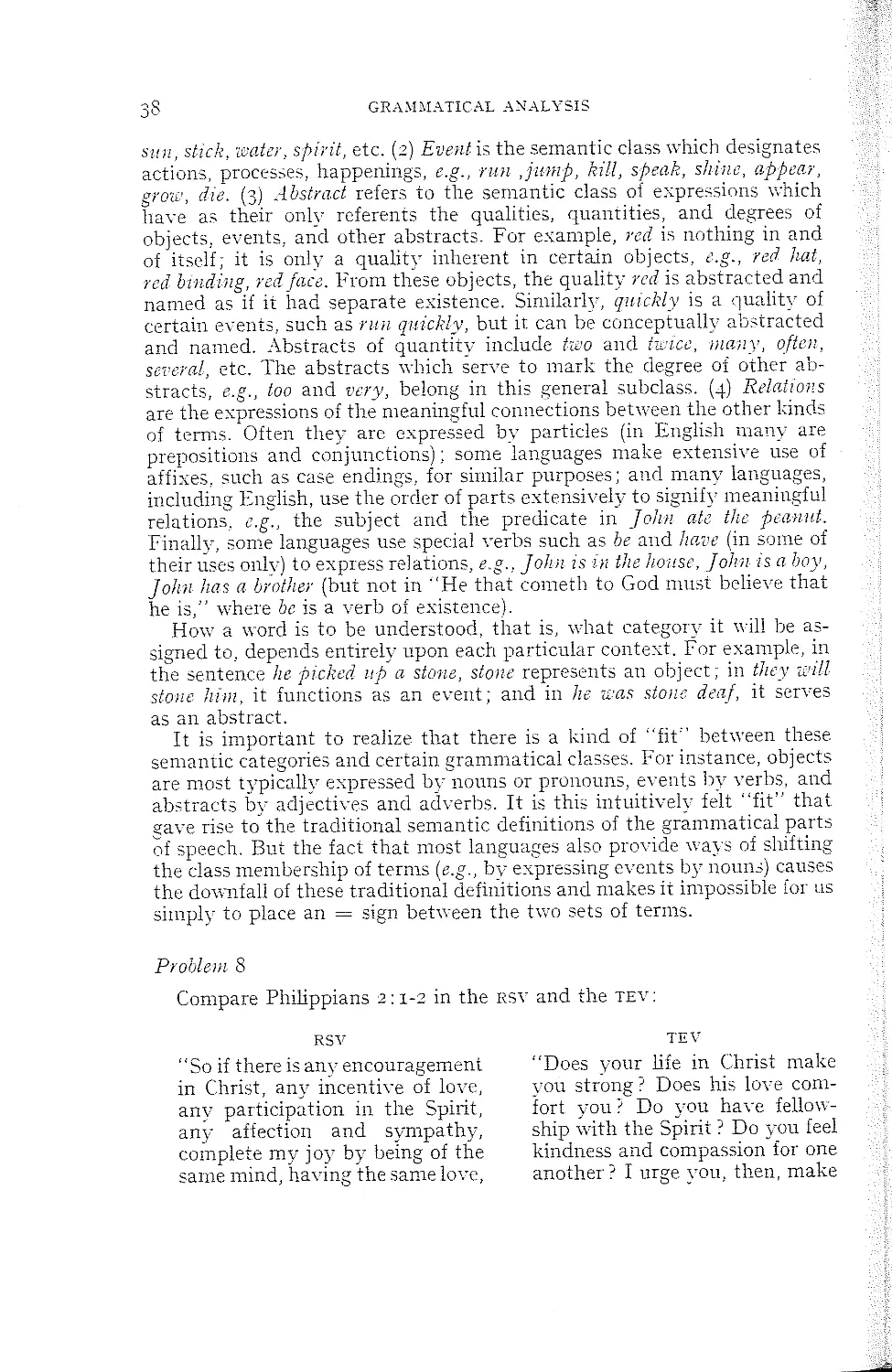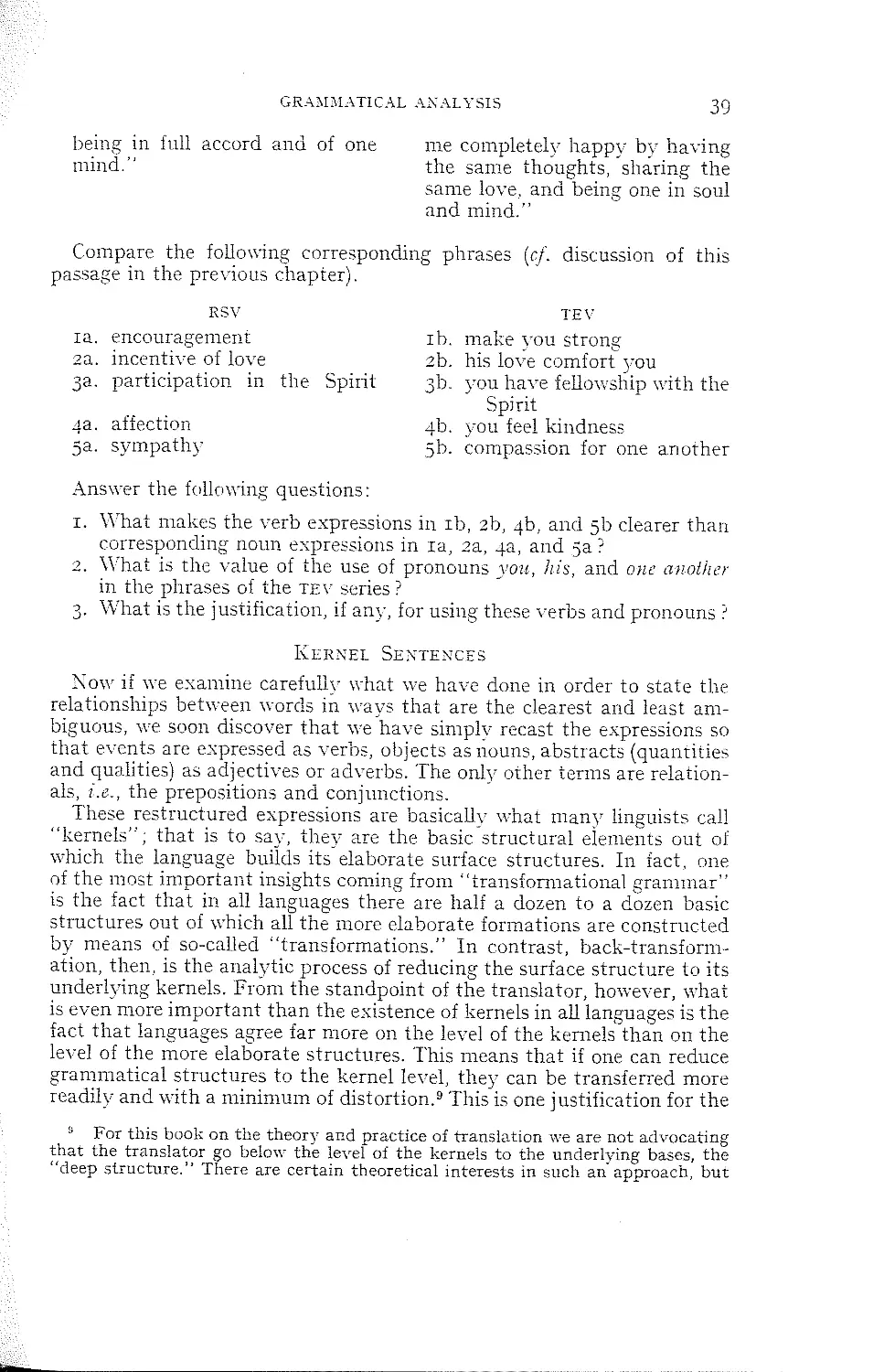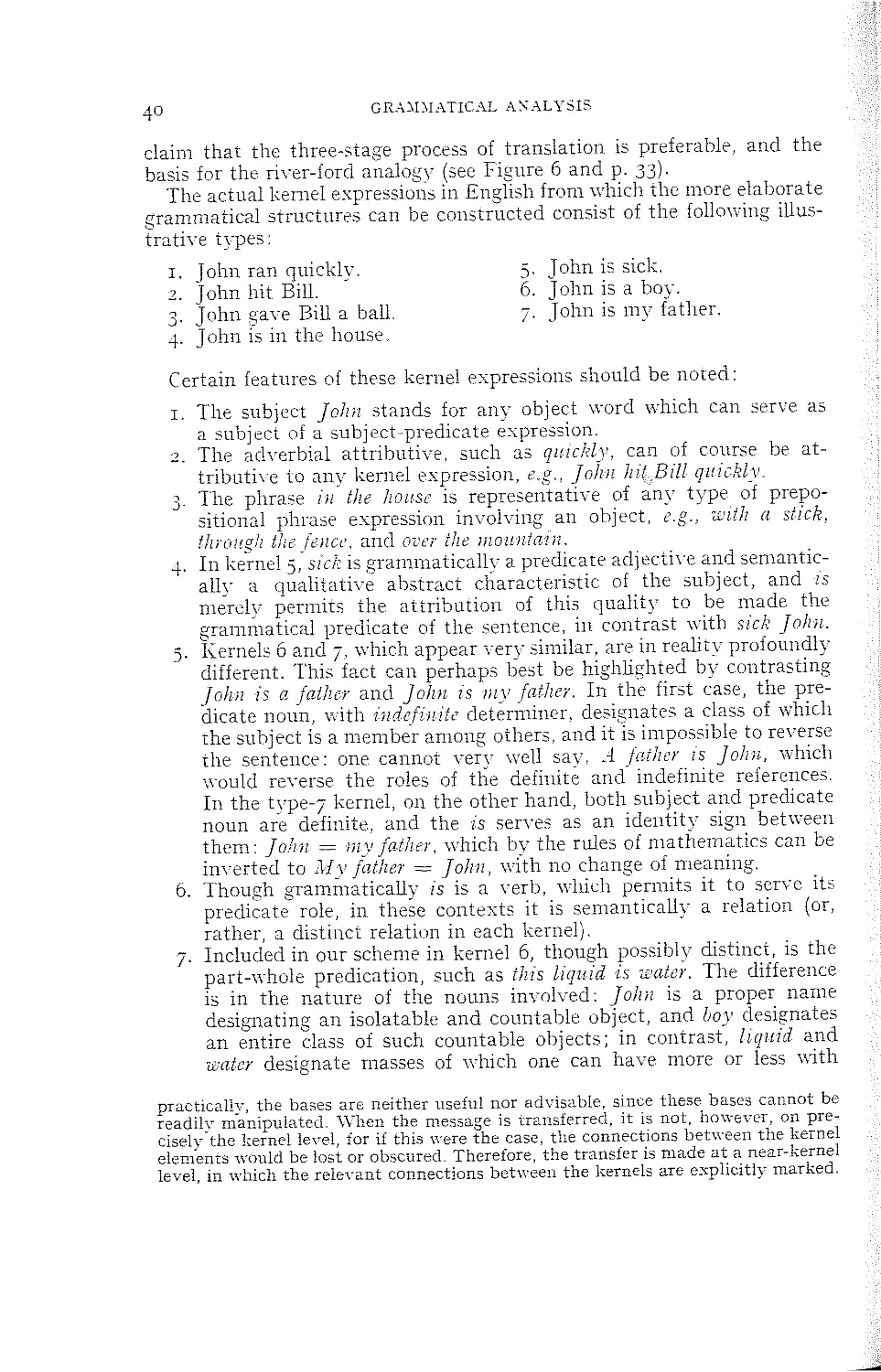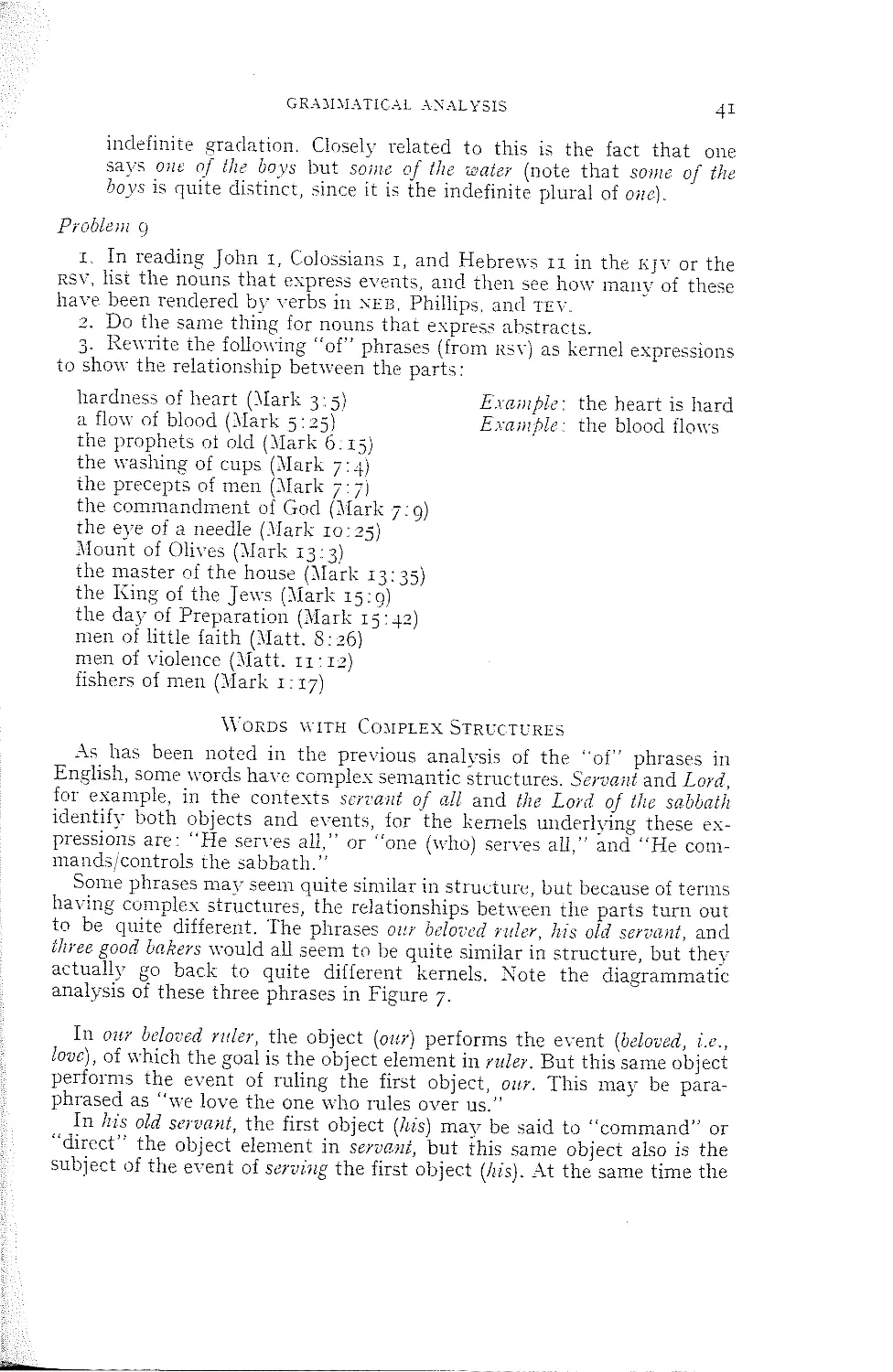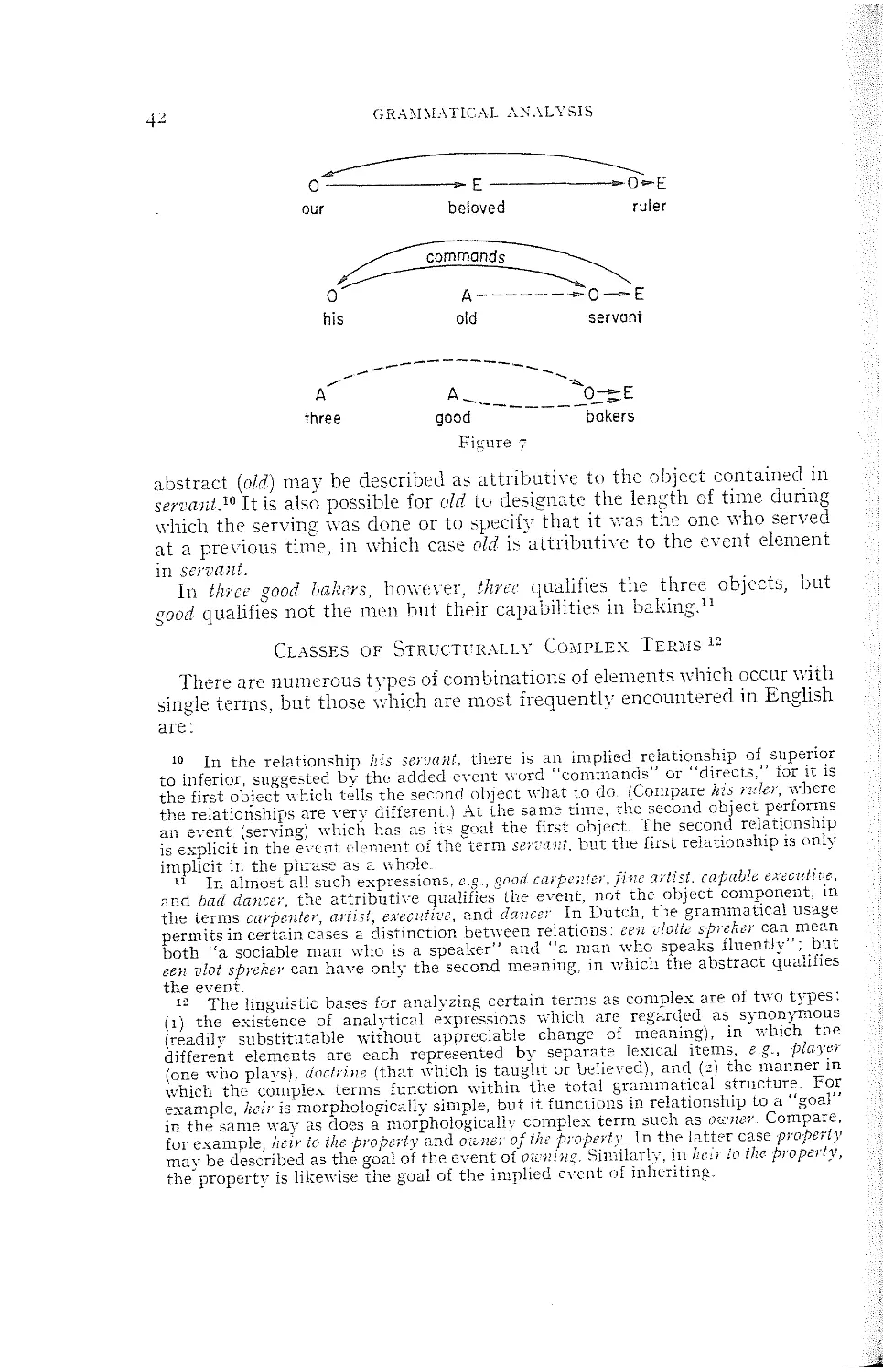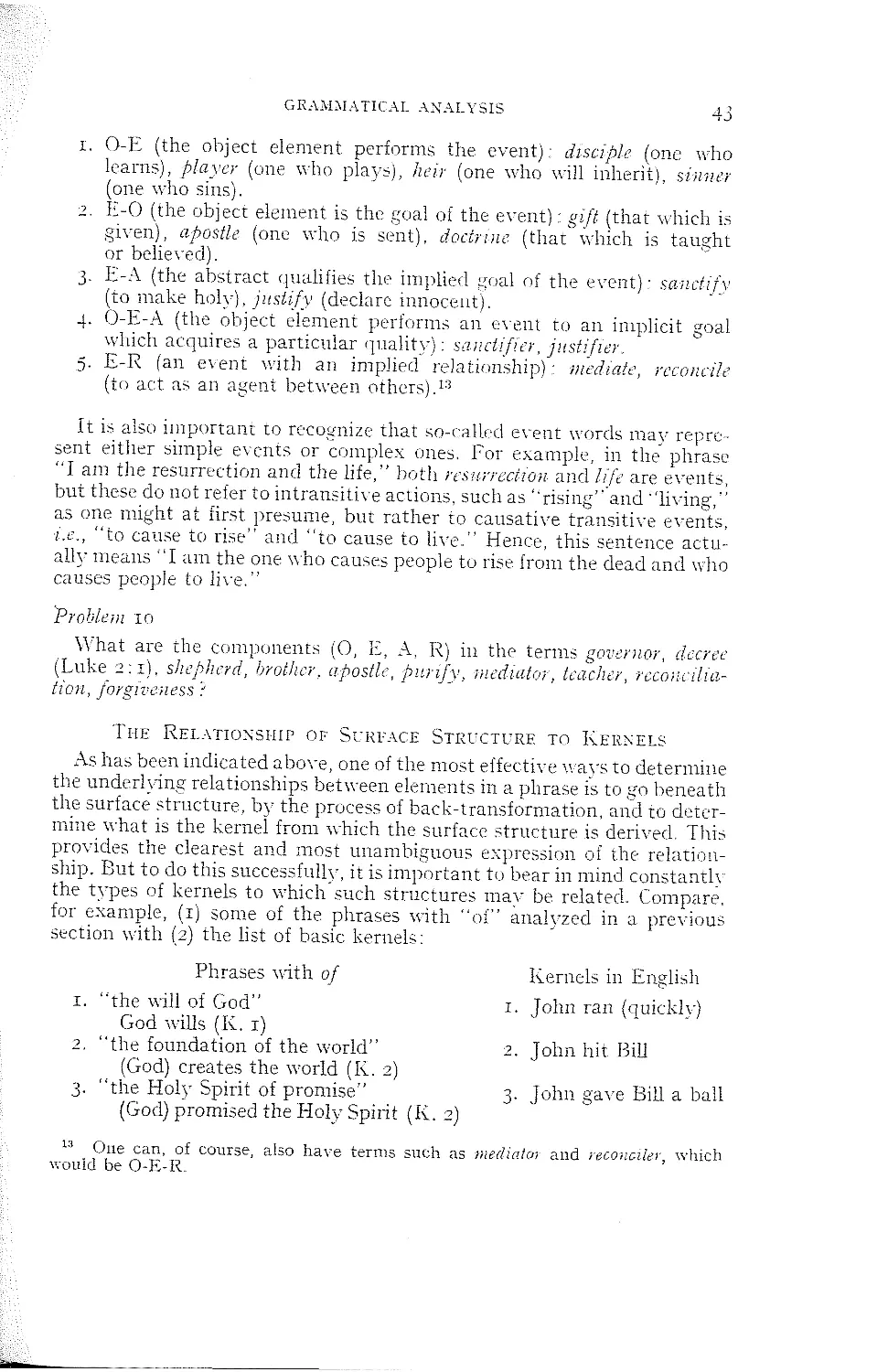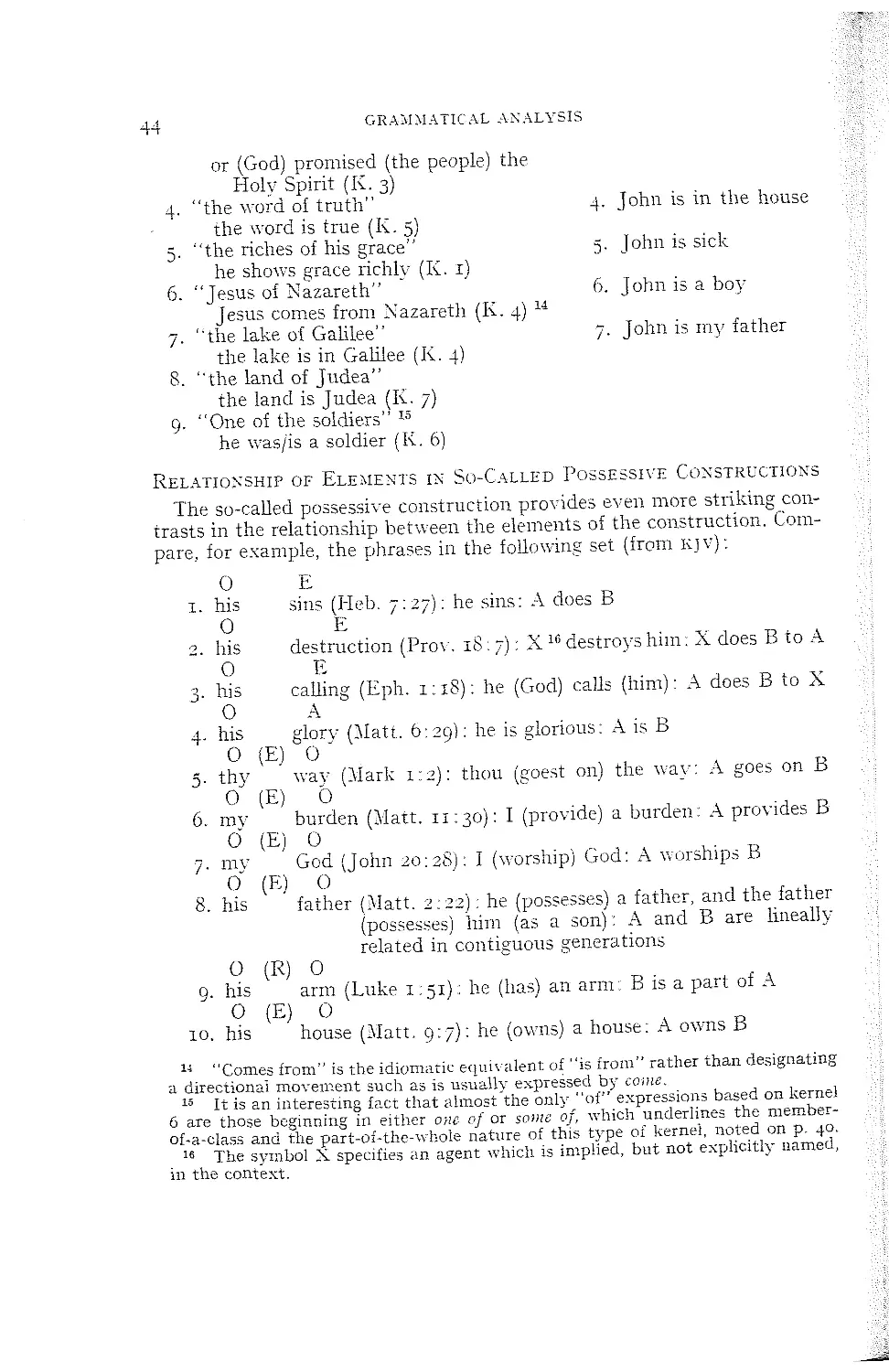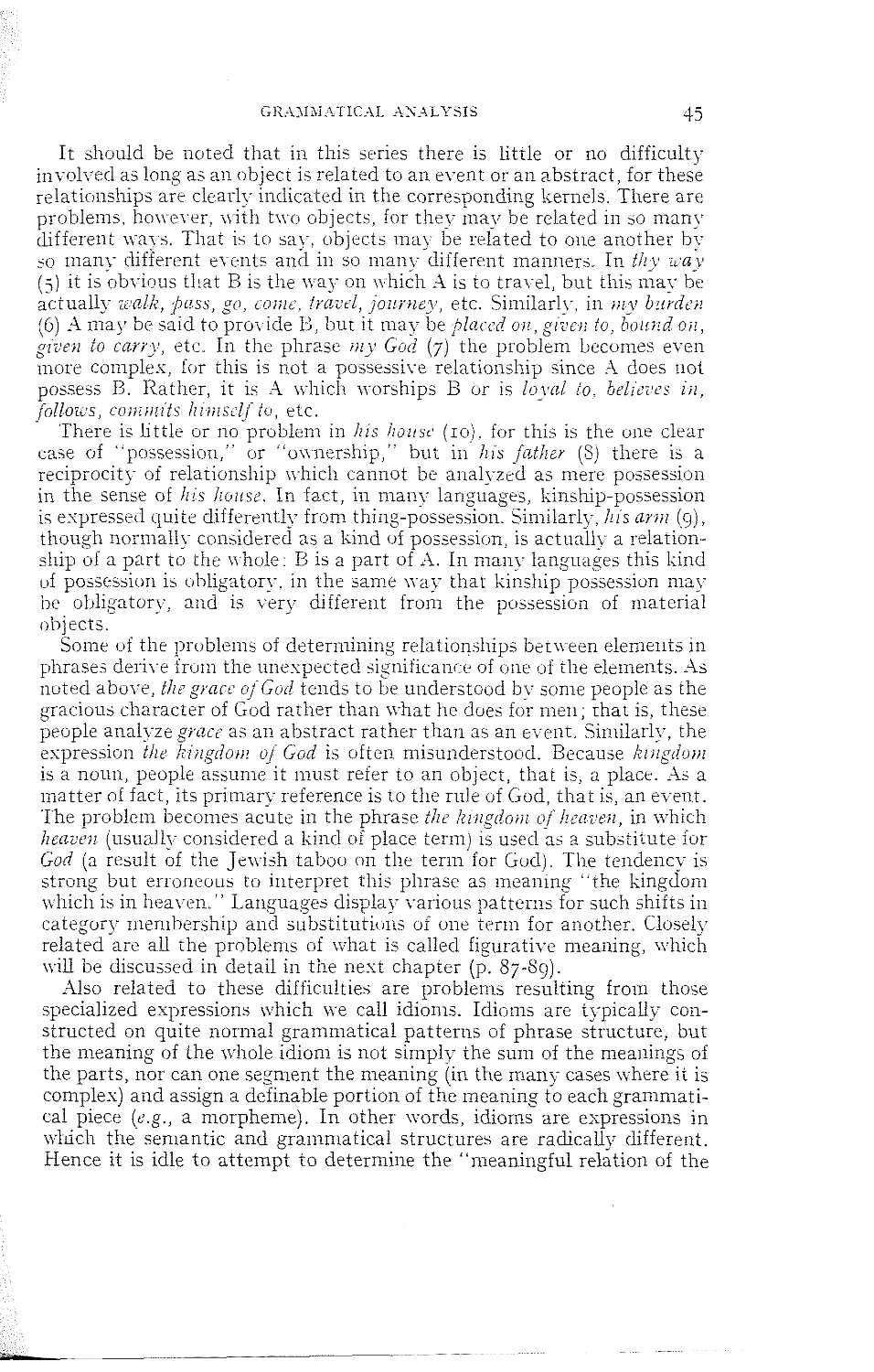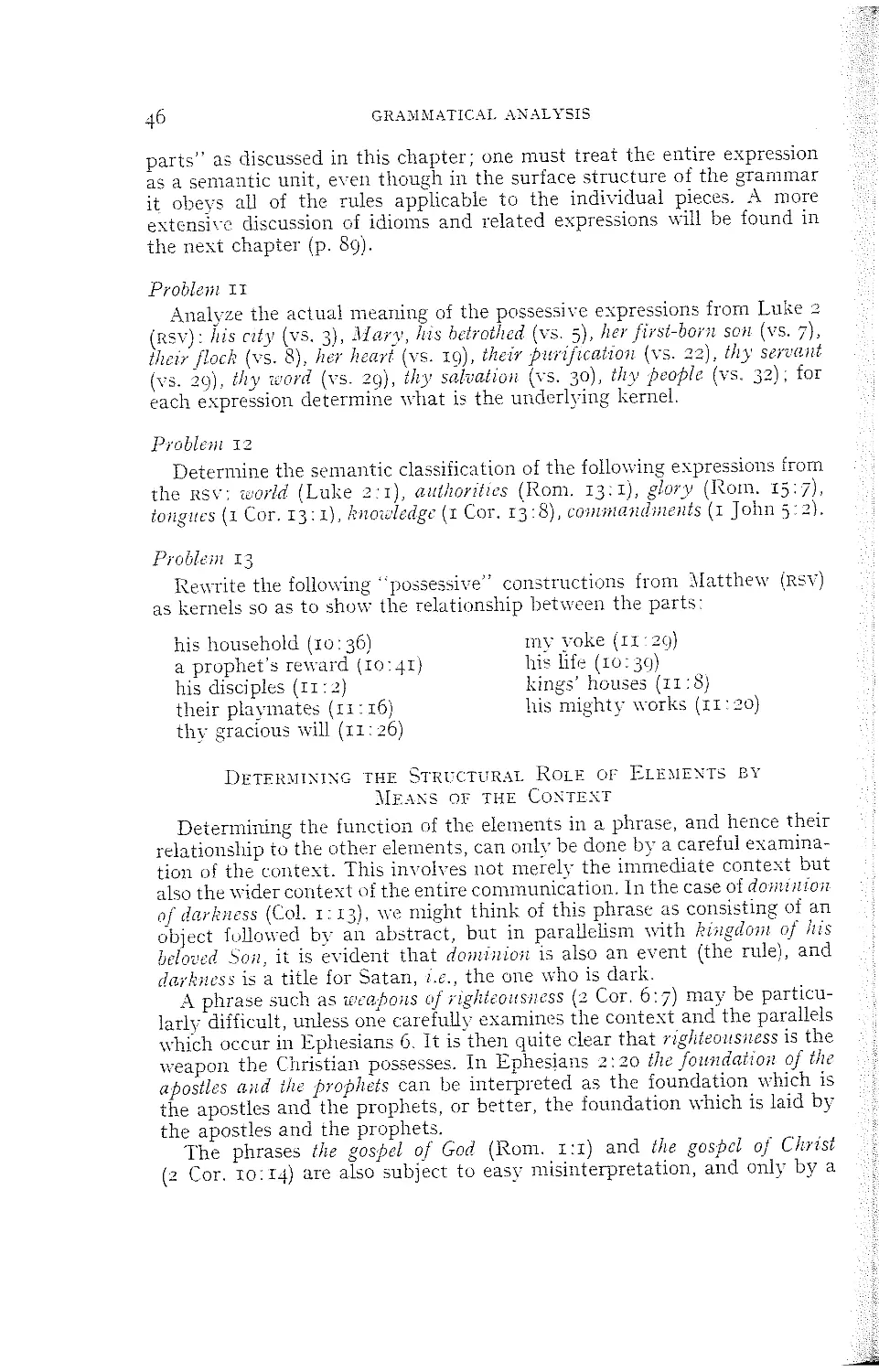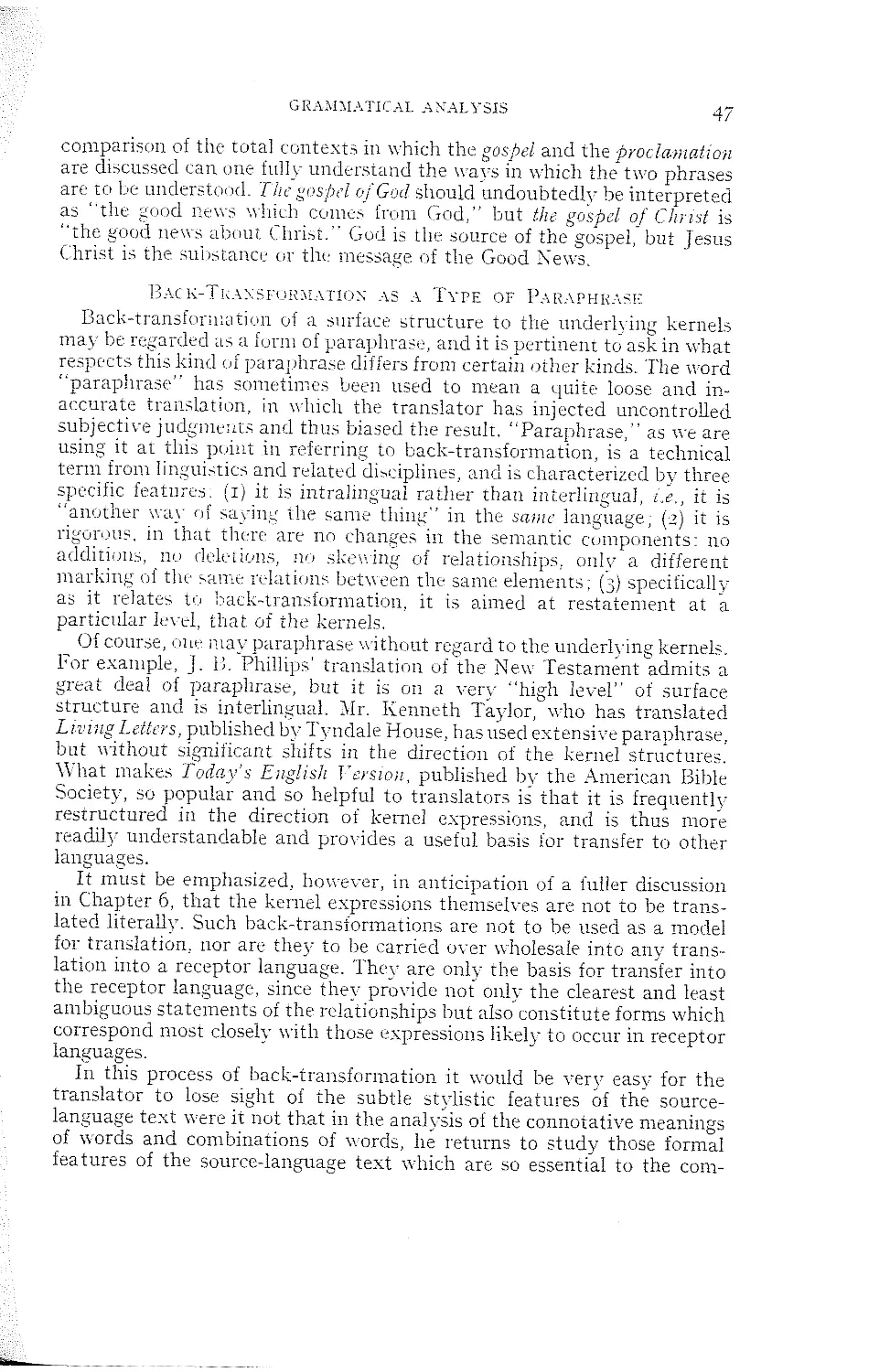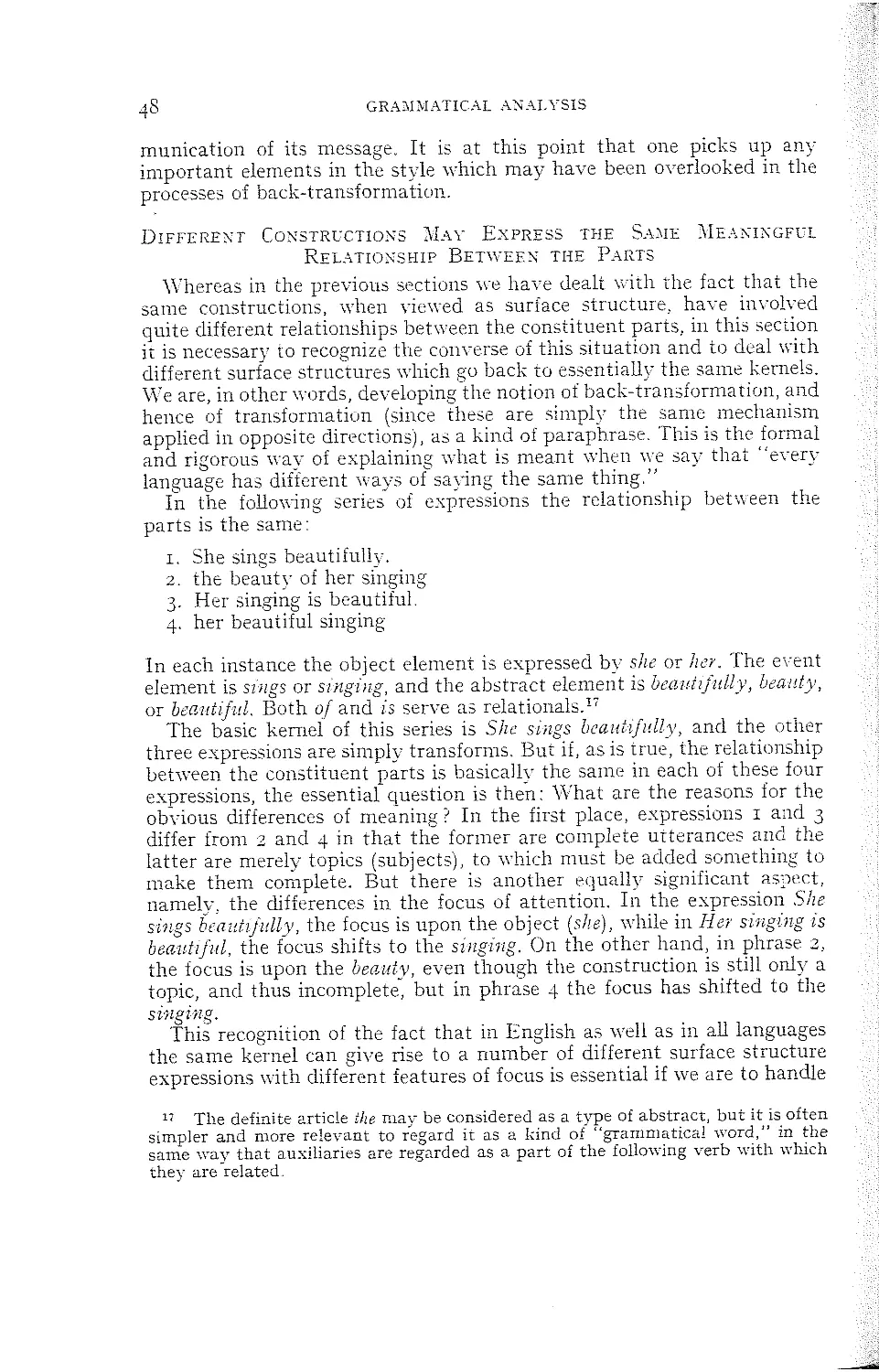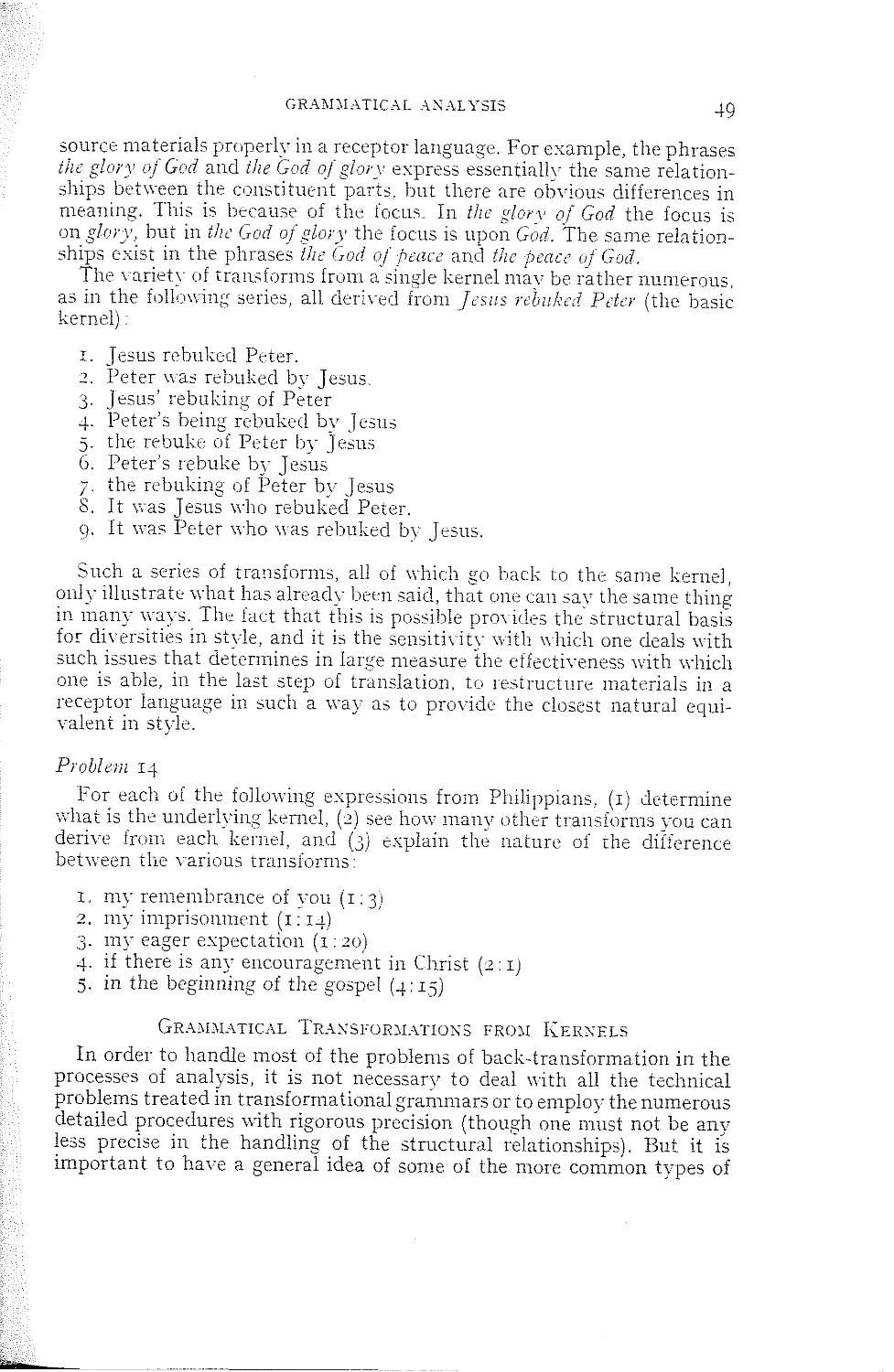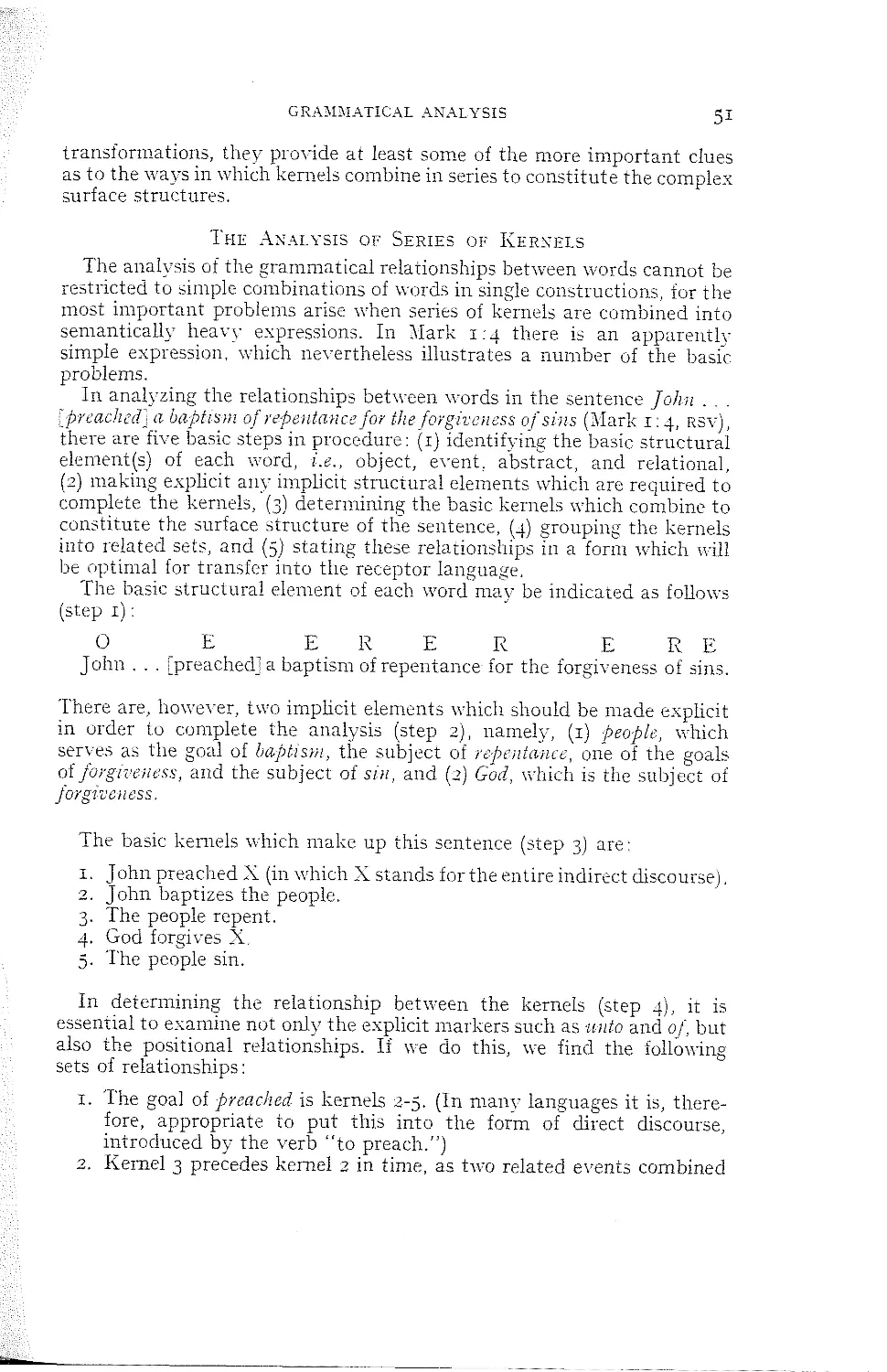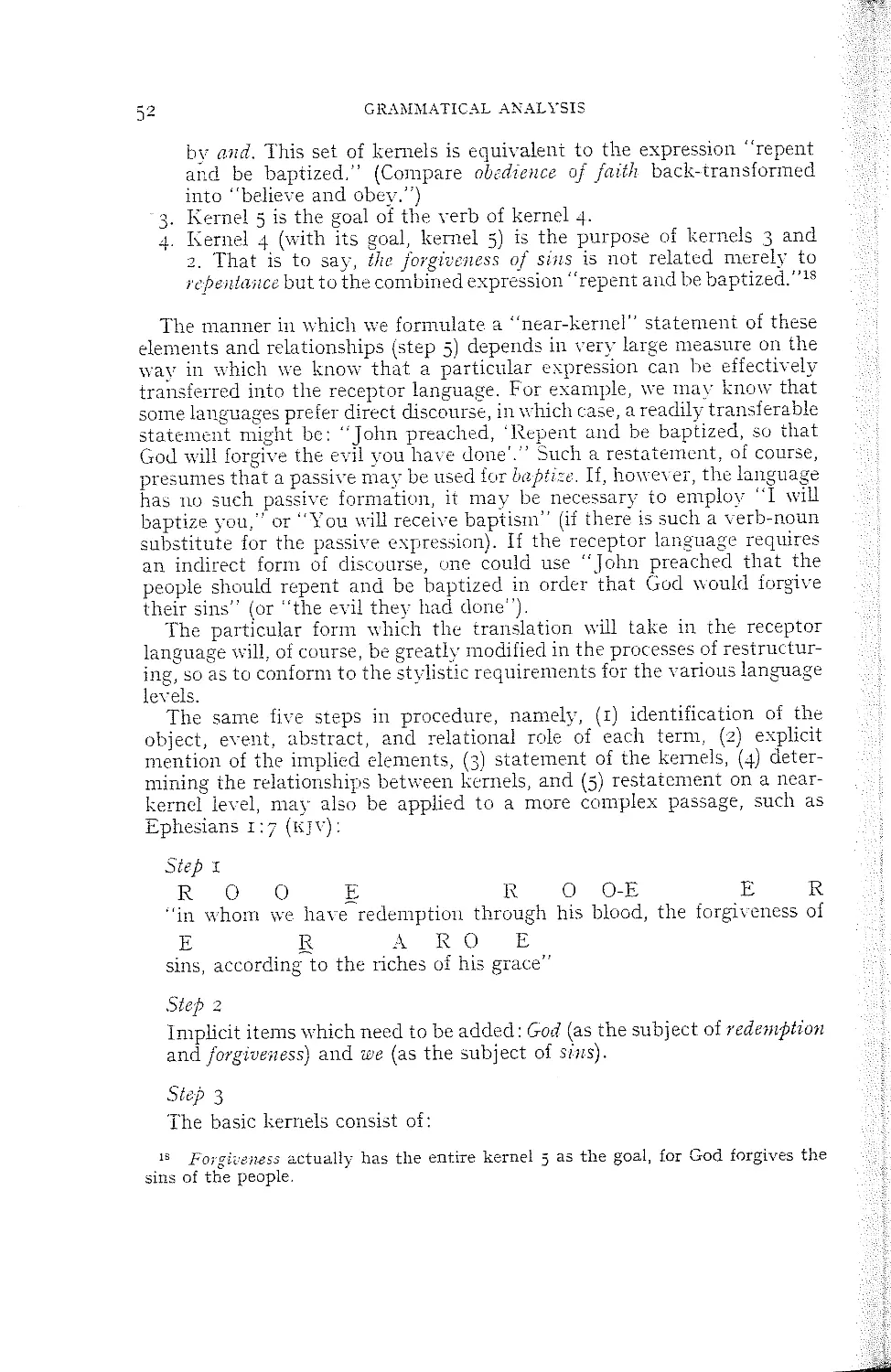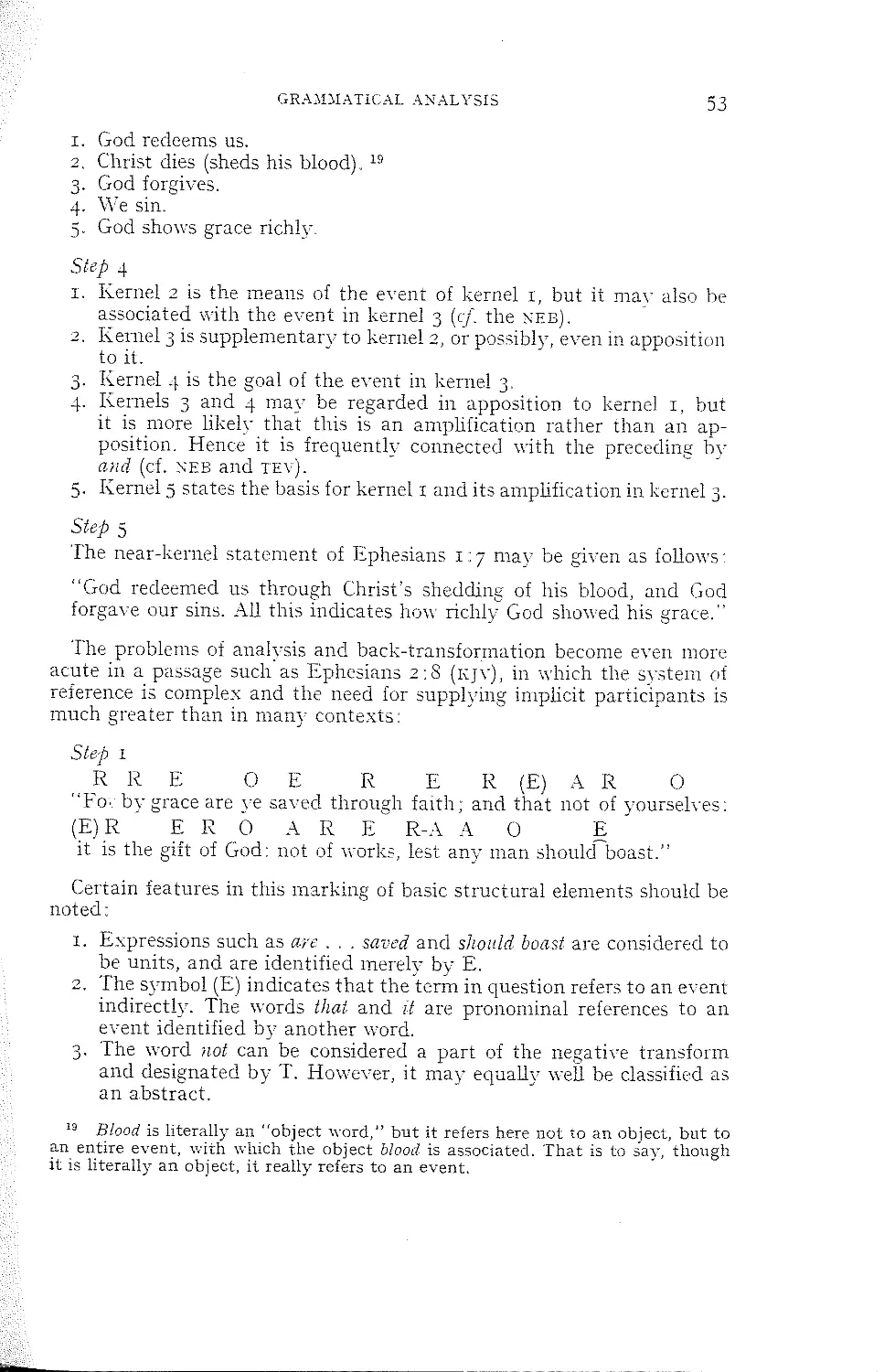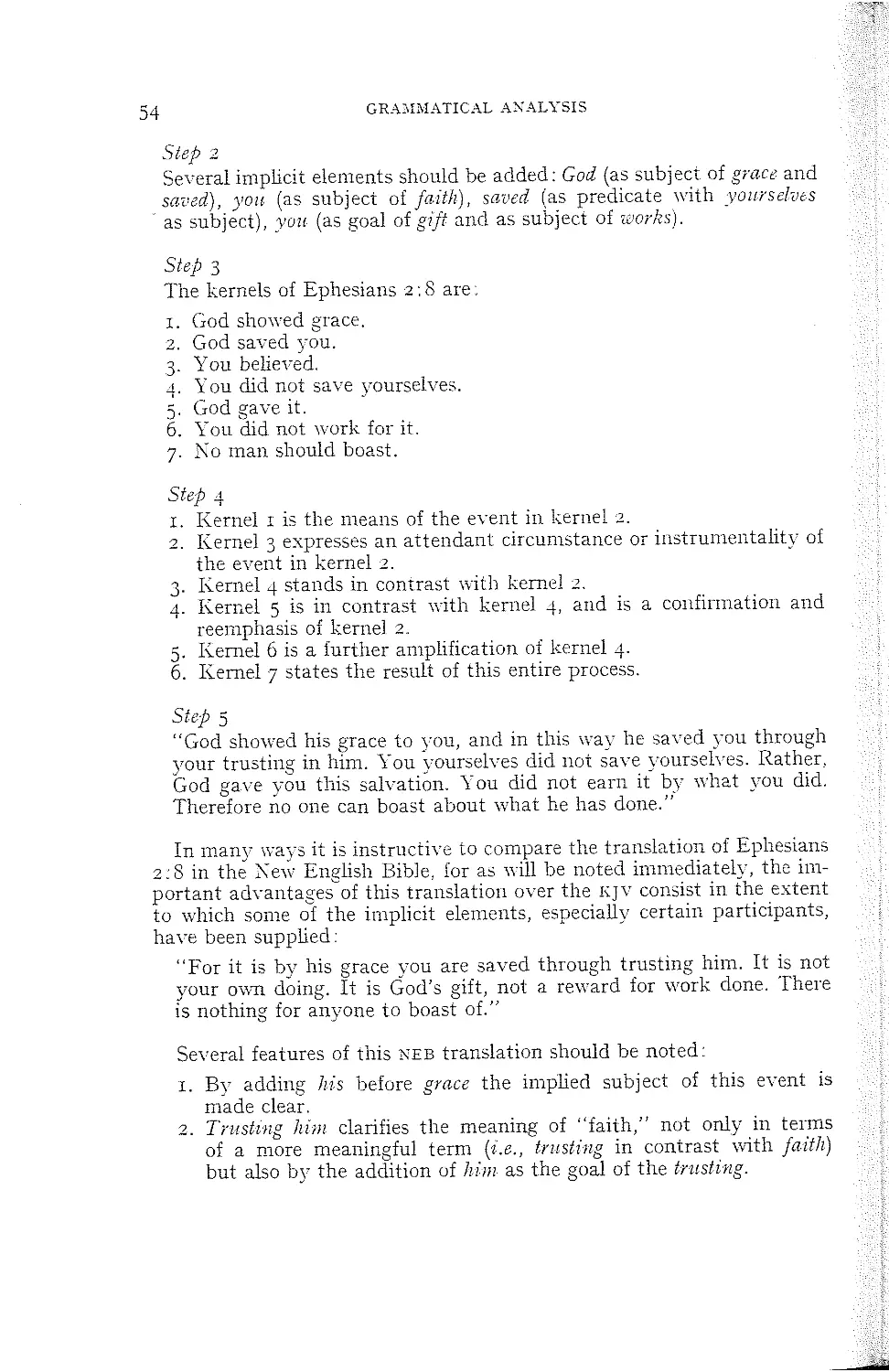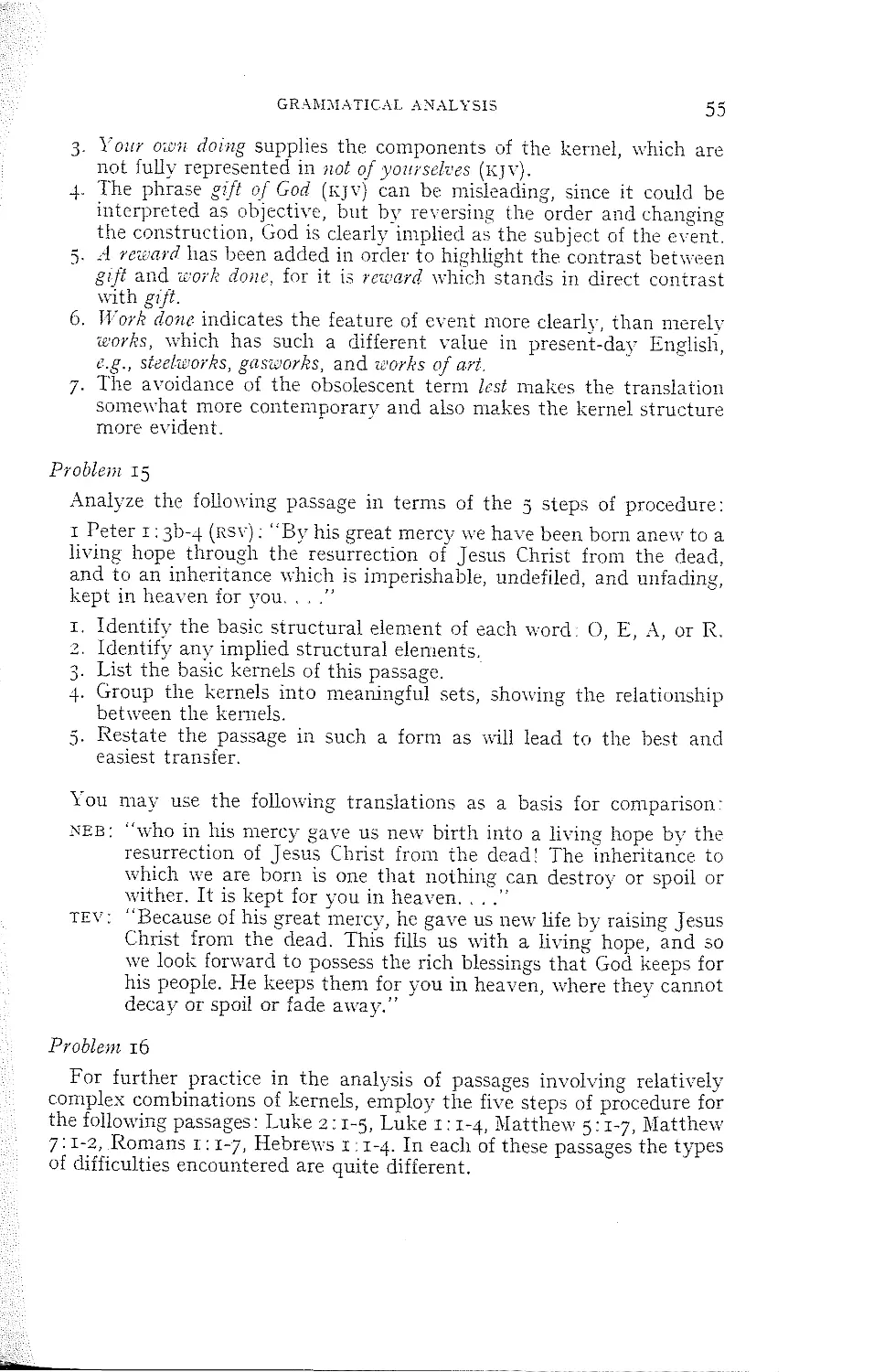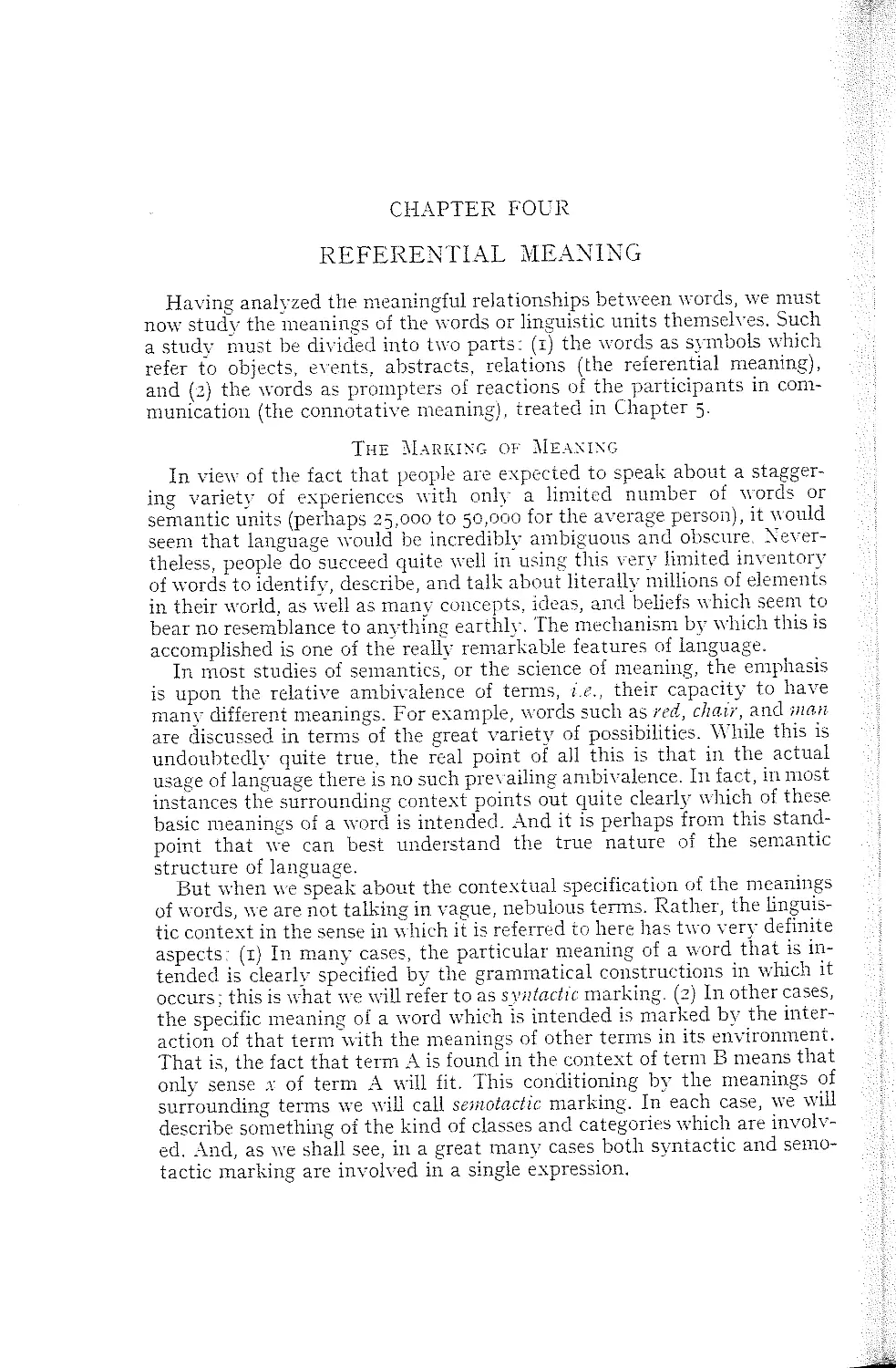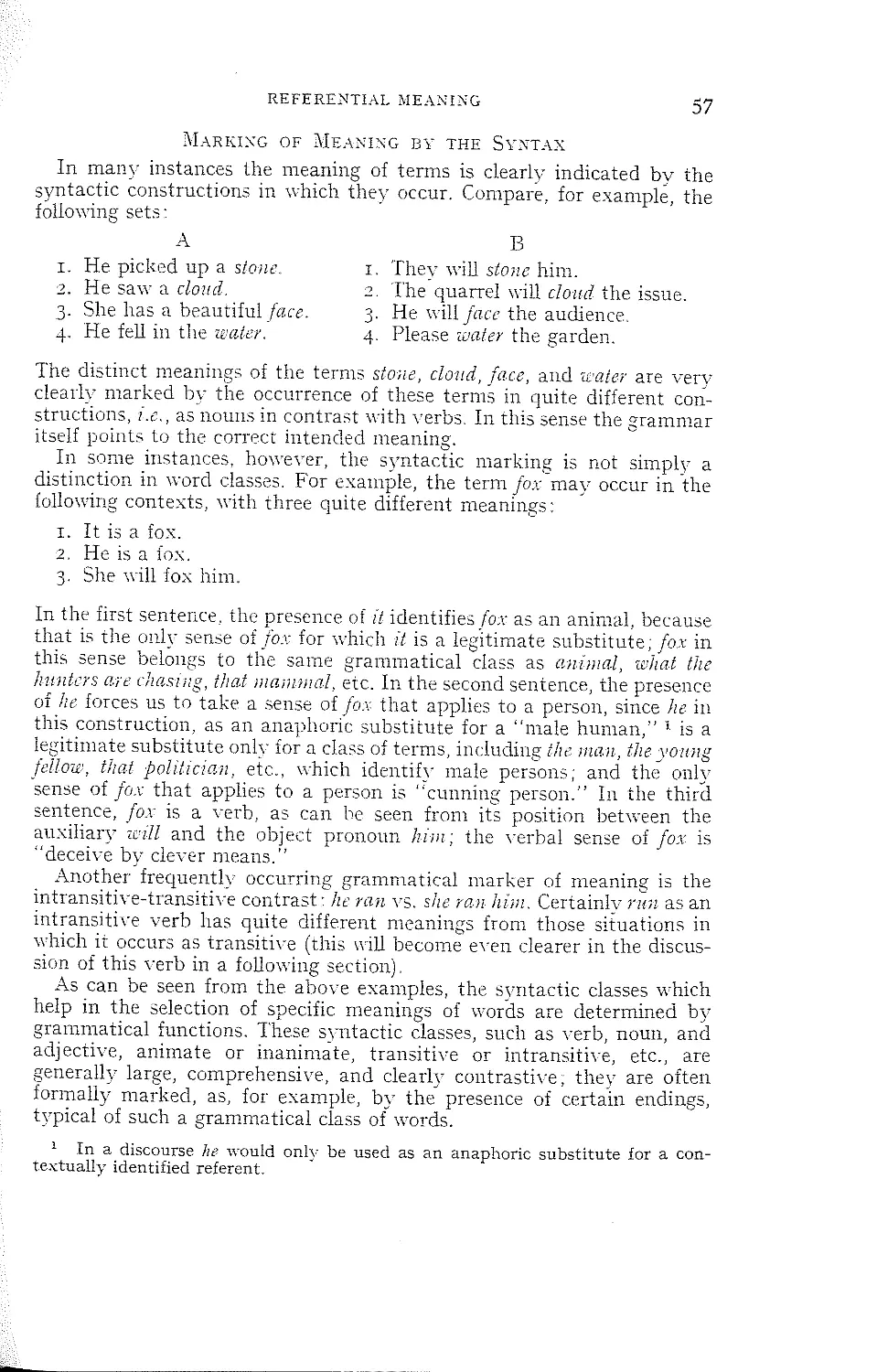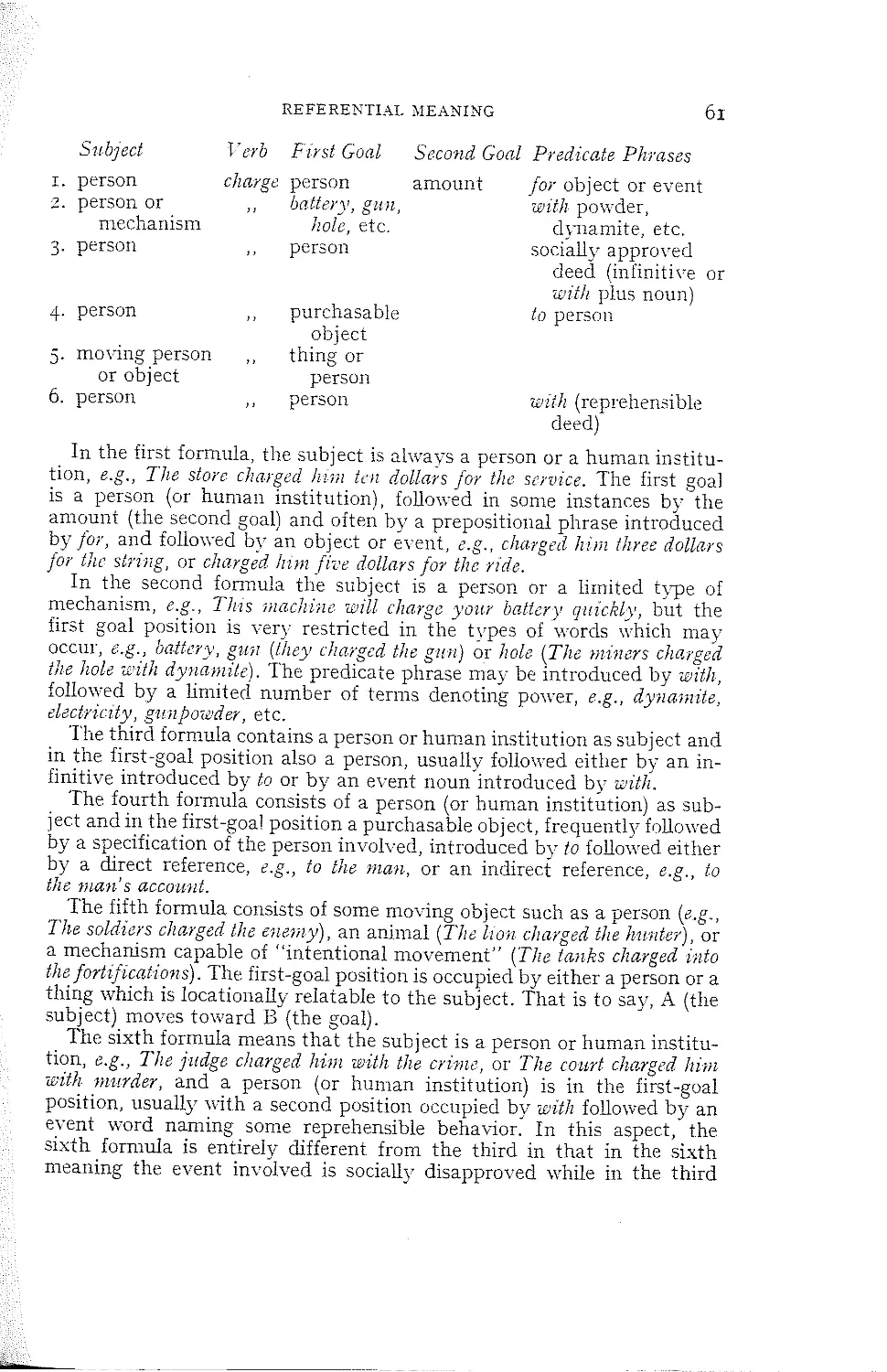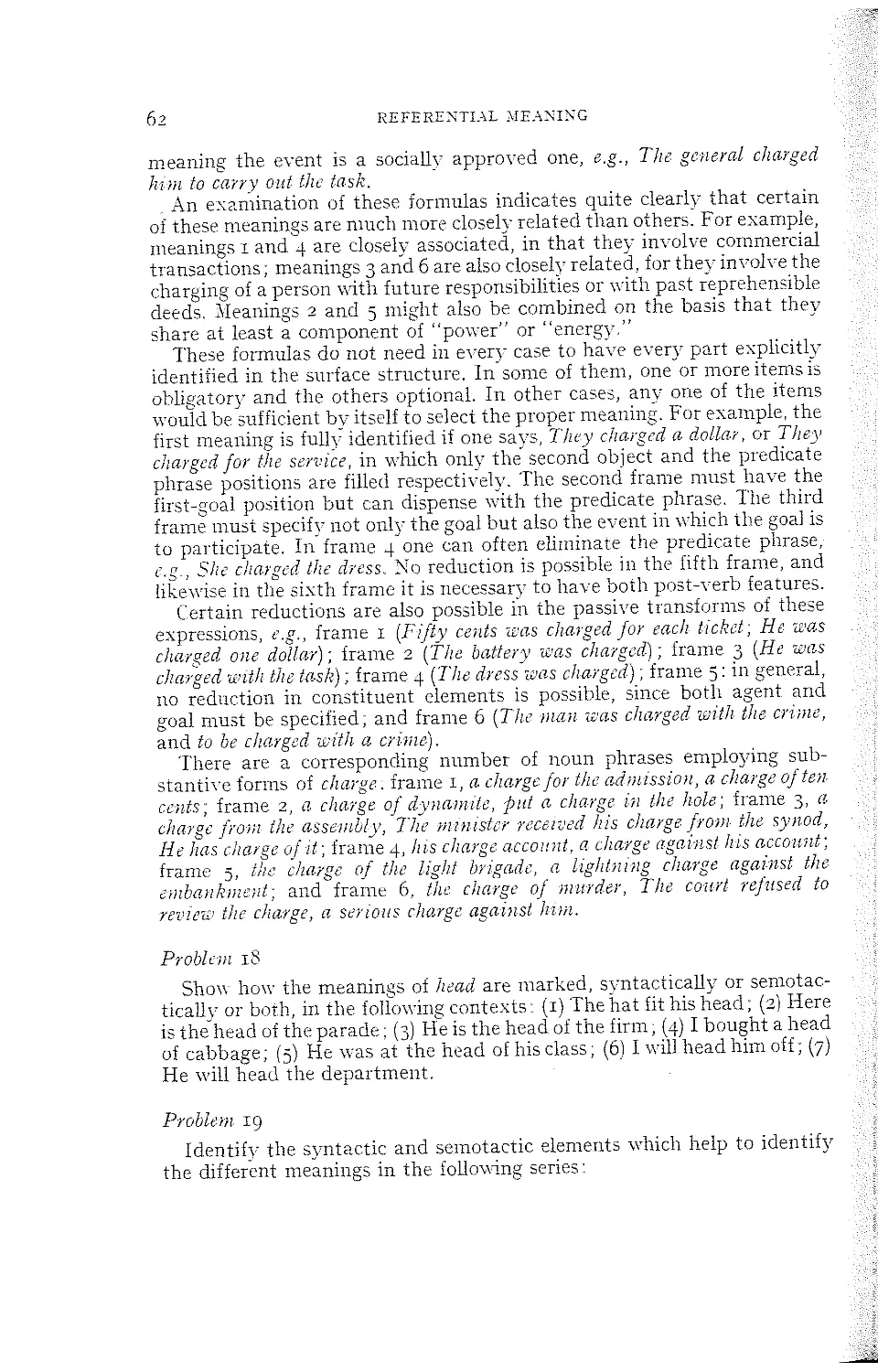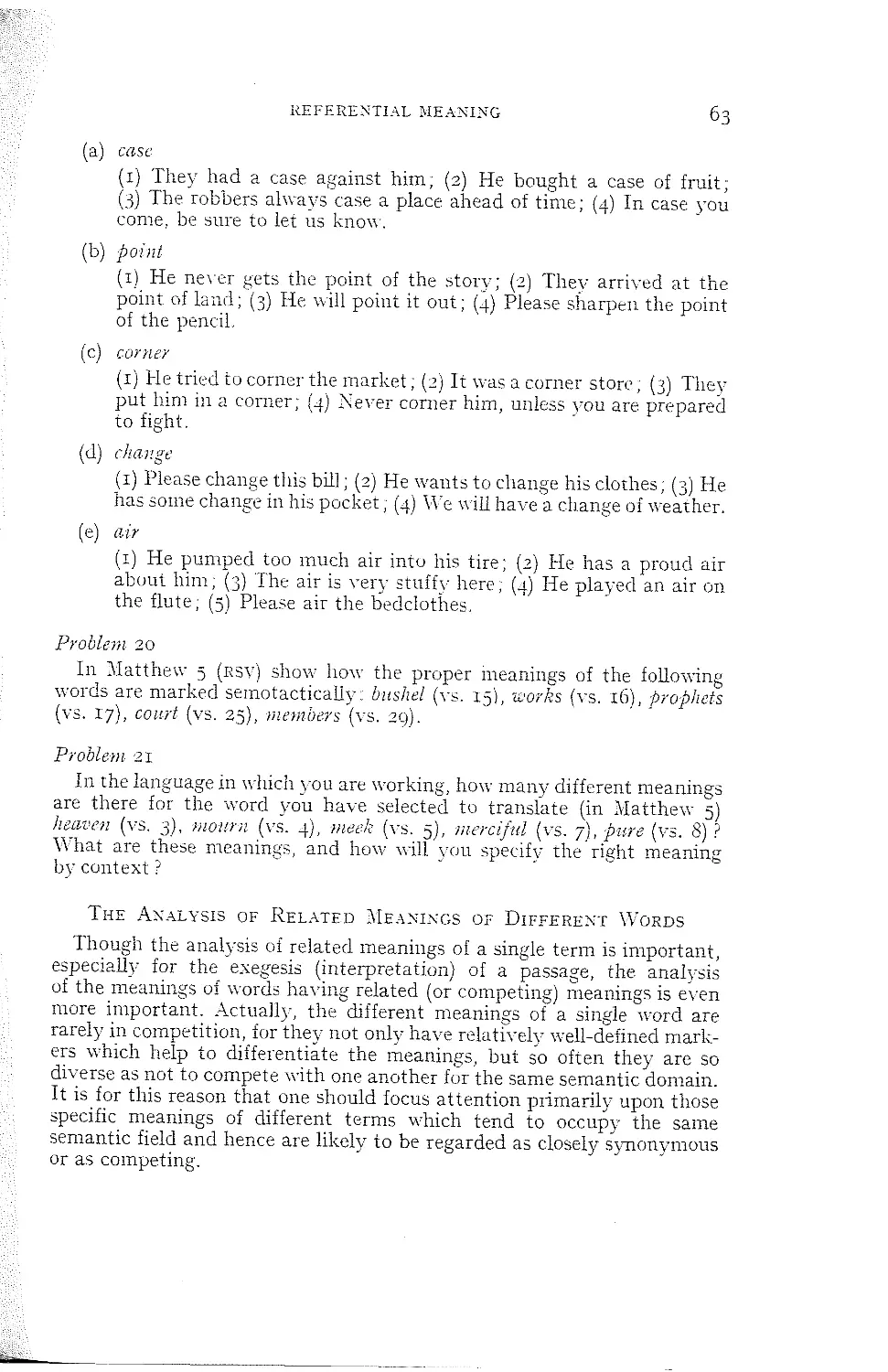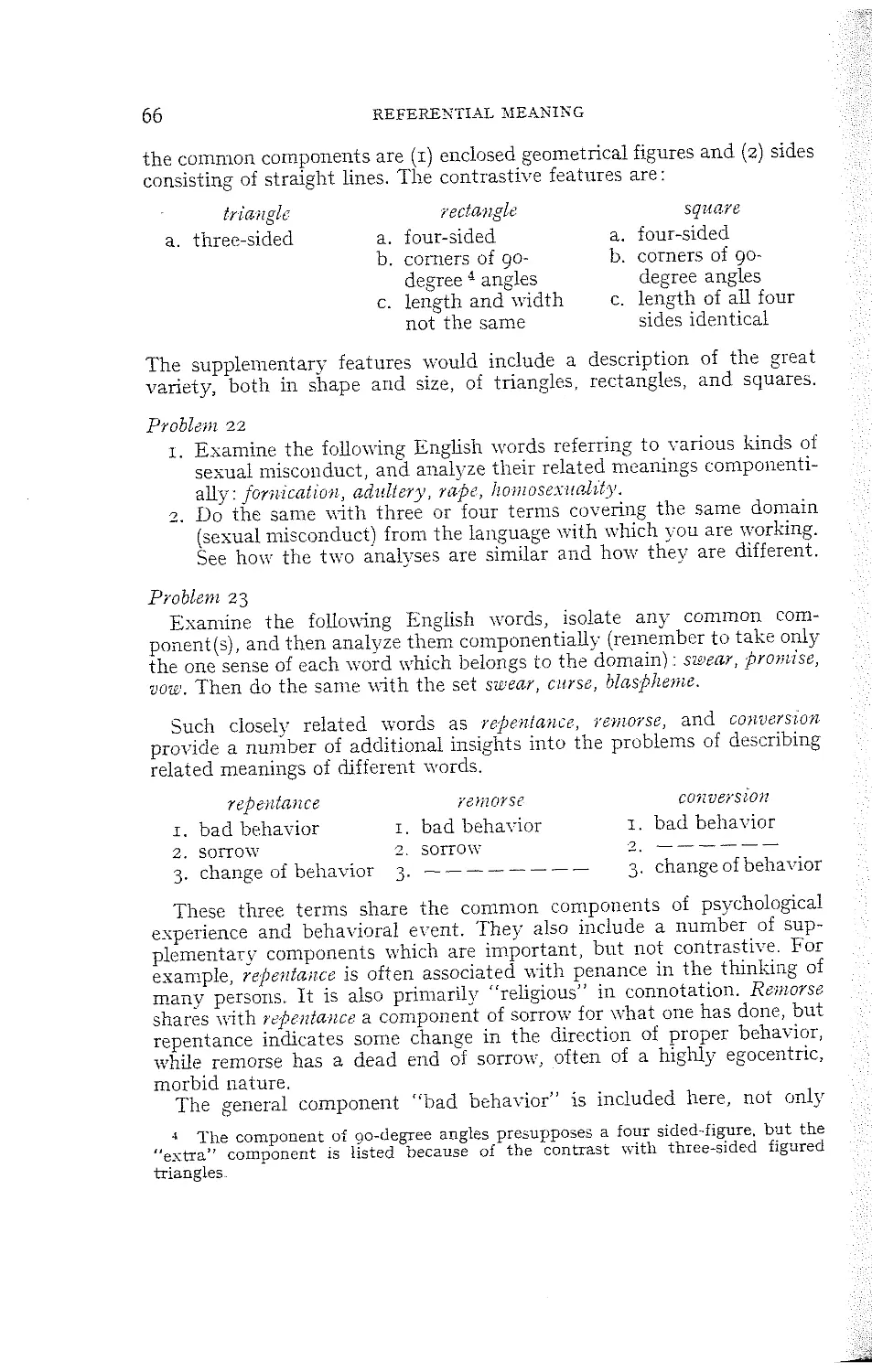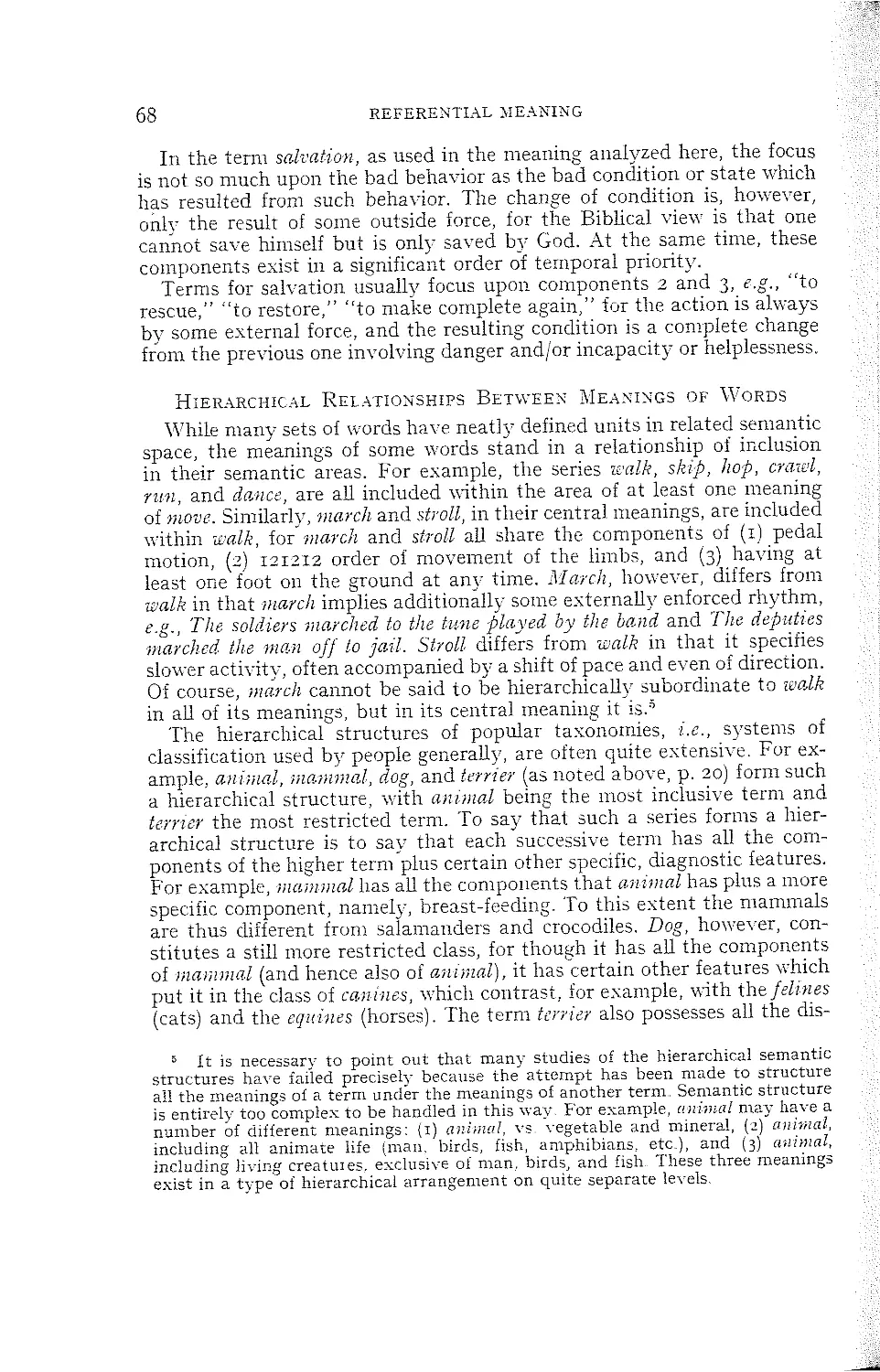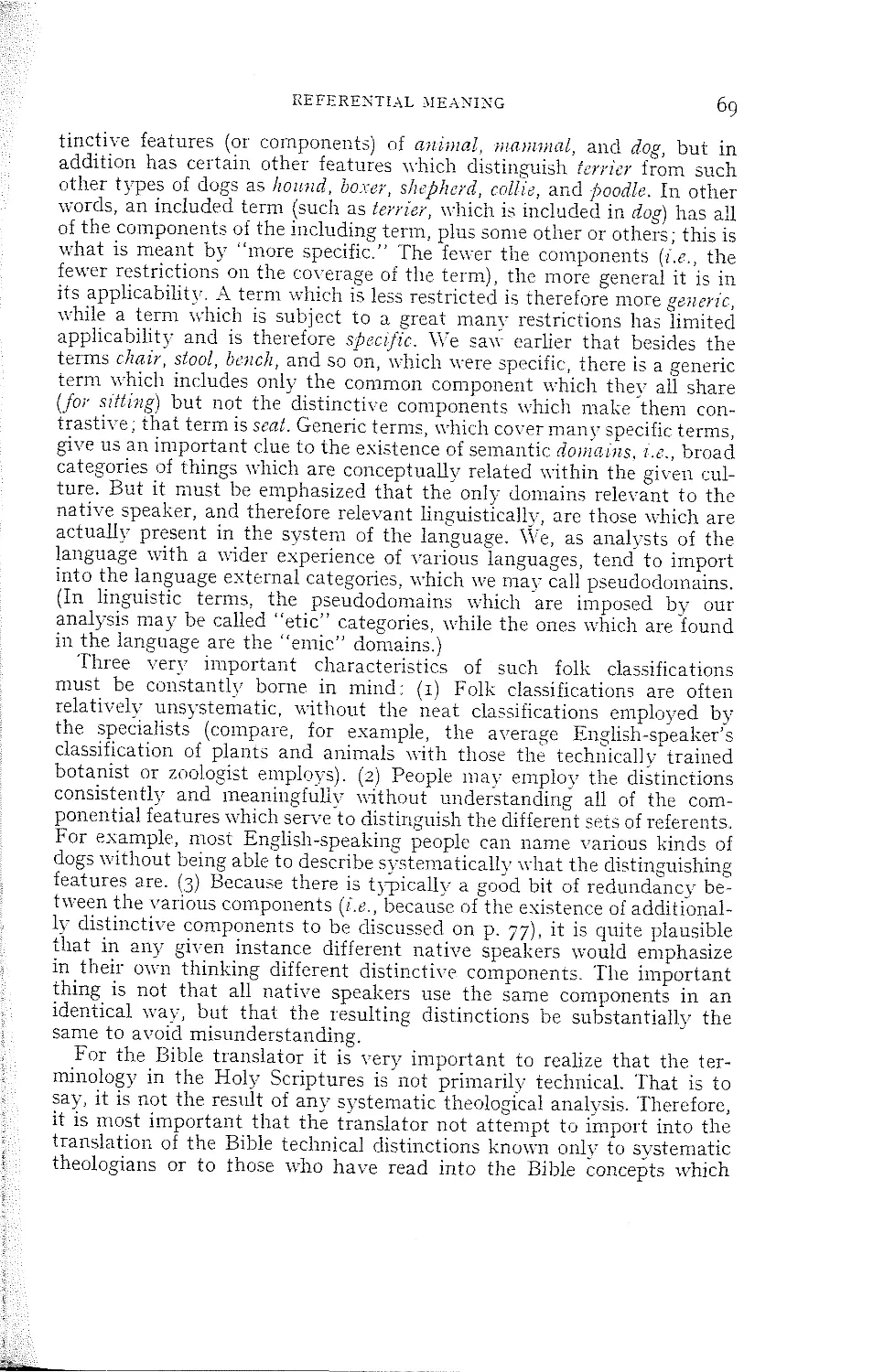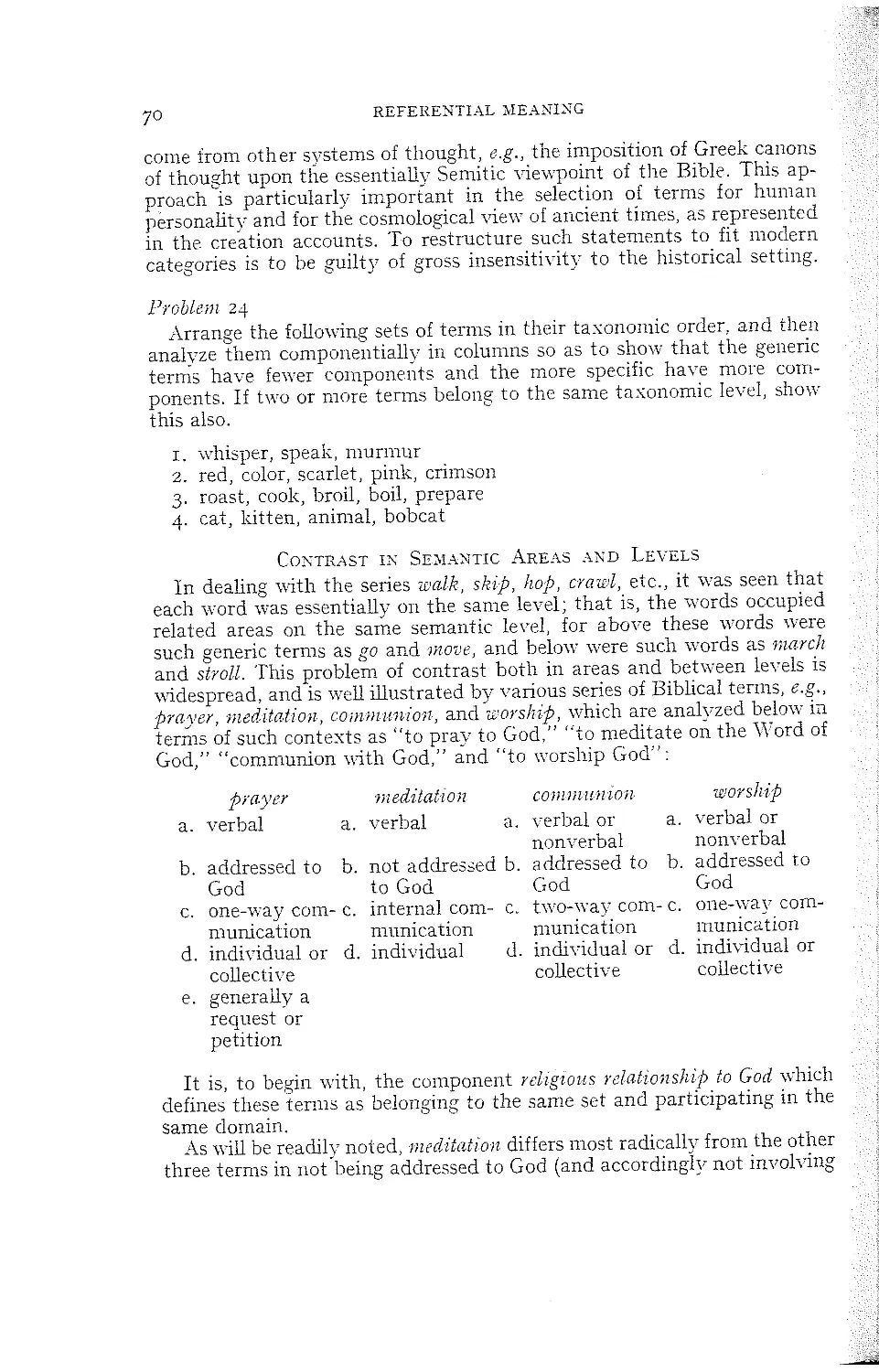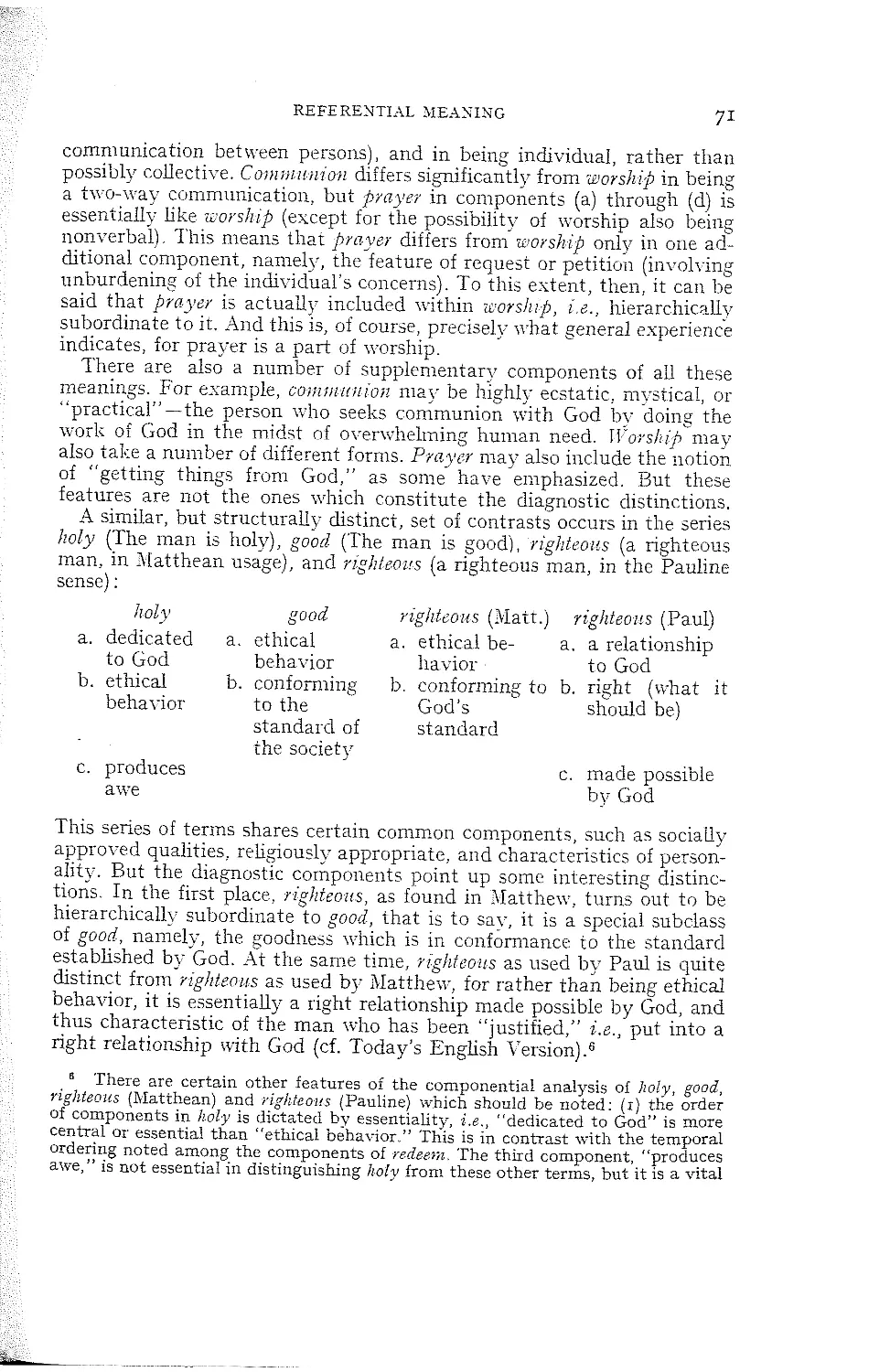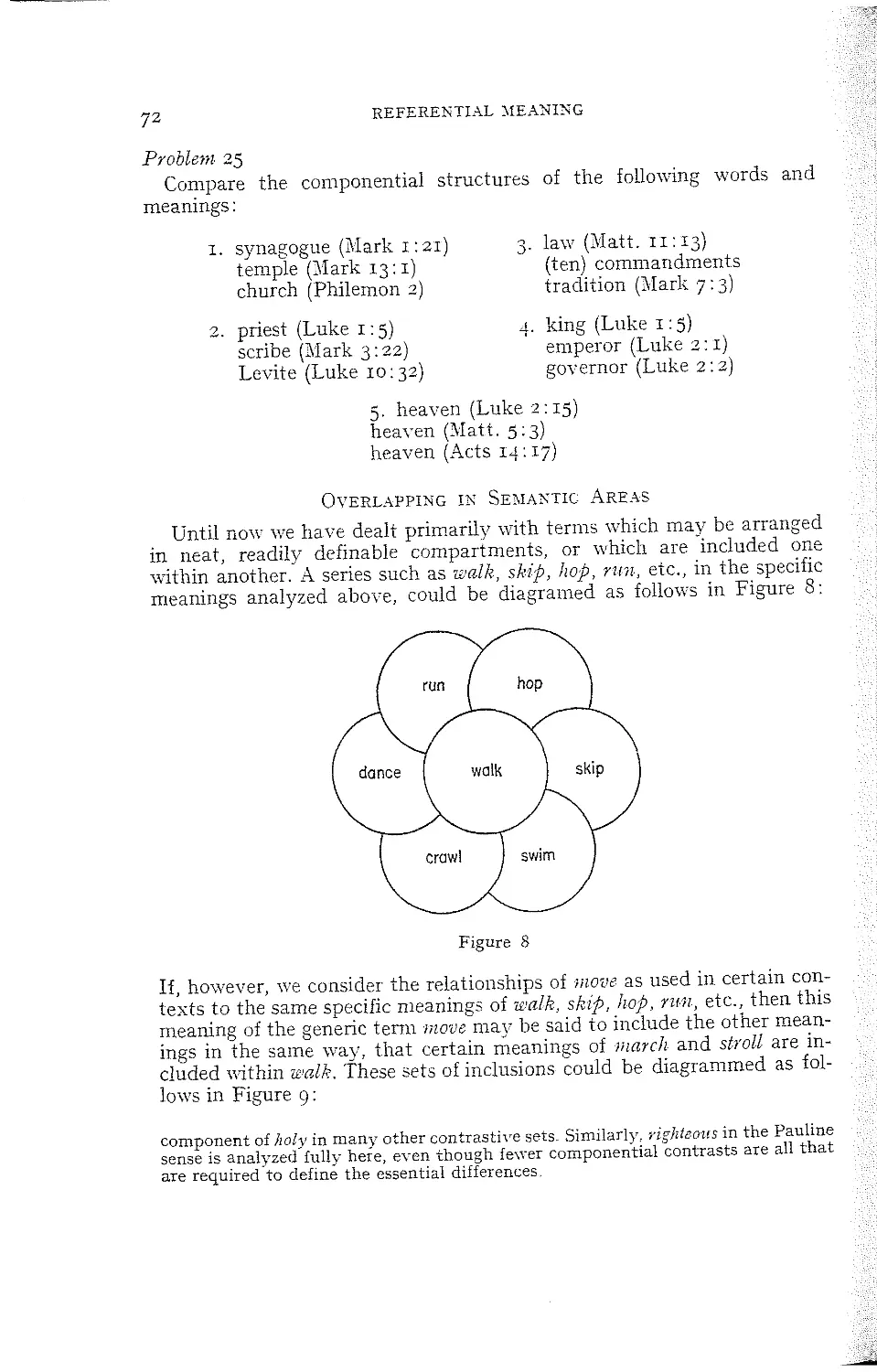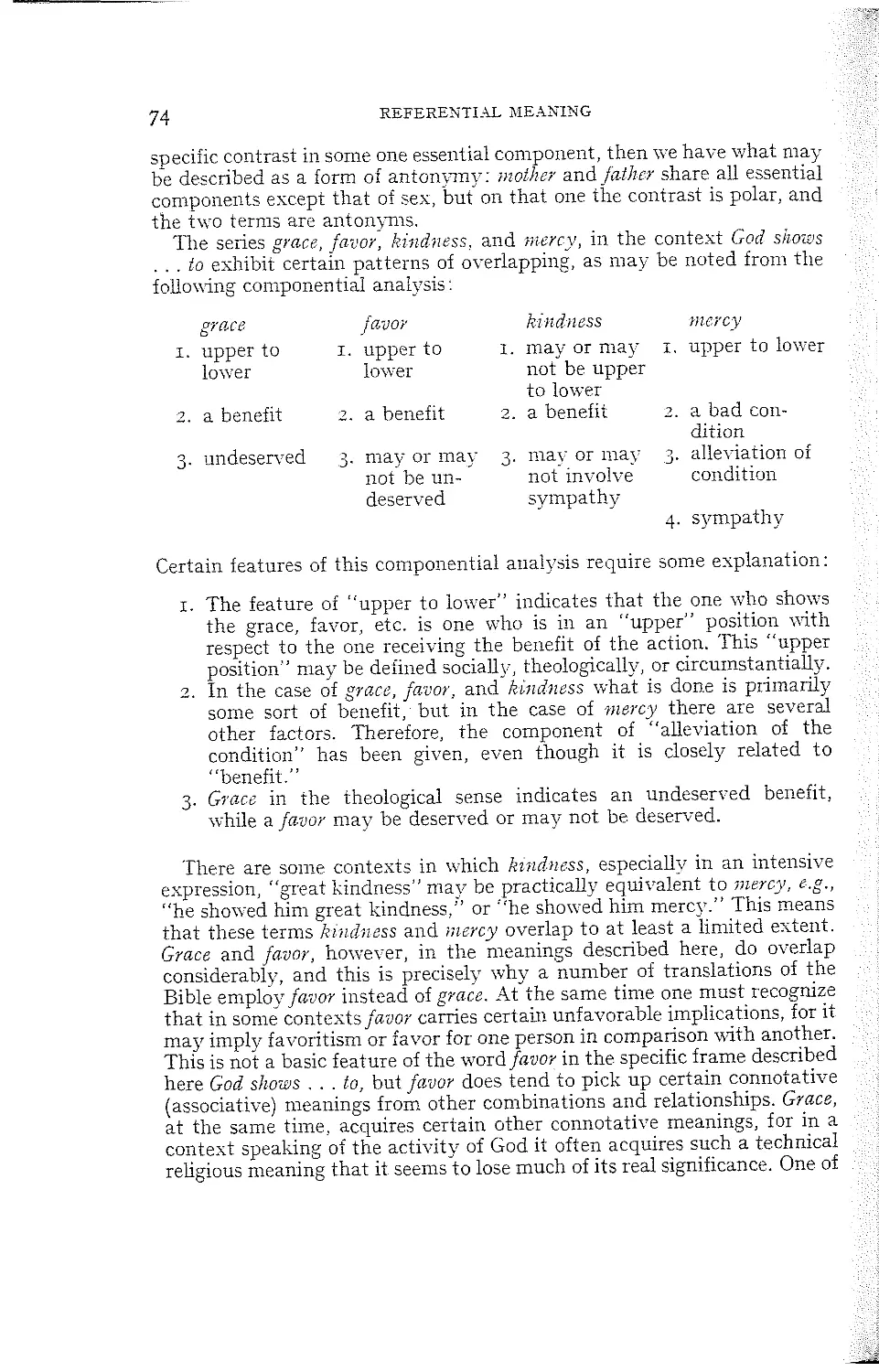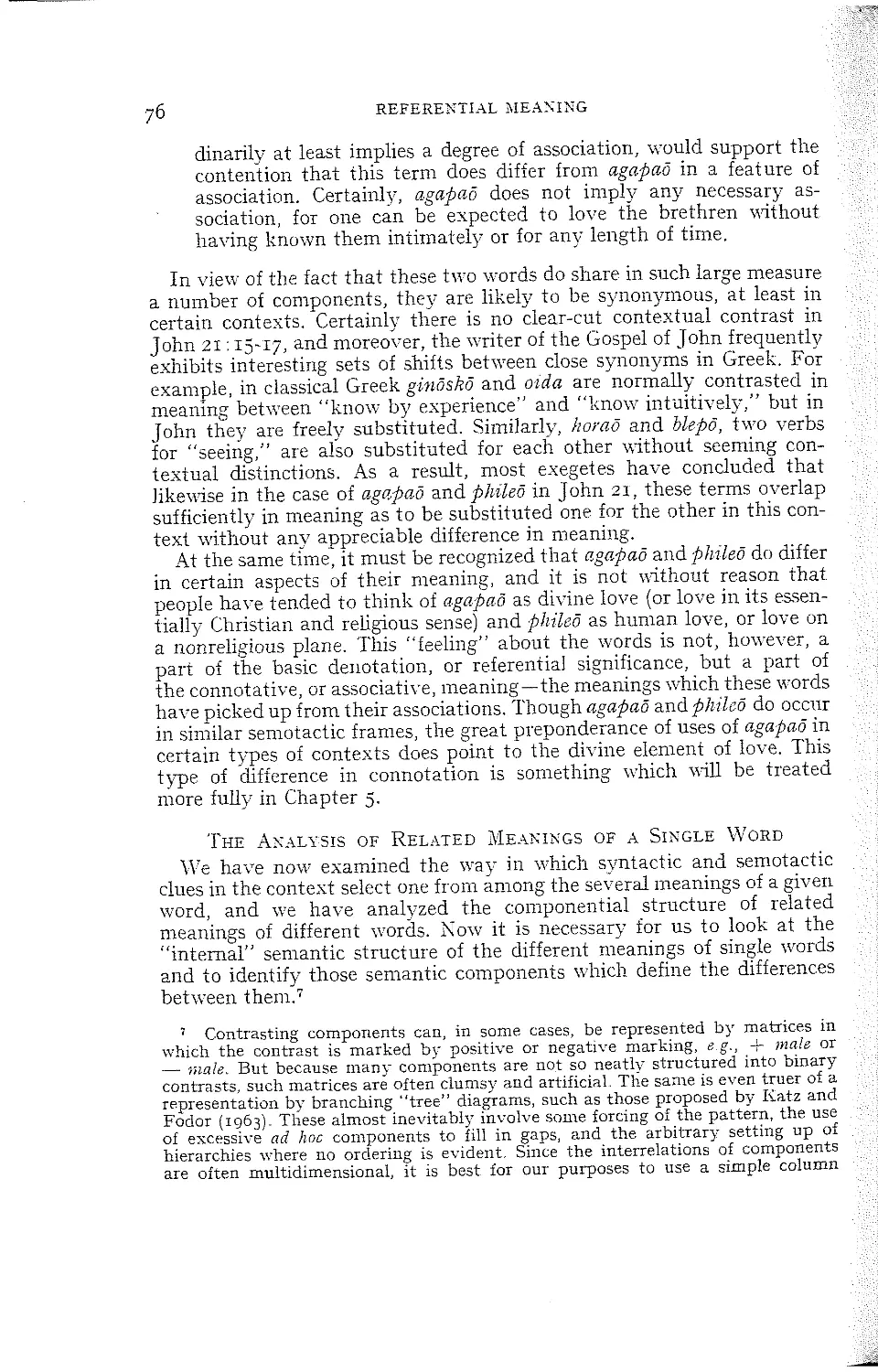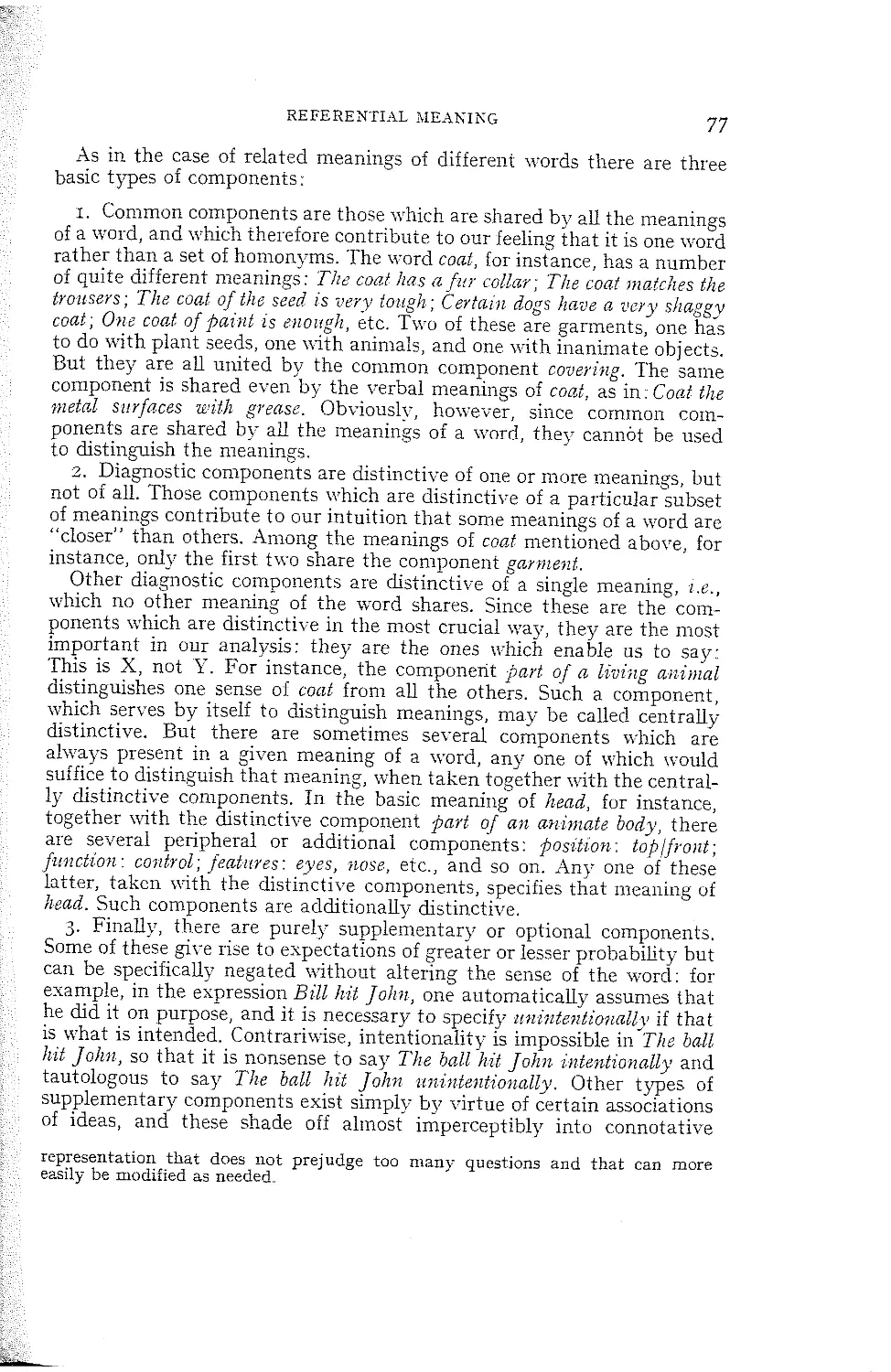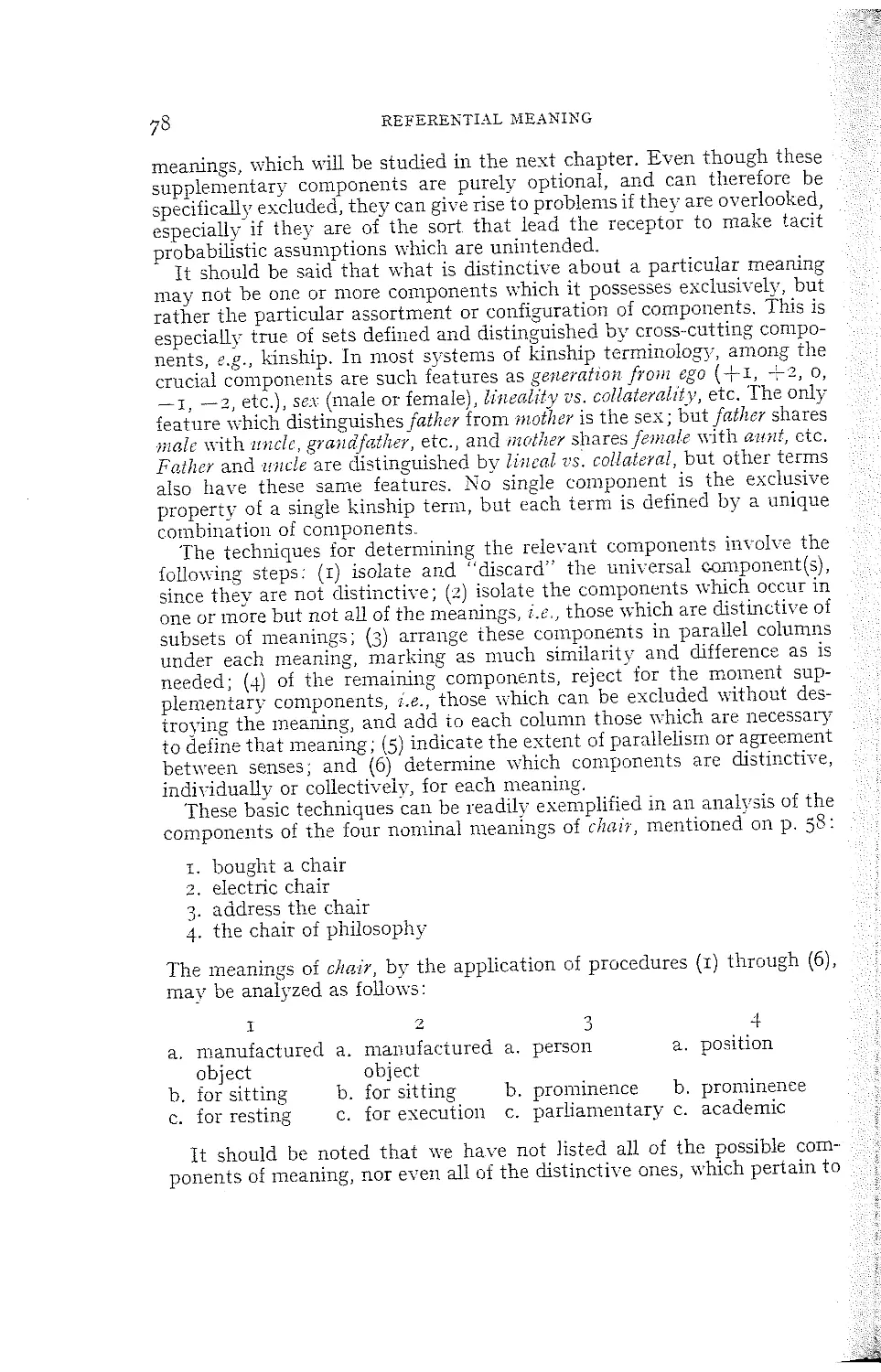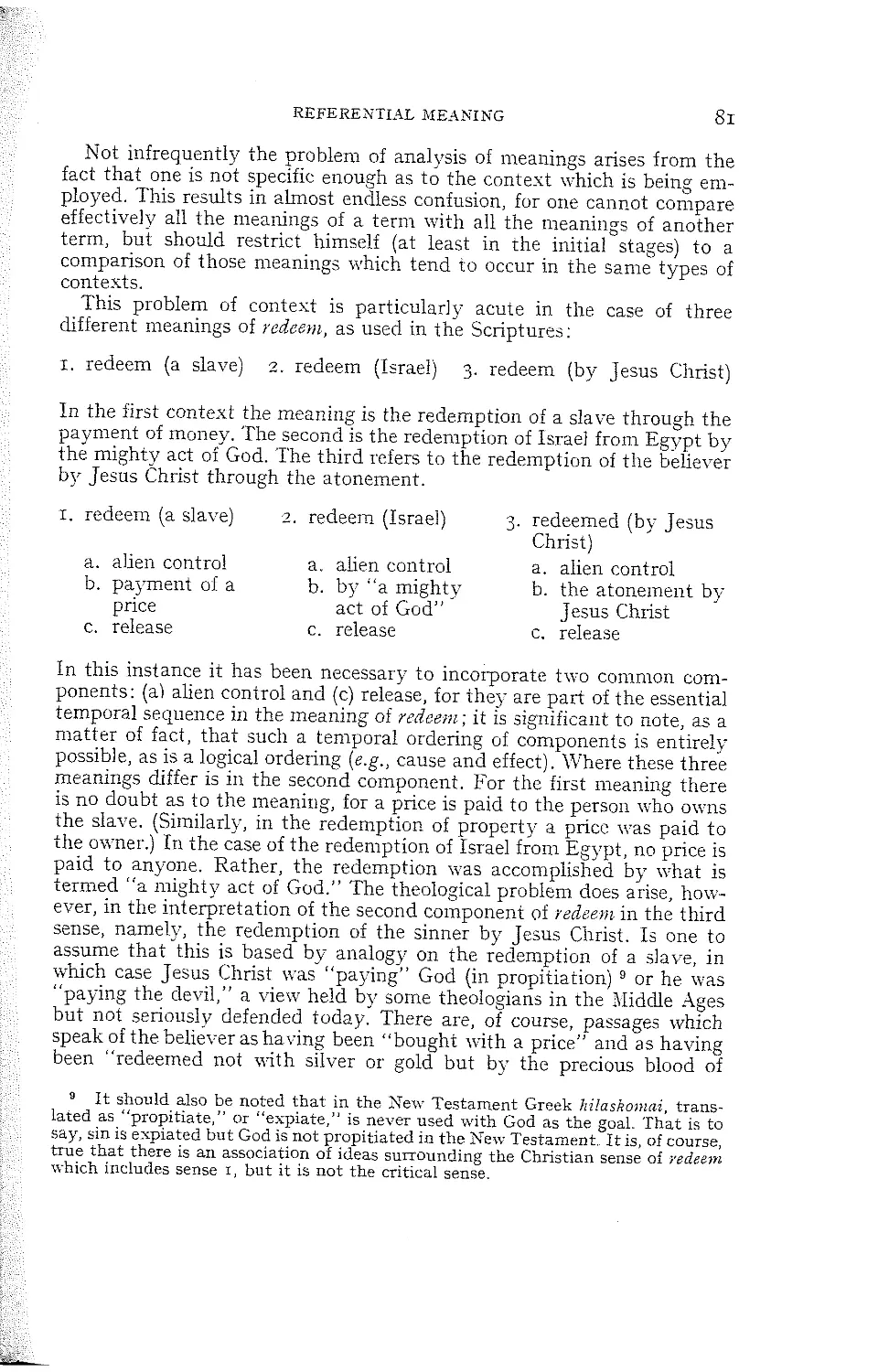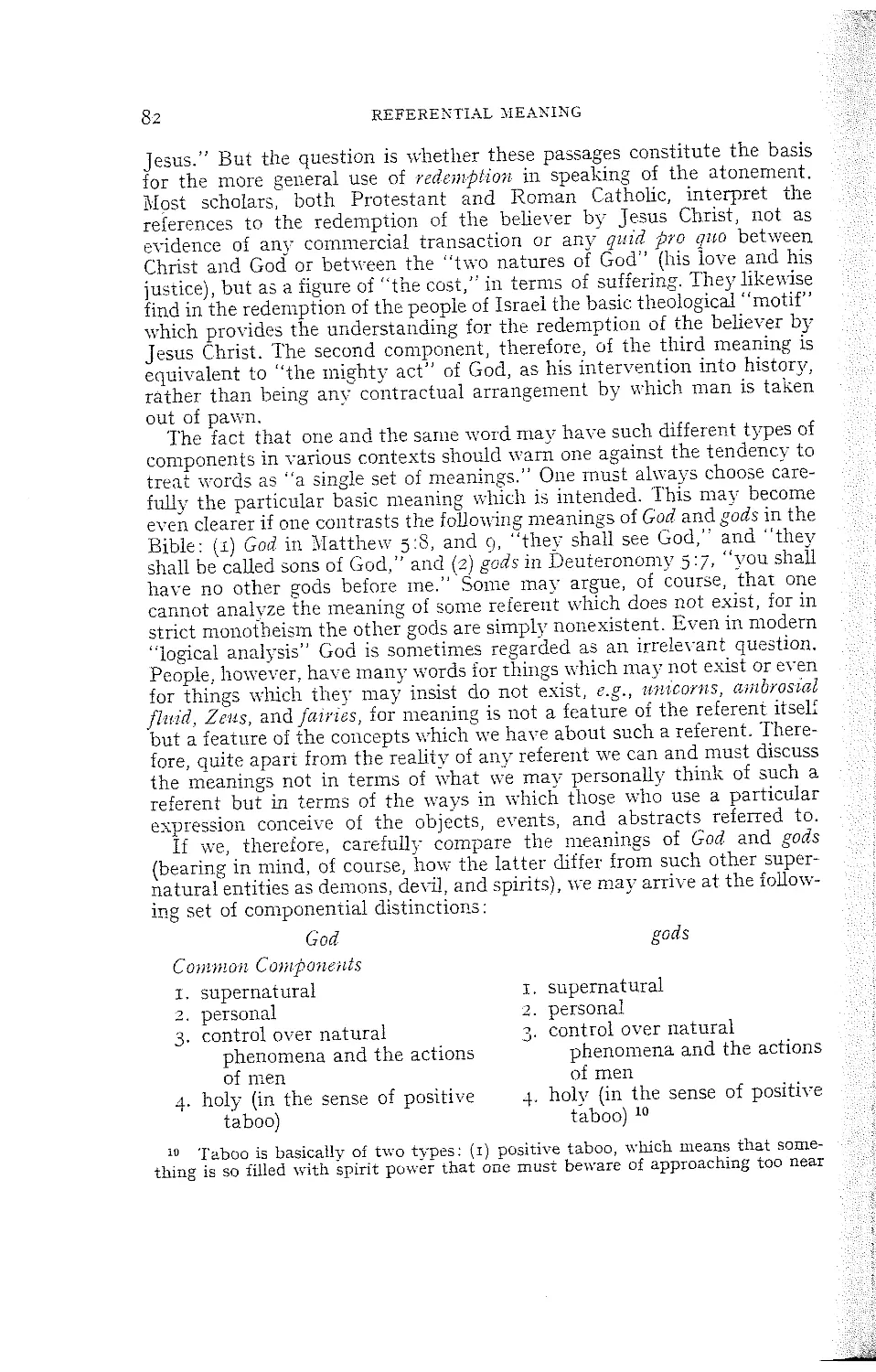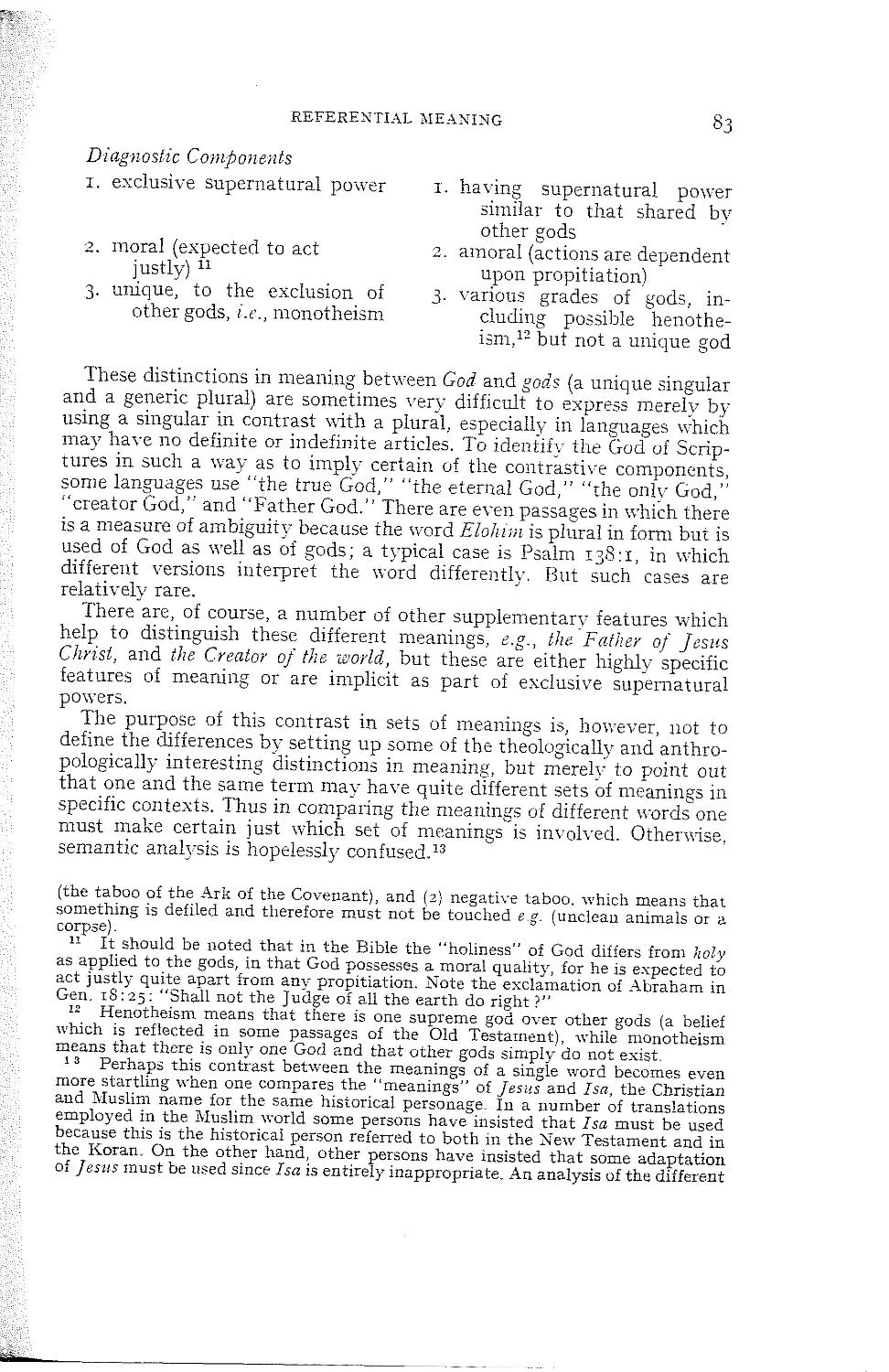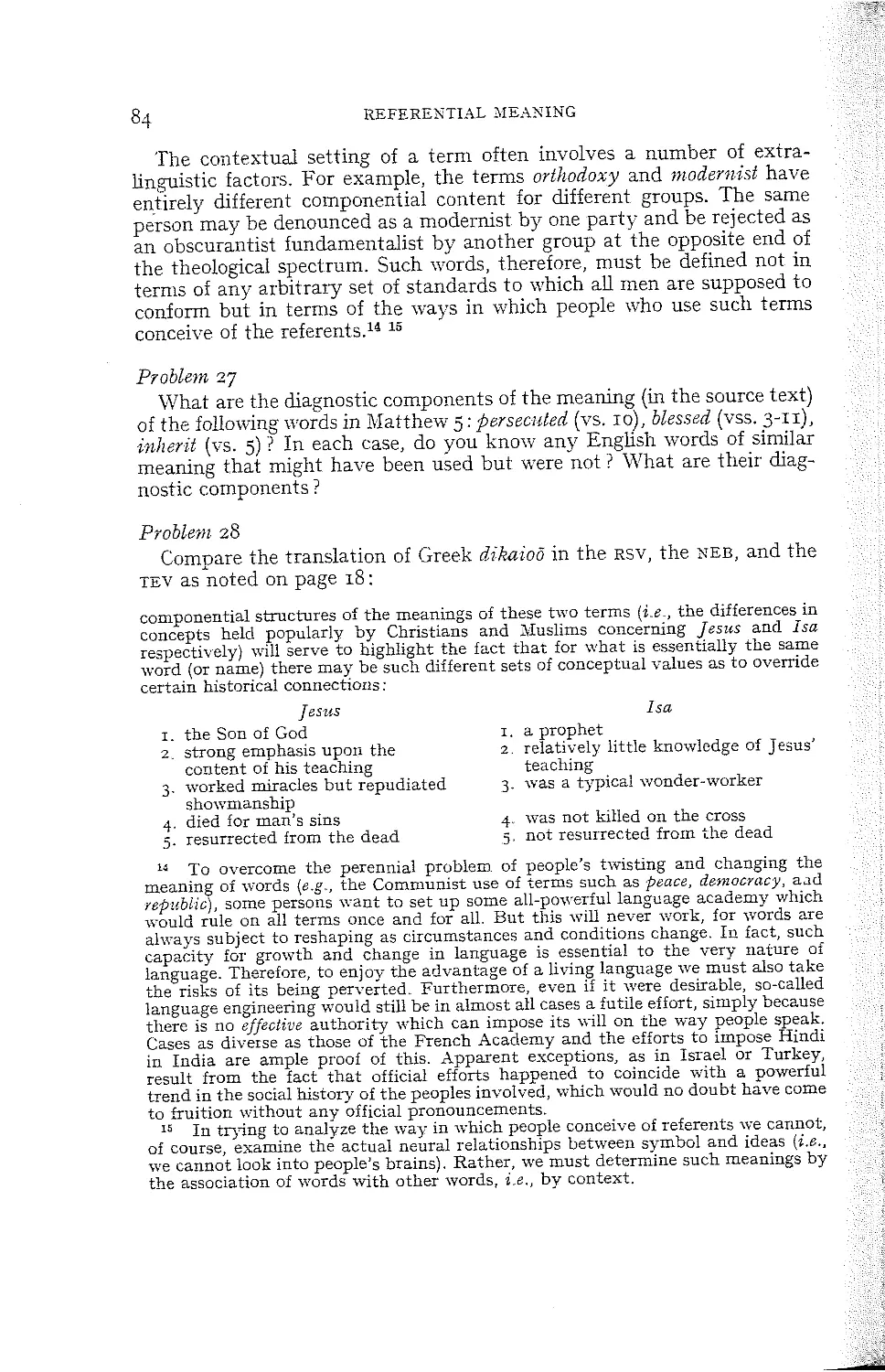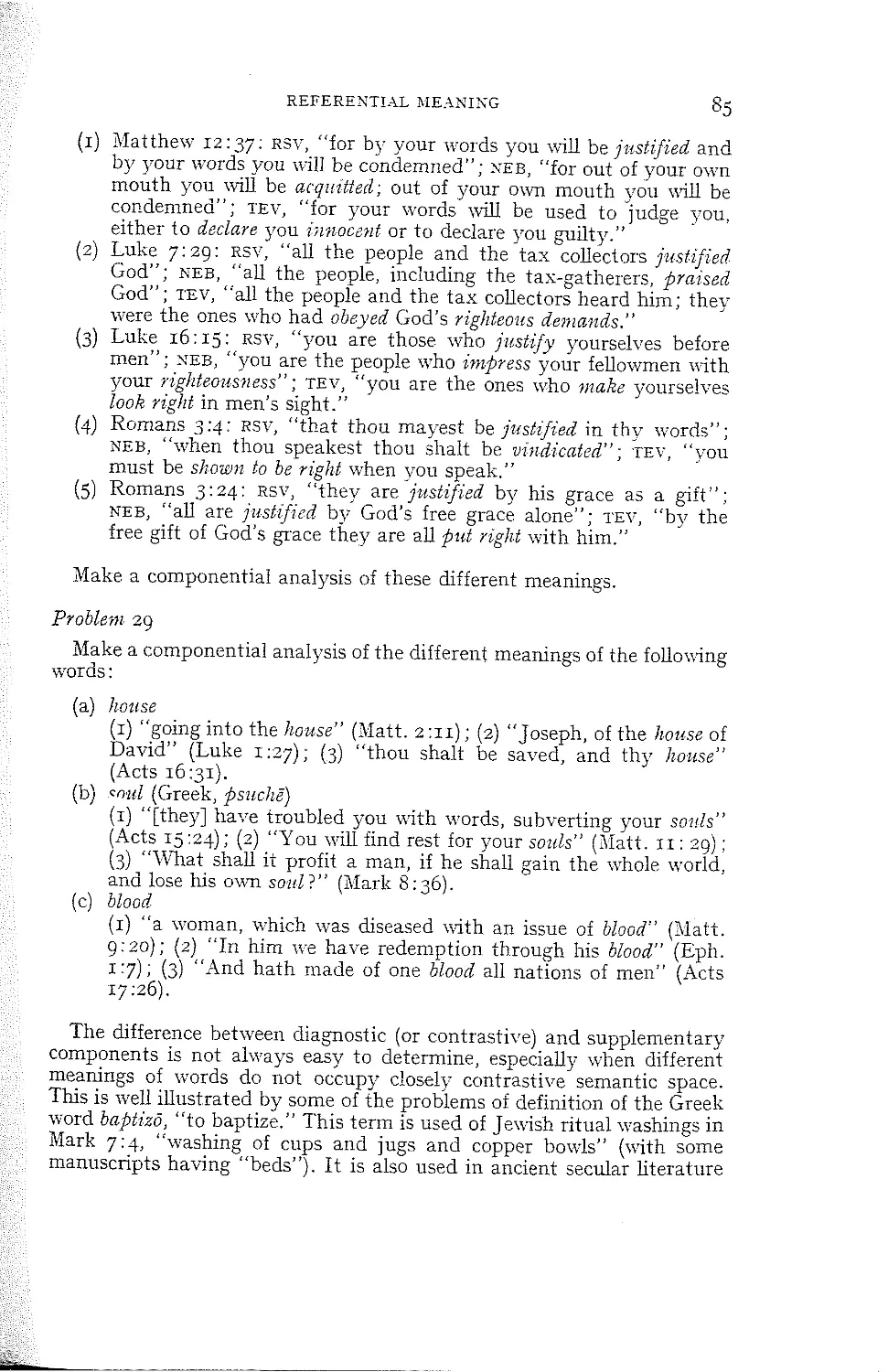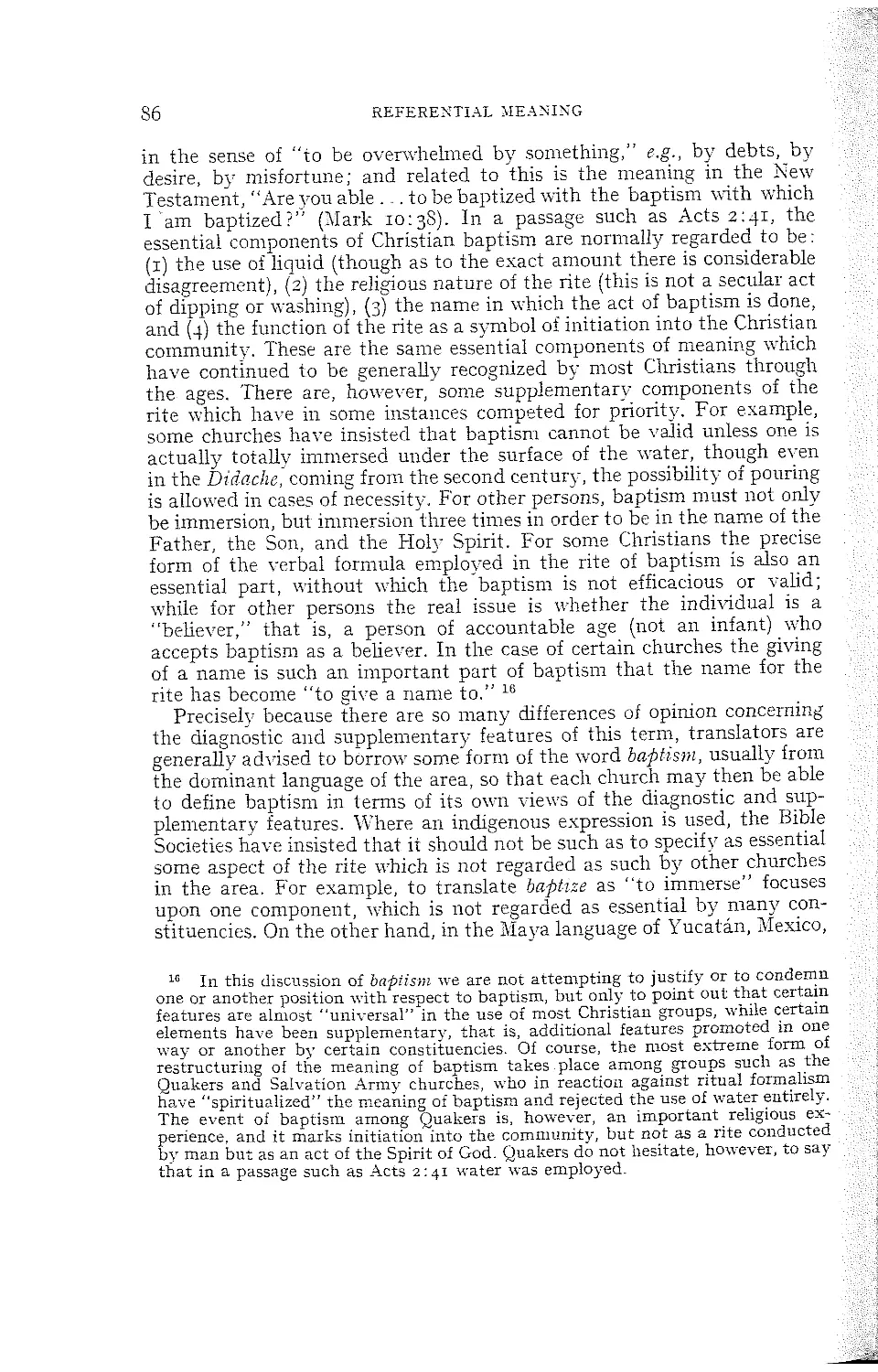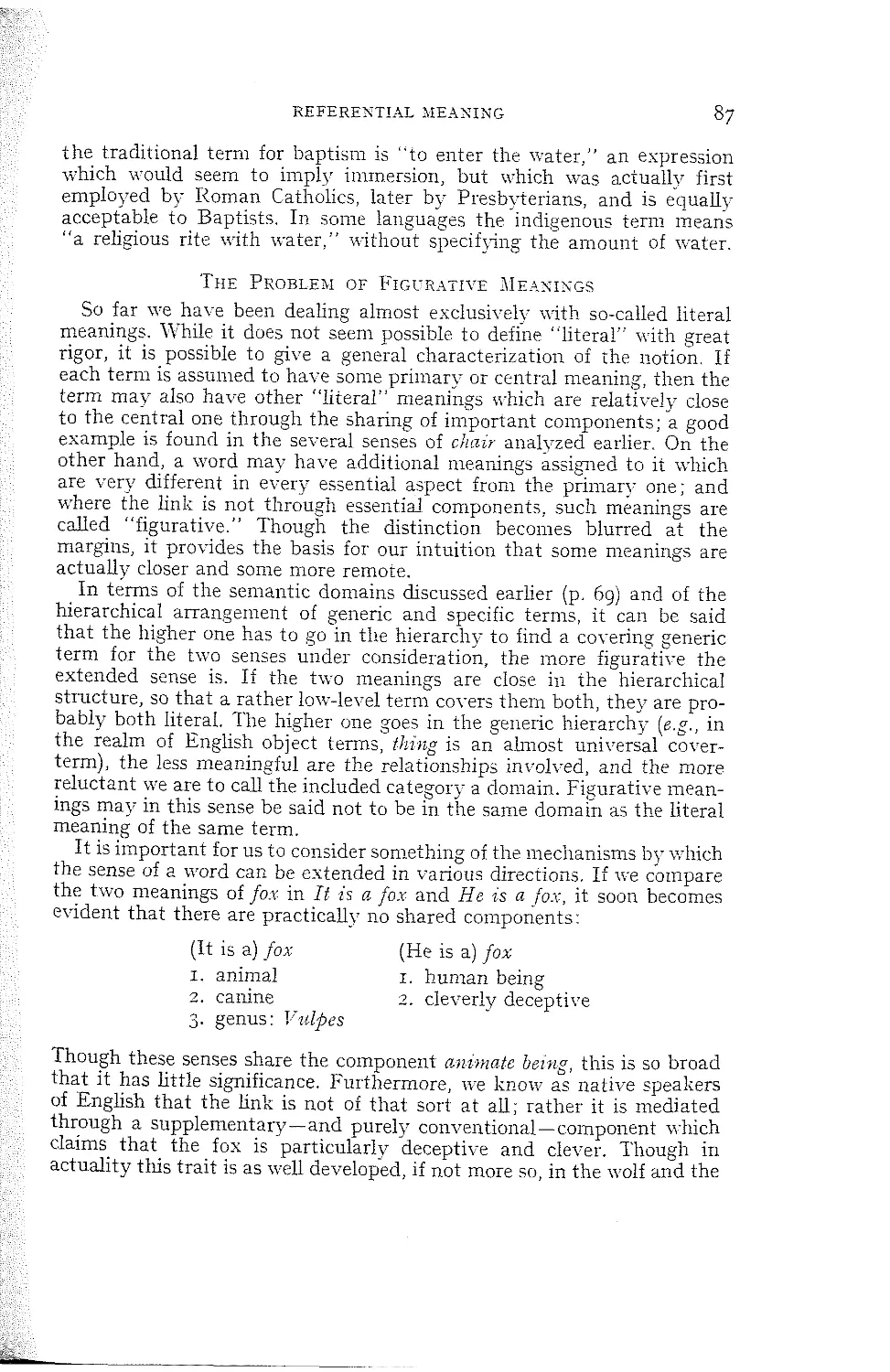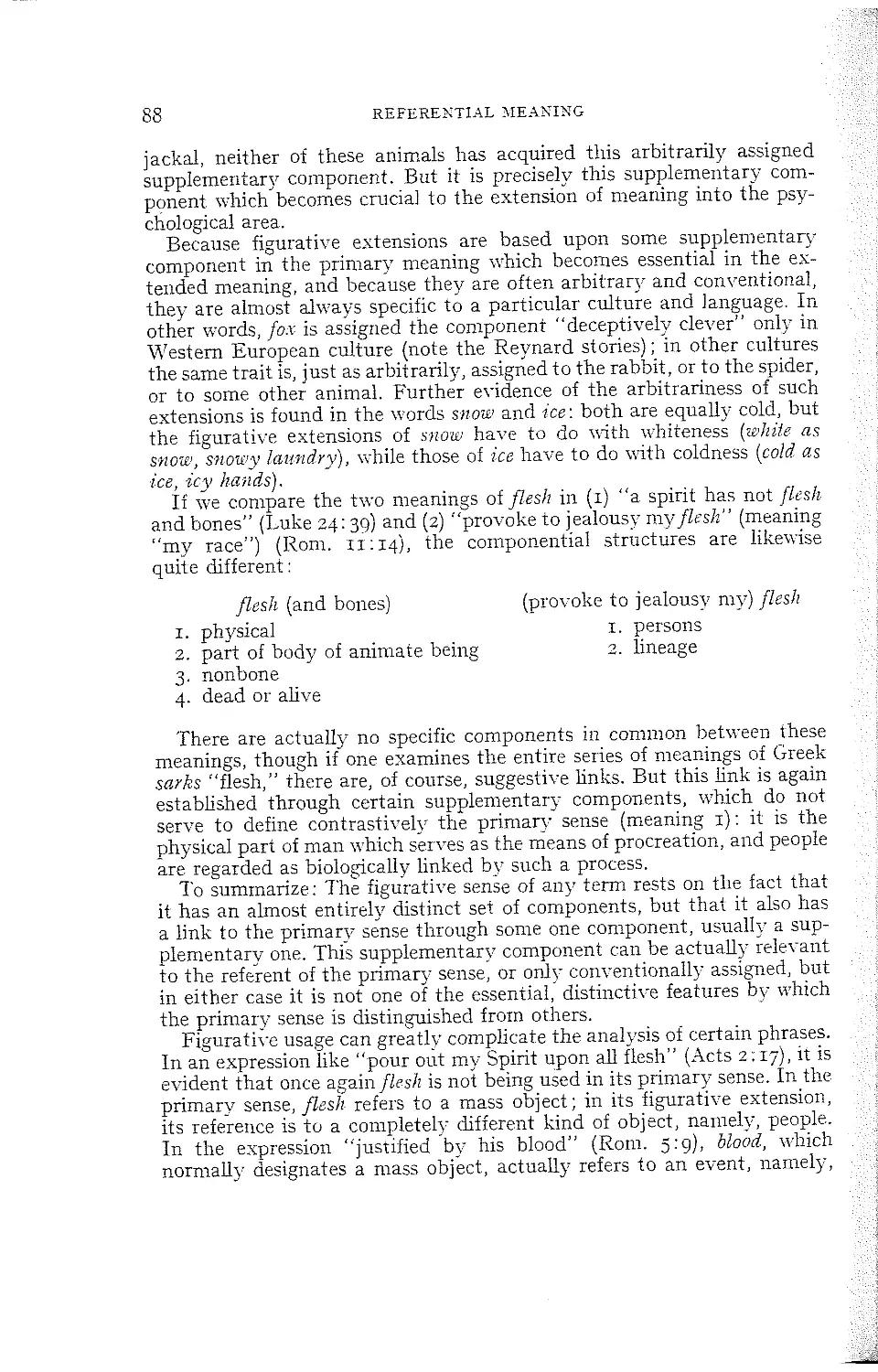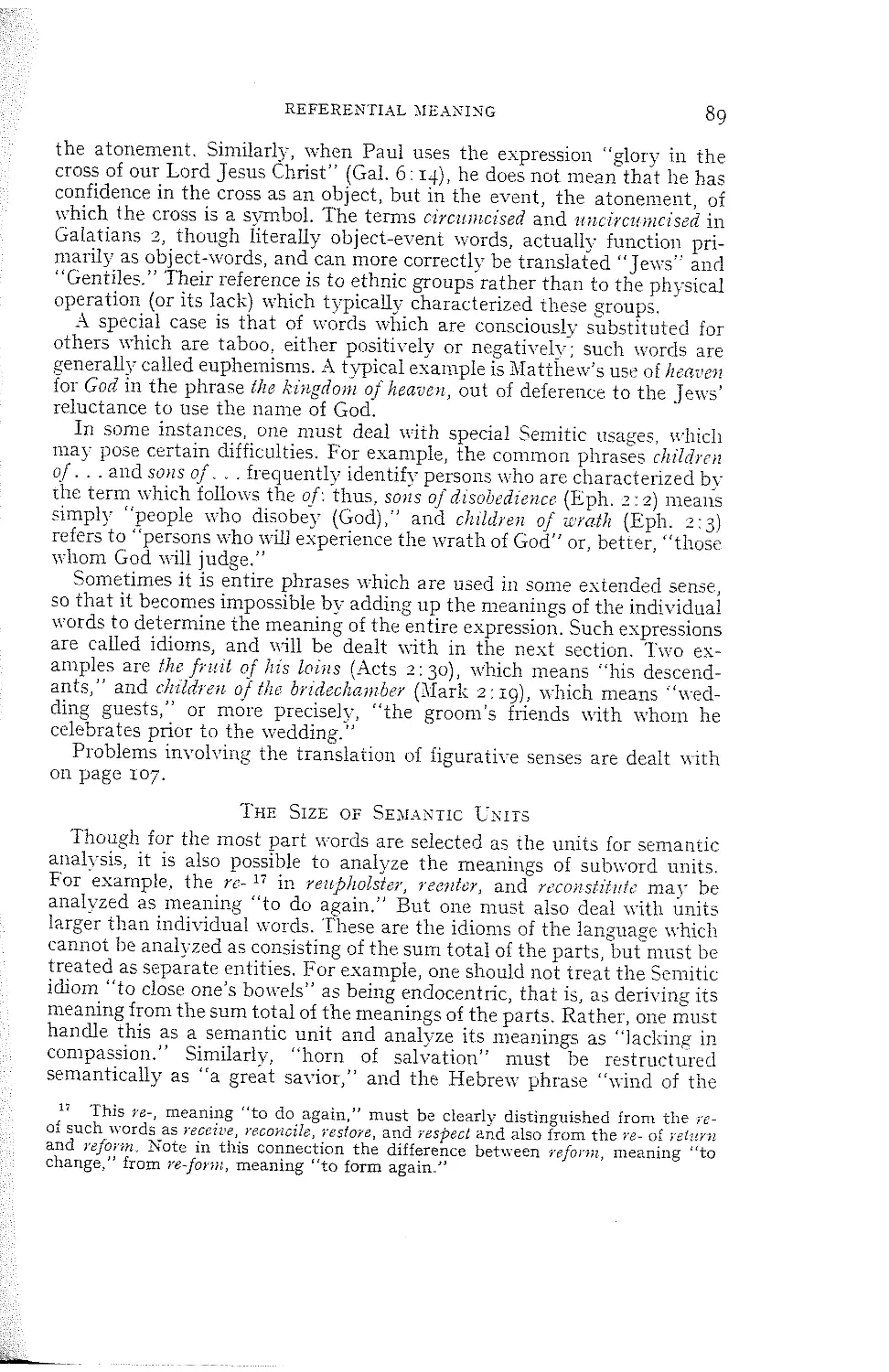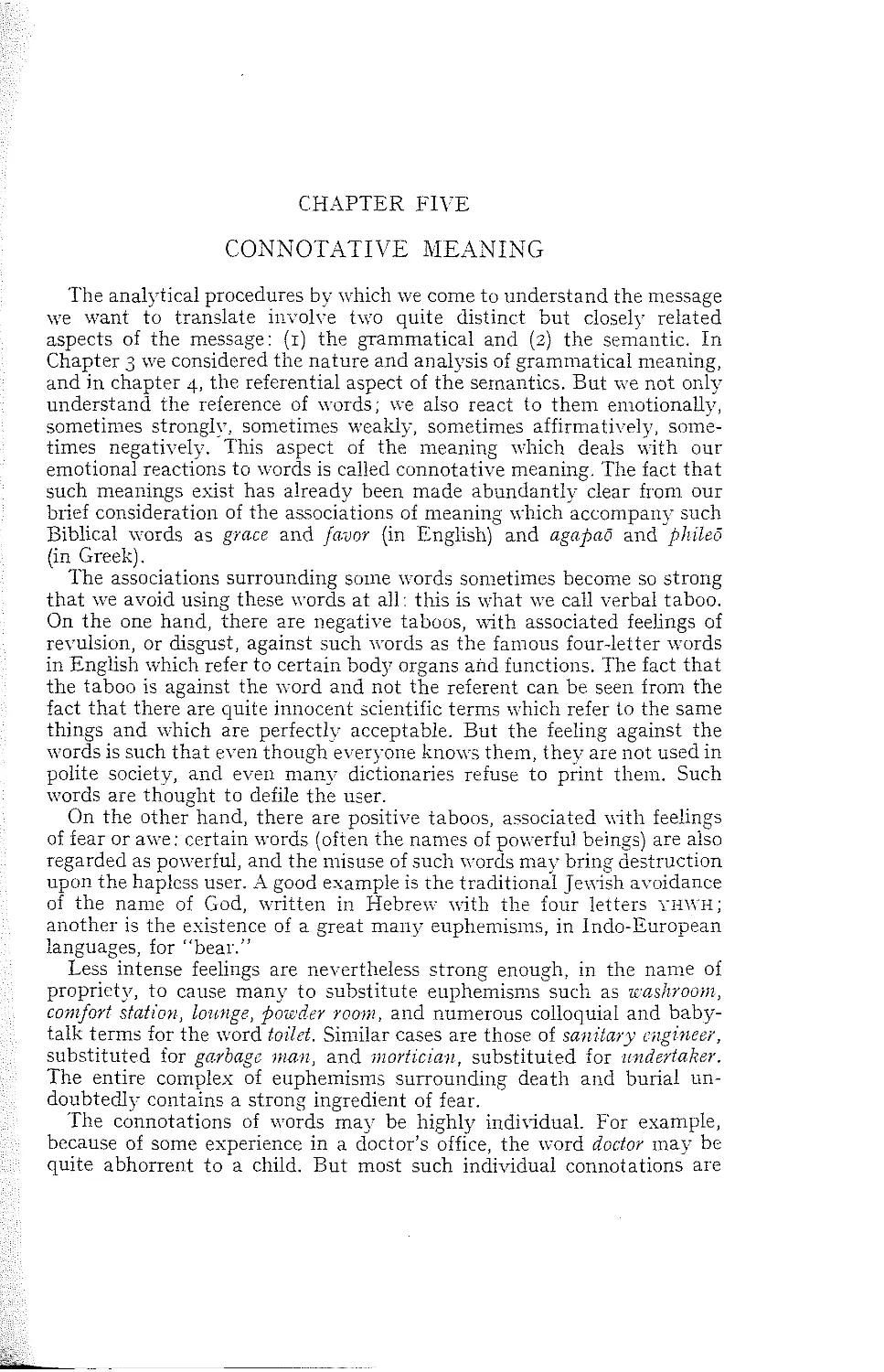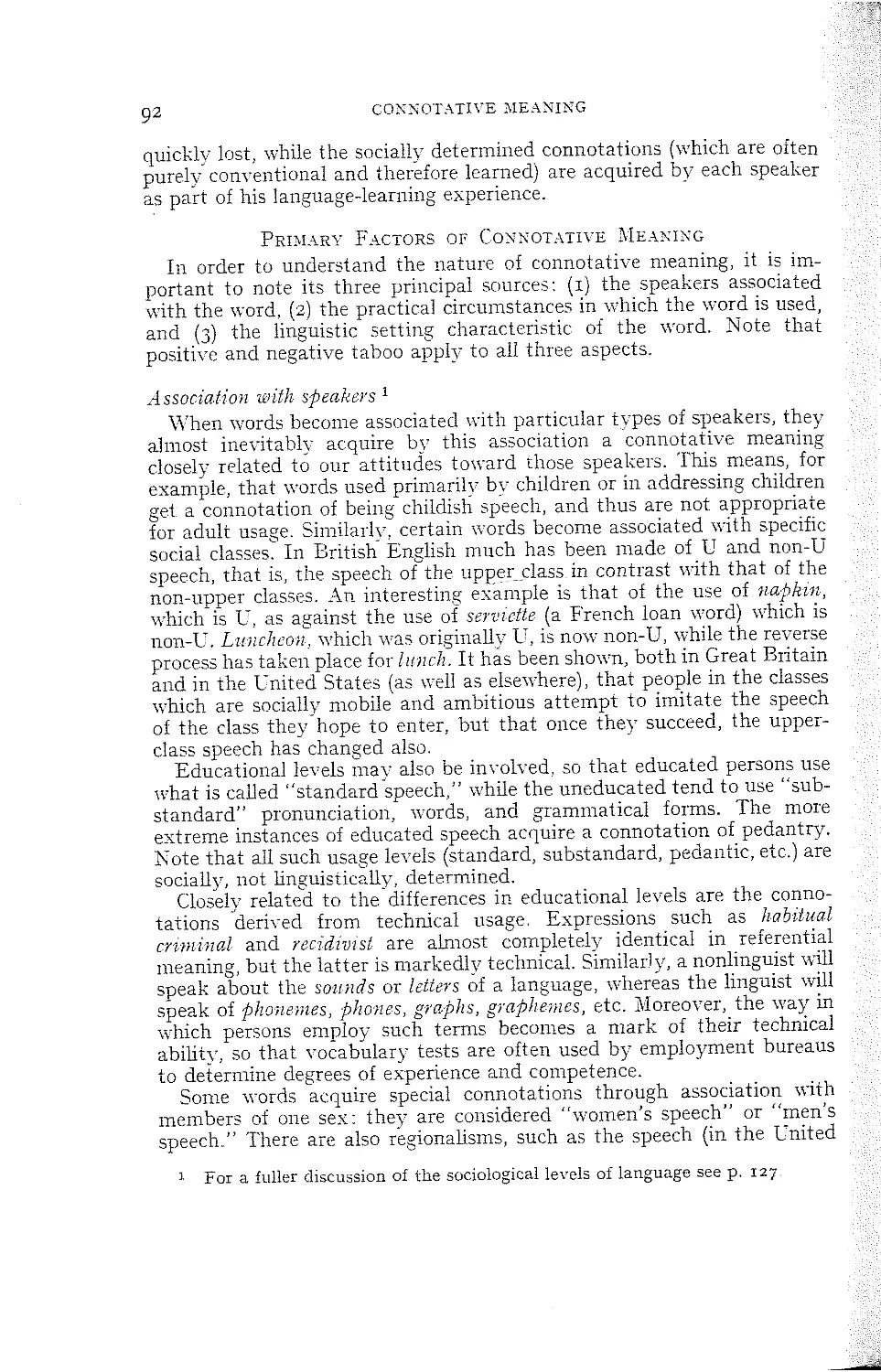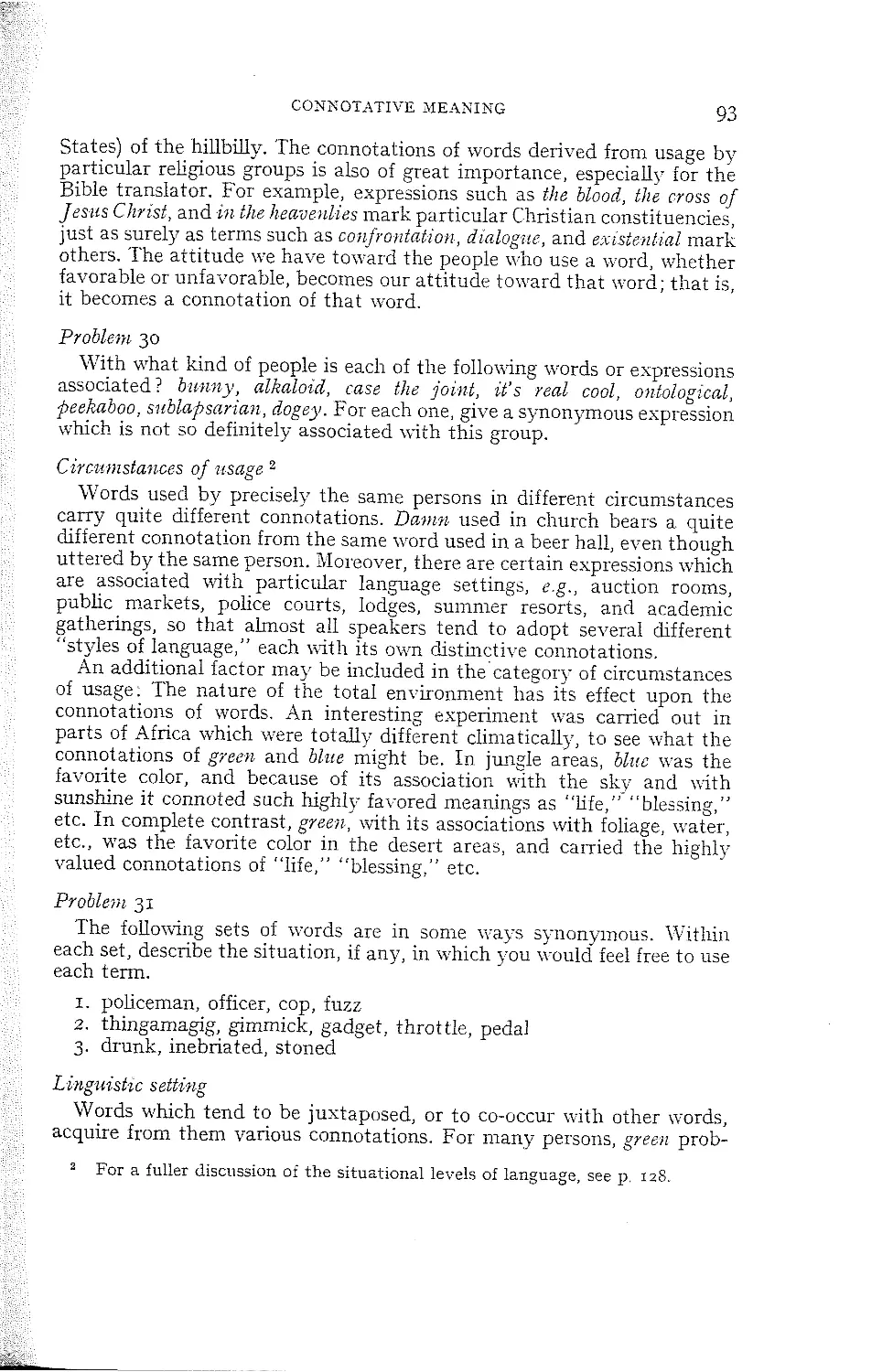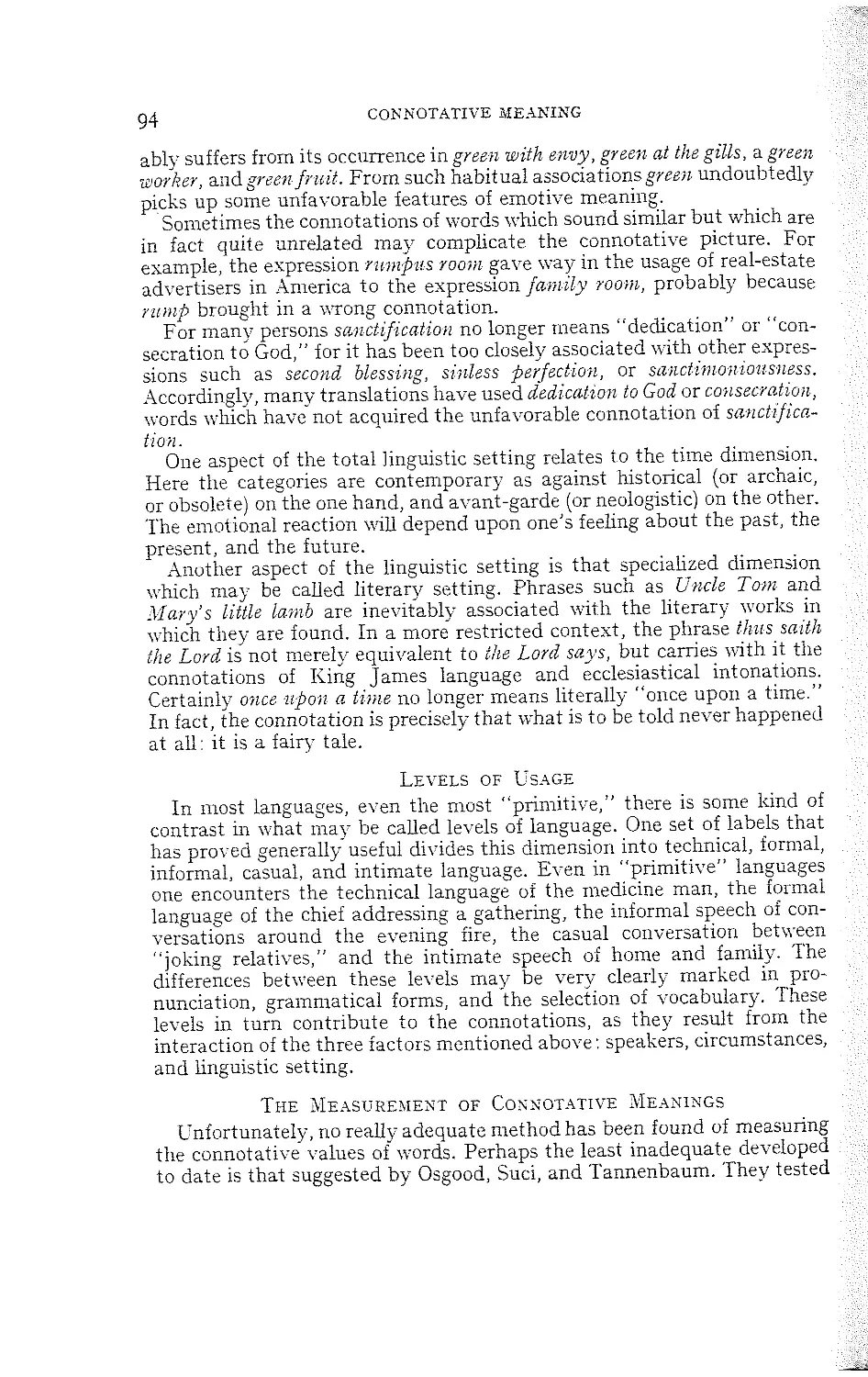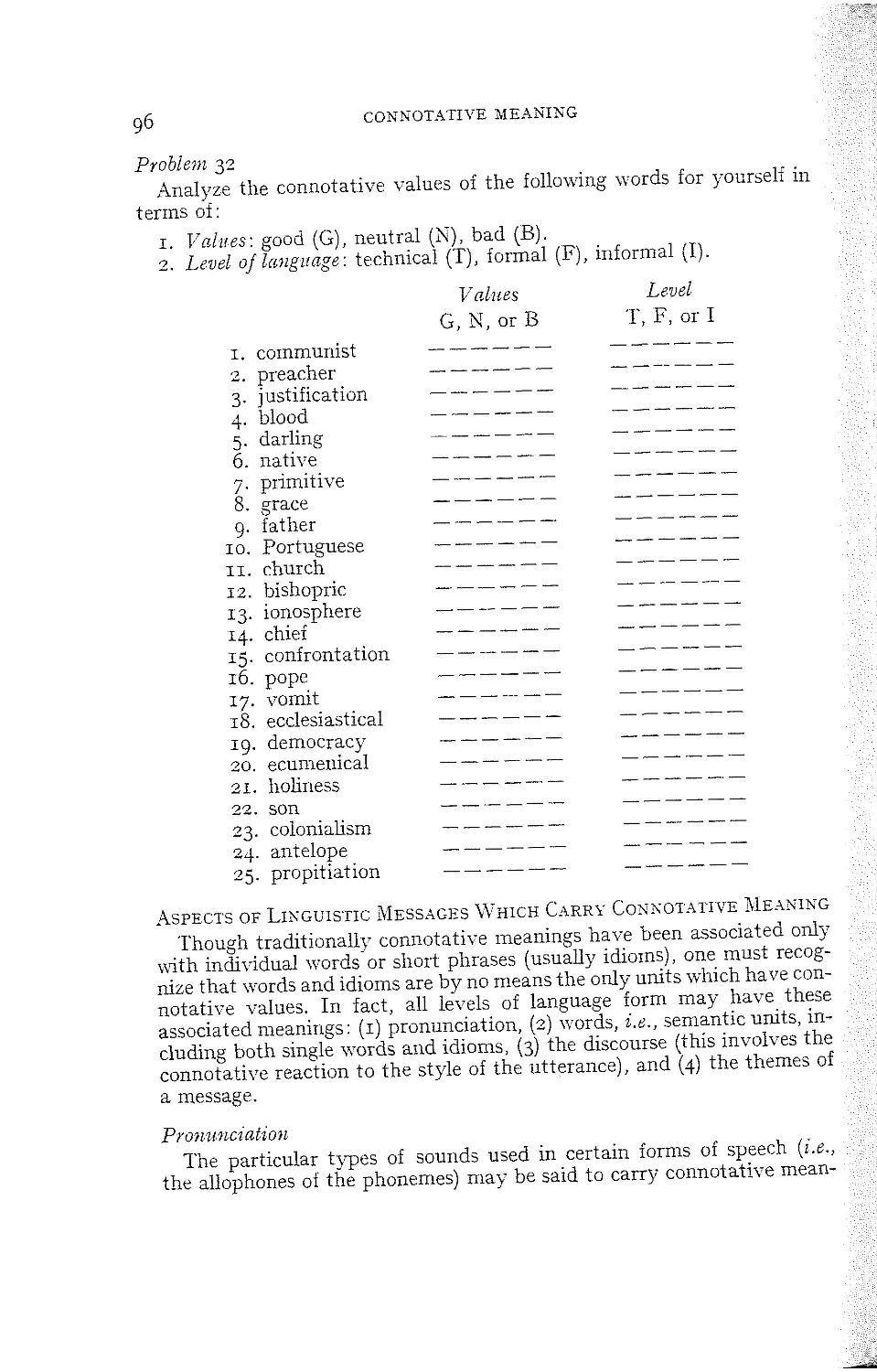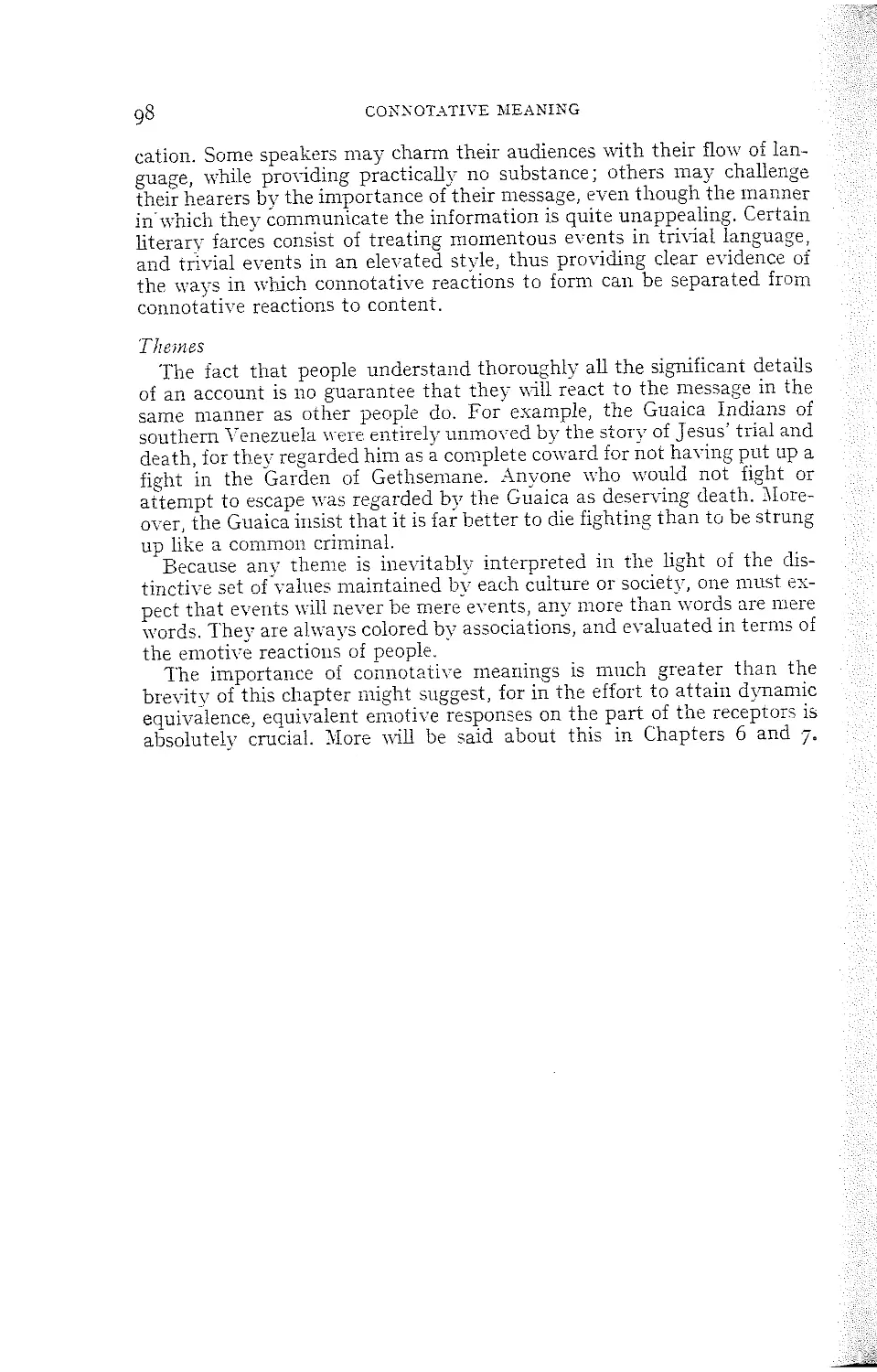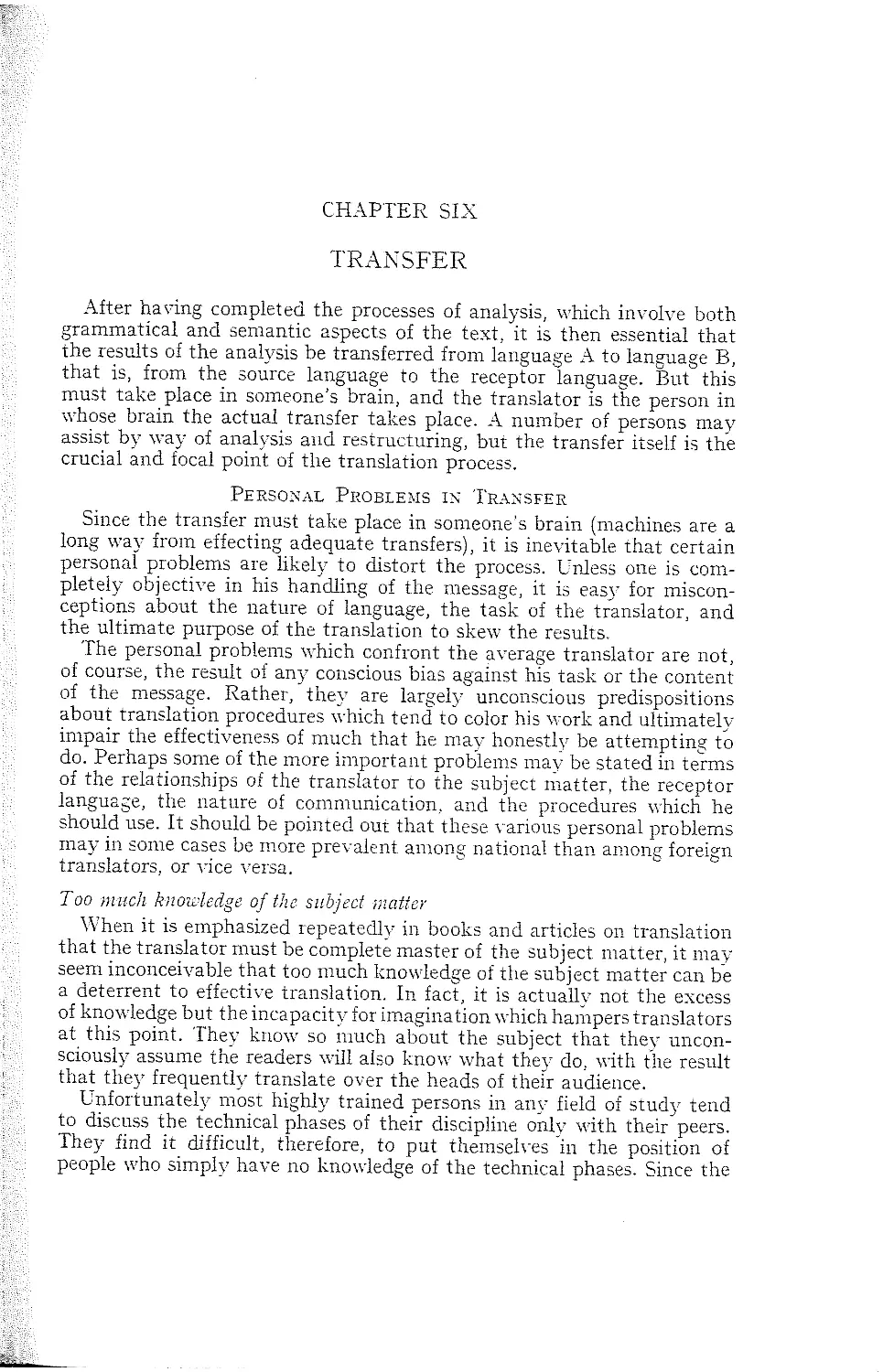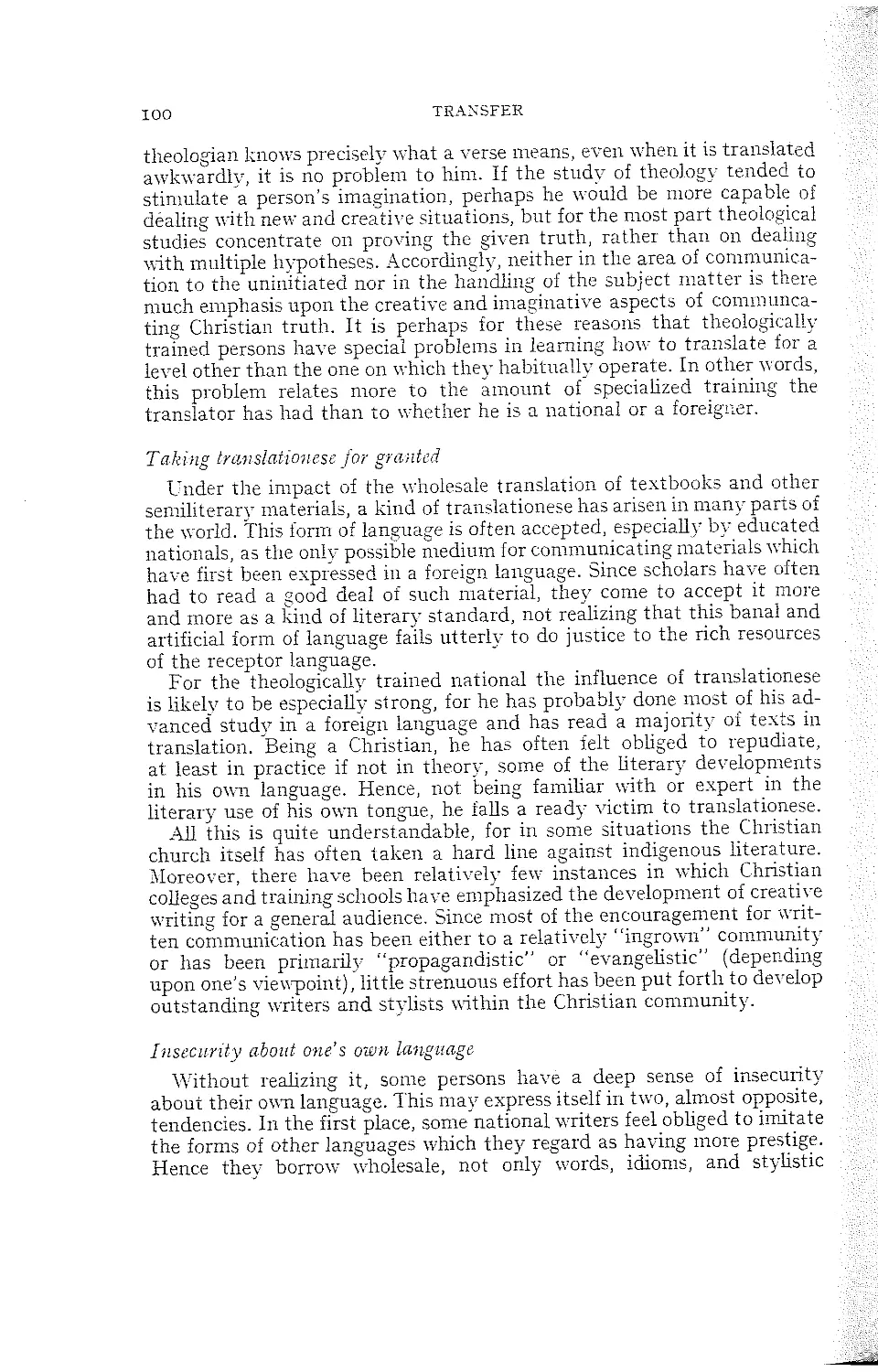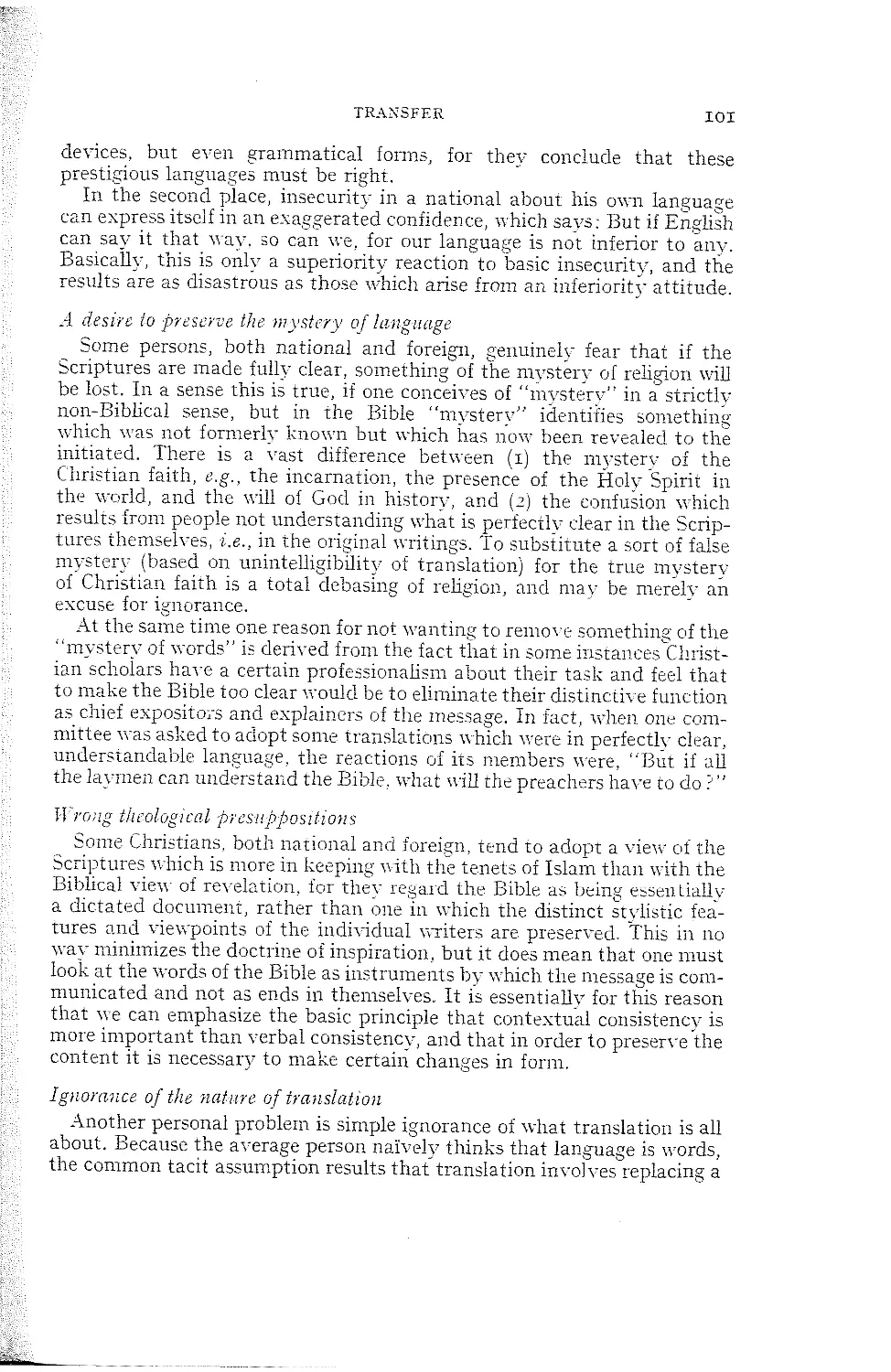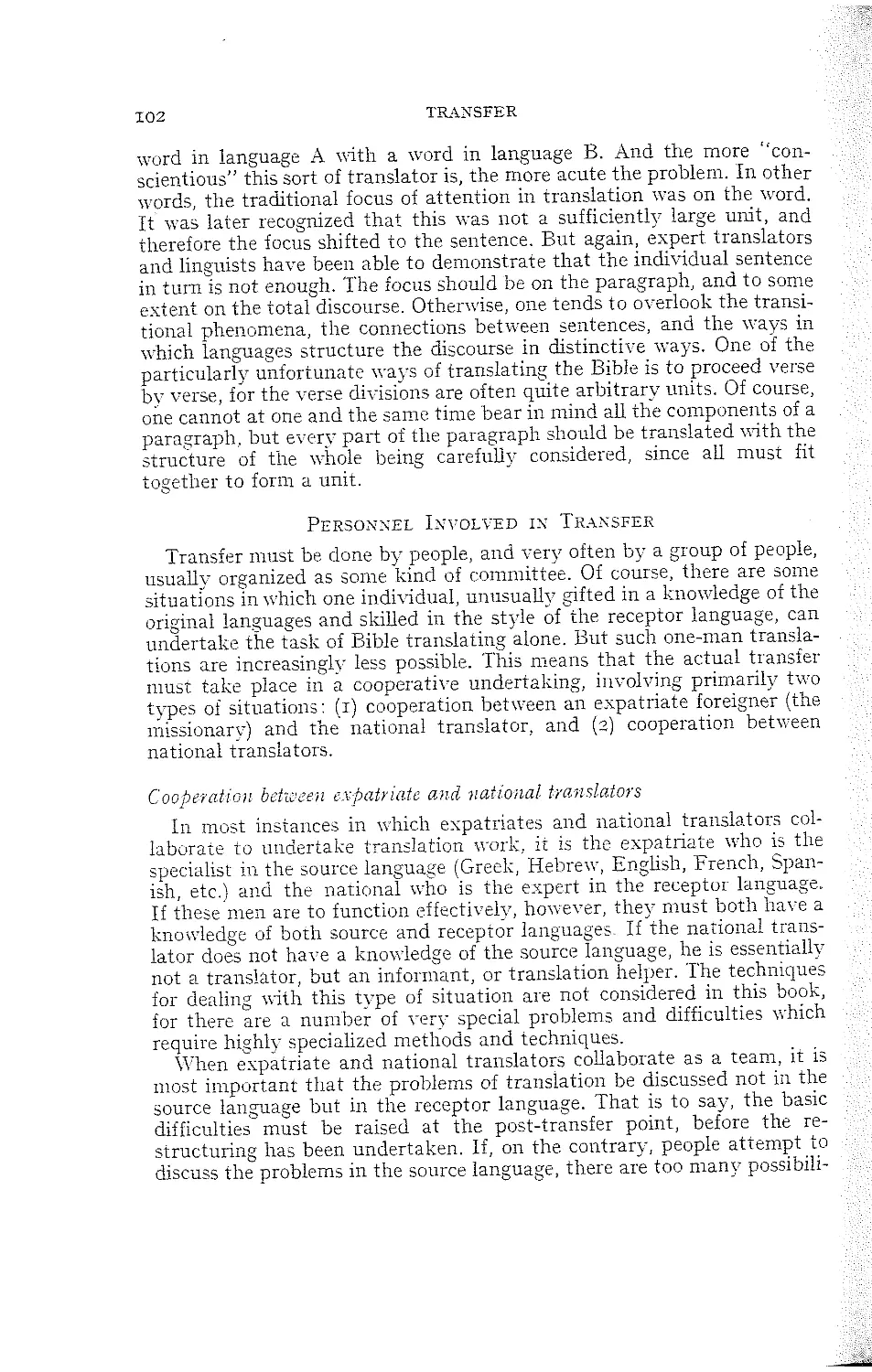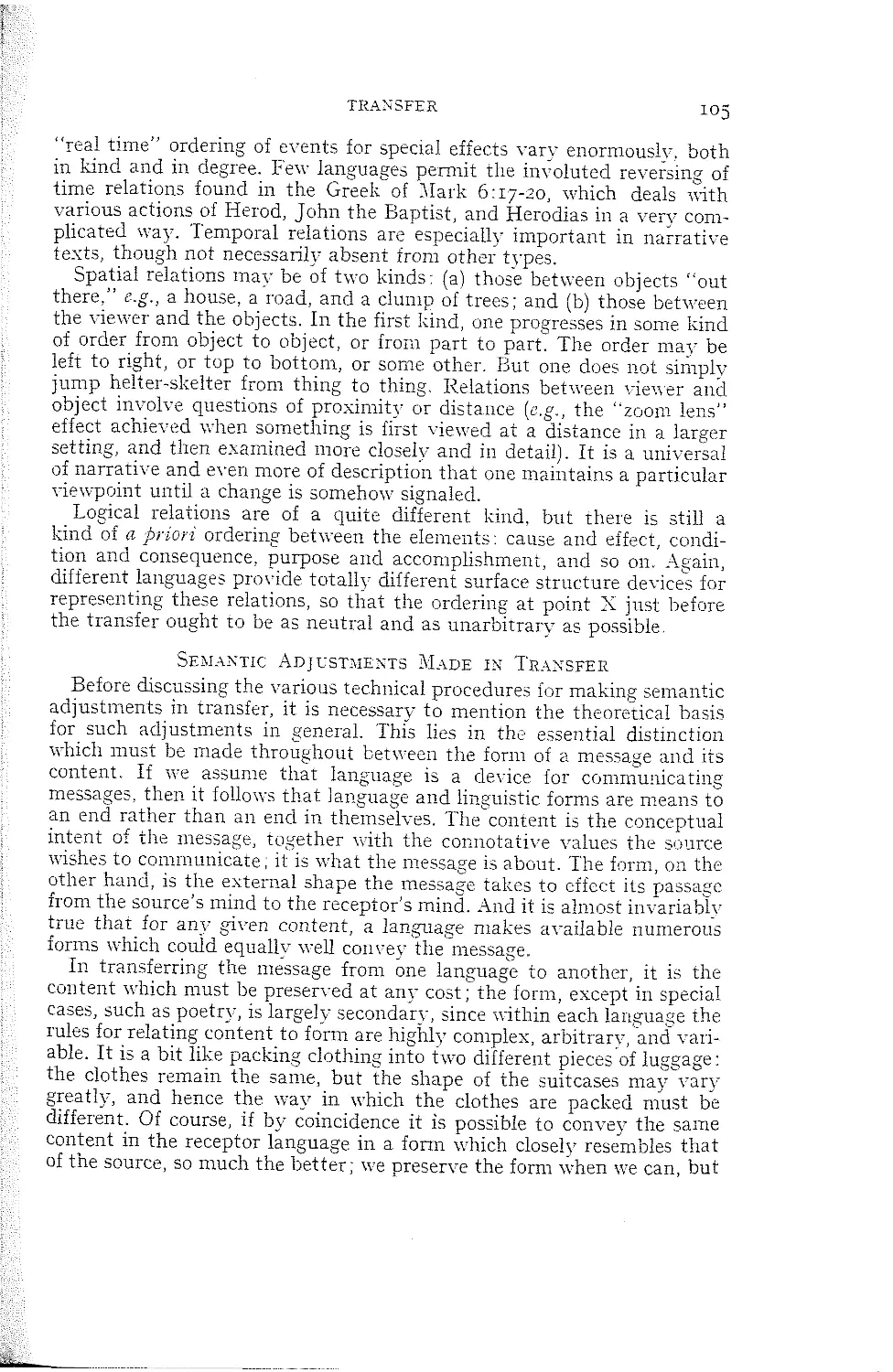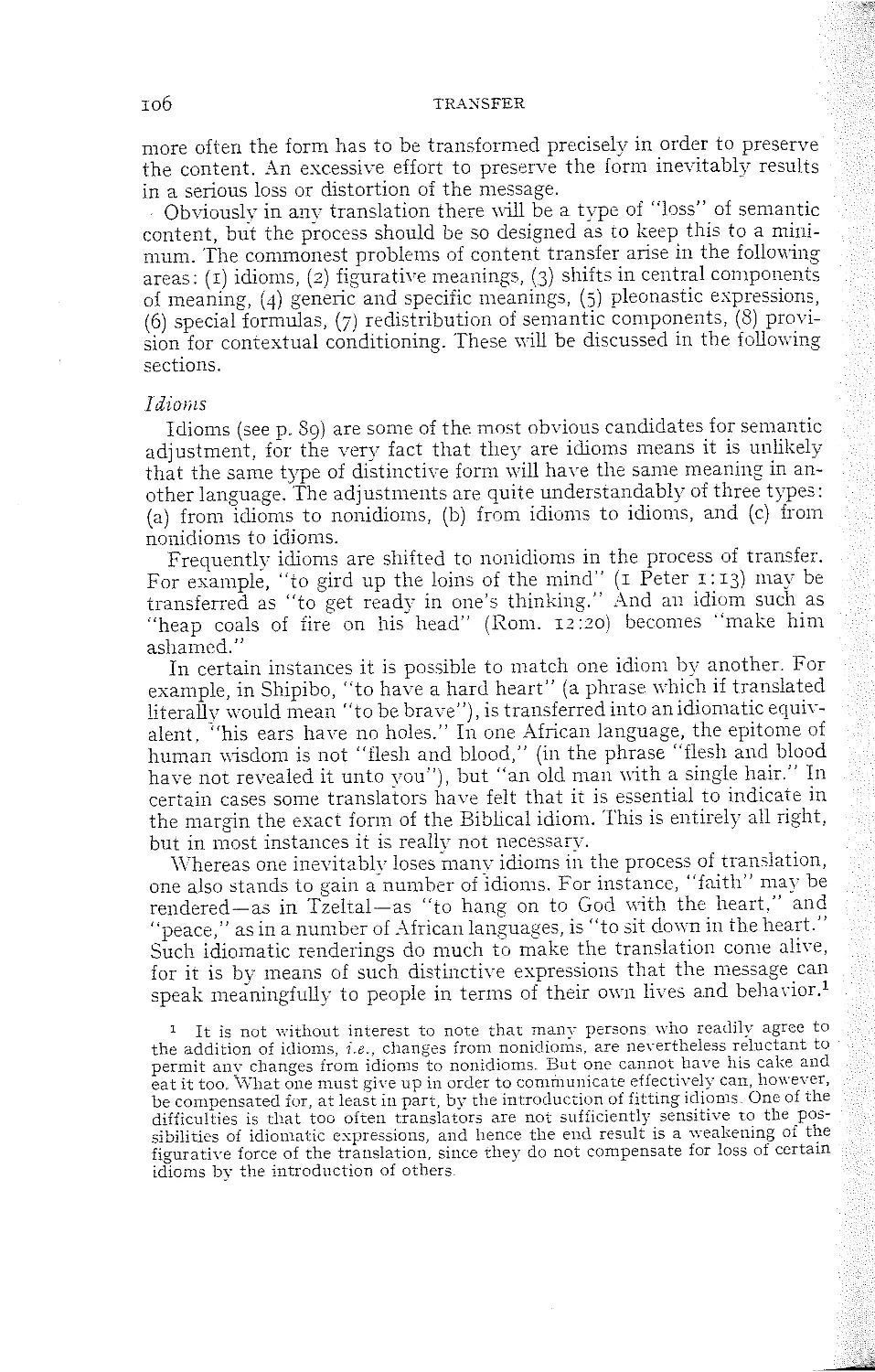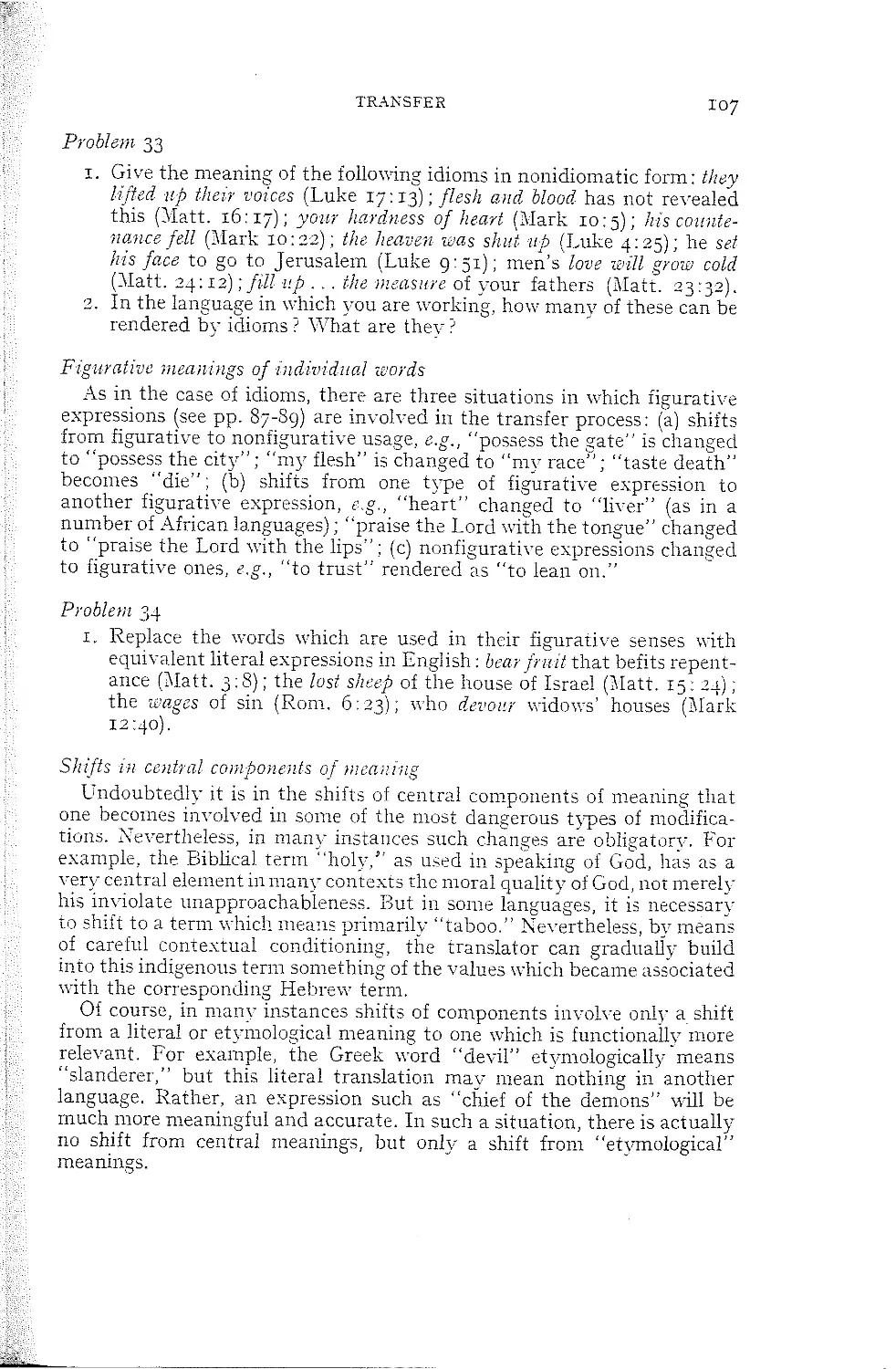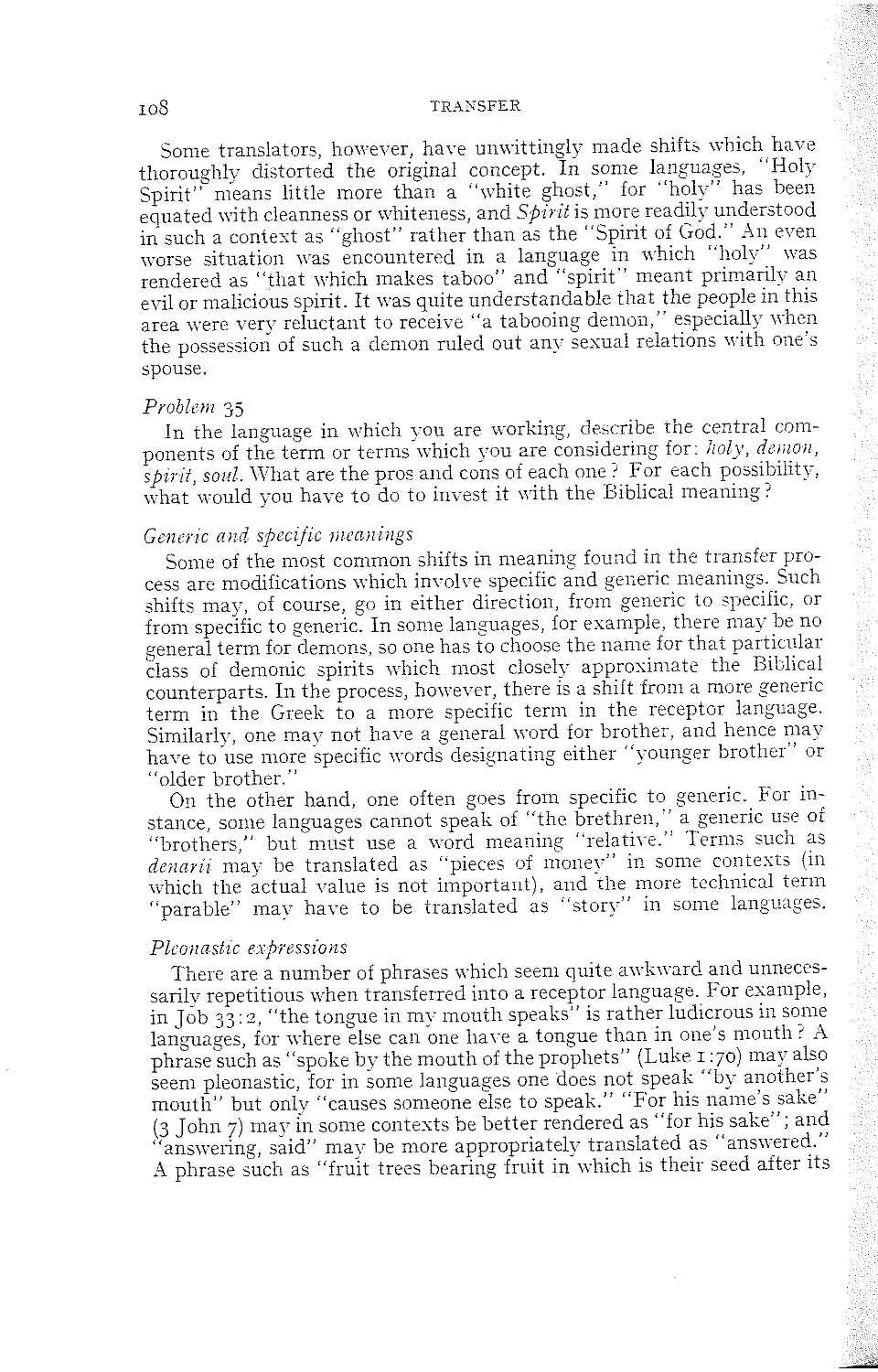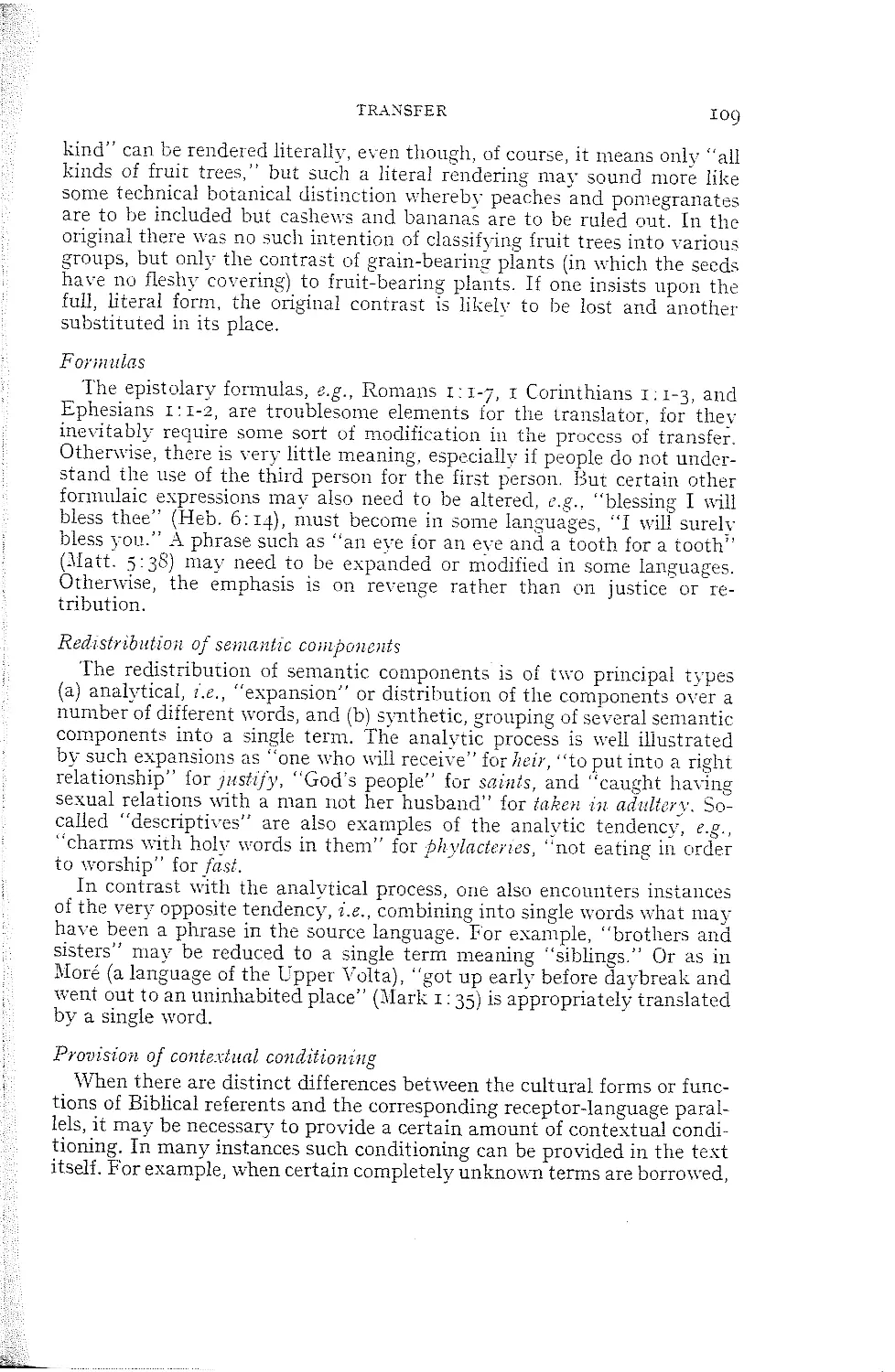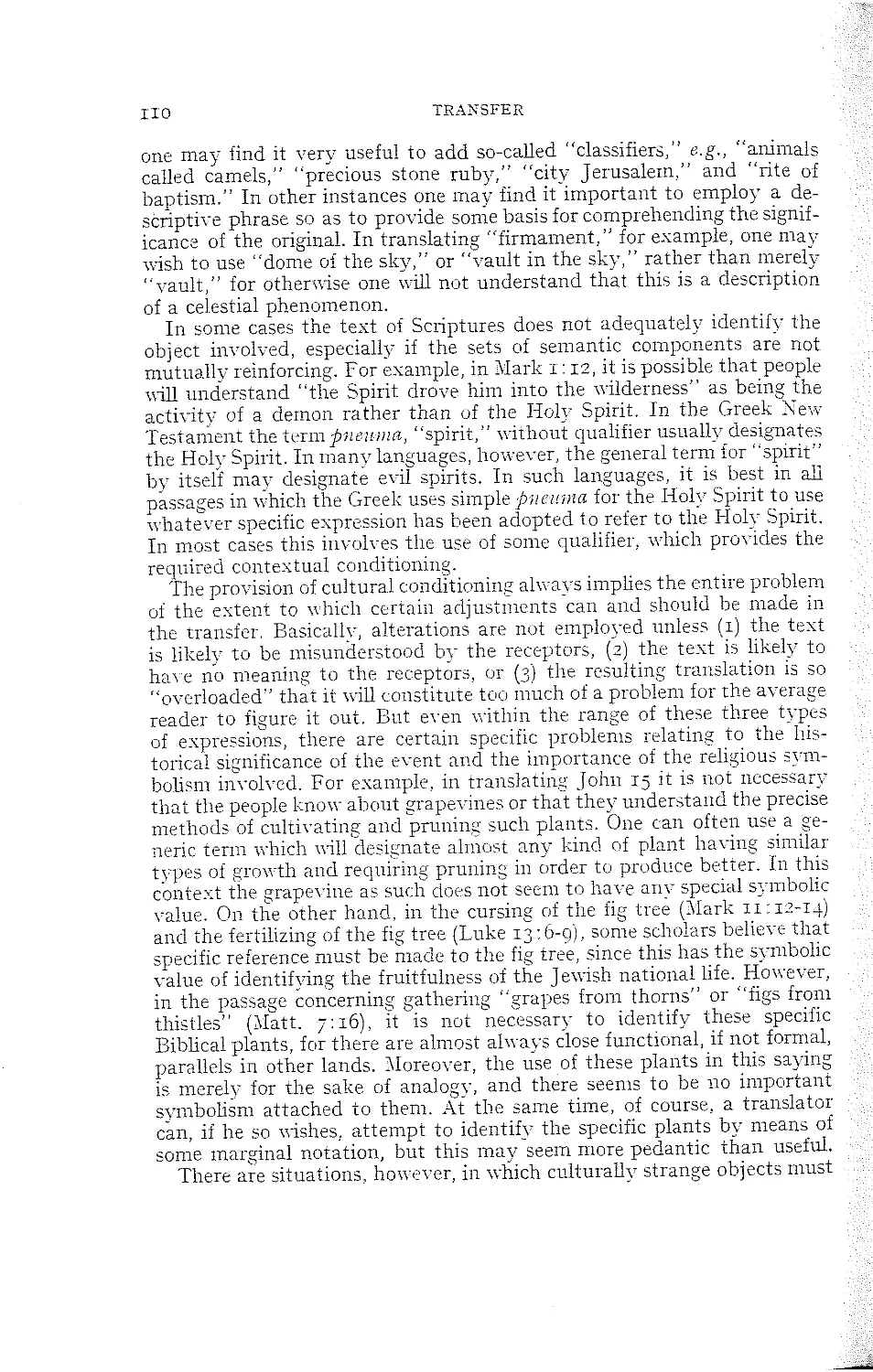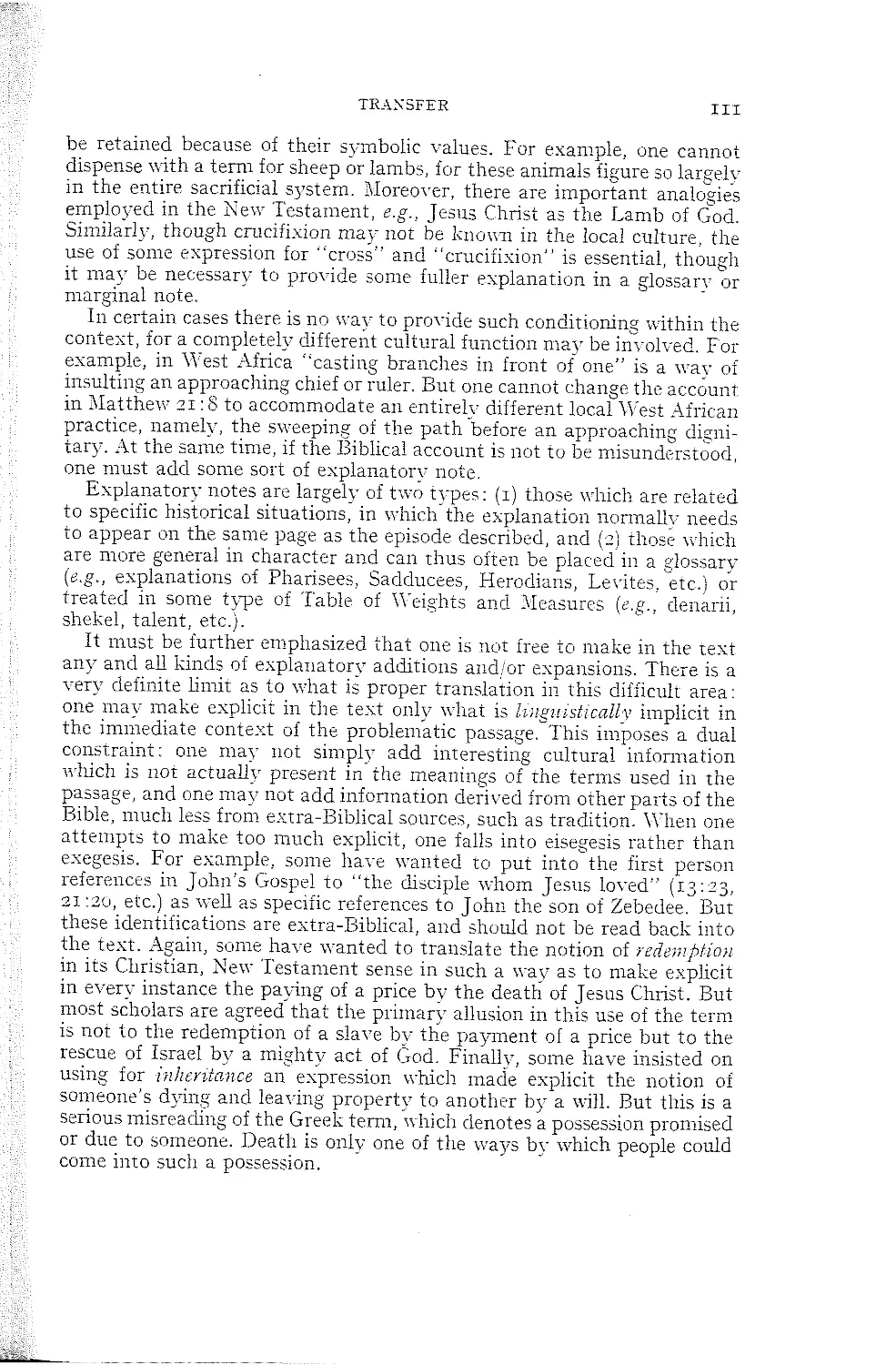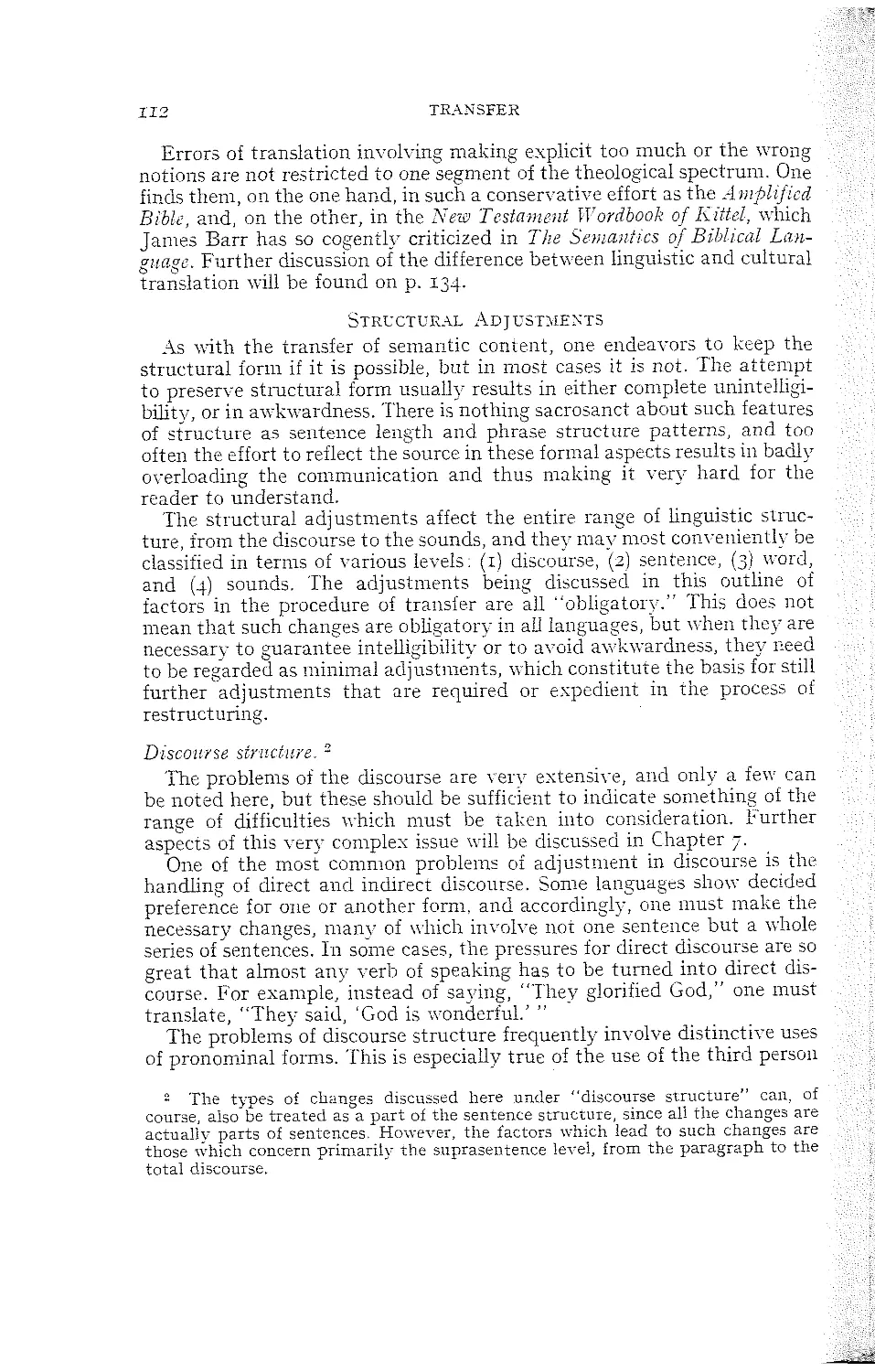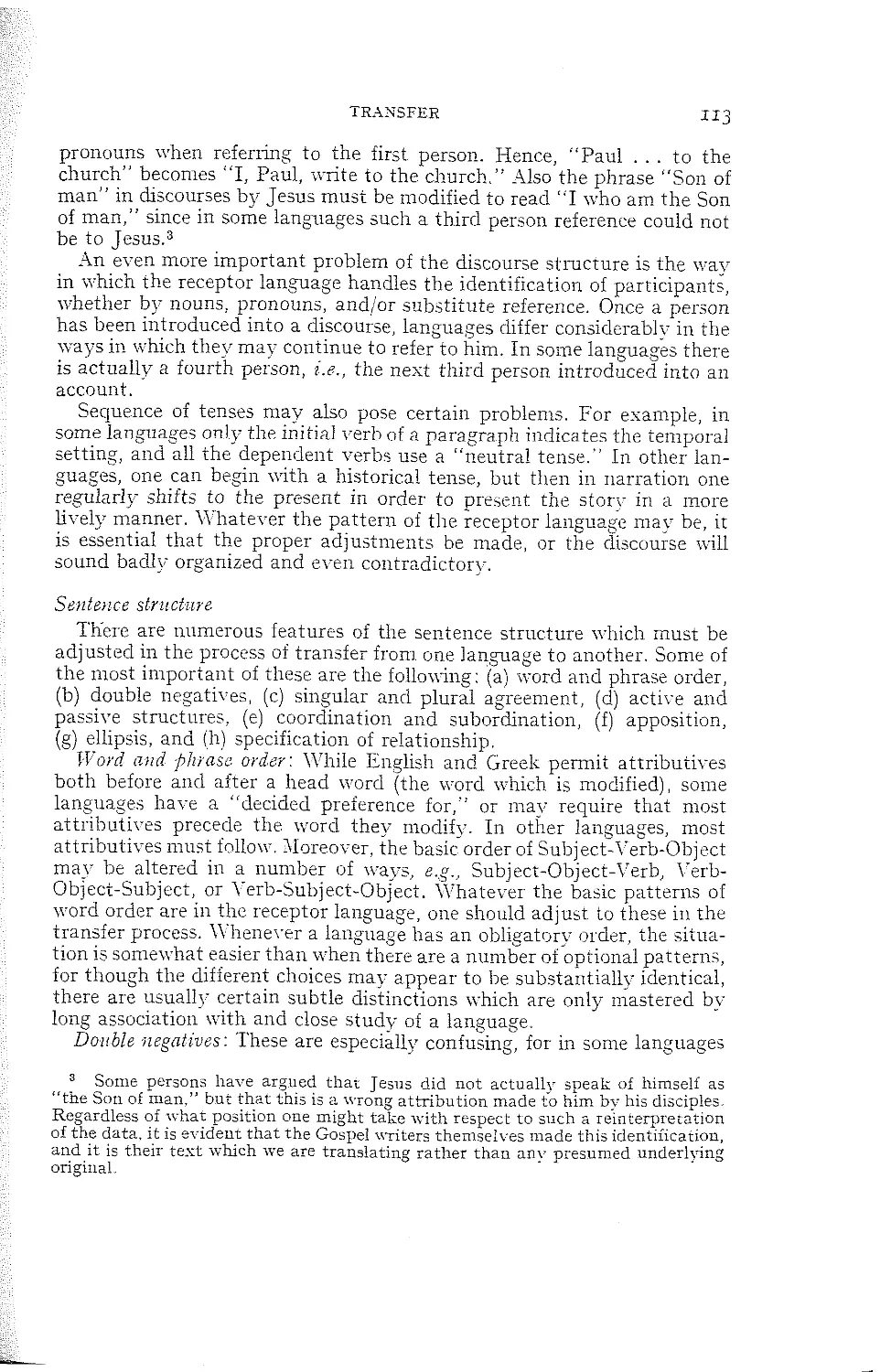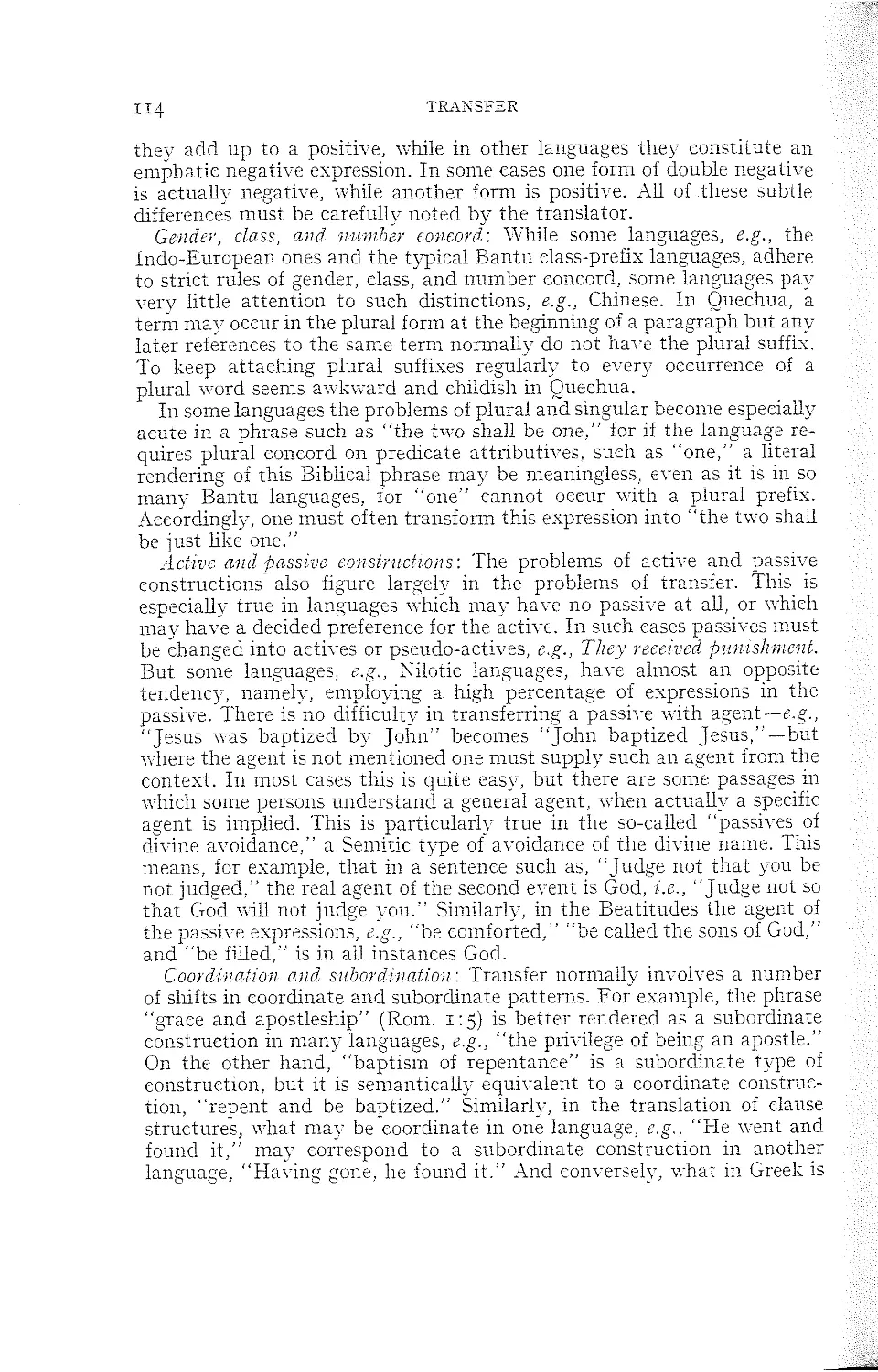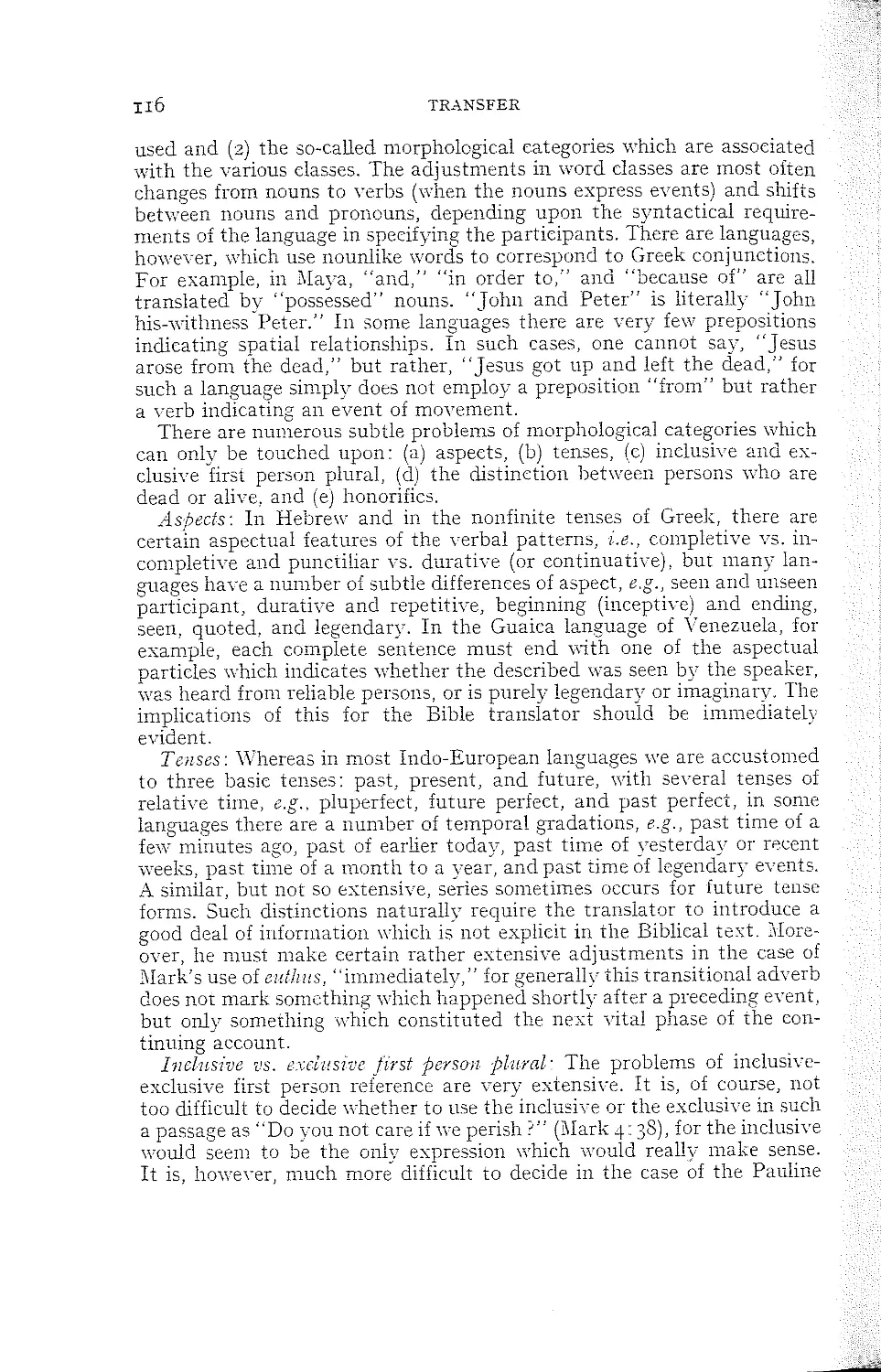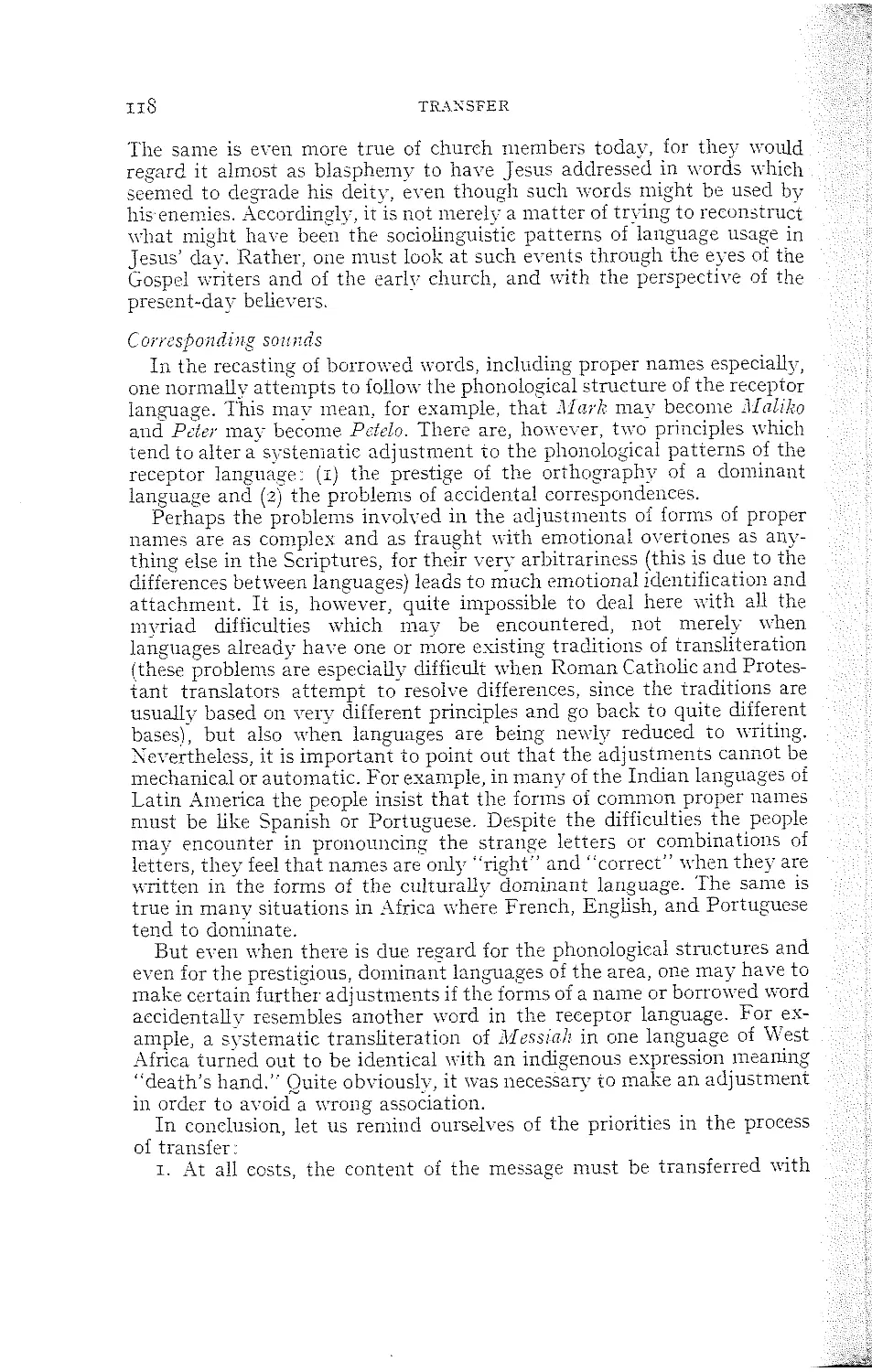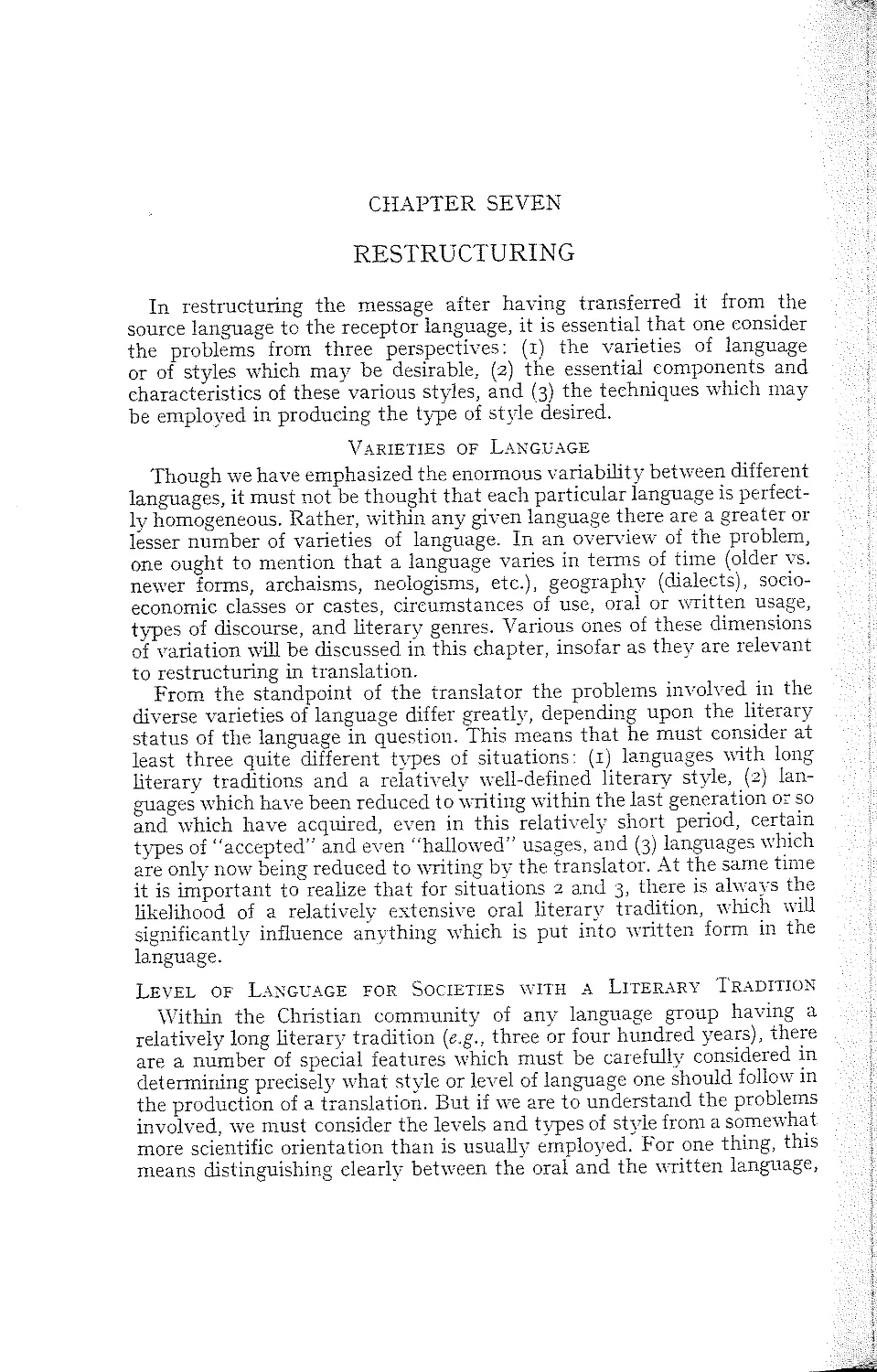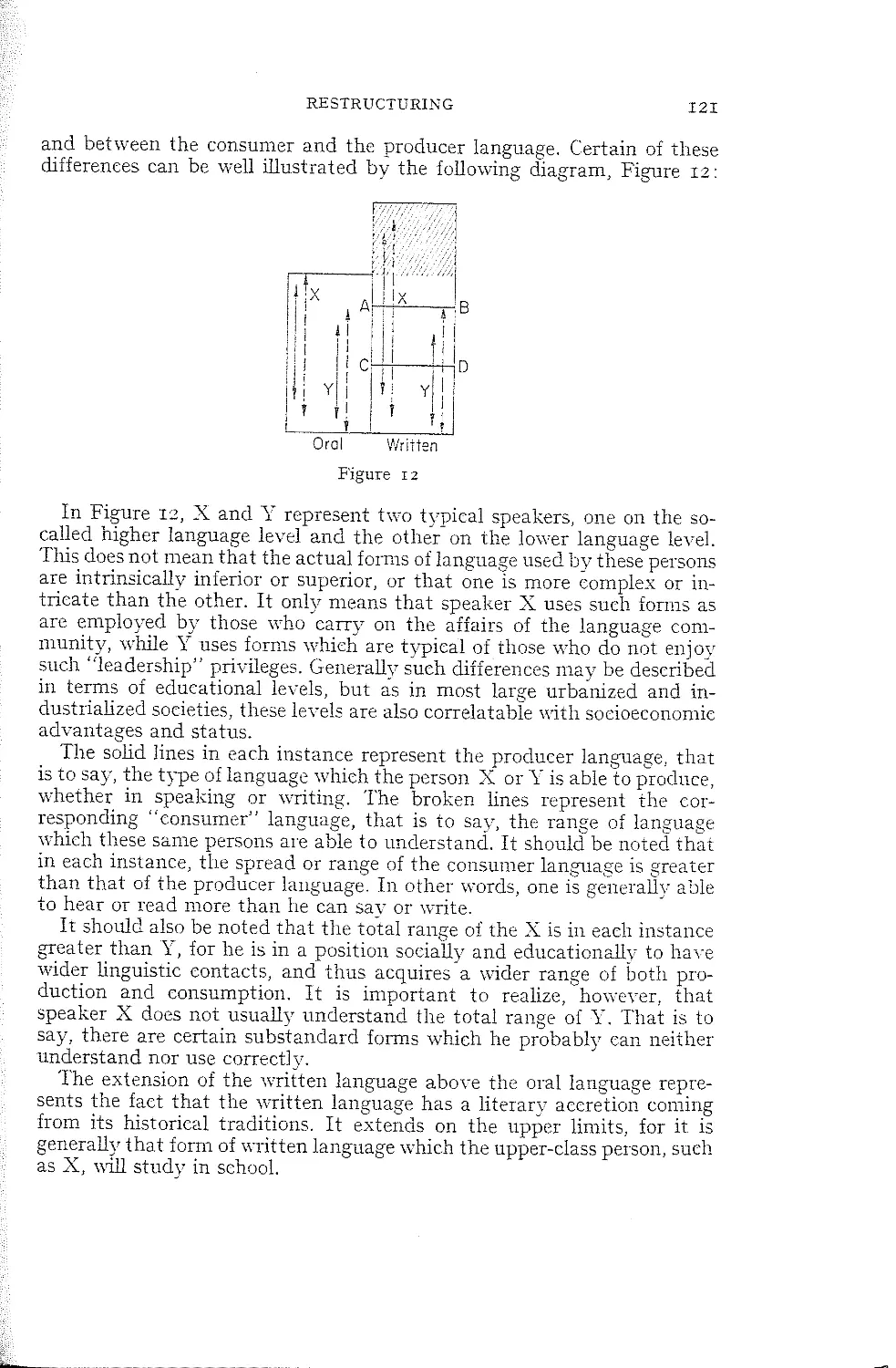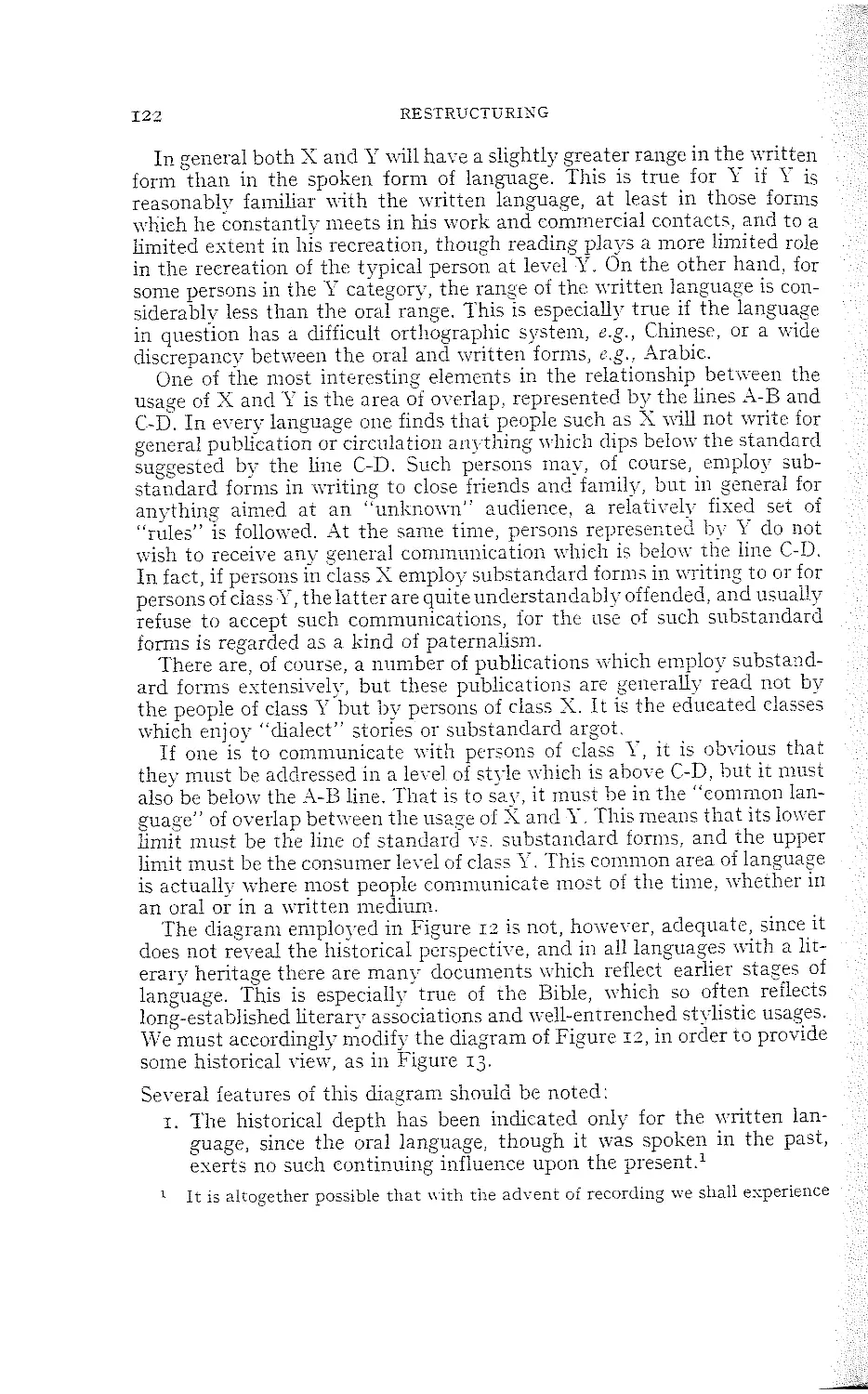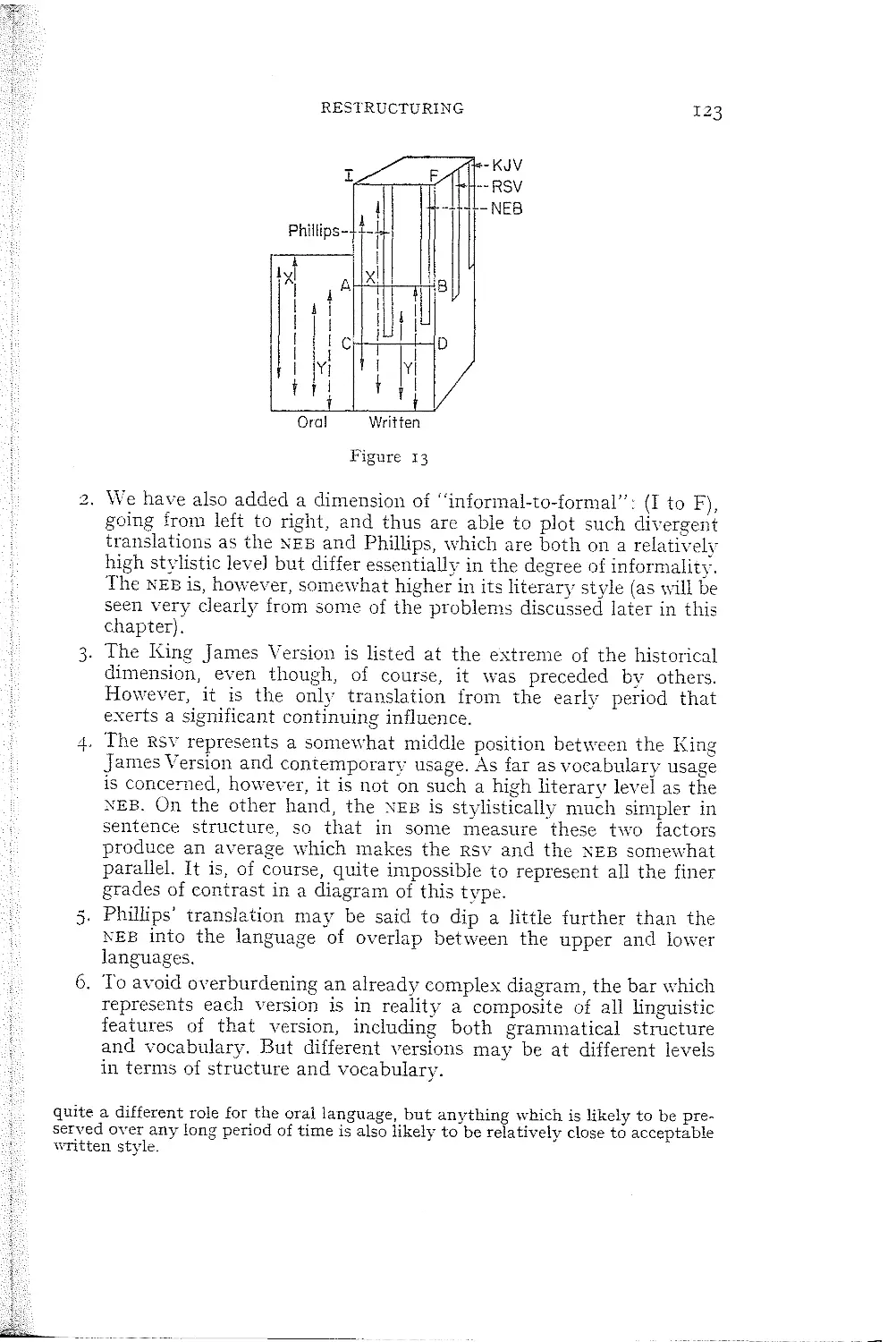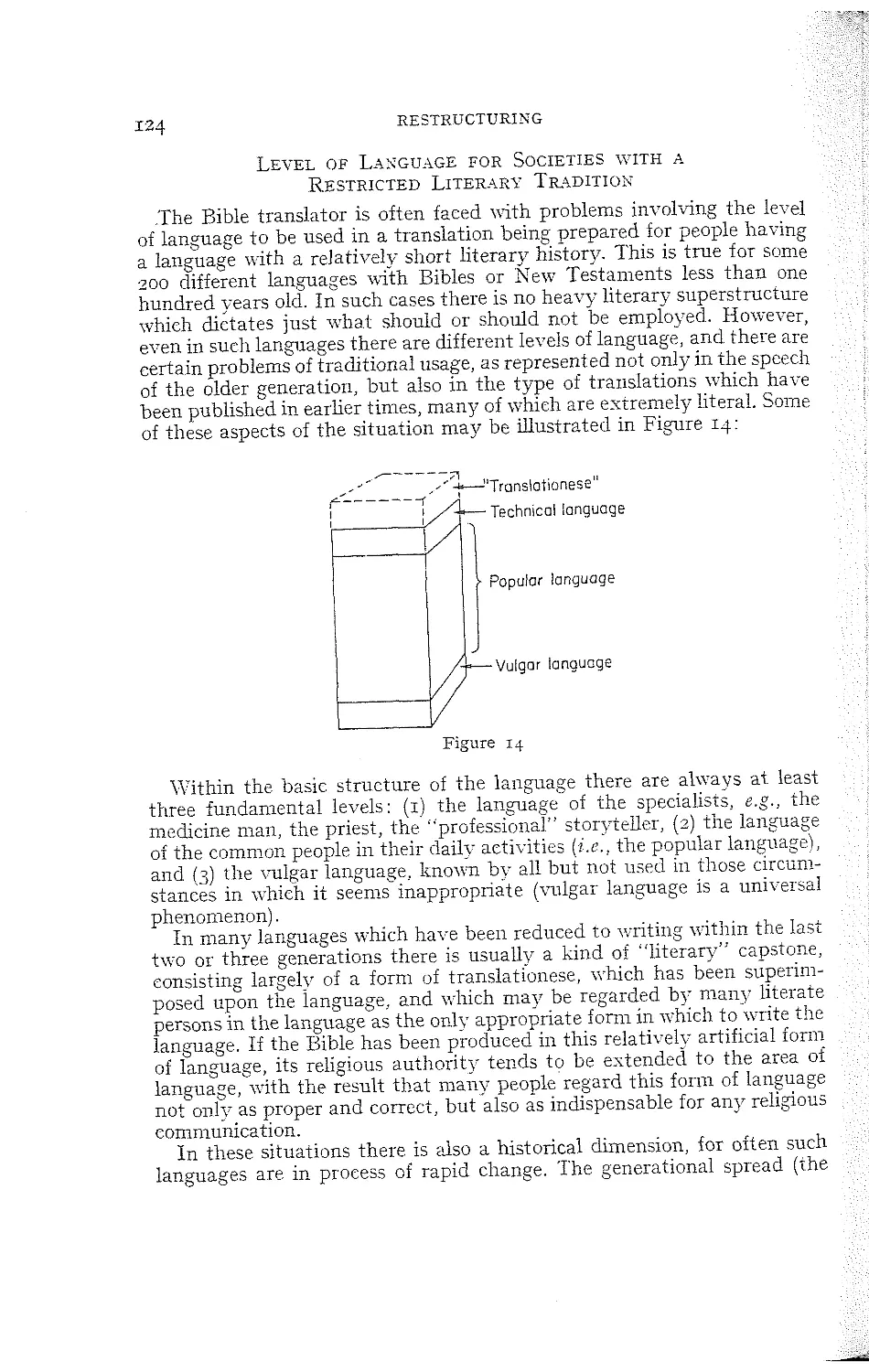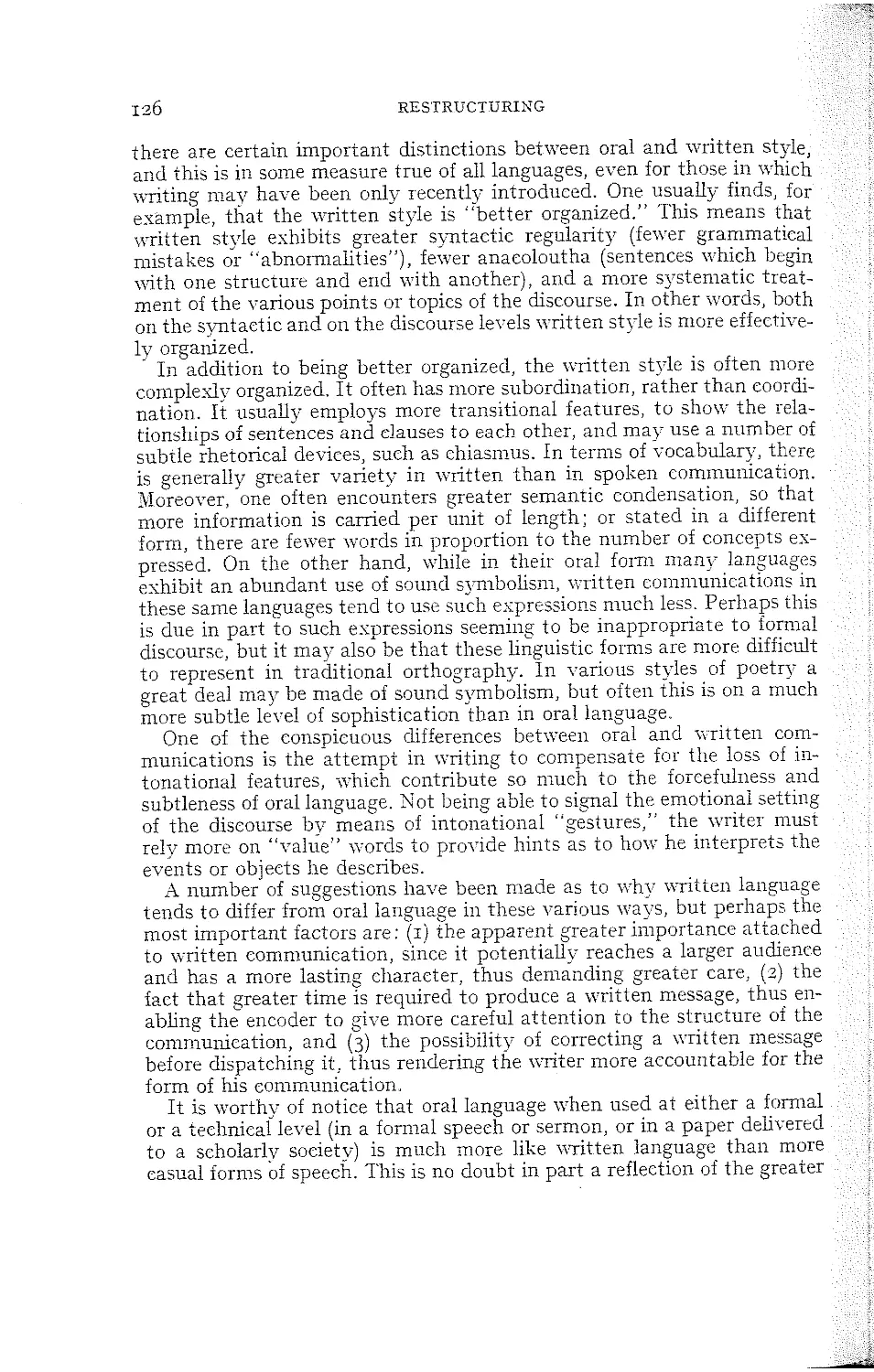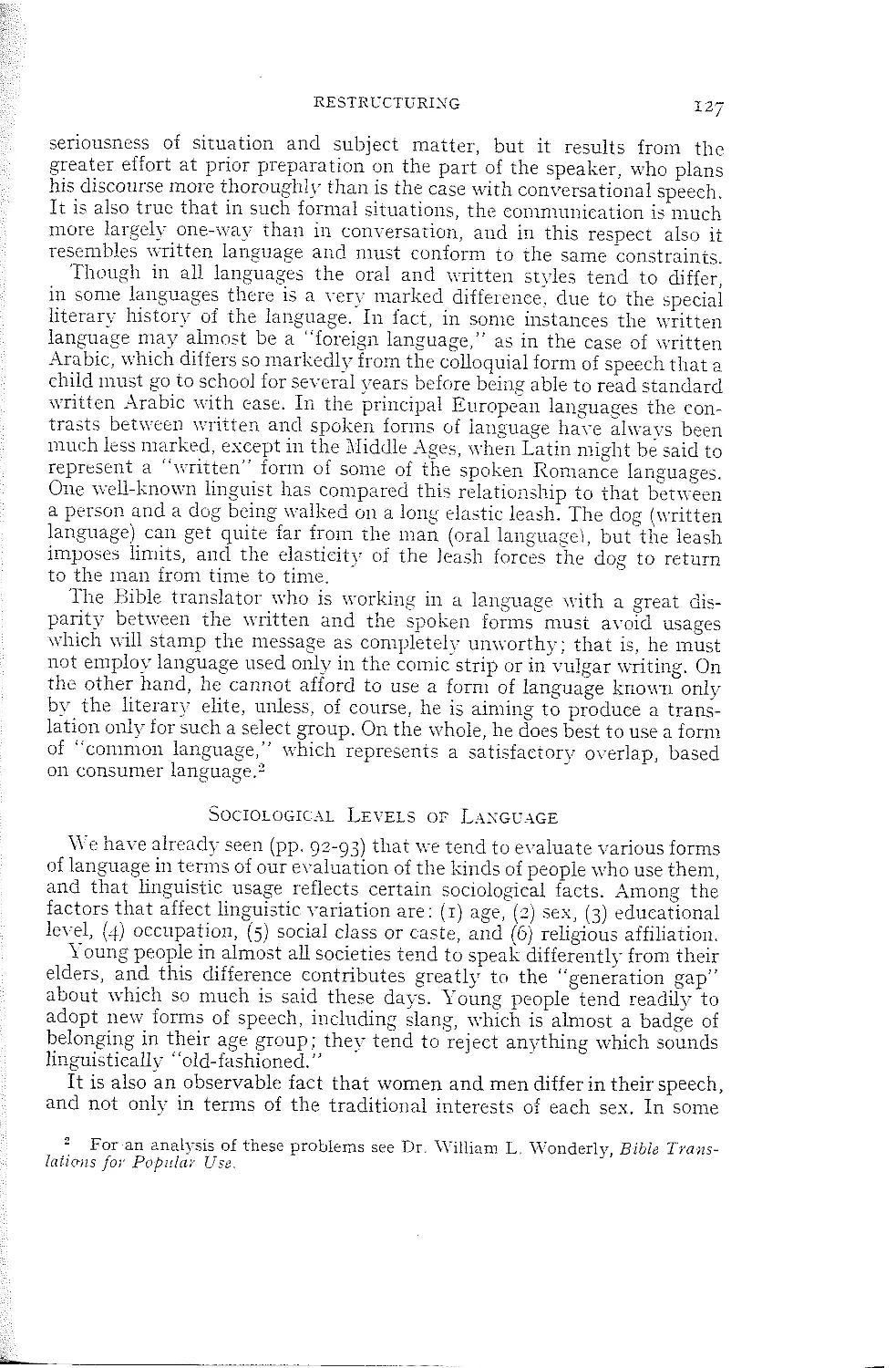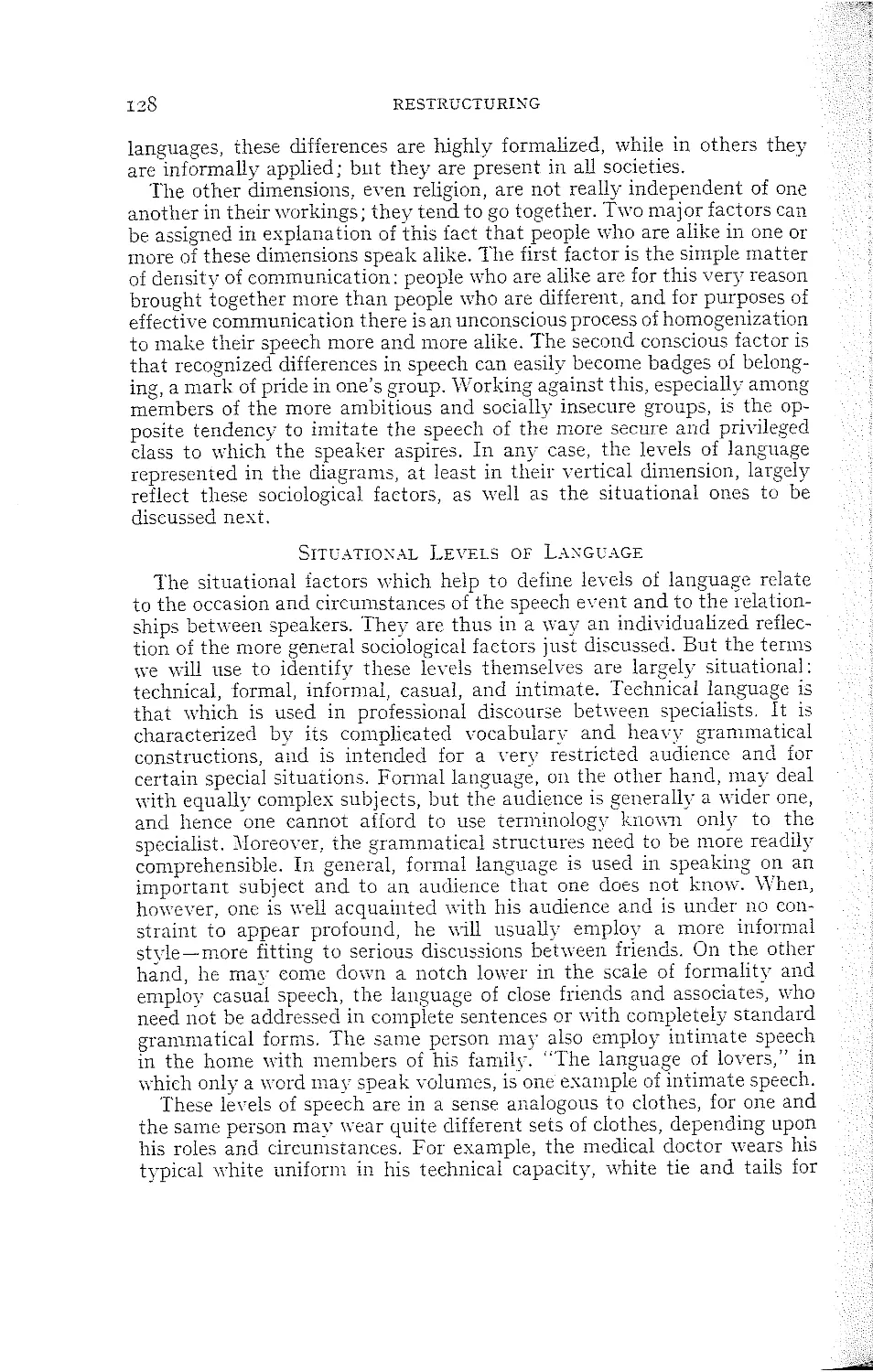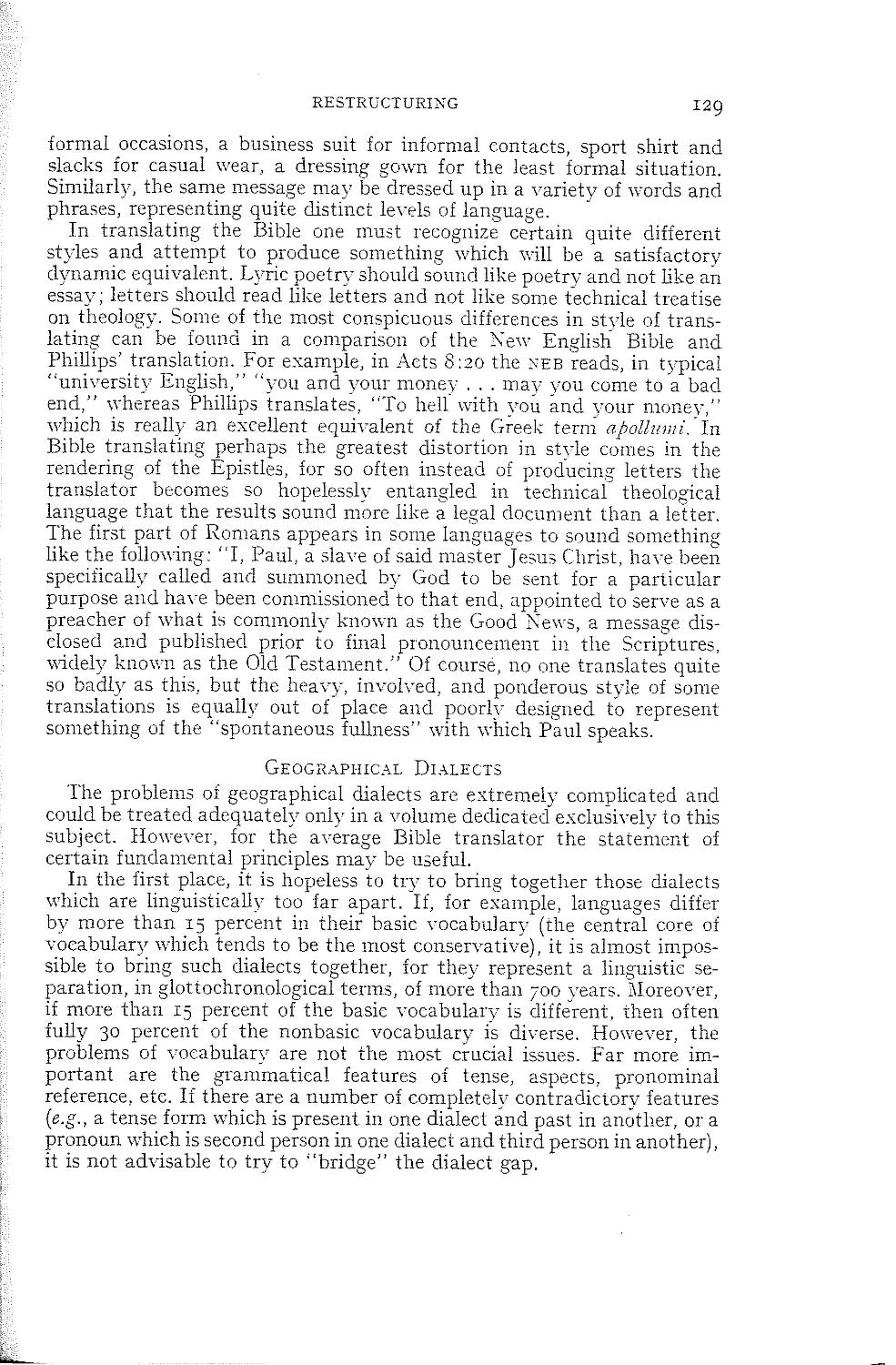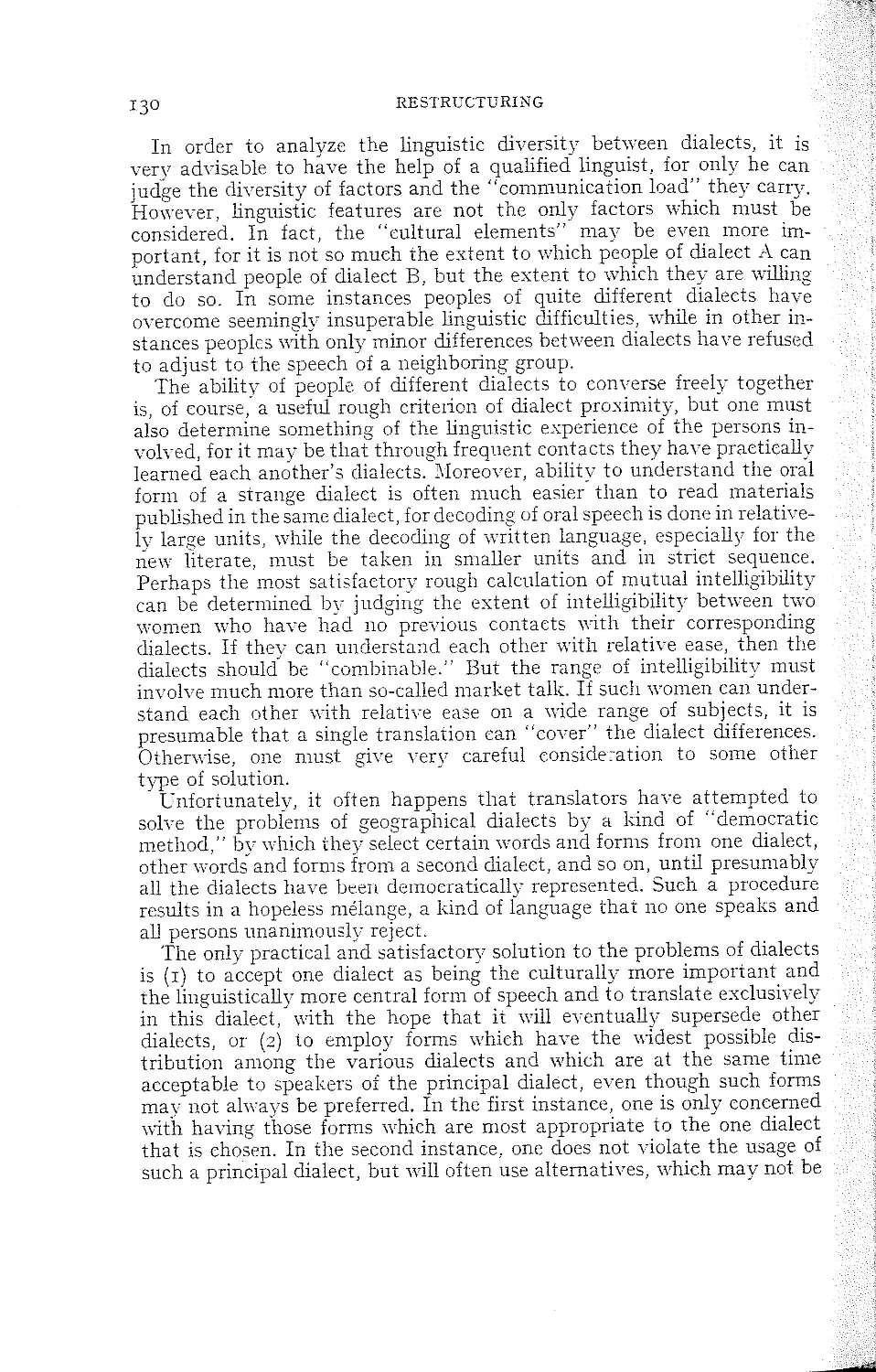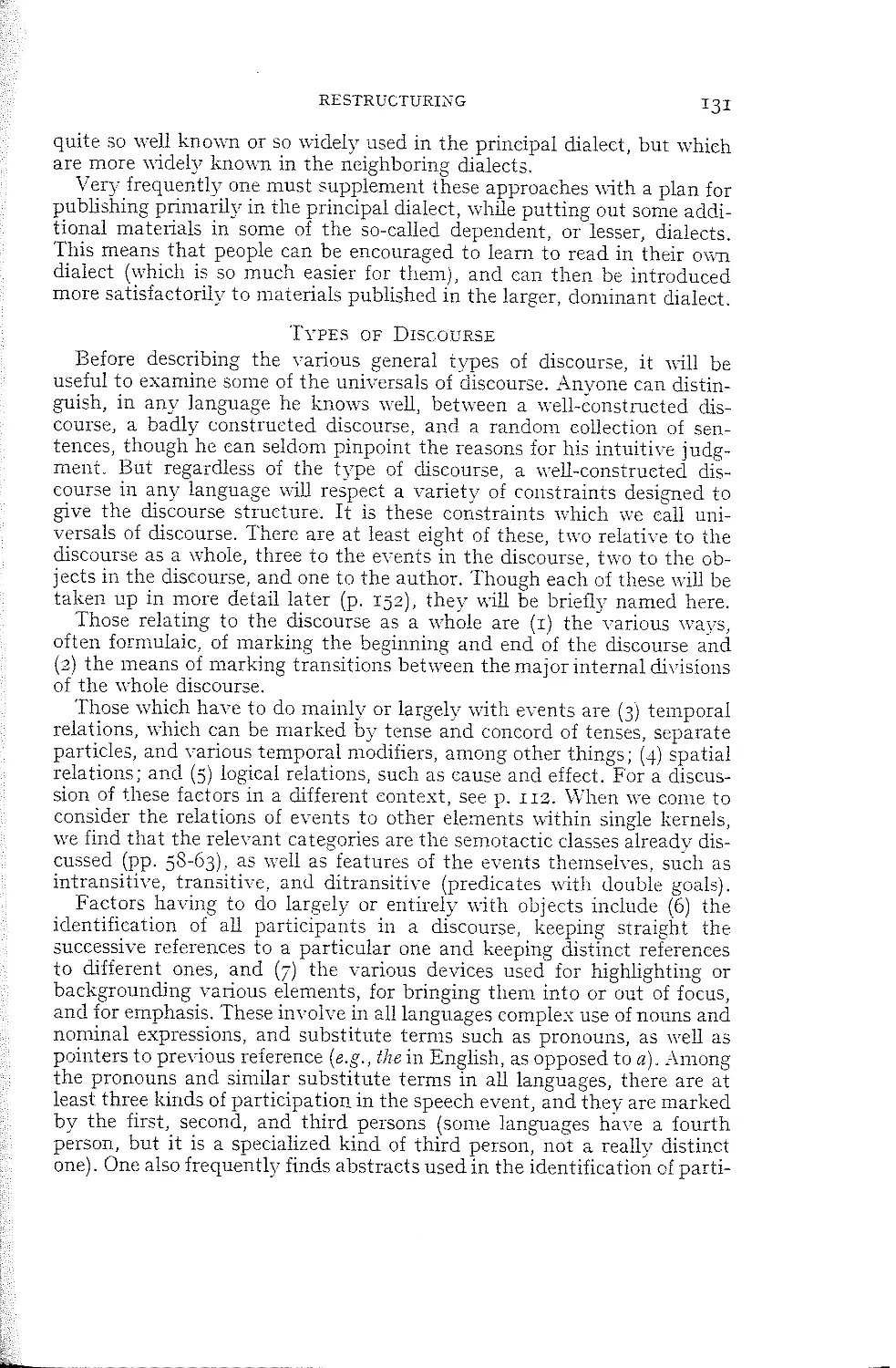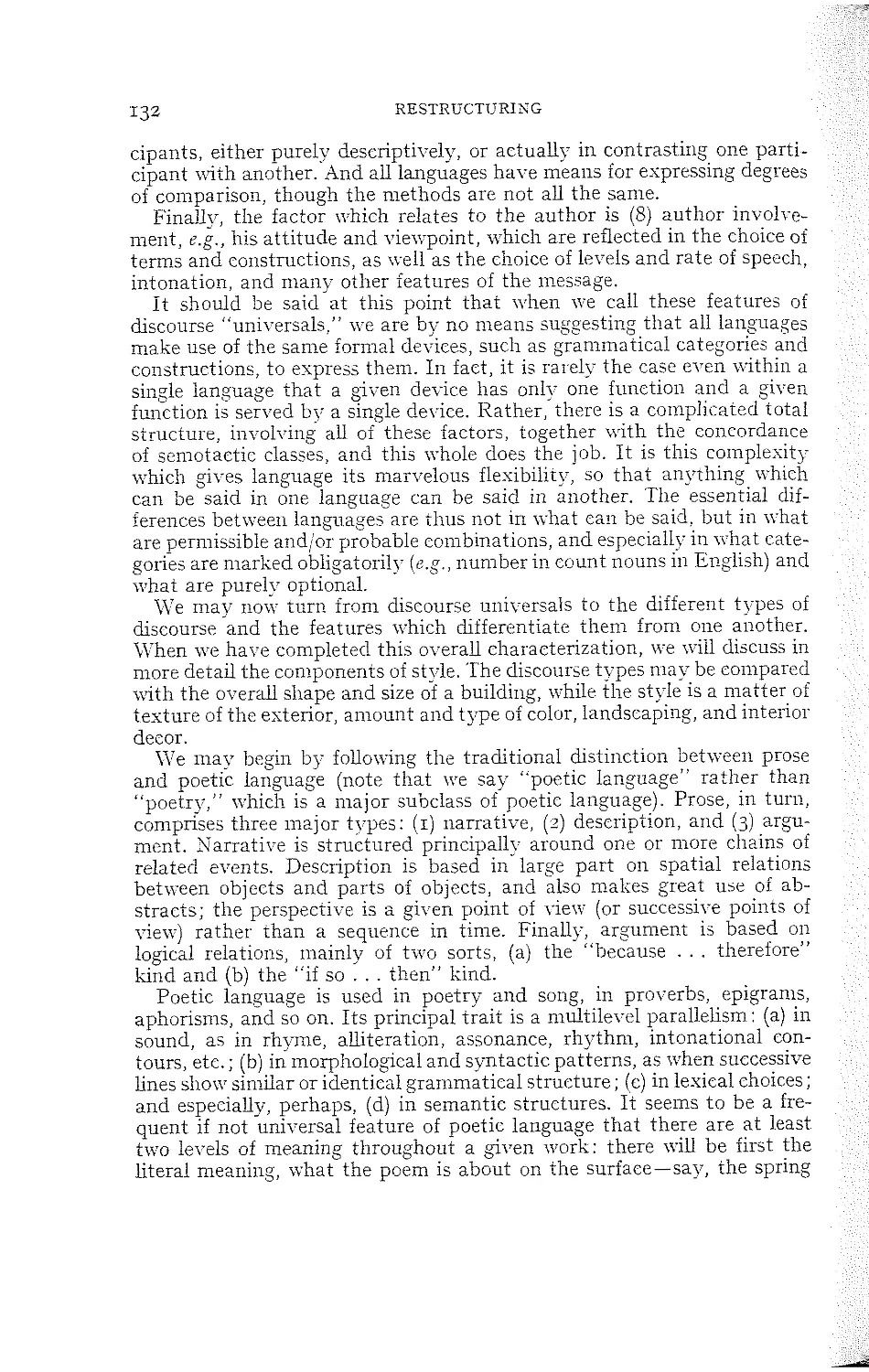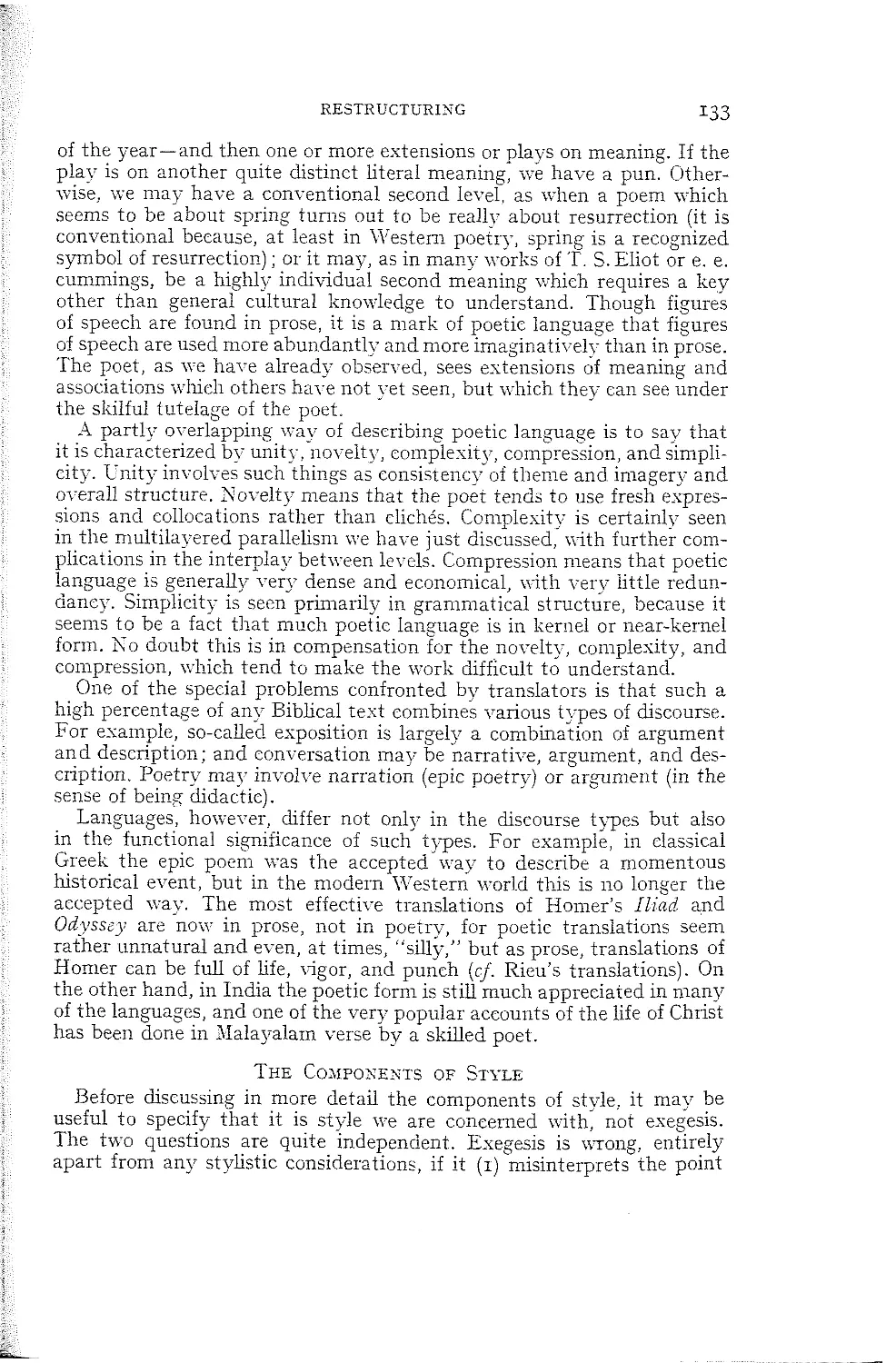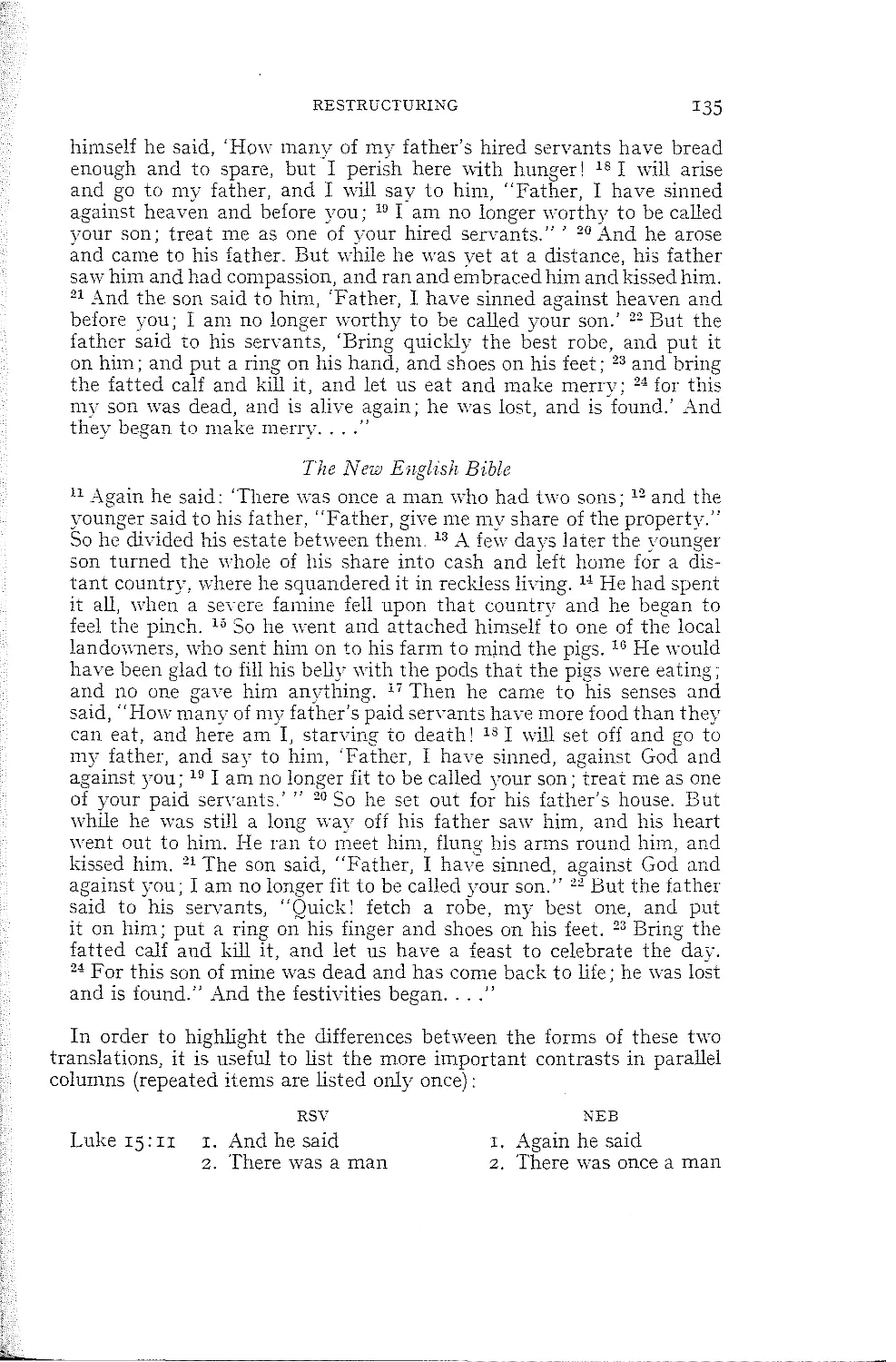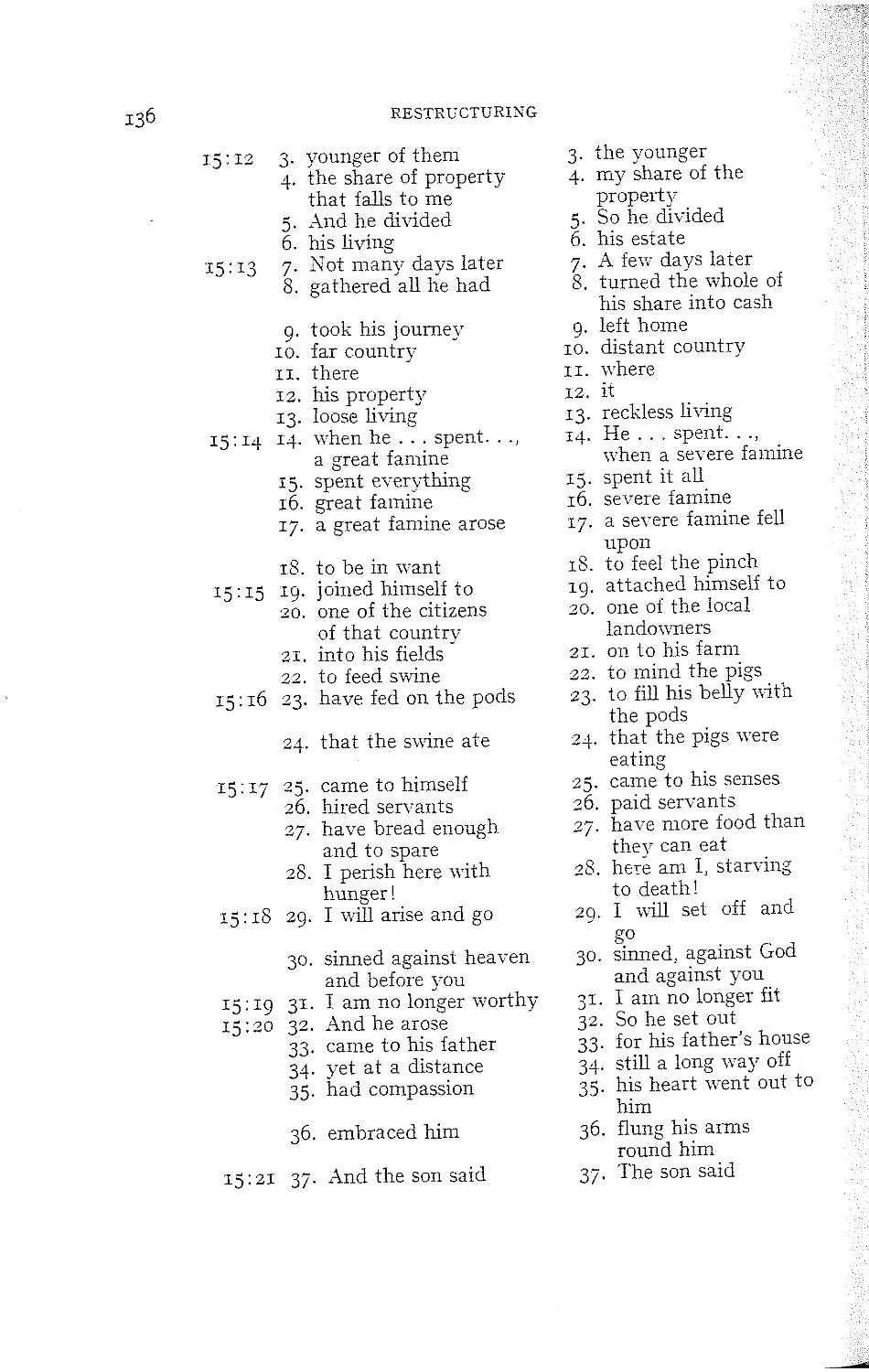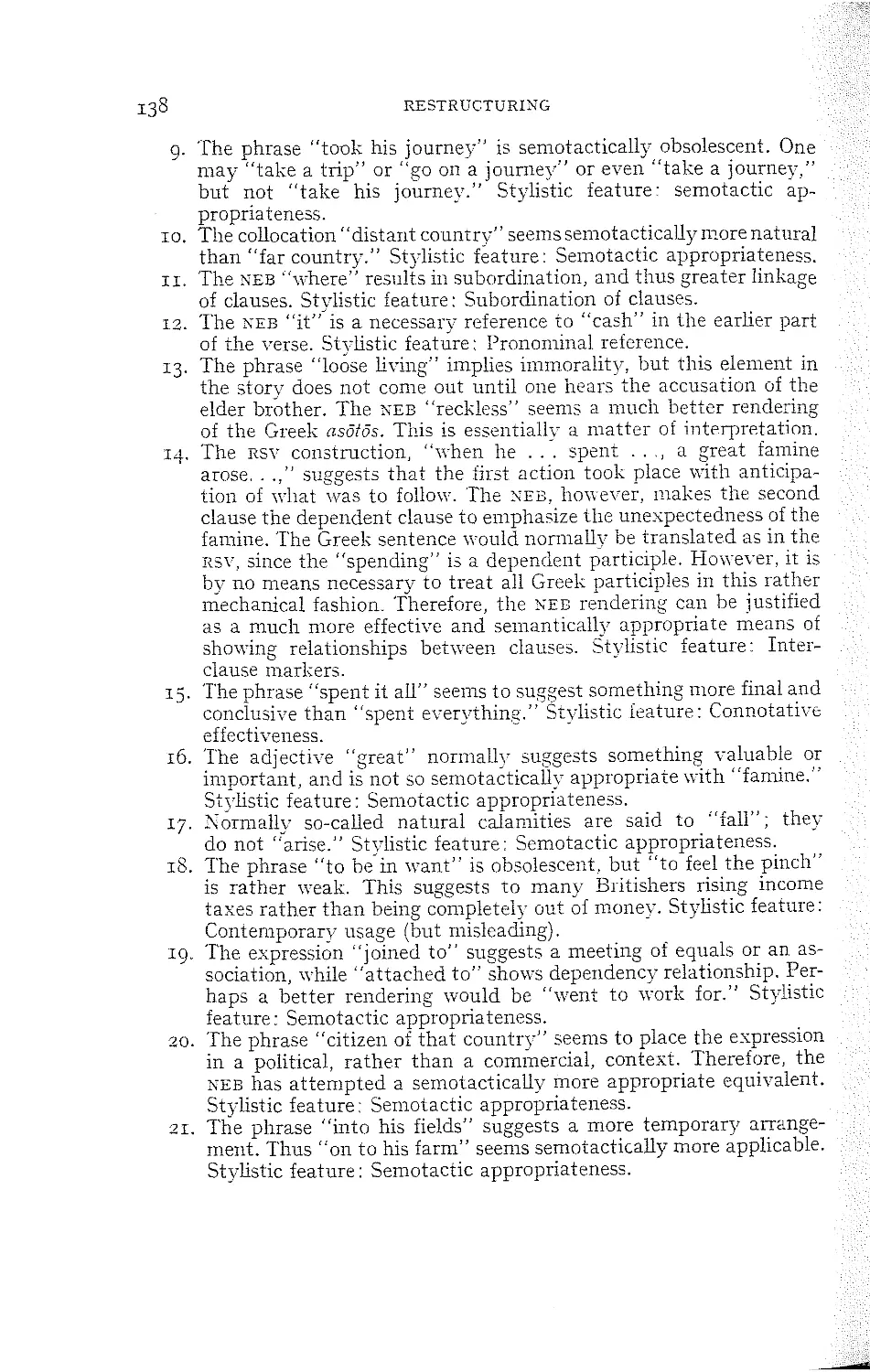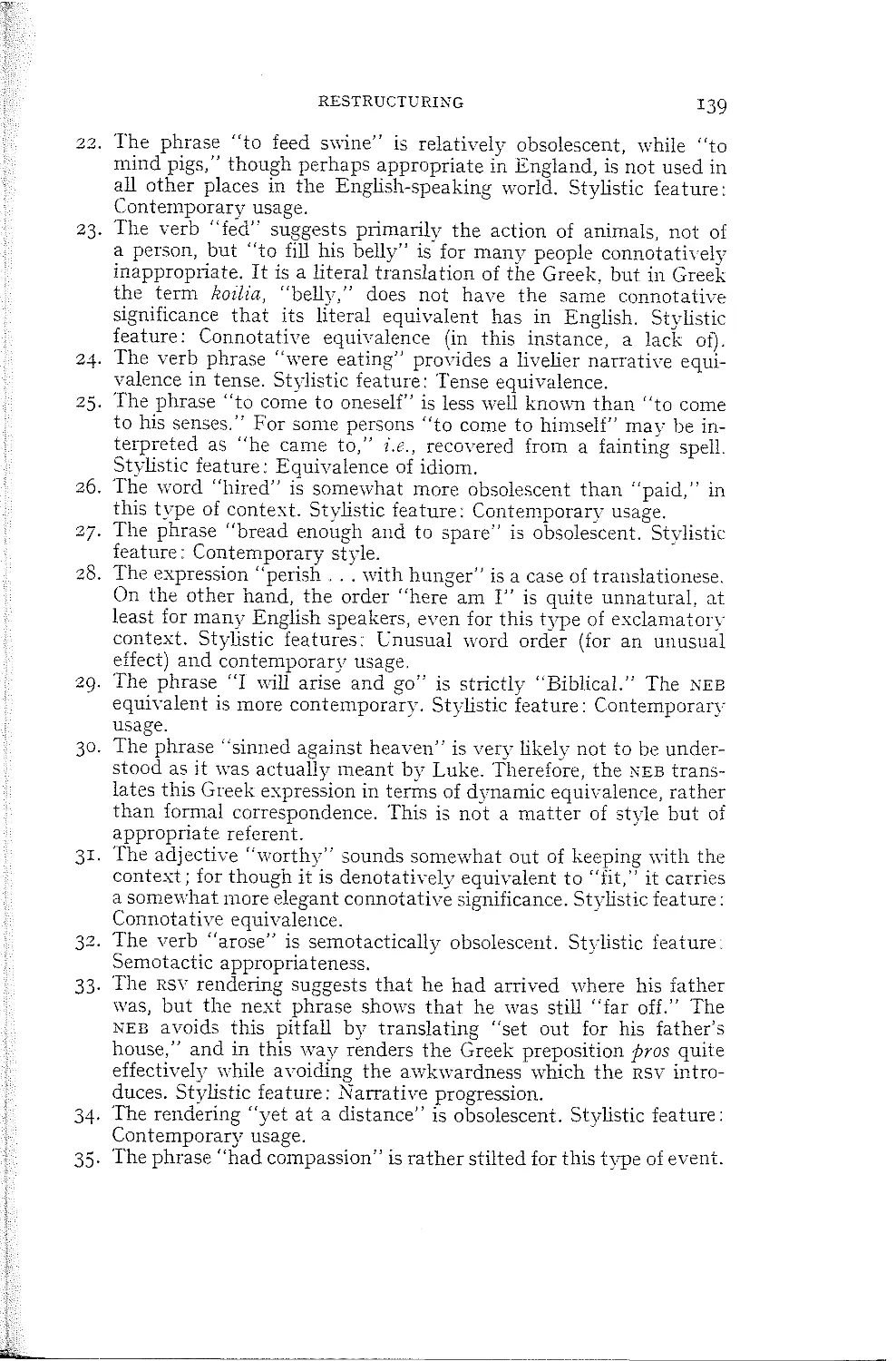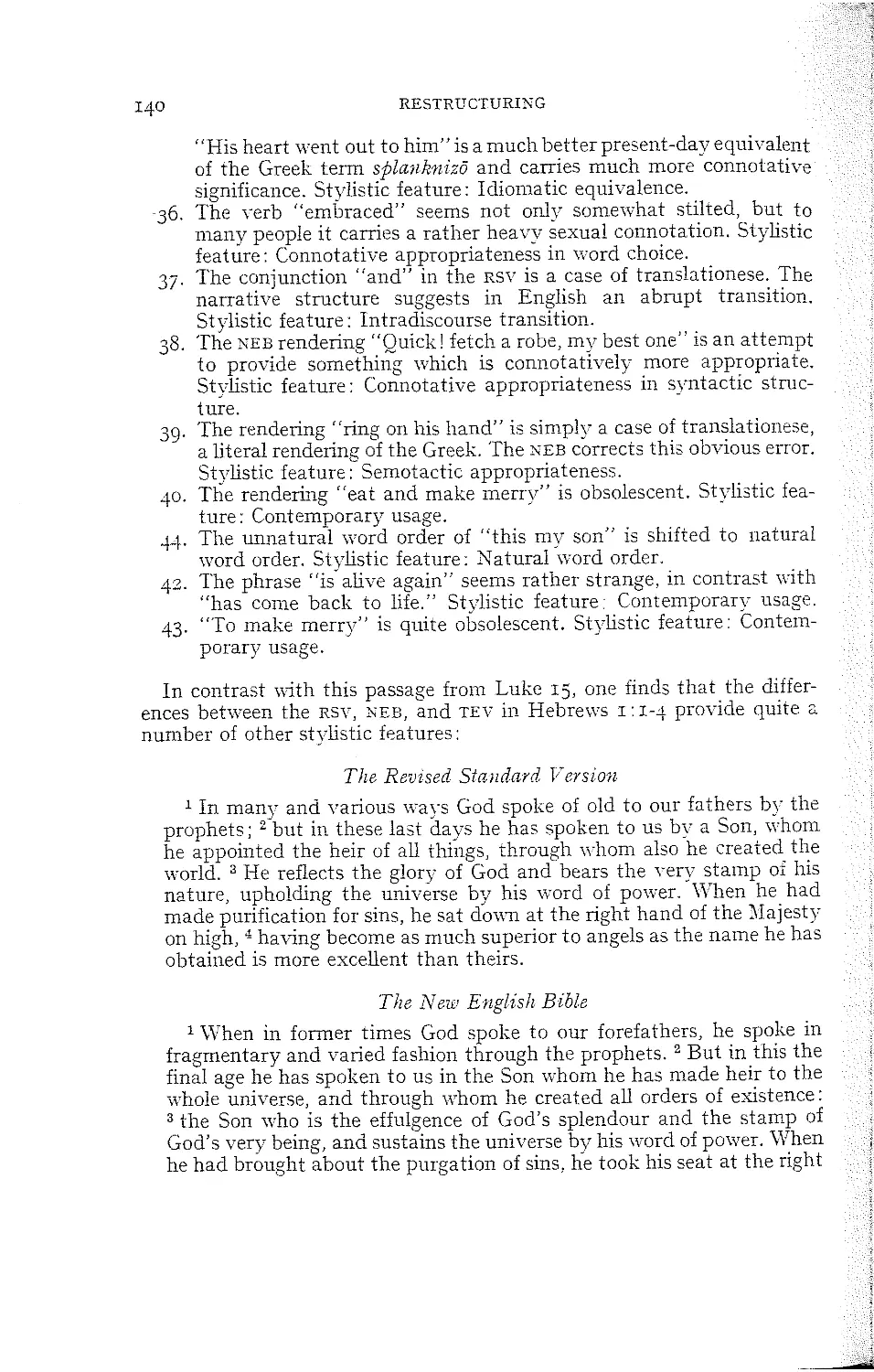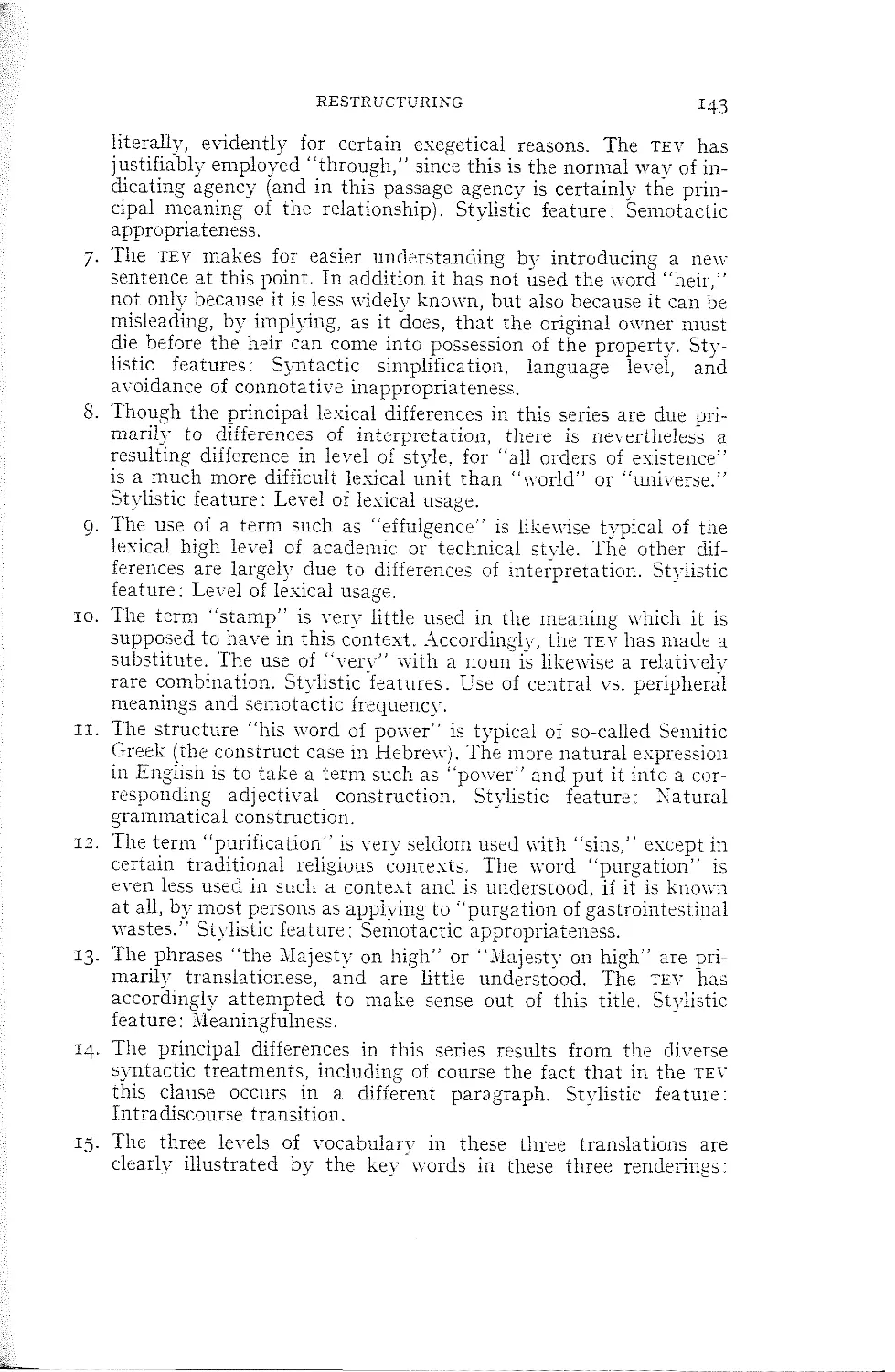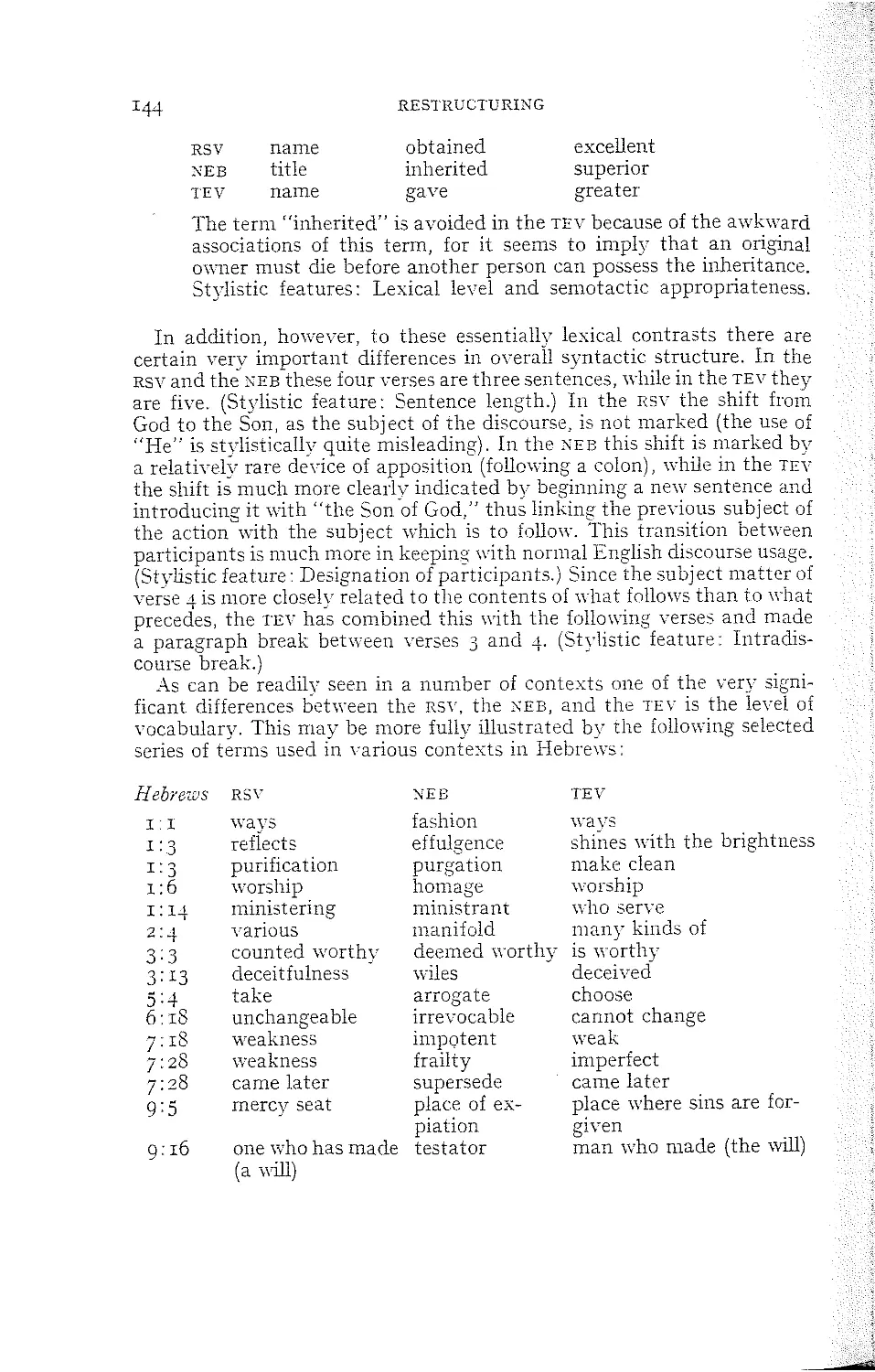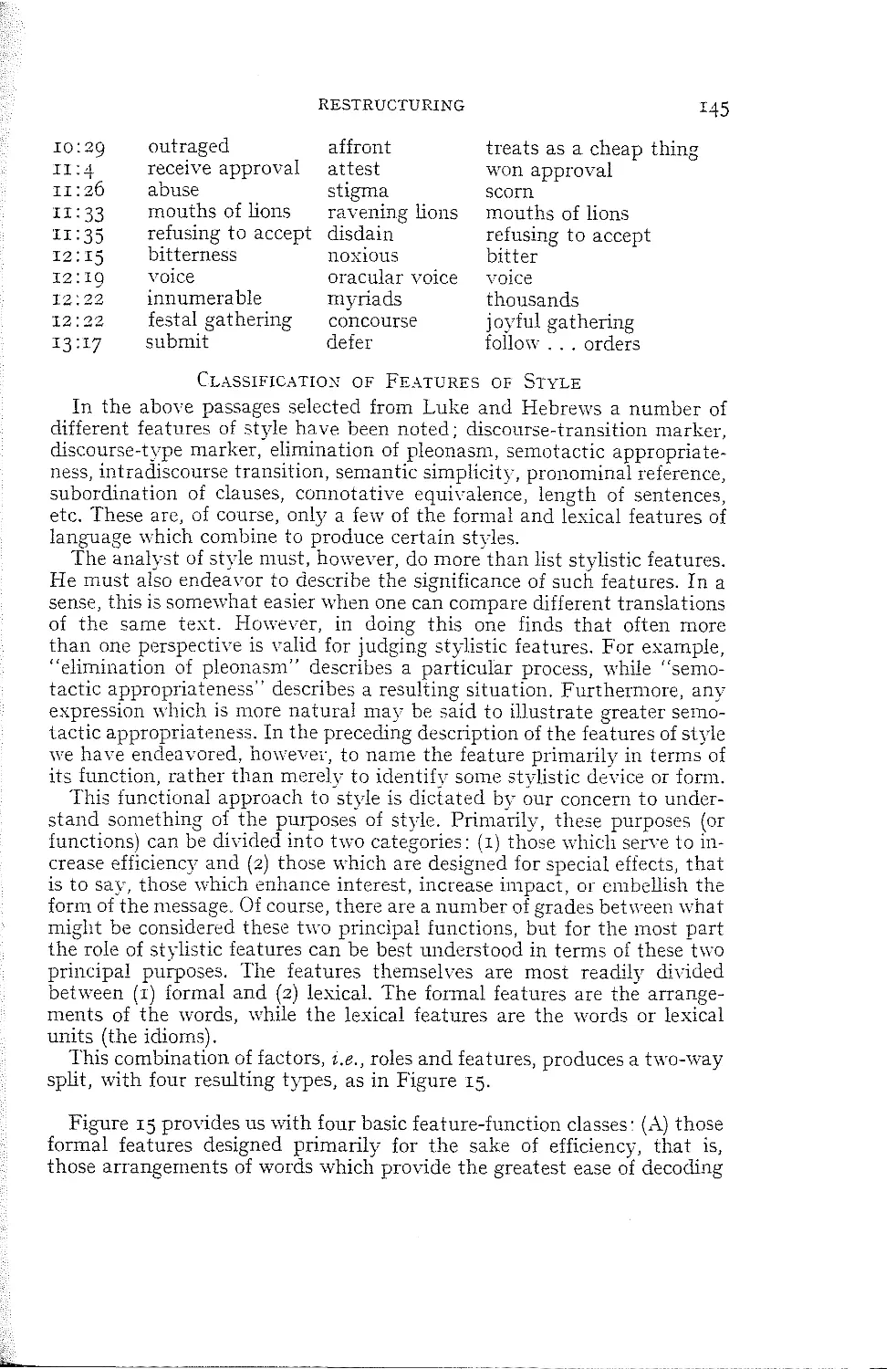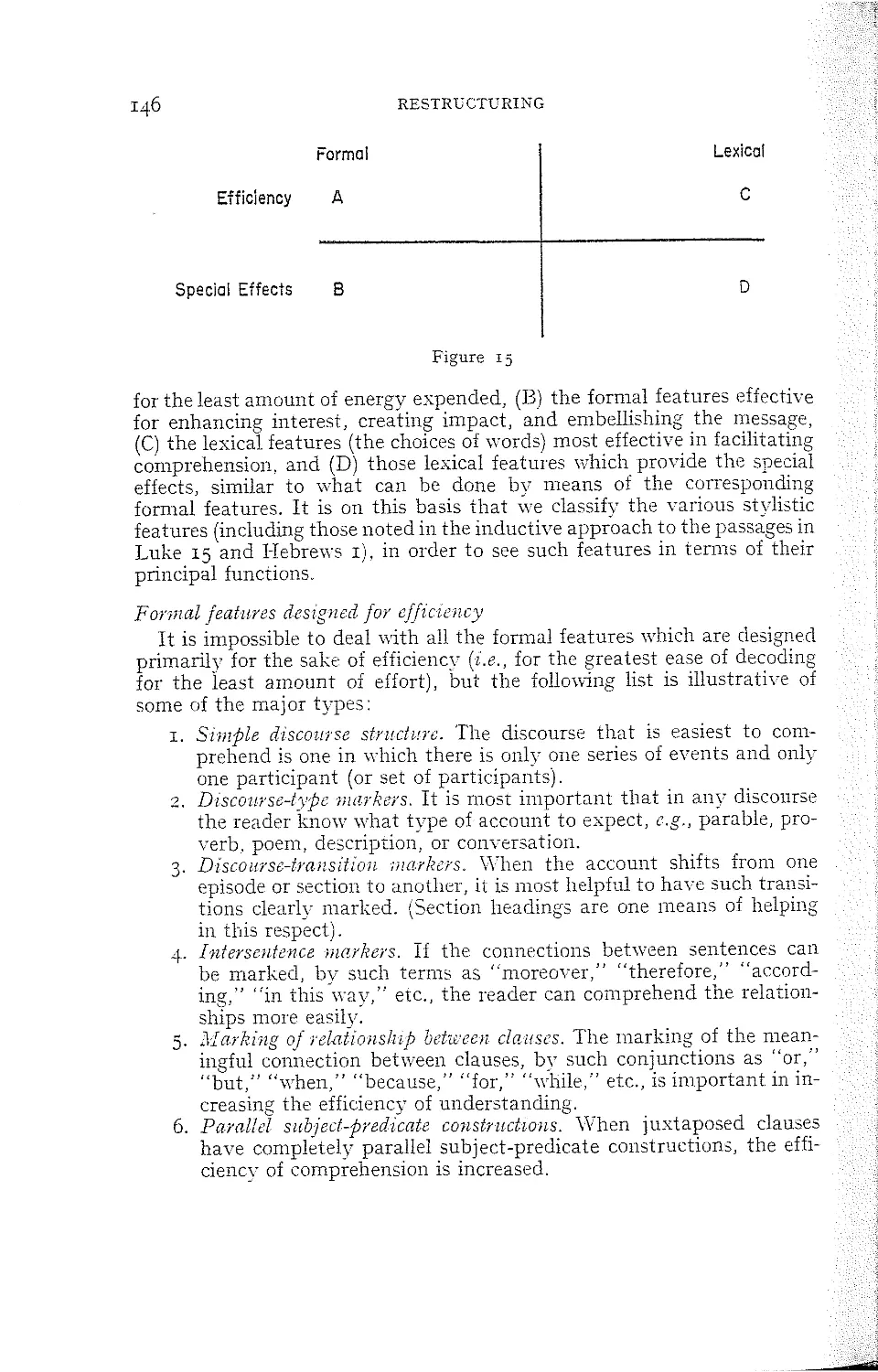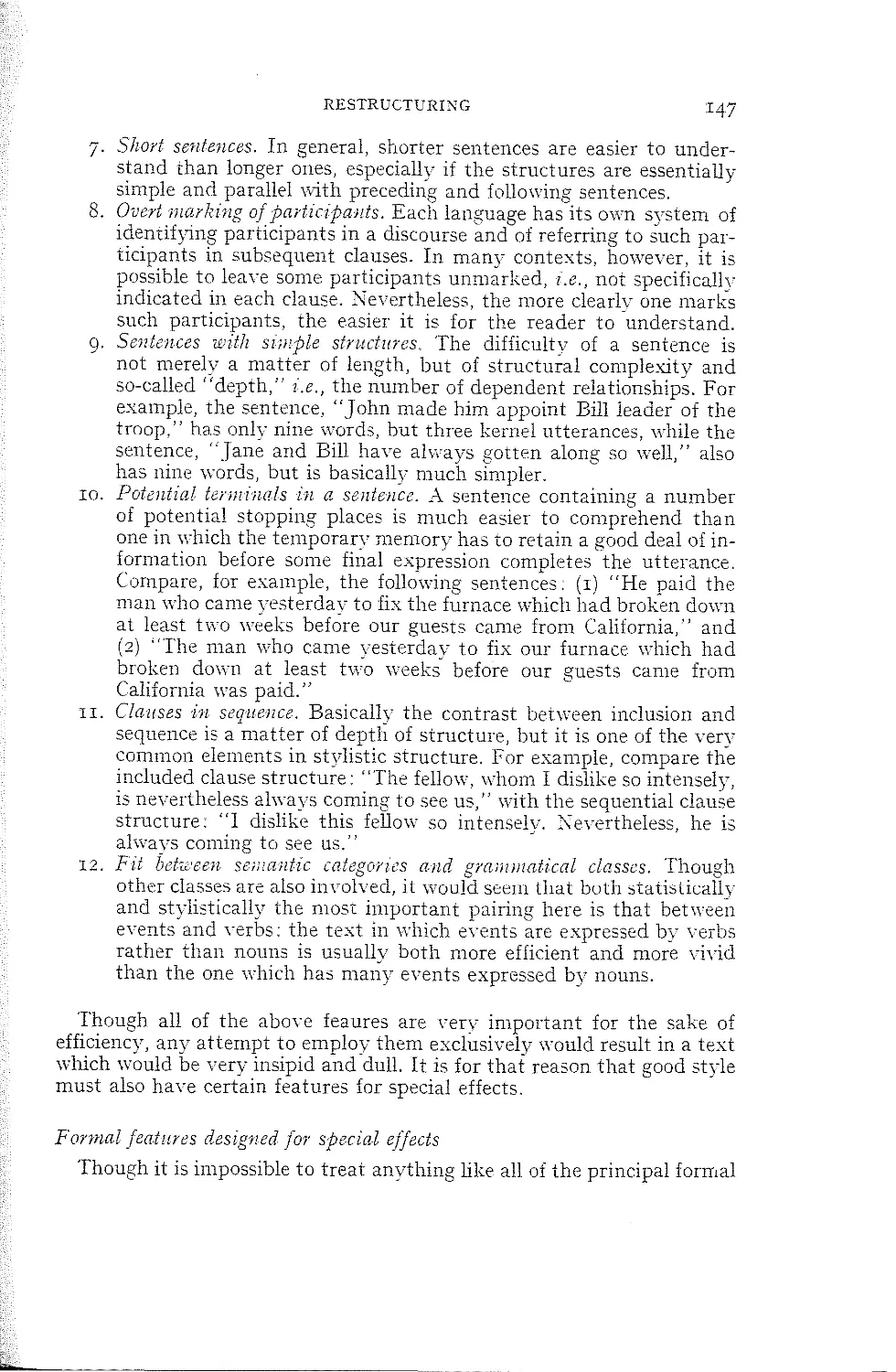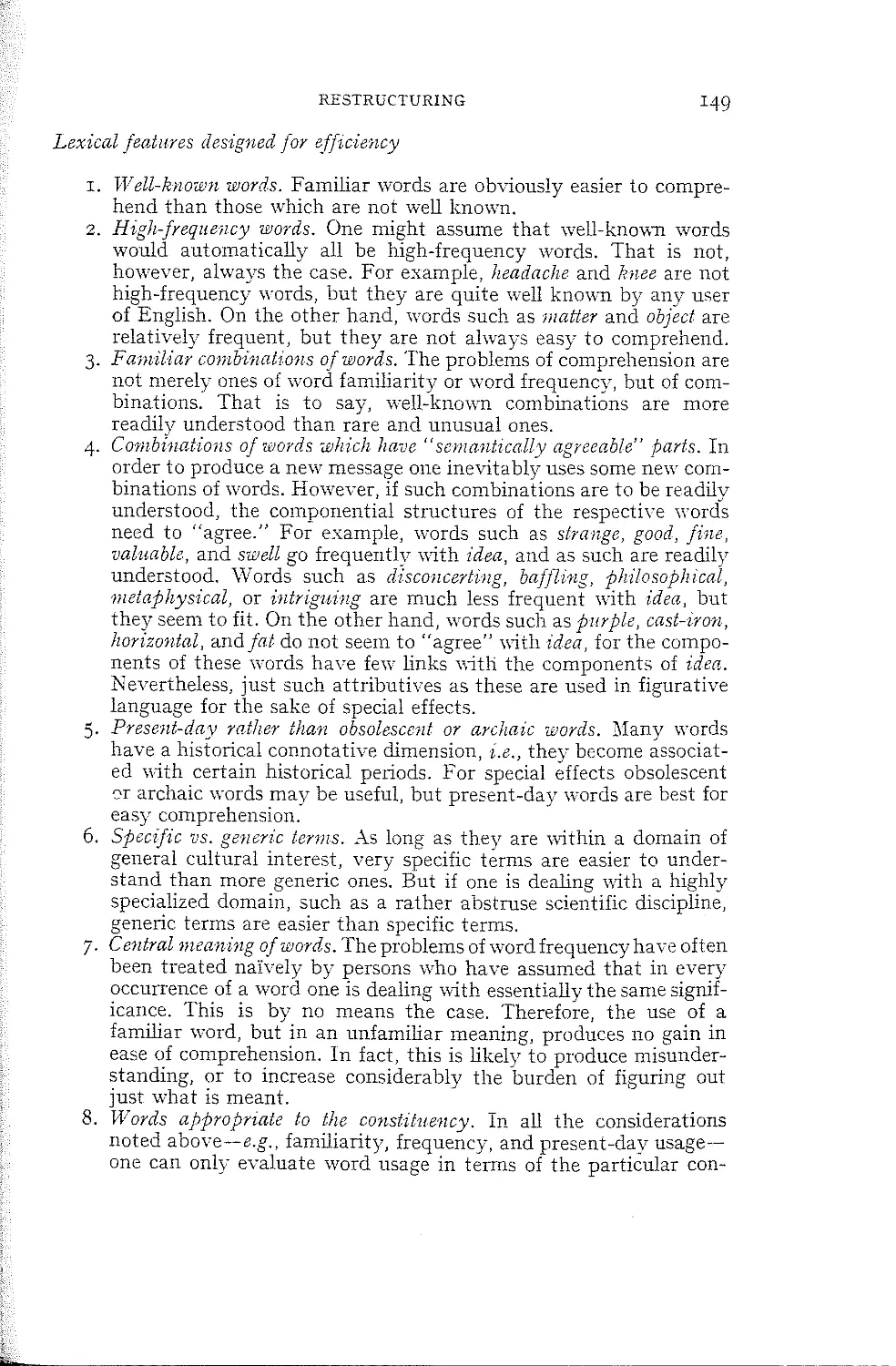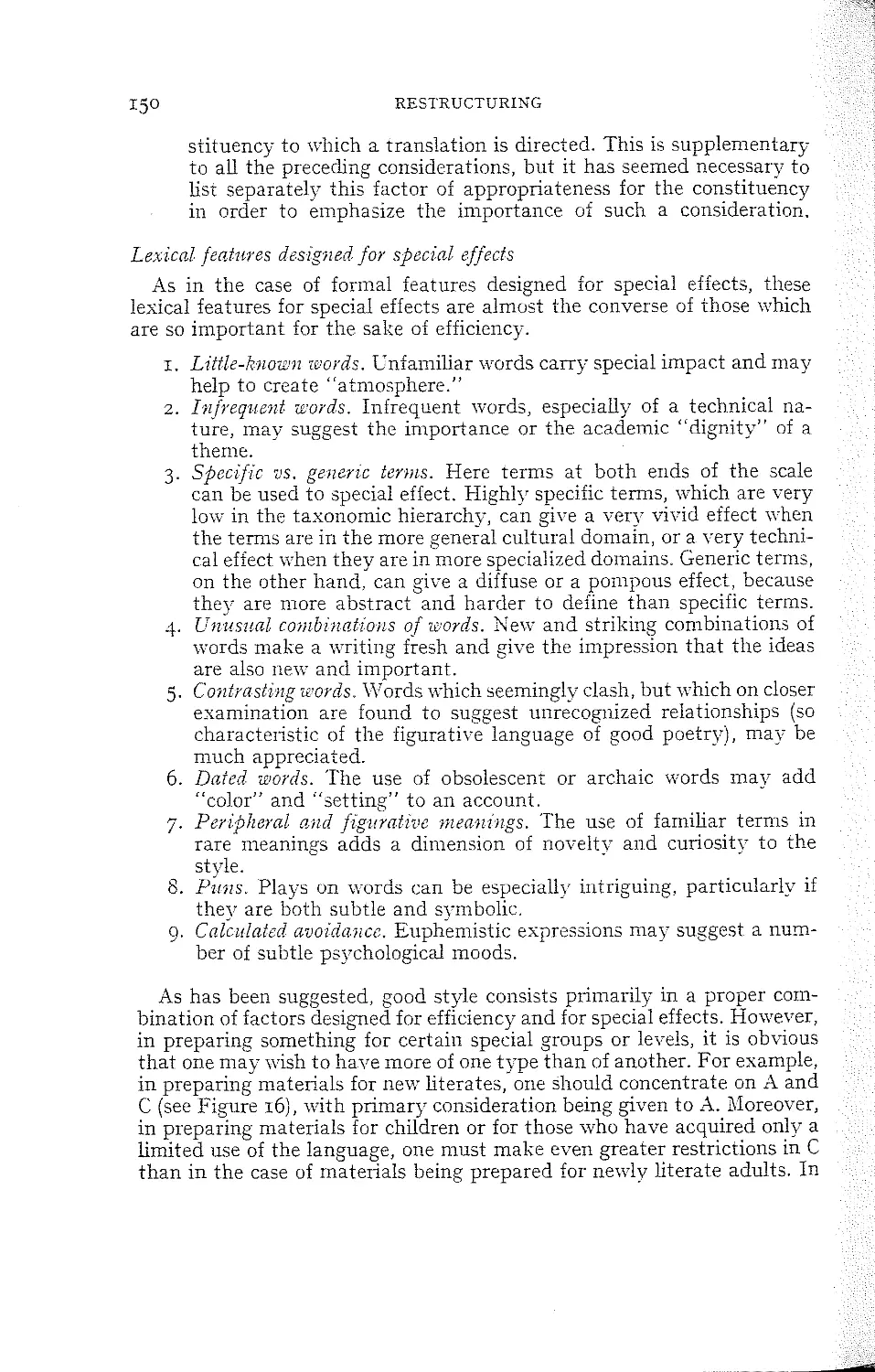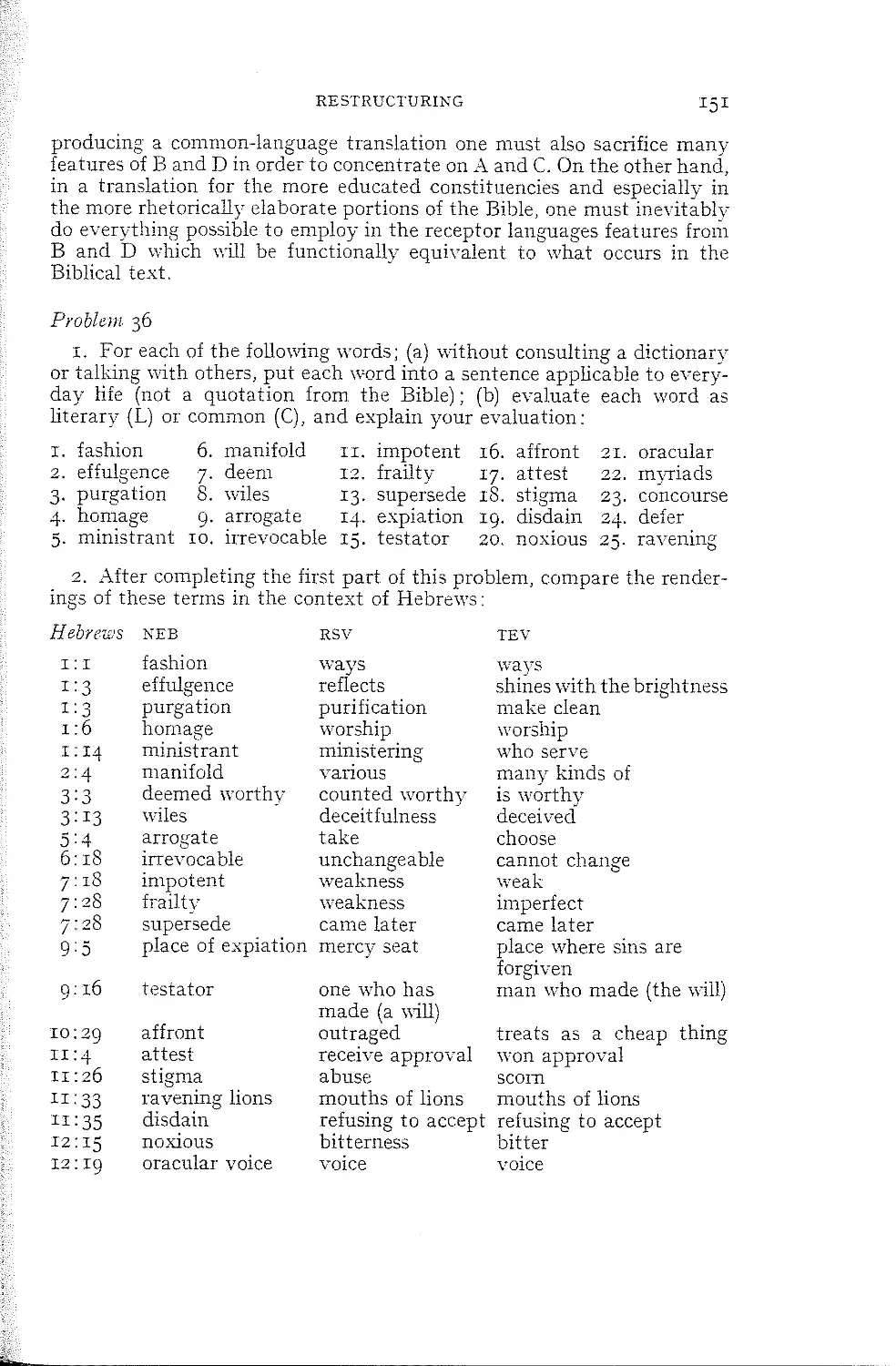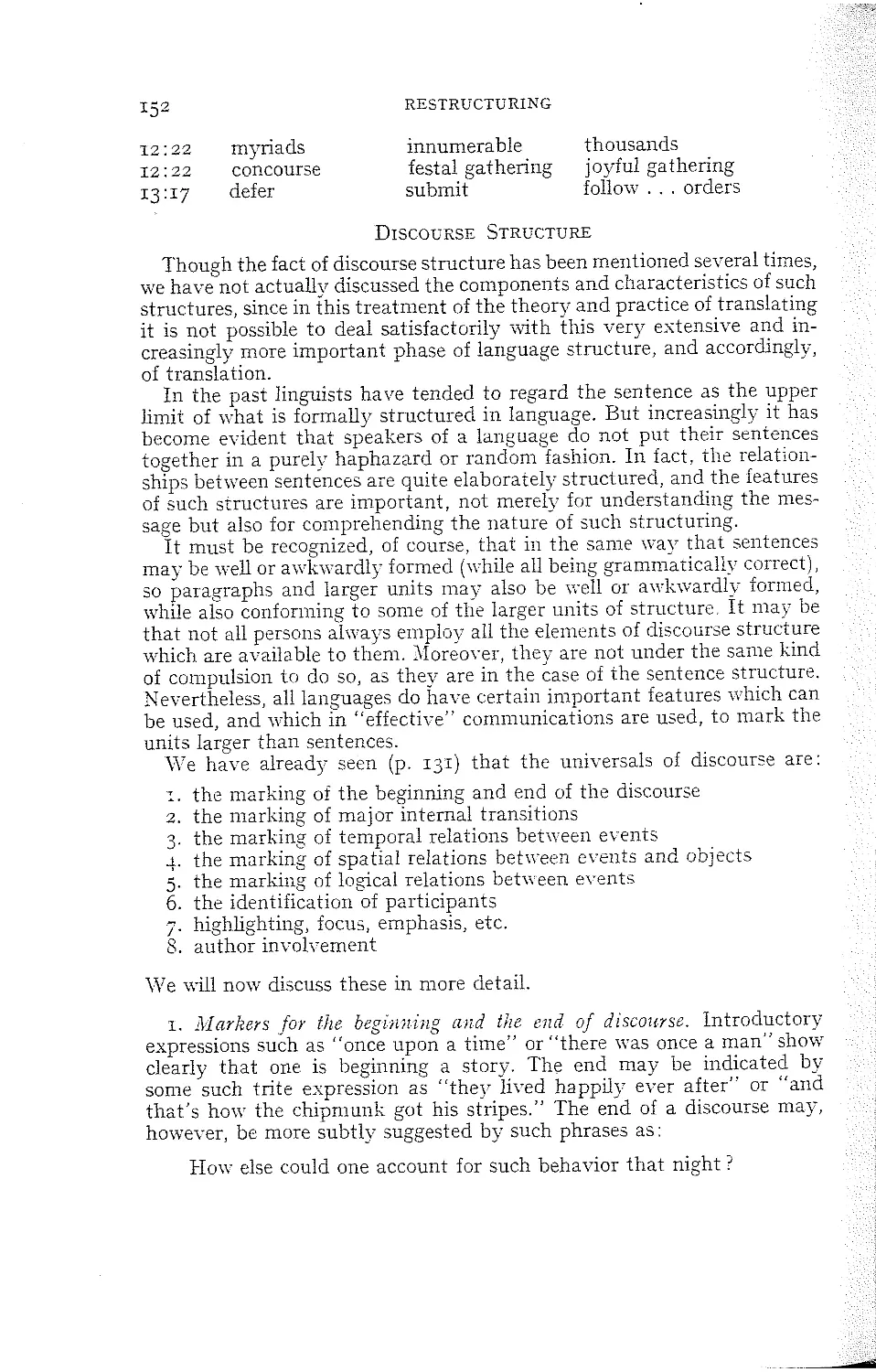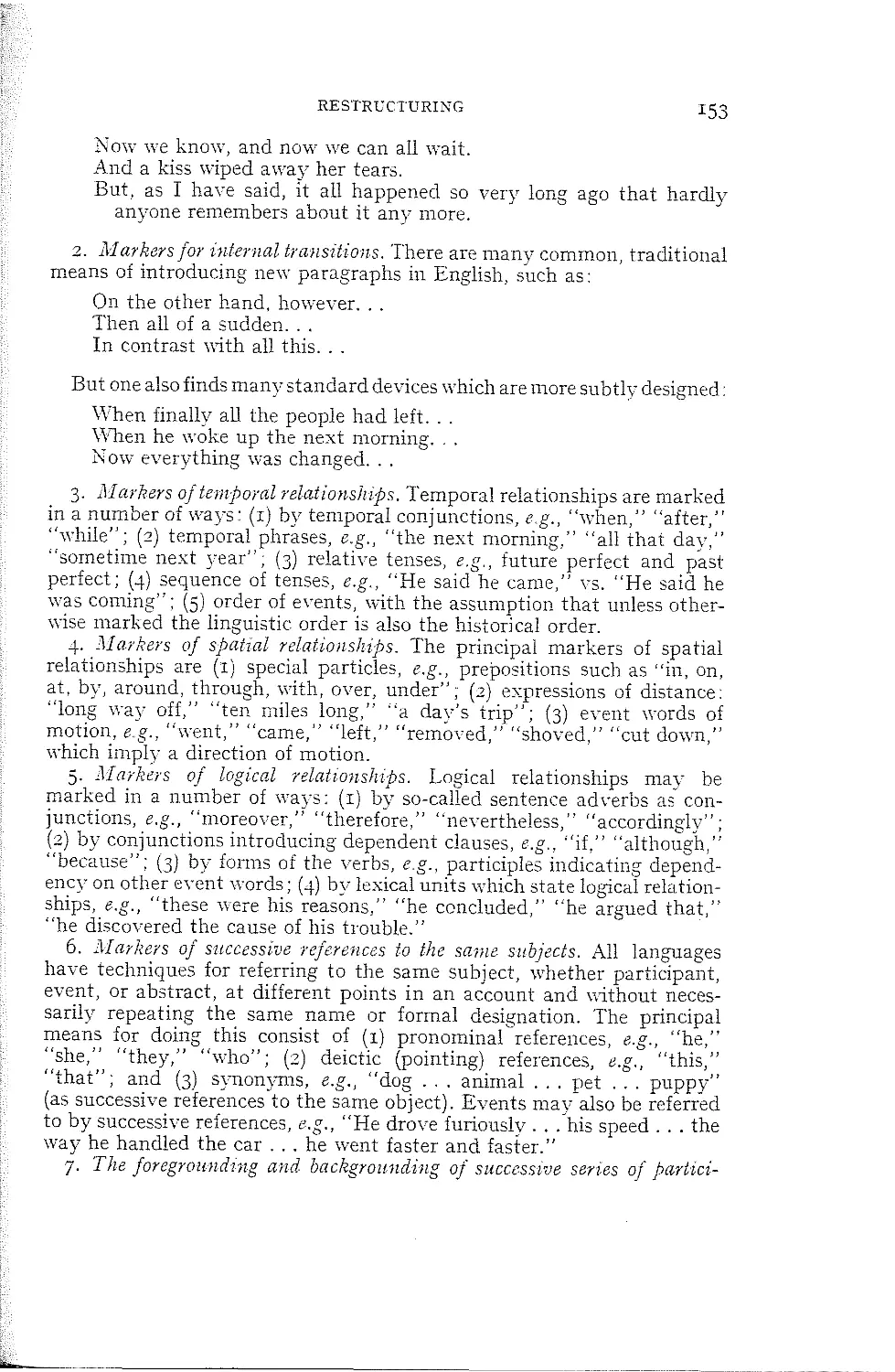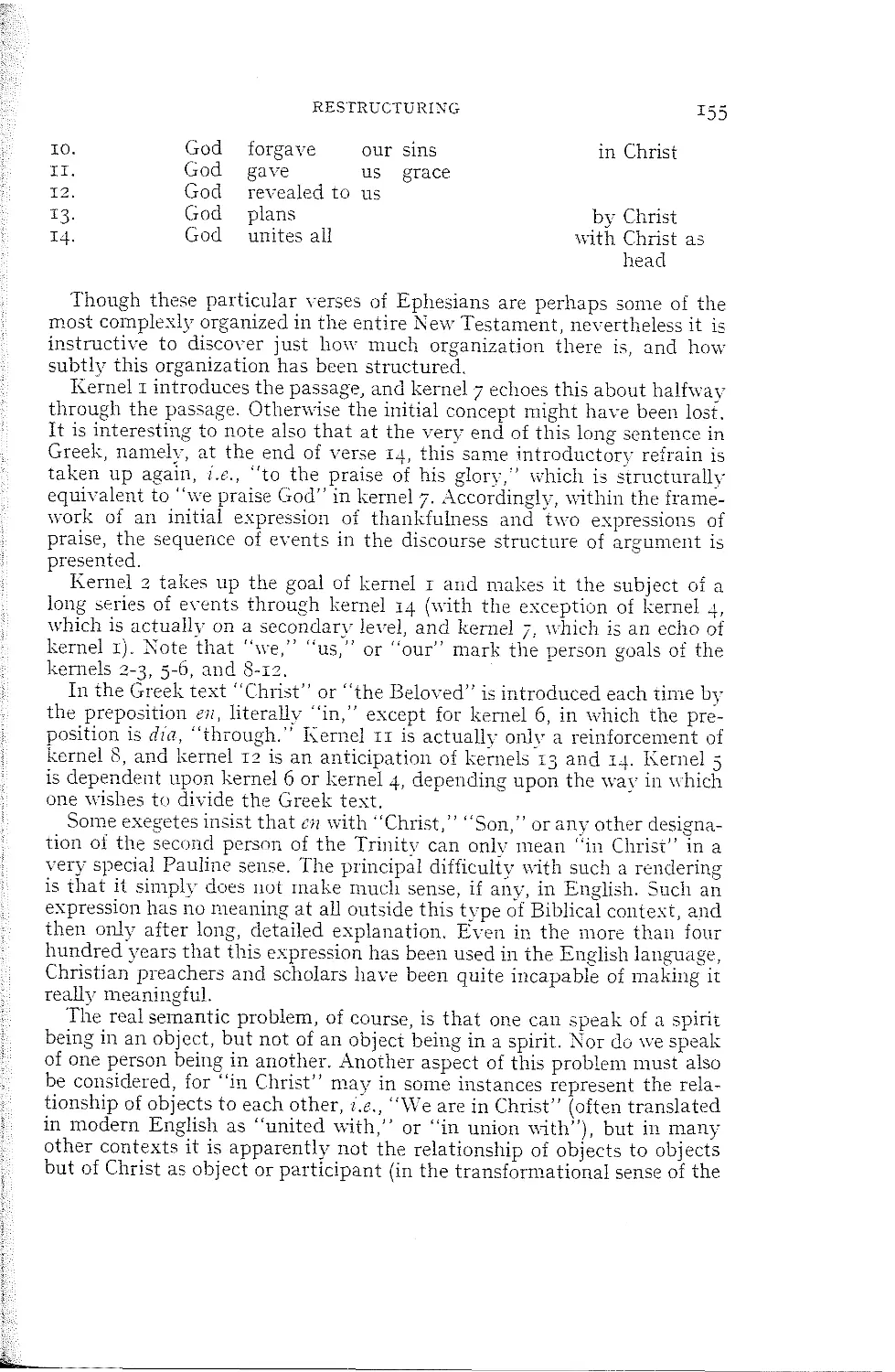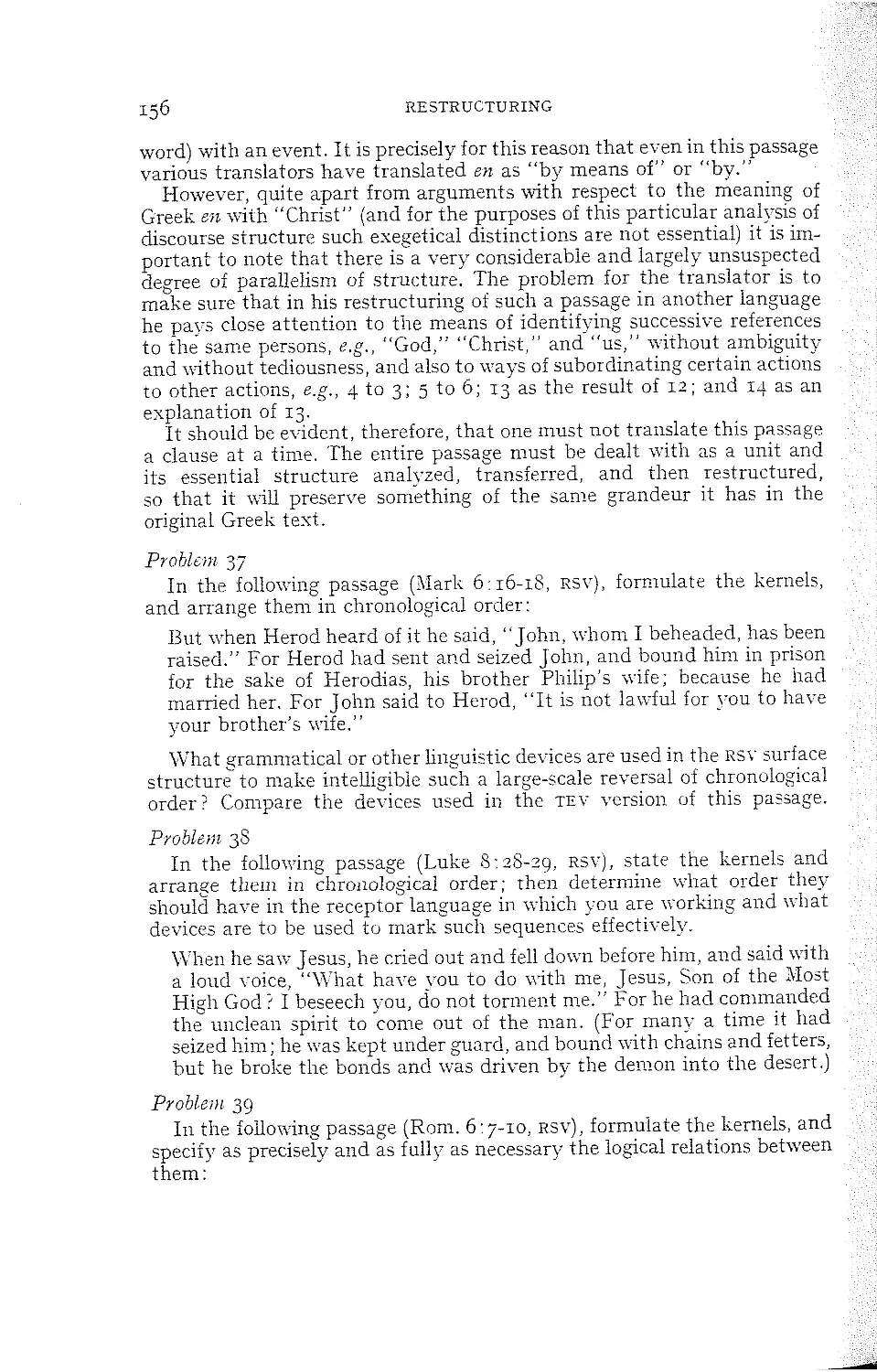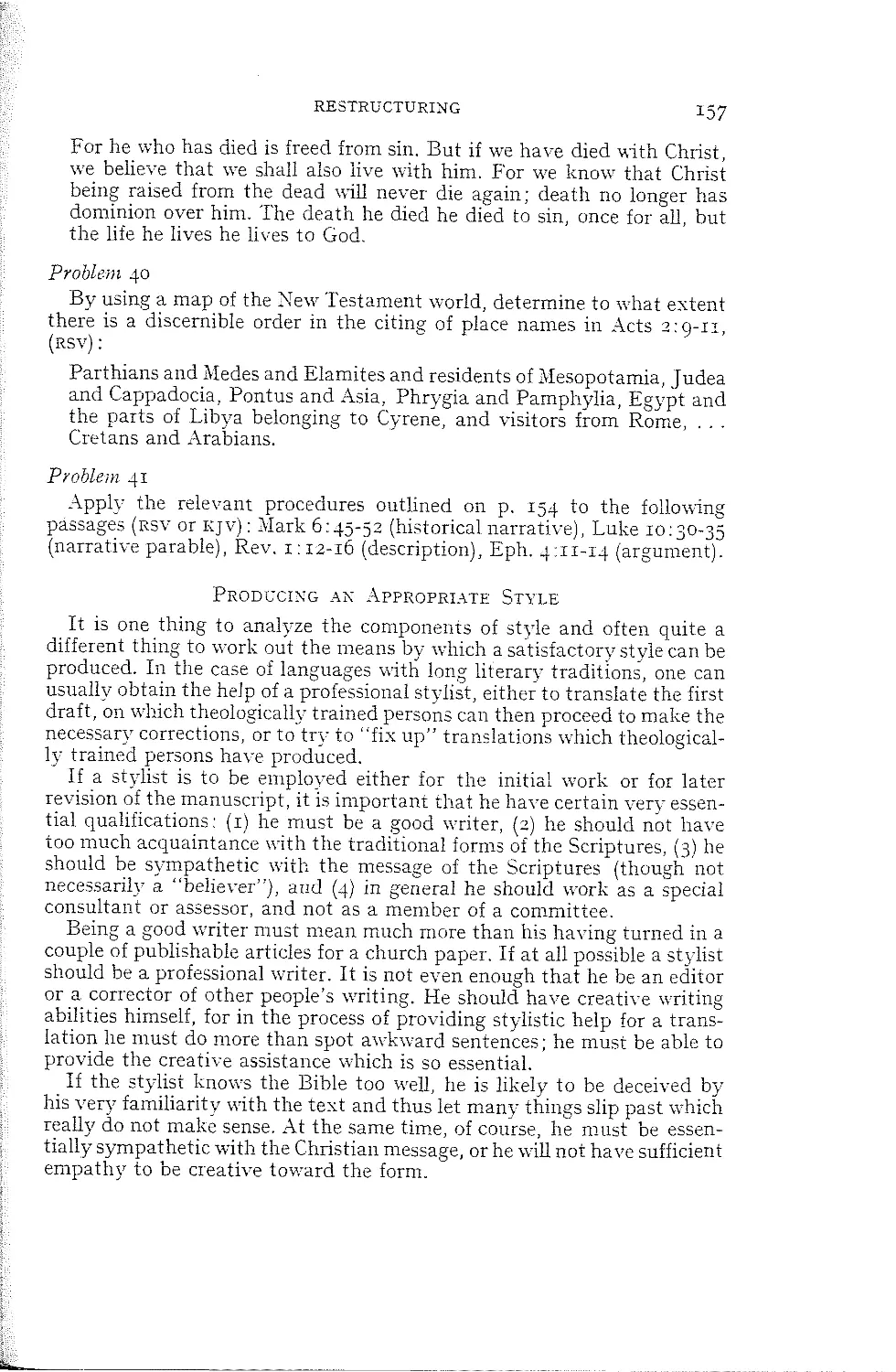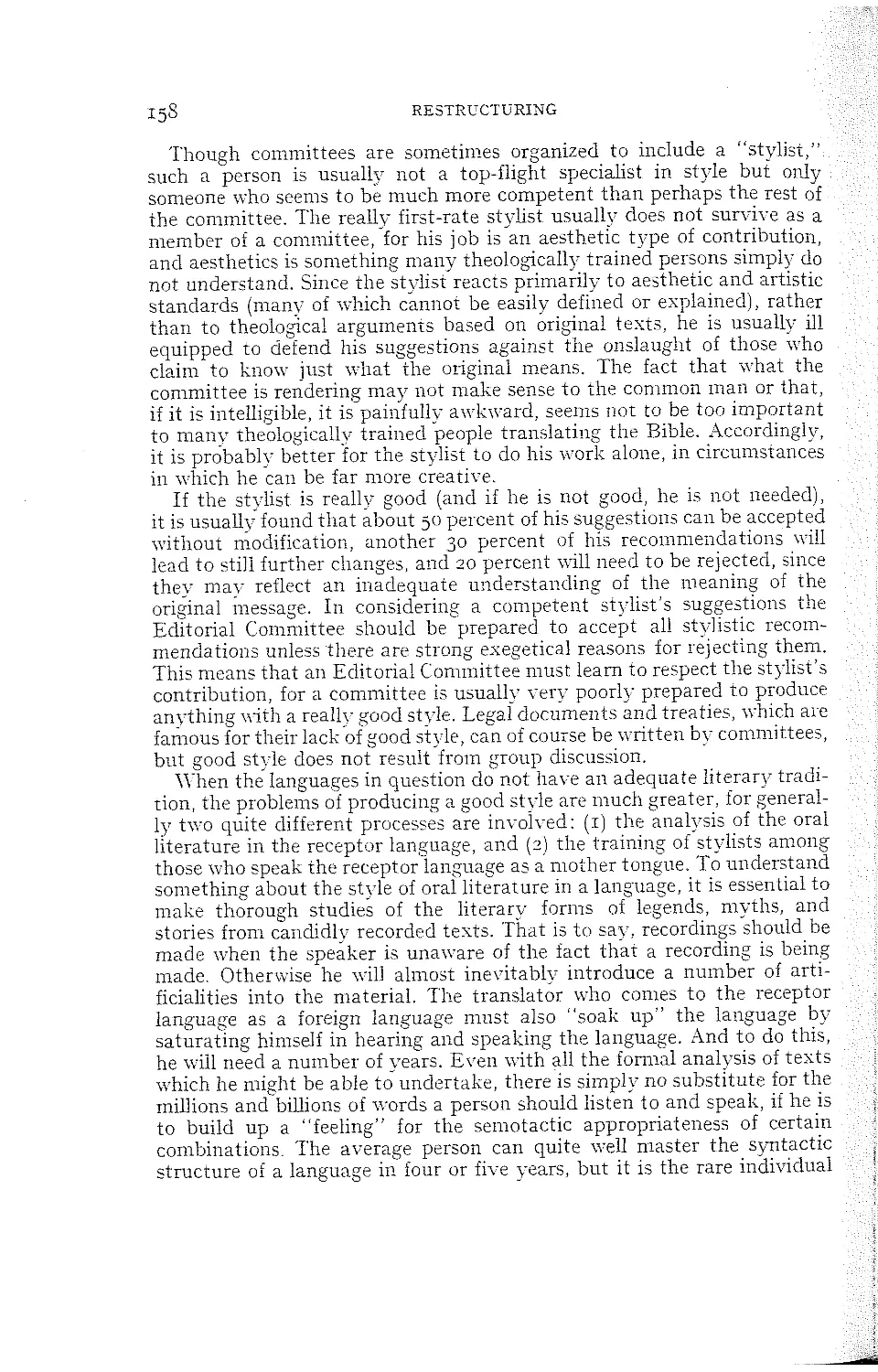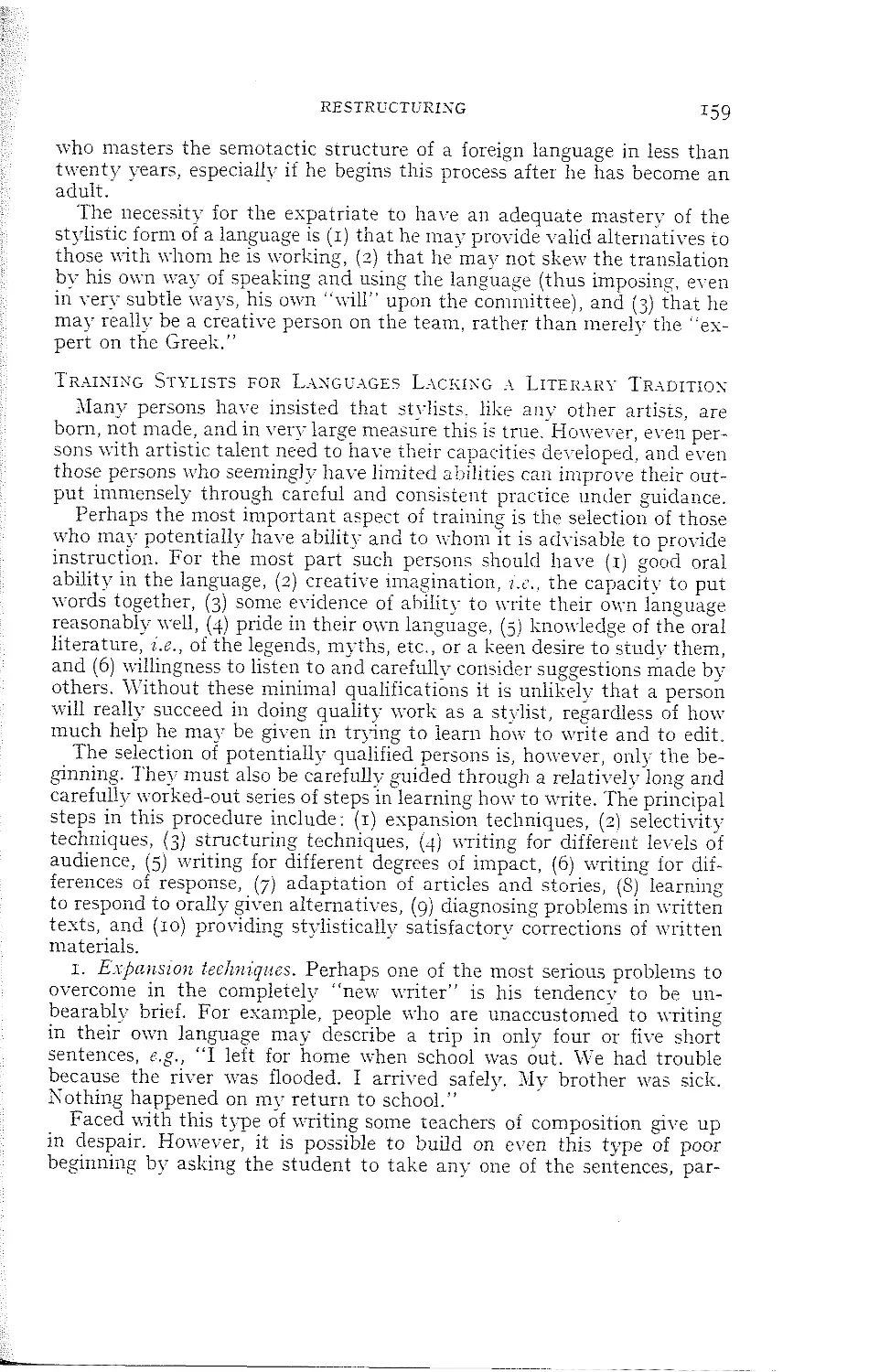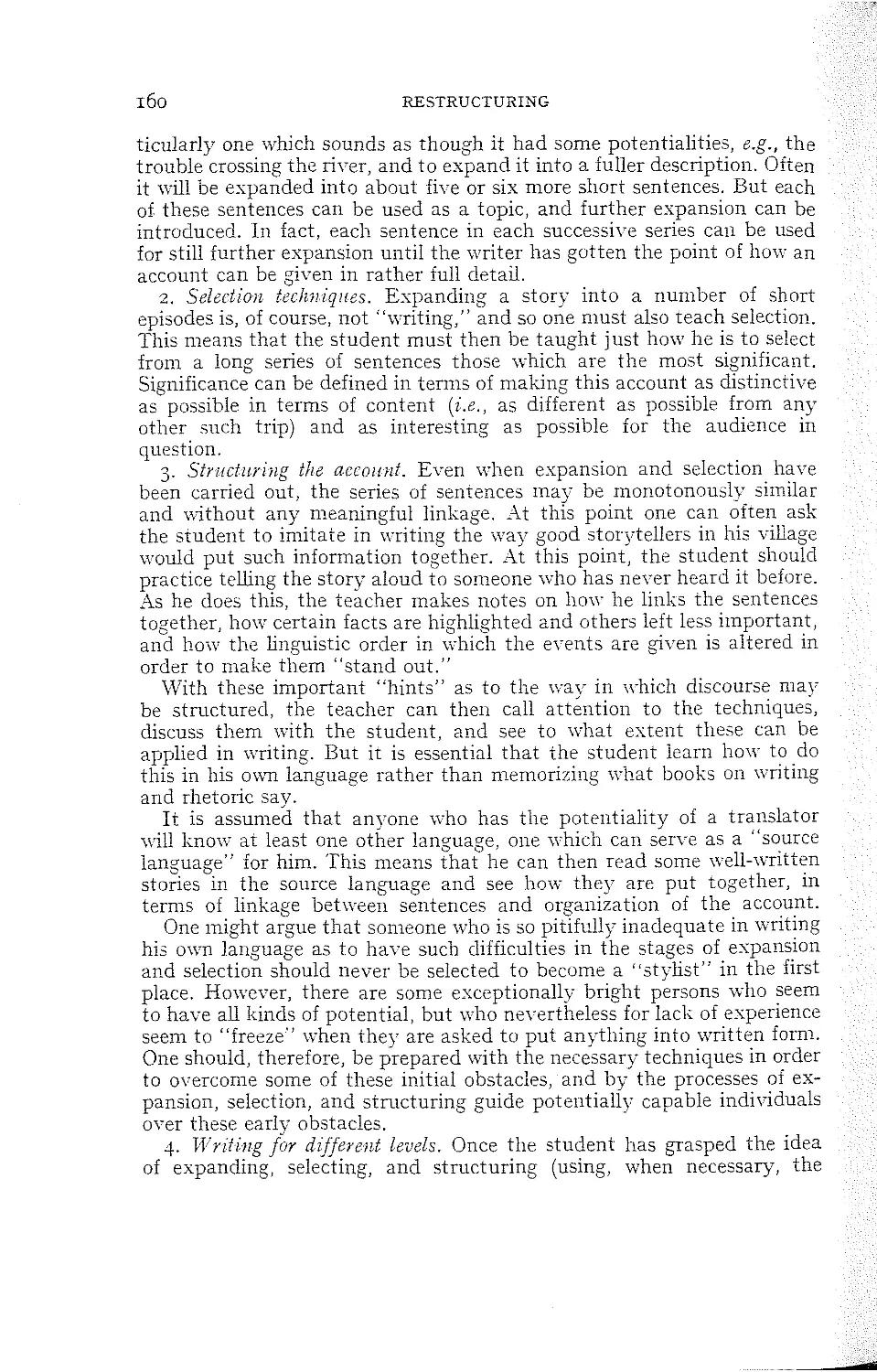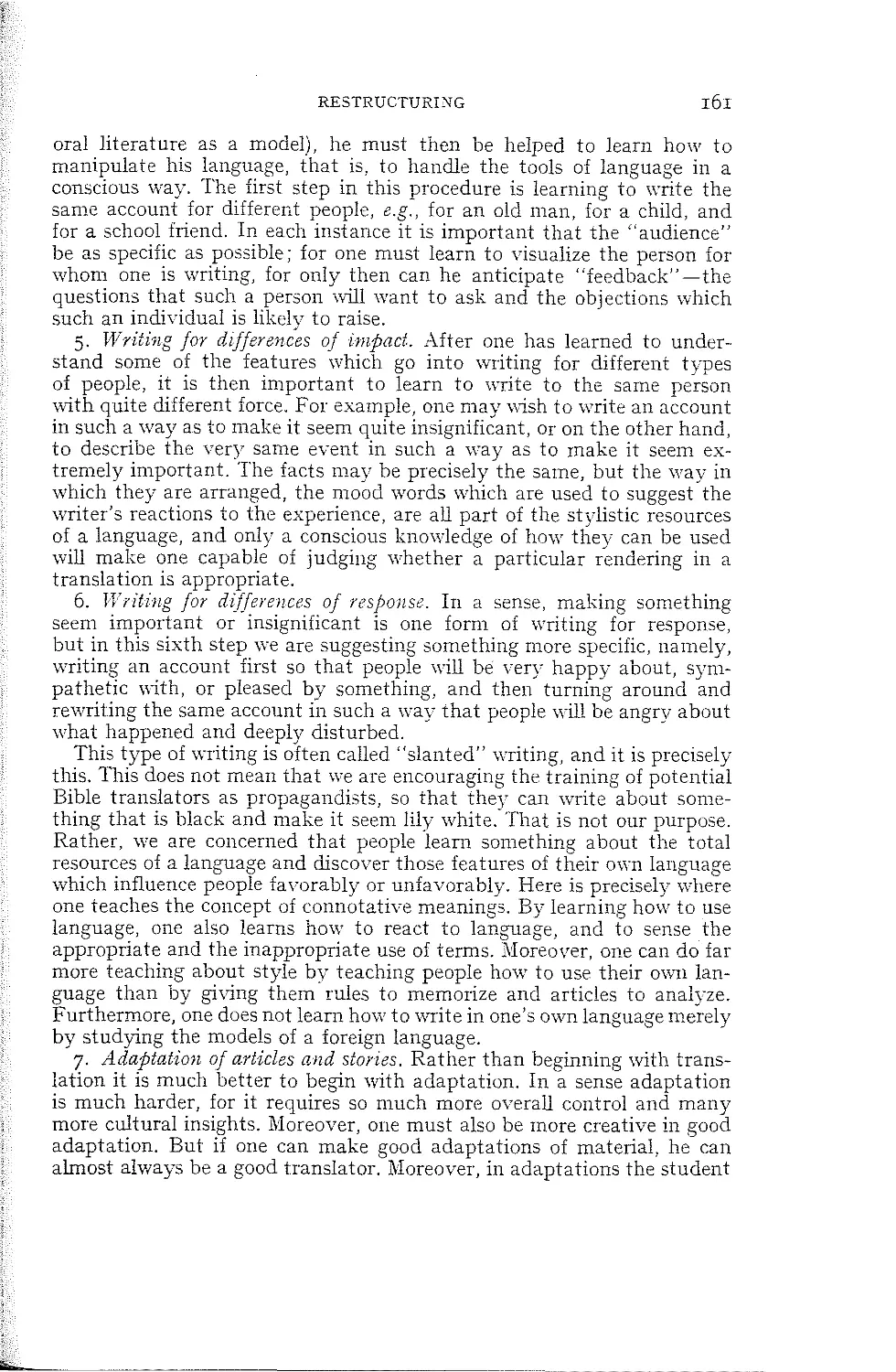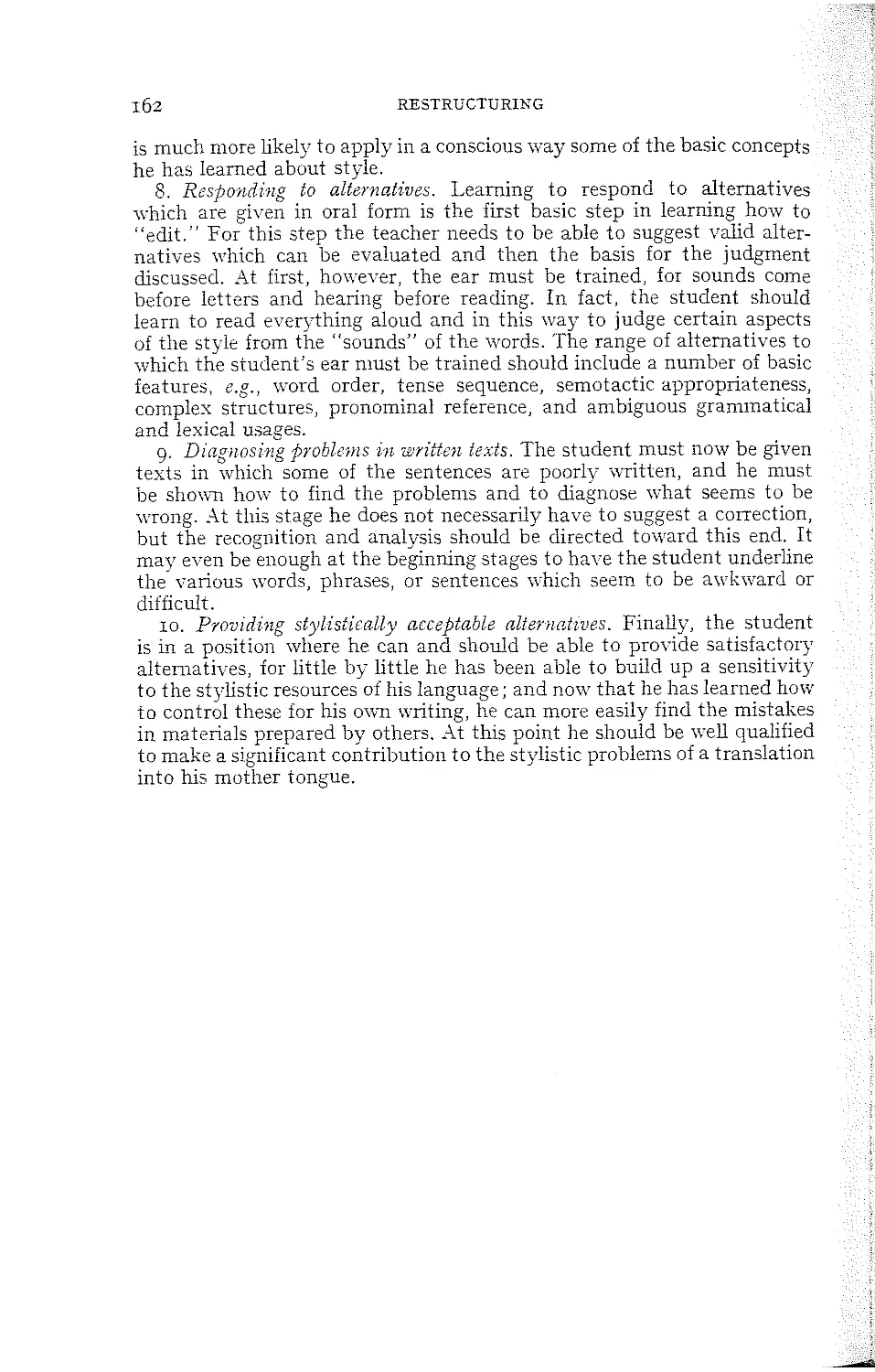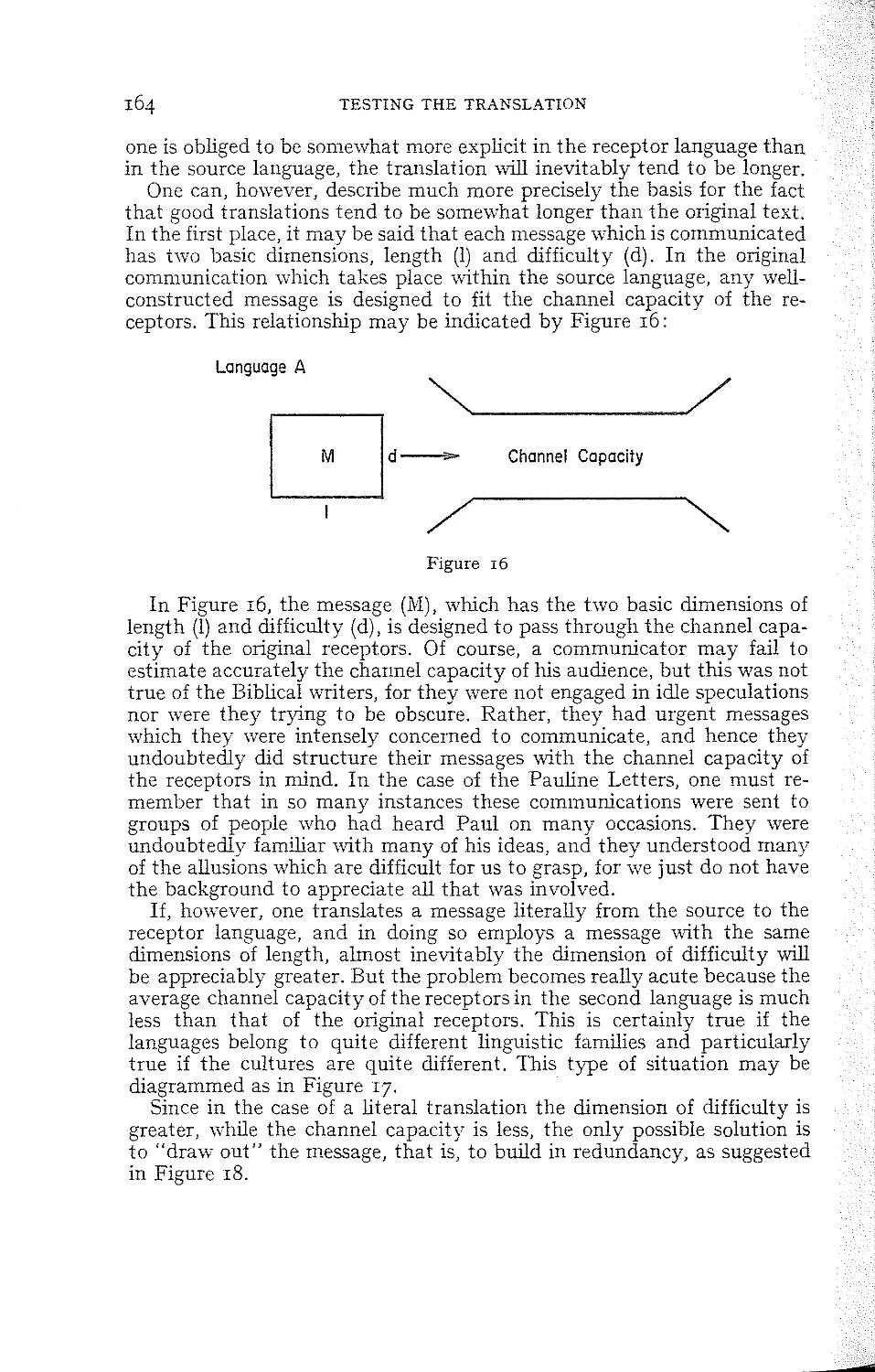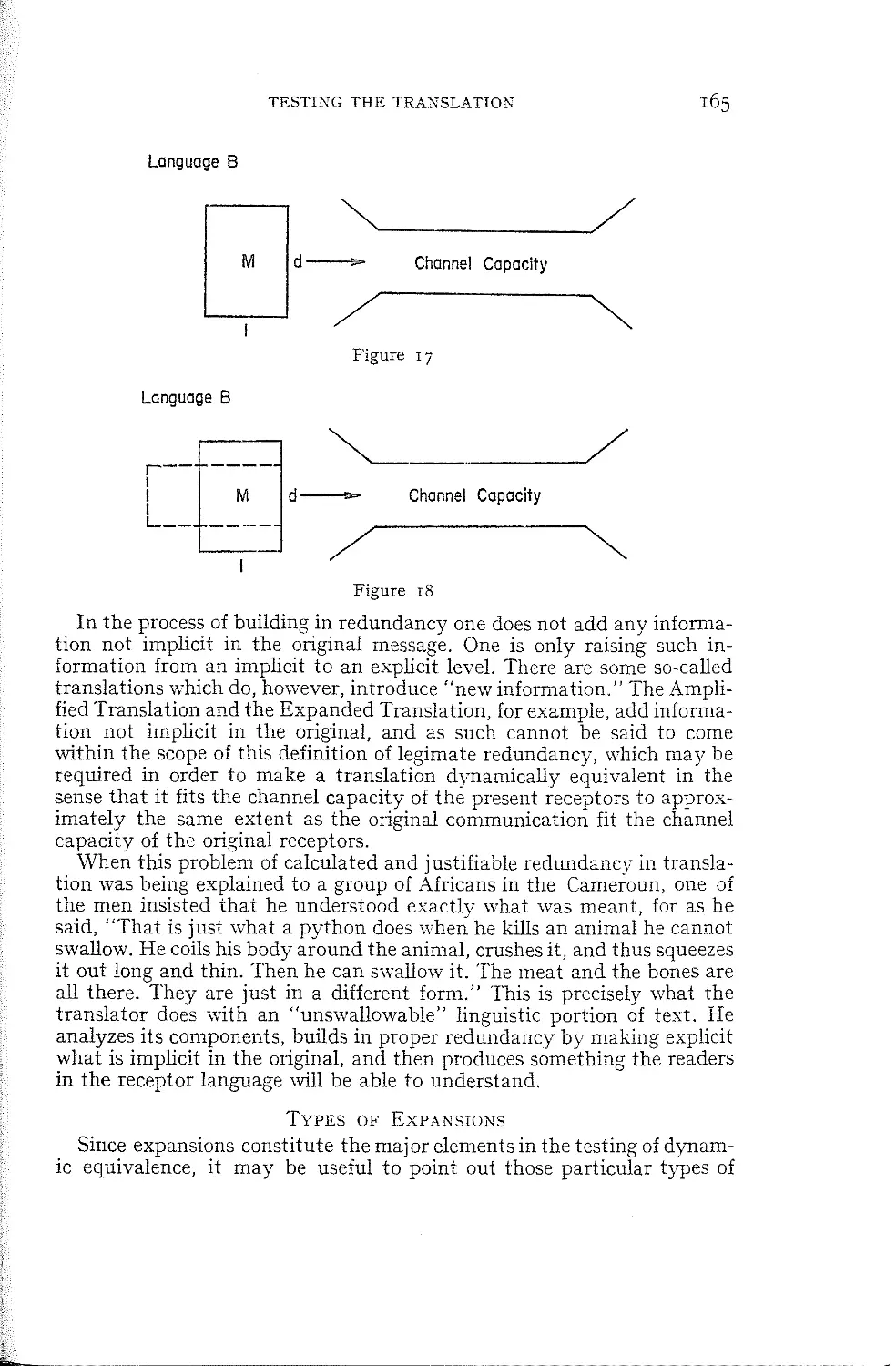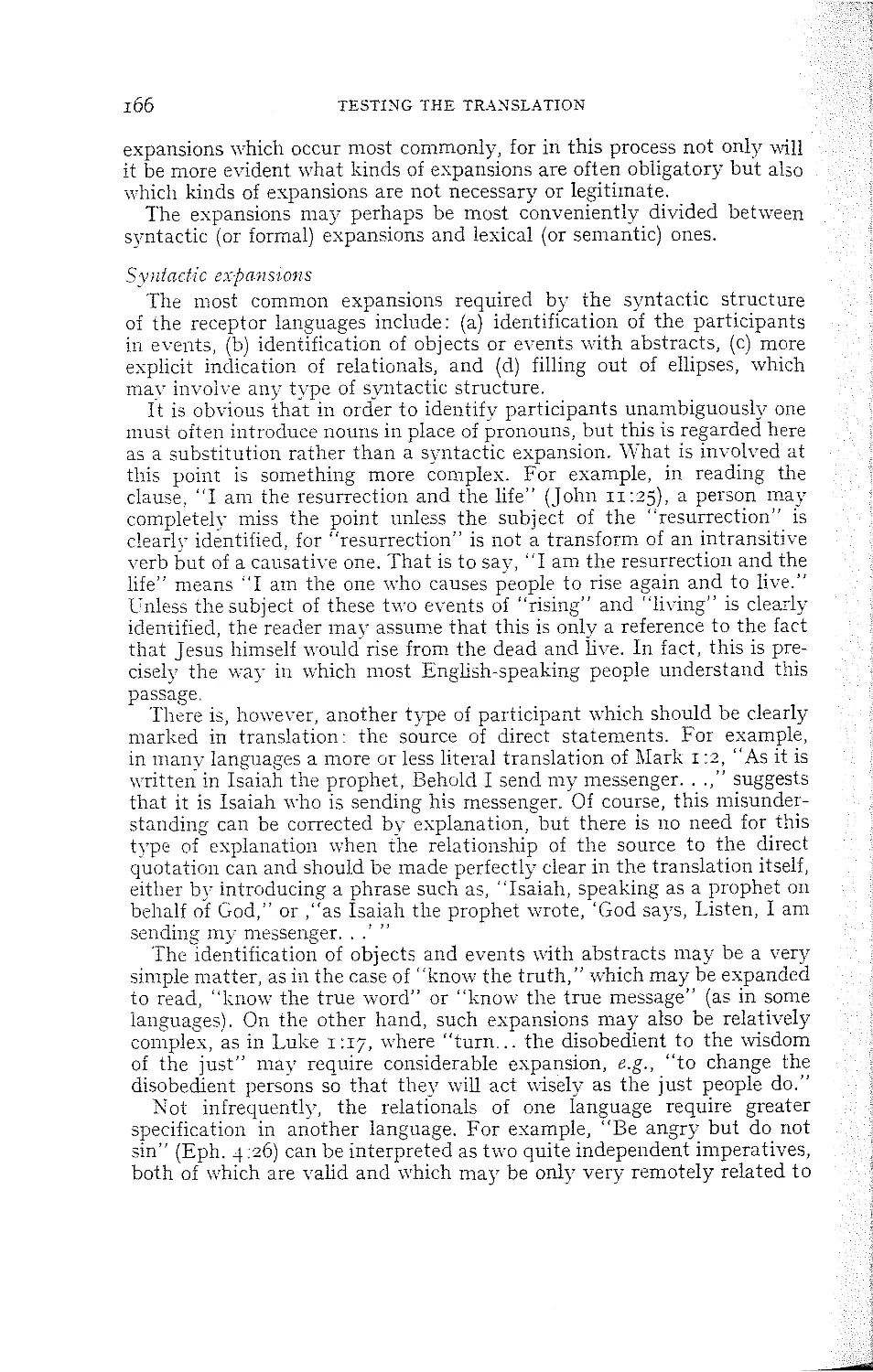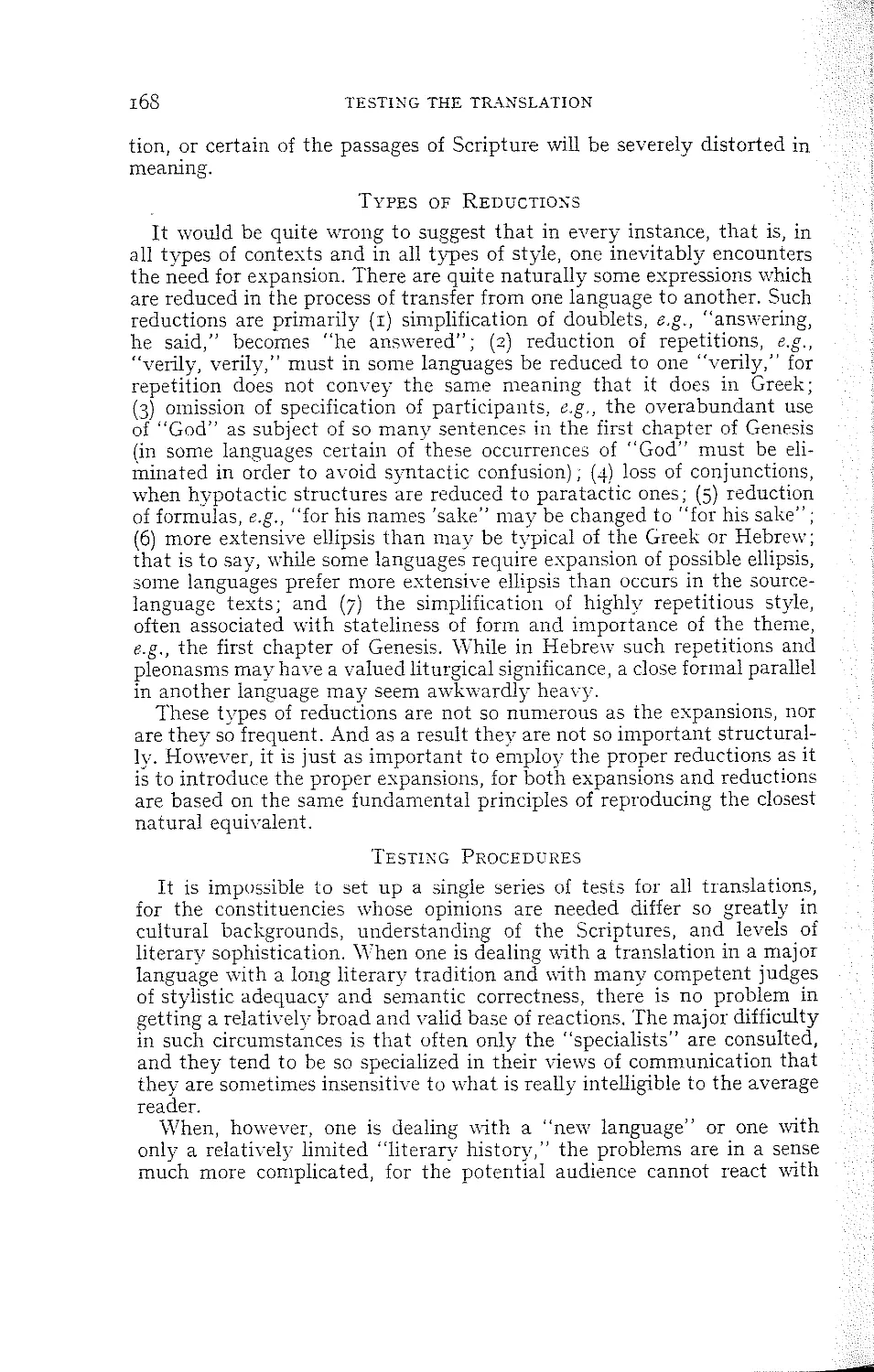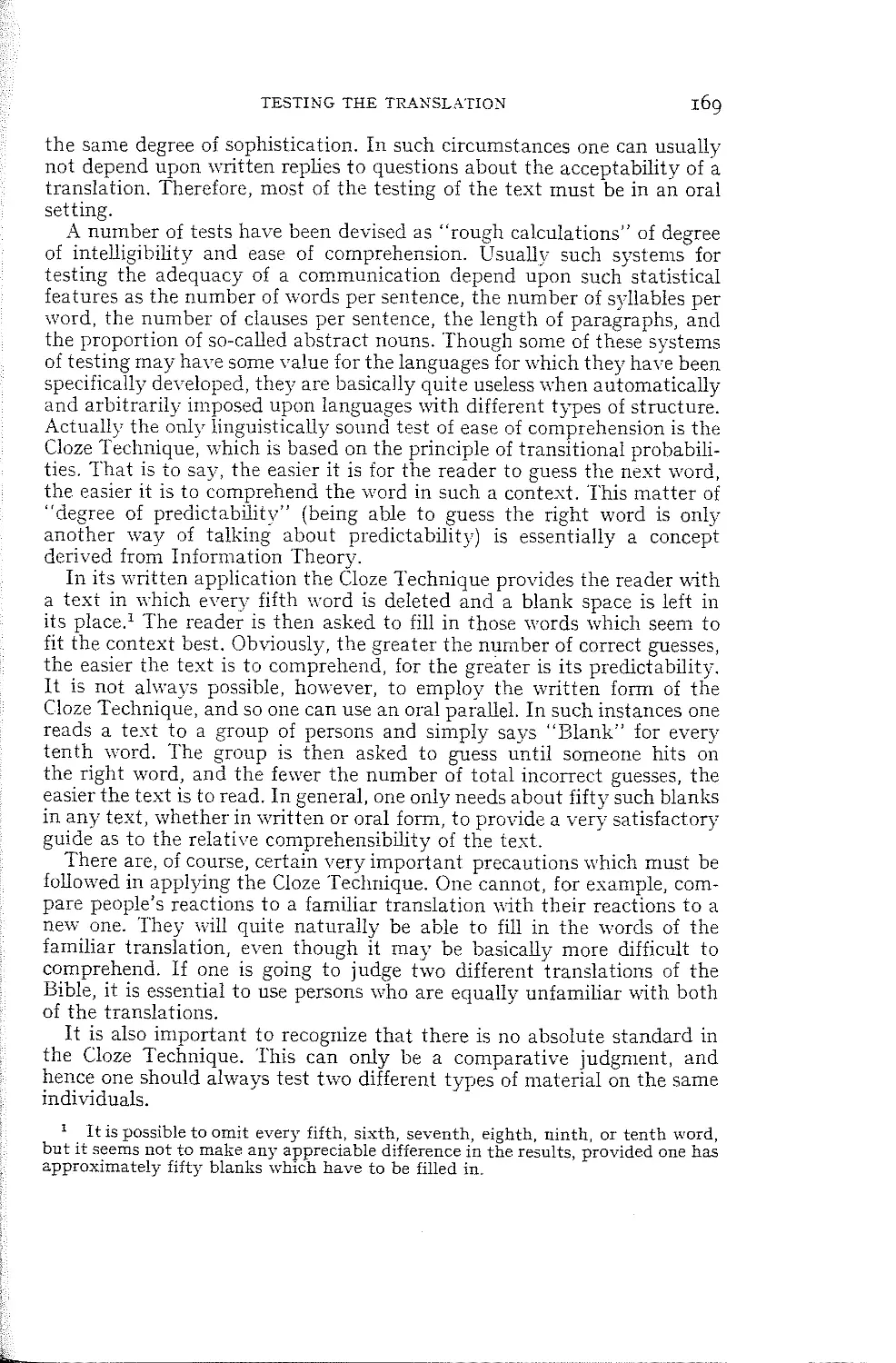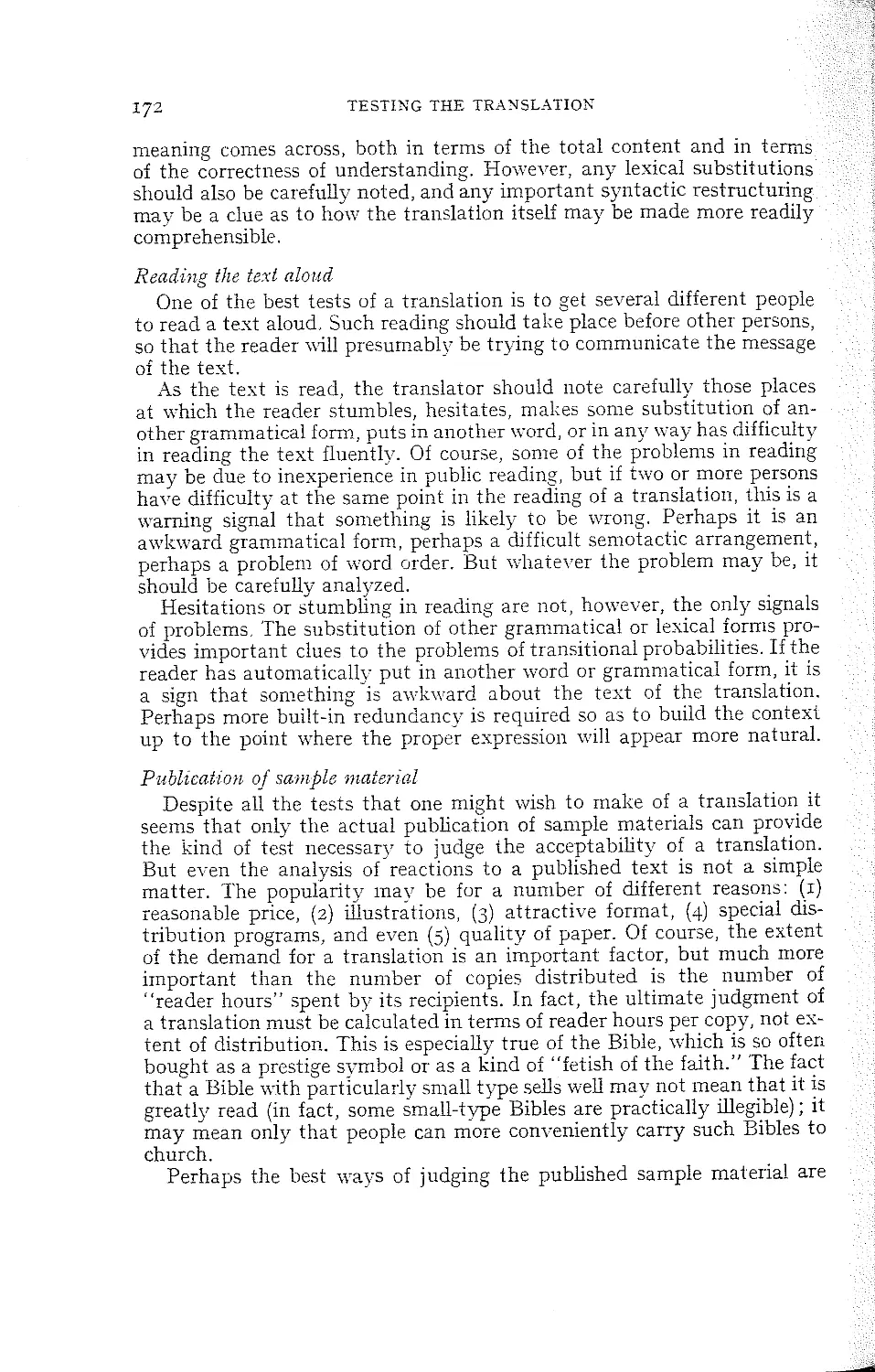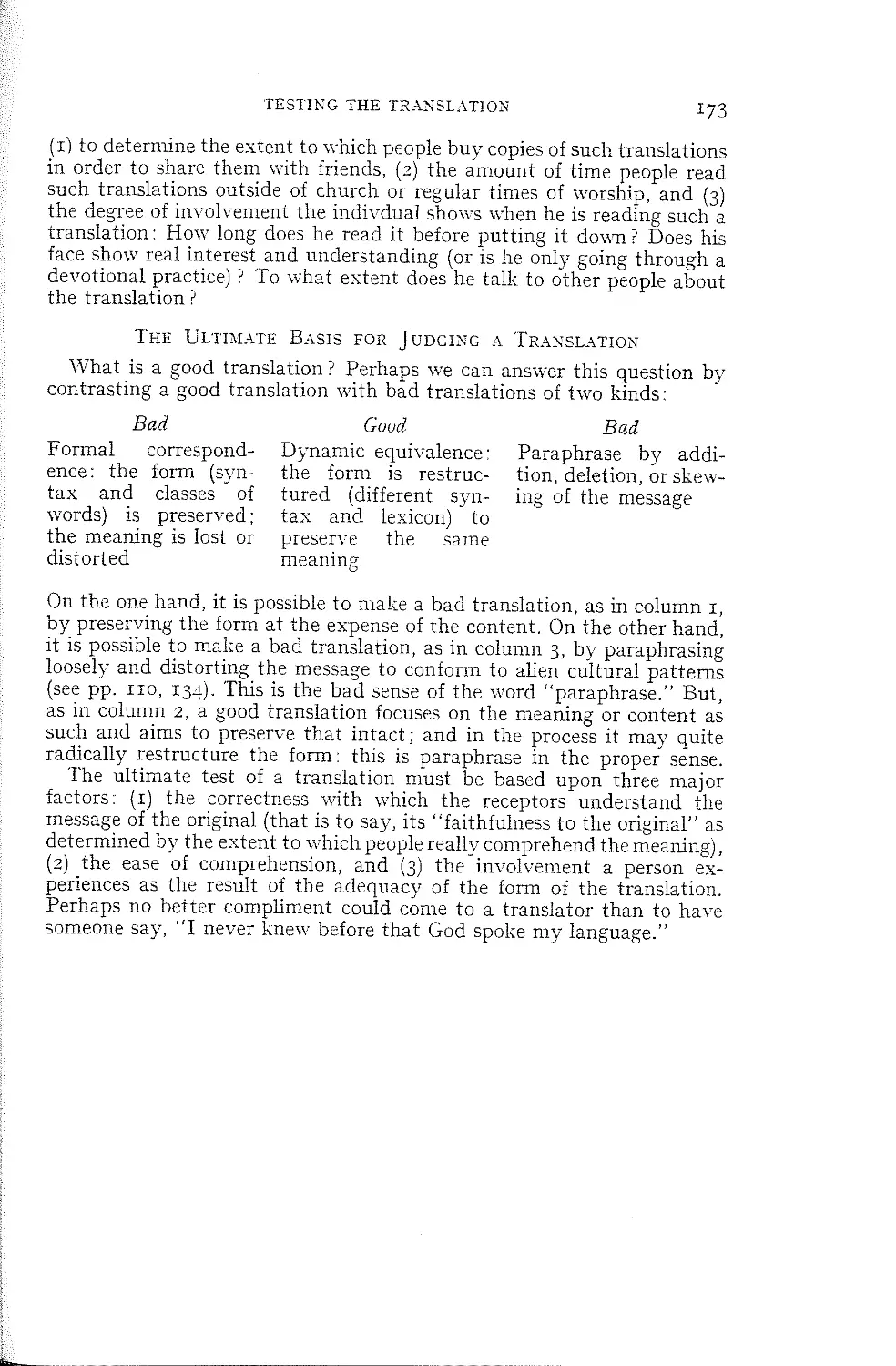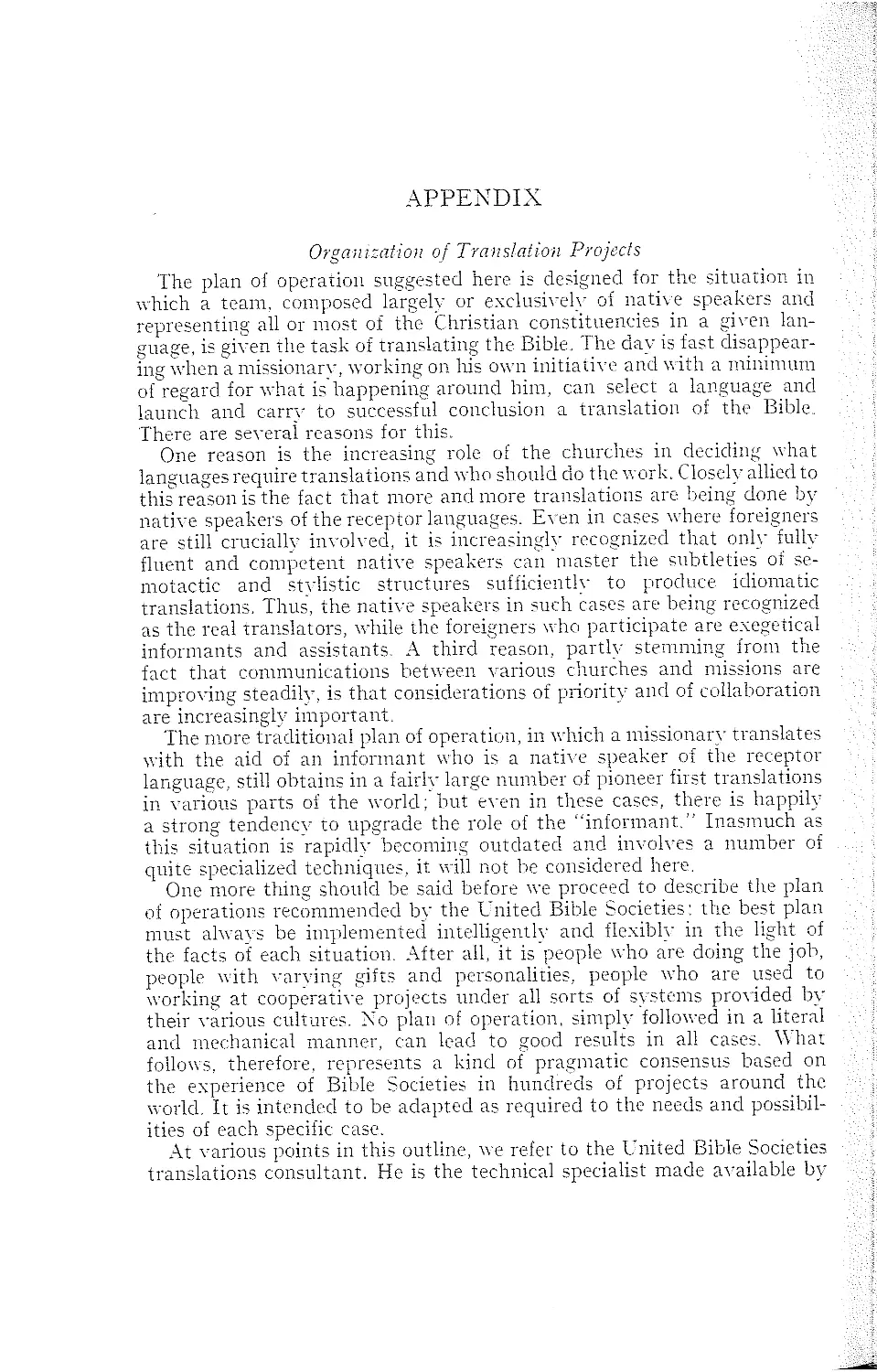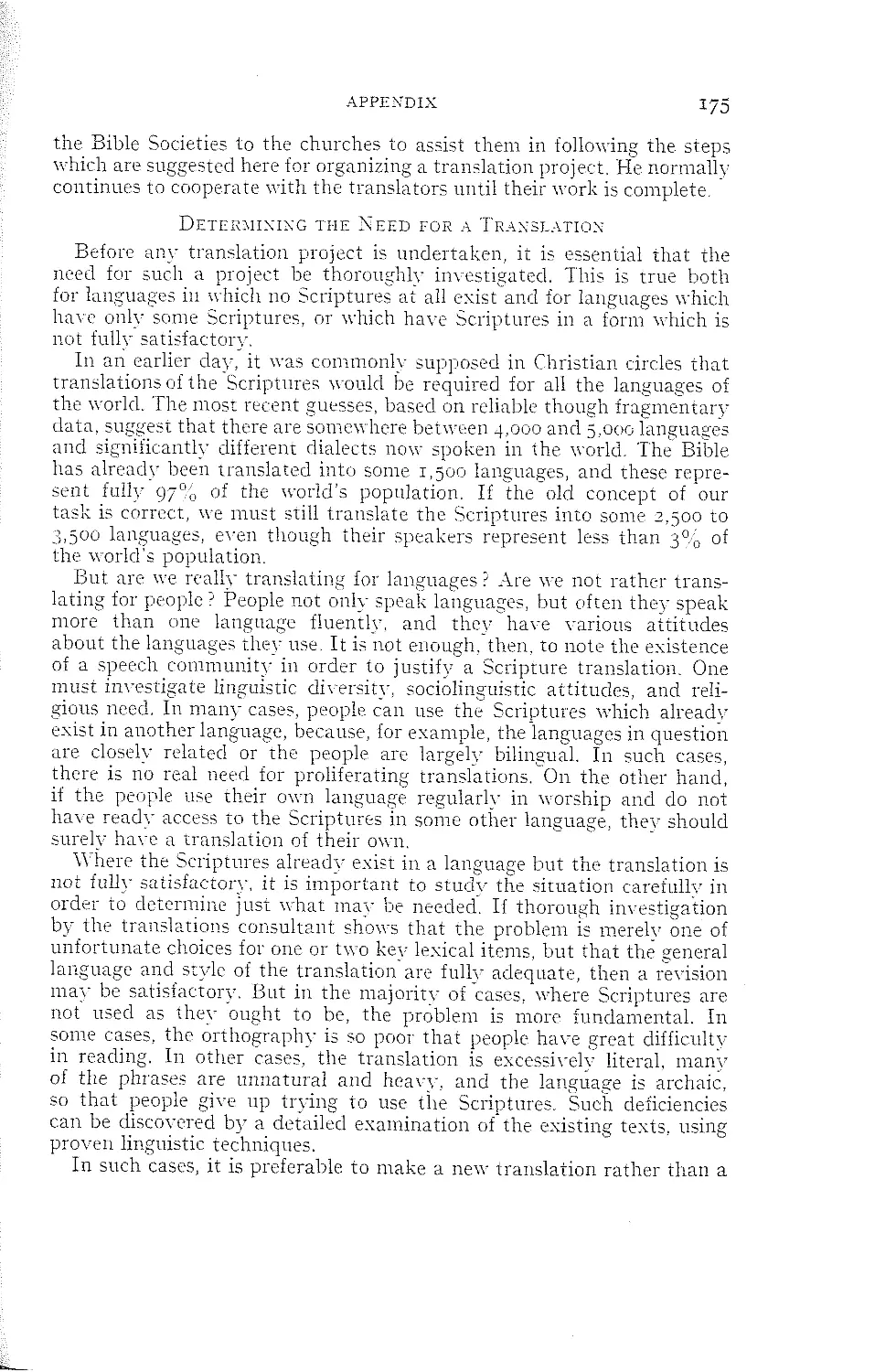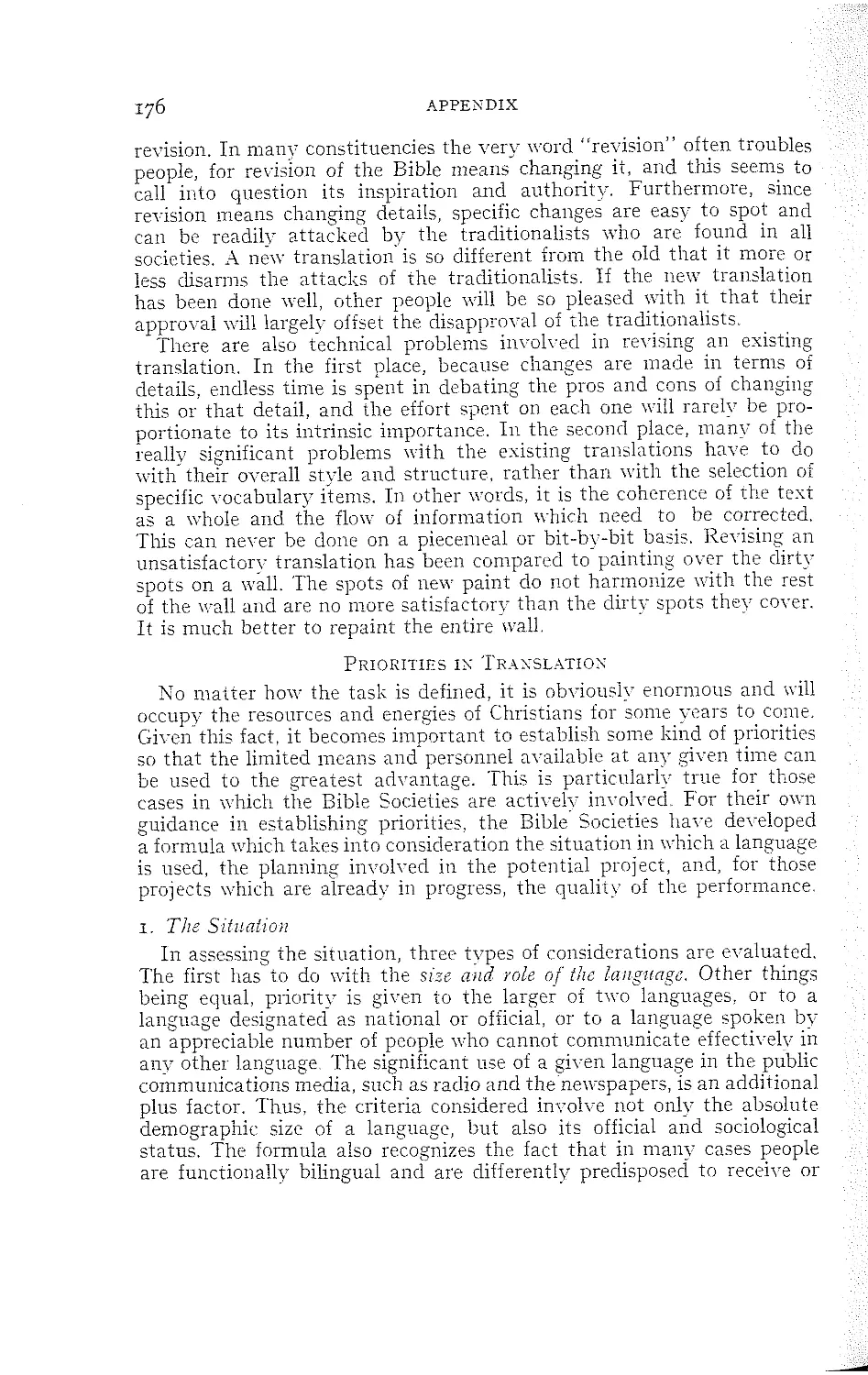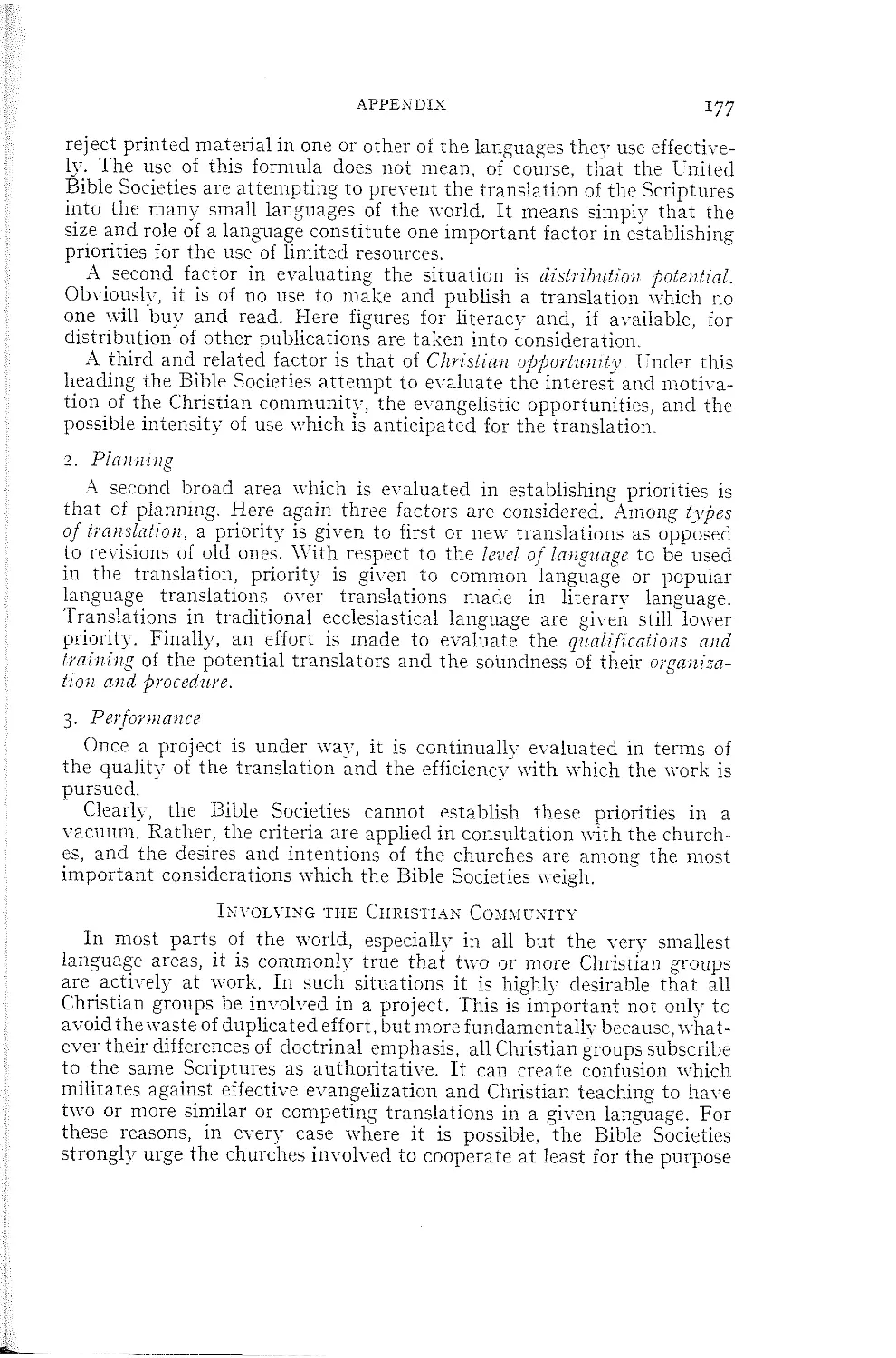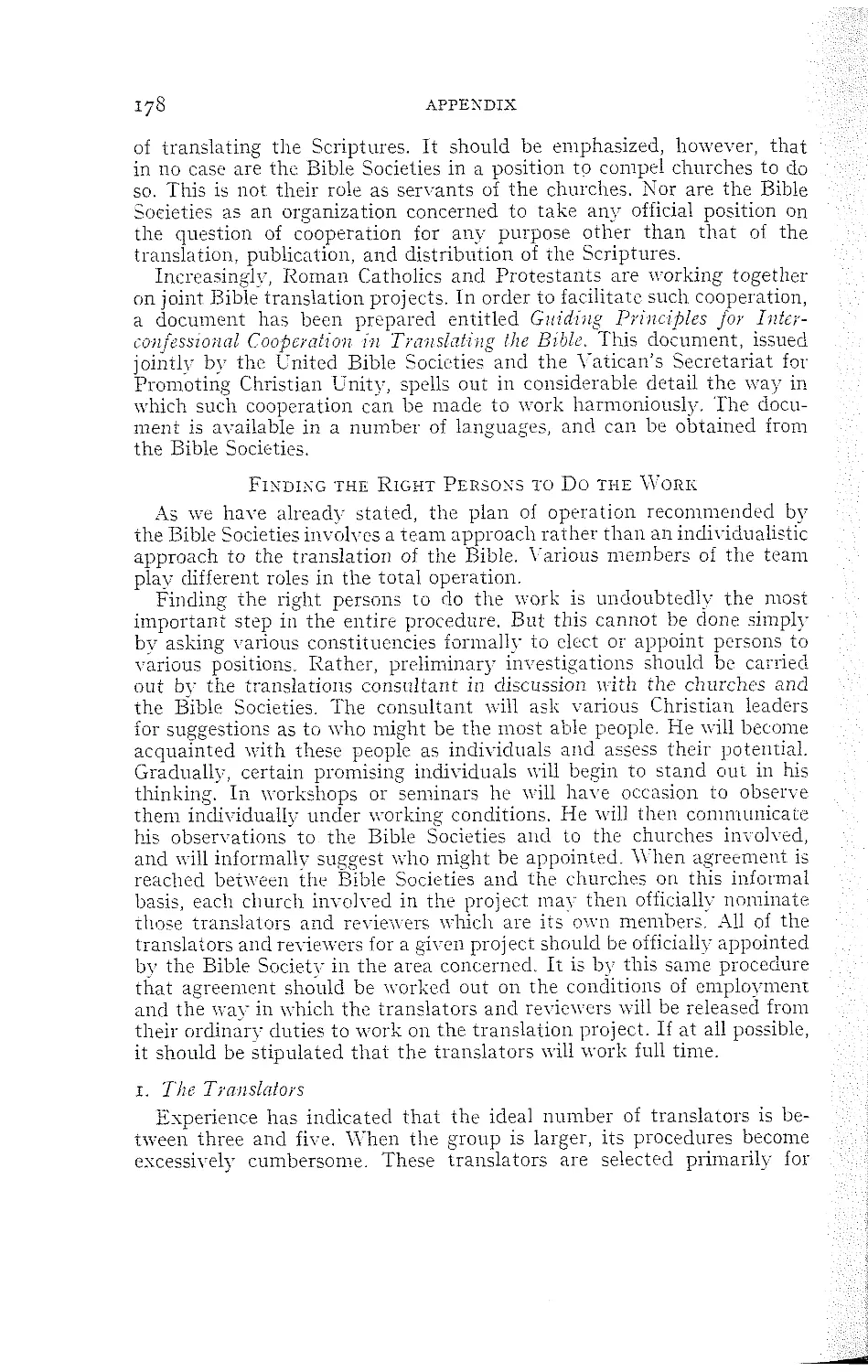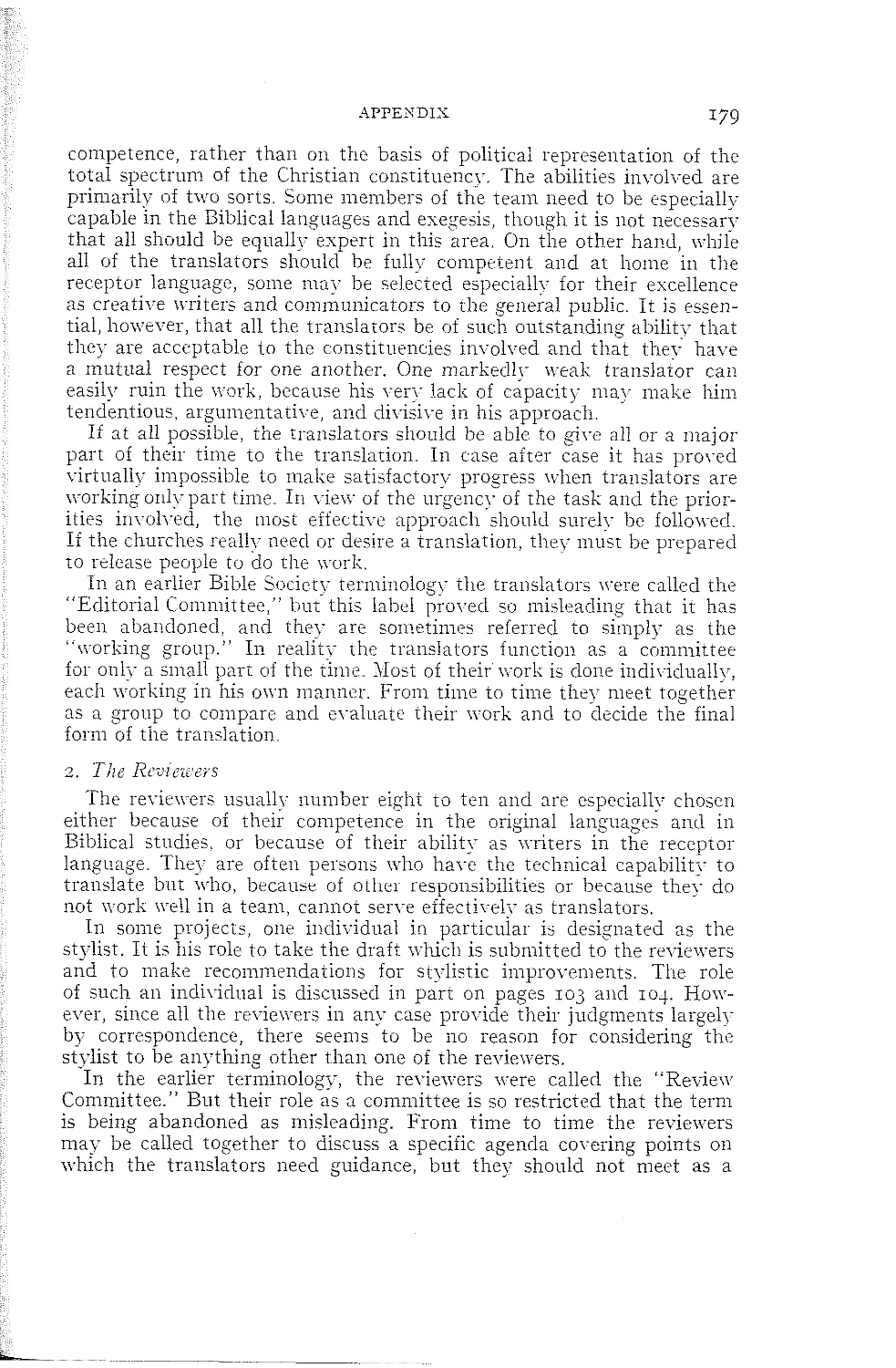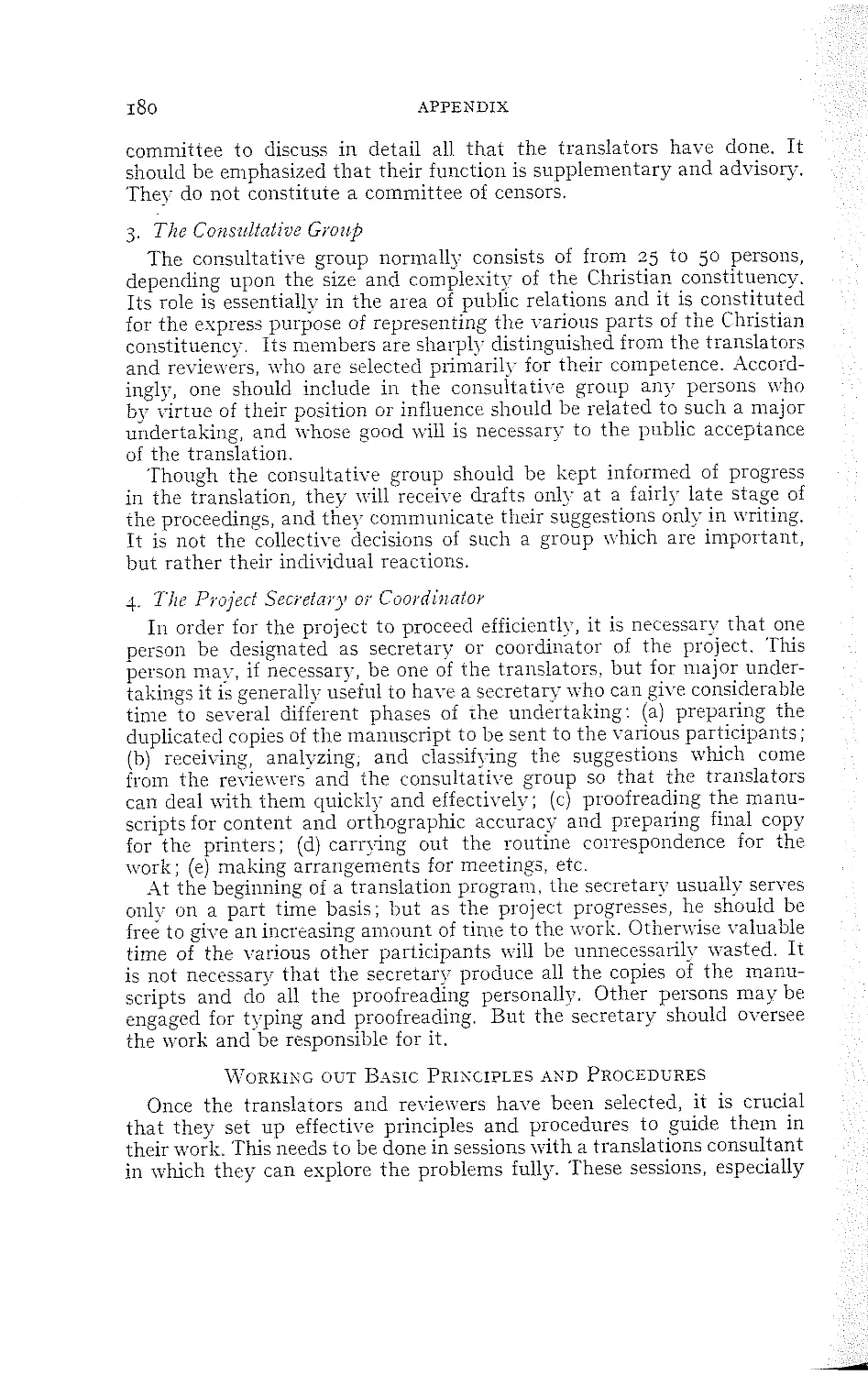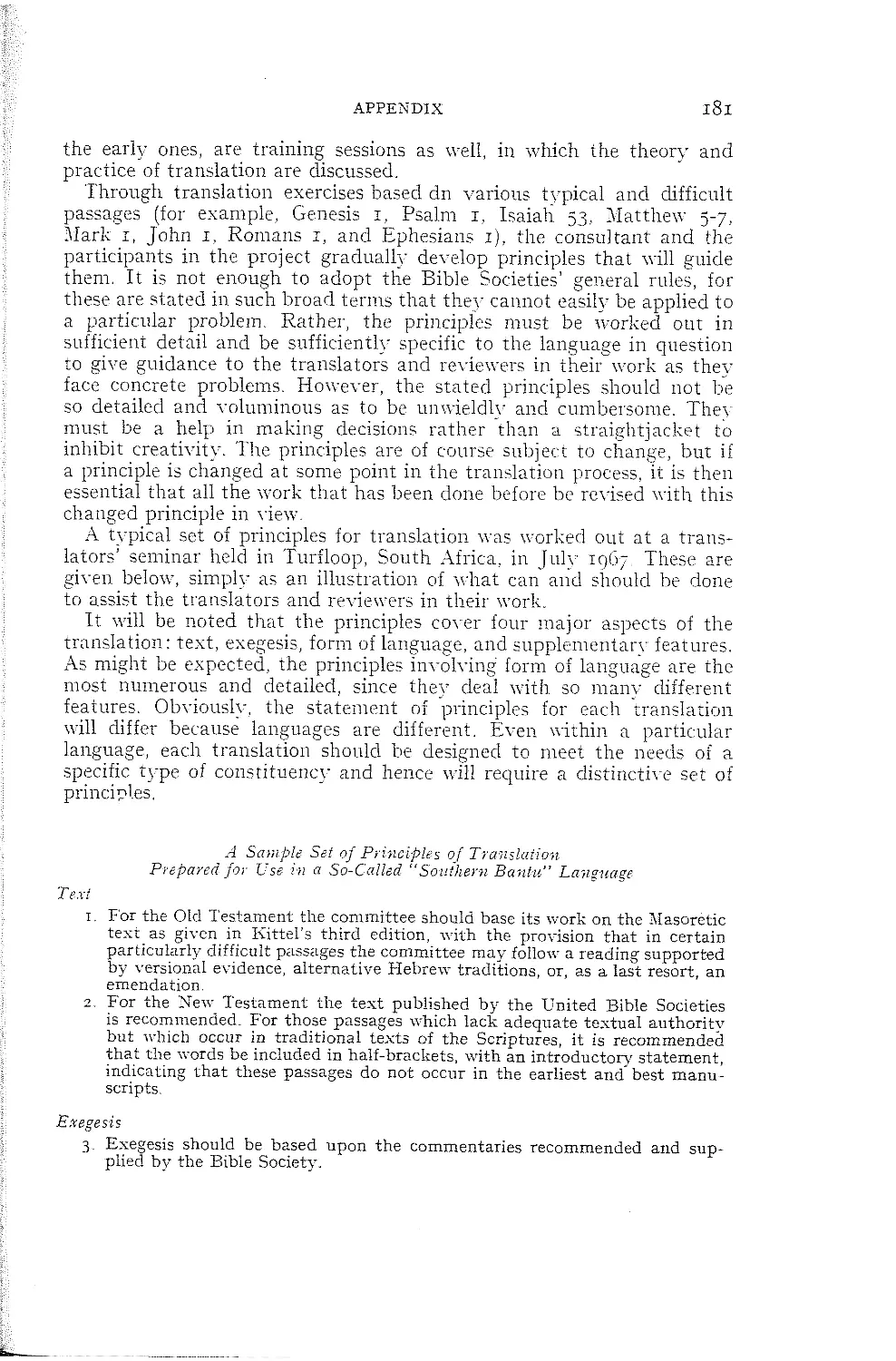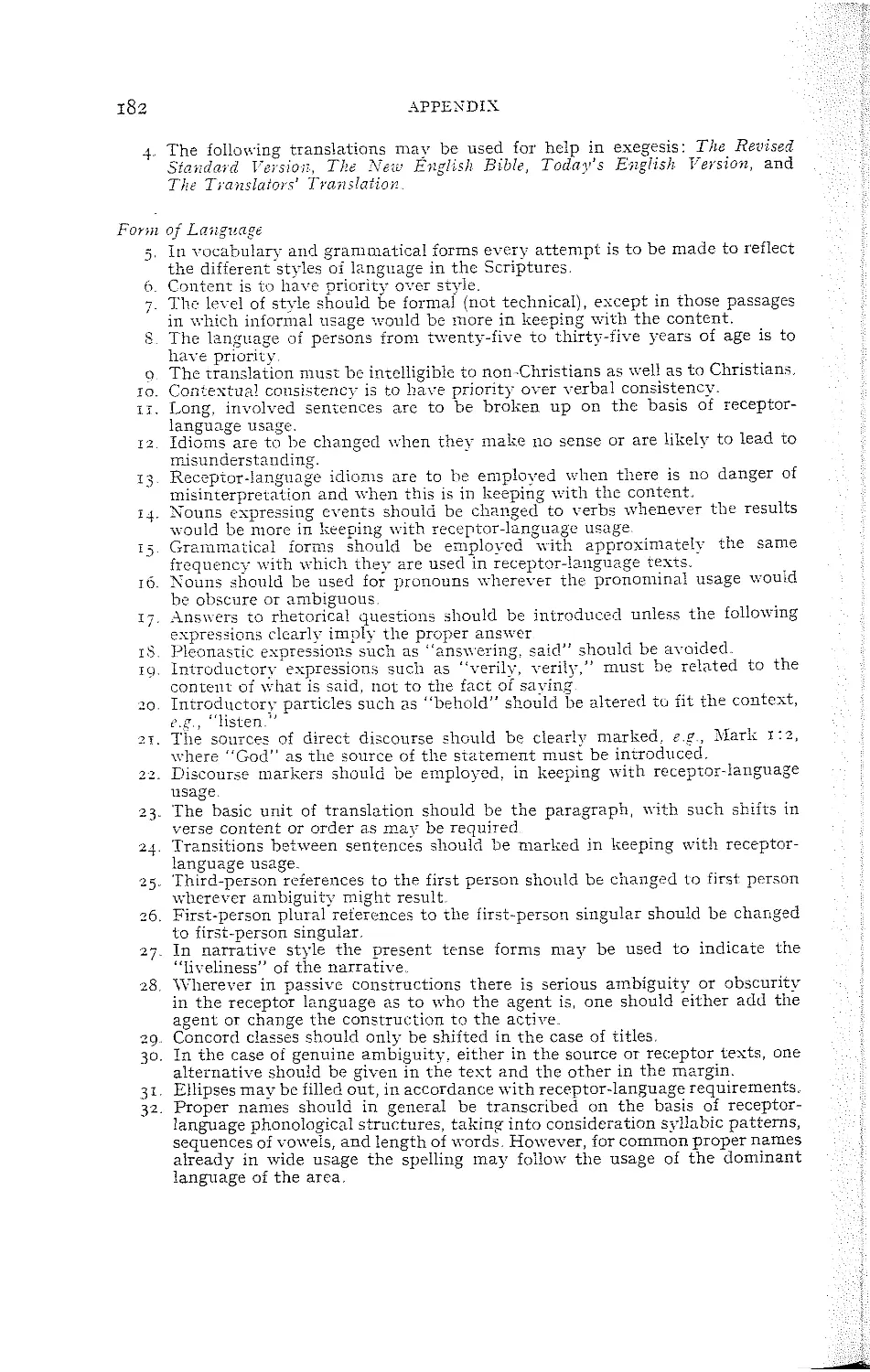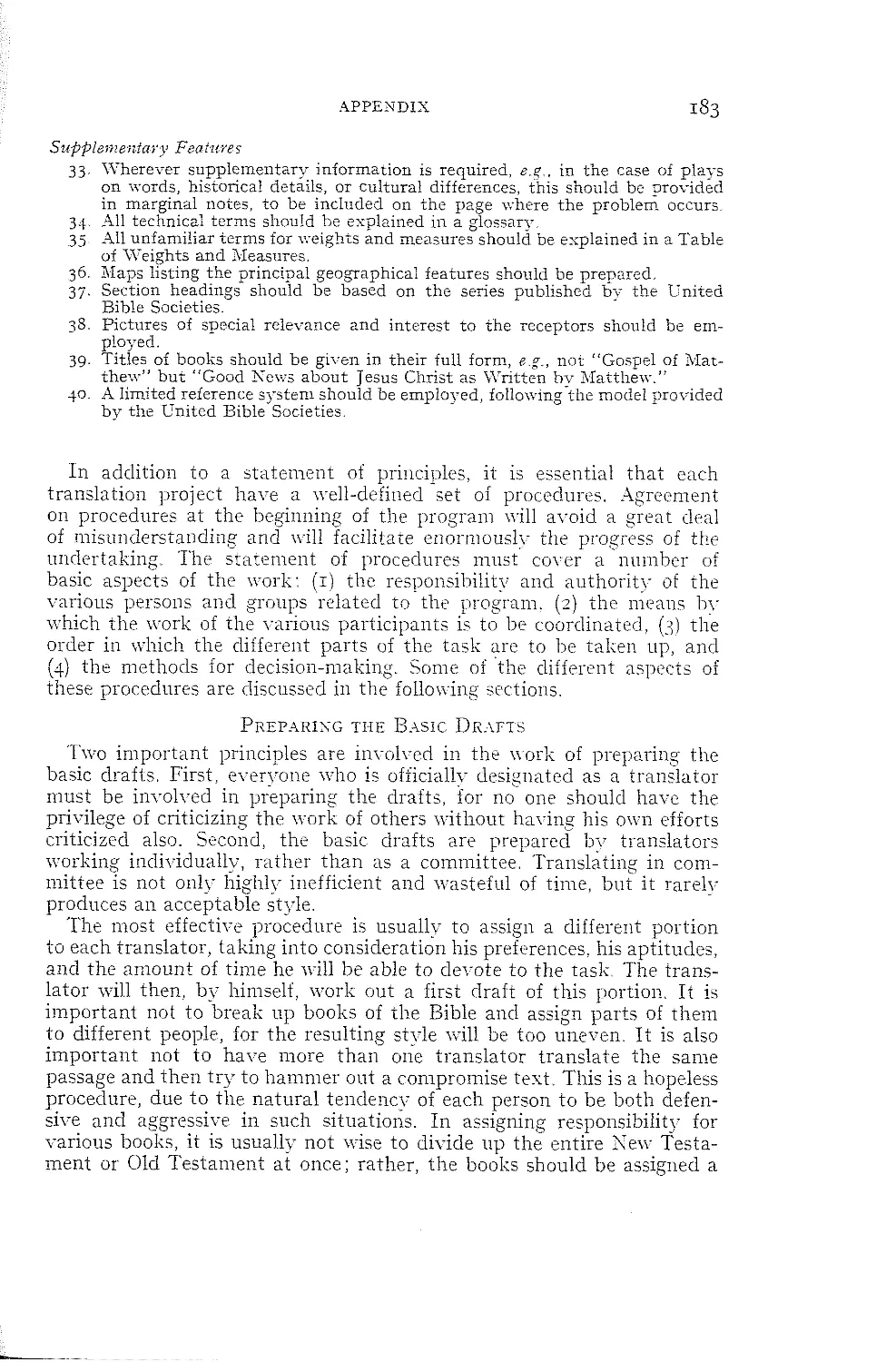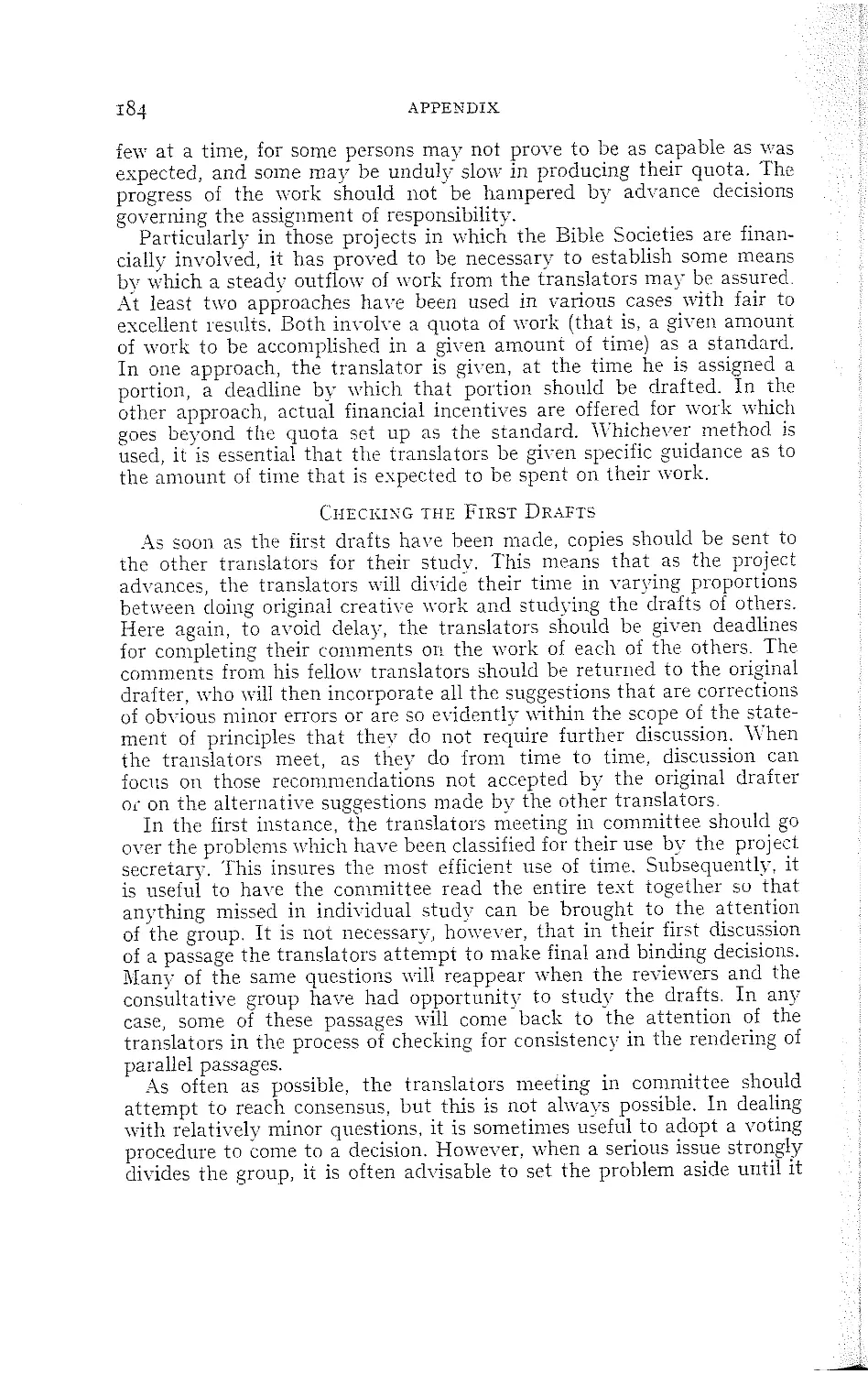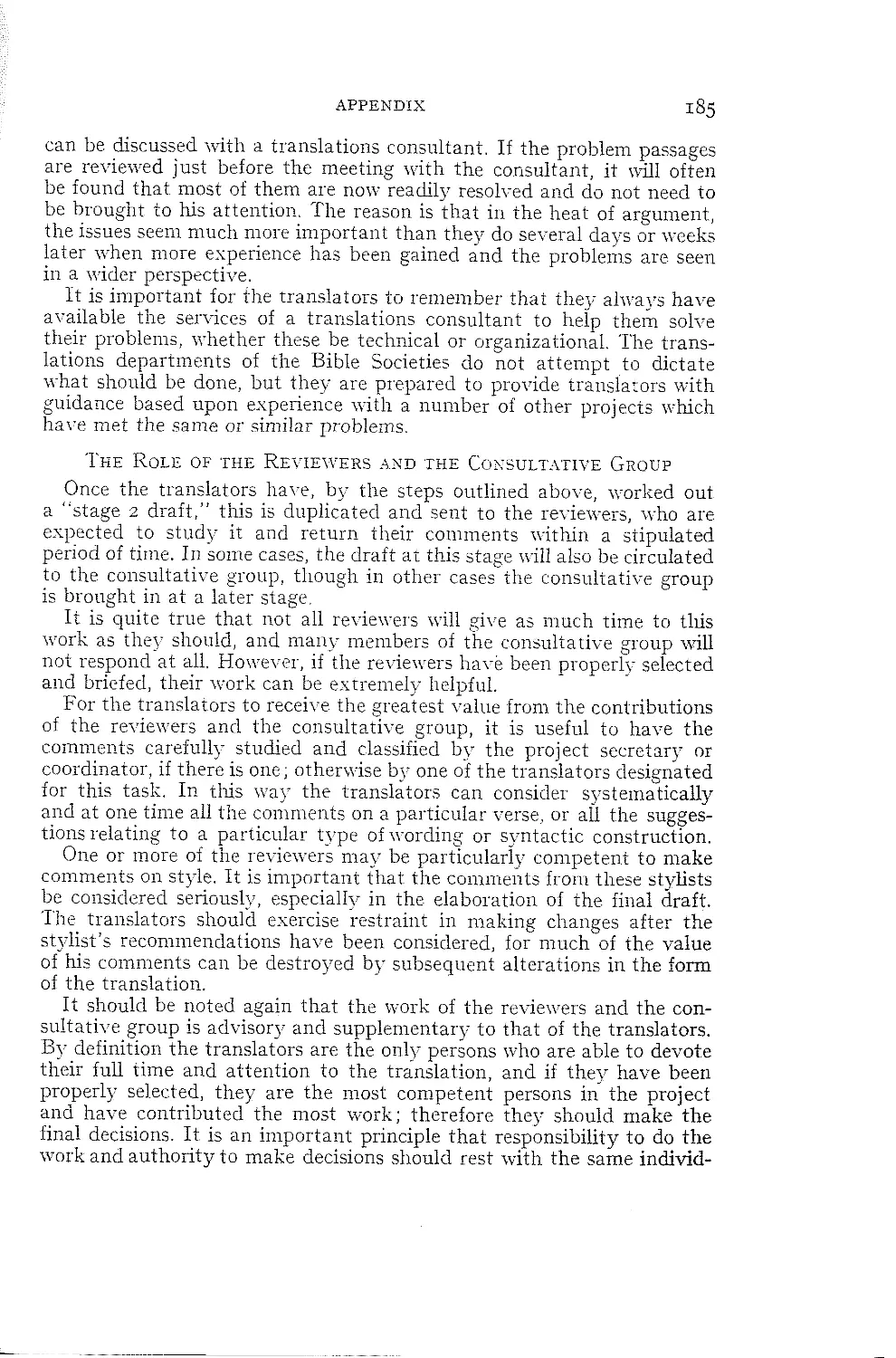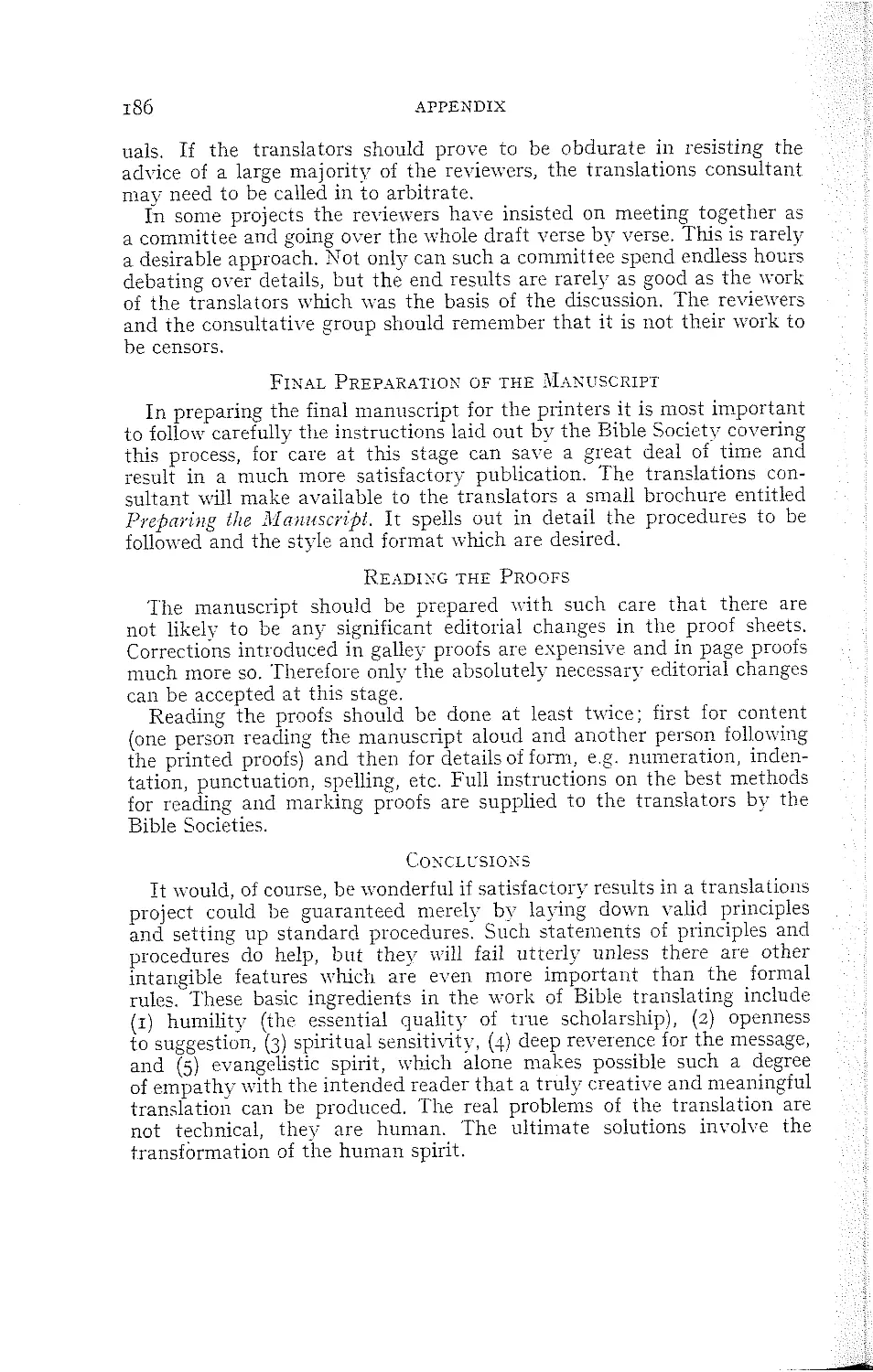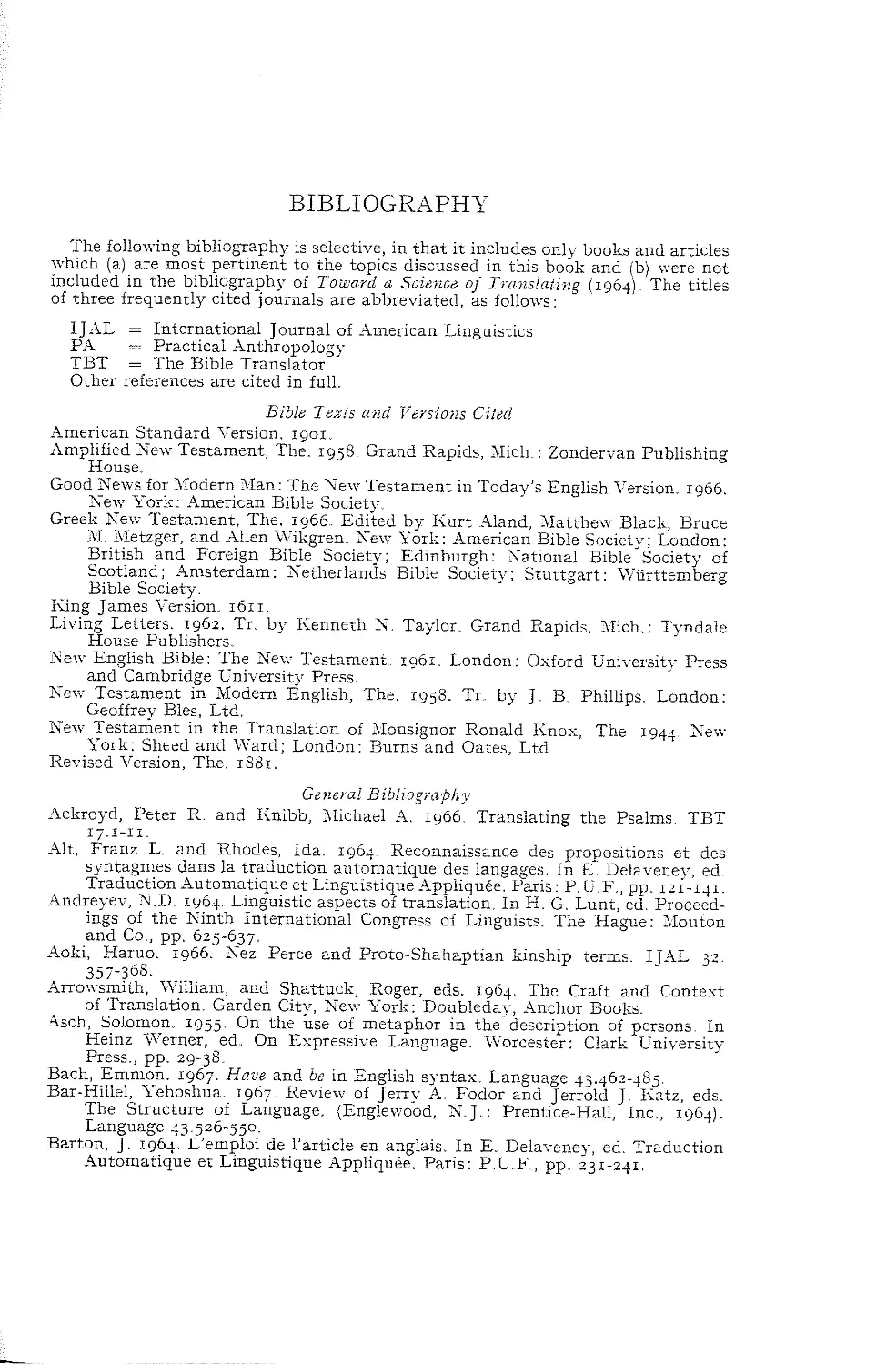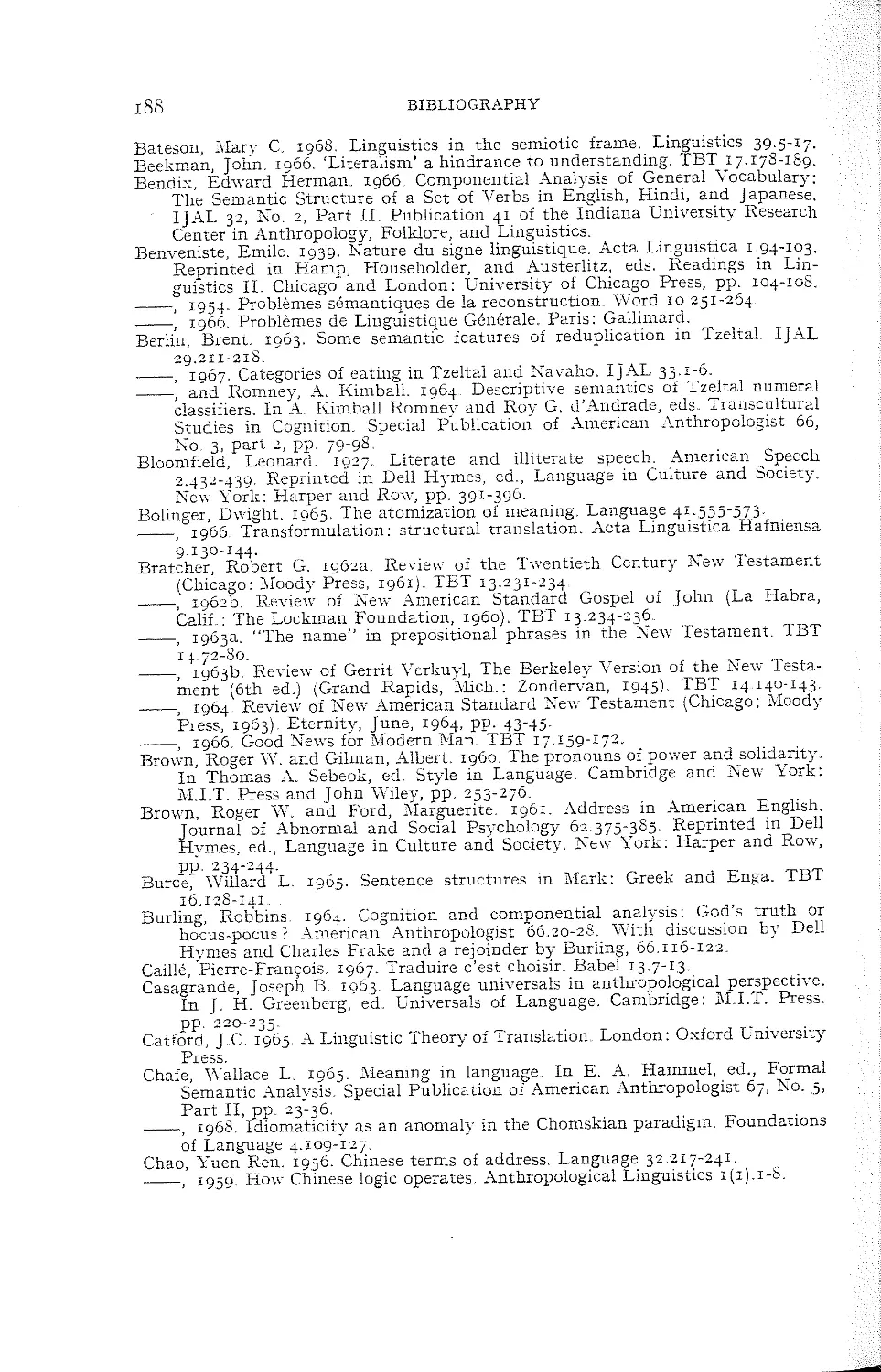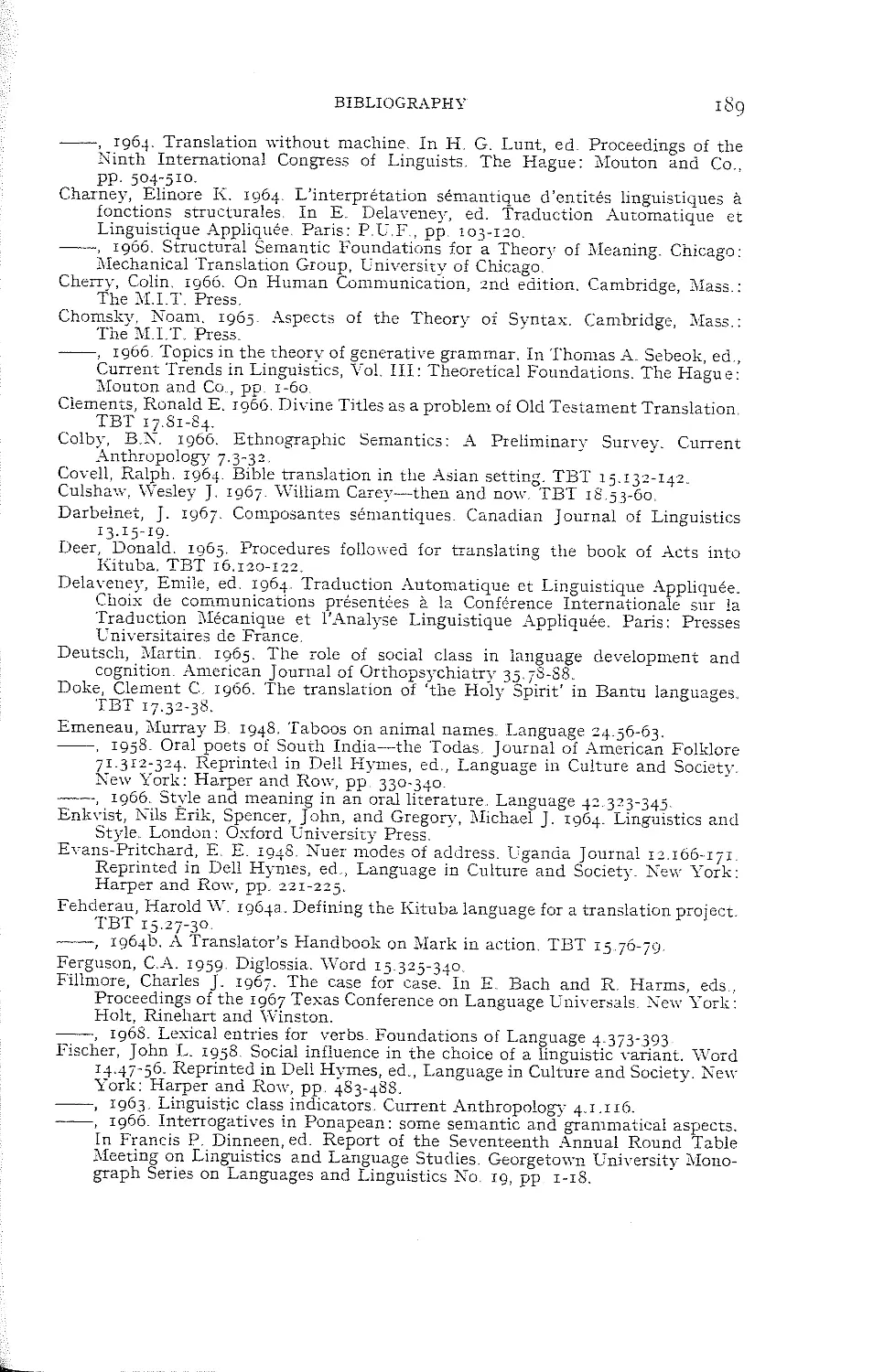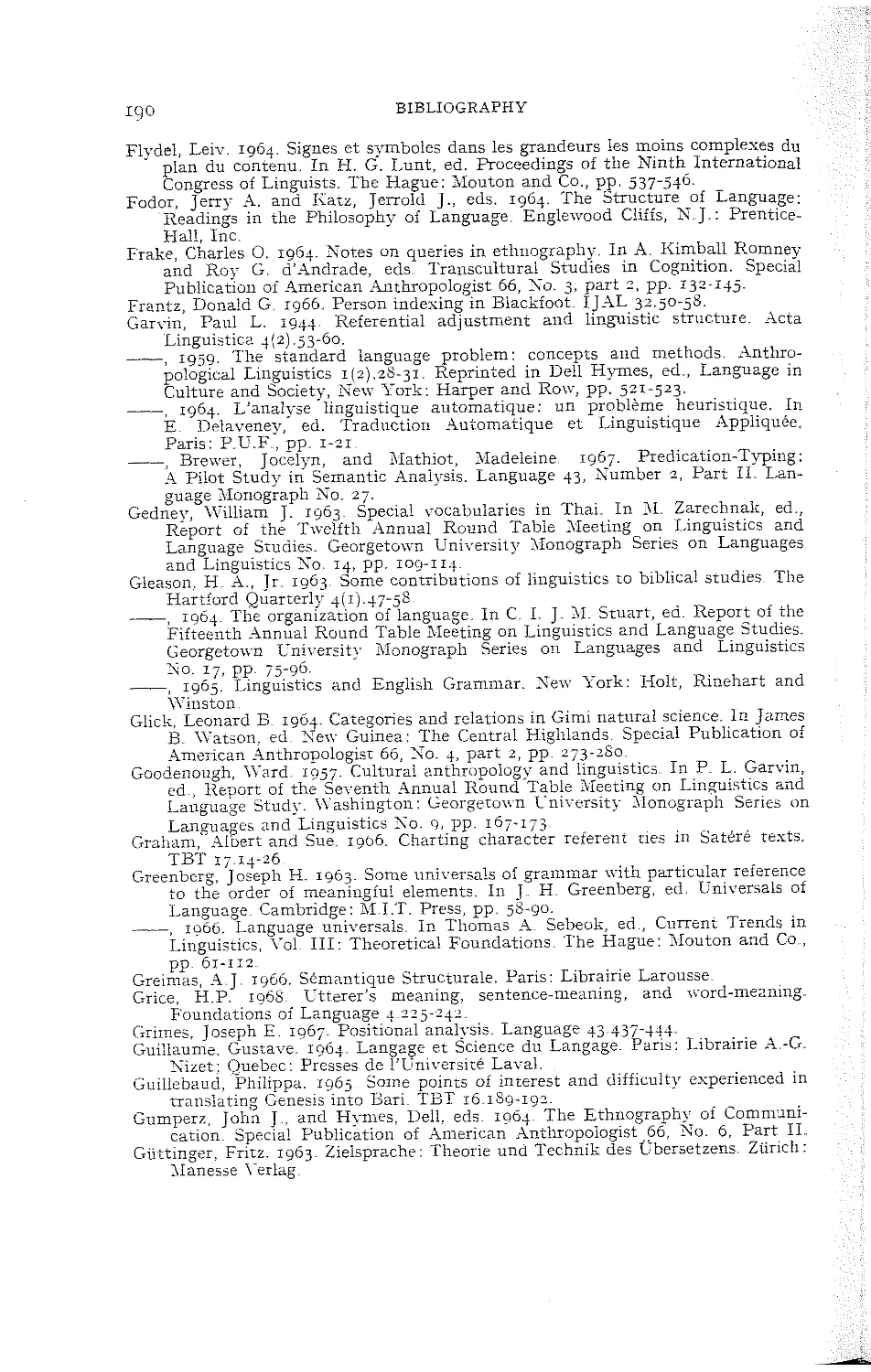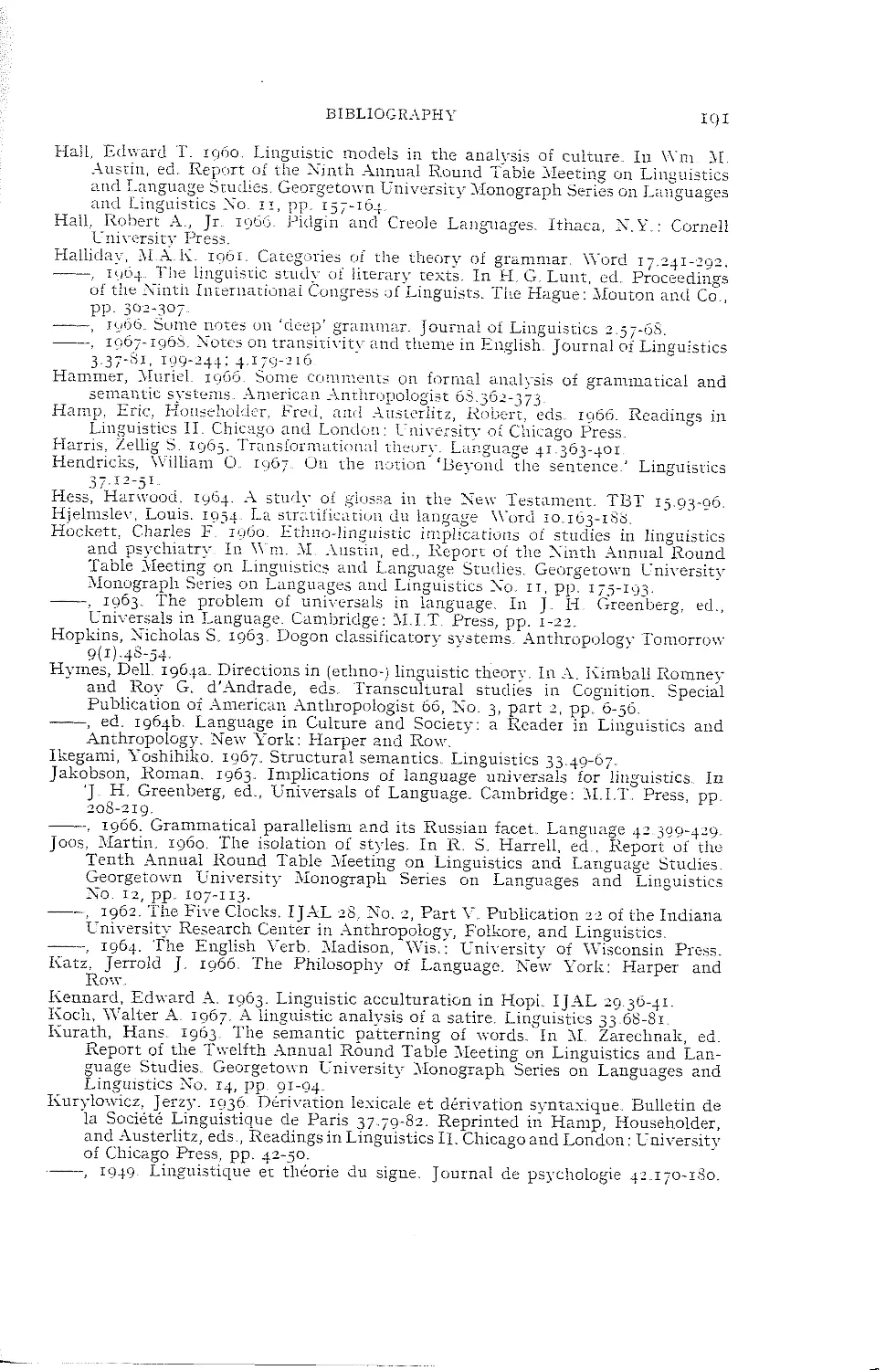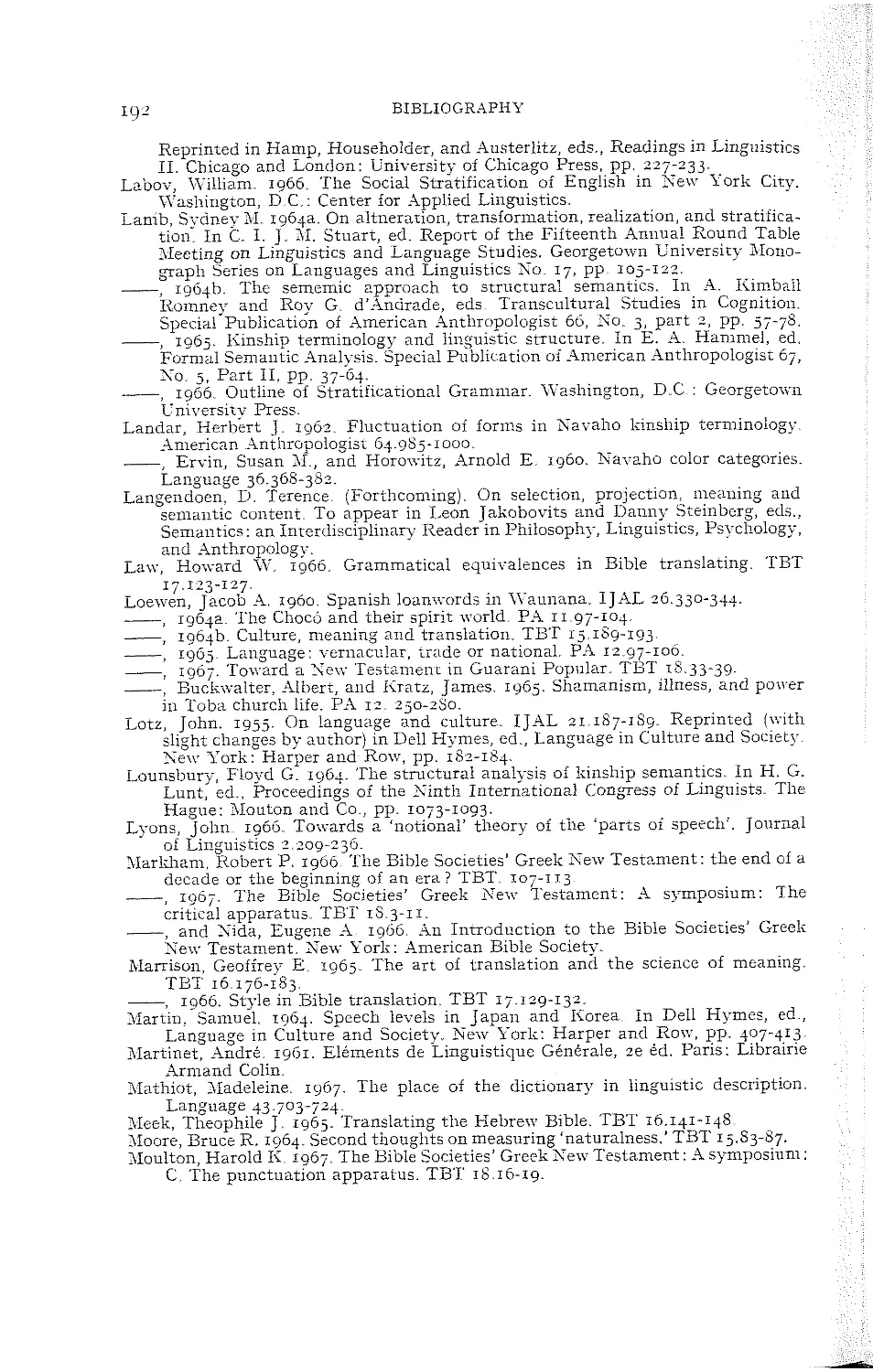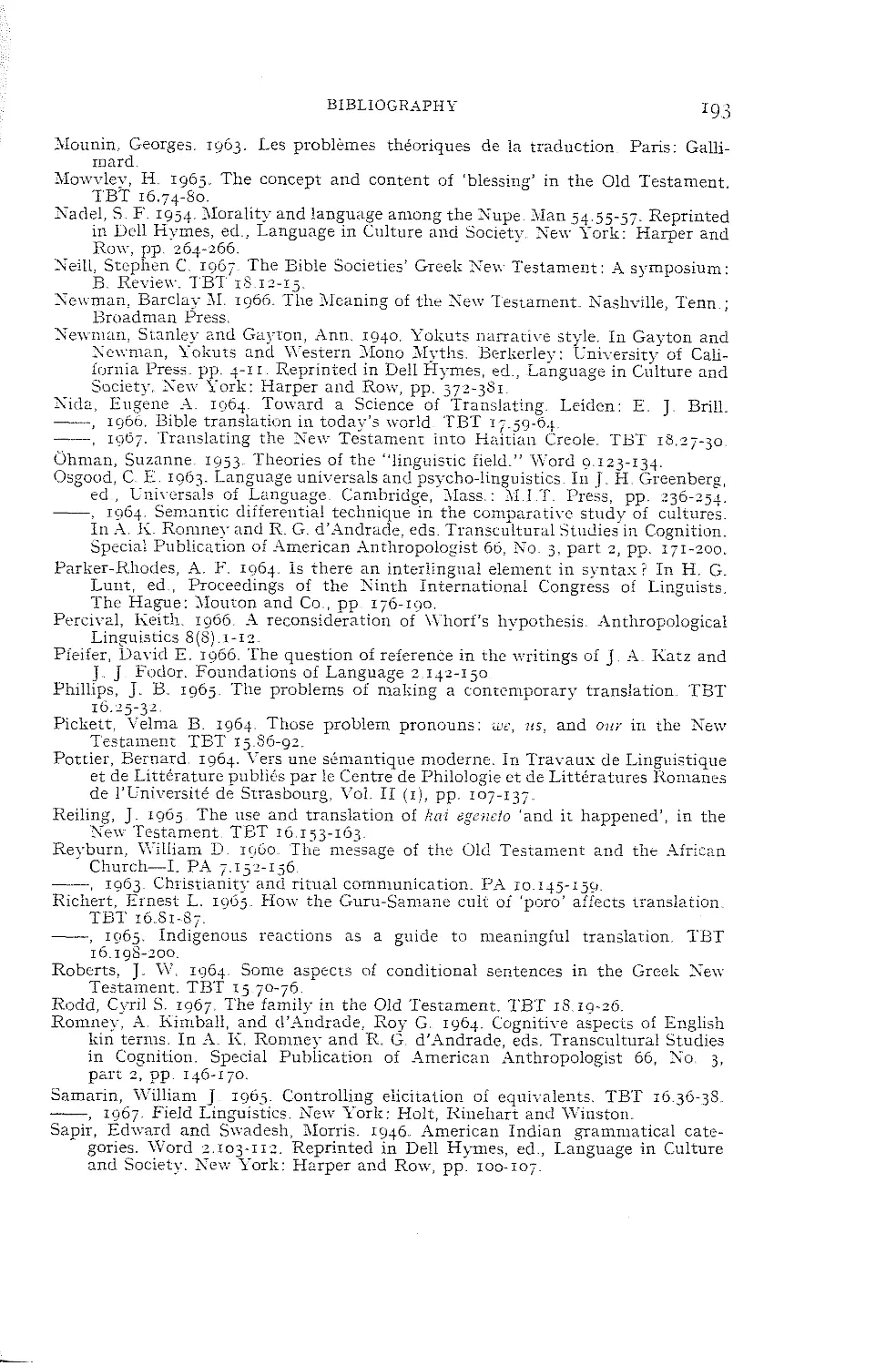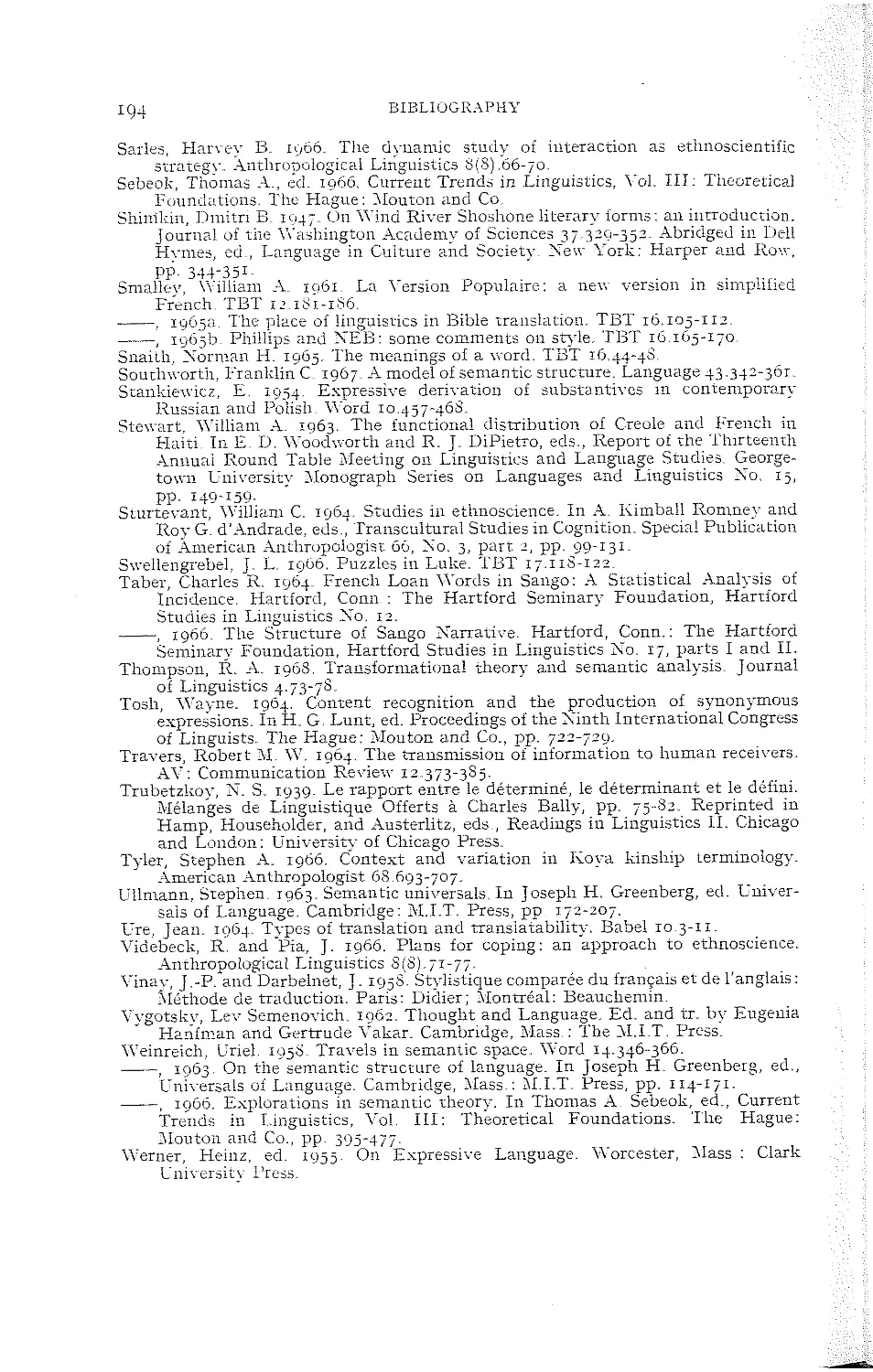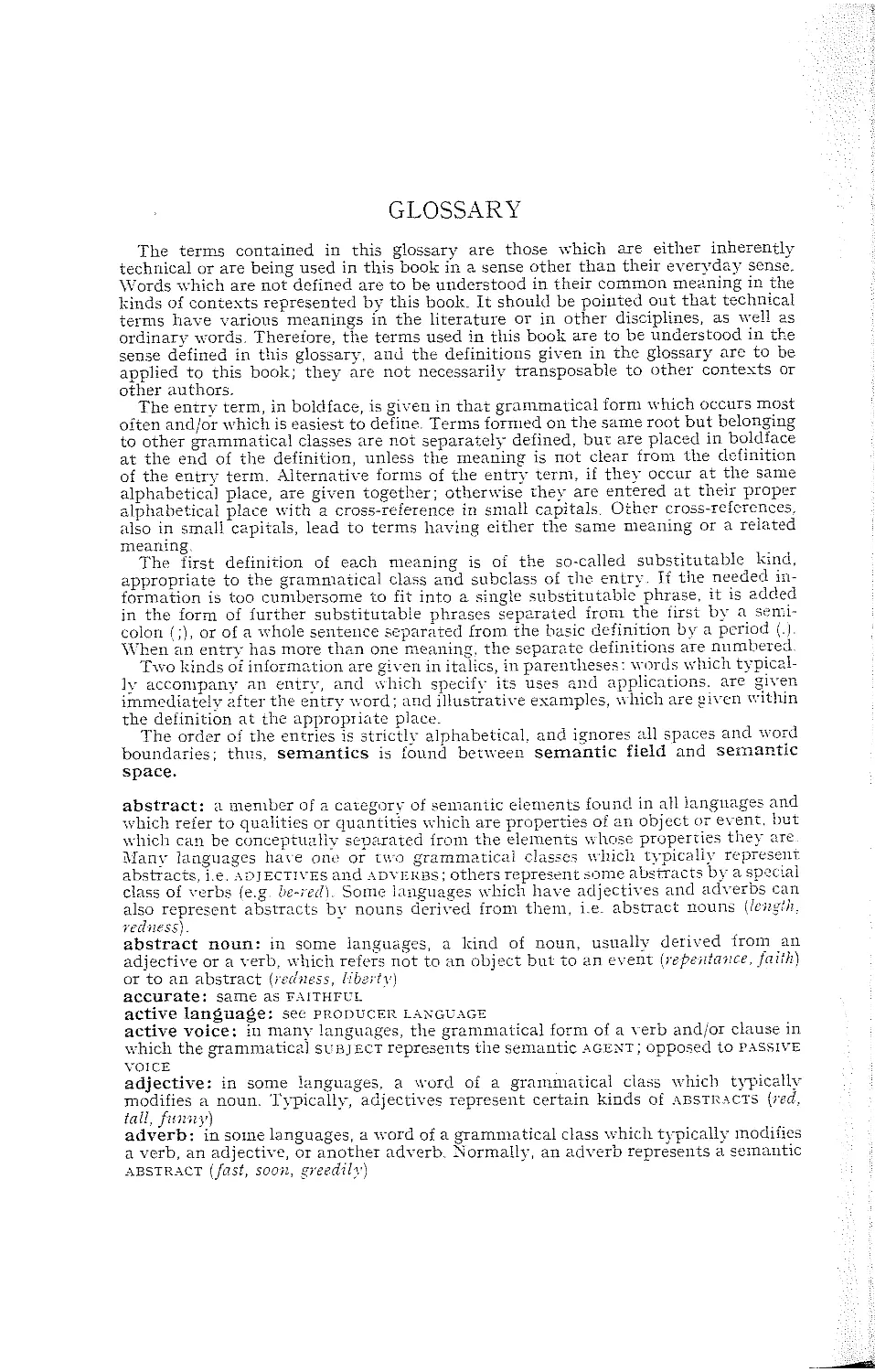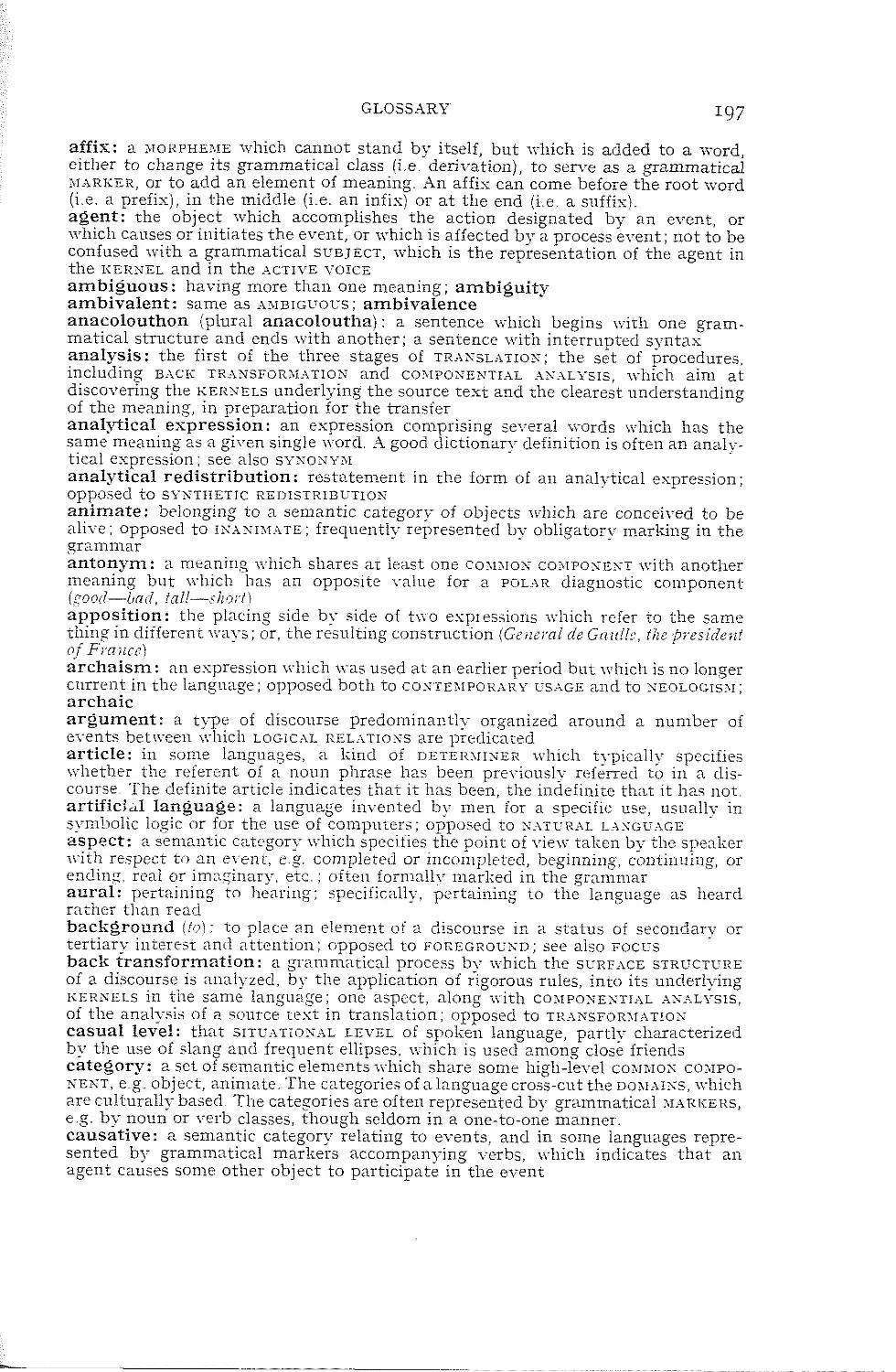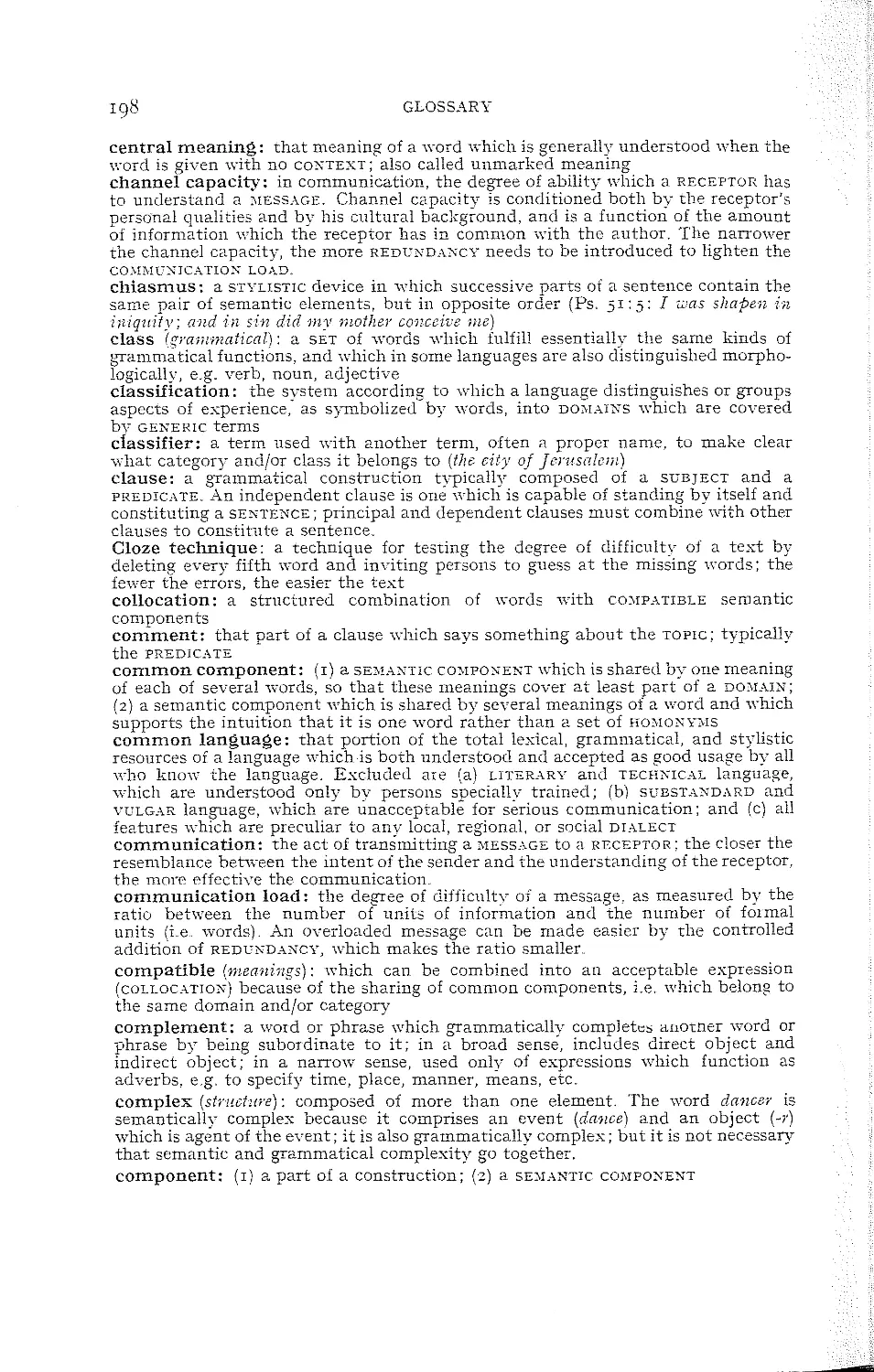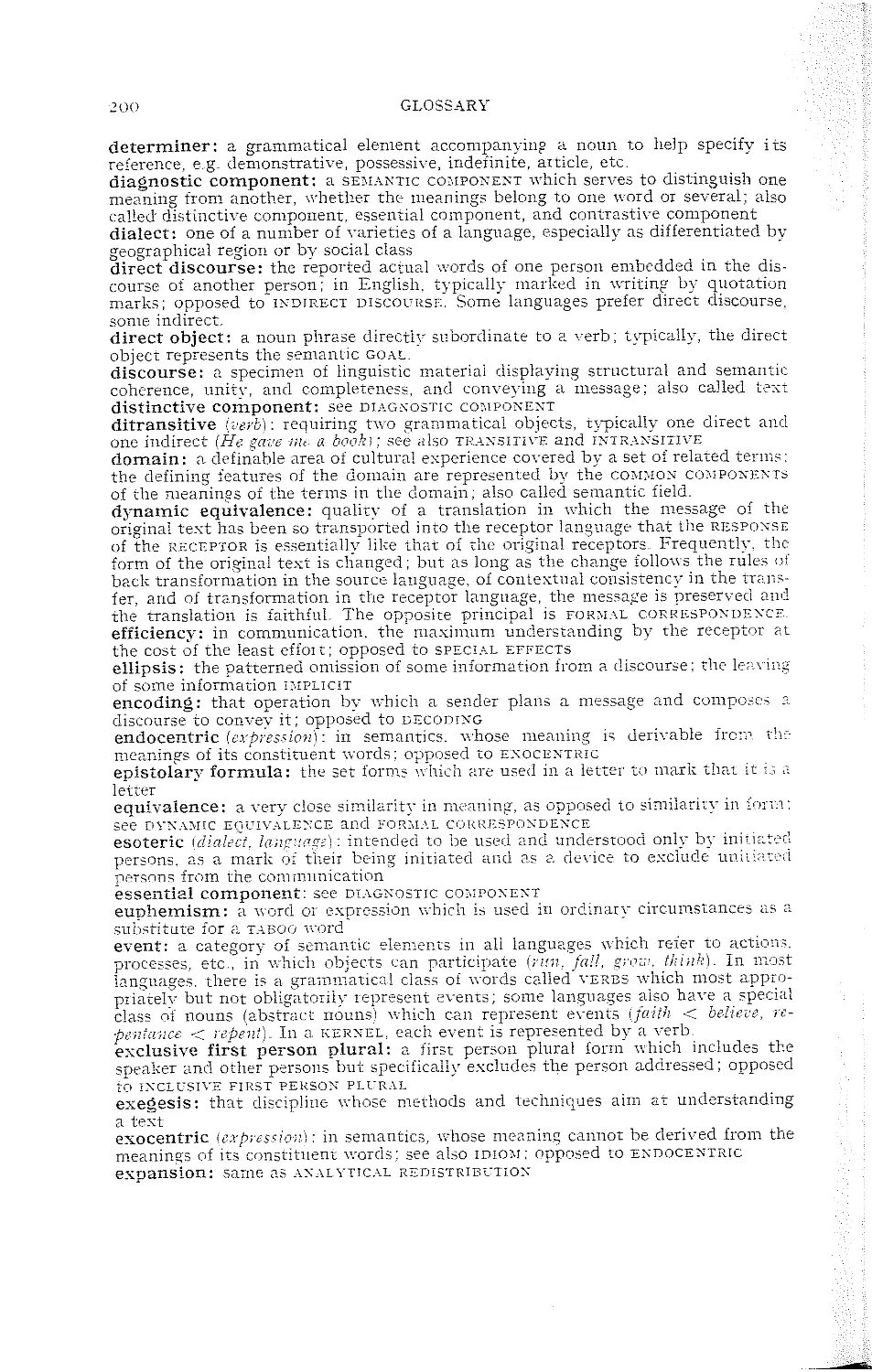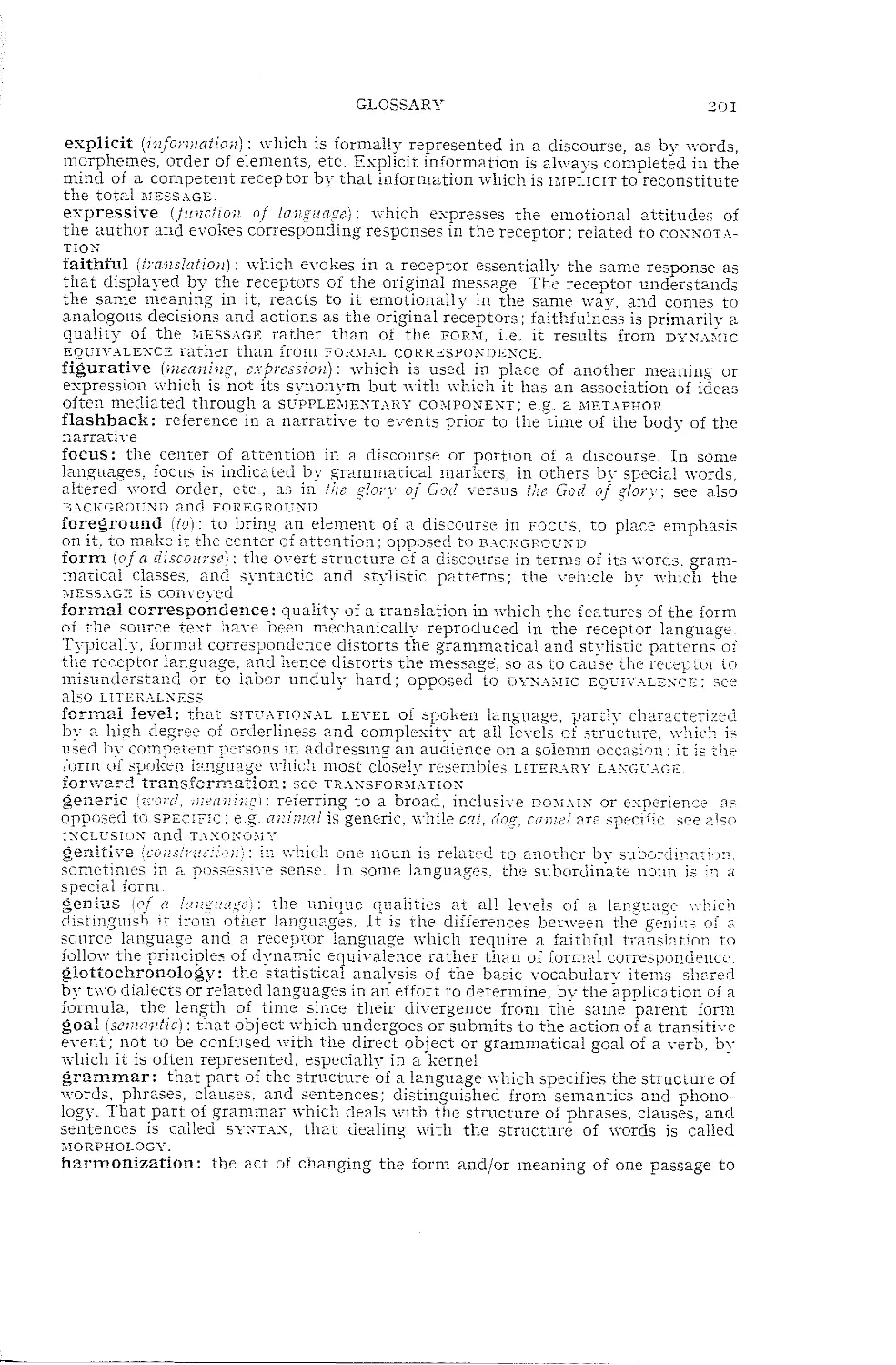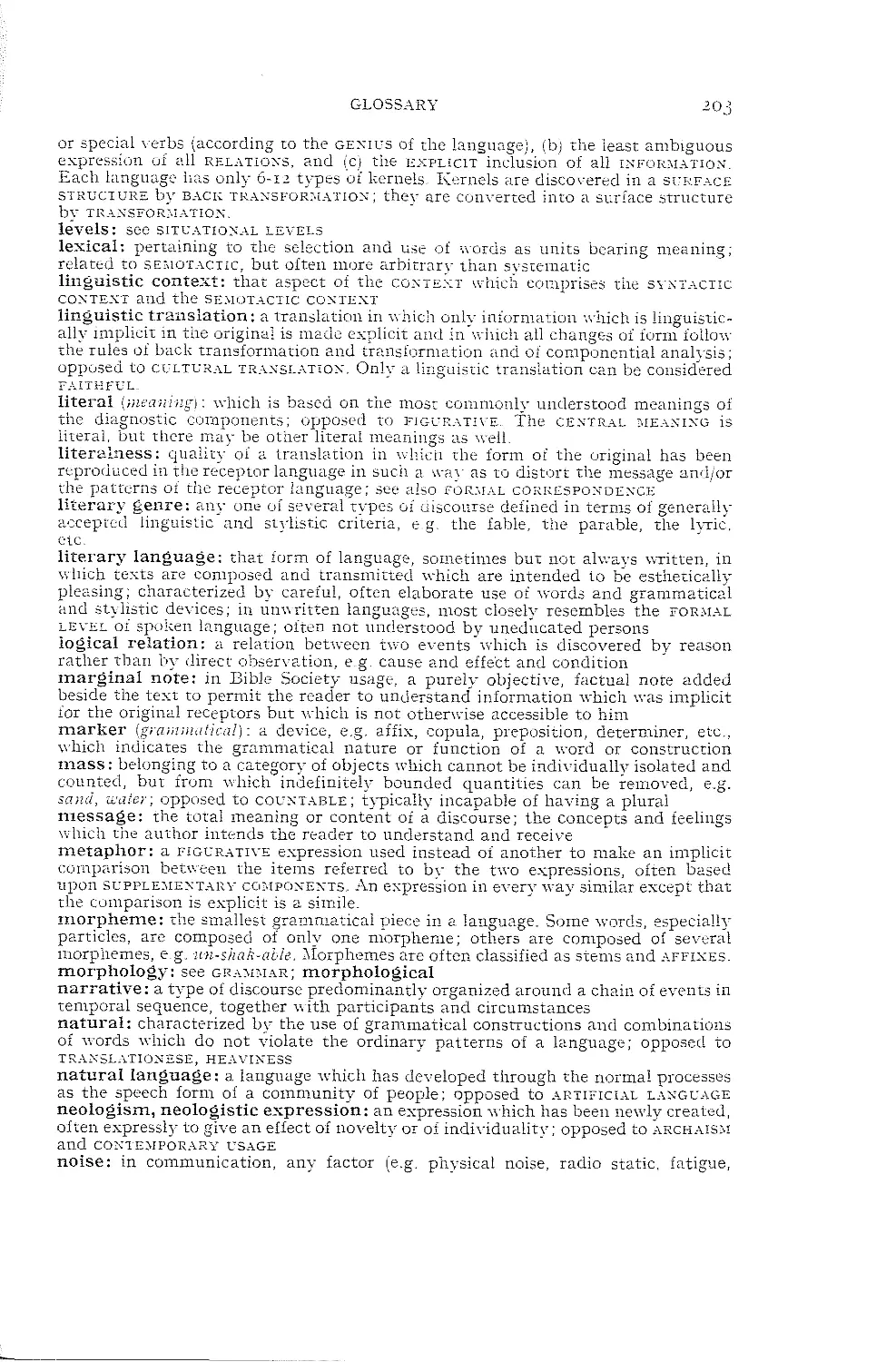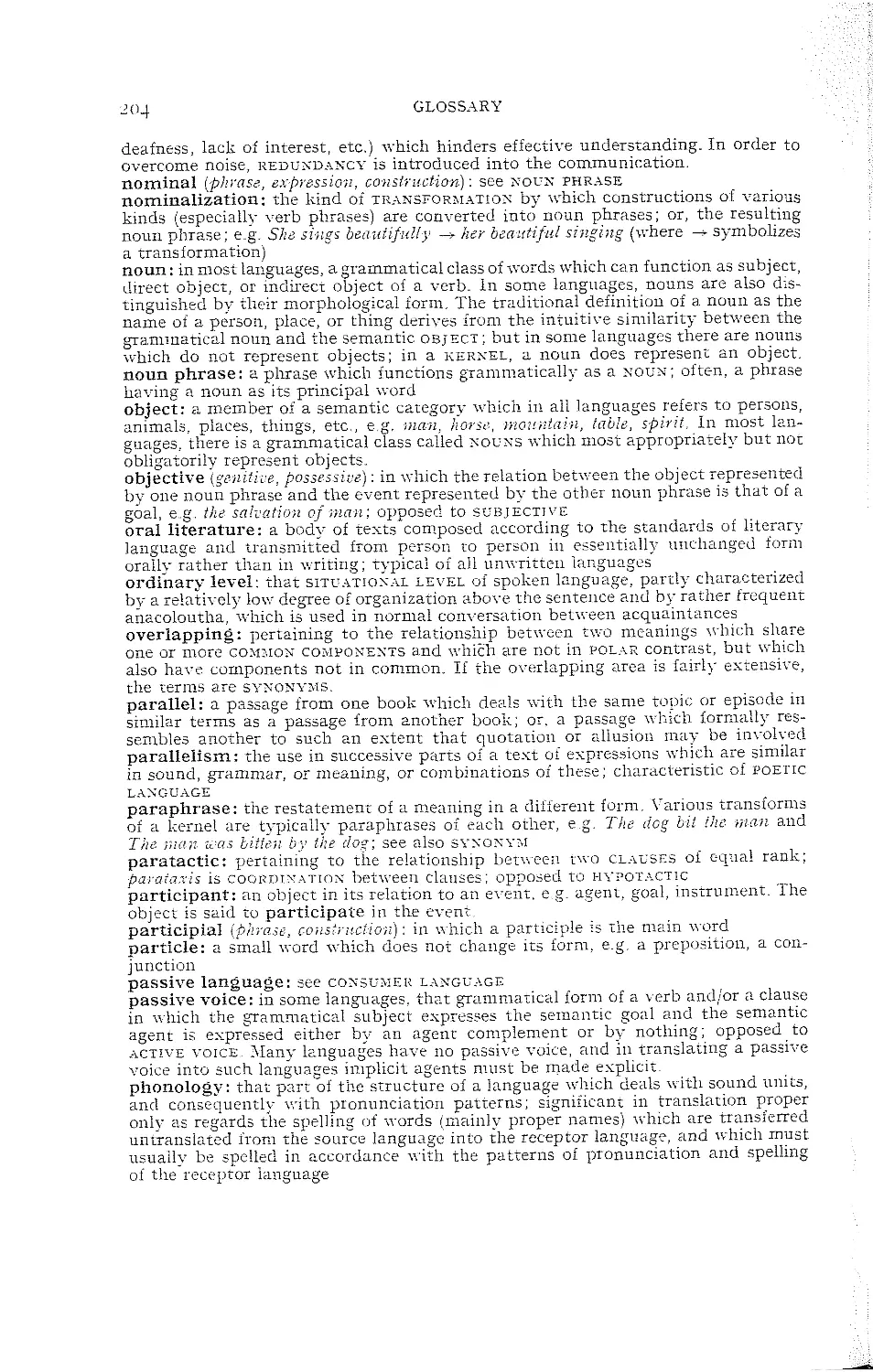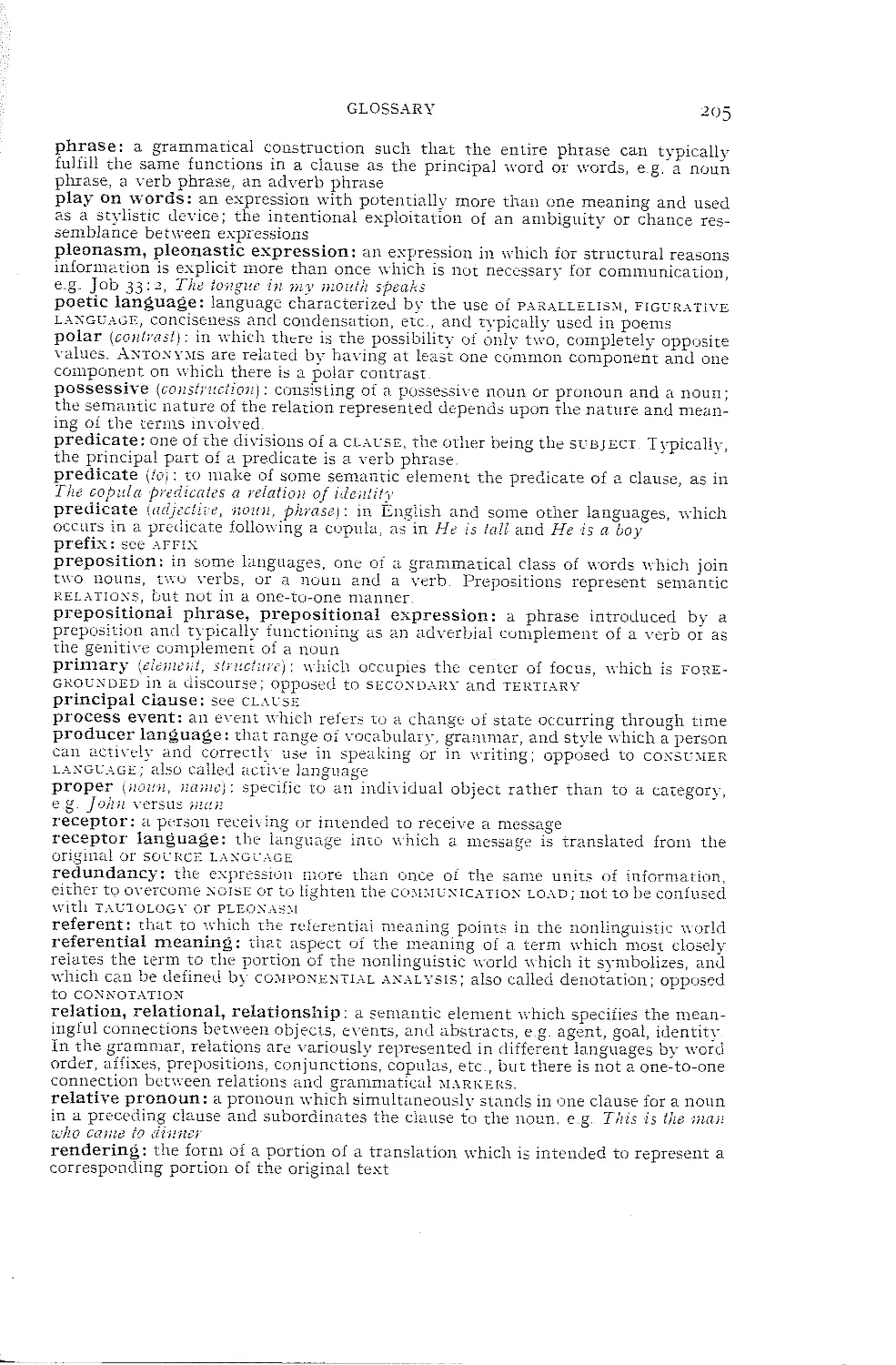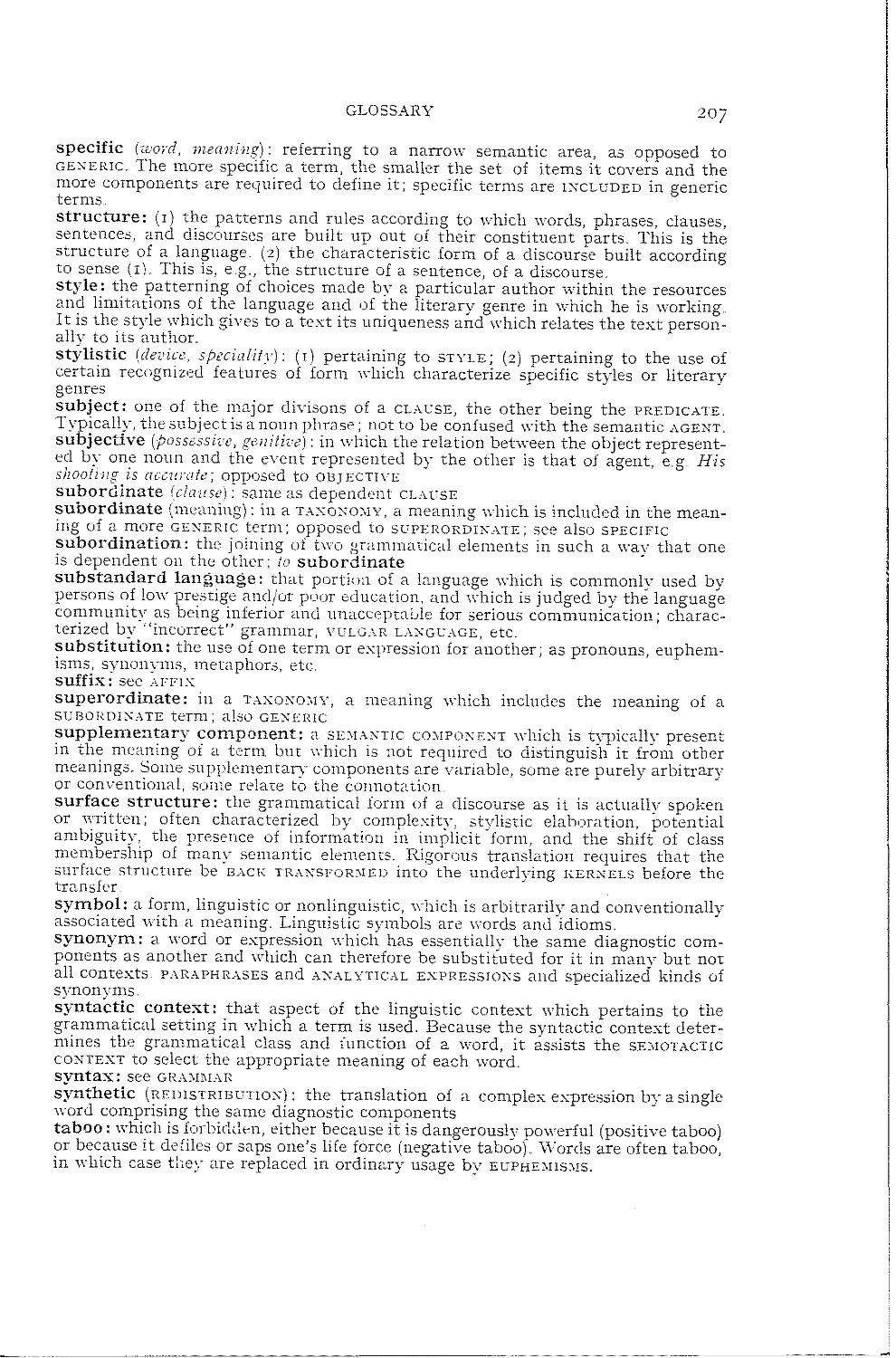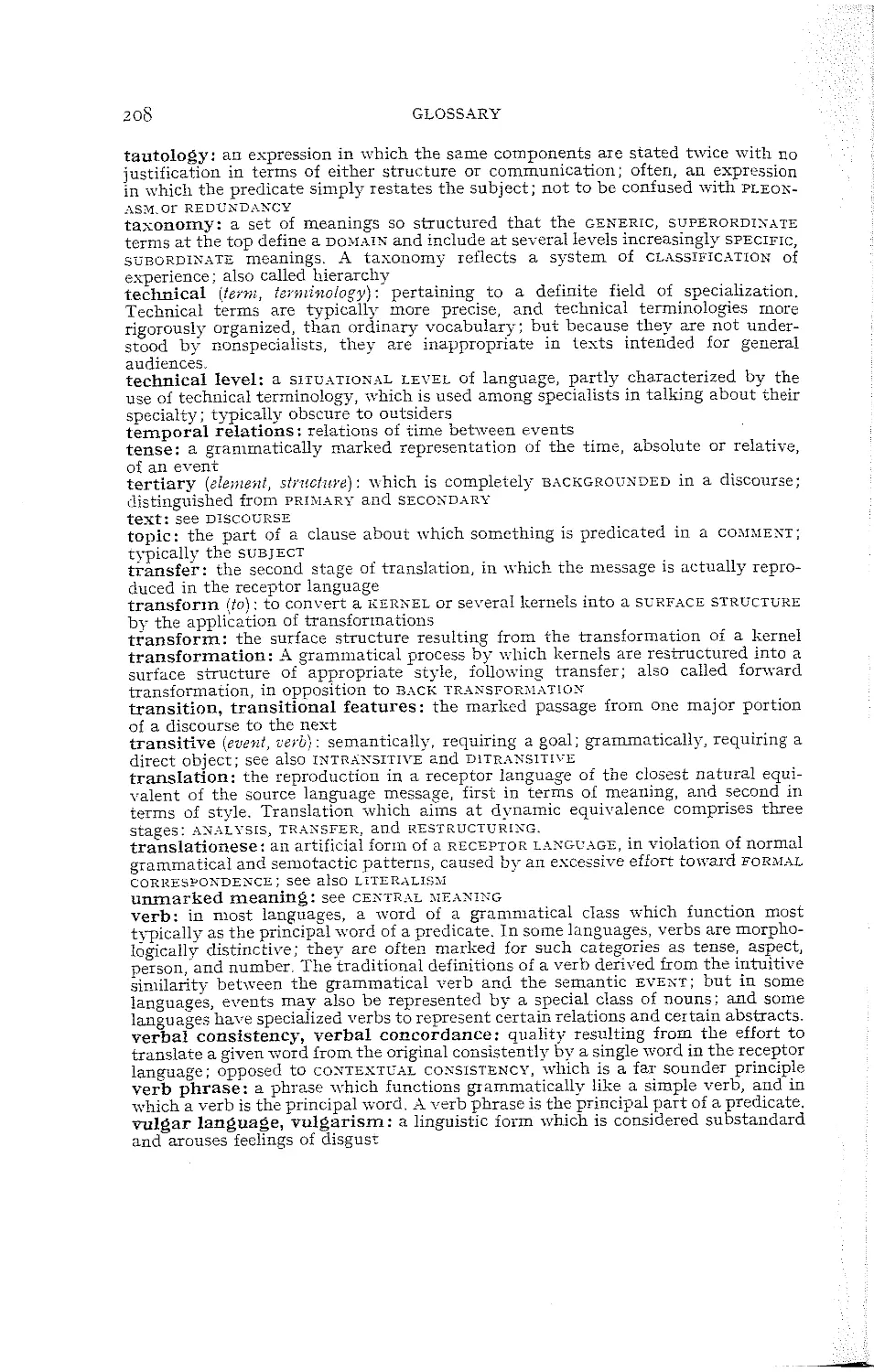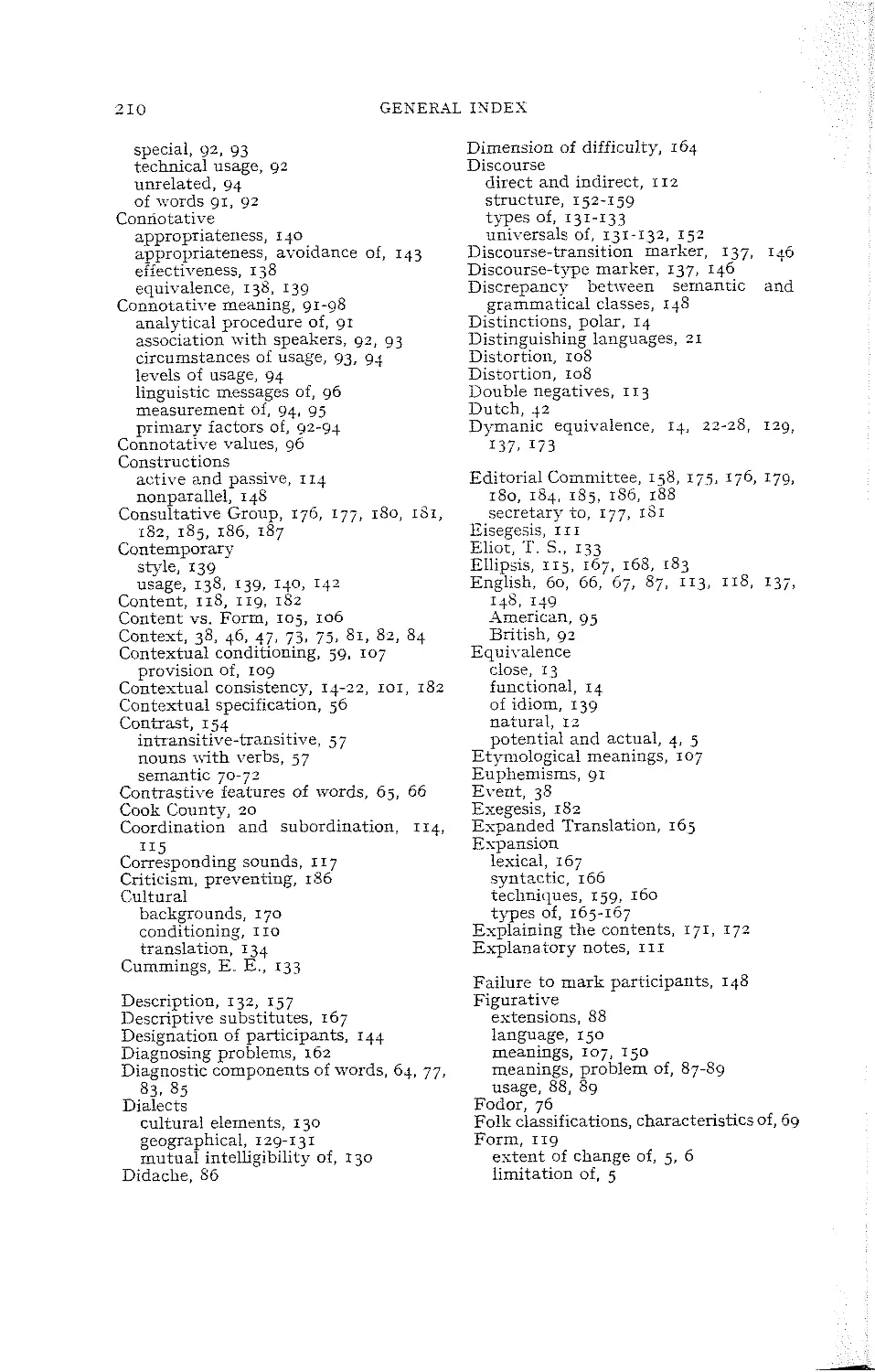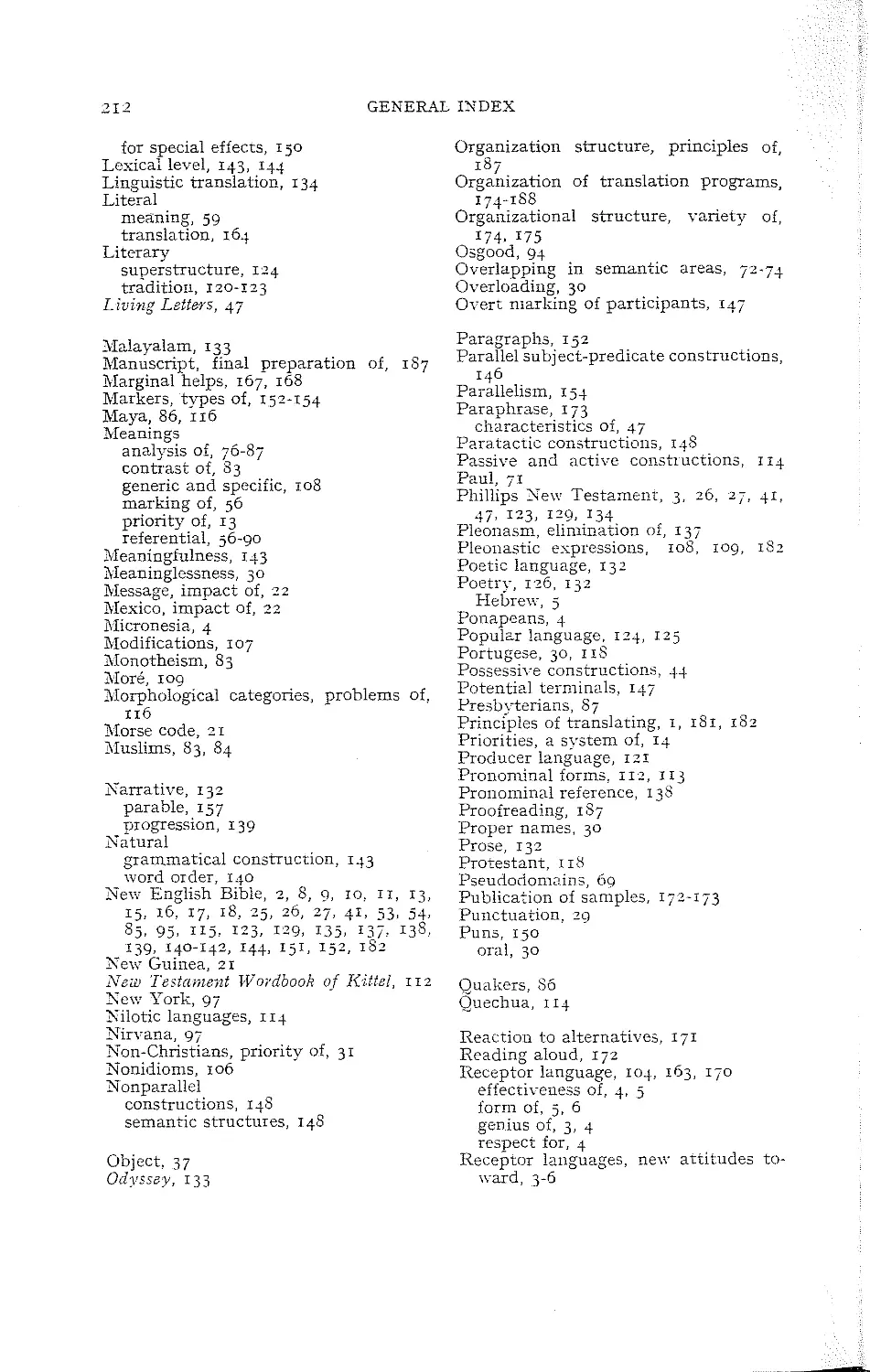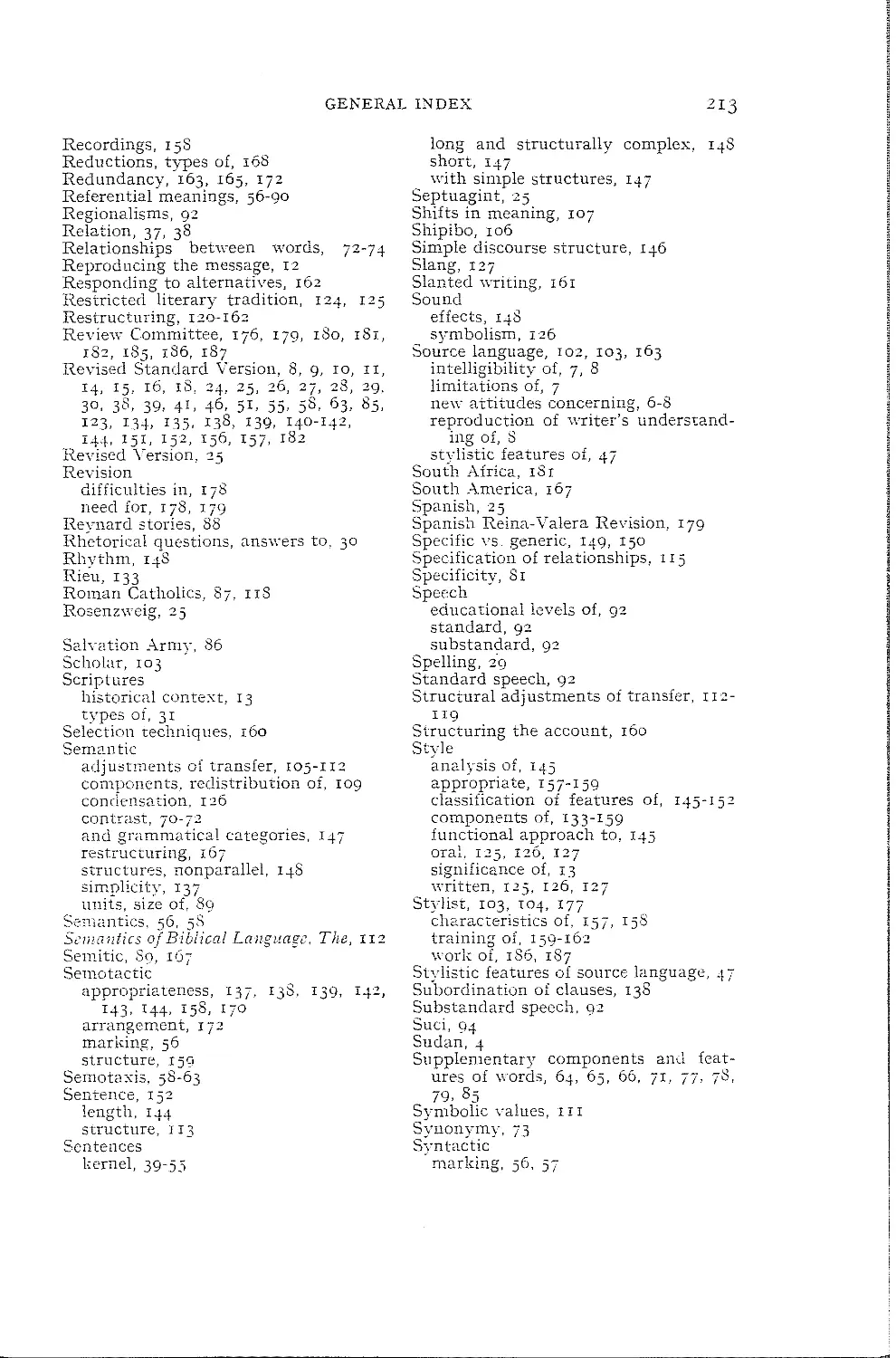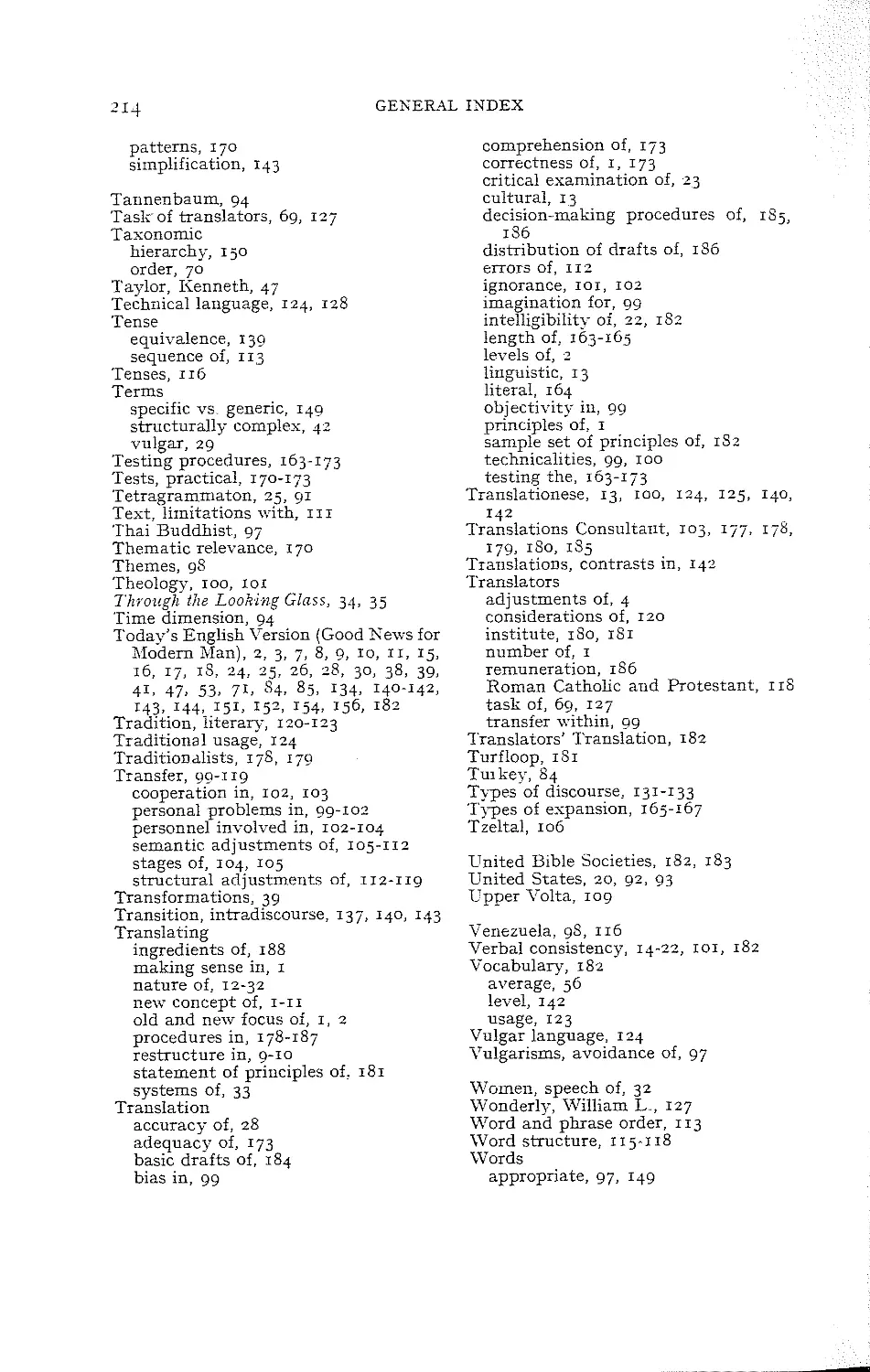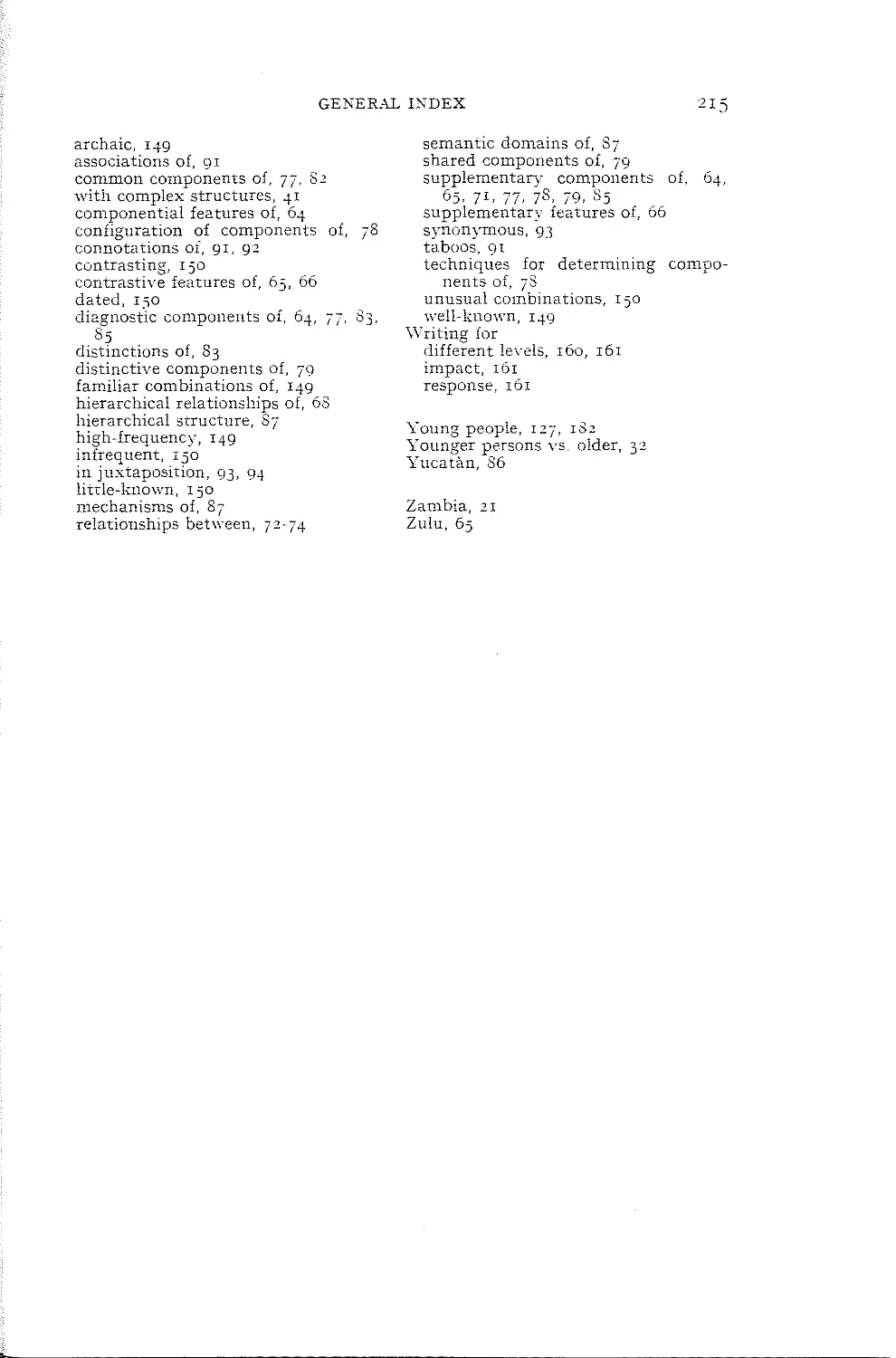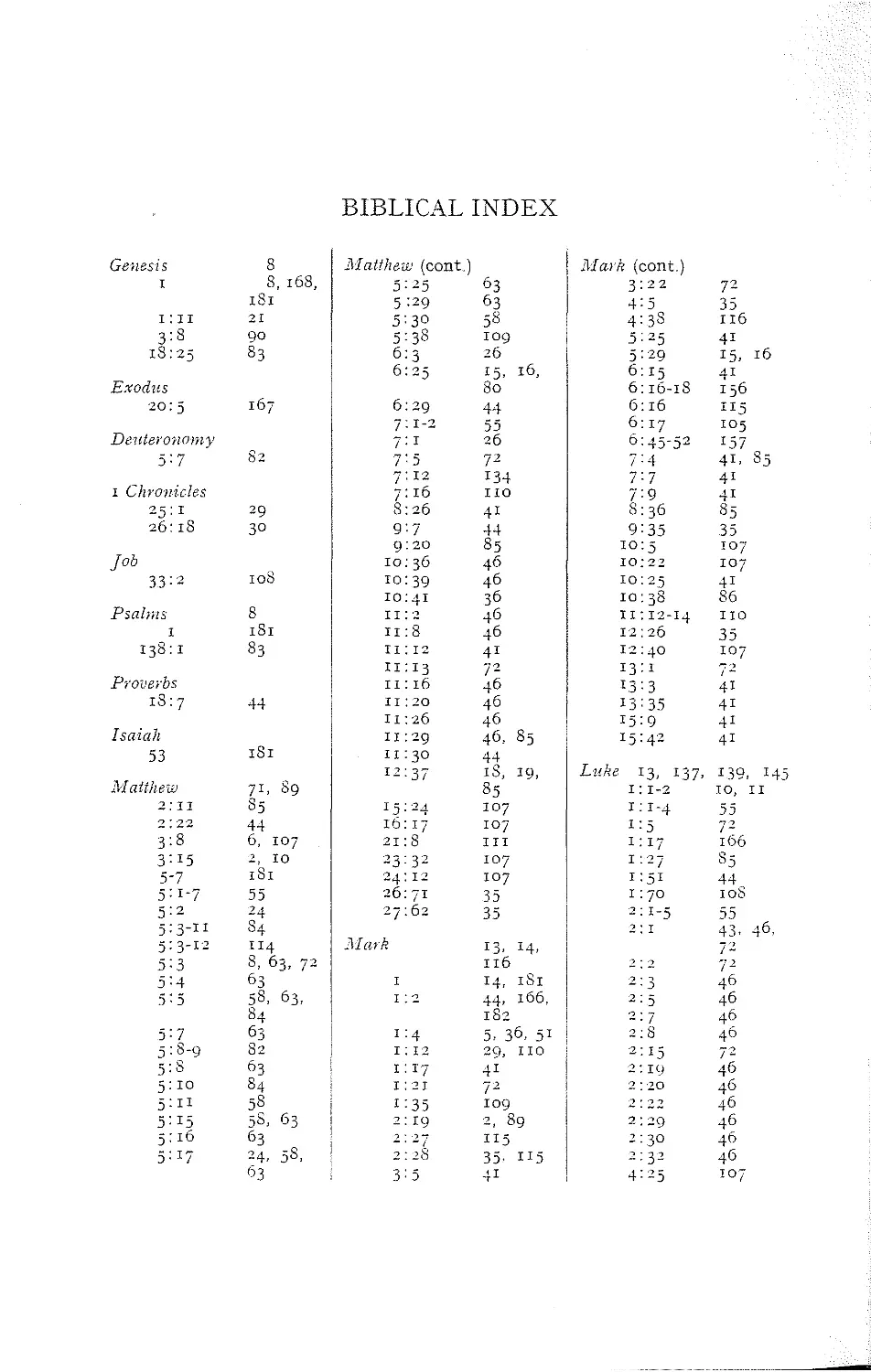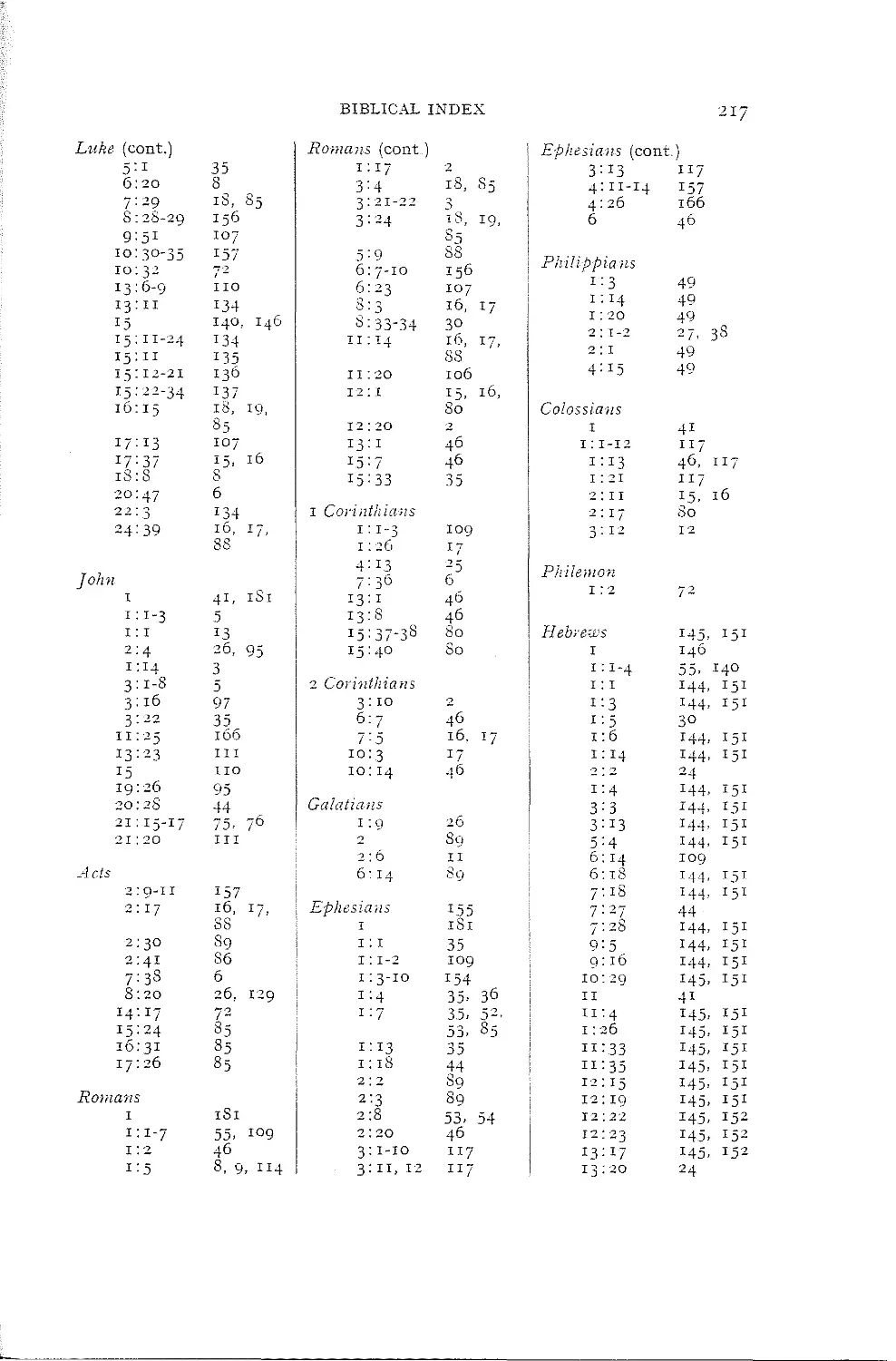Текст
HELPS FOR TRANSLATORS
PREPARED UNDER THE AUSPICES OF THE
UNITED BIBLE SOCIETIES
VOLUME VIII
THE THEORY AND PRACTICE OF TRANSLATION
PUBLISHED FOR THE UNITED BIBLE SOCIETIES
BY E. J. BRILL, LEIDEN
1982
THE THEORY AND-
PRACTICE
OF TRANSLATION
BY
ISTITUT'C l
EUGENE A. NIDA IN','
n.
AND
Dip?
CHARLES R. TABER
SECOND PHOTOMECHANICAL REPRINT
PUBLISHED FOR THE UNITED BIBLE SOCIETIES
BY E. J. BRILL, LEIDEN
1982
c.n
Helps for Translators prepared under the auspices
of the United Bible Societies
Volume I
Old Testament Translation Problems
Volume II
A Translator’s Handbook on Mark
Volume III
Old Testament Quotations in the New Testament
Volume IV
Section Heading and Reference System
Volume V
New Testament Index
Volume VI
Orthography Studies
Volume VIj
Bible Translations for Popular Use
Volume VIII
The Theory and Practice of Translation
This volume was first published in 1969
First reprint 1974
ISBN 90 04 06550 4
Copyright 1969 by E. J. Brill, Leiden, The Netherlands
All rights reserved. No part of this hook may he reproduced or
translated in any form, by print, photoprint, microfilm, microfiche
or any other means without written permission from the publisher
PRINTED IN THE NETHERLANDS
TABLE OF CONTENTS
Preface
vii
1. A New Concept of Translating
2. The Nature of Translating
3. Grammatical Analysis
4. Referential Meaning
5. Connotative Meaning
6. Transfer
7. Restructuring
8. Testing the Translation
Appendix: Organization of Translation Projects
Bibliography. : .
Glossary
General Index
Biblical Index
1
12
33
56
91
99
120
163
174
187
Kjb
209
216
PREFACE
This volume on The Theory and Practice of Translation is the logical
outgrowth of the previous book Toward a Science of Translating (1964),
which explored some of the basic factors constituting a scientific approach
to translation. This second volume presents certain of these same theories
in a pedagogicallv oriented order, designed to assist the translator to
master the theoretical elements as well as to gain certain practical skills
in learning how to carry out the procedures. Though this present book
treats the problems of translating primarily in terms of a scientific
orientation to linguistic structures, semantic analysis, and information
theory, it does not lose sight of the fact that translating is far more
than a science. It is also a skill, and in the ultimate analysis fully satis¬
factory translation is always an art.
In this volume the illustrative data are drawn primarily from the field
of Bible translating. This reflects both the immediate concerns of those
for whom the book has been specifically prepared and the background
experience of the authors. There are, however, certain ways in which this
may be a distinct advantage to the reader interested in the broadest
possible aspects of translating, for Bible translating has a longer tradition
(it began in the third century b.c.), involves far more languages (1393
languages by the end of 1968), is concerned with a greater variety of
cultures (Bible translators have worked in all areas of the world), and
includes a wider range of literary types (from lyric poetry to theological
discourse) than any comparable kind of translating. Accordingly, even
though the illustrative data may seem somewhat restricted, the total
range of background experience is unusually wide, and hence the basis for
observations on the essential problems of semantic analysis, discourse
structures, and cultural transfers is particularly valid.
The first two chapters are essentially introductory, for they deal with
certain of the broader issues and attempt to orient the reader with respect
to the total task. The following chapters take up in a systematic order the
fundamental procedures of translating: analysis, transfer, restructuring,
and testing. Purely practical considerations of committee organization
and procedures for carrying out the wnrk of translating are treated in the
Appendix. A glossary of technical terms is also added, as a kind of index,
in which difficult words are briefly defined. The reader is then referred to
that particular place in the text where the subject is discussed in greatest
detail and thoroughness.
This volume is the result of three different drafts, prepared over a
period of approximately four years, and used in varying form in a number
of translators’ institutes and seminars held in various places throughout
the w-orld. It has also benefited from the advice and counsel of a number
vii
VIII
PREFACE
of Translations Consultants working under the auspices of the United
Bible Societies.
The Theory and Practice of Translation is not, however, to be considered
exhaustive in the sense that it explores fully all the important areas and
problems of the translator. In two respects especially there is need for
further amplification: i. the presentation of structural semantics, in¬
cluding componential analysis, and 2. discourse analysis. As regards the
first kind of problems, another volume is now in preparation, tentatively
titled Introduction to Structural Semantics, which will deal much more fully
with the theoretical and structural aspects of semantics. The whole matter
of grammatical meaning will be treated there, including especially the
important notions of “case” and “role” as discussed in recent writings of
Fillmore and Langendoen. In the second area, research is also being
carried out by the technical staff of the Bible Societies, which will lead
to publications in the not-too-distant future.
Eugene A. Nida and Charles R. Taber
New York, 1969
CHAPTER ONE
A NEW CONCEPT OF TRANSLATING
Never before in the history of the world have there been so mam-
persons engaged in the translating of both secular and religious materials.
It is estimated that at least 100,000 persons dedicate most or all of their
time to such work, and of these at least 3,000 are engaged primarily in
the translation of the Bible into some Soo languages, representing about
So percent of the world’s population.
Unfortunately, the underlying theory of translating has not caught up
with the development of skills; and in religious translating, despite con¬
secrated talent and painstaking efforts, a comprehension of the basic
principles of translation and communication has lagged behind translating
in the secular fields. One specialist in translating and interpreting for the
aviation industry commented that in his work he did not dare to emplov
the principles often followed lyv translators of the Bible: “With us,”
lie said, “complete intelligibility' is a matter of life and death.” Unfor¬
tunately, translators of religious materials have sometimes not been
prompted by the same feeling of urgency to make sense.
The Old Focus and the New Focus
The older focus in translating was the form of the message, and
translators took particular delight in being able to reproduce stylistic
specialties, e.g., rhythms, rhymes, plays on words, chiasmus, parallelism,
and unusual grammatical structures. The new focus, how ever, has shifted
from the form of the message to the response of the receptor. Therefore,
what one must determine is the response of the receptor to the translated
message. This response must then be compared with the way in which
the original receptors presumably reacted to the message when it was
given in its original setting.
Even the old question: Is this a correct translation ? must be answered
in terms of another question, namely: For whom? Correctness must
be determined by the extent to which the average reader for which a
translation is intended will be likely to understand it correctly. Moreover,
we are not concerned merely with the possibility of his understanding
correctly, but with the overwhelming likelihood"of it. In other words,
we are not content merely to translate so that the average receptor is
likely to understand the message; rather we aim to make certain that
such a person is very unlikely to misunderstand it.
Posing the question of correctness in this manner naturally implies
that there will be different translations which can be called “correct.”
In fact, for the scholar wiio is himself well acquainted with the original,
even the most labored, literal translation will be "correct,” for he will
not misunderstand it. On the other hand, in most large linguistic com¬
A NEW CONCEPT OF TRANSLATING
2
munities, especially when they employ so-called international languages
spoken by millions of people, there are a number of socioeducational
levels of speech and comprehension. This means that several different
levels of translation, in terms of vocabulary and grammatical structures,
are required, if all people are to have essentially equal opportunities to
understand the message.
This test of comprehensibility is concerned primarily with discovering
and eliminating two different types of expressions: (i) those which are
likely to be misunderstood and (2) those so difficult and “heavy” (whether
in vocabulary or grammar) as to discourage the reader from attempting
to comprehend the content of the message. Such idioms as “children of
the bridechamber” (Mark 2:19) and “heap coals of fire on his head”
(Rom. 12:20) are typical of the first category. The average person un¬
acquainted with Semitic idioms is simply not going to understand that
the “children of the bridechamber” are the friends of the bridegroom, or
wedding guests, and that "heap coals of fire on his head” means to make
a person ashamed of his behavior, and is not a way of torturing people
to death.
When a high percentage of people misunderstand a rendering, it cannot
be regarded as a legitimate translation. For example, in Romans 1:17
most traditional translations have “the righteousness of God is revealed
from faith to faith,” and most readers naturally assume that this is a
reference to God’s own personal righteousness. Most scholars are agreed,
however, that this is not God’s own righteousness, but the process by
which God puts men right with himself (cf. Today’s English Version).
It is the act of “justification” (to use a technical, and generally misunder¬
stood word) and not the character of righteousness. But a translation
which insists on rendering the Greek literally as “the righteousness of
God” is simply violating the meaning for the sake of preserving a formal
grammatical correspondence.
In addition to being quite misleading, a translation may also be so
stylistically heavy as "do make comprehension almost impossible. For
example, in the American Standard Version (1901), 2 Corinthians 3:10
reads,' “For verily that which hath been made glorious hath not been
made glorious in this respect, by reason of the glory that surpasseth.”
The words are all English, but the sentence structure is essentially Greek.
The New English Bible quite rightly restructures this passage to read,
"Indeed, the splendour that once was is now no splendour at all; it is
outshone by a splendour greater still.”
Problem 1
Evaluate the following sets of renderings of Biblical passages in terms
of how readily and correctly an ordinary reader or hearer is likely to
understand them:
1. Matt. 3:15c: "Then he [John] suffered him [Jesus]” (kjv).
“So John agreed” (tev).
A NEW CONCEPT OF TRANSLATING
3
2. John 11141 “And the Word was made flesh, and dwelt among
us, (and we beheld his glory, the glory as of the only
begotten of the Father,) full of grace and truth”
(KJV).
“So the word of God became a human being and
lived among us. We saw his splendour (the splendour
as of a father’s only son), full of grace and truth”
(Phillips).
“The Word became a human being and lived among
us. We saw his glory, full of grace and truth. This
was the glory which he received as the Father’s
only Son” (tev).
3. Rom. 3:21-22: "But now the righteousness of God without the law
is manifested, being witnessed by the law and the
prophets; even the righteousness of God which is
by faith of Jesus Christ unto all and upon all them
that believe” (kjv).
“But, in these days, God’s way of justification has at
last been brought to light; one which was attested by
the law and the prophets, but stands apart from the
law; God’s wav of justification through faith in
Jesus Christ, meant for everybody and sent down
upon everybody without distinction, if he has faith”
(Knox).
"But now God’s way of putting men right with
himself has been revealed, and it has nothing to do
with law. The Law and the prophets gave their
witness to it: God puts men right through their
faith in Jesus Christ. God does this to all who
believe in Christ” (tev).
New Attitudes with Respect to Receptor Languages
Some of the basic difficulties in Bible translation can be traced to the
fact that people often have quite wrong views of the receptor as well as
of the source languages. Hence, to produce texts which will approximate
the goal of equivalent response, translators often need to change their
view of the languages in which they are working. This includes not merely
a shift in some of the attitudes which tend to place the source languages
on a theological pedestal and to bow down before them in blind submis¬
sion, but it often requires quite a radical rethinking of one’s attitude
toward the receptor language, even when it is one's own mother tongue.
Each language has its own genius.
In the first place, it is essential to recognize that each language has
its own genius. That is to say, each language possesses certain distinctive
4
A NEW CONCEPT OF TRANSLATING
characteristics which give it a special character, e.g., word-building
capacities, unique patterns of phrase order, techniques for linking
clauses into sentences, markers of discourse, and special discourse types
of. poetry, proverbs, and song. Each language is rich in vocabulary for
the areas of cultural focus, the specialities of the people, e.g., cattle
(Anuaks in the Sudan), yams (Ponapeans in Micronesia), hunting and
fishing (Piros in Peru), or technolog}- (the western world). Some languages
are rich in modal particles. Others seem particularly adept in the develop¬
ment of figurative language, and many have very rich literary resources,
both written and oral.
To communicate effectively one must respect the genius of each language.
Rather than bemoan the lack of some feature in a language, one must
respect the features of the receptor language and exploit the potentialities
of the language to the greatest possible extent. Unfortunately, in some
instances translators have actually tried to “remake” a language. For
example, one missionary in Latin America insisted on trying to introduce
the passive voice of the verb into a language which had no such form.
Of course, this was not successful. One must simply accept the fact that
there are many languages which do not have a passive voice. They
merely choose to report actions only as active.
Rather than force the formal structure of one language upon another,
the effective translator is quite prepared to make any and all formal
changes necessary to reproduce the message in the distinctive structural
forms of the receptor language.
Anything that can be said in one language can be said in another, unless
the form is an essential element of the message.
For the average person the potential and actual equivalence of languages
is perhaps the most debated point about translation. He does not see how
people who have no snow can understand a passage in the Bible that
speaks about “white as snow.” If the people do not know snow, how can
they have a word for it ? And if they do not have a word for it, then how
can the Bible be translated ? The answer to this question is both complex
and varied. In the first place, many people have a word for snow, even
if they have not themselves experienced it, for they have heard about
the phenomenon. Second, in other instances, people do not know snow,
but they do have “frost” and they speak about the two with the same
term. Third, many languages have equivalent idioms, e.g., “white as
egret feathers,” or “white as fungus” (if there is an especially white
form of fungus); or they may use a nonmetaphor to express the concept
“white as snow7,” such as “very, very white.” The point is that snow
as an object is not crucial to the message.
Some persons may object, however, and insist that unless one has a
word for snow, the translation is not adequate, for anything which does
not communicate the precise meaning of the original is a distortion. Of
course no communication, even within a single language, is ever absolute
(for no two people ever understand words in exactly the same manner),
A NEW CONCEPT OF TRANSLATING 5
and we certainly cannot expect a perfect match between languages. In
fact, we do not have such a match even in translating from Hebrew or
Greek into English, with all its wealth of vocabularv (more than a million
words if one includes all the technical terminology). When the Hebrew
word hescd is translated into English as “loving-kindness,” or as “covenant
love,” there is much left unsaid, for this Hebrew term implies a whole
social structure of mutual loyalty and support between the tribal chief
and his followers, a relationship quite strange to us and almost unthink¬
able to many people. Similarly, when the Gospel of John uses the Greek
word logos, “Word,” in the prologue, there simply is no English word
(and certainly not Word itself) which can do justice to the variety and
richness of meaning of this Greek term.
It must be said, however, that if the form in which a message is ex¬
pressed is an essential element of its significance, there is a verv distinct
limitation in communicating this significance from one language to
another. It is usually impossible to reproduce this type of “meaning.”
For example, in the third chapter of John, Jesus speaks of the “wind” and
of the “Spirit.” In Greek a single word, pnciuna, is used with both mean¬
ings. This results in a very significant play on words, but it cannot be
reproduced in English. The best we can do under such circumstances
is to use a marginal note to call the attention of the reader to the fact that
in the source language one and the same word has both meanings.
In a similar way, we cannot reproduce the rhythm of Hebrew poetry,
the acrostic features of many poems, and the frequent intentional al¬
literation. At this point, languages just do not correspond, and so we
must be prepared to sacrifice certain formal niceties for the sake of the
content.
To preserve the content of the message the form must he changed.
If all languages differ in form (and this is the essence of their being
different languages), then quite naturally the forms must be altered if one
is to preserve the content. For example, in Mark 1:4, the Greek employs a
nominal construction, “baptism of repentance,” but translated literally
into English the resulting phrase really does not convey the meaning of
the original. The average person is simply unable to describe clearly what
is the relationship between “baptism” and "repentance.” Moreover,
in a high percentage of languages, terms which express events (and both
“baptism” and “repentance” are events, not objects) are expressed more
naturally as verbs, rather than as nouns. Even this Greek noun expression
is really only a nominalization (or adaptation) of what occurs in Acts 213S
in verbal form, namely, “repent and be baptized.” In languages which
either require that such events be expressed as verbs or normally use
verb rather than noun phrases, it is not only right, but essential, that
the nominal form of this Greek phrase be changed into a corresponding
verbal expression.
The extent to which the forms must be changed in order to preserve the
meaning will depend upon the linguistic and cultural distance between
languages. Quite naturally the easiest transitions (those with the least
6
A NEW CONCEPT OF TRANSLATING
amount of formal change), occur when one translates from a language
such as English into German, or Fante into Ashanti, closely related
languages. Moreover, English and German represent the same general
cultural setting, Western technological, and Fante and Ashanti represent
the same cultural setting, West African. On the other hand, if one is
translating from English into Hungarian, or from Hausa to Fulani, the
formal shifts are greater, for Hungarian is not a member of the Germanic
branch of the Indo-European family of languages, but belongs to an
entirely different family, the Finno-Ugrian, and Hausa and Fulani
belong to different language families. However, Hungarian is still part of
the same cultural setting as English, and Hausa and Fulani belong to
the same basic cultural setting. Hence, the shifts are not so extreme.
If, however, one has to translate from English into Hindi, the formal
changes are greater than from English to Hungarian, for even though
English and Hindi belong to the same Indo-European family of languages,
the cultural contexts, including many differences of world view, are so
diverse that the formal structure patterns, both grammatical and lexical,
must be altered more extensively in order to preserve the content.
Finally, in translating from a language such as English into Zulu, which
belongs to the so-called Bantu family of languages and represents quite a
different culture, the formal modifications must be still more extreme.
Problem 2
After investigating the real meaning of the following expressions, recast
them in a different form which better conveys the meaning:
1. ‘‘if she pass the flower of her age” (i Cor. 7:36b).
2. "Bring forth therefore fruits meet for repentance” (Matt. 3:8).
3. "which devour widows’ houses” (Luke 20:47).
4. "our fathers: who received the lively oracles to give unto us”
(Acts 7:38b).
New Attitudes Concerning the Source Language
A new attitude concerning the receptor languages inevitably implies a
new view of the source languages —Greek and Hebrew—and for some
people, a new attitude toward secondary source languages, such as
English, French, and Spanish, which are often used as substitute bases
for translation.
Unfortunately some people have an exaggerated view of the Biblical
languages. Hebrew is regarded as a special esoteric tongue for the theo¬
logians, and Greek is a “mystery,” or "the finest instrument of human
thought ever devised by man.” On the contrary, Greek and Hebrew are
just “languages,” with all the excellencies and liabilities that: every
language tends to have. They are neither the languages of heaven nor the
speech of the Holy Spirit. To recognize their true worth and significance
it is important to understand three essential, theologically relevant
implications about Greek and Hebrew- and their use as vehicles of Biblical
communication:
A NEW CONCEPT OF TRANSLATING 7
The languages of the Bible are subject to the same limitations as any other
natural language.
Greek and Hebrew are simply languages, like any other languages, and
they are to be understood and analyzed in the same manner as any other
ancient tongues. They both possess extraordinarily effective means of
communication, even as all languages do; and they also have their
liabilities, even as all languages do. For example, in the Greek Gospels
there are some 700 grammatical and lexical ambiguities, but of course,
as in most languages, a high percentage of these are resolved by the
linguistic context. But what is really important is that these languages,
as used in the Bible, employ words which have meaning only in terms of
the cultural contexts in which the languages were used. That is to say,
for the message of the Bible the writers did not invent wholesale a number
of unknown terms. Rather, they used words current at that time. They
did, however, often use words in very special ways—just as one may do
in any language when he wants to communicate some new insight—but
the words of the Bible were all current terms. Our problem today is that
many of the cultural contexts of Bible times which provided meanings
for those words no longer exist and therefore we often cannot determine
just what a word means. Nevertheless, all the vocabulary was itself
rooted in the finite experience of men and women, and all of the ex¬
pressions must be understood in terms of this type of background.
Otherwise one becomes hopelessly enmeshed in arguments about the
absolute character of symbols; and valid exegesis, that is, reconstructing
the communication event with all its implications, becomes no longer
possible.
The writers of the Biblical books expected to be understood.
Writing to be understood might seem to be a truism, but for some per¬
sons it is a startling revelation, for many individuals have assumed that
the Bible is not a book to be understood. One person, for example, who
began to read Today’s English Version remarked, “This must not be the
Bible; I can understand it.”
The Bible is not a collection of cabalistic writings or of Delphic oracles.
The writers of the Bible were addressing themselves to concrete historical
situations and were speaking to living people confronted with pressing
issues. It is not always possible for us to understand precisely what the
writers meant, but we do injustice to them to assume that they were
intentionally trying to be obscure.
If we assume that the writers of the Bible expected to be understood,
we should also assume that they intended one meaning and not several,
unless an intentional ambiguity is linguistically “marked.” Of course,
there are a number of such purposefully ambiguous expressions (which
are clearly indicated by context), and it is important that the translator
either reproduce the ambiguity in the same evident way or explain it
in a marginal note. But one does not do justice to the intention of the
writer if he tries to “ride the fence” in the case of those expressions which
can have two or more meanings among which he cannot easily decide
A NEW CONCEPT OF TRANSLATING
simplv because he cannot reconstruct the cultural setting in which the
writing first took place. In these instances it is better for the translator
to select the meaning which seems best supported by all the evidence
and to put this in the text, while placing the other in a marginal note.
Otherwise he will give the impression to the reader that the original
writer was constantly dodging the issue and was unwilling to make
sense.
The translator must attempt to reproduce the meaning of a passage as
understood by the writer.
The principle of attempting to reproduce the meaning of a passage as
understood by the writer may seem so obvious as not to be worth saying,
but there is much more here than one might suspect. For example, some
persons insist that in translating the Greek of the New Testament one
must go back to the Aramaic and understand Jesus’ words in terms of
what he must have said in Aramaic. But the translator is bound to ask
himself: What was it that Luke, writing in his day, understood by the
Greek that he used ? If we are to make a faithful translation of Luke’s
Gospel, this is what must be our viewpoint. Otherwise, we will not only
be involved in interminable controversy, but we will inevitably tend
toward unwarranted harmonization. For example, in the Lucan form of
the Beatitudes it is the “poor” who are blessed, but in Matthew they are
the “poor in spirit” (or “those who recognize their spiritual poverty”).
Luke employs an expression which is a direct reference to poor people,
but Matthew puts it into a more “spiritual context.” To try to reconstruct
the Aramaic, and to reinterpret both Luke and Matthew on the basis of
this reconstruction, is not the translator’s task.
Similarly, many of the Psalms have important Ugaritic parallels, and
much can be understood in the Psalms as the result of such studies, but
one does not translate these Psalms as though they were Ugaritic ritual
songs, but as hymns used in the temple worship of \ ahweh.
Not only must we avoid going behind the writer; we must also avoid
going ahead of the writer in exegeting and understanding his language.
For example, the Greek term pistis, “faith,” came to have the meaning
"content of faith,” or "creed,” in the later parts of the New Testament
and especially in the writings of the early Christian Fathers. But it would
be quite wrong to read this meaning back into the Gospels, eg., in
Luke 1818. Similarly, we must not read back into the Genesis account of
creation our own “world view” and translate the days as “geological
ages,” or the “dome of the sky” (wrongly translated in English as
"firmament”) as “the ionosphere.”
Practical Implications of a New Concept of Translating
The practical implications of a new concept of translating may be
readily seen in the comparison of Romans 1:5 in the Revised Standard
Version, the New English Bible, and Today’s English Version:
“through whom we have received grace and apostleship to bring
rsv :
A NEW CONCEPT OF TRANSLATING
9
about the obedience of faith for the sake of his name among all
the nations,”
neb i ‘‘Through him I received the privilege of a commission in his
name to lead to faith and obedience men in all nations,”
tev: “Through him God gave me the privilege of being an apostle, for
the sake of Christ, in order to lead people of all nations to
believe and obey.”
The rsv represents a close formal correspondence to the original Greek
text, reflecting as it does the order of the Greek words and phrases and
also the corresponding word classes; that is to say, nouns are translated
as nouns and verbs as verbs. For the average reader there are, however,
some problems in understanding the rsv text i
1. "We” is quite ambiguous: Is Paul actually speaking about himself,
in which case “I” would be clearer, or does he imply that other
apostles are included ?
2. Though “we” is the grammatical subject of "received grace,” it is
nevertheless the semantic “goal” of the process, and accordingly it
is clearer in many languages to make it also the grammatical goal,
as in the tev.
3. In the rsv, “grace and apostleship” would seem to be two coordinate
activities, while in reality the semantic goal of “grace” is the
ministry of being an apostle, but the English coordinate phrase
obscures this fact.
4. “The obedience of faith” is quite misleading in English, for we do
not have in English this type of construction involving two nouns
of action (we will be calling them by the more general term “event
nouns”), in which the one which is chronologically second precedes
the first (compare "baptism of repentance,” a transform of “repent
and be baptized”).
5. The attachment of “among all the nations” to the phrase “obedience
of faith” is unclear, for “all the nations” (or better, “all nations”)
is actually the semantic subject of both the obedience and the faith.
6. The position of the phrase “for the sake of his name” is misleading.
Semantically it is related to the activity of being an apostle and
therefore should be placed closer to the words with which it is
meaningfully connected, if the reader is to understand fully what
is intended.
Both the neb and the tev attempt to restructure this passage in order
to preserve the meaning of the original. Both translations, for example,
change “we” to “I” or “me.” Both have related “grace” to “apostleship.”
Similarly, "for his name’s sake” is shifted in position, and “obedience
of faith” is correctly restructured in the right order, either as a noun
expression, “faith and obedience” (neb),or as a verb expression, “believe
and obey” (tev).
10
A NEW CONCEPT OF TRANSLATING
The tev has gone somewhat further than the neb in certain respects:
1. God is introduced as the subject of "grace,” for this makes clear
the fact that "through him” identifies the secondary agent.
2. “Me” is made the grammatical as well as the semantic goal.
3. The rather high-level word “apostleship” is restructured into the
phrase “being an apostle.” (One of the difficulties with "commis¬
sion,” as in neb, is that it can be misleading, for to many people
it seems to suggest a military commission.)
4. “For the sake of Christ” is employed instead of “for his name’s sake,”
since modern English does not use “name” in the Semitic wav as a
symbolic substitute for the personality. In order to avoid confusion
as to whether this was for "God’s sake” or for “Christ’s sake,” the
tev has used the noun rather than the pronominal substitute. This
is, of course, made obligatory because “God” is introduced as the
subject of the clause.
5. The relationship between the status of “being an apostle” and “the
obedience of faith” on the part of all nations is made explicit by
introducing the phrase “in order to lead.”
6. The verb phrase "believe and obey” is chosen in place of the cor¬
responding noun phrase, since it is more normal in straightforward
language to employ verbs, rather than derivative nouns, for events.
7. Since “people among all nations” is the grammatical and semantic
subject of the events of believing and obeying, this is made explicit
in the tev by the word order and by the subject-predicate structure,
a relationship not so fully evident in the neb.
Both the neb and the tev radically restructure the formal elements of
this Greek clause, but it must be noted that they do not introduce any
features not dearly implicit in the Greek. The}' also succeed in reproducing
the message of the Greek in a form far more comprehensible than the more
literal translation of the rsv. This is the type of faithfulness to the text
of the source language which results in alterations of form in order to
preserve the content.
Problem 3
In light of the principles stated in this chapter, evaluate the following
sets of renderings of Biblical passages:
1. Matt. 3:15: “for thus it becometh us to fulfill all righteousness”
(Kjv).
“we do well to conform in this way with all that God
requires” (neb).
“For in this way we shall do all that God requires”
(tev).
2. Luke 1:1-2: “Forasmuch as many have taken in hand to set forth
in order a declaration of those things which are most
surelv believed among 11s, even as they delivered them
A NEW CONCEPT OF TRANSLATING
II
unto us, which from the beginning were eyewitnesses”
(kjv).
“Many people have already written an account of the
events which have happened among us, basing their
work on the evidence of those who we know were
eyewitnesses as well as teachers of the message”
(Phillips),
“Many writers have undertaken to draw up an account
of the events that have happened among us, following
the traditions handed down to us by the original
eyewitnesses and servants of the Gospel” (neb).
3- Gal. 216: “And from those who were reputed to be something
(what they were makes no difference to me; God shows
no partiality)—those, I say, who were of repute added
nothing to me” (rsv).
“And as far as the leaders of the conference were
concerned (I neither know nor care what their exact
position was: God is not impressed with a man’s
office), they had nothing to add to my gospel” (Phillips).
“But those who seemed to be the "leaders —I say this
because it makes no difference to me what they were;
for God does not judge by outward appearances —those
leaders, I say, made no new suggestions to me” (tev).
By comparing two or three versions find five additional examples
which illustrate the points made in this chapter.
CHAPTER TWO
THE NATURE OF TRANSLATING
Translating consists in reproducing in the receptor language the
closest natural equivalent of the source-language message, first in terms
of meaning and secondly in terms of style. But this relatively simple
statement requires careful evaluation of several seemingly contradictory
elements.
Reproducing the Message
Translating must aim primarily at “reproducing the message.” To do
anything else is essentially false to one’s task as a translator. But to
reproduce the message one must make a good many grammatical and
lexical adjustments. For example, the Hebrew idiom “bowels of mercies”
(Col. 3112) cannot be literally rendered into English if one really wants
to communicate the message of the source language, for though we have
the words “bowels” and "mercy” in English, we simply do not employ
this combination. A meaningful equivalent is “tender compassion,” and
it is precisely in this manner that many translations attempt to reproduce
the significance of this source-language expression.
Equivalence Rather Than Identity
The translator must strive for equivalence rather than identity. In a
sense this is just another way of emphasizing the reproduction of the
message rather than the conservation of the form of the utterance, but it
reinforces the need for radical alteration of a phrase such as “it came to
pass,” which may be quite meaningless. In fact, it is often misunderstood.
Since in Greek egeneto, “it happened,” is often only a "transitional word
to mark the beginning of a new episode, it is sometimes best not reproduc¬
ed. In other instances, one may use some more natural transitions, e.g.,
“and then,” “now,” “later.”
In Mark 211 the Greek has en oiko, literally, “in house,” but the real
meaning of this phrase is “at home,” and it is so rendered in many
translations. This means a lack of verbal consistency, in not translating
oikos as “house” always in the same manner, but one simply cannot
translate in a completely concordant manner and at the same time
accurately represent the meaning of the source-language text. In French,
however, the Greek phrase en oiko, consisting of a preposition and a noun,
is most idiomatically rendered as chez Ini, a preposition and a pronoun,
in which case chez carries the semantic components of both location and
personal dwelling. Such a restructuring is fully justified, for it is the
closest natural equivalent of the source-language text.
A Natural Equivalent
The best translation does not sound like a translation. Quite naturally
THE NATURE OF TRANSLATING
13
one cannot and should not make the Bible sound as if it happened in the
next town ten years ago, for the historical context of the Scriptures is
important, and one cannot remake the Pharisees and Sadducees into
present-day religious parties, nor does one want to, for one respects
too much the historical setting of the incarnation. In other words, a good
translation of the Bible must not be a “cultural translation.” Rather, it
is a "linguistic translation.” Nevertheless, this does not mean that it
should exhibit in its grammatical and stylistic forms anv trace of awk¬
wardness _ or strangeness. That is to say, it should studiously avoid
“translationese”—formal fidelity, with resulting unfaithfulness" to the
content and the impact of the message.
The Closest Equivalent
A conscientious translator will want the closest natural equivalent.
It has been argued, for example, that in present-day English a natural
equivalent of “demon-possessed” would be “mentally distressed.” This
might be regarded by some as a natural equivalent, but it is certainly not
the “closest equivalent.” Moreover, “mentally distressed” is a cultural
reinterpretation which does not take seriously the cultural outlook of the
people of Biblical times. (More will be said later (p. 134) about the dif¬
ferences between a linguistic and a cultural translation.)
The Priority of Meaning
As has already been indicated in the definition of translating, meaning
must be given priority, for it is the content of the message which is of
prime importance for Bible translating. This means that certain rather
radical departures from the formal structure are not onlv legitimate but
may even be highly desirable. For example, the neb has rendered
John 1:1b as “what God was, the Word was.” This seems very different
from the traditional “the Word was God,” but it is an entirely legitimate
translation, since it specifies unambiguously the predicate function of the
term “God.” To make this attributive function of the predicate noun
quite clear, and thus to avoid the prevalent error of reversing the order,
t.e., "God was the Word” (an interpretation which has been followed by
some of the heretical sects in the history of Christendom), the neb
committee has departed from the form in order to make the content
unambiguously7 clear.
The Significance of Style
I hough style is secondary7 to content, it is nevertheless important.
One should not translate poetry as though it were prose, nor expository
material as though it were straight narrative. For example, the fast-
moving, brisk style of Mark is quite different from the much more polished
and structured style of Luke. Similarly, the First Epistle of Peter has some
of the most elaborately organized sentence structure of the New Testa¬
ment, while the Second Epistle of Peter is almost the exact opposite.
It is usually quite impossible to represent some of the stylistic sub¬
tleties of the original, e.g., play's on words (such as the meanings of certain
14
THE NATURE OF TRANSLATING
Old Testament names: Isaac, Abraham, Sarah, Cain, and Abel), acrostic
poems (i.c., poems in which successive lines or groups of lines begin with
successive letters of the alphabet), rhythmic units [e.g., phrases and lines
of poetrv). In many instances, one can indicate something about these
stylistic peculiarities of the original by means of marginal notes, which
will assist the reader to understand why the text reads as it does. This is
particularly essential in the case of plays on words, where the meaning
of a passage so often depends upon knowing the double meaning or the
allusion.
In trying to reproduce the style of the original one must beware, how¬
ever, of producing something which is not functionally equivalent. For
example, Mark employs typical Semitic Greek in the use of the con¬
junction kai, “and," to begin many sentences. This is perfectly appropriate
Semitized Koine Greek, in that it accurately reflects the corresponding
use of the Hebrew conjunction waw. In the RSV, however, most of these
conjunctions are reproduced literally, with the result that 26 sentences in
Mark 1 begin with “And,” producing a kind of style completely contrary
to good English usage. In fact, it gives the impression of being “childish/’
This is, of course, not the case with the original Greek text of Mark. This
means that reproducing style, even on a formal level, may not result m an
equivalence, and it is functional equivalence which is required, whether
on the level of content or on the level of style.
As may be clearly noted from the discussion of the definition of trans¬
lating, one is constantly faced by a series of polar distinctions which force
him to choose content as opposed to form, meaning as opposed to style,
equivalence as opposed to identity, the closest equivalence as opposed to
any equivalence, and naturalness as opposed to formal correspondence.
In order to choose meaningfully between these opposing sets of defining
features, it is necessary to set up certain fundamental criteria for guidance
in the process. That is to say, one must establish a set of priorities,_ which
can define translating from different perspectives: the perspectives of
form and of comprehensibility.
A System of Priorities
As a basis for judging what should be done in specific instances of
translating, it is essential to establish certain fundamental sets of pri¬
orities: (1) contextual consistency has priority over verbal consistency
(or word-for-word concordance), (2) dynamic equivalence has priority oyer
formal correspondence, (3) the aural (heard) form of language has priority7
over the written form, (4) forms that are used by and acceptable to the
audience for which a translation is intended have priority over forms
that may be traditionally more prestigious. These four priorities reflect
four different perspectives. The first views the translation in terms
of its linguistic forms. The second is based upon the reactions of the
receptors. The third deals with the typical circumstances of communica¬
tion and is especially applicable to Bible translation since, the Bible is
generally heard far more (as the result of its being read in worship services)
than it is read personally7. The fourth priority, which consists of a complex
THE NATURE OF TRANSLATING
15
set of factors, c.g., age, sex, education, and background experience,
analyzes the problems of translation from the standpoint of the types
of audience.
The Priority of Contextual Consistency over Verbal Consistency
Since words cover areas of meaning and are not mere points of meaning,
and since in different languages the semantic areas of corresponding words
are not identical, it is inevitable that the choice of the right word in
the receptor language to translate a word in the source-language text
depends more on the context than upon a fixed system of verbal con¬
sistency, i.c., always translating one word in the source language by a
corresponding word in the receptor language. This can be conveniently
illustrated by the translations of the Greek term soma (often spoken of as
meaning “body”) in several passages in the rsv, the neb, and the tey:
1. Matt. 6:25
rsv : about your body
neb: clothes to cover your body
tev : clothes for your body
2. Mark 5:29
rsv: she felt in her body
neb: she knew in herself
tev: she had the feeling inside herself
3. Luke 17:37
rsv : where the body is
neb: where the corpse is
tev : where there is a dead body
4. Rom. 12:1
rsv : present your bodies
neb: offer your very selves
tev: offer yourselves
5. Col. 2:11
Rsv: putting off the body of flesh
neb: divested of the lower nature
tev: freed from the power of this sinful body
The contrastive usages become all the more evident if we arrange these
key terms in parallel columns:
RSV
NEB
TEV
1. Matt. 6:25
body
body
body-
2. Mark 5:29
body-
herself
herself
3. Luke 17:37
body
corpse
dead body
4. Rom. 12:1
body-
your very selves
yourselves
5. Col. 2:11
body
(of flesh)
lower nature
(sinful) body
Can we justify different renderings, i.e., departures from verbal con¬
sistency, such as are found in neb and tev ? To answer this question, we
i6
THE NATURE OF TRANSLATING
must ask a further question: Is the literal rendering (the verbally con¬
sistent one) fully adequate, or is it possibly unnatural or misleading
(in some cases both unnatural and misleading) ?
In Matthew 6:25, the rendering of “body” is quite adequate, for there
is no other equivalent term in English. In Mark 5:29, however, the use of
“body” seems rather unnatural, for one does not “feel in the body” but
“feel in oneself.” In Luke 17:37, the rendering of “body” can be mis¬
leading, and in the rsv it is all the more so when the second clause has
“eagles” instead of “vultures” (though the latter is in the margin). In
Romans 12:1 the use of “body” is quite misleading and often results in
wrong exegesis, for it is the total personality and not merely the physical
part of man which is to be offered to God. In Colossians 2:11 the phrase
“body of flesh” is unnatural and in the context also misleading. However,
it is possible to interpret the Greek phrase in two different ways, either
(1) as an identification of human nature, which is prone to sin, or (2) as
the “lower nature,” in contrast with man's higher nature. This latter view
is defended by many scholars, but it is regarded by others as reflecting
a Greek view of human personality (i.e,, into lower and higher elements)
more than a strictly Biblical one. But regardless of the interpretation
one prefers, the fact is that a literal rendering is both unnatural and
misleading.1
The contrast between contextual consistency and verbal consistency
becomes all the more evident in translations of the Greek term sarks,
literally “flesh,” in a number of passages in the American Standard
Version (asv), the neb, and the tev:
1. Luke 24:39
asv: a spirit hath not flesh and bones
neb: no ghost has flesh and bones
tev: a ghost doesn't have flesh and bones
2. 2 Cor. 7:5
asv : our flesh had no relief
neb: there was still no relief for this poor body of ours
te\" : we did not have any rest
3. Rom. 11:14
asv: provoke to jealousy them that are my flesh
neb: to stir emulation in the men of my own race
tew make the people of my own race jealous
4. Acts 2:17
asv : pour out my Spirit upon all flesh
neb: pour out upon everyone a portion of my spirit
tev: pour out my Spirit upon all men
5. Rom. 8: j
asv: what the law could not do, in that it was weak through the
flesh, God. . .
1 For a further discussion of the related problem of figurative meanings, see
pp. 87-80
THE NATURE OF TRANSLATING 17
neb: what the law could never do, because our lower nature robbed
it of all potency, God has done
tev : what the Law could not do, because human nature was weak,
God did
6. 2 Cor. 10:3
asv: for though we walk in the flesh, we do not war according to
the flesh
neb: weak men we may be, but it is not as such that we fight
our battles
tev: it is true we live in the world; but we do not fight from
worldly motives
7. 1 Cor. 1; 26
asv: not many wise after the flesh
neb: few of you are men of wisdom, by any human standard
tev: few of you were wise..., from the human point of view
The contrast between these different sets of renderings can be seen more
clearly by placing them in parallel columns:
ASV
NEB
TEV
1. Luke 24:39
flesh
flesh
flesh
2. 2 Cor. 7:5
flesh
poor body
we
3. Rom. 11:14
flesh
men of mv own race people of my own race
4. Acts 2:17
flesh
everyone
men
5. Rom. 8:3
flesh
lower nature
human nature
6. 2 Cor. 10:3
flesh
weak men
world . . . worldly
7. 1 Cor. 1:26
flesh
human standard
human point of view
An analysis of
the literal renderings of the
asv as good, unnatural, or
misleading produced the following results, based on the consensus of a
group of approximately fifty Bible translators who were asked to judge
these renderings. Though some persons may not agree with one or
another particular judgment, the problem is nevertheless evident:
Good: 1; Unnatural: 2; Misleading: 3,4,6; Unnatural and misleading: 5, 7.
The next question we must ask, however, is why one reacts unfavorably
to the verbally consistent translations in contexts 2 through 7. Basically,
the negative reactions are the result of recognizing that “flesh” in present-
day English does not fit these contexts, since for most persons “flesh” has
only three meanings: (1) meat which may be purchased at the butcher’s
(but this is slightly obsolescent), (2) the flesh of a person, e.g., “She has put
on a lot of flesh,” or “That person is fleshy,” and (3) sex, which is becom¬
ing increasingly a central meaning. Quite obviously, therefore, only the
first context has a meaning of sarks which parallels a present-day use of
"flesh” in English, and it is for this reason that the average person can
rate such a translation as “good,” for it seems to fit.
An examination of the translation of the Greek term dikaioo in certain
key passages in the New Testament further illustrates the problem of the
contrast between verbal consistency and contextual consistency.
i8
THE NATURE OF TRANSLATING
1. Matt. 12:37
rsv: for by your words you will be justified, and by your words
you will be condemned
neb: for out of your own mouth you will be acquitted; out of
your own mouth you will be condemned
teyi for your words will be used to judge you, either to declare
you innocent or to declare you guilty
2. Luke 7:29
rsv: all the people and the tax collectors justified God
neb: all the people, including the tax-gatherers, praised God
tev: all the people and the tax collectors heard him; they were
the ones who had obeyed God’s righteous demands
3. Luke 16:15
rsv: you are those who justify yourselves before men
neb: you are the people who impress your fellowmen with your
righteousness
tev: you are the ones who make yourselves look right in men’s
sight
4. Romans 3:4
rsv: that thou mayest be justified in thy words
neb : when thou speakest thou shalt be vindicated
tev : you must be shown to be right when you speak
5. Romans 3:24
rsv: they are justified by his grace as a gift
neb: all are justified by God’s free grace alone
tev: by the free gift of God’s grace they are all put right with him
The comparison of these renderings in parallel columns is likewise
instructive:
RSV
NEB
TEV
1. Matt. 12:37
justified
acquitted
declared innocent
2. Luke 7:29
justified
praised (God)
obeyed (God’s) right¬
eous demands
3. Luke 16:15
justify
impress . . . with
righteousness
make yourselves look
right in man’s sight
4. Rom. 3:4
justified
vindicated
be shown to be right
5. Rom. 3:24
justified
justified
are . . . put right
In these passages verbal consistency in rendering dikaiod always by
"justify” is quite misleading, for in present-day English the verb “to
justify” has three meanings in popular usage. First, one may say, “He
was justified in doing that,” implying that what he did may have ap¬
peared to be wrong, but it was correct or right, despite such appearances.
One may also say, “He is always justifying what he is doing,” implying
that what he is doing is basically wrong, and therefore he feels compelled
to make it appear all right. Second, one may speak of “justifying two dif¬
ferent columns of type,” thus making them both the same length. A third,
THE NATURE OF TRANSLATING
I9
but very limited, usage of this term, may be found in the expression, “He
justified his existence,” i.e., he did something worthwhile and constructive
as a means of compensating the world for his presence. But none of these
meanings conveys the concept of any change of state or relationship, as
implied in Romans 3:24, or of acquittal as in Matthew 12:37. Certainlv
the Pharisees, mentioned in Luke 16:15, were not trying to show that
they were innocent.
In technical theological writings the term justify does have a highlv
specialized meaning, but in this special theological sense, and as used in
certain traditional translations in English, it is essentially Anglicized
Latin. It is perfectly acceptable in a translation being made for persons
who already know the Greek term dikaioo and understand its special
range of meanings. That is to say, justify may serve the purposes of
theological discussions between theologians, but it is not adequate as a
term to be used in a translation for persons who are expected to under¬
stand the basic elements of the New Testament message from their
knowledge of English alone.
The Reasons for the Priority of Contextual Consistency over
Verbal Consistency
It is one thing to demonstrate in a practical way that strict verbal
consistency may result in serious distortion of the meaning, but quite
another thing to understand precisely why this is true. Basically, the
priority of contextual consistency rests upon two important linguistic
facts: (1) each language covers all of experience with a set of verbal
symbols, i.e., words to designate various features of experience, and (2)
each language is different from all other languages in the ways in which
the sets of verbal symbols classify the various elements of experience.
Each language covers the totality of experience with symbols.
One may liken the totality of experience to a large circle segmented
completely into various parts, each corresponding to a particular word,
which serves as a symbol of that area of experience, as in Figure 1:
This means that people can always speak about anything that is in
their experience, for their set of symbols covers their total world. But
20
THE NATURE OF TRANSLATING
language is much more complex than a single “map” of experience, for
this segmenting of experience is several layers deep. For example, one
may use the term “terrier” in speaking of a particular house pet, but it is
also possible to speak of the same object as a "dog.” The word “dog,”
however, covers far more territory than "terrier,” for it includes terriers,
poodles, boxers, hounds, shepherds, etc. But a dog may also be referred
to as a “mammal,” a term which includes hundreds of different species
but is distinct from amphibians. Finally, one may also speak of a terrier
as an “animal,” a word which has a very wide range of meaning.2 Ac¬
cordingly, if we were to diagram the way in which language segments
the total experience of a people, we would need to describe numerous levels,
each carefully segmented into larger and larger sections, with intricate
patterns of inclusion and exclusion, as in Figure 2.
A useful analogy is that of the map of the political divisions of a country.
Each higher-order division includes a number of lower-order divisions;
that is, a state includes a certain number of counties, each of which may in
turn consist of a certain number of towns, cities, townships, etc. This
means that a given locality may be referred to as being in Chicago, or
Cook County, or Illinois, or even in the United States of America, depend¬
ing upon the perspective.
Each language has its own system of symbolizing meaning.
As long as one is dealing with merely one language, the problems of
semantic areas are not so acute. What makes the problems infinitely more
difficult is that each language has a distinctive way of segmenting its
2 See also p. 68.
THE NATURE OF TRANSLATING
21
experience by means of words. Moreover, the ways in which these words
are related to each other are also very different. For one thing, there is
often a one-for-many relationship between languages. The English word
corner is translated into Spanish as esqmna (an outside corner) and rincon
(an inside corner), while the Spanish word radio corresponds in part to
English radio, radium, and radius. Actually, however, these terms re¬
present not merely a system of one-to-many meanings, for though corner
in English corresponds to two different Spanish words, corner also has
meanings in English which could not possibly be translated by either
esquina or rincon. If languages were related' merely by one-to-many
relationships, that would not be too difficult, but in reality one usually
encounters many-to-many relationships, in almost endless chains of
related meanings, as in the following set:
English: faucet key key (solution) code (Morse) code (legal)
Spanish: Have Have clave clave codigo
In addition to these chains of many-to-many meanings, one must also
reckon with differences of classification. For example, in some languages
one can speak of bamboo as a tree, as we do in English, but in many
languages bamboo is only grass. In some of the languages of New Guinea
a cassowary is not considered a bird, for though it does have feathers
and lays eggs, it does not fly. On the other hand, bats, which do fly, are
classed with birds, not with mammals. In the Hebrew classification of
plants in Genesis i:ii, there is a general designation of “plants,” but
then a subdivision of “trees bearing fruit” and "grasses bearing seed.”
In Chibemba, a language of Zambia, the classification is somewhat parallel,
but it is based on the veins of the leaves. If the veins branch, the plant
is in one class, but if they are parallel along the entire length of the leaf,
the plant belongs to another class, regardless of size or shape.
AH this means that not only do languages have a distinct way of
segmenting their most concrete, specific layer of existence, but they also
have very different ways of distinguishing the classes in the upper layers.
In fact, languages tend' to be more alike on the specific concrete level and
increasingly different on the higher levels. This is true because the
distinctions made on the lower levels depend primarily on “perception”
(the shape and size of things), while the upper layers of classification
depend essentiaUy upon "conception” (the way people think about objects,
events, and qualities). In other words, each language classifies things,
that is, groups them as similar in some way, on the basis of certain
quahties which they share, while features in which they differ are ignored
as incidental. But which features are crucial and which are incidental is
basicaHy a matter of arbitrary choice within each language and culture.
When we speak of verbal consistency in translating, we focus primary-
attention upon the way in which specific words are translated, but words
are not the only formal features involved in formal consistency*. One
may, for example, have formal consistency- of word, phrase, and clause
order (word order is, however, more difficult to retain than phrase or
clause order), length of sentences, and classes of words, e.g., translating
THE NATURE OF TRANSLATING
22
nouns by nouns and verbs by verbs. All of these formal features combine
to produce what is called “formal correspondence,” of which verbal
consistency is merely one element.
Problem 4
For each of the following words, give one word which is on a higher level
and another which is on a lower (more specific) level (e.g., given rodent,
a higher-level word might be mammal or animal, a lowrer one might be
rat or mouse): automobile, child, table, walk, red, look.
The Priority of Dynamic Equivalence over
Formal Correspondence
If we look at translations in terms of the receptors, rather than in
terms of their respective forms, then we introduce another point of view;
the intelligibility of the translation. Such intelligibility is not, however,
to be measured merely in terms of whether the words are understandable
and the sentences grammatically constructed, but in terms of the total
impact the message has on the one wfho receives it.
Traditionally the way in which translations were judged may be clia-
grammatically represented by Figure 3.
A B
Source Receptor
Language Language
Figure 3
The first box represents the source (S), who communicates the message
(Mj), which is received by an original receptor (Rx). The translator, who
is both receptor and source, first receives Mj as if he were an R1; and then
produces in a totally different historical-cultural context a new message
M2, which he hopes will be understood by the final receptor, R,. The
differences between the two languages and the two cultural settings are
represented by the different shapes. The squares represent the source-
language factors and the circles represent the receptor-language factors.
Both the translator and the scholarly judge of the translation combine
THE NATURE OF TRANSLATING
both types of factors. In the past critical examination of a translation
was usually carried out by someone who simply examined the two mes¬
sages (Mj and M2) and compared their formal and meaningful structures,
and on the basis of this decided whether the translation was “faithful.”
This is, of course, one way to judge translations, but it does involve a
built-in problem, for the scholarly person is often too familiar with the
source (M^, and he almost instinctively judges the forms of M., in terms
of what he already knows about M1. If, however, we focus attention,
not upon the formal correspondence as judged by the scholar but upon
the manner in which the two receptors (Rx and R,) understand the
corresponding messages, we oblige the critic to inquire from R2 just how
he understands M2, and on this basis he is in a much better position to
evaluate the dynamic equivalence. The critic must compare the real or
presumed comprehension of by Rx with the comprehension of M, by
the average receptor R2, as diagrammatically represented in Figure 4:
A
Source
Language
B
Receptor
Language
Figure 4
The first message (MJ was designed not for the bilingual person (the
translator-critic), but for the monolingual R,, and it is his comprehension
which is to be compared with that of R2. Moreover, it is the comprehen¬
sion of M2 by R, which must ultimately serve as the criterion of correct¬
ness and adequacy of M2.3
3 We must assume that there is at least some basic relationship between the
intention of the source and the response of the first receptors. Otherwise, of course,
the communication has utterly failed. But in general we can assume that the source
had in mind the backgrounds of his receptors and prepared his message in such a
form as to obtain the highest degree of comprehension. To measure dynamic
equivalence we can only rightly compare the equivalence of response, rather than
the degree of agreement between the original source and the later receptors, for we
cannot presume that the source was writing for this "unknown audience” or that the
monolingual receptors in the second language have enough background to under¬
stand the setting of the original communication. Of course, we could study the
extent to which the translator and his source exhibit similarities of purpose, intent,
H
THE NATURE OF TRANSLATING
Dynamic equivalence is therefore to be defined in terms of the degree
to which the receptors of the message in the receptor language respond to
it in substantially the same manner as the receptors in the source language.
This response can never be identical, for the cultural and historical settings
are too different, but there should be a high degree of_ equivalence of
response, or the translation will have failed to accomplish its purpose.
It would be wrong to think, however, that the response of the receptors
in the second language is merely in terms of comprehension of the in¬
formation, for communication is not merely informative. It must also be
expressive and imperative if it is to serve the _ principal purposes of
communications such as those found in the Bible. That is to say, a trans¬
lation of the Bible must not only provide information which people can
understand but must present the message in such a way that people can
feel its relevance (the expressive element in communication) and can then
respond to it in action (the imperative function).
The Informative Function
The informative function in language can only be served by a transla¬
tion which is thoroughly understandable. This means that a phrase such as
"the God of peace” (Heb. 13:20) must be rendered so that people will
realize that this is a reference not to “a peaceful God,” but to “God who
makes peace” or “causes peace.” Similarly, “he opened his mouth and
taught the multitude” (Matthew 5:2), must not be interpreted as some
strange way of speaking with the mouth open. If people do tend to mis¬
understand, one must change the expression, e.g,, "he began to teach.”
In Matthew 5:17, one must make certain that “fulfill the law” really
makes the proper sense. If “fulfill the law” means only to do precisely
what the law demanded, then it is neither true of Jesus’ ministry nor
meaningful in this context, for Jesus consistently violated many of the
ritual interpretations of the law. A more contextually justifiable rendering
is “to give the Law real meaning” (tev).
Problem 5
How effectively do the following renderings fulfill their informative
function ?
1. Heb. 2:2b: “everv transgression and disobedience received a just
recompense of reward” (kjv).
"every transgression or disobedience received a just
retribution” (rsv).
"anyone who did not follow it [the message given by the
angels] or obey it received the punishment he deserved”
(tev).
and techniques, but ultimately the adequacy of the translation must be judged in
terms of the way people respond to it.. Or, to put the same idea in a different per-
spective, if Paul’had been writing directly for us rather than for his original audience
he would no doubt have said the same things differently, and the differences would
not have been only linguistic.
THE NATURE OF TRANSLATING
25
2. Jude Sb: “despise dominion” (kjv).
“reject authority” (rsv).
3. 1 Cor. 4:13: “Being defamed, we entreat” (kjv).
they slander us, and we humbly make our appeal”
(neb).
when we are insulted, we answer back with kind
words” (tev).
The Expressive Function
Dynamic equivalence in translation is far more than mere correct com¬
munication of information. In fact, one of the most essential, and yet
often neglected, elements is the expressive factor, for people must also
feel as well as understand what is said. The poetry of the Bible should
read like poetry, not like a dull prose account. Similarly, the letters
of Paul should reflect something of the freshness of a general letter, and
not sound like a theological dissertation.
One of the most interesting “expressive” problems of Bible translation
is the Hebrew tetragrammaton (literally, "four letters”) yhwh, the
name for God, often transliterated as Yahweh, and traditionally re¬
presented as Jehovah. The Jewish people themselves regarded this name as
so holy (i.e., taboo, in the technical sense of the word) that it was not to
be littered except at the most sublime occasions. For the oral reading of
the Scriptures, they usually substituted Adonai, “Lord,” as reflected in
later voweling of the text by the Masoretes. In terms of the expressive
value of language, the use of Adonai meant a much more intimate,
personal, and direct relationship.
In the Greek translation of the Old Testament, made a couple of
centuries before Christ, Jewish scholars used the Greek term kurios to
render both Adonai and yhwh. This use was carried over into the Greek
New Testament, with the result that there is a kind of divine ambiguity
m the use of the same term to apply both to God and to Jesus Christ.
It is interesting that in the English tradition, the term'“Lord” has
consistently been preferred to “Jehovah” (the use of “Jehovah” in the
Revised I ersion and the American Standard Version never proved
especially popular), and the rsv has returned to the King James use of
“Lord.In French, the Protestant tradition has used I’Eternel, “the
Eternal, but more recently there has been a strong movement in the
direction of le Seigneur, “the Lord.” In Spanish, Jehovd. has been traditio¬
nal for many years in the Protestant constituency, but one of the most
recent translations is using el Sehor, “the Lord.” '
Buber and Rosenzweig, in their German translation of the Old Testa¬
ment, have in mans' instances translated yhwh by personal pronouns:
Ich (and its inflected forms) when yhwh is the speaker; Er (and its
inflected forms) when he is referred to; the intimate Du (and its inflected
forms) when he is addressed. These pronouns, especially Du, reflect the
very personal relationship between the worshiper and his God.
Despite all the arguments for yhwh being a proper name, there has
26
THE NATURE OF TRANSLATING
nevertheless been this persistent “feeling” that there must be something
more intimate and personal, i.c., more “expressive,” than is communicated
in a strange personal name.
Problem 6
Evaluate the expressive effects of the following sets of renderings of
Biblical passages; do they carry the same impact as the original.’'
1. Acts 8:201 “Thy money perish with thee” (kjv).
“You and your money, . . . may you come to a bad
end” (neb).
"To hell with you and your money!” (Phillips; see
translator’s note).
“May you and your money go to hell” (tev).
2. Gal. 1:9: “let him be accursed” (kjv, rsv).
“may- he be damned!” (Phillips).
“let him be outcast!” (neb).
“mav he be condemned to hell!” (tf.v).
3. John 2:4: “Woman, what have I to do with thee'” (kjv).
“Your concern, mother, is not mine” (neb).
“Is that vour concern, or mine?” (Phillips).
“You must not tell me what to do, woman” (tev).
The Imperative Function
Language is not restricted to mere informative and expressive func¬
tions; it must also be clearly7 imperative, especially7 in the sort of document
the Bible is, which claims not only7 to describe the acts of God^ but to
announce guiding principles for proper human conduct, i.e., a way of
life.” To do this, however, the renderings must be sufficiently clear
that one can understand not merely7 what they7 must have meant to people
in ancient times but also how they can be applied in the present-day
context. In line with this type of principle for a “dynamic equivalent
translation,” the tev has rendered “do not let your left hand know what
your right hand is doing” (Matt. 6:3, rsv) as “do it in such a way7 that
even \7our closest friend will not know about it.” Not only do some persons
misinterpret the idiom about not letting one’s left hand know what the
right hand is doing (in fact, they7 often use it in speaking of covering up
illicit deals), but for many7 individuals this is an obscure statement which
does not seem to make any7 tangible reference to present-day circum¬
stances or life.
An even more evident illustration of the need for an imperative element
in language is found in Matthew 7:1, which contains in the Greek one of
the so-called “passive avoidances of God.” “Judge not that y?e be not
judged” does not mean that one is not to criticize others in order not to
be criticized. Rather, one should not judge others in order not to be
judged by7 God, or as in the TEy7, “Do not judge others, so that God will
not'judge you.” Any failure to understand precisely what is meant in this
THE NATURE OF TRANSLATING
27
passage means that the imperative function of such a communication has
been seriously impaired.
Problem 7
How well would an ordinary speaker of modern English understand
what is expected of him in the following passages ?
1. 1 Peter 2:12: “Having your conversation honest among the
Gentiles” (kjv).
“Maintain good conduct among the Gentiles” (rsv).
Let all your behaviour be such as even pagans can
recognize as good” (neb).
2. 1 Peter 313: "Whose adorning, let it not be that outward adorning
of plaiting the hair, and of wearing of gold, or of
putting on of apparel” (kjv).
\ our beauty should not be dependent on an
elaborate coiffure, or on the wearing of jewelry or
fine clothes” (Phillips).
A Comparison of Formal Correspondence and
Dynamic Equivalence
Philippians 2:1-2 in the rsv and the tev illustrate quite well some of
the essential differences between a formal-correspondence translation
(F-C) and a dynamic-equivalent translation (D-E):
(1) So if there is any encourage¬
ment in Christ, any incentive^of
love, any participation in the
Spirit, any affection and sym¬
pathy, (2) complete my jov'' by
being of the same mind, having
the same love, being in full
accord and of one mind.
(1) Does your life in Christ make
you strong i Does his love comfort
you ? Do you have fellowship with
the Spirit ? Do you feel kindness
and compassion for one another ?
(2) I urge you, then, make me
completely happy by having the
same thoughts, sharing the same
love, and being one in soul and
mind.
Certain distinctive features of these two translations are illustrative of
the contrast between formal correspondence and dynamic equivalence:
1. The rsv’s employment of a single sentence makes the utterance
seem somewhat heavier and more formal than the corresponding
tev translation, which has five sentences.
2. Ihe rsv phrases "encouragement in Christ,” “incentive of love,”
and participation in the Spirit” are somevfhat vague and obscure,
for there is no clear indication of how the receptors of this letter
are involved. In contrast the repeated use of your and you in the
tev make these^relationships specific and personal.
3. Words such as "affection" and “sympathy” in the rsv lack some¬
28
THE NATURE OF TRANSLATING
thing of their expressive and imperative sense, for they do not
indicate to whom such attitudes are directed.
4. In the tev the use of somewhat simpler expressions, e.g., make . . .
strong (vs. encouragement), comfort (vs. incentive), fellowship (vs.
participation), kindness (vs. affection) and compassion (vs. sym¬
pathy), makes the communication likewise seem more personal and
less “theological.”
5. The rsv phrases “complete my joy” (vs. “make me completely
happy7”) and “being in full accord and of one mind” (vs. “being one
in soul and mind”1) seem somewhat strange and artificial, a kind
of translationese. On the other hand, the tev expressions not only
communicate the information equally as well but provide a more
fitting stylistic medium.
It can, of course, be argued that in the first part of this Greek sentence
one does not have a series of questions. This is true, but there is a series
of conjunctions ei, meaning “if,” followed by tis or ti, “some,” “any,
and this very7 striking stvlistic device is actually lost in the rsv series.
To that extent, therefore, the tev does attempt to do greater justice to
the rather emphatic series of introductory clauses.
The purpose of comparing this passage in the rsv and the tev is not
to defend or to criticize, but merely to illustrate some of the differences
between a formal correspondence translation and a dynamic equivalent
translation. Of course, persons may insist that by its very nature a dyna¬
mic equivalent translation is a less “accurate” translation, for it departs
further from the forms of the original. To argue in this manner, however,
is to use “accurate” in a strictly7 formal sense, whereas accuracy7 can only7
be rightly determined by judging the extent to which the response of the
receptor is substantially equivalent to the response of the original
receptors. In other words, does the dynamic equivalent translation
succeed more completely in evoking in the receptors responses which are
substantially equivalent to those experienced by the original receptorst
If “accuracy7” is to be judged in this light, then certainly the dynamic
equivalent translation is not only more meaningful to the receptors but
also more accurate. This assumes, of course, that both the formal cor¬
respondence translation and the dynamic equivalent translation do not
contain any overt errors of exegesis.
The Priority of the Heard Language over the Written Language
The priority of the heard form of language over the purely written
forms is particularly7 important for translations of the Bible. In the
first place, the Holy7 Scriptures are often used liturgically, and this
means that many7 more people will hear the Scriptures read than will read
them for themselves. Second, the Scriptures are often read aloud to
groups as means of group instruction. Third, in some areas of the world
people employ a kind of “oral” reading. That is to say, the people tend
to read everybhing aloud, and “listen to what they7 have said. I11 such
situations, it is particularly important that people understand the Bible
THE NATURE OF TRANSLATING
29
correctly from the oral form. Last, the Scriptures are employed in¬
creasing!}' in such media as radio and television, which means that the
oral form must be fully intelligible if the audience is to comprehend.
Some persons assume that a translation which is well done in the
aspect of its printed form will be quite easily read aloud, but this is by
no means always true. In fact, if one is to anticipate the problems of
the hearer, it is necessary to bear in mind a number of very essential
matters:
Capitalization is not sufficient to correct the meaning of otherwise ambiguous
or misleading translations.
For example, in Mark 1112 the use of “Spirit,” with capitalization,
will still be misleading in the oral form of languages in which the term is
likely to imply an evil as well as a good spirit, for the action of “driving
out into the wilderness” suggests much more the deed of an evil spirit or
demon than the action of the Holy Spirit. In such instances, it is not only
legitimate but even obligatory to employ “Holy” as a qualifier of “Spirit,”
so that the hearer will understand, Similarly, one cannot expect the
capitalization of pronouns to correct otherwise ambiguous or misleading
references to God. People simply do not signal in their speech the existence
of caps in the printed text.
One must not defend upon the spelling to correct otherwise misleading
pronunciations.
For example, in 1 Chronicles 25:1, the rsv reads, “prophesy with
lyres,” but people will almost inevitably think of liars and not lyres,
since the latter is such an uncommon term. The problem of the written
form of language is very acute in the case of Chinese, in which a written
text may be quite clear, but a spoken text of the same passage can be very
ambiguous.
Terms winch are vulgar in pronunciation should not be used in the text,
even when the written form does not seem vulgar.
For example, in American English the word ass does not seem so vulgar
in a printed text, but in pronunciation the term carries strongly unfavor¬
able connotations.
The punctuation should not be employed, in an arbitrary manner to correct
otherwise misleading grammatical arrangements.
The connections of words should be clear from their arrangements and
order, and one should not have to employ marks of punctuation in an
arbitrary way to clear up an otherwise misleading combination of words.
In other words, punctuation marks should be employed to "reinforce”
the proper interpretation rather than to restructure it. People actually
pay very little attention to punctuation unless it supports what is already
the evident grammatical structure. They certainly do not look to the
punctuation to correct what is otherwise misleading.
30
THE NATURE OF TRANSLATING
Answers to rhetorical questions must often be provided, so that the hearer
will not misunderstand what is involved.
For example, in Romans 8:33-34 the listener may be misled by the set
of rhetorical questions, for the question, “Who shall bring any charge
against God’s elect ?” is immediately followed by a sentence which begins,
“It is God ” Similarly, in the following verse, “Who is to condemn?”
is followed in some translations by a statement beginning, It is Christ. . .
Because of the awkwardness of some rhetorical questions, these may be
restructured as emphatic statements, e.g., in Hebrews 1 :f>, For to what
angel did God ever say. . .,” is rendered in the tev as, “For God never
said to any of his angels.”
Unintentional oral puns should be carefully avoided.
In some languages, e.g., Portuguese, it is quite common for people to
listen for combinations of sounds (usually the endings of words combined
with the initial portions of following words) which have vulgar or obscene
meanings. This means that one must carefully read all translations of the
Bible soas to avoid any combination of sounds which can be reinterpreted
as a different and unacceptable word.
The forms of proper names should be completely adjusted to the phonological
system of the receptor language so as not to provide special problems for those
who must read the Scriptures.
In order to preserve some of the special phonological contrasts in
Hebrew and Greek, some languages have employed artificial sound
distinctions and combinations of sounds, which are very misleading to
the average reader. As a result, many persons hesitate, or even refuse, to
read the Scriptures in public, for they do not know how to pronounce
these unusual letters or combinations of letters.
Meaninglessness should be avoided, in a text.
For example, in the rsv, i Chronicles 26:18 reads: “and for the parbar
on the west there were four at the road and two at the parbar.’’ There is a
footnote indicating that the meaning of parbar is uncertain. But to
retain complete meaninglessness in the text is not satisfactory-. It would
be much better to attempt at least some of the plausible conjectures as
to the meaning of parbar and to make sense of the passage. One could
always caution the reader that the meaning of the verse is uncertain.
But as a principle it is best at least to make sense in the text and put the
scholarly caution in the margin, rather than to make nonsense in the text
and offer the excuse in the margin.
Overloading of the translation should be carefully avoided .
If a translation is relatively literal (i.e., a formal correspondence trans¬
lation), it is likely to be overloaded to the point that the listener
cannot understand as rapidly7 as the reader speaks. This is particularly-
true in the case of expository materials. For this reason it is not only
THE NATURE OF TRANSLATING
31
legitimate, but also necessary, to see that the rate at which new in¬
formation is communicated in the translation will not be too fast for the
average listener,
One of the decided advantages in giving priority to the heard form of
language is that one can always be certain that if it can be understood bv
the average hearer it is more likelv to be fullv intelligible when it is read
silently.
I he Priority of the Needs of the Audience over the
Forms of Language
The priority of the audience over the forms of the language means
essentially that one must attach greater importance to the forms under¬
stood and accepted by the audience for which a translation is designed
than to the forms which may possess a longer linguistic tradition or have
greater literary prestige.
In applying this principle of priority it is necessary to distinguish
between two different sets of situations: (1) those in which the language
in question has a long literary tradition and in which the Scriptures have
existed for some time and (2) those in which the language has no such
literary tiadition and in which the Scriptures have either not been trans¬
lated or are not so set in their form as to pose serious problems for revisers.
As will be seen in Chapter 7, in which the basic problems of style are
considered for languages with a long literary tradition and a well-establish-
ed traditional text of the Bible, it is usually necessary to have three tyrpes
of Sciiptures,: (1) a translation which will reflect the traditional usage
and be used in the churches, largely for liturgical purposes (this may be
called an ecclesiastical translation”), (2) a translation in the present-
day literary language, so as to communicate to the well-educated constitu¬
ency, and (3) a translation in the “common” or “popular” language,
wdiich is known to and used bv the common people, and which is at the
same time acceptable as a standard for published materials.
In languages which have no literary tradition and no Biblical text
which is so rooted in the life of the church as to be “untouchable,” one
must usually accept as the norm the oral form of speech used in formal
discourse, e.g., the speech of a chief explaining some important matter or
the discussions of the elders about some significant event. Even then, there
will be certain differences between oral and written language, as is in¬
dicated in Chapter 7. But apart from the level of speech, i.e., formal rather
than technical, infoimal, casual, or intimate, one must also consider the
type of audience to which a translation is directed. In setting up these
priorities the following are usually' of primary consideration:
Non-Christians have priority over Christians.
lhat is to say, the bcriptures must be intelligible to non-Christians,
and if they are, they will also be intelligible to Christians. Not only is
this principle important in making the translation of the Bible effective
as an instrument of evangelism, but it is also necessary if the language
32
THE NATURE OF TRANSLATING
of the church is to be kept from becoming an esoteric dialect —a symbol
of belonging and identification or a semimagical means of imploring God.
The use of language by persons twenty-five to thirty years of age has priority
over the language of the older people or of children.
Because of the rapid changes affecting so many languages in the
world, the forms used by the older people are becoming obsolescent. If in
translating, one insists on using primarily the speech of the elders, many
of the words and expressions are likely to be unknown or to appear odd
within a few years. Moreover, putting them in the Scriptures is likely
neither to preserve such forms nor to resurrect them. One cannot so
easily reverse linguistic history. At the same time, one should not accept
the language of children or teenagers as a norm, for this does not have
sufficient status to be fully acceptable. Such forms often including
slang and fad words, are generally rejected by the young people themselves,
who may be offended by being addressed in a style which seems sub¬
standard or paternalistic.
In certain situations the speech of women should have priority over the
speech of men.
This is true in places in which men have many more advantages of
linguistic contact than women; e.g., they may go off to work in mines
or on plantations in which other languages are spoken. Men therefore
may acquire a number of expressions quite unknown to the women;
nor are they likely to be shared with the women, for such terms are used
almost exclusively in the “foreign" places of work. It is true that the
language of the men indicates the direction in which the language is
likely to change, but if one gets too far ahead of such developments,
comprehension by women will be relatively low and the probability of
women learning to read wall be severely reduced, with the result that
the children are very unlikely to have any significant instruction in
Biblical content. On the other hand, in those languages which have
special forms of language used by women, i.e., distinctive women’s
speech in contrast with men’s speech, but with both sets of forms com¬
pletely known to everyone, it is usually important to correctly represent
this women’s speech when the Scriptures report the words of women.
This new concept of the nature of translating, especially as it is related
to Bible translating, suggests an approach to the problems of translation
quite different from what has been traditionally employed. I his
approach naturally calls for certain new techniques, especially in the
stages of analysis, and fortunately developments in linguistic science,
in the areas both of grammar and of semantics, provide us with some very
important tools.
CHAPTER THREE
GRAMMATICAL ANALYSIS
Basically there are two different systems for translating. The first
consists in setting up a series of rules which are intended to be applied
strictly in order and are designed to specify exactly what should be done
with each item or combination of items in the source language so as to
select the appropriate corresponding form in the receptor language. Some
theoreticians have contended that this automatic selection process is best
accomplished by working through an intermediate, neutral, universal
linguistic structure. This go-between language into which the source is
translated and from which the finished translation is derived may be
either another natural language or a completely artificial language.’But
whether or not such an intermediate stage is used, this approach is based
on the application of rules to what linguists call the "surface structure” of
language, that is, the level of structure which is overtly spoken and heard,
or written and read. This approach may be diagrammed as in Figure 5.
A —— (X) —B
Figure 5
In Figure 5, A represents the source language and B represents the recep¬
tor, or target, language. The letter X in parentheses stands for any
intermediate structure which may have been set up as a kind of universal
structure to which any and all languages might be related for more
economic transfer.
The second system of translation consists of a more elaborate procedure
comprising three stages: (1) analysis, in which the surface structure
(i.e., the message as given in language A) is analyzed in terms of (a) the
grammatical relationships and (b) the meanings’of the words and com¬
binations of words, (2) transfer, in which the analyzed material is trans¬
ferred in the mind of the translator from language A to language B, and
(3) restructuring, in which the transferred material is restructured in
order to make the final message fully acceptable in the receptor language.
This approach may be diagrammed as in Figure 6.
A (Source) B (Receptor)
I
(Analysis) (Restructuring)
X -(Transfer) *-Y
Figure 6
34
GRAMMATICAL ANALYSIS
At first glance, this sytem seems much more complicated and cumbersome
than the other. But the more linguists learn of the structure of languages
and of messages expressed in linguistic forms, the more they realize that a
single-stage procedure is inadequate. The seemingly roundabout route
actually reflects much better the real nature of linguistic structures, and
therefore reflects much more accurately what happens in good translation
and represents a much more efficient method for the mastery of trans¬
lation technique than the first system. In effect, the remainder of this
book is an exposition of Figure 6, of the justification for it, and of the
methods and procedures by which it may be implemented. A useful
analogy is that of crossing a broad, deep, swift river. If one does not know
how to swim, and does not have a boat, it is necessary to go up or down
the bank of the river until a place is found which is shallow enough to
serve as a ford. The time and effort spent walking along one side of the
river is not only not wasted; it is absolutely essential to the crossing.
As indicated above, there are three major steps in analysis: (i) deter¬
mining the meaningful relationships between the words and combinations
of words, (2) the referential meaning of the words and special combinations
of words (the idioms), and (3) the connotative meaning, i.e., how the
users of the language react, whether positively or negatively, to the words
and combinations of them. In this chapter we shall be dealing only with
the analysis of the meaningful relationship between words on a gram¬
matical level.
Grammar Has Meaning
When one thinks of meaning, it is almost inevitably in terms of words
or idioms, for we generally take grammar for granted, since it seems to be
merely a set of arbitrary rules about arrangements—rules that must be
followed if one wants to be understood, but not rules that in themselves
seem to have any meaning. A close look at the poem “Jabberwocky in
Through the Looking Glass will soon convince us that grammar does
carry some meaning.
’Twas brillig, and the slithy toves,
Did gyre and gimble in the wabe;
All mimsy were the borogoves,
And the mome raths outgrabe.
Almost immediately we can decide what the grammatical classes of the
meaningless words probably are: e.g., brillig, slithy (adjectives), toves
(noun), gyre, outgrabe, and gimble (verbs). Moreover, we can readily
make up some further sentences, such as (1) the toves were slithy, (2) the
toves were in the wabe; (3) Toves can gyre and gimble; (4) Gyring and gim-
bling take place in the wabe; (5) The wabe is a place; (6) The borogoves
are mimsy; and (7) The raths are mome.
Even from the grammar itself we can make some highly probable
guesses about the referential meaning of some of these terms: (i)_ brillig
either characterizes a general quality of the circumstances in which the
GRAMMATICAL ANALYSIS
35
toves gyre and gimble, or it expresses the general time of the action, (2) toves
are objects (perhaps animate) which can engage in some type of action,
(3) u'abc is a place in which actions can take place, (4) mimsy is a quality
with various degrees, (5) the borogoves are objects which can possess
certain qualities, (6) the raths are objects which can participate in an
event such as outgribing, and (7) the raths are objects which mav have a
quality such as mome. Of course, it would be possible to assign to these
nonsense terms in the Jabberwocky poem such meanings as would make
such deductions untenable, but if we accept the “meaning” of the various
forms used in this poem in terms of their highest probabilities of usage,
then the deductions which we have made are not unfounded, for the
grammatical markers, such as ’twas, and, the, did, in, all, were, -s, all
provide the necessary clues.1
Even a comparison of John hit Bill and Bill hit John should convince
us that grammar has some meaning, for it is the first word which performs
the action of the second word, and the third word identifies the goal of the
action specified by the second word. This meaningfulness of grammar can
also be illustrated by such a contrasting pair as Naturally he did it and
He did it naturally, in which naturally has two quite different meanings
because it is used in two quite different grammatical constructions. Even
the combinations Did you go and You did go can be uttered with the same
intonational pattern, but the grammatical differences of order provide
quite different meanings.
The Same Grammatical Construction 31 ay Have Many
Different Meanings
The fact that what is generally regarded as the same grammatical
construction may represent a number of different relationships, and thus
be said to have many different meanings, is no better illustrated than by
the grammatical construction consisting of two nouns or pronouns con¬
nected by of. The following phrases (from kjv) are typical of some of the
different relationships expressed by the structure “A of B”:
1. the will of God (Eph. 1:1)
2. the foundation of the world
(Eph. 1 :q)
3. the God of peace (Rom.
I5G3)
4. that holy Spirit of promise
(Eph. 1113)
5. the word of truth (Eph. 1113)
6. the riches of his grace (Eph.
117)
7. Jesus of Nazareth (Matt.
26:71)
8. the lake of Gennesaret (Luke
5:1)
9. the land of Judaea (John
3:22)
10. the Lord ... of the sabbath
(Mark 2:28)
11. the day of the preparation
(Matt. 27:62)
12. servant of all (Mark 9:35)
13. the book of Moses (Mark
12:26)
I he syntactical meanings here indicated are subsequently confirmed in
Through the Looking Glass by Humpty Dumpty, who, in answer to Alice’s enquiry,
also assigns a lexical meaning to each of the items concerned.
GRAMMATICAL ANALYSIS
36
14. baptism of repentance (Mark 15. the remission of sins (Mark
114) I;4)
'In order to determine precisely the relationship of the components
A and B in these phrases, we ask ourselves: Just what is the relationship,
for example, between God and will in the phrase the will of God ? Ob¬
viously, it is God, the second element, which “wills”, the first element.
Or we may say it is B which does A, i.e., “God wills.” In the case of the
foundation of the world (2) there is an immediate confusion, for foundation
normally identifies an object, e.g., the foundation of the house, but we
know that this is not what is meant in Ephesians 1:4. Foundation can
also, in modem usage, mean an organization or institution, especially one
which gives away money (e.g., the Rockefeller Foundation), but in view of
the time when Ephesians was written and the cultural patterns that pre¬
vailed then, we can, of course, discount this meaning. We conclude, there¬
fore, that foundation must in this instance not be an object, but an event,
and that it should actually be translated as "creation.” This interpre¬
tation is further strongly supported by the presence of the preposition
before, which expresses time relations between events. We can then readily
understand the relationship between the parts as “creating the world”;
that is to say, the second element B is the goal of the first. But the first
element also implies a subject, namely, God, so that the entire expression
is really equivalent to “(God) creates the world.” And an appropriate
formula could be “X does A to B,” or “B is the goal of A.”
In the phrase the God of -peace (3) we are not speaking of a peaceful
God, but God who causes or produces peace. Thus the relationship between
A and B in this instance is almost completely the reverse of what it is in
the will of God, for in the God of peace A causes B. In the Holy Spirit of
promise (4) the Holy Spirit is the object which is promised, and in this
instance God must be understood as the implicit subject. But again the
order is entirely the reverse of what exists in the foundation of the world (2),
for the Holy Spirit (A) is the goal of the promise (B).
We are forced to the conclusion that the construction Noun F of + Nairn
can “mean” many different things, depending on what nouns are involved
and what meanings we assign to them. In other words, this construction
means not one relation, but many: it is ambiguous. Our efforts must
therefore be aimed at discovering and then stating unambiguously
exactly what the relation is in each case.
If we proceed to analyze all of these phrases in terms of their simplest
and most unambiguous relationships, we come out with the following
series:
Biblical Phrase Unambiguously Marked
Relationships 1 2 31. the will of God God wills
2. the foundation/creation of (God) creates the world
the world
3. the God of peace
God causes/produces peace
GRAMMATICAL ANALYSIS
37
4. the Holy Spirit of promise
5. the word of truth
6. the riches of his grace
7. Jesus of Nazareth
8. the lake of Gennesaret
9. the land of Judea
10. the Lord of the sabbath
11. the day of the preparation
12. servant of all
13. the book of Moses
14. baptism of repentance
15. remission of sins
God promised the Holy Spirit
the word is true
he shows grace richly/abundantly 2
Jesus came from Nazareth
the lake is in Gennesaret
the land is Judea
one who commands the Sabbath 3
the day when (people) prepare (for
the Sabbath) 2 3 4
he serves all (people) 5
Moses wrote the book 6
(people) repent and are baptized 7
(God) forgives (the people's) sin8
We have, at one time or another, already made use of the terms object,
event, abstract, and relation. It becomes crucial at this point to explain
just what we mean by these terms. In the first place, they refer to basic
semantic categories, in contrast with the more familiar terms noun, verb,
adjective, preposition, etc., which refer to grammatical classes. Second,
these four categories include exhaustively all the semantic subcategories
of all languages, even though various languages have quite different sets
of grammatical classes; in other words, they are universal. This means
that the entire universe of experience is divided among these four cate¬
gories: (1) Object refers to those semantic classes which designate things
or entities which normally participate in events, e.g., house, dog, man,
2 If we examine closely the meaning of grace, we will realize that God’s grace
is neither a thing (substance) nor a quality of God, but that it expresses a kind of
action or behavior on the part of God: God does something, and it is this action
(event) that we call grace. Because English lacks a verb to express this semanticallv
simple notion, we use the expression show grace. Similarly, riches does not here
designate an accumulation of material things but an abstraction, basically an
expression of quantity or degree, which describes the way in which God shows grace.
For this reason we use an adverb in the unambiguous expression.
3 The term Lord is structurally complex in that it combines two types of ele¬
ments: (1) an object, i.e., a person, and (2) an event, the act of lording, commanding,
or controlling. The Lord of the Sabbath may be interpreted to mean "the one who
determines what should be done on the Sabbath.”
J Preparation designates an event, but there are participants implied, namelv,
the people.
° Servant, like Lord, is structurally complex, for it implies both a person (an
object), and an event, the act of serving. All is therefore the goal of the event of
serving, but it also functions as a substitute for, or modifier of, an implied sub¬
stantive, such as people.
8 If one employs the normal possessive construction, Moses’ book, then it is
the book that Moses had in his possession, rather than the one he was regarded as
having written,
' It is also possible to state this relationship as people repent and John baptizes
them, but in this context the phrase is a transform of the imperative phrase, "Repent
and be baptized.”
.8 When there are two events, such as forgiveness and sins, there may be two
different implied subjects, and one event (the sinning) may be the goal of the other
(the forgiving).
38
GRAMMATICAL ANALYSIS
sun, stick, water, spirit, etc. (2) Event is the semantic class which designates
actions, processes, happenings, e.g., run .jump, kill, speak, shine, appear,
grow, die. (3) Abstract refers to the semantic class of expressions which
have as their onlv referents the qualities, quantities, and degrees of
objects, events, and other abstracts. For example, red is nothing in and
of itself; it is only a quality inherent in certain objects, e.g., red hat,
red binding, red face. From these objects, the quality red is abstracted and
named as if it had separate existence. Similarly, quickly is a quality of
certain events, such as run quickly, but it can be conceptually abstracted
and named. Abstracts of quantity include two and twice, many, often,
several, etc. The abstracts which serve to mark the degree of other ab¬
stracts, e.g., too and very, belong in this general subclass. (4) Relations
are the expressions of the meaningful connections between the other kinds
of terms. Often they are expressed by particles (in English many are
prepositions and conjunctions); some languages make extensive use of
affixes, such as case endings, for similar purposes; and many languages,
including English, use the order of parts extensively to signify meaningful
relations, e.g., the subject and the predicate in John ate the peanut.
Finally, some languages use special verbs such as be and have (in some of
their uses onlv) to express relations, e.g., John is in the house, John is a boy,
John has a brother (but not in “He that cometh to God must believe that
he is,” where be is a verb of existence).
How a word is to be understood, that is, what category it will be as¬
signed to, depends entirely upon each particular context. For example, in
the sentence he picked up a stone, stone represents an object; in they will
stone him, it functions as an event; and in he was stone deaf, it serves
as an abstract.
It is important to realize that there is a kind of “fit” between these
semantic categories and certain grammatical classes. For instance, objects
are most typically expressed by nouns or pronouns, events b\r verbs, and
abstracts by adjectives and adverbs. It is this intuitively felt “fit” that
gave rise to the traditional semantic definitions of the grammatical parts
of speech. But the fact that most languages also provide ways of shifting
the class membership of terms {e.g., by expressing events by nouns) causes
the downfall of these traditional definitions and makes it impossible lor us
simply to place an = sign between the two sets of terms.
Problem 8
Compare Philippians 211-2 in the rsv and the tev :
RSV
“So if there is any encouragement
in Christ, any incentive of love,
any participation in the Spirit,
any affection and sympathy,
complete my joy by being of the
same mind, having the same love,
TEV
“Does your life in Christ make
you strong ? Does his love com¬
fort you ? Do j?ou have fellow¬
ship with the Spirit ? Do you feel
kindness and compassion for one
another ? I urge you, then, make
GRAMMATICAL ANALYSIS
39
being in full accord and of one me completely happy by having
mind.” the same thoughts, sharing the
same love, and being one in soul
and mind.”
Compare the following corresponding phrases (cf. discussion of this
passage in the previous chapter).
RSV
ia. encouragement
2a. incentive of love
3a. participation in the Spirit
4a. affection
5a. sympathy
TEV
ib. make you strong
2b. his love comfort you
3b. you have fellowship with the
Spirit
4b. you feel kindness
5b. compassion for one another
Answer the following questions
1. What makes the verb expressions in ib, 2b, 4b, and 5b clearer than
corresponding noun expressions in ia, 2a, 4a, and 5a ?
2. What is the value of the use of pronouns you, his, and one another
in the phrases of the tev series ?
3. What is the justification, if any, for using these verbs and pronouns ?
Kernel Sentences
Now if we examine carefully what we have done in order to state the
relationships between words in ways that are the clearest and least am¬
biguous, we soon discover that we have simply recast the expressions so
that events are expressed as verbs, objects as nouns, abstracts (quantities
and qualities) as adjectives or adverbs. The only other terms are relation-
als, i.e., the prepositions and conjunctions.
These ^restructured expressions are basically what many linguists call
“kernels”; that is to say, they are the basic structural elements out of
which the language builds its elaborate surface structures. In fact, one
of the most important insights coming from “transformational grammar”
is the fact that in all languages there are half a dozen to a dozen basic
structures out of which all the more elaborate formations are constructed
by means of so-called "transformations.” In contrast, back-transform¬
ation, then, is the analytic process of reducing the surface structure to its
underlying kernels. From the standpoint of the translator, however, what
is even more important than the existence of kernels in all languages is the
fact that languages agree far more on the level of the kernels than on the
level of the more elaborate structures. This means that if one can reduce
grammatical structures to the kernel level, they can be transferred more
readily and with a minimum of distortion.9 This is one justification for the
B For this book on the theory and practice of translation we are not advocating
that the translator go below the level of the kernels to the underlying bases, the
“deep structure.” There are certain theoretical interests in such an approach, but
GRAMMATICAL ANALYSIS
40
claim that the three-stage process of translation is preferable, and the
basis for the river-ford analogy (see Figure 6 and p. 33).
The actual kernel expressions in English from which the more elaborate
grammatical structures can be constructed consist of the following illus¬
trative types:
1. John ran quicklv. 5- John is sick.
2. John hit Bill. 6. John is a boy.
3. John gave Bill a ball. 7- J°kn i-s father.
4. John is in the house.
Certain features of these kernel expressions should be noted:
1. The subject John stands for any object word which can serve as
a subject of a subject-predicate expression.
2. The adverbial attributive, such as quickly, can of course be at¬
tributive to any kernel expression, e.g., John hit Bill quickly.
3. The phrase in the house is representative of any type of prepo¬
sitional phrase expression involving an object, e.g., with a stick,
through the fence, and over the mountain.
4. In kernel 5, sick is grammatically a predicate adjective and semantic-
allv a qualitative abstract characteristic of the subject, and is
merely permits the attribution of this quality to be made the
grammatical predicate of the sentence, in contrast with sick John.
5. Kernels 6 and 7, which appear very similar, are in reality profoundly
different. This fact can perhaps best be highlighted by contrasting
John is a father and John is my gather. In the first case, the pre¬
dicate noun, with indefinite determiner, designates a class of which
the subject is a member among others, and it is impossible to reverse
the sentence: one cannot very well say, A J at her js John, which
would reverse the roles of the definite and indefinite references.
In the type-7 kernel, on the other hand, both subject and predicate
noun are definite, and the is serves as an identity sign between
them: John = my father, which by the rules of mathematics can be
inverted to My fo-ther = John, with no change of meaning.
6. Though grammatically is is a verb, which permits it to serve its
predicate role, in these contexts it is semantically a relation (or,
rather, a distinct relation in each kernel).
7. Included in our scheme in kernel 6, though possibl}7 distinct, is the
part-whole predication, such as this liquid is water. Ihe difference
is in the nature of the nouns involved: John is a proper name
designating an isolatable and countable object, and boy designates
an entire class of such countable objects; in contrast, liquid and
water designate masses of which one can have more or less with
practically, the bases are neither useful nor advisable, since these bases cannot be
readily manipulated. When the message is transferred, it is not, however, on pre
cisely’the kernel level, for if this were the case, the connections between the kerne
elements would be lost or obscured. Therefore, the transfer is made at a near-kernel
level, in which the relevant connections between the kernels are explicitly marked.
GRAMMATICAL ANALYSIS
41
indefinite gradation. Closely related to this is the fact that one
says one of the boys but some of the water (note that some of the
boys is quite distinct, since it is the indefinite plural of one).
Problem 9
1. In reading John i, Colossians 1, and Hebrews 11 in the kjv or the
RSt, list the nouns that express events, and then see how many of these
have been rendered by verbs in neb, Phillips, and tev.
2. Do the same thing for nouns that express abstracts.
3. Rewrite the following of ’ phrases (from rsy) as kernel expressions
to show the relationship between the parts :
hardness of heart (Mark 3:5) Example: the heart is hard
a flow of blood (Mark 5:25) Example: the blood flows
the prophets of old (Mark 6:15)
the washing of cups (Mark 7:4)
the precepts of men (.Mark 7:7)
the commandment of God (Mark 7:9)
the eve of a needle (.Mark 10:25)
Mount of Olives (Mark 13:3)
the master of the house (Mark 13: 35)
the King of the Jews (Mark 15:9)
the day of Preparation (Mark 15:42)
men of little faith (Matt. 8:26)
men of violence (Matt. 11:12)
fishers of men (Mark 1:17)
W ords with Complex Structures
As has been noted in the previous analvsis of the “of” phrases m
English, some words have complex semantic structures. Servant and Lord,
for example, in the contexts servant of all and the Lord of the sabbath
identify both objects and events, for the kernels underlying these ex¬
pressions are: “He serves all,” or “one (who) serves all,” and "He com-
mands/controls the sabbath.”
Some phrases may seem quite similar in structure, but because of terms
has ing complex structures, the relationships between the parts turn out
to be quite different. Ihe phrases our beloved ruler, his old. servant, and
three good bakers would all seem to be quite similar in structure, but they
actually go back to quite different kernels. Note the diagrammatic
analysis of these three phrases in Figure 7.
In our beloved ruler, the object (our) performs the event (beloved, i.e.,
love) of which the goal is the object element in ruler. But this same object
performs the event of ruling the first object, our. This may be para¬
phrased as “we love the one who rules over us.”
In his old servant, the first object (his) may be said to “command” or
direct” the object element in servant, but this same object also is the
subject of the event of serving the first object (his). At the same time the
42
GRAMMATICAL ANALYSIS
our beloved ruler
A Oj^E
three good bakers
Figure 7
abstract (old) may be described as attributive to the object contained in
servant.10 It is also possible for old to designate the length of time during
which the serving was done or to specify that d was the one who served
at a previous time, in which case old is attribute e to the event element
in servant.
In three good bakers, however, three qualifies the three objects, but
good qualifies not the men but their capabilities in baking,11
Classes of Structurally Complex Terms 12
There are numerous types of combinations of elements which occur with
single terms, but those which are most frequently encountered in English
are:
10 In the relationship his servant, there is an implied relationship of superior
to inferior, suggested bv the added event word “commands’' or “directs,” for it is
the first object which tells the second object what to do. (Compare Ins ruler where
the relationships are very different ) At the same time, the second object performs
an event (serving) which has as its goal the first object. The second relationship
is explicit in the event element of the term servant, but the first relationship is only
implicit in the phrase as a whole
11 In almost all such expressions, e.g-, good carpenter, fi ne artist, capable e..eci.tue,
and bad dancer, the attributive qualifies the event, not the object component, m
the terms carpenter, artist, executive, and dancer In Dutch, the grammatical usage
permits in certain cases a distinction between relations: een vlotte spreeter can ntean
both “a sociable man who is a speaker” and “a man who speaks fluentK » u
een vlot spreker can have only the second meaning., in which the abstract qualities
the event
I-’ The linguistic bases for analyzing certain terms as complex are of two types:
(1) the existence of analytical expressions which are regarded as synonymous
(readily substitutable without appreciable change of meaning), in which the
different elements are each represented by separate lexical items e.g., player
(one who plays), doctrine (that which is taught or believed), and (2) the manner in
which the complex terms function within the total grammatical structure. Lor
example, heir is morphologically simple, but it functions in relationship to a goal
in the same wav as does a morphologically complex term such as owner. Compare,
for example, heir to the property and owner of the property . In the latter case propel ty
mav be described as the goal of the event of owning. Similarly, m heir •0 the pi ope, ty,
the property is likewise the goal of the implied e-vent of inheriting.
GRAMMATICAL ANALYSIS
43
1. 0-E (the object element performs the event): disciple (one who
learns), player (one who plays), heir (one who will inherit), sinner
(one who sins).
2. E-0 (the object element is the goal of the event): gift (that which is
gi\en), apostle (one who is sent), doctrine (that which is taught
or believed).
3. E-A (the abstract qualifies the implied goal of the event): sanctify
(to make holy), justify (declare innocent).
4. O-E-A (the object element performs an event to an implicit goal
which acquires a particular quality): sanctifier, jitstifier.
5. E-R (an event with an implied relationship): mediate, reconcile
(to act as an agent between others).13
It is also important to recognize that so-called event words may repre¬
sent either simple events or complex ones. For example, in the phrase
“I am the resurrection and the life,” both resurrection and 'life are events,
but these do not iefer to intransitive actions, such as ‘'rising” and ‘‘living,”
as one might at first presume, but rather to causative transitive events,
nr., to cause to rise and to cause to live.” Hence, this sentence actu¬
ally means I am the one who causes people to rise from the dead and who
causes people to live.”
Problem 10
tion, forgiveness t
The Relationship of Surface Structure to Kernels
As has been indicated above, one of the most effective wavs to determine
the underh ing relationships between elements in a phrase is to go beneath
the surface structure, by the process of back-transformation, and to deter¬
mine what is the kernel from which the surface structure is derived. This
provides the clearest and most unambiguous expression of the relation¬
ship. But to do this successfully, it is important to bear in mind constantly
the types of kernels to which'such structures may be related. Compare,
for example, (1) some of the phrases with “of” analyzed in a previous
section with (2) the list of basic kernels:
(God) creates the world (K. 2)
3- “the Holy Spirit of promise” 3. John gave Bill a ball
(God) promised the Holy Spirit (Ii. 2)
13 , P,ne can’ of course< also have terms such as mediator and reconciler which
would be O-E-R.
Phrases with of
Kernels in English
1. John ran (quickly)
2. John hit Bill
1. “the will of God”
God wills (E. 1)
2. “the foundation of the world”
44
GRAMMATICAL A N A L Y SIS
or (God) promised (the people) the
Holy Spirit (Iv. 3)
4. “the word of truth’’
the word is true (Iv. 5)
5. “the riches of his grace”
he shows grace richly (K. 1)
6. “Jesus of Nazareth”
Jesus comes from Nazareth (K. 4) 14
7. “the lake of Galilee”
the lake is in Galilee (K. 4)
8. “the land of Judea”
the land is Judea (K. 7)
9. "One of the soldiers” 15
he was/is a soldier (Iv. 6)
Relationship of Elements in So-Called Possessive Constructions
The so-called possessive construction provides even more striking con¬
trasts in the relationship between the elements of the construction. Com¬
pare, for example, the phrases in the following set (from kjv).
E
sins (Heb. 7127) 1 he sins: A does B
destruction (Prow 18: 7): X 16 destroys him: X does B to A
E
calling (Eph. 1:18): he (God) caUs (him): A does B to X
A
glory (Matt. 6:29): he is glorious: A is B
wav (Mark 1:2): thou (goest on) the way: A goes on B
(E) 6 , t „
burden (Matt. 11:30): I (provide) a burden: A provides B
0
1. his
0
2. his
0
3. his
O
4. his
0
5• thy
0
6. my
4. John is in the house
5. John is sick
6. John is a boy
7. John is my father
0
7. mv
6
8. his
(E) °
God (John 20:28): I (worship) God: A worships B
^ father (Matt. 2:22): he (possesses) a father, and the father
(possesses) him (as a son): A and B are lineally
related in contiguous generations
0 (R) 0 . 4. r a
9. his arm (Luke 1:51): he (has) an arm: B is a part of A
0 (E) 0 , . „
10. his house (Matt. 9:7): he (owns) a house: A owns B
14 “Comes from” is the idiomatic equivalent of “is from’’ rather than designating
a directional movement such as is usually expressed by come. , nn kprnei
» It is an interesting fact that almost the only ’ of expressions based °n kernel
6 are those beginning in either one of or some of, whic.i underh »
of-a-class and the part-of-the-whoie nature of this type 01 kernel noted on p. 4-
16 The symbol X specifies an agent which is implied, but not explicitly na ne ,
in the context.
GRAMMATICAL ANALYSIS
45
It should be noted that in this series there is little or no difficulty
involved as long as an object is related to an event or an abstract, for these
relationships are clearly indicated in the corresponding kernels. There are
problems, however, with two objects, for they may be related in so many
different ways. That is to say, objects may be related to one another by
so man\' different events and in so many different manners. In thy way
(5) it is obvious that B is the way on which A is to travel, but this may be
actually walk, pass, go, come, travel, journey, etc. Similarlv, in my burden
(6) A may be said to pror ide B, but it may be plowed on, given to, bound on,
given to carry, etc. In the phrase my God (7) the problem becomes even
more complex, for this is not a possessive relationship since A does not
possess B. Rather, it is A which worships B or is loyal to, believes in,
follows, commits himself to, etc.
There is little or no problem in his house (10), for this is the one clear
case of “possession,” or "ownership,” but in his father (8) there is a
reciprocity of relationship which cannot be analyzed as mere possession
in the sense of his house. In fact, in many languages, kinship-possession
is expressed quite differently from thing-possession. Similarly, his arm (9),
though normally considered as a kind of possession, is actually a relation¬
ship of a part to the whole: B is a part of A. In many languages this kind
of possession is obligatory, in the same way that kinship possession may¬
be obligatory, and is very different from the possession of material
objects.
Some of the problems of determining relationships between elements in
phrases derive from the unexpected significance of one of the elements. As
noted above, the grace of God tends to be understood by some people as the
gracious character of God rather than what he does for men; that is, these
people analvze grace as an abstract rather than as an event. Similarly, the
expression the kingdom of God is often misunderstood. Because kingdom
is a noun, people assume it must refer to an object, that is, a place. As a
matter of fact, its primary reference is to the rule of God, that is, an event.
The problem becomes acute in the phrase the kingdom of heaven, in which
heaven (usually considered a kind of place term) is used as a substitute for
God (a result of the Jewish taboo on the term for God). The tendency is
strong but erroneous to interpret this phrase as meaning “the kingdom
which is in heaven.” Languages display various patterns for such shifts in
category membership and substitutions of one term for another. Closely
related are all the problems of what is called figurative meaning, which
will be discussed in detail in the next chapter (p. 87-89).
Also related to these difficulties are problems resulting from those
specialized expressions which we call idioms. Idioms are typically con¬
structed on quite normal grammatical patterns of phrase structure, but
the meaning of the whole idiom is not simply the sum of the meanings of
the parts, nor can one segment the meaning (in the many cases where it is
complex) and assign a definable portion of the meaning to each grammati¬
cal piece (e.g., a morpheme). In other words, idioms are expressions in
which the semantic and grammatical structures are radically different.
Hence it is idle to attempt to determine the “meaningful relation of the
GRAMMATICAL ANALYSIS
46
parts” as discussed in this chapter; one must treat the entire expression
as a semantic unit, even though in the surface structure of the grammar
it obeys all of the rules applicable to the individual pieces. A more
extensive discussion of idioms and related expressions will be found in
the next chapter (p. 89).
Problem xi
Analyze the actual meaning of the possessive expressions from Luke 2
(rsv) 1 his city (vs. 3), Mary, his betrothed (vs. 5)) her first-born son (vs. j),
their flock (vs. 8), her heart (vs. 19), their ■purification (vs. 22), thy servant
(vs. 29), thy word (vs. 29), thy salvation (vs. 30), thy people (vs. 32); for
each expression determine what is the underlying kernel.
Problem 12
Determine the semantic classification of the following expressions from
the rsv 1 world (Luke 2:1), authorities (Rom. 13:1), glory (Rom. 15:7),
tongues (1 Cor. 1311), knowledge (1 Cor. 1318), commandments (1 John 512).
Problem 13
Rewrite the following “possessive” constructions from Matthew- (Rsv)
as kernels so as to show the relationship between the parts:
his household (10:36)
a prophet’s reward (10:41)
his disciples (11:2)
their playmates (11:16)
thy gracious will (11: 26)
my yoke (11:29)
his life (10:39)
kings’ houses (11:8)
his mighty works (11:20)
Determining the Structural Role of Elements by
Means of the Context
Determining the function of the elements in a phrase, and hence their
relationship to the other elements, can only be done by a careful examina¬
tion of the context. This involves not merely the immediate context but
also the wider context of the entire communication. In the case of dominion
of darkness (Col. 1:13), we might think of this phrase as consisting of an
object followed by an abstract, but in parallelism with kingdom of his
beloved Son, it is evident that dominion is also an event (the rule), and
darkness is a title for Satan, i.e., the one who is dark.
A phrase such as weapons of righteousness (2 Cor. 6:7) may be particu¬
larly difficult, unless one carefully examines the context and the parallels
which occur in Ephesians 6. It is then quite clear that righteousness is the
wreapon the Christian possesses. In Ephesians 2:20 the foundation of the
apostles and the prophets can be interpreted as the foundation which is
the apostles and the prophets, or better, the foundation which is laid by
the apostles and the prophets.
The phrases the gospel of God (Rom. 1:1) and the gospel of Christ
(2 Cor. 10:14) are also subject to easy misinterpretation, and only by a
grammatical analysis
47
comparison of the total contexts in which the gospel and the proclamation
are discussed can one fully understand the ways in which the two phrases
are to be understood. The gospel of God should undoubtedly be interpreted
as “the good news which comes from God,” but the gospel of Christ is
the good news about Christ. God is the source of the gospel, but Jesus
Christ is the substance or the message of the Good News.
Back-Transformation as a Type of Paraphrase
Back-transformation of a surface structure to the underlying kernels
may be regarded as a form of paraphrase, and it is pertinent to ask in what
respects this kind of paraphrase differs from certain other kinds. The word
paraphrase” has sometimes been used to mean a quite loose and in¬
accurate translation, in which the translator has injected uncontrolled
subjecth e judgments and thus biased the result. “Paraphrase,” as we are
using it at this point in referring to back-transformation, is a technical
term from linguistics and related disciplines, and is characterized by three
specific features: (i) it is intralingual rather than interlingual, i.e., it is
anotner way of saying the same thing” in the same language; (2) it is
nguioim, in that there are no changes in the semantic components: no
additions, no deletions, no skewing of relationships, only a different
marking of the same relations between the same elements; (3) specifically
as it relates to back-transformation, it is aimed at restatement at a
particular level, that of the kernels.
_ Of course, one may paraphrase without regard to the underlying kernels.
I'°r example, j. x:k Phillips translation of the New Testament admits a
great deal of paraphrase, but it is on a very "high level” of surface
structure and is interlingual. Mr. Kenneth Taylor, who has translated
Living Letters, published by I yndale House, has used extensive paraphrase,
but without significant shifts in the direction of the kernel structures.
W hat makes Today s English T ersion, published bv the American Bible
Society, so popular and so helpful to translators is that it is frequently
restructured in the direction of kernel expressions, and is thus more
readily undeistandable and provides a useful basis for transfer to other
languages.
It must be emphasized, however, in anticipation of a fuller discussion
in Chapter 6, that the kernel expressions themselves are not to be trans¬
lated literally. Such back-transformations are not to be used as a model
for translation, nor are they to be carried over wholesale into any trans¬
lation into a receptor language, they' are only* the basis for transfer into
the receptor language, since they provide not only* the clearest and least
ambiguous statements of the relationships but also constitute forms which
correspond most closely* with those expressions likely* to occur in receptor
languages.
In this process of back-transformation it would be very easy for the
translator to lose sight of the subtle stydistic features of the source-
language text were it not that in the analysis of the connotative meanings
of words and combinations of words, he returns to study* those formal
features of the source-language text which are so essential to the com¬
GRAMMATICAL ANALYSIS
munication of its message. It is at this point that one picks up any
important elements in the style which may have been overlooked in the
processes of back-transformation.
Different Constructions May Express the Same Meaningful
Relationship Between the Parts
Whereas in the previous sections we have dealt with the fact that the
same constructions, when viewed as surface structure, have involved
quite different relationships between the constituent parts, in this section
it is necessary to recognize the converse of this situation and to deal with
different surface structures which go back to essentially the same kernels.
We are, in other words, developing the notion of back-transformation, and
hence of transformation (since these are simply the same mechanism
applied in opposite directions), as a kind of paraphrase. This is the formal
and rigorous wav of explaining what is meant when we say that “every
language has different ways of saying the same thing.”
In the following series" of expressions the relationship between the
parts is the same i
1. She sings beautifully.
2. the beauty of her singing
3. Her singing is beautiful.
4. her beautiful singing
In each instance the object element is expressed by she or her, I he event
element is sings or singing, and the abstract element is beantijally, beauty,
or beautiful. Both of and is serve as relationals.17
The basic kernel of this series is She sings_ beautifully, and the other
three expressions are simply transforms. But if, as is true, the relationship
between the constituent parts is basically the same in each of these four
expressions, the essential question is then: What are the reasons for the
obvious differences of meaning? In the first place, expressions 1 and 3
differ from 2 and 4 in that the former are complete utterances and the
latter are merely topics (subjects), to which must be added something to
make them complete. But there is another equally significant aspect,
namely, the differences in the focus of attention. In the expression She
sings beautifully, the focus is upon the object (she), while in Her singing is
beautiful, the focus shifts to the singing. On the other hand, in phrase 2,
the focus is upon the beauty, even though the construction is still only a
topic, and thus incomplete, but in phrase 4 the focus has shifted to the
singing.
'This recognition of the fact that in English as well as in all languages
the same kernel can give rise to a number of different surface structure
expressions with different features of focus is essential if we are to handle
17 The definite article the may be considered as a type of abstract, but it is often
simpler and more relevant to regard it as a kind of “grammatical word,” in the
same way that auxiliaries are regarded as a part of the following verb with which
they are related.
GRAMMATICAL ANALYSIS
49
source materials properly in a receptor language. For example, the phrases
the glory oj God and the God oj glory express essentially the same relation¬
ships between the constituent parts, but there are obvious differences in
meaning. I his is because of the focus. In the glory of God the focus is
on glory, but in the God oj glory the focus is upon God, The same relation¬
ships exist in the phrases the God. of pence and the peace of God.
The variety of transforms from a single kernel may be rather numerous,
as in the following series, all derived from Jesus rebuked Peter (the basic
kernel):
1. Jesus rebuked Peter.
2. Peter was rebuked by Jesus.
3. Jesus’ rebuking of Peter
4. Peter’s being rebuked by Jesus
5. the rebuke of Peter by Jesus
6. Peter’s rebuke by Jesus
7. the rebuking of Peter bv Jesus
8. It was Jesus who rebuked Peter.
9. It was Peter who was rebuked bv Jesus.
Such a series of transforms, all of which go back to the same kernel,
only illustrate what has already been said, that one can sav the same thing
in many ways. The fact that this is possible provides the structural basis
for diversities in style, and it is the sensitivity with which one deals with
such issues that determines in large measure the effectiveness with which
one is able, in the last step of translation, to restructure materials in a
receptor language in such a way as to provide the closest natural equi¬
valent in style.
Problem 14
For each of the following expressions from Philippians, (1) determine
what is the underlying kernel, (2) see how many other transforms vou can
derive from each kernel, and (3) explain the nature of the difference
between the various transforms:
1. my remembrance of you (1:3)
2. my imprisonment (1:14)
3. my eager expectation (1:20)
4. if there is any encouragement in Christ (2:1)
5. in the beginning of the gospel (4:15)
Grammatical Transformations from Kernels
In order to handle most of the problems of back-transformation in the
processes of analysis, it is not necessary to deal with all the technical
problems treated in transformational grammars or to employ7 the numerous
detailed procedures with rigorous precision (though one must not be any
less precise in the handling of the structural relationships). But it is
important to have a general idea of some of the more common t\7pes of
5«
GRAMMATICAL ANALYSIS
forward-transformations in order to appreciate the implications of the
system and the ways in which it can be applied to the problems of relation¬
ships between words.
■ Forward-transformations are essentially of two types: (i) those involv¬
ing the restructuring of single kernels and (2) those involving the combin¬
ing of two or more kernels. In English the restructuring of single kernels
is of three principal kinds: (a) active to passive, e.g., John hit Bill to Bill
was kit by John, (b) positive to negative, e.g., John hit Bill to John did not
hit Bill, and (c) statement to question, e.g., John hit Bill to Did John hit
Bill ? At the same time, of course, both active and passive constructions
can be negativized, and both active-passive and positive-negative con¬
trasts can be changed from statements into questions.
The process of combining two or more kernels results in two kinds of
surface structure expressions: (1) those in which all the essential com¬
ponents of both kernels remain explicitly and overtly expressed and (2)
those in which some of the elements of at least one of the kernels are left
implicit or covert. In English, there are three types of combinations which
retain in the surface structure all of the elements of the kernels: (a) those
in which the relation between the two kernels is marked by a conjunction,
e.g., Because fhev were angry, we left', These people slept while the others
watched] He said that we should go;\b) those in which the relation of one
kernel to a part of another is marked by a relative pronoun, e.g., The man
whom we hired is lazy and We found the boat which had sunk] and (c) those
in which one of the kernels has been transformed into a dependent
form without a connective marker, e.g., lie saw him go (from we saw him
and he went) and His learning irked everyone (from he left and (this) irked
everyone).
In many instances, on the other hand, one or more of the kernels may
undergo the loss of one or more of its parts when two kernels are combined
into a complex structure. For example, the sentence Hawing left, he never
returned is derived from the kernels he left and he never returned] and He
came back after wasting a fortune is derived from the kernels he came back
and he wasted a fortune; similarly, in the sentence 1 hough sick he carried on
v'e find the kernels he was sick and he carried on. In this type of combina¬
tion, however, the “loss” is actually only apparent, since all that happens
is that both kernels share the same subject component which need not be
expressed twice in the resulting surface structure: one overt expression
suffices for both kernels, and it is quite easy to state a rule for^such sent¬
ences which permits the unambiguous recovery of the lost element.
This is why we can say that the loss is only apparent. But it is not only a
single subject element which may be so “lost.” In a sentence such as
Peter is bigger than John we find tw7o kernels, Peter is bigger and John is big,
and in the combination it is the entire predicate of the subordinate clause
that is dropped because it is identical with that of the principal clause.
In He liked the song, and so did she we combine two kernels with identical
predicates, liked the song, and all that remains of this in the second clause
is the pro-form did.
Though these arrangements of kernels are by no means the only types of
GRAMMATICAL ANALYSIS
51
transformations, they provide at least some of the more important clues
as to the ways in which kernels combine in series to constitute the complex
surface structures.
The Analysis of Series of Kernels
The analysis of the grammatical relationships between words cannot be
restricted to simple combinations of words in single constructions, for the
most important problems arise when series of kernels are combined into
semantically heavy expressions. In Mark 114 there is an apparentlv
simple expression, which nevertheless illustrates a number of the basic
problems.
In analyzing the relationships between words in the sentence John . . .
Ipreachedj a baptism oj repentance for the forgiveness of sins (Mark 114, rsv),
there are five basic steps in procedure: (1) identifying the basic structural
element(s) of each word, i.e., object, event, abstract, and relational,
(2) making explicit any implicit structural elements which are required to
complete the kernels, (3) determining the basic kernels which combine to
constitute the surface structure of the sentence, (4) grouping the kernels
into related sets, and (5) stating these relationships in a form which will
be optimal for transfer into the receptor language.
The basic structural element of each word may be indicated as follows
(step x):
0 E E R E R ERE
John . . . [preached] a baptism of repentance for the forgiveness of sins.
There are, however, two implicit elements which should be made explicit
in order to complete the analysis (step 2), namely, (1) people, which
serves as the goal of baptism, the subject of repentance, one of the goals
oi forgiveness, and the subject of sin, and (2) God, which is the subject of
forgiveness.
The basic kernels which make up this sentence (step 3) are:
1. John preached X (in which X stands for the entire indirect discourse].
2. John baptizes the people.
3. The people repent.
4. God forgives X.
5. The people sin.
In determining the relationship between the kernels (step 4), it is
essential to examine not only the explicit markers such as unto and of, but
also the positional relationships. If we do this, we find the following
sets of relationships:
1. I he goal of preached is kernels 2-5. (In many languages it is, there¬
fore, appropriate to put this into the form of direct discourse,
introduced by the verb “to preach.”)
2. Kernel 3 precedes kernel 2 in time, as two related events combined
52
GRAMMATICAL ANALYSIS
by and. This set of kernels is equivalent to the expression "repent
and be baptized,” (Compare obedience of faith back-transformed
into “believe and obey.”)
3. Kernel 5 is the goal of the verb of kernel 4.
4. Kernel 4 (with its goal, kernel 5) is the purpose of kernels 3 and
2. That is to say, the forgiveness of sins is not related merely to
repentance but to the combined expression “repent and be baptized.”18
The manner in which we formulate a “near-kernel” statement of these
elements and relationships (step 5) depends in very large measure on the
way in which we know that a particular expression can be effectively
transferred into the receptor language. For example, we may know that
some languages prefer direct discourse, in which case, a readily transferable
statement might be: “John preached, ‘Repent and be baptized,_so that
God will forgive the evil you have done’.” Such a restatement, of course,
presumes that a passive may be used for baptize. If, however, the language
has no such passive formation, it may be necessary to employ “I will
baptize you,” or “You will receive baptism” (if there is such a verb-noun
substitute for the passive expression). If the receptor language requires
an indirect form of discourse, one could use “John preached that the
people should repent and be baptized in order that God would forgive
their sins” (or “the evil they had done”).
The particular form which the translation will take in the receptor
language will, of course, be greatly modified in the processes of restructur¬
ing, so as to conform to the stylistic requirements for the various language
levels.
The same five steps in procedure, namely, (1) identification of the
object, event, abstract, and relational role of each term, (2) explicit
mention of the implied elements, (3) statement of the kernels, (4) deter¬
mining the relationships between kernels, and (5) restatement on a near¬
kernel level, may also be applied to a more complex passage, such as
Ephesians 1:7 (kjv):
Step 1
R 0 0 E R 0 O-E E R
“in whom we have redemption through his blood, the forgiveness of
E R A R 0 E
sins, according to the riches of his grace”
Step 2
Implicit items which need to be added: God (as the subject of redemption
and forgiveness) and we (as the subject of sins).
Stef 3
The basic kernels consist of:
13 Forgiveness actually has the entire kernel 5 as the goal, for God forgives the
sins of the people.
GRAMMATICAL ANALYSIS
53
1. God redeems us.
2. Christ dies (sheds his blood). 19
3. God forgives.
4. We sin.
5. God shows grace richly.
Step 4
1. Kernel 2 is the means of the event of kernel 1, but it may also be
associated with the event in kernel 3 (cf. the neb).
2. Kernel 3 is supplementary to kernel 2, or possibly, even in apposition
to it.
3. Kernel 4 is the goal of the event in kernel 3.
4. Kernels 3 and 4 may be regarded in apposition to kernel 1, but
it is more likely that this is an amplification rather than an ap¬
position. Hence it is frequently connected with the preceding by
and (cf. neb and tev).
5. Kernel 5 states the basis for kernel 1 and its amplification in kernel 3.
Step 5
I he near-kernel statement of Ephesians 11 7 may be given as follows:
“God redeemed us through Christ’s shedding of his blood, and God
forgave our sins. All this indicates how richly God showed his grace.’’
I he problems of analysis and back-transformation become even more
acute in a passage such as Ephesians 2:8 (kjv), in which the system of
reference is complex and the need for supplying implicit participants is
much greater than in many contexts;;
Step 1
_ R R E 0 E R E R (E) A R 0
“For by grace are ye saved through faith; and that not of yourselves:
(E)R E R 0 ARE R-A AO E
it is the gift of God: not of works, lest any man should boast.”
Certain features in this marking of basic structural elements should be
noted:
1. Expressions such as are . . . saved and should boast are considered to
be units, and are identified merely by E.
2. The symbol (E) indicates that the term in question refers to an event
indirectljn The words that and it are pronominal references to an
event identified by another word.
3. I'he word not can be considered a part of the negative transform
and designated by T. However, it may equally well be classified as
an abstract.
19 Blood is literally an “object word,” but it refers here not to an object, but to
an entire event, with which the object blood is associated. That is to say, though
it is literally an object, it really refers to an event.
54
GRAMMATICAL ANALYSIS
Step 2
Several implicit elements should be added: God (as subject of grace and
saved), you (as subject of faith), saved (as predicate with yourselves
' as subject), you (as goal of gift and as subject of works).
Step 3
The kernels of Ephesians 2:8 are:
1. God showed grace.
2. God saved you.
3. You believed.
4. You did not save yourselves.
5. God gave it.
6. You did not work for it.
7. No man should boast.
Step 4
1. Kernel 1 is the means of the event in kernel 2.
2. Kernel 3 expresses an attendant circumstance or instrumentality of
the event in kernel 2.
3. Kernel 4 stands in contrast with kernel 2.
4. Kernel 5 is in contrast with kernel 4, and is a confirmation and
reemphasis of kernel 2.
5. Kernel 6 is a further amplification of kernel 4.
6. Kernel 7 states the result of this entire process.
Step 5
"God showed his grace to you, and in this way he saved you through
your trusting in him. You yourselves did not save yourselves. Rather,
God gave you this salvation. You did not earn it by what you did.
Therefore no one can boast about what he has done.”
In many ways it is instructive to compare the translation of Ephesians
2:8 in the New English Bible, for as will be noted immediately, the im¬
portant advantages of this translation over the kjv consist in the extent
to which some of the implicit elements, especially certain participants,
have been supplied:
“For it is by his grace you are saved through trusting him. It is not
your own doing. It is God’s gift, not a reward for work done. There
is nothing for anyone to boast of."
Several features of this neb translation should be noted:
1. By adding his before grace the implied subject of this event is
made clear.
2. Trusting him clarifies the meaning of “faith,” not only in terms
of a more meaningful term (i.e., trusting in contrast with faith)
but also b)- the addition of him as the goal of the trusting.
GRAMMATICAL ANALYSIS
55
3. Your own doing supplies the components of the kernel, which are
not fully represented in not of yourselves (kjv).
4. The phrase gift of God (kjv) can be misleading, since it could be
interpreted as objective, but by reversing the order and changing
the construction, God is clearly implied as the subject of the event.
5. .4 reward has been added in order to highlight the contrast between
gift and work done, for it is reward which stands in direct contrast
with gift.
6. Work done indicates the feature of event more clearly, than merely
■works, which has such a different value in present-day English,
e.g., steelworks, gasworks, and works of art.
7. The avoidance of the obsolescent term lest makes the translation
somewhat more contemporary and also makes the kernel structure
more evident.
Problem 15
Analyze the following passage in terms of the 5 steps of procedure:
1 Peter 1: gb-q (rsv) : “By his great mercy we have been bom anew to a
living hope through the resurrection of Jesus Christ from the dead,
and to an inheritance which is imperishable, undefiled, and unfading,
kept in heaven for you. ...”
1. Identify the basic structural element of each word: 0, E, A, or R.
2. Identify any implied structural elements.
3. List the basic kernels of this passage.
4. Group the kernels into meaningful sets, showing the relationship
between the kernels.
5. Restate the passage in such a form as will lead to the best and
easiest transfer.
hou may use the following translations as a basis for comparison:
neb: “who in his mercy gave us new' birth into a living hope by the
resurrection of Jesus Christ from the dead! The inheritance to
which we are born is one that nothing can destroy or spoil or
wither. It is kept for you in heaven. ...”
tevi ‘‘Because of his great mercy, he gave us new life by raising Jesus
Christ from the dead. Ihis fills us with a living hope, and so
w'e look forward to possess the rich blessings that God keeps for
his people. He keeps them for you in heaven, where they cannot
decay or spoil or fade away.”
Problem 16
For further practice in the analysis of passages involving relatively
complex combinations of kernels, employ the five steps of procedure for
the following passages: Luke 2:1-5, Luke 1:1-4, Matthew' 5:1-7, Matthew'
7:1-2, Romans 1:1-7, Hebrew's 1:1-4. In each of these passages the types
of difficulties encountered are quite different.
CHAPTER FOUR
REFERENTIAL MEANING
Having analyzed the meaningful relationships between words, we must
now study the meanings of the words or linguistic units themselves. Such
a study must be divided into two parts: (i) the words as symbols which
refer to objects, events, abstracts, relations (the referential meaning),
and (2) the words as prompters of reactions of the participants in com¬
munication (the connotative meaning), treated in Chapter 5.
The Marking of Meaning
In view of the fact that people are expected to speak about a stagger¬
ing variety of experiences with only a limited number of words or
semantic units (perhaps 25,000 to 50,000 for the average person), it would
seem that language would be incredibly ambiguous and obscure. Never¬
theless, people do succeed quite well in using this very limited inventor}'
of words to identify, describe, and talk about literally millions of elements
in their world, as well as many concepts, ideas, and beliefs which seem to
bear no resemblance to anything earthly. I he mechanism by which this is
accomplished is one of the really remarkable features of language.
In most studies of semantics, or the science of meaning, the emphasis
is upon the relative ambivalence of terms, i.e., their capacity to have
many different meanings. For example, words such as red, chair, and man
are discussed in terms of the great variety of possibilities. While this is
undoubtedly quite true, the real point of all this is that in the^ actual
usage of language there is no such prevailing ambivalence. In fact, in most
instances the surrounding context points out quite clearly whicly of these
basic meanings of a word is intended. And it is perhaps from this stand¬
point that we can best understand the true nature of the semantic
structure of language.
But when we speak about the contextual specification of the meanings
of words, we are not talking in vague, nebulous terms. Rather, the Unguis-
tic context in the sense in which it is referred to here has two very definite
aspects: (1) In many cases, the particular meaning of a word that is in¬
tended is clearly specified by the grammatical constructions in which it
occurs; this is what we will refer to as syntactic marking. (2) In other cases,
the specific meaning of a word which is intended is marked by the inter¬
action of that term with the meanings of other terms in its environment.
That is, the fact that term A is found in the context of term B means that
only sense a of term A will fit. This conditioning by the meanings of
surrounding terms we wiU call semotadic marking. In each case, we will
describe something of the kind of classes and categories which are involv¬
ed. And, as we shall see, in a great many cases both syntactic and semo-
tactic marking are involved in a single expression.
REFERENTIAL MEANING
57
Marking of Meaning by the Syntax
In many instances the meaning of
syntactic constructions in which they
following sets:
A
1. He picked up a stone. i.
2. He saw a cloud. 2.
3. She has a beautiful face. 3.
4. He fell in the water. 4,
terms is clearly indicated by the
occur. Compare, for example, the
B
They will stone him.
The quarrel will cloud the issue.
He will face the audience.
Please water the garden.
The distinct meanings of the terms stone, cloud, face, and water are very
clearly marked by the occurrence of these terms in quite different con¬
structions, i.c., as nouns in contrast with verbs. In this sense the grammar
itself points to the correct intended meaning.
_ In some instances, however, the syntactic marking is not simply a
distinction in word classes. For example, the term fox may occur in the
following contexts, with three quite different meanings:
1. It is a fox.
2. He is a fox.
3. She will fox him.
In the first sentence, the presence of it identifies fox as an animal, because
that is the only sense oi fox for which it is a legitimate substitute; fox in
this sense belongs to the same grammatical class as animal, what the
hunters are chasing, that mammal, etc. In the second sentence, the presence
oi lie forces us to take a sense of fox that applies to a person, since he in
this construction, as an anaphoric substitute for a “male human,” 1 is a
legitimate substitute only for a class of terms, including the man, the young
fellow, that politician, etc., which identify male persons; and the only
sense oi fox that applies to a person is “cunning person.” In the third
sentence, fox is a verb, as can be seen from its position between the
auxiliary will and the object pronoun him; the verbal sense of fox is
“deceive by clever means.”
Another frequently occurring grammatical marker of meaning is the
intransitive-transitive contrast: he ran vs. she ram him. Certainly run as an
intransitive verb has quite different meanings from those situations in
which it occurs as transitive (this will become even clearer in the discus¬
sion of this verb in a following section).
As can be seen from the above examples, the syntactic classes which
help in the selection of specific meanings of words are determined by
grammatical functions. These syntactic classes, such as verb, noun, and
adjective, animate or inanimate, transitive or intransitive, etc., are
generally large, comprehensive, and clearly contrastive; they are often
formally marked, as, for example, by the presence of certain endings,
typical of such a grammatical class of words.
1 In a discourse he would only be used as an anaphoric substitute for a con¬
textually identified referent.
REFERENTIAL MEANING
58
Problem 17
In Matthew 5 (rsv), show how the syntactic marking determines the
meaning of meek (vs. 5)> e-vil (vs- i:i)> (vs- I5)> prophets (vs. 17),
causes (vs. 30).
Marking of Meaning by Semotaxis
In addition to the syntactic marking which has been described above,
in many instances the semotactic environment of words is also essential to
differentiate meanings. Here we are dealing not with functional gram¬
matical classes but with categories of meanings which can be said to be
compatible or incompatible, and which mutually select or eliminate each
other. Here, because we are dealing with semantics, which is far more
complex than grammar, the semotactic classes are very numerous, often
quite small and even arbitrary, often overlap in multidimensional ways,
and are seldom formally marked. A good number of them are highly
specific. But, as we shall see, it is possible at least in part to describe the
components of meaning that are involved in particular selections of
meanings. As a matter of fact, quite often the syntactic and the semotactic
markings interact to pinpoint specific meanings. But they remain in
essence quite distinct.
This distinction between syntactic and semotactic functions will
become more evident as special examples and problems are studied.
Compare, for example, the following sentences 1
1. He cut his hand.
2. He cut off a hand of bananas.
3. Hand me the book.
Sentence 3 is clearly distinguished from the other two by syntactic mark¬
ing, in that hand is used as a verb (as seen from the presence of thedndirect
and direct object), whereas the other two are both nouns. What (dif¬
ferentiates these two? In sentence 1, the presence of his makes it quite
clear, in the absence of any contradictory features in the environment, that
we should understand the commonest sense of hand as a part of the body
at the end of the arm. However, of bananas quite specifically marks the
area or domain in which hand is being used: it is the quite specific one
relating to bananas, in which hand means “a number of bananas in a
single or double row and still fastened to each other at the base.
Certain problems of semotactic marking may be illustrated by the use of
chair in a number of different contexts.
1. He bought a chair at the furniture store.
2. He was condemned to the (electric) chair.
3. Please address the chair.
4. He will chair the meeting.
5. He was appointed to the chair of philosophy at the university.
In these sentences, one stands out from the rest by syntactic marking: in
sentence 4, chair is a verb, as seen by the presence of subject and object,
REFERENTIAL MEANING
59
whereas all the rest are nouns. Of these, the commonest sense is under¬
stood in sentence i, and would be even in the absence of the word furni¬
ture, since it is marked as a countable concrete object and nothing in the
context requires a different sense. In sentence 2, the chair remains a
concrete object, but the presence of condemned and (optionally) of electric
forces us to a specialized understanding of chair as an instrument of
execution.
In sentence 3, we are no longer dealing with an inanimate concrete
object but rather with an object which can be addressed, that is, spoken to.
The only sense of chair which fits, and which is especially appropriate
with^ this particular verb of speaking, is “person who presides at a meet¬
ing. Incidentally, the verbal sense in sentence 4 is otherwise semantically
related to sense 3. As for sentence 5, this special sense of “faculty position”
can be understood only when there is in the immediate environment an
expression^ such as of philosophy. Beyond that, the reference to the
■university is the only supplementary confirmation of this interpretation.
I he importance of contextual conditioning may also be illustrated by-
certain meanings of the word father, for in this instance the range of syn¬
tactic and semotactic differentiations is somewhat different "from the
case of chair, (.ompare the following four meanings of father:
1. my father, the father of Tim Smith, the father of the girl
2. our Father in heaven, the heavenly Father
3. Father Murphv
4. father of the idea, father of the invention, father of his country
In meaning 1 we are dealing with the so-called literal meaning 2; and in
such instances there are always at least two persons specified or implied,
and these stand in a biological and social relationship of contiguous
generations and in direct descent.
With meaning 2 some term such as heaven, divine, or everlasting (to
designate something supernatural), or the very context of the utterance
{e.g., in church), or the type of intonation (some persons have a special
intonation for prayer) marks the meaning.
In meaning 3 there is a syntactic distinction, as well as a semotactic
one. In the first place, father in such contexts is essentially a title and
occurs in the same syntactic positions as a word such as mister. Moreover,
father in meaning 3 would not be used except with a proper name or in
direct address where the practical context completely defines the range
of possibilities.
In meaning 4 there is always the specific meaning of the “goal” of the
implied process of fathering.” Otherwise, this meaning is not understood.
The manner in which semotactic classes mark the meanings of words
may- be readily illustrated by- the use of verb run in four sets of meanings:
1. The horse runs. 2. The water runs.
The man runs. The tap runs.
The dog runs. His nose runs.
For a further discussion of literal and figurative meanings, see pp. 87.
6o
REFERENTIAL MEANING
3. The motor runs. 4. The vine runs over the door.
The business runs. The line runs abruptly up on this graph.
For these four meanings of run in these intransitive usages, we immediate¬
ly sense that the specific meaning in each instance is determined by the
type of subject term. With meaning 1 the subject is an animate object,
and the meaning is the so-called literal meaning (i.e., the central meaning).
With meaning 2 the subject is either a mass, e.g., water, oil, flour, ox salt,
or an object associated with a mass, e.g., tap, nose, spout. With meaning 3
the subject element is a complex mechanism or organization with parts
which function in relationship to each other, and with meaning 4 the
object is a projection which has the capacity of extension, either naturally
(by growth) or artificially (by some outside agency). It is no good reason¬
ing that these differences of meaning are merely “natural” and that any
language could and would do the same, since French, for example, simply
cannot say that a motor runs. Rather it walks: Le inoteur marche. Similar
differences exist in the case of a number of different combinations which
seem so natural in English that we simply do not question them.
When run is used as a transitive verb, it is causative, with an inter¬
esting set of correspondences:
1. He ran the animal in the last race, i.e., he caused the animal to
run.
2. She ran the water into the tub, i.e., the water did the running.
3. He ran his business well, i.e., he caused the business to function
efficiently.
4. He ran the vine over the trellis, i.e., he caused the vine to grow
over the trellis.
In some cases, the extreme complexity of the sets of semotantic classes
which interact to select the intended meanings can be conveniently sum¬
marized by means of formulas, which may then serve to explain some of
the reduced but diagnostic features of contexts marking particular
meanings. The English verb change illustrates a number of the problems
associated with such complex patterns 1 2 3 4 5 6:
1. He charged the man ten cents for the pencil.
2. He charged the battery.
3. He charged them to do their duty.
4. He charged it to the man’s account at the store.
5. He charged into the enemy.
6. He charged the man with murder.
The formulas for these meanings may'' be listed as follows:
3 There are, of course, a number of nominal parallels, e.g., a charge for the
pencil, his charge account, and the charge against him, but since these may be better
described as derivative from the verb expressions, it is preferable to analyze the
verb phrases first, and then describe the nominal adaptations.
REFERENTIAL MEANING
61
Subject
Verb First Goal Second
Second Goal Predicate Phrases
1. person
2. person or
charge person amount
for object or event
mechanism
3. person
battery, gun,
with powder,
dynamite, etc.
hole, etc.
person
socially approved
deed (infinitive or
with plus noun)
5. moving person
or object
6. person
4. person
purchasable
object
thing or
person
person
with (reprehensible
deed)
to person
In the first formula, the subject is always a person or a human institu¬
tion, e.g., The store charged him ten dollars for the service. The first goal
is a person (or human institution), followed in some instances by the
amount (the second goal) and often by a prepositional phrase introduced
by for, and followed by an object or event, e.g., charged him three dollars
for the string, or charged him five dollars for the ride.
In the second formula the subject is a person or a limited type of
mechanism, e.g., This machine will charge your battery quickly, but the
first goal position is very restricted in the types of words which may
occur, e.g., battery, gun (they charged the gun) or hole (The miners charged
the hole with dynamite). The predicate phrase may be introduced by with,
followed by a limited number of terms denoting power, e.g., dynamite,
electricity, gunpowder, etc.
I he third formula contains a person or human institution as subject and
in the first-goal position also a person, usually followed either by an in¬
finitive introduced by to or by an event noun introduced bv with.
I he fourth formula consists of a person (or human institution) as sub¬
ject and in the first-goal position a purchasable object, frequently followed
by a specification of the person involved, introduced by to followed either
by a direct reference, e.g., to the mom, or an indirect reference, e.g., to
the man’s account.
, Ihe fifth formula consists of some moving object such as a person (e.g.,
The soldiers charged the enemy), an animal (The lion charged the hunter), or
a mechanism capable of “intentional movement” (The tanks charged into
the fortif ications). I he first-goal position is occupied by either a person or a
thing which is locationaLLy relatable to the subject. That is to say, A (the
subject) moves toward B (the goal).
The sixth formula means that the subject is a person or human institu¬
tion, e.g., The judge charged him with the crime, or The court charged him
with murder, and a person (or human institution) is in the first-goal
position, usually with a second position occupied by with followed by an
event word naming some reprehensible behavior. In this aspect, the
sixth formula is entirely different from the third in that in the sixth
meaning the event involved is socially disapproved while in the third
62
REFERENTIAL .WEANING
meaning the event is a socially approved one, e.g., The general charged
him to carry out the task. _ _ _ .
An examination of these formulas indicates quite clearly that certain
of these meanings are much more closely related than others. For example,
meanings i and 4 are closely associated, in that they involve commercial
transactions; meanings 3 and 6 are also closely related, for they involve the
charging of a person with future responsibilities or with past reprehensible
deeds. Meanings 2 and 5 might also be combined on the basis that they
share at least a component of “power” or “energy.” .
These formulas do not need in every case to have every part explicitly
identified in the surface structure. In some of them, one or more items is
obligatory and the others optional. In other cases, any one of the items
would be sufficient by itself to select the proper meaning. F or example, the
first meaning is fully identified if one says, They charged a dollar, or They
charged, for the service, in which only the second object and the piedicate
phrase positions are filled respective!}7. I he second frame must have the
first-goal position but can dispense with the predicate phrase. The third
frame must specify not only the goal but also the event in which the goal is
to participate. In frame 4 one can often eliminate the predicate phrase,
e.g., She charged the dress. No reduction is possible in the fifth frame, and
likewise in the sixth frame it is necessary to have both post-verb features.
Certain reductions are also possible in the passive transforms of these
expressions, e.g., frame 1 (Fifty cents was charged for each ticket; He was
charged one dollar); frame 2 (The battery was charged); frame 3 (He was
charged with the task); frame 4 (The dress was charged)] frame 5: in general,
no reduction in constituent elements is possible, since both agent and
goal must be specified; and frame 6 (The man was charged with the crime,
and to be changed with a crime).
There are a corresponding number of noun phrases employing sub¬
stantive forms of charge: frame 1, a charge for the admission, a charge often
cents] frame 2, a charge of dynamite, put a, charge in the hole] frame 3, a
charge from the assembly, The minister received his charge from the synod,
He has charge of it] frame 4, his charge account, a change against his account]
frame 5, the charge of the light brigade, a lightning charge against the
embankment] and frame 6, the charge of murder, The court refused to
review the charge, a serious charge against him.
Problem 18
Show how the meanings of head are marked, syntactically or semotac-
ticallv or both, in the following contexts: (1) The hat fit his head; (2) Here
is the head of the parade; (3) He is the head of the firm; (4) I bought a head
of cabbage; (5) He was at the head of his class; (6) I will head him off; (7)
He wall head the department.
Problem 19
Identify the syntactic and semotactic elements which help to identify
the different meanings in the following series:
REFERENTIAL MEANING
63
(a) case
(1) They had a case against him; (2) He bought a case of fruit;
(3) The robbers always case a place ahead of time; (4) I11 case you
come, be sure to let us know.
(b) point
(I). He never gets the point of the story; (2) They arrived at the
point of land; (3) He will point it out; (4) Please sharpen the point
of the pencil.
(c) corner
(1) He tried to corner the market; (2) It was a corner store; (3) They
put him in a corner; (4) Never corner him, unless you are prepared
to fight.
(d) change
(1) Please change this bill; (2) He wants to change his clothes; (3) He
has some change in his pocket; (4) We will have a change of weather.
(e) air
(1) He pumped too much air into his tire; (2) He has a proud air
about him; (3) The air is very stuffy here; (4) He played an air on
the flute; (5) Please air the bedclothes.
Problem 20
In Matthew 5 (rsv) show how the proper meanings of the following
words are marked semotactically: bushel (vs. 15), works (vs. 16), prophets
(vs. 17), court (vs. 25), members (vs. 29).
Problem 21
In the language in which you are working, how many different meanings
are there for the word you have selected to translate (in Matthew 5)
heaven (vs. 3), mourn (vs. 4), meek (vs. 5), merciful (vs. 7), pure (vs. S) ?
W hat are these meanings, and how will you specify the right meaning
by context ?
The Analysis of Related Meanings of Different Words
I hough the analysis of related meanings of a single term is important,
especially for the exegesis (interpretation) of a passage, the analysis
of the meanings of words having related (or competing) meanings is even
more important. Actually, the different meanings of a single word are
rarely in competition, for they not only have relatively well-defined mark¬
ers which help to differentiate the meanings, but so often they are so
diverse as not to compete with one another for the same semantic domain.
It is for this reason that one should focus attention primarily upon those
specific meanings of different terms which tend to occupy the same
semantic field and hence are likely to be regarded as closely synonymous
or as competing.
64
REFERENTIAL MEANING
This means, for example, that it is not so important for us to analyze
all the different componential features of the meanings of chair, as it is
to contrast one of the meanings of chair (meaning i) with other words
which occur in the same semantic field, i.e., stool, bench, and hassock (a
cushionlike seat, usually made of leather and stuffed with relatively firm
material). It should be very clear, however, that in comparing chair, stool,
bench, and hassock, we are only comparing “comparable meanings”; that
is to say, we are not comparing all the meanings of chair with all the
meanings of stool, bench, or hassock. We must select only those meanings
which compete in the same semantic field, that is, chair, stool, bench, and
hassock as manufactured articles to sit on, and not chair in the other
meanings mentioned above, nor stool in the meaning of toilet bowl or
feces, or bench in the meaning of position of judge [He was elected to the
bench). It is precisely these basic components “manufactured object” and
“for sitting” which are the common components of this set. There is, in
fact, a single term which covers precisely this and no more: one of the
meanings of the word seat.
If we contrast chair, stool, bench, and hassock in terms of their minimal
contrasting features we obtain the following set of contrasts:
chair stool bench hassock
a. with legs a. with legs a. with legs a. without legs
b. with back b. without back b. with or b. without back
With these three sets of diagnostic components it is possible to contrast
the essential elements of meaning in these competing terms. There are,
however, other components not listed here. For example, there are the
common components shared by all of these terms, namely, “manufactured
article” and “used for sitting.” But these common components do not
distinguish between the words, though they may be important and hence
diagnostic on another level of contrast; for example, in distinguishing
a rough stone on which a person might sit from the central meanings of
these four words (the stone is not manufactured) and also in distinguishing
the meaning of a dresser from one of these meanings (the dresser is not
made to be sat on).
There are also many supplementary components in each of these mean¬
ings. For example, chairs may be made in many shapes and sizes, with or
without arms, with different number and arrangement of legs, plain or
fancy, hard or overstuffed. Similarly stools occur in many different forms.
Likewise, chairs, stools, and hassocks are normally movable, whereas
benches may be movable or built in.
Certain further implications of the componential structures of terms
in a related semantic area may be illustrated by the series walk, skip, hop,
crawl, run, and dance. Again, however, these terms are to be analyzed
only in terms of their specific, so-called central meanings involving
without back
c. for one
person
c. for one
person
c. for two or c. for one
more persons person
REFERENTIAL MEANING
65
physical movement by a living being, and more specifically by a person
for the sake of simplifying the description of some of the types of move¬
ment involved. We are not concerned, for example, with skip in skipping
class] hop as a dance; crawl as the car was crawling through traffic] run in
the sense of running one’s business] and dance in the meaning of belly
For the specific sense of each of these words which fits into the set,
there must be at least one common component (which, incidentally is
shared ^ by a good many other verbs): movement byr an animate being
It is this component which places these meanings in a set and makes of the
total semantic area a definable domain.
Next, there are in the meaning of each of these words a number of
components which, either singly or collectively, are distinctive. These we
may represent in the following columns:
i
walk
a. pedal
b. I2T2I2
c. one foot on
ground at any¬
time
skip
a. pedal
b. II22II22
c. not one foot
on ground at any
time
3
hop
a. pedal
b. mi or 2222
c. not one foot
on ground at any
time
4
crawl
a. all four limbs
b. 1-3 2-4 1-3 2-4
c. one foot and
hand on ground
at any^ time
5
rim
a. pedal
b. I2I2I2
c. not one foot on
ground at any¬
time
6
dance
a. pedal
b. different patterns
but rhythmically
repeated
c. one foot may- or
may not be on
ground at any'- time
. % means of these three sets of related components we are able to
distinguish the essential features which contrast these six different
meanings. We have not, however, described all the elements in any one
of these terms. There are many different types of walking. Zulu, for
example, has 120 different ideophones to characterize numerous varieties
e.g., like a fat man, like a pregnant woman, sauntering, briskly, etc. The
same is also true for the other terms.
The contrastive features may be said to include those particular com¬
ponents which are “necessary and sufficient” to define the differences
between the respective meanings. By this is meant that if even one of the
components is absent, the particular meaning could not exist: the com¬
ponents are necessary. Further, no other components are necessary to
distinguish a particular meaning from others in its set: these components
are sufficient. For example, in the case of triangle, rectangle, and square,
66
REFERENTIAL MEANING
the common components are (i) enclosed geometrical figures and (2) sides
consisting of straight lines. The contrastive features are:
triangle
a. three-sided
rectangle
a. four-sided
b. comers of 90-
degree 4 angles
c. length and width
not the same
square
a. four-sided
b. corners of 90-
degree angles
c. length of all four-
sides identical
The supplementary features would include a description of the great
variety, both in shape and size, of triangles, rectangles, and squares.
Problem 22
1. Examine the following English words referring to various kinds of
sexual misconduct, and analyze their related meanings componenti-
ally: fornication, adultery, rape, homosexuality.
2. Do the same with three or four terms covering the same domain
(sexual misconduct) from the language with which you are working.
See how the two analyses are similar and how they are different.
Problem 23
Examine the following English words, isolate any common com¬
ponent (s), and then analyze them componentially (remember to take only
the one sense of each word which belongs to the domain) r swear, promise,
vow. Then do the same with the set swear, curse, blaspheme.
Such closely related words as repentance, remorse, and conversion
provide a number of additional insights into the problems of describing
related meanings of different words.
repentance remorse conversion
1. bad behavior 1. bad behavior x. bad behavior
2. sorrow' 2. sorrow’ 2. ~7~ ■
3. change of behavior 3. 3- change of behavior
These three terms share the common components of psychological
experience and behavioral event. Ihey also include a number of sup¬
plemental v components which are important, but not contrastive. For
example, repentance is often associated with penance in the thinking of
many persons. It is also primarily “religious” in connotation. Remorse
shares with repentance a component of sorrow for what one has done, but
repentance indicates some change in the direction of proper behavior,
while remorse has a dead end of sorrow, often of a highly egocentric,
morbid nature. . . . .
The general component “bad behavior” is included here, not only
•> The component of 90-degree angles presupposes a four sided-figure but the
"extra” component is listed because of the contrast with three-sided figured
triangles.
REFERENTIAL MEANING
67
because it stands in contrast with 'bad condition,” a component of
salvation, to be considered below, but because in these terms the events
involve a historical sequence of components, something which is not true
of words such as walk, run, dance, etc. In all event-words involving a
change of state or condition one must take into consideration such order¬
ing of the components.
In most instances the various components of meaning have exactly the
same rank, e.g., the components of the word walk. Similarly, the word
father, in contrast with grandfather, mother, and uncle, has the com¬
ponents of one prior generation, male, and direct descent, but no one of
these features has any logical or temporal priority over the others. But in
the case of the components of repentance, remorse, and conversion, there
is a system of temporal priority, for as in repentance, there is first the bad
behavior, then the sorrow for this, and finally the change of behavior.
It is rare that a language will be explicit about all the essential com¬
ponents. Rather, there is a tendency to focus upon one or another feature.
In Greek the focus of metanoeo (traditionally translated “to repent”) is
“to change one’s ways,” rather than merely “to change the mind,” for in
English to change the mind is a relatively inconsequential event. In some
languages, however^ the equivalent term means “sorrow for sin,” with the
subsequent change implied. In some instances the equivalent expression
is “to leave sin behind,” with a focus upon components 1 and 3. In still
other cases one encounters “to change in the heart,” which not only con¬
centrates primary attention upon the change of behavior, but by the use
of heart implies a strong emotive element, thus suggesting the second
component. Whatever expression is employed, it is essential that the
principal component, namely, the change of behavior, is not overlooked,
for this not only occurs in the final position of temporal priority, but it
certainly is the principal component.
It may be argued that repentance should differ from conversion in more
than the mere sorrow'for sin, and of course this is true. Repentance may
focus upon the negative aspect of turning away from sin, while at least
one of the supplementary components of conversion is the positive aspect
of turning toward a new and different form of behavior. At the same time,
however, repentance may be said to imply the same, especially if one
view's this event in terms of the Greek expressions used, rather than the
meanings which have been read into the corresponding English equiva¬
lents. To express this contrast some languages have used “to turn from
sm” (for repentance) and “to turn to God” (for conversion). In other-
cases one finds “to put on a new heart” (for repentance, as a way of
emphasizing the psychological factors involved) and “to put on a new'
life” (for conversion, to focus upon the new type of behavior).
Certain features of this series of three terms—repentance, remorse,
and conversion—become even more evident when they are contrasted with
salvation, which may be described in terms of the following components:
Salvation
1. a bad state 2. outside force or power 3. change of condition
68
REFERENTIAL MEANING
In the term salvation, as used in the meaning analyzed here, the focus
is not so much upon the bad behavior as the bad condition or state which
has resulted from such behavior. The change of condition is, however,
only the result of some outside force, for the Biblical view is that one
cannot save himself but is only saved by God. At the same time, these
components exist in a significant order of temporal priority.
Terms for salvation usually focus upon components 2 and 3, e.g., ‘ to
rescue,” “to restore,” “to make complete again,” for the action is always
by some external force, and the resulting condition is a complete change
from the previous one involving danger and/or incapacity or helplessness.
Hierarchical Relationships Between Meanings of Words
While many sets of words have neatly defined units in related semantic
space, the meanings of some words stand in a relationship of inclusion
in their semantic areas. For example, the series walk, skip, hop, crawl,
run, and dance, are all included within the area of at least one meaning
of move. Similarly, march and stroll, in their central meanings, are included
within walk, ior march and stroll all share the components of (1) pedal
motion, (2) 121212 order of movement of the limbs, and (3) having at
least one foot on the ground at any time. March, however, differs from
walk in that march implies additionally some externally enforced rhythm,
e.g., The soldiers marched to the time played by the band and The deputies
marched the man off to jail. Stroll differs from walk in that it specifies
slower activity, often accompanied by a shift of pace and even of direction.
Of course, march cannot be said to be hierarchical!}' subordinate to walk
in all of its meanings, but in its central meaning it is.0
The hierarchical structures of popular taxonomies, i.e., systems of
classification used by people generally, are often quite extensive. For ex-
ample, animal, mammal, dog, and terrier (as noted above, p. 20) form such
a hierarchical structure, with animal being the most inclusive term and
terrier the most restricted term. To say that such a series forms a hier¬
archical structure is to say that each successive term has all the com¬
ponents of the higher term plus certain other specific, diagnostic features.
For example, mammal has all the components that animal has plus a more
specific component, namely, breast-feeding. To this extent the mammals
are thus different from salamanders and crocodiles. Dog, however, con¬
stitutes a still more restricted class, for though it has all the components
of mammal (and hence also of animal), it has certain other features which
put it in the class of can ines, which contrast, for example, with the felines
(cats) and the equines (horses). The term terrier also possesses all the dis- 55 It is necessary to point out that many studies of the hierarchical semantic
structures have failed precisely because the attempt has been made to structure
all the meanings of a term under the meanings of another term. Semantic structure
is entirely too complex to be handled in this vvayr For example, animal may have a
number of different meanings: (i) animal, vs. vegetable and mineral, (2) animal,
including all animate life (man, birds, fish, amphibians, etc.), and (3) animal,
including living creatuies, exclusive of man, birds, and fish These three meanings
exist in a type of hierarchical arrangement on quite separate levels
referential meaning
69
tinctive features (or components) of animal, mammal, and dog, but in
addition has ceitain other features which distinguish tennien from such
other types of dogs as hound, boxen, shepherd, collie, and poodle. In other
words, an included term (such as terrier, which is included in dog) has all
of the components of the including term, plus some other or others; this is
what is meant by more specific.” I'he fewer the components (i.e., the
fewer restrictions on the coverage of the term), the more general it ’is in
its applicability. A term which is less restricted is therefore more generic,
while a term which is subject to a great many restrictions has limited
applicability and is therefore specific. We saw earlier that besides the
terms chain, stool, bench, and so on, which were specific, there is a generic
term which includes only the common component which they all share
[for sitting) but not the distinctive components which make them con¬
trastive, that term is seat. Generic terms, which cover many specific terms,
give us an important clue to the existence of semantic domains, i.e., broad
categories of things which are conceptually related within the given cul¬
ture. But it must be emphasized that the only domains relevant to the
native speaker, and therefore relevant linguisticallv, are those which are
actually present in the system of the language. We, as analysts of the
language with a wider experience of various languages, tend to import
into the language external categories, which we may call pseudodomains.
(In linguistic terms, the pseudodomains which are imposed by our
analysis may be called etic categories, while the ones which are found
in the language are the “emic” domains.)
Three very important characteristics of such folk classifications
must be constantly' borne in mind: (1) Folk classifications are often
relatively7 unsystematic, without the neat classifications employed by’
the specialists (compare, for example, the average English-speaker’s
classification of plants and animals with those the technically trained
botanist or zoologist employs). (2) People mav emplov the distinctions
consistently and meaningfully without understanding all of the com-
ponential features which serve to distinguish the different sets of referents.
For example, most English-speaking people can name various kinds of
dogs without being able to describe systematically what the distinguishing
features are. (3) Because there is typically a good bit of redundancy7 be¬
tween the various components (i.e., because of the existence of additional¬
ly distinctive components to be discussed on p. 77), it is quite plausible
.at if1 any given instance different native speakers would emphasize
m their own thinking different distinctive components. The important
thing is not that all native speakers use the same components in an
identical way, but that the resulting distinctions be substantially7 the
same to avoid misunderstanding.
For the Bible translator it is very important to realize that the ter¬
minology in the Holy Scriptures is not primarily technical. That is to
say, it is not the result of any' systematic theological analysis. Therefore,
it is most important that the translator not attempt to import into the
translation of the Bible technical distinctions known only to systematic
theologians or to those who have read into the Bible concepts which
REFERENTIAL MEANING
70
come from other systems of thought, e.g., the imposition of Greek canons
of thought upon the essentially Semitic viewpoint of the Bible. This ap¬
proach is particularly important in the selection of terms for human
personality and for the cosmological view of ancient times, as represented
in the creation accounts. To restructure such statements to fit modern
categories is to be guilty of gross insensitivity to the historical setting.
Problem 24
Arrange the following sets of terms in their taxonomic order, and then
analyze them componentially in columns so as to show that the generic
terms have fewer components and the more specific have more com¬
ponents. If two or more terms belong to the same taxonomic level, show
this also.
1. whisper, speak, murmur
2. red, color, scarlet, pink, crimson
3. roast, cook, broil, boil, prepare
4. cat, kitten, animal, bobcat
Contrast in Semantic Areas and Levels
In dealing with the series walk, skip, hop, crawl, etc., it was seen that
each word was essentially7 on the same level; that is, the words occupied
related areas on the same semantic level, for above these words were
such generic terms as go and move, and below7 were such words as march
and stroll. This problem of contrast both in areas and between levels is
widespread, and is well illustrated by7 various series of Biblical terms, e.g.,
prayer, meditation, communion, and worship, which are analyzed below in
terms of such contexts as “to pray7 to God,” “to meditate on the Word of
God,” "communion with God,” and "to worship God :
prayer
a. verbal
b. addressed to
God
c. one-way com¬
munication
d. individual or
collective
e. generally a
request or
petition
meditation
. verbal a
1. not addressed b
to God
.. internal com- c
munication
1. individual c
communion
verbal or a.
nonverbal
addressed to b.
God
tvowvay com- c.
munication
individual or d.
collective
worship
verbal or
nonverbal
addressed to
God
one-way com¬
munication
individual or
collective
It is, to begin with, the component religions relationship to God which
defines these terms as belonging to the same set and participating in the
same domain. _ ,
As will be readily noted, meditation differs most radically from the other
three terms in not being addressed to God (and accordingly7 not involving
REFERENTIAL MEANING
71
communication between persons), and in being individual, rather than
possibly collective. Communion differs significantly from worship in being
a two-way communication, but prayer in components (a) through (d) is
essentially like worship (except for the possibility of worship also being
nonverbal). This means that prayer differs from worship only in one ad¬
ditional component, namely, the feature of request or petition (involving
unburdening of the individual s concerns). Io this extent, then, it can be
said that prayer is actually included within worship, i.e., hierarchically
subordinate to it. And this is, of course, precisely what general experience
indicates, for prayer is a part of worship.
There are also a number of supplementary components of all these
meanings. Jmr example, communion may be highly ecstatic, mystical, or
■'practical” —the person who seeks communion with God by "doing the
wrork of God in the midst of overwhelming human need. Worship may
also take a number of different forms. Prayer may also include the notion
of getting things from God,” as some have emphasized. But these
features are not the ones which constitute the diagnostic distinctions.
A similar, but structurally distinct, set of contrasts occurs in the series
holy (Ihe man is holy), good (The man is good), righteous (a righteous
man, in Matthean usage), and righteous (a righteous man, in the Pauline
sense):
holy
a. dedicated
to God
b. ethical
behavior
c. produces
awe
good
a. ethical
behavior
b. conforming
to the
standard of
the society
righteous (Matt.) righteous (Paul)
a. ethical be- a. a relationship
havior to God
b. conforming to b. right (what it
God’s should be)
standard
c. made possible
by God
This series of terms shares certain common components, such as socially
approved qualities, religiously appropriate, and characteristics of person-
alit}'. But the ^diagnostic components point up some interesting distinc¬
tions. In the first place, righteous, as found in Matthew, turns out to be
hierarchically subordinate to good, that is to say, it is a special subclass
of good, namely, the goodness which is in conformance to the standard
established by God. At the same time, righteous as used by Paul is quite
distinct from righteous as used by Matthew, for rather than being ethical
behavior, it is essentially a right relationship made possible by God, and
thus characteristic of the man who has been “justified,” i.e,, put into a
right relationship with God (cf. Today’s English Version).6
■ 7 are certain other features of the componential analysis of holy, good
righteous (Matthean) and righteous (Pauline) which should be noted- (1) the order
oi components m holy is dictated by essentiality, i.e., “dedicated to God” is more
central or essential than “ethical behavior.” This is in contrast with the temporal
ordering noted among the components of redeem„ The third component, “produces
awe, is not essential in distinguishing holy from these other terms, but it is a vital
REFERENTIAL MEANING
72
Problem 25
Compare the componential
meanings:
1. synagogue (Mark 1:21)
temple (Mark 13:1)
church (Philemon 2)
2. priest (Luke 1:5)
scribe (Mark 3:22)
Levite (Luke 10:32)
of the following words and
(ten) commandments
tradition (Mark 7:3)
4. king (Luke 1:5)
emperor (Luke 2:1)
governor (Luke 2:2)
(Luke 2:15)
5. heaven
heaven (Matt. 5:3)
heaven (Acts 14:17)
structures
Overlapping in Semantic Areas
Until now we have dealt primarily with terms which may be arranged
in neat, readily definable compartments, or which are included one
within another. A series such as walk, skip, hop, run, etc., m the specific
meanings analyzed above, could be diagramed as follows m Figure o.
Figure 8
If, however, we consider the relationships of move as used m certain con¬
texts to the same specific meanings of walk, skip, hop, run e.tc., then t is
meaning of the generic term move may be said to include the other mean¬
ings in the same way, that certain meanings of march and stroll are in¬
cluded within walk. These sets of inclusions could be diagrammed as 0
lows in Figure 9:
component of holy in many other contrastive sets. Similarly, righteous m the Pauline
sense is analyzed fully here, even though fewer componential contrasts are all that
are required to define the essential differences.
REFERENTIAL MEANING
73
Figure 9
It is necessary to emphasize, however, that we do not include all the
meanings of certain terms within others, but only those specific meanings
which share certain features of meaning. Now in addition to the patterns
of separation or inclusion, there is also a pattern of overlapping. This
exists ^ between synonyms, words which share several (but not all)
essential components and thus can be used to substitute for one another
m some (but not all) contexts without any appreciable difference of
meaning in these contexts, e.g., love and like. Such a relationship may be
diagrammatically described, as in Figure 10:
Figure 10
Such a relationship of overlapping may obviously involve many or few of
the components of each term. But in either case, if the components which
aie not shared do not contrast in any specific way, we have synonymy in
one degree or another; that is, the fact that essential components are
shared and that none contrast permits two terms to be used in some of the
same contexts with the same meaning; but the presence of nonshared
components, even if they do not contrast, prevents the terms from being
used interchangeably in ah contexts. If, on the other hand, there is a
74
REFERENTIAL MEANING
specific contrast in some one essential component, then we have what may
be described as a form of antonymy: mother and father share all essential
components except that of sex, but on that one the contrast is polar, and
the two terms are antonyms.
The series grace, favor, kindness, and mercy, in the context God shows
. . . to exhibit certain patterns of overlapping, as may be noted from the
following componential analysis:
grace
favor
kindness
mercy
I.
upper to
1. upper to
1.
may or may
1. upper to knver
low'er
lower
not be upper
to lower
2.
a benefit
2. a benefit
2.
a benefit
2. a bad con¬
dition
3-
undeserved
3. may or may
3-
may or max7
3. alleviation of
not be un¬
not involve
condition
deserved
sympathy
4. sympathy
Certain features of this componential analysis require some explanation:
1. The feature of “upper to lower” indicates that the _ one who shows
the grace, favor, etc. is one who is in an “upper position with
respect to the one receiving the benefit of the action. This upper
position” may be defined socially, theologically, or circumstantially.
2. In the case of grace, favor, and kindness what is done is primarily
some sort of benefit, but in the case of mercy there are several
other factors. Therefore, the component of “alleviation of the
condition” has been given, even though it is closely related to
“benefit.”
3. Grace in the theological sense indicates an undeserved benefit,
while a favor may be deserved or may not be. deserved.
There are some contexts in which kindness, especially in an intensive
expression, "great kindness” may be practically equivalent to mercy, e.g.,
“he showed him great kindness,” or “he show-ed him mercy. I his means
that these terms kindness and mercy overlap to at least a limited extent.
Grace and favor, however, in the meanings described here, do overlap
considerably, and this is precisely why a number of translations of the
Bible employ favor instead of grace. At the same time one must recognize
that in some contexts favor carries certain unfavorable implications, for it
may imply favoritism or favor for one person in comparison with another.
This is not a basic feature of the word favor in the specific frame described
here God shows ... to, but favor does tend to pick up certain connotative
(associative) meanings from other combinations and relationships. Grace,
at the same time, acquires certain other connotative meanings, for in a
context speaking of the activity of God it often acquires such a technical
religious meaning that it seems to lose much of its real significance. One of
REFERENTIAL MEANING
75
the difficulties is that outside of the specific context such as we have
analyzed here, grace has quite different meanings. Hence, in a context
speaking of God it seems to be largely out of place for the average secular¬
ized person.
Ihe two Greek terms agapao and philed, both translated “love” in most
contexts, have been extensively discussed by exegetes as instances of near
synonyms, which are supposed to have certain important distinctions of
meaning. Many persons have insisted on marking such a distinction in
John 21:15-17, where the two different words are used in the three
questions posed by Jesus to Peter after the resurrection. Some in¬
dividuals have insisted that the very fact that two words exist indicates
an inevitable difference of meaning, and the most popular explanation is
that agapao refers to divine love while philed indicates merely human love.
To prove this type of distinction, however, it would be necessary to find
that agapao was used with certain sets of participants, that it occurred in
different sorts of semotactic frames from phileo. But this is not the case,
for both terms are used in speaking of God’s love for the Son, the Son’s
love of the Father, God’s love for man, man’s love for God, and men’s
love of one another. There is, therefore, no semotactic frame to distinguish
such meanings. If one undertakes to list the features of meaning, they are
largely shared components:
agapao
1. affection for
2. concern for
3. recognition of worth
4. association not implied
philed
1. affection for
2. concern for
3. recognition of worth
4. association
Certain of these components are likely to be challenged by some
theologians and therefore require some explanation:
1. Ihe quality of affection in agapao and philed does differ, for agapao
can be commanded and philed is never used in the imperative.
That is to say, philed seemingly arises out of association and un¬
doubtedly involves a greater degree of sentimental attachment. As
some persons have said, one can “love” (agapao) without “liking”
{phileo), but this is likewise too strong a contrast.
2. The component "loyalty to" would be another way of describing the
sentiment of attachment or concern.
3. In both agapao and phileo there is inevitably a component of
"concern for” the goal of the event, though this concern may-
express itself in a number of different ways, especially in the
contrast between God’s love for man and man’s love of God.
4. The component of “recognition of worth” must be understood, at
least in the case of agapao, as “potential worth,” for God is not
represented as loving man because of any7 inherent goodness, but
only7 because of what he can potentially7 be.
5. The fact that philed does not occur with the imperative, and or¬
76
REFERENTIAL MEANING
dinarily at least implies a degree of association, would support the
contention that this term does differ from agapao in a feature of
association. Certainly, agapao does not imply any necessary as¬
sociation, for one can be expected to love the brethren without
having known them intimately or for any length of time.
In view- of the fact that these two words do share in such large measure
a number of components, they are likely to be synonymous, at least in
certain contexts. Certainly there is no clear-cut contextual contrast in
John 21115-17, and moreover, the writer of the Gospel of John frequently
exhibits interesting sets of shifts between close synonyms m Greek. For
example, in classical Greek giuosko and oida are normally contrasted in
meaning between “know7 by experience and know' intuitively, but in
John they are freely substituted. Similarly, homo and blepo, two verbs
for "seeing,” are also substituted for each other without seeming con¬
textual distinctions. As a result, most exegetes have concluded that
likewise in the case of agapao and phileo in John 21, these terms overlap
sufficiently in meaning as to be substituted one for the other in this con¬
text without any appreciable difference in meaning.
At the same time, it must be recognized that agapao and phileo do differ
in certain aspects of their meaning, and it is not without reason that
people have tended to think of agapao as divine love (or love in its essen¬
tially Christian and religious sense) and phileo as human love, or love on
a nonreligious plane. This "feeling” about the w-ords is not, hcnvever, a
part of the basic denotation, or referential significance, but a part of
the connotative, or associative, meaning—the meanings w'hich these w'ords
have picked up from their associations. 1 hough agapao and phileo do occur
in similar semotactic frames, the great preponderance of uses of agapao^ m
certain types of contexts does point to the divine element of love. This
type of difference in connotation is something wdiich will be treated
more fully in Chapter 5.
The Analysis of Related Meanings of a Single Word
We have now- examined the wray in winch syntactic and semotactic
dues in the context select one from among the several meanings of a given
word, and we have analyzed the componential structure of related
meanings of different wrords. Now it is necessary for us to look at the
“internal” semantic structure of the different meanings of single words
and to identify those semantic components which define the diffeiences
between them.7
' Contrasting components can, in some cases, be represented by matrices m
which the contrast is marked by positive or negative marking, e g. 4- male or
— male. But because many components are not so neatly structured into binary-
contrasts, such matrices are often clumsy and artificial. The same is even truer of a
representation by branching "tree” diagrams, such as those proposed by I\atz and
Fodor (1963). These almost inevitably involve some forcing of the pattern, the use
of excessive ad. hoc components to fill in gaps, and^ the arbitrary setting up o
hierarchies where no ordering is evident. Since the interrelations of components
are often multidimensional, it is best for our purposes to use a simple column
REFERENTIAL MEANING
77
As in. the ca.se of i elated, meanings of different words there are three
basic types of components:
1. Common components are those which are shared by all the meanings
of a word, and which therefore contribute to our feeling that it is one word
rather than a set of homonyms. I he word coat, for instance, has a number
of quite different meanings: The coat has a fur collar; The coat matches the
trousers-, The coat of the seed is very tough - Certain dogs have a very shaggy
coat; One coat of paint is enough, etc. Two of these are garments, one has
to do with plant seeds, one with animals, and one with inanimate objects.
But they are all united by the common component covering. The same
component is shared even by the verbal meanings of coat, as in: Coat the
metal surfaces with grease. Obviously, however, since common com¬
ponents are shared by all the meanings of a w'ord, they cannot be used
to distinguish the meanings.
2. Diagnostic components are distinctive of one or more meanings, but
not of all. Those components which are distinctive of a particular subset
of meanings contribute to our intuition that some meanings of a word are
"closer” than others. Among the meanings of coat mentioned above for
instance, only the first two share the component garment.
Othei diagnostic components are distinctive of a single meaning, i.e.,
which no other meaning of the word shares. Since these are the com¬
ponents w'hich are distinctive in the most crucial way, they are the most
important in our analysis: they are the ones which enable us to say;
This is X, not Y. For instance, the component part of a living animal
distinguishes one sense of coat from all the others. Such a component,
w'hich serves by itself to distinguish meanings, may be called centrally
distinctive. But there are sometimes several components which are
always present in a given meaning of a word, any one of which would
suffice to distinguish that meaning, when taken together with the central¬
ly distinctive components. In the basic meaning of head, for instance,
together with the distinctive component part of an animate body, there
are several peripheral or additional components: position: top I front;
function, control; features: eyes, nose, etc., and so on. Any one of these
latter, taken with the distinctive components, specifies that meaning of
head. Such components are additionally distinctive.
3. Finally, there are purely supplementary or optional components.
Some of these give rise to expectations of greater or lesser probability but
can be specifically negated without altering the sense of the word: for
example, in the expression Bill hit John, one automatically assumes that
he did it on purpose, and it is necessary to specify unintentionallv if that
is what is intended. Contrariwise, intentionally is impossible in 'The ball
hit John, so that it is nonsense to say The ball hit John intentionally and
tautologous to say I he ball hit John un intentionally. Other types of
supplementary components exist simply by virtue of certain associations
of ideas, and these shade off almost imperceptibly into connotative
representation that does not prejudge too many questions and that can more
easily be modified as needed.
78
REFERENTIAL MEANING
meanings, which will be studied in the next chapter. Even though these
supplementary components are purely optional, and can therefore be
specifically excluded, they can give rise to problems if they are overlooked,
especially'if they are of the sort that lead the receptor to make tacit
probabilistic assumptions which are unintended.
It should be said that what is distinctive about a particular meaning
may not be one or more components which it possesses exclusively, but
rather the particular assortment or configuration of components. I his is
especially true of sets defined and distinguished by cross-cutting compo¬
nents, e.g., kinship. In most systems of kinship terminology, among the
crucial components are such features as generation from ego (—T °>
x —2, etc.), sex (male or female), lineality vs. collaterality, etc. Ihe only
feature which distinguishes father from mother is the sex; but father shares
male with uncle, grandfather, etc., and mother shares female with aunt, etc.
Father and uncle are distinguished by lineal vs. collateral, but other terms
also have these same features. No single component is the exclusive
property of a single kinship term, but each term is defined by a unique
combination of components.
'Ihe techniques for determining the relevant components involve the
following steps: (i) isolate and “discard” the universal component(s),
since they are not distinctive; (2) isolate the components which occur m
one or more but not all of the meanings, i.e., those which are distinctive of
subsets of meanings; (3) arrange these components in parallel columns
under each meaning, marking as much similarity and difference as is
needed; (4) of the remaining components, reject for the moment sup¬
plementary components, i.e., those which can be excluded without des¬
troying the meaning, and add to each column those which are necessary
to define that meaning; (5) indicate the extent of parallelism or agreement
between senses; and (6) determine which components are distinctive,
individually or collectively, for each meaning. _
These basic techniques can be readily exemplified m an analysis ot the
components of the four nominal meanings of chair, mentioned on p. 58:
x. bought a chair
2. electric chair
3. address the chair
4. the chair of philosophy
The meanings of chair, by? the application of procedures (1) through (6),
may be analyzed as follows:
x 2 3 4
a. manufactured a. manufactured a. person a. position
object object
b. for sitting b. for sitting b. prominence b. prominence
c. for resting c. for execution c. parliamentary c. academic
It should be noted that we have not listed all of the possible com¬
ponents of meaning, nor even all of the distinctive ones, which pertain to
REFERENTIAL MEANING
79
any of those senses of client. We have listed only those necessary to dis¬
tinguish these four from each other, not from other words. Sense i, for
instance, has as distinctive components (as we have seen in contrasti.110'
chair with stool and related terms) the components four legs, back, for one
person, movable, etc. It is also true that senses 3 and 4 could’ be dis¬
tinguished solely on the basic of the difference between parliamentary
and academic; but because of the semotactic collocations in which each
sense occurs, it is also necessary to specify that 3 is a person and 4 a
position. '+
We can go on to highlight the shared components and the distinctive
components by joining the first with lines and marking the latter with
asterisks;
a. manufactured a. person* a. position*
b. for sitting b. prominence b. prominence
c. for execution* c. parliamentary* c. academic*
. Some of the supplementary components may also parallel some of the
distinctive ones. For example, the person designated by sense 3 normally
sits in a chair, sense 1. Similarly, the holder of the chair of philosophy may
actually occupy a particular chair in the faculty assembly which cor¬
responds to his position or rank. I hese supplementary components
icenforce some of the shared distinctive components, but they are not
essential in distinguishing this particular subset of meanings.
In summary, it may be said that the kind of componential analysis
which we have been doing is the way we determine the features and "the
boundaries which make up the “map” of the conceptual universe; and if
we need to know why we can substitute certain terms in certain contexts
but not in others, we can specify7 this in terms of the components which
the meanings share or do not share. I he average person probably7 does not
do this automatically; he simply identifies a particular semantic class in
terms of what substitutes can replace them, either at the same level or at
a higher hieiarchical level.8 This same notion has been discussed
under the title of “domains,” on p. 69.
1
a. manufactured—
b. for sitting'
c. for resting*
Problem 26
1. Apply the techniques explained in this section to the following
senses of head: (i) I he hat fits his head; (2) Here is the head of the parade;
It is most probable that the human mind, in determining the sense of a word in
a particular context, actually proceeds by substituting other terms at either the
same or a higher position m the hierarchical structure of meanings. For example
the substitute for sense i might be "piece of furniture." In the terms of the "map”
presented on pp. 19-20 the substitute for the name of a "town” may be the name
of the state m which it is found, to distinguish it from a "town" which has the
but is m another "state.” The componential structures are an analytical
approach to what the mind no doubt accomplishes by much more direct baths
but they are recognized by the native speaker as underlying what he does when they
are pointed out to him. See also the discussion of domains, p. 69.
8o
REFERENTIAL MEANING
(3) He is the head of the firm; (4) I bought a head of cabbage; (5) He was
at the head of his class; (6) I will head him off.
2. Do the same for the following senses of see: (1) I see my house from
here; (2) I see what you mean; (3) Please see her home.
The same technique of analyzing related meanings of a single term may
be applied to certain of the principal meanings of the Greek term soma,
often rendered as “body”:
1. the body of people (Matt. 6:25), of animals (James 3:3), and of
plants (1 Cor. 15:37-38)—whether dead or alive.
2 heavenly bodies: stars, planets, sun, and moon (1 Cor. 15:40).
3' the total person (Rom. 12:1), i.e., "present yourselves.”
4. slaves (Rev. 18:13), where “bodies” are listed as^ merchandise.
5. reality (Col. 2:17), where “reality” is contrasted with “shadow.”
A componential analysis of this set
following sets of components:
meanings would include the
1
a. physical
b. living
or dead
c. person,
animal,
plant
d. part
2
a. physical
b. nonliving
c. celestial
d. whole
of
3
a. physical
b. living
c. person
d. whole
4
a. physical
b. living
c. person
5
a. abstract
quality
b. existent
c. experienced
d. whole
e. purchasable
Certain aspects of these componential features require explanation:
1. We have not tried to define with complete precision all the com¬
ponential features. For example, physical is to be interpreted in
terms of “material,” in contrast with the nonmaterial, either
spiritual or psychological. _
2. The contrast between part and whole indicates merely that this
is the body of a person in meaning 1, while the entire person
is intended in meaning 3- Quite naturally the terms part and
whole do not have precisely the same significance in all the
contexts
3. In the case of meaning 5 we have indicated not only that this is
an abstract quality (which would be enough to contrast this meaning
with the rest), but also that it implies something existent (parallel
to some extent with “living”). This quality is also experienced
by people. To this extent this meaning of soma differs from “being,
which is the abstract quality of existence, but not necessarily
experienced.
REFERENTIAL MEANING
81
Not infrequently the problem of analysis of meanings arises from the
fact that one is not specific enough as to the context which is being em¬
ployed. I his results in almost endless confusion, for one cannot compare
effectively all the meanings of a term with all the meanings of another
term, but should restrict himself (at least in the initial stages) to a
comparison of those meanings which tend to occur in the same types of
contexts. ^
I his pioblem of context is particularly acute in the case of three
different meanings of redeem, as used in the Scriptures:
i. redeem (a slave) 2. redeem (Israel) 3. redeem (by Jesus Christ)
In the first context the meaning is the redemption of a slave through the
payment of money .The second is the redemption of Israel from Egypt by
the mighty act of God. The third refers to the redemption of the believer
by Jesus Christ through the atonement.
i. redeem (a slave)
2. redeem (Israel)
3. redeemed (by Jesus
Chiist)
a. alien control
a. alien control
a. alien control
b. payment of a
b. by7 “a mighty
b. the atonement by-
price
act of God”
Jesus Christ
c. release
c. release
c. release
In this instance it has been necessary to incorporate two common com¬
ponents: (al alien control and (c) release, for they are part of the essential
temporal sequence in the meaning of redeem; it is significant to note, as a
matter of fact, that such a temporal ordering of components is entirely
possible, as is a logical ordering (e.g., cause and effect). Where these three
meanings differ is in the second component. For the first meaning there
is no doubt as to the meaning, for a price is paid to the person who owns
the slave. (Similarly, in the redemption of property a price was paid to
the ownei.) In the case of the redemption of Israel from Egypt, no price is
paid to anyone. Rather, the redemption was accomplished by what is
termed a mighty act of God.” The theological problem does arise, how¬
ever, in the interpretation of the second component of redeem in the third
sense, namely, the redemption of the sinner by Jesus Christ. Is one to
assume that this is based by analogy7 on the redemption of a slave, in
which case Jesus Christ was “paying” God (in propitiation) 9 or he was
"paying the devil,” a view held by some theologians in the Middle Ages
but not seriously defended today. There are, of course, passages which
speak of the believer as having been “bought with a price” and as having
been redeemed not with silver or gold but by7 the precious blood of
It should also be noted that in the New Testament Greek hilaskomai trans¬
lated as propitiate,” or "expiate,” is never used with God as the goal. That is to
say, sin is expiated but God is not propitiated in the New Testament It is of course
true that there is an association of ideas surrounding the Christian sense of redeem
which includes sense 1, but it is not the critical sense.
8-2
REFERENTIAL MEANING
Tesus.” But the question is whether these passages constitute the basis
for the more general use of redemption in speaking of the atonement.
Most scholars, both Protestant and Roman Catholic, interpret the
references to the redemption of the believer by Jesus Christ, not as
evidence of anv commercial transaction or any quid pro quo between
Christ and God or between the "two natures of God" (his love and his
justice), but as a figure of "the cost,” in terms of suffering. They likewise
find in the redemption of the people of Israel the basic theological _ motif
which provides the understanding for the redemption of the believer by
Tesus Christ. The second component, therefore, of the third meaning is
equivalent to “the mighty act” of God, as his intervention into history,
rather than being any contractual arrangement by which man is taken
out of pawn. , , , ,
The fact that one and the same word may have such different types of
components in various contexts should warn one against the tendency to
treat words as “a single set of meanings.” One must always choose care-
fullv the particular basic meaning which is intended. This may become
even clearer if one contrasts the following meanings of God and gods in the
Bible: (i) God in Matthew 5:8, and 9, "they shall see God,” and ‘ they
shall be called sons of God,” and (2) gods in Deuteronomy 5:7, you shall
have no other gods before me.” Some may argue, of course, that one
cannot analyze the meaning of some referent which does not exist, for m
strict monotheism the other gods are simply nonexistent. Even m modern
“logical analysis” God is sometimes regarded as an irrelevant question.
People, however, have many words for things which may not exist or even
for things which they may insist do not exist, e.g., unicorns ambrosial
fluid, Zeus, and fames, for meaning is not a feature of the referent itseL
but a feature of the concepts which we have about such a referent, there¬
fore, quite apart from the reality7 of any7 referent we can and must discuss
the meanings not in terms of what we may- personally7 think of such a
referent but in terms of the ways in which those who use a particular
expression conceive of the objects, events, and abstracts^ referred to.
If we therefore, carefully compare the meanings of God and gods
(bearing in mind, of course, how the latter differ from such other super¬
natural entities as demons, devil, and spirits), we may arrive at the follow¬
ing set of componential distinctions:
God g°ds
Common Components
1. supernatural
2. personal
3. control over natural
phenomena and the actions
of men
4. holy (in the sense of positive
taboo)
1. supernatural
2. personal
3. control over natural
phenomena and the actions
of men
4. holy (in the sense of positive
taboo) 10
10 Taboo is basically of two types: (1) positive taboo, which means that some¬
thing is so filled with spirit power that one must beware of approaching too near
REFERENTIAL MEANING
83
Diagnostic Components
1. exclusive supernatural power
2. moral (expected to act
justly) 11
3. unique, to the exclusion of
other gods, i.e., monotheism
1. having supernatural power
similar to that shared by
other gods
2. amoral (actions are dependent
upon propitiation)
3- various grades of gods, in¬
cluding possible henothe-
ism,12 but not a unique god
I hese distinctions in meaning between God and gods (a unique singular
and a generic plural) are sometimes very difficult to express merely by-
using a singular in^ contrast with a plural, especially in languages which
may have no definite or indefinite articles. To identify the God of Scrip¬
tures m such a way as to imply certain of the contrastive components,
some languages use^ the true God, the eternal God,” “the only God,”
. creator God, and‘‘Father God.” There are even passages in which there
is a measure of ambiguity because the word Elohim is plural in form but is
used of God as well as of gods; a typical case is Psalm 13811, in which
different versions interpret the word differently. But such cases are
relatively rare.
I here are, of course, a number of other supplementary features which
help to distinguish these different meanings, e.g., the 'Father of Jesus
Christ, and die Creator oj the world,, but these are either highly specific
features of meaning or are implicit as part of exclusive supernatural
powers.
The purpose of this contrast in sets of meanings is, how-ever not to
define the differences bv setting up some of the theologically and anthro¬
pologically interesting distinctions in meaning, but merely- to point out
that one and the same term may have quite different sets of meanings in
specific contexts. Ihus in comparing the meanings of different words one
must make certain just which set of meanings is involved Otherwise
semantic analysis is hopelessly confused.13
mb°° 0fihriAirk °j tIiS C°venailt)- and (2) negative taboo, which means that
something is defiled and therefore must not be touched e.g. (unclean animals or a
corpus j.
U IrSJ°ulibe n?ted that in the Bible the “holiness” of God differs from holy
as applied to the gods, m that God possesses a moral quality, for he is expected to
act justly quite apart from any propitiation. Note the exclamation of Abraham in
Gen. 16:25: Shall not the Judge of all the earth do right ?”
t. Henotheism means that there is one supreme god over other gods (a belief
it reflected in some passages of the Old Testament), while monotheism
means that there is only one God and that other gods simply do not exist
Perhaps this contrast between the meanings of a single word becomes even
more starthng when one compares the “meanings” of Jesus and Isa, the Christian
emnWd W thmMf0rthe hlstorical Personage. In a number of translations
employed m the Muslim world some persons have insisted that Isa must be used
^ hlff°ncaI Person referred to both in the New Testament and in
f Koran” other hand, other persons have insisted that some adaptation
of Jesus must be used since Isa is entirely inappropriate. An analysis of the different
84
REFERENTIAL MEANING
The contextual setting of a term often involves a number of extra-
linguistic factors. For example, the terms orthodoxy and modernist have
entirely different componential content for different groups. The same
person may be denounced as a modernist by one party and be rejected as
an obscurantist fundamentalist by another group at the opposite end of
the theological spectrum. Such words, therefore, must be defined not m
terms of any arbitrary set of standards to which all men are supposed to
conform but in terms of the ways in which people who use such terms
conceive of the referents.14 15
Problem 27
What are the diagnostic components of the meaning (in the source text)
of the following words in Matthew 5: persecuted (vs. 10), blessed (vss. 3-11),
inherit (vs. 5) ? In each case, do you know any English words of similar
meaning that might have been used but were not ? What are their diag¬
nostic components ?
Problem 28
Compare the translation of Greek dikaioo in the rsv, the neb, and the
tev as noted on page 18:
componential structures of the meanings of these two terms (i.e., the differences in
concepts held popularly by Christians and Muslims concerning Jesus and Isa
respectively) will serve to highlight the fact that for what is essentially the same
word (or name) there may be such different sets of conceptual values as to override
certain historical connections :
Jesus Isa
1. the Son of God 1. a prophet
2. strong emphasis upon the 2. relatively little knowledge of Jesus
content of his teaching teaching
3. worked miracles but repudiated 3. was a typical wonder-worker
showmanship
4 died for man’s sins 4. was not killed on the cross
5. resurrected from the dead 5- not resurrected from the dead 14 1514 To overcome the perennial problem of people’s twisting and changing the
meaning of w'ords (e.g., the Communist use of terms such as peace, democracy, aya
republic), some persons want to set up some all-powerful language academy which
would rule on all terms once and for all. But this will never work, for words are
always subject to reshaping as circumstances and conditions change. In fact, such
capacity for growth and change in language is essential to the very nature of
language. Therefore, to enjoy the advantage of a living language we must also take
the risks of its being perverted. Furthermore, even if it were desirable, so-called
language engineering would still be in almost all cases a futile effort, simply because
there is no effective authority which can impose its will on the way people speak.
Cases as diverse as those of the French Academy and the efforts to impose Hindi
in India are ample proof of this. Apparent exceptions, as in Israel or Turkey,
result from the fact that official efforts happened to coincide with a powerful
trend in the social history of the peoples involved, which would no doubt have come
to fruition without any official pronouncements.
15 In trying to analyze the way in which people conceive of referents we cannot,
of course, examine the actual neural relationships between symbol and ideas (i.e.,
we cannot look into people’s brains). Rather, we must determine such meanings by
the association of words with other words, i.e., by context.
REFERENTIAL MEANING
85
(1) Matthew 12.37- RSV, for by your words you will be justified and
by your words you will be condemned”; neb, “for out of your own
mouth you ^ will be acquitted; out of your own mouth you will be
condemned ; iev, for your words will be used to judge you,
either to declare you innocent or to declare you guilty.”
(2) Luke 7:29: rsv, "all the people and the tax collectors justified
God”; neb, "all the people, including the tax-gatherers, praised
God”; tev, “all the people and the tax collectors heard him; they
were the ones who had obeyed God’s righteous demands."
(3) Luke 16:15^ rsv, you are those who justify yourselves before
men ; neb, you are the people who impress your fellowmen with
your righteousness ; tev, you are the ones who make yourselves
look right in men’s sight.”
(d) Romans 3'4' ®sv, that thou mayest he justified in thv w;ords”;
neb, when thou speakest thou shalt be vindicated"; tev, “you
must be shown to be right when you speak.”
(5) Romans 3:24: Rsv, they are justified by his grace as a gift”;
neb, "all are justified by God’s free grace alone”; tev, “by the
free gift of God’s grace they are all put right with him.”
Make a componential analysis of these different meanings.
Problem 29
Make a componential analysis of the different meanings of the following
w'ords:
(a) house
M "going into the house” (Matt. 2:11); (2) "Joseph, of the house of
David (Luke 1:27); (3) "thou shalt be saved, and thy house"
(Acts 16:31).
(b) soul (Greek, psuche)
(1) [they] have troubled you with wrords, subverting your souls"
(Acts 15124); (2) “You will find rest for your souls” (Matt. 11: 29);
(3) What shall it profit a man, if he shall gain the whole world,
and lose his own soul?” (Mark 8:36).
(c) blood
(1) "a woman, which was diseased with an issue of blood" (Matt.
9:20); (2)( “In him we have redemption through his blood” (Eph.
i:7)>' (3) And hath made of one blood all nations of men” (Acts
17:26).
The difference between diagnostic (or contrastive) and supplementary
components is not always easy to determine, especially wiien different
meanings of words do not occupy closely contrastive semantic space.
This is well illustrated by some of the problems of definition of the Greek
word baptizo, to baptize.” Ihis term is used of Jewish ritual wrashings in
Mark 7:4, washing of cups and jugs and copper bowls” (with some
manuscripts having beds”). It is also used in ancient secular literature
86
REFERENTIAL MEANING
in the sense of “to be overwhelmed by something,” e.g., by debts, by
desire, by misfortune; and related to this is the meaning in the New
Testament, “Are you able ... to be baptized with the baptism with which
I am baptized?” (Mark 10:38). In a passage such as Acts 2:41, the
essential components of Christian baptism are normally regarded to be 1
(1) the use of liquid (though as to the exact amount there is considerable
disagreement), (2) the religious nature of the rite (this is not a secular act
of dipping or washing), (3) the name in which the act of baptism is done,
and (4) the function of the xite as a symbol of initiation into the Christian
community. These are the same essential components of meaning which
have continued to be generally recognized by most Christians through
the ages. There are, however, some supplementary components of the
rite which have in some instances competed for priority. For example,
some churches have insisted that baptism cannot be valid unless one is
actually totally immersed under the surface of the water, though even
in the Didache, coming from the second century, the possibility of pouring
is allowed in cases of necessity. For other persons, baptism must not only
be immersion, but immersion three times in order to be in the name of the
Father, the Son, and the Holy Spirit. For some Christians the precise
form of the verbal formula employed in the rite of baptism is also an
essential part, without which the baptism is not efficacious or valid;
while for other persons the real issue is whether the individual is a
“believer,” that is, a person of accountable age (not an infant) who
accepts baptism as a believer. In the case of certain churches the giving
of a name is such an important part of baptism that the name for the
rite has become "to give a name to.” 16 * 18
Precisely because there are so many differences of opinion concerning
the diagnostic and supplementary features of this term, translators are
generally advised to borrow some form of the word baptism, usually from
the dominant language of the area, so that each church may then be able
to define baptism in terms of its own views of the diagnostic and sup¬
plementary features. Where an indigenous expression is used, the Bible
Societies have insisted that it should not be such as to specify as essential
some aspect of the rite which is not regarded as such by other ^churches
in the area. For example, to translate baptize as “to immerse focuses
upon one component, which is not regarded as essential by many con¬
stituencies. On the other hand, in the Maya language of Yucatan, Mexico,
16 In this discussion of baptism we are not attempting to justify or to condemn
one or another position with respect to baptism, but only to point out that certain
features are almost “universal” in the use of most Christian groups, while certain
elements have been supplementary, that is, additional features promoted m one
way or another by certain constituencies. Of course, the most extreme form of
restructuring of the meaning of baptism takes.place among groups such as the
Quakers and Salvation Army churches, who in reaction against ritual formalism
have “spiritualized” the meaning of baptism and rejected the use of water entirely.
The event of baptism among Quakers is, however, an important religious ex¬
perience, and it marks initiation into the community, but not as a rite conducted
byr man but as an act of the Spirit of God. Quakers do not hesitate, however, to say
that in a passage such as Acts 2:41 water was employed.
REFERENTIAL MEANING
87
the traditional term for baptism is “to enter the water,” an expression
which would seem to imply immersion, but which was actually first
employed by Roman Catholics, later by Presbyterians, and is equally
acceptable to^ Baptists. In some languages the indigenous term means
"a religious rite with water,” without specifying the amount of water.
So far we have been dealing almost exclusively with so-called literal
meanings. While it does not seem possible to define “literal” with great
rigor, it is possible to give a general characterization of the notion. If
each term is assumed to have some primary or central meaning, then the
term may also have other “literal” meanings which are relatively close
to the central one through the sharing of important components; a good
example is found in the several senses of chair analyzed earlier. On the
other hand, a word may have additional meanings assigned to it which
are very different in every essential aspect from the primary one; and
where the link is not through essential components, such meanings are
called "figurative.” Though the distinction becomes blurred at the
margins, it provides the basis for our intuition that some meanings are
actually closer and some more remote.
_ In terms of the semantic domains discussed earlier (p. 69) and of the
hierarchical arrangement of generic and specific terms, it can be said
that the higher one has to go in the hierarchy to find a covering generic
term for the two senses under consideration, the more figurative the
extended sense is. If the two meanings are close in the hierarchical
structure, so that a rather low-level term covers them both, they are pro¬
bably both literal. The higher one goes in the generic hierarchy (e.g., in
the realm of English object terms, thing is an almost universal cover-
term), the less meaningful are the relationships involved, and the more
reluctant we are to call the included category a domain. Figurative mean¬
ings may in this sense be said not to be in the same domain as the literal
meaning of the same term.
It is important for us to consider something of the mechanisms by which
the sense of a word can be extended in various directions. If we compare
the two meanings of fox in It is a fox and He is a fox, it soon becomes
evident that there are practically no shared components 1
Though these senses share the component animate being, this is so broad
that it has little significance. Furthermore, we know as native speakers
of English that the link is not of that sort at all; rather it is mediated
through a supplementary—and purely conventional—component which
claims^ that the ^ fox is particularly deceptive and clever. Though in
actuality this trait is as well developed, if not more so, in the wolf and the
The Problem of Figurative Meanings
(It is a) fox
1. animal
2. canine
3. genus; Vulpes
(He is a) fox
1. human being
2. cleverly deceptive
88
REFERENTIAL MEANING
jackal, neither of these animals has acquired this arbitrarily assigned
supplementary component. But it is precisely this supplementary com¬
ponent which becomes crucial to the extension of meaning into the psy¬
chological area.
Because figurative extensions are based upon some supplementary
component in the primary meaning which becomes essential in the ex¬
tended meaning, and because they are often arbitrary and conventional,
they are almost always specific to a particular culture and language. In
other words, fox is assigned the component “deceptively clever” only in
Western European culture (note the Reynard stories) ; in other cultures
the same trait is, just as arbitrarily, assigned to the rabbit, or to the spider,
or to some other animal. Further evidence of the arbitrariness of such
extensions is found in the words snow and ice: both are equally cold, but
the figurative extensions of snow have to do with whiteness (white as
snow, snowy laundry), while those of ice have to do with coldness (cold as
ice, icy hands). . , ^ x ,, .
If we compare the two meanings of flesh in (i) a spirit has not flesh
and bones” (Luke 24: 39) and (2) “provoke to jealousy my flesh” (meaning
“my race”) (Rom. 11:14), the componential structures are likewise
quite different:
flesh (and bones) (provoke to jealousy my) flesh
1. physical i- persons
2. part of body of animate being 2. lineage
3. nonbone
4. dead or alive
There are actually no specific components in common between these
meanings, though if one examines the entire series of meanings of Greek
sarks “flesh,” there are, of course, suggestive links. But this link is again
established through certain supplementary components, which do not
serve to define contrastivelv the primary sense (meaning 1): it is the
physical part of man which serves as the means of procreation, and people
are regarded as biologically linked by such a process.
To summarize: The figurative sense of any term rests on the fact that
it has an almost entirely distinct set of components, but that it also has
a link to the primary' sense through some one component, usually' a sup¬
plementary one. This supplementary component can be actually relevant
to the referent of the primary sense, or only conventionally assigned but
in either case it is not one of the essential, distinctive features by which
the primary sense is distinguished from others.
Figurative usage can greatly’ complicate the analysis of certain phrases.
In an expression like “pour out my Spirit upon all flesh (Acts 2.17), it is
evident that once again flesh is not being used in its primary sense. In the
primary? sense, flesh refers to a mass object; in its figurative extension,
its reference is to a completely? different kind of object, namely, people.
In the expression “justified by? his blood” (Rom. 5:9), blood, which
normally? designates a mass object, actually? refers to an event, namely,
REFERENTIAL MEANING
89
the atonement. Similarly, when Paul uses the expression “glory in the
cross of our Lord Jesus Christ” (Gal. 6114), he does not mean that he has
confidence in the cross as an object, but in the event, the atonement, of
which the cross is a symbol. I he terms circumcised and uncircumcised in
Galatians 2, though literally object-event words, actually function pri¬
marily as object-words, and can more correctly be translated “Jews” and
“Gentiles.” Their reference is to ethnic groups'rather than to the physical
operation (or its lack) which typically characterized these groups. "
A special case is that of words which are consciously substituted for
others which are taboo, either positively or negatively"; such words are
generally called euphemisms. A typical example is Matthew’s use of heaven
for God in the phrase the kingdom of heaven, out of deference to the Jews’
reluctance to use the name of God.
In some instances, one must deal with special Semitic usages which
may pose certain difficulties. For example, the common phrases 'children
of. . . and sons of. . . frequently identify persons who are characterized by
the term which follows the of: thus, sons of disobedience (Eph. 212) means
simply "people who disobey (God),” and children of wrath (Eph. 2:3)
refers to “persons who will experience the wrath of God” or, better, "those
whom God will judge.”
Sometimes it is entire phrases which are used in some extended sense,
so that it becomes impossible by adding up the meanings of the individual
words to determine the meaning of the entire expression. Such expressions
are called idioms, and will be dealt with in the next section. Two ex¬
amples are the fruit of his loins (Acts 2130), which means “his descend¬
ants, and children of the bridechamber (Mark 2 ; 19), which means “wed¬
ding guests,” or more precisely, “the groom’s friends with whom he
celebrates prior to the wedding.”
Problems involving the translation of figurative senses are dealt with
on page 107.
The Size of Semantic Units
I hough for the most part words are selected as the units for semantic
analysis, it is also possible to analyze the meanings of subword units.
For example, the re- 17 in reupholster, reenter, and reconstitute may be
analyzed as meaning “to do again.” But one must also deal with units
larger than individual words. These are the idioms of the language which
cannot be analyzed as consisting of the sum total of the parts,"but"must be
treated as separate entities. For example, one should not treat the Semitic
idiom “to close one’s bowels” as being endocentric, that is, as deriving its
meaning from the sum total of the meanings of the parts. Rather, one must
handle this as a semantic unit and analyze its meanings as “lacking in
compassion.” Similarly, “horn of salvation” must be restructured
semantically as “a great savior,” and the Hebrew phrase “wind of the
J I his re-, meaning to do again,” must be clearlv distinguished from the re-
01 such words as receive, reconcile, restore, and respect and also from the re- of return
and reform, .Note m this connection the difference between reform, meaning “to
change, from re-form, meaning "to form again."
REFERENTIAL MEANING
90
day” (Gen. 3:8) must be treated as a unit meaning "the evening time,’’
or “the cool part of the day.” But the treatment of such idioms is in no
sense different from the way in which words are handled, except that
in many instances an idiom consists of several different types of compo¬
nents. But this is also true of words such as sanctifier, m which object,
event, and abstract quality of the goal are all included. Problems in the
transfer of idioms are dealt with on page 106.
CHAPTER FIVE
CONNOTATIVE MEANING
The analytical procedures by which we come to understand the message
we want to translate involve two quite distinct but closely related
aspects of the message: (i) the grammatical and (2) the semantic. In
Chapter 3 we considered the nature and analysis of grammatical meaning,
and in chapter 4, the referential aspect of the semantics. But we not only
understand the reference of words; we also react to them emotionally,
sometimes strongly, sometimes weakly, sometimes affirmatively, some¬
times negatively. This aspect of the meaning which deals with our
emotional reactions to words is called connotative meaning. The fact that
such meanings exist has already been made abundantly clear from our
brief consideration of the associations of meaning which accompany such
Biblical words as grace and favor (in English) and agapao and phileo
(in Greek).
The associations surrounding some words sometimes become so strong
that we avoid using these words at all: this is what we call verbal taboo.
On the one hand, there are negative taboos, with associated feelings of
revulsion, or disgust, against such words as the famous four-letter words
in English which refer to certain body organs and functions. The fact that
the taboo is against the word and not the referent can be seen from the
fact that there are quite innocent scientific terms which refer to the same
things and which are perfectly acceptable. But the feeling against the
words is such that even though everyone knows them, they are not used in
polite society, and even many dictionaries refuse to print them. Such
words are thought to defile the user.
On the other hand, there are positive taboos, associated with feelings
of fear or awe: certain words (often the names of powerful beings) are also
regarded as powerful, and the misuse of such words may bring destruction
upon the hapless user. A good example is the traditional Jewish avoidance
of the name of God, written in Hebrew with the four letters yhwh;
another is the existence of a great many euphemisms, in Indo-European
languages, for “bear.”
Less intense feelings are nevertheless strong enough, in the name of
propriety, to cause many to substitute euphemisms such as washroom,
comfort station, lounge, powder room, and numerous colloquial and baby-
talk terms for the word toilet. Similar cases are those of sanitary engineer,
substituted for garbage man, and mortician, substituted for undertaker.
The entire complex of euphemisms surrounding death and burial un¬
doubtedly contains a strong ingredient of fear.
The connotations of words may be highly individual. For example,
because of some experience in a doctor’s office, the word doctor may be
quite abhorrent to a child. But most such individual connotations are
CONNOTATIVE MEANING
92
quickly lost, while the socially determined connotations (which are often
purely conventional and therefore learned) are acquired by each speaker
as part of his language-learning experience.
Primary Factors of Connotative Meaning
In order to understand the nature of connotative meaning, it is im¬
portant to note its three principal sources: (1) the speakers associated
with the word, (2) the practical circumstances in which the word is used,
and (3) the linguistic setting characteristic of the word. Note that
positive and negative taboo apply to all three aspects.
Association with speakers 1
When words become associated with particular types of speakers, they
almost inevitably acquire by this association a connotative meaning
closely related to our attitudes toward those speakers. This_ means, for
example, that words used primarily by children or in addressing children
get a connotation of being childish speech, and thus are not appropriate
for adult usage. Similarly, certain words become associated with specific
social classes. In British English much has been made of U and non-U
speech, that is, the speech of the upper class in contrast with that of the
non-upper classes. An interesting example is that of the use of napkin,
which is U, as against the use of serviette (a French loan word) which is
non-U. Luncheon, which was originally U, is now non-U, while the reverse
process has taken place for lunch. It has been shown, both in Great Britain
and in the United States (as well as elsewhere), that people in the classes
which are socially mobile and ambitious attempt to imitate the speech
of the class they hope to enter, but that once they succeed, the upper-
class speech has changed also.
Educational levels may also be involved, so that educated persons use
what is called “standard speech,” while the uneducated tend to use sub¬
standard” pronunciation, words, and grammatical forms. The more
extreme instances of educated speech acquire a connotation of pedantry.
Note that all such usage levels (standard, substandard, pedantic, etc.) are
socially, not linguistically, determined.
Closely related to the differences in educational levels are the conno¬
tations derived from technical usage. Expressions such as habitual
criminal and recidivist are almost completely identical in referential
meaning, but the latter is markedly technical. Similarly, a nonlinguist will
speak about the sounds or letters of a language, whereas the linguist will
speak of phonemes, phones, graphs, graphemes, etc. Moreover, the way in
wrhich persons employ such terms becomes a mark of their technical
ability, so that vocabulary tests are often used by employment bureaus
to determine degrees of experience and competence.
Some words acquire special connotations through association with
members of one sex: they are considered “women’s speech” or “men’s
speech.” There are also regionalisms, such as the speech (in the United
1 For a fuller discussion of the sociological levels of language see p. 127.
CONNOTATIVE MEANING
93
States) of the hillbilly. The connotations of words derived from usage by
particular religious groups is also of great importance, especially for the
Bible translator. For example, expressions such as the blood, the cross of
Jesus Christ, and in the heavenlies mark particular Christian constituencies,
just as surely as terms such as confrontation, dialogue, and existential mark
others. The attitude we have toward the people who use a word, whether
favorable or unfavorable, becomes our attitude toward that word; that is,
it becomes a connotation of that word.
Problem 30
With what kind of people is each of the following words or expressions
associated ? bunny, alkaloid, case the joint, it's real cool, ontological,
peekaboo, sublapsarian, dogey. For each one, give a synonymous expression
which is not so definitely associated with this group.
Circumstances of usage 2
Words used by precisely the same persons in different circumstances
carry quite different connotations. Damn used in church bears a quite
different connotation from the same word used in a beer hall, even though
uttered by the same person. Moreover, there are certain expressions which
are associated with particular language settings, e.g., auction rooms,
public markets, police courts, lodges, summer resorts, and academic
gatherings, so that almost all speakers tend to adopt several different
“styles of language,” each with its own distinctive connotations.
An additional factor may be included in the category of circumstances
of usage: I he nature of the total environment has its effect upon the
connotations of words. An interesting experiment was carried out in
parts of Africa which were totally different climatically, to see what the
connotations of green and blue might be. In jungle areas, blue was the
favorite color, and because of its association with the sky and with
sunshine it connoted such highly favored meanings as “life,” “blessing,”
etc. In complete contrast, green, with its associations with foliage, water,
etc., was the favorite color in the desert areas, and carried the highly
valued connotations of "life,” “blessing," etc.
Problem 31
I he following sets of words are in some wavs synonymous. Within
each set, describe the situation, if any, in which you would feel free to use
each term.
1. policeman, officer, cop, fuzz
2. thingamagig, gimmick, gadget, throttle, pedal
3. drunk, inebriated, stoned
Linguistic setting
Words which tend to be juxtaposed, or to co-occur with other words,
acquire from them various connotations. For many persons, green prob-
For a fuller discussion of the situational levels of language, see p. 128.
CONNOTATIVE MEANING
94
ably suffers from its occurrence in green with envy, green at the gills, a green
worker, and green fruit. From such habitual associations green undoubtedly
picks up some unfavorable features of emotive meaning.
Sometimes the connotations of words which sound similar but which are
in fact quite unrelated may complicate the connotative picture. For
example, the expression rumpus room gave way in the usage of real-estate
advertisers in America to the expression family room, probably because
rump brought in a wrong connotation.
For many persons sanctification no longer means “dedication” or con¬
secration to God,” for it has been too closely associated with other expres¬
sions such as second blessing, sinless perfection, or sanctimoniousness.
Accordingly, many translations have used dedication to God or consecration,
words which have not acquired the unfavorable connotation of sanctifica¬
tion.
One aspect of the total linguistic setting relates to the time dimension.
Here the categories are contemporary as against historical (or archaic,
or obsolete) on the one hand, and avant-garde (or neologistic) on the other.
The emotional reaction will depend upon one’s feeling about the past, the
present, and the future. _
Another aspect of the linguistic setting is that specialized dimension
which may be called literary setting. Phrases such as Uncle Tom and
Mary’s little lamb are inevitably associated with the literary w'orks in
which they are found. In a more restricted context, the phrase thus saith
the Lord is not merely equivalent to the Lord says, but carries with it the
connotations of King James language and ecclesiastical intonations.
Certainly once upon a time no longer means literally “once upon a time.
In fact, the connotation is precisely that what is to be told never happened
at all: it is a fairy tale.
Levels of Usage
In most languages, even the most “primitive,” there is some kind of
contrast in what may be called levels of language. One set of labels that
has proved generally useful divides this dimension into technical, formal,
informal, casual, and intimate language. Even in "primitive” languages
one encounters the technical language of the medicine man, the formal
language of the chief addressing a gathering, the informal speech of con¬
versations around the evening fire, the casual conversation betvveen
“joking relatives,” and the intimate speech of home and family. Ihe
differences between these levels may be very clearly marked in pro¬
nunciation, grammatical forms, and the selection of vocabulary. Ihese
levels in turn contribute to the connotations, as they result from the
interaction of the three factors mentioned above: speakers, circumstances,
and linguistic setting.
The Measurement of Connotative Meanings
Unfortunately, no really adequate method has been found of measuring
the connotative values of wmrds. Perhaps the least inadequate developed
to date is that suggested by Osgood, Suci, and Tannenbaum. They tested
CONNOTATIVE MEANING
95
the reactions of a great many persons by using a matrix in which scales
from i to io marked off the polar contrasts of pairs of adjectives such as
good-bad,^beautiful-ugly, strong-weak, light-dark, high-low, warm-cold, and
so forth. Then each subject was given a list of words to evaluate on all of
these scales. words such as patriotism, love, blood-, conmiiniism, revolution,
woman, mother, and many more. Each term had to be evaluated on all
scales, whether the subject thought it appropriate or not. The evaluations
of the subjects were then tabulated and subjected to highly sophisticated
statistical analyses by computer so as to draw for each evaluated word a
kind of “profile” of its connotations.
One might expect that people’s reactions to words might be highly
individual, but in fact a high degree of agreement was found, so that in
most cases there is a typical “bell curve” of reactions. Of course, when the
method is applied in other cultures, it is necessary to make certain sub¬
stitutions of evaluative scales; but within a given culture, once the scales
have been properly selected, there is a high degree of similarity among the
reactions of individual subjects.
Approximately sixty persons of American English background were
tested as to their responses to the words woman and mother. Figure n
shows that woman tends to be connotatively rather neutral, but that
mother is strongly favored.
Mother Woman
Figure u
From the standpoint of the Bible translator these differences in the
connotative responses to mother and woman have given rise to real pro¬
blems in the translation of the Greek term gunai (literally "woman”) in
John 2:4 and 19:26. Ihe King James Version and many others have
maintained a literal translation of “woman.” But the New' English Bible
has used "mother.” This is not merely because in English "mother” is
connotatively more appropriate than “woman,” but because in Greek
itself gunai has a connotatively more favorable value than woman does
in English. On this basis the translators of the neb have felt completely
justified in shifting the denotative referent in order to provide something
which is connotatively closer.
CONNOTATIVE MEANING
96
Problem 32 . , _ ,, ■
Analyze the connotative values of the following words for youmelt m
terms of:
1. Values: good (G), neutral (N), bad (B).
2. Level of language: technical (T), formal (F), informal (I).
Values Level
G, N, or B T, F, or I
1. communist
2. preacher
3. justification
4. blood
5. darling
6. native
7. primitive
8. grace
9. father
xo. Portuguese
11. church
12. bishopric
13. ionosphere
14. chief
15. confrontation
16. pope
17. vomit
18. ecclesiastical
19. democracy
20. ecumenical
21. holiness
22. son
23. colonialism
24. antelope
25. propitiation
Aspects of Linguistic Messages Which Carry Connotative Meaning
Though traditionally connotative meanings have been associated only
with individual words or short phrases (usually idioms) one must rec b
nize that words and idioms are by no means the only units which have con¬
notative values. In fact, all levels of language form may have the.e
associated meanings: (1) pronunciation (2) words, t.e.,
eluding both single words and idioms, (3) the discourse (this involves the
connotative reaction to the style of the utterance), and (4) the t eme
a message.
(i.e.
Pronunciation
The particular types of sounds used in certain forms of speech ^
the allophones of the phonemes) may be said to carry connotativ
CONNOTATIVE MEANING
97
ings. For example, the “Toity-toid and Toid Avenue” dialect of New York,
with its special pronunciation of bird as boid, girl as goil, and third as toid,
is quite understandable, and after a little practice one can readily “restruc¬
ture” the sounds. However, these forms do carry certain associative
meanings of being substandard. The same is true of many substandard
dialect usages.
Words
For the most part connotative meanings are usually discussed merely in
terms of the avoidance of vulgarisms and the appropriateness of levels.
Rarely is it recognized that there are many more serious consequences of
connotative significance. For example, a typical well-indoctrinated Thai
Buddhist, who has had no previous acquaintance with the Christian
religion, would be likely to interpret the traditional translation of John
3:16 as follows: “God so lusted after this material world that he sent his
only Son so that anyone who is gullible enough to believe in him would
have the misfortune of keeping on living forever and not dying.” These
interpretations arise from a number of important differences of viewpoint
and association with words :
1. In rendering the Biblical phrase “so loved the world,” the Thai
translators chose a word for “world” which meant primarily this
physical universe, rather than the people in this world. As a result,
the term for “love” would then be interpreted connotatively as
“lusting after,” for to love the material'world is something which
in the Buddhist world is regarded as wrong; in fact, it is the basis
of the all-pervasive delusion, which in turn is the principal cause
of evil.
2. The expression "to believe in” represents primarily intellectual
agreement, rather than trust or confidence in, and under such
circumstances would be interpreted connotatively as a misplaced
kind of belief.
3. “Living forever” is in the Buddhist view one of the greatest of
tragedies, for this means being trapped in the physical world of
delusion and thus never permitted to escape into the eternal bliss
of Nirvana, which is the logical and metaphysical opposite to the
physical world.
These connotative values associated with the Thai translation of John
3:16 are not merely the result of reactions to the individual Thai words,
but also to the message as a whole.
The form of the discourse
The style of a discourse inevitably produces important connotative
values, quite apart from the connotations of the words or of the themes
which may be treated. The fact that wre may be pleased with a style, but
quite displeased with the content of a discourse, indicates clearly that
there are differences of emotive responses to these two levels of communi-
CONNOTATIVE MEANING
98
cation. Some speakers may charm their audiences with their flow of lan¬
guage, while providing practically no substance; others may challenge
their hearers by the importance of their message, even though the manner
in which they communicate the information is quite unappealing. Certain
literary farces consist of treating momentous events in trivial language,
and trivial events in an elevated style, thus providing clear evidence of
the ways in which connotative reactions to form can be separated from
connotative reactions to content.
Themes
The fact that people understand thoroughly all the significant details
of an account is no guarantee that they will react to the message^ in the
same manner as other people do. For example, the Guaica Indians of
southern Venezuela were entirely unmoved by the story of Jesus’ trial and
death, for they regarded him as a complete coward for not having put up a
fight in the Garden of Gethsemane. Anyone who would not fight or
attempt to escape was regarded by the Guaica as deserving death. More¬
over, the Guaica insist that it is far better to die fighting than to be strung
up like a common criminal.
Because any theme is inevitably interpreted in the light of the dis¬
tinctive set of values maintained by each culture or society, one must ex¬
pect that events will never be mere events, any more than words are mere
words. They are always colored by associations, and evaluated in terms of
the emotive reactions of people.
The importance of connotative meanings is much greater than the
brevity of this chapter might suggest, for in the effort to attain dynamic
equivalence, equivalent emotive responses on the part of the receptors is
absolutely crucial. More will be said about this in Chapters 6 and 7.
CHAPTER SIX
TRANSFER
After having completed the processes of analysis, which involve both
grammatical and semantic aspects of the text, it is then essential that
the results of the analysis be transferred from language A to language B,
that is, from the source language to the receptor language. But this
must take place in someone’s brain, and the translator is the person in
whose brain the actual transfer takes place. A number of persons may
assist by way of analysis and restructuring, but the transfer itself is the
crucial and focal point of the translation process.
Personal Problems in Transfer
Since the transfer must take place in someone’s brain (machines are a
long way from effecting adequate transfers), it is inevitable that certain
personal problems are likely7 to distort the process. Unless one is com¬
pletely objective in his handling of the message, it is easy for miscon¬
ceptions about the nature of language, the task of the translator, and
the ultimate purpose of the translation to skew the results.
The personal problems which confront the average translator are not,
of course, the result of any7 conscious bias against his task or the content
of the message. Rather, they7 are largely7 unconscious predispositions
about translation procedures which tend to color his work and ultimately7
impair the effectiveness of much that he may7 honestly7 be attempting to
do. Perhaps some of the more important problems may be stated in terms
of the relationships of the translator to the subject matter, the receptor
language, the nature of communication, and the procedures which he
should use. It should be pointed out that these various personal problems
may7 in some cases be more prevalent among national than among foreign
translators, or vice versa.
Too much knowledge of the subject matter
W hen it is emphasized repeatedly in books and articles on translation
that the translator must be complete master of the subject matter, it may
seem inconceivable that too much knowledge of the subject matter can be
a deterrent to effective translation. In fact, it is actually not the excess
of knowledge but the incapacity for imagination which hampers translators
this point. They know so much about the subject that they uncon¬
sciously7 assume the readers will also know what they do, with the result
that they frequently translate over the heads of their audience.
Unfortunately most highly7 trained persons in any7 field of study tend
to discuss the technical phases of their discipline only with theiFpeers.
They find it difficult, therefore, to put themselves in the position of
people who simply have no knowledge of the technical phases. Since the
100
TRANSFER
theologian knows precisely what a verse means, even when it is translated
awkwardly, it is no problem to him. If the study of theology tended to
stimulate a person’s imagination, perhaps he would be more capable of
dealing with new and creative situations, but for the most part theological
studies concentrate on proving the given truth, rather than on dealing
with multiple hypotheses. Accordingly, neither in the area of communica¬
tion to the uninitiated nor in the handling of the subject matter is there
much emphasis upon the creative and imaginative aspects of communica¬
ting Christian truth. It is perhaps for these reasons that theologically
trained persons have special problems in learning how to translate for a
level other than the one on which they habitually operate. In other words,
this problem relates more to the amount of specialized training the
translator has had than to whether he is a national or a foreigner.
Taking translationese for granted
Under the impact of the wholesale translation of textbooks and other
semiliterarv materials, a kind of translationese has arisen in many parts of
the world. This form of language is often accepted, especially by educated
nationals, as the only possible medium for communicating materials which
have first been expressed in a foreign language. Since scholars have often
had to read a good deal of such material, they come to accept it more
and more as a kind of literary standard, not realizing that this banal and
artificial form of language fails utterly to do justice to the rich resources
of the receptor language.
For the theologically trained national the influence of translationese
is likely to be especially strong, for he has probably done most of his ad¬
vanced study in a foreign language and has read a majority of texts in
translation. Being a Christian, he has often felt obliged to repudiate,
at least in practice if not in theory, some of the literary developments
in his own language. Hence, not being familiar with or expert in the
literary use of his own tongue, he falls a ready victim to translationese.
All this is quite understandable, for in some situations the Christian
church itself has often taken a hard line against indigenous literature.
Moreover, there have been relatively few instances in which Christian
colleges and training schools have emphasized the development of creative
writing for a general audience. Since most of the encouragement for writ¬
ten communication has been either to a relatively “ingrown^ community
or has been primarily “propagandists” or “evangelistic” (depending
upon one’s viewpoint), little strenuous effort has been put forth to develop
outstanding writers and stylists within the Christian community.
Insecurity about one’s own language
Without realizing it, some persons have a deep sense of insecurity
about their own language. This may express itself in two, almost opposite,
tendencies. In the first place, some national writers feel obliged to imitate
the forms of other languages which they regard as having more prestige.
Hence they borrow wholesale, not only words, idioms, and stylistic
TRANSFER
IOI
devices, but even grammatical forms, for they conclude that these
prestigious languages must be right.
In the second place, insecurity in a national about his own language
can express itself in an exaggerated confidence, which says: But if English
can say it that way, so can we, for our language is not inferior to any.
Basically, this is only a superiority reaction to basic insecurity, and the
results are as disastrous as those which arise from an inferiority attitude.
.4 desire to -preserve the mystery of language
Some persons, both national and foreign, genuinelv fear that if the
Scriptures are made fully clear, something of the mystery of religion will
be lost. In a sense this is true, if one conceives of “mystery” in a strictly
non-Biblical sense, but in the Bible "mysterv” identifies something
which was not formerly known but which has now' been revealed to the
initiated. I here is a vast difference between (i) the mystery of the
Christian faith, e.g., the incarnation, the presence of the Holy Spirit in
the world, and the will of God in history, and (2) the confusion which
results from people not understanding wdiat is perfectly dear in the Scrip¬
tures themselves, -i.e., in the original writings, to substitute a sort of false
mystery (based on unintelligibility of translation) for the true mystery
01 Christian faith is a total debasing of religion, and may be merely an
excuse for ignorance.
At the same time one reason for not wanting to remove something of the
, mystery of words” is derived from the fact that in some instances Christ¬
ian scholars have a certain professionalism about their task and feel that
to make the Bible too clear would be to eliminate their distinctive function
as chief expositors and explainers of the message. In fact, when one com¬
mittee was asked to adopt some translations wdiich were in perfectly clear,
understandable language, the reactions of its members were, "But if all
the laymen can understand the Bible, wdiat will the preachers have to do ?”
Wrong theological presuppositions
Some Christians, both national and foreign, tend to adopt a view of the
Scriptures wdiich is more in keeping with the tenets of Islam than with the
Biblical view of revelation, for they regard the Bible as being essentially
a dictated document, rather than one in wdiich the distinct stylistic fea¬
tures and viewpoints of the individual writers are preserved. This in no
way minimizes the doctrine of inspiration, but it does mean that one must
look at the words of the Bible as instruments by' which the message is com¬
municated and not as ends in themselves. It is essentially for this reason
that we can emphasize the basic principle that contextual consistency is
more important than verbal consistency?, and that in order to preserve the
content it is necessary? to make certain changes in form.
Ignorance of the nature of translation
Another personal problem is simple ignorance of wdiat translation is all
about. Because the average person naively thinks that language is words,
the common tacit assumption results that translation involves replacing a
102
TRANSFER
word in language A with a word in language B. And the more “con¬
scientious” this sort of translator is, the more acute the problem. In other
words, the traditional focus of attention in translation was on the word.
It was later recognized that this was not a sufficiently large unit, and
therefore the focus shifted to the sentence. But again, expert translators
and linguists have been able to demonstrate that the individual sentence
in turn is not enough. The focus should be on the paragraph, and to some
extent on the total discourse. Otherwise, one tends to overlook the transi¬
tional phenomena, the connections between sentences, and the ways in
viiich languages structure the discourse in distinctive^ way?s. One of the
particularly unfortunate ways of translating the Bible is to proceed verse
by verse, for the verse divisions are often quite arbitrary units. Of course,
one cannot at one and the same time bear in mind all the components of a
paragraph, but every7 part of the paragraph should be translated with the
structure of the wdiole being carefully considered, since all must fit
together to form a unit.
Personnel Involved in Transfer
Transfer must be done by people, and very often by a group of people,
usually organized as some kind of committee. Of course, there are some
situations in w'hich one individual, unusually7 gifted in a knowledge of the
original languages and skilled in the style of the receptor language, can
undertake the task of Bible translating alone. But such one-man transla-
tions are increasingly less possible. Iliis means that the actual tiansfei
must take place in a cooperative undertaking, involving primarily twro
types of situations: (i) cooperation betw7een an expatriate foreigner (the
missionary) and the national translator, and (2) cooperation between
national translators.
Cooperation between expatriate and national translators
In most instances in which expatriates and national translators col¬
laborate to undertake translation work, it is the expatriate who is the
specialist in the source language (Greek, Hebrew, English, French, Span¬
ish, etc.) and the national who is the expert in the receptor language.
If these men are to function effectively, however, they7 must both have a
knowledge of both source and receptor languages. If the national trans¬
lator does not have a knowledge of the source language, he is essentially
not a translator, but an informant, or translation helper. The techniques
for dealing with this tvpe of situation are not considered^!! this book,
for there are a number of very7 special problems and difficulties which
require highly specialized methods and techniques. .
When expatriate and national translators collaborate as a team, it is
most important that the problems of translation be discussed not in the
source language but in the receptor language. That is to say, the basic
difficulties must be raised at the post-transfer point, before the re¬
structuring has been undertaken. If, on the contrary7, people attempt uo
discuss the problems in the source language, there are too many possibili-
TRANSFER
103
ties of slips and distortions taking place when the material has to be
transferred into the receptor language.
Cooperation between national translators
The basic structure of committees to undertake the work of translation
is. discussed in the appendix, but at this point it is important to note the
distinctiv e roles of the scholar and the ^stvlist/1 for they represent
two basic functions which cannot always be easily differentiated. In the
past, the tendency has been to have a scholar do the translating and then
to ask a stylist, very late in the proceedings, to fix up whatever seemed
unduly rough and awkw ard. But it is very difficult to achieve a good style
by reworking a draft which is all but completed. It is preferable to have
the stylist involved as early7 as possible in the enterprise. How early he
can be of help depends upon whether or not he has anv command of the
source language.
Ideallyy the stylist has some grasp of the source language but is not
a scholar in it. If he does have such an understanding, he can be the pri¬
mary translator, working from the source text and producing a first draft
which is aimed at an appropriate style. In such a situation, the scholar
can contribute in a vital way7 at two points: (1) He can provide the stylist-
translator with an analysis of the source text into the quasi-kernel struc¬
ture i/i the source language at all points where the surface structure is
difficult, ambiguous, or otherwise problematic. This gives the styiist
crucial guidance in understanding the message, preparatory7 to transferring
it into the receptor language, which he can then do either instinctively
on the basis of his native ability, or as the result of training. (2) When
the stylist has completed a draft translation, the scholar can then go over
it vdth great care, making sure that it is accurate and bringing to the
attention of the stylist errors of various kinds. Experience has shown
that it is much easier to achieve the proper combination of accuracy and
adequate style in this manner than in the more traditional approach in
which the scholar translated and the stvlist corrected.
It, on the other hand, the stydist has no knowledge of the source lan¬
guage, the scholar must perforce make the transfer from the quasi-kernel
level achieved by7 his analysis (point X in the diagram, Figure 6, page 33)
to an analogous level in the receptor language (point Y in the diagram),
m which all statements are as simple as possible and everything as explicit
and as unambiguous as possible. Hie stydist picks up the job at this point
and restructures it into a draft of the finished translation, calling the
scholar s attention to residual problems of meaning or of awkwardness. In
this approach, it is vdtal that the scholar not produce a draft that appears
to be finished, for this psychologically inhibits the freedom of the stvlist
to restructure the text into a really7 acceptable stvde.
In either case, it is usually essential that at" various points in the
collaborative effort of scholars and stylists, someone act as a kind of
'go-between’' to help each understand the distinctive contributions of the
other. I his is one of the vdtal functions of Bible Society Translation Con¬
sultants.
104
TRANSFER
It is also important, whichever approach is used, to submit the final
draft to a stylist who is not a Christian, or at least who is not familiar
with the Bibl'e. This may or may not be the same as the one who does the
restructuring. But if the stylist is already too familiar with the Bible,
he mav too easily accept certain terms or expressions merely because they
are traditional, without realizing that they may be rare or awkward.
Stages of Transfer
In view of the particular manner in which the steps in procedure are
outlined in this text, it might seem as though the translator must first
analyze all of his material, then make the transfer of the total discourse,
and finally restructure it. This is, of course, a mistake, for the steps
in procedure followed in the orderly exposition of a technique are not
precisely the ones which one employs in the practical application of such
a set of procedures. For example, in the actual process of translating, the
translator will constantly swing back and forth between the analytical
and the restructuring processes by way of the transfer. In split-second
fashion the mind is able to shift procedures, and this is all to the good.
It is only important that one be aware, insofar as necessary, of^precisely
what he is doing, and that one not confuse one task with the other.
Not only7 will a good translator be constantly' sweeping back and forth
from one aspect of the procedure to another, but he will also inevitably
analyse in the direction of wiiat he knows he must do in the restructuring.
That is to say, in his analysis he will anticipate what he knows he must
confront in the restructuring. For example, if a receptor language em¬
ploy's primarily participial constructions rather than dependent clauses,
then automatically the back-transformations will anticipate the types cf
transfers and restructuring which are required. Similarly7, if passives
have to be changed to actives under certain conditions he will anticipate
this in the steps of analysis.
One must not transfer the message from language A to language b
merely7 in the form of a series of disconnected kernels. Such unrelated sim¬
ple constructions would make little or no sense. Rather, it is impoitant
that one indicate clearly the precise relationship between the kernels. In
other words, the transfer is not made at the extreme level of individual
kernels, but at the point where they are connected into meaningful series.
This means that we must modify slightly our basic diagram, so as to show7
that after having analyzed the basic components into their simplest rela¬
tionships within"kernels, we “back up” to the point w'here these kernels
are carefully and properly related to each other.
The relations betw'een two kernels may7 be of three main sorts: (x)
temporal, (2) spatial, and (3) logical. The temporal relations arrange the
kernels into a time sequence, including the indication of simultaneity7 and
of extended time lapses; and it is in general'a good idea to arrange kernels
that are related temporally into the absolute time sequence, even though it
may not be the actual literary ordering either in the surface structure of
the" source language or in the final draft translation. I he reason for this
is that the devices by which different languages permit alteration of the
TRANSFER
105
“real time” ordering of events for special effects vary enormously, both
in kind and in degree. Few languages permit the involuted reversing of
time relations found in the Greek of Mark 6:17-20, which deals with
various actions of Herod, John the Baptist, and Herodias in a verv com¬
plicated way. I emporal relations are especially important in narrative
texts, though not necessarily absent from other types.
Spatial relations may be of two kinds: (a) those between objects “out
there,” e.g., a house, a road, and a clump of trees; and (b) those between
the viewer and the objects. In the first kind, one progresses in some kind
of order from object to object, or from part to part The order may be
left to right, or top to bottom, or some other. But one does not simply
jump helter-skelter from thing to thing. Relations between viewer and
object involve questions of proximity or distance (e.g., the “zoom lens”
effect achieved when something is first viewed at a distance in a larger
setting, and then examined more closely and in detail). It is a universal
of narrative and even more of description that one maintains a particular
viewpoint until a change is somehow signaled.
Logical relations are of a quite different kind, but there is still a
kind of a priori ordering between the elements: cause and effect, condi¬
tion and consequence, purpose and accomplishment, and so on. Again,
different languages provide totally different surface structure devices for
representing these relations, so that the ordering at point X just before
the transfer ought to be as neutral and as unarbitrary as possible.
Semantic Adjustments Made in Transfer
Before discussing the various technical procedures for making semantic
adjustments in transfer, it is necessary to mention the theoretical basis
for^ such adjustments in general. This lies in the essential distinction
which must be made throughout between the form of a message and its
content. If we assume that language is a device for communicating
messages, then it follows that language and linguistic forms are means to
an end rather than an end in themselves. The content is the conceptual
intent of the message, together with the connotative values the source
wishes to communicate; it is what the message is about. The form, on the
other hand, is the external shape the message takes to effect its passage
from the source s mind to the receptor's mind. And it is almost invariably
true that for any given content, a language makes available numerous
forms which could equally well convey the message.
In transferring the message from one language to another, it is the
content which must be preserved at any cost; the form, except in special
cases, such as poetry, is largely secondary, since within each language the
iules for relating content to form are highly7 complex, arbitrary, and vari¬
able. It is a bit like packing clothing into two different pieces of luggage:
the clothes remain the same, but the shape of the suitcases may7 vary
greatly7, and hence the way7 in which the clothes are packed must be
different. Of course, if by coincidence it is possible to convey the same
content in the receptor language in a form which closely resembles that
of the source, so much the better; we preserve the form when we can, but
io6
TRANSFER
more often the form has to be transformed precisely in order to preserve
the content. An excessive effort to preserve the form inevitably results
in a serious loss or distortion of the message.
• Obviously in any translation there will be a type of “loss” of semantic
content, but the process should be so designed as to keep this to a mini¬
mum. The commonest problems of content transfer arise in the following
areas: (i) idioms, (2) figurative meanings, (3) shifts in central components
of meaning, (4) generic and specific meanings, (5) pleonastic expressions,
(6) speciaHormulas, (7) redistribution of semantic components, (8) provi¬
sion for contextual conditioning. These will be discussed in the following
sections.
Idioms
Idioms (see p. 89) are some of the most obvious candidates for semantic
adjustment, for the very fact that they are idioms means it is unlikely
that the same type of distinctive form will have the same meaning in an¬
other language. The adjustments are quite understandably of three types:
(a) from idioms to nonidioms, (b) from idioms to idioms, and (c) from
nonidioms to idioms.
Frequently idioms are shifted to nonidioms in the process of transfer.
For example, “to gird up the loins of the mind” (1 Peter 1:13) may be
transferred as “to get ready in one’s thinking.” And an idiom such as
“heap coals of fire on his head” (Rom. 12:20) becomes “make him
ashamed.”
In certain instances it is possible to match one idiom by another. For
example, in Shipibo, “to have a hard heart” (a phrase which if translated
literally would mean “to be brave”), is transferred into an idiomatic equiv¬
alent, “his ears have no holes.” In one African language, the epitome of
human wisdom is not “flesh and blood,” (in the phrase “flesh and blood
have not revealed it unto you”), but “an old man with a single hair.” In
certain cases some translators have felt that it is essential to indicate in
the margin the exact form of the Biblical idiom. This is entirely all right,
but in most instances it is really not necessary.
Whereas one inevitably loses many idioms in the process of translation,
one also stands to gain a number of idioms. For instance, “faith” may be
rendered—as in Tzeltal —as “to hang on to God with the heart,” and
“peace,” as in a number of African languages, is "to sit down in the heart. ’
Such idiomatic renderings do much to make the translation come alive,
for it is by means of such distinctive expressions that the message can
speak meaningfully to people in terms of their own lives and behavior.1
1 It is not without interest to note that many persons who readily agree to
the addition of idioms, i.e., changes from nonidioms, are nevertheless reluctant to
permit any changes from idioms to nonidioms. But one cannot have his cake and
eat it too. What one must give up in order to communicate effectively can, however,
be compensated for, at least in part, by the introduction of fitting idioms. One of the
difficulties is that too often translators are not sufficiently sensitive to the pos¬
sibilities of idiomatic expressions, and hence the end result is a weakening of the
figurative force of the translation, since they do not compensate for loss of certain
idioms by the introduction of others.
TRANSFER
107
Problem 33
1. Give the meaning of the following idioms in nonidiomatic form: they
lifted up their voices (Luke 17:13); flesh and blood has not revealed
this (Matt. 16:17); your hardness of heart (Mark 10:5); his counte¬
nance fell (Mark 10:22); the heaven was shut up (Luke 4:25); he set
his face to go to Jerusalem (Luke 9:51); men’s love will grow cold
(Matt. 24:12); fill up . ,. the measure of your fathers (Matt. 23:32).
2. In the language in which you are working, how many of these can be
rendered by idioms ? What are they ?
Figurative meanings of individual words
As in the case of idioms, there are three situations in which figurative
expressions (see pp. S7-S9) are involved in the transfer process: (a) shifts
from figurative to nonfigurative usage, e.g., "possess the gate” is changed
to “possess the city”; "my flesh” is changed to “my race”; “taste death"
becomes “die”; (b) shifts from one type of figurative expression to
another figurative expression, e.g., “heart” changed to "liver” (as in a
number of African languages); “praise the Lord with the tongue” changed
to "praise the Lord with the lips”; (c) nonfigurative expressions changed
to figurative ones, e.g., "to trust” rendered as “to lean on.”
Problem 34
1. Replace the words vdiich are used in their figurative senses with
equivalent literal expressions in English: bear fruit that befits repent¬
ance (Matt. 3:8); the lost sheep of the house of Israel (Matt. 15: 24);
the wages of sin (Rom. 6:23); who devour widows’ houses (Mark
12:40).
Shifts in central components of meaning
Lndoubtedly it is in the shifts of central components of meaning that
one becomes involved in some of the most dangerous types of modifica¬
tions. Nevertheless, in many instances such changes are obligatory. For
example, the Biblical term "holy,” as used in speaking of God, has as a
very centra] element in many contexts the moral quality of God, not merely
his inviolate unapproachableness. But in some languages, it is necessary
to shift to a term which means primarily “taboo.” Nevertheless, by means
of careful contextual conditioning, the translator can gradually build
into this indigenous term something of the values which became associated
with the corresponding Hebrew term.
Of course, in many instances shifts of components involve only a shift
from a literal or etymological meaning to one which is functionally more
relevant. For example, the Greek word “devil” etymologically means
"slanderer,” but this literal translation may mean nothing in another
language. Rather, an expression such as “chief of the demons” will be
much more meaningful and accurate. In such a situation, there is actually
no shift from central meanings, but only a shift from “etymological”
meanings.
io8
TRANSFER
Some translators, however, have unwittingly made shifts which^have
thoroughly distorted the original concept. In some languages, “Holy-
Spirit” means little more than a “white ghost,” for “holy” has been
equated with cleanness or whiteness, and Spirit, is more readily understood
in such a context as "ghost” rather than as the “Spirit of God.” An even
worse situation was encountered in a language in which “holy’’ was
rendered as “that which makes taboo” and “spirit” meant primarily an
evil or malicious spirit. It was quite understandable that^the people in this
area were very reluctant to receive “a tabooing demon,” especially when
the possession of such a demon ruled out any sexual relations with one s
spouse.
Problem 35
In the language in which you are working, describe the central com¬
ponents of the term or terms which you are considering fori holy, demon,
spirit, soul. What are the pros and cons of each one .J For each possibility,
what ’would you have to do to invest it with the Biblical meaning ?
Generic and specific meanings
Some of the most common shifts in meaning found in the transfer pro¬
cess are modifications which involve specific and generic meanings. Such
shifts may, of course, go in either direction, from generic to specific, or
from specific to generic. In some languages, for example, there may be no
general term for demons, so one has to choose the name for that particular
class of demonic spirits which most closely approximate the Biblical
counterparts. In the process, however, there is a shift from a more generic
term in the Greek to a more specific term m the receptor language.
Similarly, one may not have a general word for brother, and hence may
have to use more specific words designating either “younger brother or
“older brother.”
On the other hand, one often goes from specific to generic. For in¬
stance, some languages cannot speak of “the brethren,'' a generic use of
“brothers,” but must use a word meaning "relative.” Terms such as
denarii may be translated as “pieces of money” in some contexts (in
which the actual value is not important), and the more technical term
“parable” mav have to be translated as “story” in some languages.
Pleonastic expressions
There are a number of phrases which seem quite awkward and unneces¬
sarily repetitious when transferred into a receptor language. For example,
in Job 33:2, "the tongue in my mouth speaks” is rather ludicrous in some
languages, for where else can one have a tongue than in one s mouth ■ A
phrase such as “spoke by the mouth of the prophets” (Luke 170) may also
seem pleonastic, for in some languages one does not speak "by anothers
mouth” but only “causes someone else to speak.” “For his name s^sake
(3 John 7) may in some contexts be better rendered as ‘ for his sake ; and
“answering, said” may be more appropriately translated as answered..
A phrase such as “fruit trees bearing fruit in which is their seed after its
TRANSFER
109
kind” can be rendered literally, even though, of course, it means only “all
kinds of fruit trees,” but such a literal rendering may sound more like
some technical botanical distinction wherebv peaches and pomegranates
are to be included but cashews and bananas are to be ruled out. In the
original there was no such intention of classifying fruit trees into various
groups, but only the contrast of grain-bearing plants (in which the seeds
have no fleshy covering^ to fruit-bearing plants. If one insists upon the
full, literal form, the original contrast is likelv to be lost and another
substituted in its place.
Formulas
I he epistolary formulas, e.g., Romans 1:1-7, 1 Corinthians 1:1-3, and
Ephesians 1:1-2, are troublesome elements for the translator, for they
inevitably require some sort of modification in the process of transfer.
Otherwise, there is very little meaning, especially if people do not under¬
stand the use of the third person for the first person. But certain other
formulaic expressions may also need to be altered, e.g., “blessing I will
bless thee” (Heb. 6:14), must become in some languages, “I will surely
bless you.” A phrase such as “an eye for an eve and a tooth for a tooth5’
(Matt. 5:38) may need to be expanded or modified in some languages.
Otherwise, the emphasis is on revenge rather than on justice or'"re¬
tribution.
Redistribution of semantic components
I he redistribution of semantic components is of two principal types
(a) analytical, i.e., “expansion” or distribution of the components over a
number of different words, and (b) synthetic, grouping of several semantic
components into a single term. The analytic process is well illustrated
by such expansions as “one who will receive” for heir, “to put into a right
relationship” for justify, “God’s people” for saints, and “caught having
sexual relations with a man not her husband” for taken in adultery. So-
called "descriptives" are also examples of the analytic tendency, e.g.,
charms with holy words in them” for phylacteries, “not eating in order
to worship” tor fast.
In contrast with the analytical process, one also encounters instances
of the very opposite tendency, i.e., combining into single words what may
have been a phrase in the source language. For example, “brothers and
sisters" may be reduced to a single term meaning “siblings.” Or as in
More (a language of the Upper Volta), “got up early before daybreak and
went out to an uninhabited place” (Mark 1:35) is appropriately translated
by a single word.
Provision of contextual conditioning
. When there are distinct differences between the cultural forms or func¬
tions of Biblical referents and the corresponding receptor-language paral¬
lels, it may be necessary to provide a certain amount of contextual condi¬
tioning. In many instances such conditioning can be provided in the text
itself. F or example, when certain completely unknown terms are borrowed,
110
TRANSFER
one may find it very useful to add so-called "classifiers,” e.g., "animals
called camels,” “precious stone ruby,” "city Jerusalem,” and “rite of
baptism.” In other instances one may find it important to employ a de¬
scriptive phrase so as to provide some basis for comprehending the signif¬
icance of the original. In translating "firmament,” for example, one may
wish to use “dome of the sky,” or “vault in the sky,” rather than merely
“vault,” for otherwise one will not understand that this is a description
of a celestial phenomenon.
In some cases the text of Scriptures does not adequately identify the
object involved, especially if the sets of semantic components are not
mutually reinforcing. For example, in Mark 1112, it is possible that people
will understand "the Spirit drove him into the wilderness” as being the
activity of a demon rather than of the Holy Spirit. In the Greek New
Testament the term pneuma, “spirit,” without qualifier usually designates
the Holy Spirit. In many languages, however, the general term for “spirit”
by itself may designate evil spirits. In such languages, it isjrest in all
passages in which the Greek uses simple pneuma for the Holy Spirit to use
whatever specific expression has been adopted to refer to the Holy Spirit.
In most cases this involves the use of some qualifier, which provides the
required contextual conditioning.
The provision of cultural conditioning always implies the entire problem
of the extent to which certain adjustments can and should be made in
the transfer. Basically, alterations are not employed unless (1) the text
is likely to be misunderstood by the receptors, (2) the text is likely to
have no meaning to the receptors, or (3) the resulting translation is so
"overloaded”' that it will constitute too much of a problem for the average
reader to figure it out. But even within the range of these three types
of expressions, there are certain specific problems relating to the his¬
torical significance of the event and the importance of the religious sym¬
bolism involved. For example, in translating John 15 it is not necessary
that the people know about grapevines or that they- understand the precise
methods of cultivating and pruning such plants. One can often use a ge¬
neric term which will designate almost any- kind of plant having similar
types of growth and requiring pruning in order to produce better. In this
context the grapevine as such does not seem to have any special sy mbolic
value. On the other hand, in the cursing of the fig tree (Mark 11:12-14)
and the fertilizing of the fig tree (Luke 13:6-9), some scholars believe that
specific reference must be made to the fig tree, since this has the symbolic
value of identifying the fruitfulness of the Jewish nationaHife.^Hovevei,
in the passage concerning gathering “grapes from thorns” or figs from
thistles” (Matt. 7:16), it is not necessary to identify these specific
Biblical plants, for there are almost always close functional, if not formal,
parallels in other lands. Moreover, the use of these plants in this saying
is merely- for the sake of analogy, and there seems to be no important
symbolism attached to them. At the same time, of course, a translator
can, if he so wishes, attempt to identify the specific plants by means of
some marginal notation, but this may seem more pedantic than useful.
There are situations, however, in which culturally strange objects must
TRANSFER
III
be retained because of their symbolic values. For example, one cannot
dispense with a term for sheep or lambs, for these animals figure so largely
in the entire sacrificial system. Moreover, there are important analogies
employed in the New Testament, e.g., Jesus Christ as the Lamb of God
Similarly, though crucifixion may not be known in the local culture the
use of some expression for “cross” and “crucifixion” is essential, though
it may be necessary to provide some fuller explanation in a glossary or
marginal note.
In certain cases there is no way to provide such conditioning within the
context, for a completely different cultural function may be involved. For
example, in West Africa “casting branches in front of one” is a way of
insulting an approaching chief or ruler. But one cannot change the account
in Matthew 21:8 to accommodate an entirely different local West African
practice, namely, the sweeping of the path before an approaching digni¬
tary. At the same time, if the Biblical account is not to be misunderstood,
one must add some sort of explanatory note.
Explanatory notes are largely of two types: (1) those which are related
to specific historical situations, in which the explanation normally needs
to appear on the same page as the episode described, and (2) those which
are more general m character and can thus often be placed in a glossary
{e.g., explanations of Pharisees, Sadducees, Herodians, Levites, etc.) or
treated m some type of Table of Weights and Measures (e.g., denarii,
shekel, talent, etc.).
It must be further emphasized that one is not free to make in the text
any and all kinds of explanatory additions and/or expansions. There is a
very definite limit as to_ what is proper translation in this difficult area:
one may make explicit in the text only what is linguistically implicit in
the immediate context of the problematic passage. This imposes a dual
constraint: one may not simply add interesting cultural information
which is not actually present in the meanings of the terms used in the
passage, and one may not add information derived from other parts of the
Bible, much less from extra-Biblical sources, such as tradition. When one
attempts to make too much explicit, one falls into eisegesis rather than
exegesis. For example, some have wanted to put into the first person
references in John’s Gospel to “the disciple whom Jesus loved” (13:23,
21:2o, etc.) as well as specific references to John the son of Zebedee. But
these identifications are extra-Biblical, and should not be read back into
the text. Again, some have wanted to translate the notion of redemption
in its Christian, New Testament sense in such a way as to make explicit
m every instance the paying of a price bv the death of Jesus Christ. But
most scholars are agreed that the primary allusion in this use of the term
is not to the redemption of a slave by the payment of a price but to the
rescue of Israel by a mighty act of God. Finally, some have insisted on
using for inheritance an expression which made explicit the notion of
someone’s dying and leasing property to another by a will. But this is a
serious misreading of the Greek term, which denotes a possession promised
or due to someone. Death is only one of the ways by which people could
come into such a possession.
112
TRANSFER
Errors of translation involving making explicit too much or the wrong
notions are not restricted to one segment of the theological spectrum. One
finds them, on the one hand, in such a conservative effort as the Amplified
Bible, and, on the other, in the New Testament Wordbook of Kittel, which
James Barr has so cogently criticized in The Semantics of Biblical Lan¬
guage. Further discussion of the difference between linguistic and cultural
translation will be found on p. 134.
Structural Adjustments
As with the transfer of semantic content, one endeavors to keep the
structural form if it is possible, but in most cases it is not. The attempt
to preserve structural form usually results in either complete unintelligi-
bility, or in awkwardness. There is nothing sacrosanct about such features
of structure as sentence length and phrase structure patterns, and too
often the effort to reflect the source in these formal aspects results in badly
overloading the communication and thus making it very hard for the
reader to understand.
The structural adjustments affect the entire range of linguistic struc¬
ture, from the discourse to the sounds, and they may most conveniently be
classified in terms of various levels: (1) discourse, (2) sentence, (3) word,
and (4) sounds. The adjustments being discussed in this outline of
factors in the procedure of transfer are all “obligatory.” This does not
mean that such changes are obligatory in all languages, but when they are
necessary to guarantee intelligibility or to avoid awkwardness, they need
to be regarded as minimal adjustments, which constitute the basis for still
further adjustments that are required or expedient in the process of
restructuring.
Discourse structure. 2
The problems of the discourse are very extensive, and only a few can
be noted here, but these should be sufficient to indicate something of the
range of difficulties which must be taken into consideration, turther
aspects of this very complex issue will be discussed in Chapter 7.
One of the most common problems of adjustment in discourse is the
handling of direct and indirect discourse. Some languages show decided
preference for one or another form, and accordingly, one must make the
necessary changes, many of which involve not one sentence but a whole
series of sentences. In some cases, the pressures for direct discourse are so
great that almost any verb of speaking has to be turned into direct dis¬
course. For example, instead of saying, “They glorified God,” one must
translate, “They said, ‘God is wonderful.’ ”
The problems of discourse structure frequently involve distinctive uses
of pronominal forms. This is especially true of the use of the third person
2 The types of changes discussed here under “discourse structure’’ can, of
course, also be treated as a part of the sentence structure, since all the changes are
actually parts of sentences. However, the factors which lead to such changes are
those which concern primarily the suprasentence level, from the paragraph to the
total discourse.
TRANSFER
113
pronouns when referring to the first person. Hence, “Paul ... to the
church” becomes “I, Paul, write to the church.” Also the phrase "Son of
man” in discourses by Jesus must be modified to read “I who am the Son
of man,” since in some languages such a third person reference could not
be to Jesus.3
An even more important problem of the discourse structure is the wav-
in which the receptor language handles the identification of participants,
whether by nouns, pronouns, and/or substitute reference. Once a person
has been introduced into a discourse, languages differ considerably in the
ways in which they may continue to refer to him. In some languages there
is actually a fourth person, i.e., the next third person introduced into an
account.
Sequence of tenses may also pose certain problems. For example, in
some languages only the initial verb of a paragraph indicates the temporal
setting, and all the dependent verbs use a “neutral tense.” In other lan¬
guages, one can begin with a historical tense, but then in narration one
regularly shifts to the present in order to present the story in a more
lively manner. Whatever the pattern of the receptor language mav be, it
is essential that the proper adjustments be made, or the discourse will
sound badly organized and even contradictory.
Sentence structure
There are numerous features of the sentence structure which must be
adjusted in the process of transfer from one language to another. Some of
the most important of these are the following: (a) word and phrase order,
(b) double negatives, (c) singular and plural agreement, (d) active and
passive structures, (e) coordination and subordination, (f) apposition,
(g) ellipsis, and (h) specification of relationship.
Word and phrase order: While English and Greek permit attributives
both before and after a head word (the word which is modified), some
languages have a “decided preference for,” or may require that most
attributives precede the word they modify. In other languages, most
attributives must follow. Moreover, the basic order of Subject-Verb-Object
may be altered in a number of ways, e.g., Subject-Object-Verb, Verb-
Object-Subject, or Verb-Subject-Object. Whatever the basic patterns of
word order are in the receptor language, one should adjust to these in the
transfer process. Whenever a language has an obligatory order, the situa¬
tion is somewhat easier than when there are a number of optional patterns,
for though the different choices may appear to be substantially identical,
there are usually certain subtle distinctions which are only mastered by
long association with and close study of a language.
Double negatives: These are especially confusing, for in some languages
3 Some persons have argued that Jesus did not actually speak of himself as
"the Son of man,” but that this is a wrong attribution made to him by his disciples.
Regardless of what position one might take with respect to such a reinterpretation
of the data, it is evident that the Gospel writers themselves made this identification,
and it is their text which we are translating rather than anv presumed underlying
original.
114
TRANSFER
they add up to a positive, while in other languages they constitute an
emphatic negative expression. In some cases one form of double negative
is actually negative, while another form is positive. All of these subtle
differences must be carefully noted by the translator.
Gender, class, and number concord: While some languages, e.g., the
Indo-European ones and the typical Bantu class-prefix languages, adhere
to strict rules of gender, class, and number concord, some languages pay
very little attention to such distinctions, e.g., Chinese. In Ouechua, a
term may occur in the plural form at the beginning of a paragraph but any
later references to the same term normally do not have the plural suffix.
To keep attaching plural suffixes regularly to every occurrence of a
plural word seems awkward and childish in Ouechua.
In some languages the problems of plural and singular become especially
acute in a phrase such as “the two shall be one,” for if the language re¬
quires plural concord on predicate attributives, such as "one,” a literal
rendering of this Biblical phrase may be meaningless, even as it is in so
many Bantu languages, for “one” cannot occur with a plural prefix.
Accordingly’, one must often transform this expression into “the two shall
be just like one.”
Active and passive constructions: The problems of active and passive
constructions also figure largely in the problems of transfer. This is
especially7 true in languages which may7 have no passive at all, or which
may7 have a decided preference for the active. In such cases passives must
be changed into actives or pseudo-actives, e.g., They received ■punishment.
But some languages, e.g., Nilotic languages, have almost an opposite
tendency, namely, employing a high percentage of expressions in the
passive. There is no difficulty in transferring a passive with agent—e.g.,
“Jesus was baptized by John” becomes “John baptized Jesus,”—but
where the agent is not mentioned one must supply such an agent from the
context. In most cases this is quite easy, but there are some passages in
which some persons understand a general agent, when actually a specific
agent is implied. This is particularly7 true in the so-called “passives of
divine avoidance,” a Semitic type of avoidance of the divine name. This
means, for example, that in a sentence such as, “Judge not that you be
not judged," the real agent of the second event is God, i.e., “Judge not so
that God will not judge you.” Similarly, in the Beatitudes the agent of
the passive expressions, e.g., "be comforted,” “be called the sons of God,”
and “be filled,” is in all instances God.
Coordination and subordination i Transfer normally involves a number
of shifts in coordinate and subordinate patterns. For example, the phrase
"grace and apostleship” (Rom. 1:5) is better rendered as a subordinate
construction in many7 languages, e.g., “the privilege of being an apostle.”
On the other hand, “baptism of repentance” is a subordinate type of
construction, but it is semantically equivalent to a coordinate construc¬
tion, “repent and be baptized.” Similarly, in the translation of clause
structures, what may be coordinate in one language, e.g., “He went and
found it,” may correspond to a subordinate construction in another
language, “Having gone, he found it.” And conversely, what in Greek is
TRANSFER
115
expressed as subordinate, i.e., hypotactic, turns out to be paratactic, or
coordinate, in many other languages, e.g., “John’s disciples and the
Pharisees were keeping a fast; then some people came to him and said.”
Apposition 1 An apposition such as “Paul, a servant of Jesus Christ” can
always be readily changed into a dependent expression, e.g., “Paul, who
is a servant of Jesus Christ.” What is more difficult is to spot those subtle
forms of apposition which are formally disguised, e.g., “God and Father
of our Lord Jesus Christ.” To translate “God and Father” literally in
some languages is to imply that these are two different persons. There¬
fore, one must render this phrase as “God, the Father. . .,” or “God, who
is the Father. . . .” Similarly, "the land of Judea” is a form of apposition,
and in some languages one must translate “the land called Judea.”
Ellipsis: All languages employ ellipsis, but the patterns of ellipsis are
usually quite diverse in different languages. “He is greater than I” must be
rendered in some languages as “He is greater than I am great,” while in
other languages the equivalent is "He is great, I am not.” Such ellipses as
these pose few problems, but there are some which may escape one’s
notice. For example, “The sabbath was made for man, not man for
the sabbath” (Mark 2:27) must in many languages be translated as two
paratactically combined positive-negative sentences: “The sabbath was
made for the sake of helping people; people were not made for the sake of
honoring the sabbath.” Here, the ellipsis is of two types: (1) the absence
of the verb in the second clause of the English model, and (2) an ellipsis
in the phrases “for the sake of the man” and “for the sake of the sabbath,”
for in these two instances the events which may contribute to the benefit
of man and the sabbath are quite different. It is for this reason that the
implied terms, “helping” and "honoring,” must be added.
Specification of relationship: There is much in any communication
which is taken for granted, for the original participants in the com¬
munication are aware of a good deal of information which does not require
explicit statement in the particular form of a message. For example,
“lord of the sabbath” (Mark 2:2s) involves a very complex relationship,
since “lord” implies not only an individual but one who controls or
commands (see Chapter 3). In the neb this relationship is made more
explicit by the phrase, “sovereign even over the sabbath,” but in some
languages one must make the relationship even more specific, e.g.,
"commands what men should do on the sabbath.” In Mark 6:16 Herod is
quoted as saying, “John, whom I beheaded.” This seems to be a perfectly
clear relationship among the subject, the verb, and the goal of the action;
but in reality, as shown by verse 27, Herod did not himself behead John
but ordered a soldier to do it. In many languages it is obligatory to make
clear this causative relationship, and therefore the relationship between
the participants and the action must be made more specific, e.g., “John,
whom I ordered a soldier to behead.”
Word structure
The relationships of word structure to the problems of transfer are of
two principal types: (1) the grammatical classes of words which may be
Ii6
TRANSFER
used and (2) the so-called morphological categories which are associated
with the various classes. The adjustments in word classes are most often
changes from nouns to verbs (when the nouns express events) and shifts
between nouns and pronouns, depending upon the syntactical require¬
ments of the language in specifying the participants. There are languages,
however, which use nounlike words to correspond to Greek conjunctions.
For example, in Maya, “and,” “in order to,” and “because of" are all
translated by “possessed” nouns. “John and Peter” is literally “John
his-withness Peter.” In some languages there are very few prepositions
indicating spatial relationships. In such cases, one cannot say, “Jesus
arose from the dead,” but rather, “Jesus got up and left the dead,” for
such a language simply does not employ a preposition “from” but rather
a verb indicating an event of movement.
There are numerous subtle problems of morphological categories which
can only be touched upon: (a) aspects, (b) tenses, (c) inclusive and ex¬
clusive first person plural, (d) the distinction between persons who are
dead or alive, and (e) honorifics.
Aspects'. In Hebrew and in the nonfinite tenses of Greek, there are
certain aspectual features of the verbal patterns, i.e., completive vs. in-
completive and punctiliar vs. durative (or continuative), but many lan¬
guages have a number of subtle differences of aspect, e.g., seen and unseen
participant, durative and repetitive, beginning (inceptive) and ending,
seen, quoted, and legendary. In the Guaica language of Venezuela, for
example, each complete sentence must end with one of the aspectual
particles which indicates whether the described was seen by the speaker,
was heard from reliable persons, or is purely legendary or imaginary. The
implications of this for the Bible translator should be immediately
evident.
Tenses: Whereas in most Indo-European languages we are accustomed
to three basic tenses: past, present, and future, with several tenses of
relative time, e.g., pluperfect, future perfect, and past perfect, in some
languages there are a number of temporal gradations, e.g., past time of a
few minutes ago, past of earlier today, past time of yesterday or recent
weeks, past time of a month to a year, and past time of legendary events.
A similar, but not so extensive, series sometimes occurs for future tense
forms. Such distinctions naturally require the translator to introduce a
good deal of information which is not explicit in the Biblical text. More¬
over, he must make certain rather extensive adjustments in the case of
Mark’s use of euthus, “immediately,” for generally this transitional adverb
does not mark something which happened shortly after a preceding event,
but only something which constituted the next vital phase of the con¬
tinuing account.
Inclusive vs. exclusive first person plural: The problems of inclusive-
exclusive first person reference are very extensive. It is, of course, not
too difficult to decide whether to use the inclusive or the exclusive in such
a passage as “Do you not care if we perish ?” (Mark 4:38), for the inclusive
would seem to be the only expression which would really make sense.
It is, however, much more difficult to decide in the case of the Pauline
TRANSFER
117
Epistles just when Paul is speaking for himself or for his colleagues and
when he is presuming that his audience shares with him the spiritual
experiences he describes. For example, in Colossians 1:1-12 the "we”
forms are essentially exclusive, but at verse 13 Paul evidently shifts
viewpoints and includes his audience, and in verse 21 there is another
shift back to the I-you or the we-you distinction. In Ephesians the problem
is somewhat more acute. Verses 3-10 of chapter 1 seem to be distinctly
inclusive, in that the writer is assuming in his audience the same type of
experience which he has had, but in verses n and 12 there is no such
certainty, for verse 13 introduces a contrast between the "we” and the
“you.” In general, translators have tended to favor the inclusive forms
when there is real obscurity, for the exclusive would seem to imply too
great a barrier between the writer and his audience.
Dead and alive: Some languages mark continually the differences
between persons who are dead (or have died) and those who are still alive.
What is one to do, however, in speaking of the risen Christ ? To use an
affix meaning “still alive” would imply that he did not die, but rather only
fainted. On the other hand, what is one to do in the case of Lazarus, who
was not only raised from the dead, but who died later ? In most instances
languages with this type of distinction resolve the situation by using the
“dead’) affix in speaking of Christ, for he did not die again, but they use
the "alive” affix in speaking of Lazarus, for he was destined to die again.
Honorifics: The various patterns of honorific language constitute some
of the most difficult of all problems for the translator. These, however,
are not restricted merely to matters of grammatical categories; they
involve lexical usage (the choice of words), complexity of grammatical
expression, and word forms. A number of languages with such honorific
structures define three major levels: (1) speaking up (as to royalty or
deity), (2) speaking down (as to servants or persons of inferior'status),
and (3)_ speaking to peers (those on the same level). It is obviously quite
imposs'ble to deal here with all the types of problems or special situations.
For example, in Balinese, Isaiah is spoken to and about with honorific
forms, because of his princely lineage, but Amos is not addressed or spoken
of with such terms because he had no such high social rank. But there are
two other problems which are even more complex than the intricacies of
form and arrangement: (1) the viewpoint of the original participants vs.
the viewpoint of the writer (and the church), and (2) the attitudes of
present-day readers.
In a language with honorific distinctions it is quite unnatural that the
Pharisees should be represented as addressing Jesus with honorific
terminology, even though he was regarded by some as a rabbi, for he was
a young man and had not been educated in the rabbinic tradition. On
the other hand, in an honorific-using society, Jesus is likely to have
addressed the prestigious Pharisees with honorifics, for most of them would
have been relatively well-to-do, since only the rich could afford to keep
the ritual observances. But by the time the Gospel writers composed their
accounts, Jesus would not be regarded by the writers or by the church as
anything less than divine, and hence deserving of such recognition by all.
n8
TRANSFER
The same is even more true of church members today, for they would
regard it almost as blasphemy to have Jesus addressed in words which
seemed to degrade his deity, even though such words might be used by
his-enemies. Accordingly, it is not merely a matter of trying to reconstruct
what might have been the sociolinguistic patterns of language usage in
Jesus’ day. Rather, one must look at such events through the eyes of the
Gospel writers and of the early church, and with the perspective of the
present-day believers.
Corresponding sounds
In the recasting of borrowed words, including proper names especially,
one normally attempts to follow the phonological structure of the receptor
language. This may mean, for example, that Mark may become Mahko
and Peter may become Petelo. There are, however, two principles which
tend to alter a'systematic adjustment to the phonological patterns of the
receptor language: (i) the prestige of the orthography of a dominant
language and (2) the problems of accidental correspondences.
Perhaps the problems involved in the adjustments of forms of proper
names are as complex and as fraught with emotional overtones as any¬
thing else in the Scriptures, for their very arbitrariness (this is due to the
differences between languages) leads to much emotional identification and
attachment. It is, however, quite impossible to deal here with all the
myriad difficulties which may be encountered, not merely when
languages already have one or more existing traditions of transliteration
(these problems are especially difficult when Roman Catholic and Protes¬
tant translators attempt to resolve differences, since the traditions are
usually based on very different principles and go back to quite different
bases), but also when languages are being newly reduced to writing.
Nevertheless, it is important to point out that the adjustments cannot be
mechanical or automatic. For example, in many of the Indian languages of
Latin America the people insist that the forms of common proper names
must be like Spanish or Portuguese. Despite the difficulties the people
may encounter in pronouncing the strange letters or combinations of
letters, they feel that names are only “right” and “correct” when they are
written in the forms of the culturally dominant language. The same is
true in many situations in Africa where French, English, and Portuguese
tend to dominate.
But even when there is due regard for the phonological structures and
even for the prestigious, dominant languages of the area, one may have to
make certain further adjustments if the forms of a name or borrowed word
accidentally resembles another word in the receptor language. For ex¬
ample, a systematic transliteration of Messiah in one language of West
Africa turned out to be identical with an indigenous expression meaning
“death’s hand.” Quite obviously, it was necessary to make an adjustment
in order to avoid a wrong association.
In conclusion, let us remind ourselves of the priorities in the process
of transfer:
1. At all costs, the content of the message must be transferred with
TRANSFER
II9
as little loss or distortion as possible. It is the referential, conceptual
burden of the message that has the highest priority.
2. It is very important to convey as well as possible the connotation,
the emotional flavor and impact, of the message. This is harder to describe
than the first, and even harder to accomplish, but it is very important.
3. If, in transferring from one language to another the content and
connotation of the message, one can also carry over something of the form,
one should do so. But under no circumstances should the form be given
priority over the other aspects of the message.
CHAPTER SEVEN
RESTRUCTURING
In restructuring the message after having transferred it from the
source language to the receptor language, it is essential that one consider
the problems from three perspectives: (i) the varieties of language
or of styles which may be desirable, (2) the essential components and
characteristics of these various styles, and (3) the techniques which may
be employed in producing the type of style desired.
Varieties of Language
Though we have emphasized the enormous variability between different
languages, it must not be thought that each particular language is perfect¬
ly homogeneous. Rather, within any given language there are a greater or
lesser number of varieties of language. In an overview of_ the problem,
one ought to mention that a language varies in terms of time (older vs.
newer forms, archaisms, neologisms, etc.), geography (dialects), socio¬
economic classes or castes, circumstances of use, oral or written usage,
types of discourse, and literary genres. Various ones of these dimensions
of variation will be discussed in this chapter, insofar as they are relevant
to restructuring in translation.
From the standpoint of the translator the problems involved in the
diverse varieties of language differ greatly, depending upon the literary
status of the language in question. This means that he must consider at
least three quite different types of situations: (1) languages with long
literary traditions and a relatively well-defined literary style, (2) lan¬
guages which have been reduced to writing within the last generation or so
and which have acquired, even in this relatively short period, certain
types of “accepted” and even “hallowed” usages, and (3) languages which
are only now being reduced to writing by the translator. At the same time
it is important to realize that for situations 2 and 3, there is always the
likelihood of a relatively extensive oral literary tradition, which will
significantly influence anything which is put into written form in the
language.
Level of Language for Societies with a Literary Tradition
Within the Christian community of any language group having a
relatively long literary tradition (e.g., three or four hundred years), there
are a number of special features which must be carefully considered in
determining precisely what style or level of language one should follow in
the production of a translation. But if wre are to understand the problems
involved, we must consider the levels and types of style from a somewhat
more scientific orientation than is usually employed. For one thing, this
means distinguishing clearly between the oral and the written language,
RESTRUCTURING
121
and between the consumer and the producer language. Certain of these
differences can be well illustrated by the following diagram, Figure 121
ifx
I
T
r!
?
5
Oral Written
B
D
Figure 12
In Figure 12, X and Y represent two typical speakers, one on the so-
called higher language level and the other on the lower language level.
I his does not mean that the actual forms of language used by these persons
are intrinsically inferior or superior, or that one is more complex or in¬
tricate than the other. It only means that speaker X uses such forms as
are employed by those who carry on the affairs of the language com¬
munity, w7hile Y uses forms which are typical of those who do not enjoy
such ‘leadership” privileges. Generally such differences may be described
in terms of educational levels, but as in most large urbanized and in¬
dustrialized societies, these levels are also correlatable with socioeconomic
advantages and status.
The solid lines in each instance represent the producer language, that
is to say, the type of language which the person X or Y is able to produce,
whether in speaking or writing. The broken lines represent the cor¬
responding "consumer” language, that is to say, the range of language
which these same persons are able to understand. It should be noted that
in each instance, the spread or range of the consumer language is greater
than that of the producer language. In other words, one is generallv able
to hear or read more than he can say or write.
It should also be noted that the total range of the X is in each instance
greater than for he is in a position socially and educationally to have
wider linguistic contacts, and thus acquires a wider range of both pro¬
duction and consumption. It is important to realize, however, that
speaker X does not usually understand the total range of Y. That is to
say, there are certain substandard forms which he probably can neither
understand nor use correctly.
The extension of the vuitten language above the oral language repre¬
sents the fact that the written language has a literary accretion coming
from its historical traditions. It extends on the upper limits, for it is
generally that form of written language which the upper-class person, such
as X, will study in school.
122
RESTRUCTURING
Iii general both X and Y will have a slightly greater range in the written
form than in the spoken form of language. This is true for Y if Y is
reasonably familiar with the written language, at least in those forms
which he constantly meets in his work and commercial contacts, and to a
limited extent in his recreation, though reading plays a more limited role
in the recreation of the typical person at level Y. On the other hand, for
some persons in the Y category, the range of the written language is con¬
siderably less than the oral range. This is especially true_ if the language
in question has a difficult orthographic system, e.g., Chinese, or a wide
discrepancy between the oral and written forms, e.g., Arabic.
One of the most interesting elements in the relationship between the
usage of X and Y is the area of overlap, represented by the lines A-B and
C-D. In every language one finds that people such as X will not write for
general publication or circulation anything which dips below the standard
suggested by the hue C-D. Such persons may, of course, employ sub¬
standard forms in waiting to close friends and family, but in general for
anything aimed at an “unknown” audience, a relatively fixed set of
“rules” is followed. At the same time, persons represented by \ do not
wish to receive any general communication which is below the line C-D.
In fact, if persons in class X employ substandard forms in writing to or for
persons of class Y, the latter are quite understandably offended, and usually
refuse to accept such communications, for the use of such substandard
forms is regarded as a kind of paternalism.
There are, of course, a number of publications which employ substand¬
ard forms extensively, but these publications are generally read not by
the people of class Y but by persons of class X. It is the educated classes
which enjoy “dialect” stories or substandard argot.
If one is to communicate with persons of class 1, it is obvious that
thetT must be addressed in a level of style which is above C-D, but it must
also be below the A-B line. That is to say, it must be in the “common lan¬
guage” of overlap between the usage of X and Y. This means that its lower
limit must be the line of standard vs. substandard forms, and the upper
limit must be the consumer level of class \ . This common area of language
is actually where most people communicate most of the time, wdiether in
an oral or in a written medium.
The diagram employed in Figure 12 is not, however, adequate, since it
does not reveal the historical perspective, and in all languages with a lit¬
erary heritage there are many documents which reflect earlier stages of
language. This is especially true of the Bible, which so often reflects
long-established literary associations and well-entrenched stylistic usages.
We must accordingly modify the diagram of Figure 12, in order to provide
some historical view-, as in Figure 13.
Several features of this diagram should be noted:
1. The historical depth has been indicated only for the written lan¬
guage, since the oral language, though it w;as spoken in the past,
exerts no such continuing influence upon the present.1
1 It is altogether possible that with the advent of recording we shall experience
RESTRUCTURING
123
Figure 13
2. We have also added a dimension of “informal-to-formal”: (I to F),
going from left to right, and thus are able to plot such divergent
translations as the neb and Phillips, which are both on a relativelv
high stylistic level but differ essentially in the degree of informality.
The neb is, however, somewhat higher in its literary style (as will be
seen very clearly from some of the problems discussed later in this
chapter).
3. The King James Version is listed at the extreme of the historical
dimension, even though, of course, it was preceded by others.
However, it is the only translation from the early period that
exerts a significant continuing influence.
4. The rsv represents a somewhat middle position between the King
James Version and contemporary usage. As far as vocabulary usage
is concerned, however, it is not on such a high literary level as the
neb. On the other hand, the neb is stylistically much simpler in
sentence structure, so that in some measure these two factors
produce an average which makes the rsv and the neb somewhat
parallel. It is, of course, quite impossible to represent all the finer
grades of contrast in a diagram of this type.
5. Phillips’ translation may be said to dip a little further than the
neb into the language of overlap between the upper and lower
languages.
6. To avoid overburdening an already complex diagram, the bar which
represents each version is in reality a composite of all linguistic
features of that version, including both grammatical structure
and vocabulary. But different versions may be at different levels
in terms of structure and vocabulary.
quite a different role for the oral language, but anything which is likely to be pre¬
served over any long period of time is also likely to be relativelv close to acceptable
written style.
124
RESTRUCTURING
Level of Language for Societies with a
Restricted Literary Tradition
The Bible translator is often faced with problems involving the level
of language to be used in a translation being prepared for people having
a language with a relatively short literary history. This is tine for some
200 different languages with Bibles or New Testaments less than one
hundred years old. In such cases there is no heavy literary superstructure
which dictates just what should or should not be employed. However,
even in such languages there are different levels of language, and there are
certain problems of traditional usage, as represented not only in the speech
of the older generation, but also in the type of translations which have
been published in earlier times, many of which are extremely literal, borne
of these aspects of the situation may be illustrated in Figure 14:
-"Translationese
- Technical language
Popular language
-Vulgar language
Figure 14
Within the basic structure of the language there are always at least
three fundamental levels: (1) the language of the specialists e.g., the
medicine man, the priest, the “professional” storyteller, (2) the language
of the common people in their daily activities {i.e., the popular language),
and (a) the vulgar language, known by all but not used m those circum¬
stances in which it seems inappropriate (vulgar language is a univeisal
P In manv languages which have been reduced to writing within the last
two or three generations there is usually’ a kind of literary? capstone,
consisting largely of a form of translationese, which has been superim¬
posed upon the language, and which may be regarded by many derate
persons in the language as the only appropriate form m which to;write Lie
language. If the Bible has been produced in this relatively artificial form
of language, its religious authority tends to be extended to the area of
language, with the result that many people regard this form of language
not only? as proper and correct, but also as indispensable for any religious
communication. ,, <
In these situations there is also a historical dimension, for often such
languages are in process of rapid change. The generational spread (the
RESTRUCTURING
125
differences between older and younger people) in such languages becomes
a problem and constitutes certain serious difficulties for the translator,
especially in those instances in which the authority of the church may
be in the hands of the older generation, while the more educated and
capable persons belong to the newer, younger generation. However, for a
translation to have any future value it cannot be translated into the lan¬
guage of a dying generation, but must use the speech of the oncoming
generation, which will soon be carrying on the affairs of the language
community.
In languages without long literary traditions, one should attempt to
produce a translation in the “popular" form of language, which represents
the usage between the technical levels at the top and the vulgar speech at
the bottom. The artificial forms of translationese should certainly be
rejected as not representing the true genius of the language, and speech
which is only* used by the older generation should be largely rejected. How¬
ever, in these situations one is generally able to employ a relatively wider
range of the total resources of the language than in the case of “common
language translations,” in which usage must be restricted primarily to the
specific area of overlap.
The Level of Language for Societies in Which the Language
Is Only Now Being Reduced to Writing
At the present time some 500 languages are in the process of being
reduced to writing and are being given the Scriptures and other published
materials for the first time. These situations are very similar to those
described in the preceding paragraphs, except for the fact that there is no
existing translationese tradition, and one need not be concerned with the
influence of this semihallowed form of language. This means that there are
no artificial limits to the use of the total resources of the language.
But whereas in case of languages with long literary7 traditions one is
faced with the problems of socioeconomic and educational "dialects,” in
the case of languages only now being reduced to writing, the problems are
not those of vertical (sociological) dialects but of horizontal, or geo¬
graphical, ones. Without the normalizing influence of a national educa¬
tional program, local geographical dialects quite naturally proliferate,
and one is confronted with certain very serious difficulties.
Dimensions of Variation in Language
We have diagrammed in a composite way7 a number of factors which are
relevant to the production of a satisfactory? style in the receptor language.
It is now time to examine the more important of these dimensions at some
length. We will, therefore, consider in order (1) the contrast between
oral and written usage; (2) various sociological factors; (3) levels of style
which reflect circumstances of usage and relations between speaker and
hearer; and (4) geographical dialects.
Oral and Written Style
As has been suggested at several points in the preceding discussion,
126
RESTRUCTURING
there are certain important distinctions between oral and written style,
and this is in some measure true of all languages, even for those in which
writing may have been only recently introduced. One usually finds, for
example, that the written style is “better organized.” This means that
written style exhibits greater syntactic regularity (fewer grammatical
mistakes or “abnormalities”), fewer anacoloutha (sentences which begin
with one structure and end with another), and a more systematic treat¬
ment of the various points or topics of the discourse. In other words, both
on the syntactic and on the discourse levels written style is more effective¬
ly organized.
In addition to being better organized, the written style is often more
complexly organized. It often has more subordination, rather than coordi¬
nation. It usually employs more transitional features, to show the rela¬
tionships of sentences and clauses to each other, and may use a number of
subtle rhetorical devices, such as chiasmus. In terms of vocabulary, there
is generally greater variety in written than in spoken communication.
Moreover, one often encounters greater semantic condensation, so that
more information is carried per unit of length; or stated in a different
form, there are fewer words in proportion to the number of concepts ex¬
pressed. On the other hand, while in their oral form many languages
exhibit an abundant use of sound symbolism, written communications in
these same languages tend to use such expressions much less. Perhaps this
is due in part to such expressions seeming to be inappropriate to formal
discourse, but it may also be that these linguistic forms are more difficult
to represent in traditional orthography. In various styles ^ of poetry a
great deal may be made of sound symbolism, but often this is on a much
more subtle level of sophistication "than in oral language.
One of the conspicuous differences between oral and written com¬
munications is the attempt in writing to compensate for the loss of in-
tonational features, which contribute so much to the forcefulness and
subtleness of oral language. Not being able to signal the emotional setting
of the discourse by means of intonational “gestures,” the waiter must
rely more on “value” words to provide hints as to how- he interprets the
events or objects he describes.
A number of suggestions have been made as to why w-ritten language
tends to differ from oral language in these various ways, but perhaps the
most important factors are: (i) the apparent greater importance attached
to written communication, since it potentially reaches a larger audience
and has a more lasting character, thus demanding greater care, (2) the
fact that greater time is required to produce a written message, thus en¬
abling the encoder to give more careful attention to the structure of the
communication, and (3) the possibility of correcting a written message
before dispatching it, thus rendering the writer more accountable for the
form of his communication.
It is worthy of notice that oral language when used at either a formal
or a technical level (in a formal speech or sermon, or in a paper delivered
to a scholarly societv) is much more like written language than more
casual forms of speech. This is no doubt in part a reflection of the greater
RESTRUCTURING
127
seriousness of situation and subject matter, but it results from the
greater effort at prior preparation on the part of the speaker, who plans
his discourse more thoroughly than is the case with conversational speech.
It is also true that in such formal situations, the communication is much
more largely one-way than in conversation, and in this respect also it
resembles written language and must conform to the same constraints.
Though in all languages the oral and written styles tend to differ,
in some languages there is a very marked difference' due to the special
literary history of the language. In fact, in some instances the written
language may almost be a '‘foreign language,” as in the case of written
Arabic, which differs so markedly from the colloquial form of speech that a
child must go to school for several years before being able to read standard
written Arabic with ease. In the principal European languages the con¬
trasts between written and spoken forms of language have always been
much less marked, except in the Middle Ages, when Latin might be said to
represent a “written” form of some of the spoken Romance languages.
One well-known linguist has compared this relationship to that between
a person and a dog being walked on a long elastic leash. The dog (written
language) can get quite far from the man (oral language), but‘'the leash
imposes limits, and the elasticity of the leash forces the dog to return
to the man from time to time.
The Bible translator who is working in a language with a great dis¬
parity between the written and the spoken forms must avoid usages
which will stamp the message as completely unworthy; that is, he must
not employ language used only in the comic strip or in vulgar writing. On
the other hand, he cannot afford to use a form of language known only
by the literary elite, unless, of course, he is aiming to produce a trans¬
lation only for such a select group. On the whole, he does best to use a form
of “common language,” which represents a satisfactory overlap, based
on consumer language.2
Sociological Levels of Language
We have already seen (pp. 92-93) that we tend to evaluate various forms
of language in terms of our evaluation of the kinds of people who use them,
and that linguistic usage reflects certain sociological facts. Among the
factors that affect linguistic variation are: (1) age, (2) sex, (3) educational
level, (4) occupation, (5) social class or caste, and (6) religious affiliation.
\ oung people in almost all societies tend to speak differently from their
elders, and this difference contributes greatly to the “generation gap”
about which so much is said these days. Young people tend readily to
adopt new forms of speech, including slang, which is almost a badge of
belonging in their age group; they- tend to reject anything which sounds
linguistically" “old-fashioned.”
It is also an observable fact that women and men differ in their speech,
and not only" in terms of the traditional interests of each sex. In some
2 For an analysis of these problems see Dr. William L. Wonderlv, Bible Trans¬
lations for Popular Use.
128
RESTRUCTURING
languages, these differences are highly formalized, while in others they
are informally applied; but they are present in all societies.
The other dimensions, even religion, are not really independent of one
another in their workings; they tend to go together. Two major factors can
be assigned in explanation of this fact that people who are alike in one or
more of these dimensions speak alike. The first factor is the simple matter
of density of communication: people who are alike are for this very reason
brought together more than people who are different, and for purposes of
effective communication there is an unconscious process of homogenization
to make their speech more and more alike. The second conscious factor is
that recognized differences in speech can easily become badges of belong¬
ing, a mark of pride in one’s group. Working against this, especially among
members of the more ambitious and socially insecure groups, is the op¬
posite tendency to imitate the speech of the more secure and privileged
class to which the speaker aspires. In any case, the levels of language
represented in the diagrams, at least in their vertical dimension, largely
reflect these sociological factors, as well as the situational ones to be
discussed next.
Situational Levels of Language
The situational factors which help to define levels of language relate
to the occasion and circumstances of the speech event and to the relation¬
ships between speakers. They are thus in a way an individualized reflec¬
tion of the more general sociological factors just discussed. But the terms
we will use to identify these levels themselves are largely situational:
technical, formal, informal, casual, and intimate. Technical language is
that which is used in professional discourse between specialists. It is
characterized by its complicated vocabulary and heavy grammatical
constructions, and is intended for a very restricted audience and for
certain special situations. Formal language, on the other hand, may deal
with equally complex subjects, but the audience is generally a wider one,
and hence one cannot afford to use terminology known only to the
specialist. Moreover, the grammatical structures need to be more readily
comprehensible. In general, formal language is used in speaking on an
important subject and to an audience that one does not knows When,
however, one is well acquainted with his audience and is under no con¬
straint to appear profound, he will usually employ a more informal
style—more fitting to serious discussions between friends. On the other
hand, he may come dowm a notch low;er in the scale of formality and
employ casual speech, the language of close friends and associates, who
need not be addressed in complete sentences or with completely standard
grammatical forms. The same person may also employ intimate speech
in the home with members of his family. “The language of lovers,” in
which only a word may speak volumes, is one example of intimate speech.
These levels of speech are in a sense analogous to clothes, for one and
the same person may wear quite different sets of clothes, depending upon
his roles and circumstances. For example, the medical doctor wears his
typical white uniform in his technical capacity, white tie and tails for
RESTRUCTURING
I29
formal occasions, a business suit for informal contacts, sport shirt and
slacks for casual wear, a dressing gown for the least formal situation.
Similarly, the same message may be dressed up in a variety of words and
phrases, representing quite distinct levels of language.
In translating the Bible one must recognize certain quite different
styles and attempt to produce something which will be a satisfactory
dynamic equivalent. Lyric poetry should sound like poetry and not like an
essay; letters should read like letters and not like some technical treatise
on theology. Some of the most conspicuous differences in style of trans¬
lating can be found in a comparison of the New English Bible and
Phillips’ translation. For example, in Acts 8:20 the neb reads, in typical
“university' English,” “you and your money . . . may you come to a bad
end,” whereas Phillips translates, "To hen with you and your money,”
which is really an excellent equivalent of the Greek term apollumi.'In
Bible translating perhaps the greatest distortion in style conies in the
rendering of the Epistles, for so often instead of producing letters the
translator becomes so hopelessly entangled in technical theological
language that the results sound more like a legal document than a letter.
The first part of Romans appears in some languages to sound something
like the following: “I, Paul, a slave of said master Jesus Christ, have been
specifically called and summoned by God to be sent for a particular
purpose and have been commissioned to that end, appointed to serve as a
preacher of what is commonly known as the Good News, a message dis¬
closed and published prior to final pronouncement in the Scriptures,
widely' known as the Old Testament.” Of course, no one translates quite
so badly as this, but the heavy, involved, and ponderous style of some
translations is equally out of place and poorly designed to represent
something of the "spontaneous fullness” with which Paul speaks.
Geographical Dialects
The problems of geographical dialects are extremely complicated and
could be treated adequately only in a volume dedicated exclusively to this
subject. However, for the average Bible translator the statement of
certain fundamental principles may be useful.
In the first place, it is hopeless to try to bring together those dialects
which are linguistically too far apart. If, for example, languages differ
by more than 15 percent in their basic vocabulary (the central core of
vocabulary which tends to be the most conservative), it is almost impos¬
sible to bring such dialects together, for they represent a linguistic se¬
paration, in glottochronological terms, of more than 700 years. Moreover,
if more than 15 percent of the basic vocabulary is different, then often
fully 30 percent of the nonbasic vocabulary- is diverse. However, the
problems of vocabulary are not the most crucial issues. Far more im¬
portant are the grammatical features of tense, aspects, pronominal
reference, etc. If there are a number of completely contradictory features
(e.g., a tense form which is present in one dialect and past in another, or a
pronoun which is second person in one dialect and third person in another),
it is not advisable to try to "bridge” the dialect gap.
130
RESTRUCTURING
In order to analyze the linguistic diversity between dialects, it is
very advisable to have the help of a qualified linguist, for only he can
judge the diversity of factors and the “communication load” they carry.
However, linguistic features are not the only factors which must be
considered. In fact, the “cultural elements” may be even more im¬
portant, for it is not so much the extent to which people of dialect A can
understand people of dialect B, but the extent to which they are willing
to do so. In some instances peoples of quite different dialects have
overcome seemingly insuperable linguistic difficulties, while in other in¬
stances peoples with only minor differences between dialects have refused
to adjust to the speech of a neighboring group.
The ability of people of different dialects to converse freely together
is, of course,' a useful rough criterion of dialect proximity, but one must
also determine something of the linguistic experience of the persons in¬
volved, for it may be that through frequent contacts they have practically
learned each another’s dialects. Moreover, ability to understand the oral
form of a strange dialect is often much easier than to read materials
published in the same dialect, for decoding of oral speech is done in relative¬
ly large units, while the decoding of written language, especially for the
new literate, must be taken in smaller units and in strict sequence.
Perhaps the most satisfactory rough calculation of mutual intelligibility-
can be determined by judging the extent of intelligibility between two
women who have had no previous contacts with their corresponding
dialects. If they can understand each other with relative ease, then the
dialects should' be “combinable.” But the range of intelligibility must
involve much more than so-called market talk. If such women can under¬
stand each other with relative ease on a wide range of subjects, it is
presumable that a single translation can “cover” the dialect differences.
Otherwise, one must give very careful consideration to some other
type of solution.
Unfortunately, it often happens that translators have attempted to
solve the problems of geographical dialects by a kind of “democratic
method,” by which they select certain words and forms from one dialect,
other words and forms from a second dialect, and so on, until presumably
all the dialects have been democratically represented. Such a procedure
results in a hopeless melange, a kind of language that no one speaks and
all persons unanimously reject.
The only practical and satisfactory solution to the problems of dialects
is (i) to accept one dialect as being the culturally more important and
the linguistically more central form of speech and to translate exclusively
in this dialect, with the hope that it will eventually supersede other
dialects, or (2) to employ- forms which have the widest possible dis¬
tribution among the various dialects and which are at the same time
acceptable to speakers of the principal dialect, even though such forms
may not always be preferred. In the first instance, one is only concerned
with having those forms which are most appropriate to the one dialect
that is chosen. In the second instance, one does not violate the usage of
such a principal dialect, but will often use alternatives, which may not be
RESTRUCTURING
131
quite so well known or so widely used in the principal dialect, but which
are more widely known in the neighboring dialects.
Very frequently one must supplement these approaches with a plan for
publishing primarily in the principal dialect, while putting out some addi¬
tional materials in some of the so-called dependent, or lesser, dialects.
This means that people can be encouraged to learn to read in their own
dialect (which is so much easier for them), and can then be introduced
more satisfactorily to materials published in the larger, dominant dialect.
Types of Discourse
Before describing the various general types of discourse, it will be
useful to examine some of the universals of discourse. Anyone can distin¬
guish, in any language he knows well, between a well-constructed dis¬
course, a badly constructed discourse, and a random collection of sen¬
tences, though he can seldom pinpoint the reasons for his intuitive judg¬
ment. But regardless of the type of discourse, a well-constructed dis¬
course in any language will respect a variety of constraints designed to
give the discourse structure. It is these constraints which wre call uni¬
versals of discourse. There are at least eight of these, two relative to the
discourse as a whole, three to the events in the discourse, two to the ob¬
jects in the discourse, and one to the author. Though each of these will be
taken up in more detail later (p. 152), they will be briefly named here.
Those relating to the discourse as a whole are (1) the various ways,
often formulaic, of marking the beginning and end of the discourse and
(2) the means of marking transitions between the major internal divisions
of the whole discourse.
Those which have to do mainly or largely with events are (3) temporal
relations, which can be marked by tense and concord of tenses, separate
particles, and various temporal modifiers, among other things; (4) spatial
relations; and (5) logical relations, such as cause and effect. For a discus¬
sion of these factors in a different context, see p. 112. When w>e come to
consider the relations of events to other elements within single kernels,
we find that the relevant categories are the semotactic classes already dis¬
cussed (pp. 58-63), as well as features of the events themselves, such as
intransitive, transitive, and ditransitive (predicates with double goals).
Factors having to do largely or entirely with objects include (6) the
identification of all participants in a discourse, keeping straight the
successive references to a particular one and keeping distinct references
to different ones, and (7) the various devices used for highlighting or
backgrounding various elements, for bringing them into or out of focus,
and for emphasis. These involve in all languages complex use of nouns and
nominal expressions, and substitute terms such as pronouns, as well as
pointers to previous reference (e.g., the in English, as opposed to a). Among
the pronouns and similar substitute terms in all languages, there are at
least three kinds of participation in the speech event, and they are marked
by the first, second, and third persons (some languages have a fourth
person, but it is a specialized kind of third person, not a really distinct
one). One also frequently finds abstracts used in the identification of parti¬
132
RESTRUCTURING
cipants, either purely descriptively, or actually in contrasting one parti¬
cipant with another."And all languages have means for expressing degrees
of comparison, though the methods are not all the same.
Finally, the factor which relates to the author is (8) author involve¬
ment, e.g., his attitude and viewpoint, which are reflected in the choice of
terms and constructions, as well as the choice of levels and rate of speech,
intonation, and many other features of the message.
It should be said at this point that when we call these features of
discourse "universals,” we are by no means suggesting that all languages
make use of the same formal devices, such as grammatical categories and
constructions, to express them. In fact, it is rarely’ the case even within a
single language that a given device has only- one function and a given
function is served by a single device. Rather, there is a complicated total
structure, involving all of these factors, together with the concordance
of semotactic classes, and this whole does the job. It is this complexity
which gives language its marvelous flexibility, so that anything which
can be said in one language can be said in another. The essential dif¬
ferences between languages are thus not in what can be said, but in what
are permissible and/or probable combinations, and especially in what cate¬
gories are marked obligatorily7 {e.g., number in count nouns in English) and
what are purely- optional.
We may now7 turn from discourse universals to the different types of
discourse and the features which differentiate them from one another.
When we have completed this overall characterization, w7e wdll discuss in
more detail the components of style. The discourse types may7 be compared
with the overall shape and size of a building, while the style is a matter of
texture of the exterior, amount and ty7pe of color, landscaping, and interior
decor.
We may7 begin by following the traditional distinction between prose
and poetic language (note that we say “poetic language” rather than
“poetry,” which is a major subclass of poetic language). Prose, in turn,
comprises three major types: (i) narrative, (2) description, and (3) argu¬
ment. Narrative is structured principally around one or more chains of
related events. Description is based in large part on spatial relations
between objects and parts of objects, and also makes great use of ab¬
stracts; the perspective is a given point of view7 (or successive points of
view7) rather than a sequence in time. Finally, argument is based on
logical relations, mainly of two sorts, (a) the “because . . . therefore”
kind and (b) the “if so . . . then” kind.
Poetic language is used in poetry and song, in proverbs, epigrams,
aphorisms, and so on. Its principal trait is a multilevel parallelism: (a) in
sound, as in rhyme, alliteration, assonance, rhythm, intonational con¬
tours, etc.; (b) in morphological and syntactic patterns, as when successive
lines show7 similar or identical grammatical structure; (c) in lexical choices;
and especially, perhaps, (d) in semantic structures. It seems to be a fre¬
quent if not universal feature of poetic language that there are at least
two levels of meaning throughout a given work: there will be first the
literal meaning, what the poem is about on the surface—say, the spring
RESTRUCTURING
133
of the year—and then one or more extensions or plays on meaning. If the
play is on another quite distinct literal meaning, we have a pun. Other¬
wise, we may have a conventional second level, as when a poem which
seems to be about spring turns out to be really about resurrection (it is
conventional because, at least in Western poetry, spring is a recognized
symbol of resurrection); or it may, as in many works of T. S. Eliot or e. e.
cummings, be a highly individual second meaning which requires a key
other than general cultural knowledge to understand. Though figures
of speech are found in prose, it is a mark of poetic language that figures
of speech are used more abundantly and more imaginatively than in prose.
The poet, as we have already observed, sees extensions of meaning and
associations which others have not yet seen, but which they can see under
the skilful tutelage of the poet.
A partly overlapping way of describing poetic language is to say that
it is characterized by unity, novelty, complexity, compression, and simpli¬
city. Unity involves such things as consistency'of theme and imagery and
overall structure. Novelty means that the poet tends to use fresh expres¬
sions and collocations rather than cliches. Complexity is certainly seen
in the multilayered parallelism we have just discussed, with further com¬
plications in the interplay between levels. Compression means that poetic
language is generally very dense and economical, with very little redun¬
dancy. Simplicity- is seen primarily in grammatical structure, because it
seems to be a fact that much poetic language is in kernel or near-kemel
form. No doubt this is in compensation for the novelty-, complexity, and
compression, which tend to make the work difficult to understand.
One of the special problems confronted byr translators is that such a
high percentage of any- Biblical text combines various ty-pes of discourse.
For example, so-called exposition is largely a combination of argument
and description; and conversation may- be narrative, argument, and des¬
cription. Poetry may involve narration (epic poetry-) or argument (in the
sense of being didactic).
Languages, however, differ not only in the discourse types but also
in the functional significance of such types. For example, in classical
Greek the epic poem was the accepted way- to describe a momentous
historical event, but in the modern Western world this is no longer the
accepted way. The most effective translations of Homer's Iliad and
Odyssey are now in prose, not in poetry, for poetic translations seem
rather unnatural and even, at times, “silly,” but as prose, translations of
Homer can be full of life, vigor, and punch (c/. Rieu’s translations). On
the other hand, in India the poetic form is still much appreciated in many
of the languages, and one of the very popular accounts of the life of Christ
has been done in Malayalam verse by a skilled poet.
The Components of Style
Before discussing in more detail the components of style, it may be
useful to specify that it is style we are concerned witty not exegesis.
The two questions are quite independent. Exegesis is wrong, entirely
apart from any stylistic considerations, if it (1) misinterprets the point
134
RESTRUCTURING
of the original, or (2) adds information from some nontextual source, and
especially from some other cultural milieu. Compare, for instance, the
following passages from the tev and from Phillips:
TEV
Matt. 7:12 “this is the meaning of the
Law of Moses and the
teaching of the prophets”
Luke 13:11 “a woman . . . who had an
evil spirit in her that had
kept her sick for eighteen
years”
Luke 22:3 “then Satan went into
Judas”
Phillips
“this is the essence of all
true religion”
“a woman who for eighteen
years had been ill from
some psychological cause”
“then a diabolical plan
came into the mind of
Judas”
There is nothing wrong with the style of these passages in Phillips, but
they show the introduction of cultural ideas which are at least absent, if
not foreign, to the culture of the text.
We may then contrast a linguistic translation, which is legitimate, and
a cultural translation or adaptation, which is not. This is because we
believe in the significance of the historical events and situations just as
they occurred. It is the job of the pastor and teacher, not of the trans¬
lator, to make the cultural adaptation. This is also one of the major dif¬
ferences between an exegetical commentary and a homiletical or devotion¬
al commentary. See also page no for a related discussion.
Every feature of language, from the total structure of the discourse
to the sounds of the individual words, is included in the components of
style. However, merely to list the features of style is not so important
as trying to determine how they function, in terms of efficiency of com¬
munication and impact. But before classifying stylistic components, it is
important to determine just how one can recognize such stylistic features.
I'o do this most effectively one can compare the way in which different
translations have rendered certain specific passages.
Comparison of Luke 15:11-24 in the Revised Standard Version and the
New English Bible:
The Revised Standard Version
11 And he said, “There was a man who had two sons;12 and the younger
of them said to his father, 'Father, give me the share of property
that falls to me.’ And he divided his living between them. 13 Not
many days later, the younger son gathered all he had and took his
journey into a far country, and there he squandered his property in
loose living. 14 And when he had spent everything, a great famine _ arose
in that country, and he began to be in want. 15 So he went and joined
himself to one of the citizens of that country, who sent him into his
fields to feed swine. 16 And he would gladly have fed on the pods that
the swine ate; and no one gave him anything. 17 But when he came to
RESTRUCTURING
135
himself he said, ‘How many of my father’s hired servants have bread
enough and to spare, but I perish here with hunger! 181 will arise
and go to my father, and I will say to him, “Father, I have sinned
against heaven and before you; 191 am no longer worthy to be called
your son; treat me as one of your hired servants." ' 20 And he arose
and came to his father. But while he was yet at a distance, his father
saw him and had compassion, and ran and embraced him and kissed him.
21 And the son said to him, ‘Father, I have sinned against heaven and
before you; I am no longer worthy to be called your son.’ 22 But the
father said to his servants, ‘Bring quickly the best robe, and put it
on him; and put a ring on his hand, and shoes on his feet; 23 and bring
the fatted calf and kill it, and let us eat and make merry; 24 for this
my son was dead, and is alive again; he was lost, and is found.’ And
they began to make merrv. ...”
The New English Bible
11 Again he said: ‘There was once a man who had two sons; 12 and the
younger said to his father, “Father, give me my share of the property.”
So he divided his estate between them. 13 A few days later the younger
son turned the whole of his share into cash and left home for a dis¬
tant country, where he squandered it in reckless living. 14 He had spent
it all, when a severe famine fell upon that country and he began to
feel the pinch. 13 So he went and attached himself to one of the local
landowners, who sent him on to his farm to mind the pigs. 16 He would
have been glad to fill his belly with the pods that the pigs were eating;
and no one gave him anything. 17 Then he came to his senses and
said, “How many of my father’s paid servants have more food than they
can eat, and here am I, starving to death! 181 will set off and go to
my father, and say to him, ‘Father, I have sinned, against God and
against you; 191 am no longer fit to be called your son; treat me as one
of your paid servants.’ ” 20 So he set out for his father’s house. But
while he was still a long way off his father saw him, and his heart
went out to him. He ran to meet him, flung his arms round him, and
kissed him. 21 The son said, “Father, I have sinned, against God and
against you; I am no longer fit to be called your son.” 22 But the father
said to his servants, “Quick! fetch a robe, my best one, and put
it on him; put a ring on his finger and shoes on his feet. 23 Bring the
fatted calf and kill it, and let us have a feast to celebrate the day.
24 For this son of mine was dead and has come back to life; he was lost
and is found.” And the festivities began. . . .”
In order to highlight the differences between the forms of these two
translations, it is useful to list the more important contrasts in parallel
columns (repeated items are listed only once):
RSV NEB
Luke 15:11 1. And he said 1. Again he said
2. There was a man 2. There was once a man
I36
RESTRUCTURING
15:12 3. younger of them
4. the share of property
that falls to me
5. And he divided
6. his living
15:13 7. Not many days later
8. gathered all he had
9. took his journey
10. far country
11. there
12. his property
13. loose living
15:14 14. when he . . . spent. . .,
a great famine
15. spent everything
16. great famine
17. a great famine arose
18. to be in want
15:15 19. joined himself to
20. one of the citizens
of that country-
21. into his fields
22. to feed swine
15:16 23. have fed on the pods
24. that the swine ate
15:17 25. came to himself
26. hired servants
27. have bread enough
and to spare
28. I perish here with
hunger!
15:18 29. I will arise and go
30. sinned against heaven
and before you
15:19 31. I am no longer worthy-
15:20 32. And he arose
33. came to his father
34. yet at a distance
35. had compassion
36. embraced him
15:21 37. And the son said
3. the younger
4. my share of the
property
5. So he divided
6. his estate
7. A fewr days later
8. turned the whole of
his share into cash
9. left home
10. distant country
11. wliere
12. it
13. reckless living
14. He . . . spent. . .,
vlien a severe famine
15. spent it all
16. severe famine
17. a severe famine fell
upon
18. to feel the pinch
19. attached himself to
20. one of the local
landowners
21. on to his farm
22. to mind the pigs
23. to fill his belly with
the pods
24. that the pigs were
eating
25. came to his senses
26. paid servants
27. have more food than
they can eat
28. here am I, starving
to death!
29. I will set off and
go . „ ,
30. sinned, against God
and against you _
31. I am no longer fit
32. So he set out
33. for his father's house
34. still a long way off
35. his heart went out to
him
36. flung his arms
round him
37. The son said
RESTRUCTURING
*37
15:22 38. Bring quickly the
38. Quick! fetch a robe,
best robe
my best one
39. put a ring on his
39. put a ring on his
hand
finger
40. let us have a feast
15:23 40. let us eat and make
15:24 41. this my son
43. they began to make
merry
42. is alive again
merry
to celebrate the day
41. this son of mine
42. has come back to life
43. the festivities began
Several features of the above sets of contrasts require some comment
and explanation, and in each instance it is important to indicate the type
of stylistic (or interpretive) problem which is involved:
1. The Greek text reads literally "and he said,” but this expression
is used frequently by Luke as a marker of discourse transition,
that is, to signal the shifts from one story or account to another.
Accordingly, the neb is thoroughly justified in introducing an
equivalent marker in English. Stylistic feature: Discourse-transi¬
tion marker.
2. The use of “once” in the neb suggests the discourse type, i.e.,
the fact that this is a parable, rather than the account of a particular
person and his two sons. In Greek this is clearly marked by the
indefinite pronoun tis, “some,” “any,” “a.” Stylistic feature:
Discourse-type marker.
3. Though the phrase “younger of them” is a literal rendering of the
Greek text, the closer natural equivalent is “younger,” since with
comparatives, "of them” is pleonastic in English. Stylistic feature:
Elimination of pleonasm,
4. Though the phrase “that falls to me” is a literal rendering of the
original, the neb has avoided a phrase which is semotacticallv un¬
natural. Stylistic feature: Semotactic appropriateness.
5. The use of “so” in place of the literal translation “and” is used
to mark the intradiscourse transition. This is a perfectly legitimate
translation of the Greek conjunction kai. Stylistic feature: Intra¬
discourse transition.
6. Though “living” is a literal rendering of Greek bios, it is mis¬
leading in present-day English, for “living” would refer to “in¬
come” and not to one’s entire estate. The neb rendering is basically
not a matter of style but of correctness in rendering, based on the
principle of dynamic equivalence and not on the principle of
formal correspondence.
7. The phrase “not many” is semantically more complex than the posi¬
tive expression “few.” Stylistic feature: Semantic simplicity
(and therefore easier decodability).
8. The neb is a more idiomatic rendering and is fully justified by
Koine usage. Moreover, it results in a much more understandable
account. This is not so much a matter of style as of inteipretation.
138
RESTRUCTURING
9. The phrase “took his journey” is semotactically obsolescent. One
may “take a trip” or "go on a journey” or even “take a journey,”
but not “take his journey.” Stylistic feature; semotactic ap¬
propriateness.
10. The collocation "distant country’’seems semotactically more natural
than “far country.” Stylistic feature; Semotactic appropriateness.
11. The neb “where" results in subordination, and thus greater linkage
of clauses. Stylistic feature: Subordination of clauses.
12. The neb “it”"is a necessary reference to "cash” in the earlier part
of the verse. Stylistic feature: Pronominal reference.
13. The phrase “loose living” implies immorality, but this element in
the story does not come out until one hears the accusation of the
elder brother. The neb “reckless” seems a much better rendering
of the Greek asotos. This is essentially a matter of interpretation.
14. The rsv construction, “when he ... spent . . ., a great famine
arose. . suggests that the first action took place with anticipa¬
tion of what was to follow. The neb, however, makes the second
clause the dependent clause to emphasize the unexpectedness of the
famine. The Greek sentence would normally be translated as in the
rsv, since the “spending” is a dependent participle. However, it is
by no means necessary to treat all Greek participles in this rather
mechanical fashion. Therefore, the neb rendering can be justified
as a much more effective and semantically appropriate means of
showing relationships between clauses. Stylistic feature: Inter¬
clause markers.
15. The phrase “spent it all" seems to suggest something more final and
conclusive than "spent everything.” Stylistic feature: Connotative
effectiveness.
16. The adjective “great” normally suggests something valuable or
important, and is not so semotactically appropriate with “famine.”
Stylistic feature: Semotactic appropriateness.
17. Normally so-called natural calamities are said to “fall”; they
do not “arise.” Stylistic feature: Semotactic appropriateness.
18. The phrase “to be in want” is obsolescent, but “to feel the pinch”
is rather weak. This suggests to many Britishers rising income
taxes rather than being completely out of money. Stylistic feature:
Contemporary usage (but misleading).
19. The expression “joined to” suggests a meeting of equals or an as¬
sociation, while “attached to” shows dependency relationship. Per¬
haps a better rendering would be “went to work for.” Stylistic
feature: Semotactic appropriateness.
20. The phrase “citizen of that country” seems to place the expression
in a political, rather than a commercial, context. Therefore, the
neb has attempted a semotactically more appropriate equivalent.
Stylistic feature: Semotactic appropriateness.
21. The phrase “into his fields” suggests a more temporary arrange¬
ment. Thus “on to his farm” seems semotactically more applicable.
Stylistic feature: Semotactic appropriateness.
RESTRUCTURING
139
22. I he phrase “to feed swine” is relatively obsolescent, while "to
mind pigs,” though perhaps appropriate in England, is not used in
all other places in the English-speaking world. Stylistic feature:
Contemporary usage.
23. The verb “fed” suggests primarily the action of animals, not of
a person, but “to fill his belly” is for many people connotatively
inappropriate. It is a literal translation of the Greek, but in Greek
the term koilia, “belly,” does not have the same connotative
significance that its literal equivalent has in English. Stylistic
feature: Connotative equivalence (in this instance, a lack of).
24. The verb phrase “were eating” provides a livelier narrative equi¬
valence in tense. Stylistic feature: Tense equivalence.
25. The phrase “to come to oneself” is less well known than “to come
to his senses.” For some persons “to come to himself” may be in¬
terpreted as “he came to,” i.e., recovered from a fainting spell.
Stylistic feature: Equivalence of idiom.
26. The word “hired” is somewhat more obsolescent than “paid,” in
this type of context. Stylistic feature: Contemporary usage.
27. The phrase “bread enough and to spare” is obsolescent. Stylistic
feature: Contemporary style.
28. dhe expression “perish . . . with hunger” is a case of translationese.
On the other hand, the order “here am I” is quite unnatural, at
least for many English speakers, even for this type of exclamatory
context. Stylistic features: Unusual word order (for an unusual
effect) and contemporary usage.
29. The phrase “I will arise and go” is strictly “Biblical.” The neb
equivalent is more contemporary. Stylistic feature: Contemporary
usage.
30. The phrase “sinned against heaven” is very likely not to be under¬
stood as it was actually meant by Luke. Therefore, the neb trans¬
lates this Greek expression in terms of dynamic equivalence, rather
than formal correspondence. This is not a matter of style but of
appropriate referent.
31. The adjective “worthy” sounds somewhat out of keeping with the
context; for though it is denotatively equivalent to “fit,” it carries
a somewhat more elegant connotative significance. Stylistic feature:
Connotative equivalence.
32. The verb “arose” is semotactically obsolescent. Stylistic feature:
Semotactic appropriateness.
33. The rsv rendering suggests that he had arrived where his father
was, but the next phrase show's that he was still “far off.” The
neb avoids this pitfall by translating “set out for his father’s
house," and in this way renders the Greek preposition pros quite
effectively while avoiding the awkwardness which the rsv intro¬
duces. Stylistic feature: Narrative progression.
34. The rendering “yet at a distance” is obsolescent. Stylistic feature:
Contemporary usage.
35. The phrase “had compassion” is rather stilted for this type of event.
140
RESTRUCTURING
“His heart went out to him” is a much better present-day equivalent
of the Greek term splanknizo and carries much more connotative
significance. Stylistic feature: Idiomatic equivalence. _
-36. The verb “embraced” seems not only somewhat stilted, but to
many people it carries a rather heavy sexual connotation. Stylistic
feature: Connotative appropriateness in word choice.
37. The conjunction “and” in the rsv is a case of translationese. The
narrative structure suggests in English an abrupt transition.
Stylistic feature: Intradiscourse transition.
38. The neb rendering “Quick! fetch a robe, my best one” is an attempt
to provide something which is connotatively more appropriate.
Stylistic feature: Connotative appropriateness in syntactic struc¬
ture.
39. The rendering “ring on his hand” is simply a case of translationese,
a literal rendering of the Greek. The neb corrects this obvious error.
Stylistic feature: Semotactic appropriateness.
40. The rendering “eat and make merry” is obsolescent. Stylistic fea¬
ture : Contemporary usage.
44. The unnatural word order of "this my son” is shifted to natural
word order. Stylistic feature: Natural word order.
42. The phrase “is alive again” seems rather strange, in contrast with
"has come back to life.” Stylistic feature: Contemporary usage.
43. “To make merry” is quite obsolescent. Stylistic feature: Contem¬
porary usage.
In contrast with this passage from Luke 15, one finds that the differ¬
ences between the rsv, neb, and tev in Hebrew's 1:1-4 provide quite a
number of other stylistic features:
The Revised Standard Version
1 In many and various w'ays God spoke of old to our fathers by the
prophets; 2 but in these last days he has spoken to us by a Son, whom
he appointed the heir of all things, through whom also he created the
w'orld. 3 He reflects the glory of God and bears the very stamp of his
nature, upholding the universe by his word of power. When he had
made purification for sins, he sat down at the right hand of the Majesty-
on high, 4 having become as much superior to angels as the name he has
obtained is more excellent than theirs.
The New English Bible
1 When in former times God spoke to our forefathers, he spoke in
fragmentary and varied fashion through the prophets. 2 But in this the
final age he has spoken to us in the Son whom he has made heir to the
whole universe, and through whom he created all orders of existence :
3 the Son who is the effulgence of God’s splendour and the stamp of
God’s very being, and sustains the universe by his word of power. When
he had brought about the purgation of sins, he took his seat at the right
RESTRUCTURING
141
hand of Majesty on high, 4 raised as far above the angels, as the title
he has inherited is superior to theirs.
Today’s English Version
1 In the past God spoke to our ancestors many times and in many
ways through the prophets, 2 but in these last days he has spoken to us
through his Son. He is the one through whom God created the universe,
the one whom God has chosen to possess all things at the end. 3 He
shines with the brightness of God’s glory; he is the exact likeness of
God’s own being, and sustains the universe with his powerful word.
After he had made men clean from their sins, he sat down in heaven
at the right side of God, the Supreme Power.
_ 4 The Son was made greater than the angels, just as the name that
God gave him is greater than theirs.
The following sets of contrasts in these three translations should be
noted:
1. rsv: in many and various ways
neb: in fragmentary and varied fashion
tev : many times and in many ways
2. rsv: of old
neb: in former times
tev: in the past
3. rsv: to our fathers
neb . to our forefathers
tev: to our ancestors
4. rsv: by the prophets
neb : through the prophets
tev: through the prophets
6. rsv: by a Son
neb : in the Son
tev: through his Son
7. rsv: whom he appointed the heir of all things
neb: whom he has made heir to the whole universe
tev: He is the one whom God has chosen to possess all things at
the end
8. rsv: through whom also he created the world
neb: through whom he created all orders of existence
tev : through whom God created the universe
9. rsv : he reflects the glory of God
neb: the Son who is the effulgence of God’s splendour
tev: he shines with the brightness of God’s own glory
10. rsv : bears the very stamp of his nature
neb : the stamp of God’s very being
tev: he is the exact likeness of God’s own being
142
RESTRUCTURING
11. rsv: upholding the universe by his word of power
neb : sustains the universe by his word of power
tev : sustains the universe by his powerful word
12. rsv: when he made purification for sins
neb : when he brought about purgation of sins
tev: after he had made men clean from their sins
13. rsv: he sat down at the right hand of the Majesty on high
neb: he took his seat at the right hand of Majesty on high
tev: he sat down in heaven at the right side of God, the Supreme
Power
14. rsv : having become as much superior to angels
neb: raised as far above angels
tev: the Son was made greater than the angels
15. rsv: as the name he has obtained is more excellent than theirs
neb: as the title he has inherited is superior to theirs
tev: just as the name that God gave him is greater than theirs
These detailed contrasts in phraseology by no means cover the entire
range of contrasts in these translations, it will also be necessary to dis¬
cuss some of the more extensive formal contrasts of paragraph, sentence,
and clause structures, but these differences, noted in the parallel listings,
do provide some rather effective illustrations of significant stylistic con¬
trasts.
1. Quite apart from some differences of interpretation which lie behind
the diversities in these renderings, it is still quite evident that
basic differences in the principles governing the choice of voca¬
bulary levels account for such usages as “fragmentary,” “varied,^
and “fashion,” in contrast with “many,” "various,” and “ways.”
Stylistic feature: Vocabulary level (common or uncommon).
2. The phrase “of old” is decidedly obsolescent, while “in former
times” is rather “academic.” The rendering “in the past” is quite
ordinary and natural. Stylistic features: Contemporary usage and
level of language (formal vs. informal).
3. The usage of “fathers” is obsolescent (and translationese), while
"forefathers" is rather technical. “Ancestors” is more normal
(at least for American English). Stylistic features: Contemporary
usage and level of language.
4. The preposition “through” is much more normal for expressing
secondary- agency. Stylistic feature: Semotactic appropriateness.
5. The neb rendering is primarily dictated by exegetical concerns, for
though the rsv and the tev can have this meaning, the phrase ‘‘these
last days” is not so explicit. However, the rendering "this the
final age” is on the level of technical language. Stylistic feature:
Level of language.
6. The rendering “by7 a Son” is merely translationese, a more or less
literal rendering. If the word “Son” is to be capitalized, it can
refer only to Jesus Christ, and therefore it should be “the,’) not
“a.” The neb employs “the,” but renders the Greek preposition
RESTRUCTURING
143
literally, evidently for certain exegetical reasons. The tev has
justifiably employed “through,” since this is the normal way of in¬
dicating agency (and in this passage agency is certainly the prin¬
cipal meaning of the relationship). Stylistic feature: Semotactic
appropriateness.
7. The tev makes for easier understanding by introducing a new
sentence at this point. In addition it has not used the word “heir,”
not only because it is less widely known, but also because it can be
misleading, by implying, as it does, that the original owner must
die before the heir can come into possession of the property. Sty¬
listic features: Syntactic simplification, language level, and
avoidance of connotative inappropriateness.
8. Though the principal lexical differences in this series are due pri¬
marily to differences of interpretation, there is nevertheless a
resulting difference in level of style, for “all orders of existence”
is a much more difficult lexical unit than “world” or “universe.”
Stylistic feature: Level of lexical usage.
9. The use of a term such as “effulgence” is likewise typical of the
lexical high level of academic or technical style. The other dif¬
ferences are largely due to differences of interpretation. Stylistic
feature: Level of lexical usage.
10. The term “stamp” is very little used in the meaning which it is
supposed to have in this context. Accordingly, the tev has made a
substitute. The use of “very” with a noun is likewise a relatively
rare combination. Stylistic features: Use of central vs. peripheral
meanings and semotactic frequency.
11. The structure “his word of power” is typical of so-called Semitic
Greek (the construct case in Hebrew). The more natural expression
in English is to take a term such as “power” and put it into a cor¬
responding adjectival construction. Stylistic feature: Natural
grammatical construction.
12. The term “purification” is very seldom used with “sins,” except in
certain traditional religious contexts. The word “purgation” is
even less used in such a context and is understood, if it is known
at all, by most persons as applying to “purgation of gastrointestinal
wastes." Stylistic feature: Semotactic appropriateness.
13. The phrases “the Majesty on high” or "Majesty on high” are pri¬
marily translationese, and are little understood. The tev has
accordingly attempted to make sense out of this title. Stylistic
feature: Meaningfulness.
14. The principal differences in this series results from the diverse
syntactic treatments, including of course the fact that in the tev
this clause occurs in a different paragraph. Stylistic feature:
Intradiscourse transition.
15. The three levels of vocabulary in these three translations are
clearly illustrated by the key words in these three renderings:
i44
RESTRUCTURING
RSV
name
obtained
excellent
NEB
title
inherited
superior
TEV
name
gave
greater
The term “inherited” is avoided in the tev because of the awkward
associations of this term, for it seems to imply that an original
owner must die before another person can possess the inheritance.
Stylistic features: Lexical level and semotactic appropriateness.
In addition, however, to these essentially lexical contrasts there are
certain very important differences in overall syntactic structure. In the
rsv and the neb these four verses are three sentences, while in the tev they
are five. (Stylistic feature: Sentence length.) In the rsv the shift from
God to the Son, as the subject of the discourse, is not marked (the use of
“He” is stylistically quite misleading). In the neb this shift is marked by
a relatively rare device of apposition (following a colon), while in the tev
the shift is much more clearly indicated by beginning a new sentence and
introducing it with “the Son of God,” thus linking the previous subject of
the action with the subject which is to follow. This transition between
participants is much more in keeping with normal English discourse usage.
(Stylistic feature: Designation of participants.) Since the subject matter of
verse 4 is more closely related to the contents of what follows than to what
precedes, the tev has combined this with the following verses and made
a paragraph break between verses 3 and 4. (Stylistic feature: Intradis¬
course break.)
As can be readily seen in a number of contexts one of the very signi¬
ficant differences between the rsv, the neb, and the tev is the level of
vocabulary. This may be more fully illustrated bjr the following selected
series of terms used in various contexts in Hebrews:
Hebrews
RSV
NEB
TEV
1:1
ways
fashion
ways
1:3
reflects
effulgence
shines with the brightness
1:3
purification
purgation
make clean
1:6
worship
homage
worship
1:14
ministering
ministrant
who serve
2:4
various
manifold
many kinds of
3:3
counted worthy
deemed worthy
is worthy
3:i3
deceitfulness
wiles
deceived
5 ;4
take
arrogate
choose
6: iS
unchangeable
irrevocable
cannot change
7:18
weakness
impotent
weak
7:28
weakness
frailty
imperfect
7:28
came later
supersede
came later
9L3
mercy seat
place of ex¬
place where sins are for¬
piation
given
VO
H
Ov
one who has made
testator
man who made (the will)
(a will)
RESTRUCTURING
145
10:29
outraged
affront
treats as a cheap thing
11:4
receive approval
attest
wfon approval
11:26
abuse
stigma
scorn
11:33
mouths of lions
ravening lions
mouths of lions
11:35
refusing to accept
disdain
refusing to accept
12:15
bitterness
noxious
bitter
12:19
voice
oracular voice
voice
12:22
innumerable
myriads
thousands
12:22
festal gathering
concourse
joyful gathering
13:17
submit
defer
follow . . . orders
Classification of Features of Style
In the above passages selected from Luke and Hebrews a number of
different features of style have been noted; discourse-transition marker,
discourse-type marker, elimination of pleonasm, semotactic appropriate¬
ness, intradiscourse transition, semantic simplicity, pronominal reference,
subordination of clauses, connotative equivalence, length of sentences,
etc. These are, of course, only a few of the formal and lexical features of
language which combine to produce certain styles.
The analyst of style must, however, do more than list stylistic features.
He must also endeavor to describe the significance of such features. In a
sense, this is somewhat easier when one can compare different translations
of the same text. However, in doing this one finds that often more
than one perspective is valid for judging stylistic features. For example,
“elimination of pleonasm” describes a particular process, while “semo¬
tactic appropriateness” describes a resulting situation. Furthermore, any
expression which is more natural may be said to illustrate greater semo¬
tactic appropriateness. In the preceding description of the features of style
we have endeavored, however, to name the feature primarily in terms of
its function, rather than merely to identify some stylistic device or form.
This functional approach to style is dictated by our concern to under¬
stand something of the puiposes of style. Primarily, these purposes (or
functions) can be divided into two categories: (1) those which serve to in¬
crease efficiency and (2) those which are designed for special effects, that
is to say, those which enhance interest, increase impact, or embellish the
form of the message. Of course, there are a number of grades between what
might be considered these two principal functions, but for the most part
the role of stylistic features can be best understood in terms of these two
principal purposes. The features themselves are most readily divided
between (1) formal and (2) lexical. The formal features are the arrange¬
ments of the words, while the lexical features are the words or lexical
units (the idioms).
This combination of factors, i.e., roles and features, produces a two-way
split, with four resulting types, as in Figure 15.
Figure 15 provides us with four basic feature-function classes: (A) those
formal features designed primarily for the sake of efficiency, that is,
those arrangements of words which provide the greatest ease of decoding
146
RESTRUCTURING
Formal
Lexical
Efficiency
A
C
Special Effects
B
D
Figure 15
for the least amount of energy expended, (B) the formal features effective
for enhancing interest, creating impact, and embellishing the message,
(C) the lexical features (the choices of words) most effective in facilitating
comprehension, and (D) those lexical features which provide the special
effects, similar to what can be done by means of the corresponding
formal features. It is on this basis that we classify the various stylistic
features (including those noted in the inductive approach to the passages in
Luke 15 and Hebrews 1), in order to see such features in terms of their
principal functions.
Formal features designed for efficiency
It is impossible to deal with all the formal features which are designed
primarily for the sake of efficiency (i.e., for the greatest ease of decoding
for the least amount of effort), but the following list is illustrative of
some of the major types:
1. Simple discourse structure. The discourse that is easiest to com¬
prehend is one in which there is only one series of events and only
one participant (or set of participants).
2. Discourse-type ■markers. It is most important that in any discourse
the reader know what type of account to expect, e.g., parable, pro¬
verb, poem, description, or conversation.
3. Discourse-transition markers. When the account shifts from one
episode or section to another, it is most helpful to have such transi¬
tions clearly marked. (Section headings are one means of helping
in this respect).
4. Intersentence markers. If the connections between sentences can
be marked, by such terms as “moreover,” “therefore,” “accord¬
ing,” “in this way,” etc., the reader can comprehend the relation¬
ships more easily.
5. Marking of relationship between clauses. The marking of the mean¬
ingful connection between clauses, by such conjunctions as “or,”
“but,” “when,” “because,” “for,” “while,” etc., is important in in¬
creasing the efficiency of understanding.
6. Parallel subject-predicate constructions. When juxtaposed clauses
have completely parallel subject-predicate constructions, the effi¬
ciency of comprehension is increased.
RESTRUCTURING
I47
7. Short sentences. In general, shorter sentences are easier to under¬
stand than longer ones, especially if the structures are essentially
simple and parallel with preceding and following sentences.
8. Overt marking of participants. Each language has its own system of
identifying participants in a discourse and of referring to such par¬
ticipants in subsequent clauses. In many contexts, however, it is
possible to leave some participants unmarked, i.e., not specifically
indicated in each clause. Nevertheless, the more clearly one marks
such participants, the easier it is for the reader to understand.
9. Sentences with simple structures. The difficulty of a sentence is
not merely a matter of length, but of structural complexity and
so-called “depth,” i.e., the number of dependent relationships. For
example, the sentence, “John made him appoint Bill leader of the
troop,” has only nine words, but three kernel utterances, while the
sentence, “Jane and Bill have always gotten along so well,” also
has nine words, but is basically much simpler.
10. Potential terminals in a sentence. A sentence containing a number
of potential stopping places is much easier to comprehend than
one in which the temporary memory has to retain a good deal of in¬
formation before some final expression completes the utterance.
Compare, for example, the following sentences: (1) “He paid the
man who came yesterday to fix the furnace which had broken down
at least two weeks before our guests came from California,” and
(2) “The man who came yesterday to fix our furnace which had
broken down at least two weeks before our guests came from
California was paid.”
11. Clauses in sequence. Basically the contrast between inclusion and
sequence is a matter of depth of structure, but it is one of the very
common elements in stylistic structure. For example, compare the
included clause structure: “The fellow, whom I dislike so intensely,
is nevertheless always coming to see us,” with the sequential clause
structure: “I dislike this fellow so intensely. Nevertheless, he is
always coming to see us.”
12. Fit between semantic categories and grammatical classes. Though
other classes are also involved, it would seem that both statistically
and stylistically the most important pairing here is that between
events and verbs: the text in which events are expressed by verbs
rather than nouns is usually both more efficient and more vivid
than the one which has many events expressed by nouns.
Though all of the above feaures are very important for the sake of
efficiency, any attempt to employ them exclusively would result in a text
which would be very insipid and dull. It is for that reason that good style
must also have certain features for special effects.
Formal features designed for special effects
'I hough it is impossible to treat anything like all of the principal formal
RESTRUCTURING
148
features designed for special effects, some of the more common of these
features include the following:
1. Complex discourse structures. In order to treat highly complex
actions with several layers of events and participants, the style may
reflect the circumstances by being complexly structured in a
parallel manner.
2. Lack of discourse-type markers. When he does not have discourse-
type markers, the reader is left to discover for himself, often after
some time and perhaps with considerable surprise, just what kind
of account he is reading, e.g., history, legend, or fantasy.
3. Lack of transition markers. Abrupt shifts from one episode to an¬
other provide a sense of rapid movement and intense activity, and
as such may be useful in creating impact.
4. Paratactic constructions. The meaningful relationship between
clauses and sentences can often be effectively left to the reader to
surmise (note, for example, Hemingway’s frequent use of para¬
taxis) .
5. Nonparallel constructions. Nonparallel constructions, e.g., chiasmus,
may provide relief from stylistic monotony and help to “modulate”
the account.
6. Long and structurally complex sentences. Well-constructed long sen¬
tences may be effectively used to describe highly complex events or
relationships. (But they are perhaps more often employed to gain a
reputation for being clever in so-called scholarly writing).
7. Failure to mark participants. The purposeful failure to mark parti¬
cipants may result in making the reader “guess” and in this way
becoming involved in a pleasant linguistic detective game.
8. Discrepancy between semantic and grammatical classes. Some lan¬
guages, such as Greek and English, make frequent use of a shift of
class, as when events are expressed by nouns. The effect, at least
in English, is to achieve a rather cold, impersonal style, which is
much used in certain kinds of scientific or scholarly writing.
9. Nonparallel semantic structures. The use of antithesis in meaning
may be an interesting and effective device for producing special
effects.
10. Formal confusion. Some modern writers have introduced calculated
formal confusion in order to suggest by the style something of the
confusion and “absurdity” of the action or the responses of the
participants.
11. Sound effects. The use of assonance, alliteration, rhyme, and
onomatopoeic effects may all be useful in creating special
effects.
12. Rhythm. Any elaborate or rigid systems of rhythm are likely to
require certain uncommon combinations or orders of words, and
thus to decrease efficiency of understanding. However, rhythmic
features of poetry are highly valued for their special effects, and
the avoidance of jerkiness is essential to good, readable prose.
Ol
RESTRUCTURING
149
Lexical features designed for efficiency
1. Well-known words. Familiar words are obviously easier to compre¬
hend than those which are not well known.
2. High-frequency words. One might assume that well-known words
would automatically all be high-frequency words. That is not,
however, always the case. For example, headache and knee are not
high-frequency words, but they are quite well known by any user
of English. On the other hand, words such as matter and object are
relatively frequent, but they are not always easy to comprehend.
3. Familiar combinations of words. The problems of comprehension are
not merely ones of word familiarity or word frequency, but of com¬
binations. That is to say, well-known combinations are more
readily understood than rare and unusual ones.
4. Combinations of words which have “semantically agreeable” farts. In
order to produce a new message one inevitably uses some new- com¬
binations of words. However, if such combinations are to be readily
understood, the componential structures of the respective words
need to “agree.” For example, words such as strange, good, fine,
valuable, and swell go frequently with idea, and as such are readily
understood. Words such as disconcerting, baffling, philosophical,
metaphysical, or intriguing are much less frequent with idea, but
they seem to fit. On the other hand, words such as purple, cast-iron,
horizontal, and fat do not seem to “agree” with idea, for the compo¬
nents of these words have few- links with the components of idea.
Nevertheless, just such attributives as these are used in figurative
language for the sake of special effects.
Present-day rather than obsolescent or archaic words. Many words
have a historical connotative dimension, i.e., they become associat¬
ed with certain historical periods. For special effects obsolescent
or archaic words may be useful, but present-day wrords are best for
easy comprehension.
6. Specific vs. generic terms. As long as they are within a domain of
general cultural interest, very specific terms are easier to under¬
stand than more generic ones. But if one is dealing with a highly
specialized domain, such as a rather abstruse scientific discipline,
generic terms are easier than specific terms.
7. Central meaning of words. The problems of word frequency have often
been treated naively by persons who have assumed that in every
occurrence of a word one is dealing with essentially the same signif¬
icance. This is by no means the case. Therefore, the use of a
familiar word, but in an unfamiliar meaning, produces no gain in
ease of comprehension. In fact, this is likely to produce misunder¬
standing, or to increase considerably the burden of figuring out
just what is meant.
8. Words appropriate to the constituency. In all the considerations
noted above—e.g., familiarity, frequency, and present-day usage—
one can only evaluate word usage in terms of the particular con¬
150
RESTRUCTURING
stituency to which a translation is directed. This is supplementary
to all the preceding considerations, but it has seemed necessary to
list separately this factor of appropriateness for the constituency
in order to emphasize the importance of such a consideration.
Lexical features designed for special effects
As in the case of formal features designed for special effects, these
lexical features for special effects are almost the converse of those which
are so important for the sake of efficiency.
x. Little-known words. Unfamiliar words carry special impact and may
help to create “atmosphere.”
2. Infrequent words. Infrequent words, especially of a technical na¬
ture, may suggest the importance or the academic “dignity” of a
theme.
3. Specific vs. generic terms. Here terms at both ends of the scale
can be used to special effect. Highly specific terms, which are very
low in the taxonomic hierarchy, can give a very vivid effect when
the terms are in the more general cultural domain, or a very techni¬
cal effect when they are in more specialized domains. Generic terms,
on the other hand, can give a diffuse or a pompous effect, because
they are more abstract and harder to define than specific terms.
4. Unusual combinations of words. New and striking combinations of
words make a writing fresh and give the impression that the ideas
are also new and important.
5. Contrasting words. Words which seemingly clash, but which on closer
examination are found to suggest unrecognized relationships (so
characteristic of the figurative language of good poetry), may be
much appreciated.
6. Dated words. The use of obsolescent or archaic words may add
“color” and “setting” to an account.
7. Peripheral and figurative meanings. The use of familiar terms in
rare meanings adds a dimension of novelty and curiosity to the
style.
8. Puns. Plays on words can be especially intriguing, particularly if
they are both subtle and symbolic.
9. Calculated avoidance. Euphemistic expressions may suggest a num¬
ber of subtle psychological moods.
As has been suggested, good style consists primarily in a proper com¬
bination of factors designed for efficiency and for special effects. However,
in preparing something for certain special groups or levels, it is obvious
that one may wish to have more of one type than of another. For example,
in preparing materials for new literates, one should concentrate on A and
C (see Figure 16), with primary" consideration being given to A. Moreover,
in preparing materials for children or for those who have acquired only a
limited use of the language, one must make even greater restrictions in C
than in the case of materials being prepared for newly literate adults. In
RESTRUCTURING
151
producing a common-language translation one must also sacrifice many
features of B and D in order to concentrate on A and C. On the other hand,
in a translation for the more educated constituencies and especially in
the more rhetorically elaborate portions of the Bible, one must inevitably
do everything possible to employ in the receptor languages features from
B and E> which will be functionally equivalent to what occurs in the
Biblical text.
Problem 36
1. For each of the following words; (a) without consulting a dictionary
or talking with others, put each word into a sentence applicable to every¬
day life (not a quotation from the Bible); (b) evaluate each word as
literary (L) or common (C), and explain your evaluation:
1. fashion 6. manifold 11. impotent 16. affront
2. effulgence 7. deem 12. frailty 17. attest
3. purgation 8. wiles 13. supersede 18. stigma
4. homage 9. arrogate 14. expiation 19. disdain
5. ministrant 10. irrevocable 15. testator 20. noxious
21. oracular
22. myriads
23. concourse
24. defer
25. ravening
2. After completing the first part of this problem, compare the render¬
ings of these terms in the context of Hebrews:
Hebrews
NEB
RSV
TEV
1:1
fashion
ways
way7s
i:3
effulgence
reflects
shines with the brightness
1:3
purgation
purification
make clean
1:6
homage
worship
worship
H
H
ministrant
ministering
who serve
2:4
manifold
various
many kinds of
3:3
deemed worthy-
counted worthy7
is worthy7
3:i3
wiles
deceitfulness
deceived
5:4
arrogate
take
choose
6:18
irrevocable
unchangeable
cannot change
7:18
impotent
weakness
weak
7:28
frailty7
weakness
imperfect
7:28
supersede
came later
came later
9:5
place of expiation
mercy7 seat
place where sins are
forgiven
9:16
testator
one who has
made (a will)
man who made (the will)
O'
(M
0
H
affront
outraged
treats as a cheap thing
11:4
attest
receive approval
won approval
kO
H
H
stigma
abuse
scorn
11-'33
ravening lions
mouths of lions
mouths of lions
ii:35
disdain
refusing to accept refusing to accept
12:15
noxious
bitterness
bitter
12:19
oracular voice
voice
voice
152
RESTRUCTURING
12:22 myriads innumerable thousands
12:22 concourse festal gathering joyful gathering
13:17 defer submit follow . . . orders
Discourse Structure
Though the fact of discourse structure has been mentioned several times,
we have not actually discussed the components and characteristics of such
structures, since in this treatment of the theory and practice of translating
it is not possible to deal satisfactorily with this very extensive and in¬
creasingly more important phase of language structure, and accordingly,
of translation.
In the past linguists have tended to regard the sentence as the upper
limit of what is formally structured in language. But increasingly it has
become evident that speakers of a language do not put their sentences
together in a purely haphazard or random fashion. In fact, the relation¬
ships between sentences are quite elaborately structured, and the features
of such structures are important, not merely for understanding the mes¬
sage but also for comprehending the nature of such structuring.
It must be recognized, of course, that in the same way- that sentences
may be well or awkwardly formed (while all being grammatically correct),
so paragraphs and larger units may also be well or awkwardly formed,
while also conforming to some of the larger units of structure. It may be
that not all persons always employ all the elements of discourse structure
which are available to them. Moreover, they are not under the same kind
of compulsion to do so, as they are in the case of the sentence structure.
Nevertheless, all languages do have certain important features which can
be used, and which in “effective” communications are used, to mark the
units larger than sentences.
We have already seen (p. 131) that the universal of discourse are:
1. the marking of the beginning and end of the discourse
2. the marking of major internal transitions
3. the marking of temporal relations between events
4. the marking of spatial relations between events and objects
5. the marking of logical relations between events
6. the identification of participants
7. highlighting, focus, emphasis, etc.
8. author involvement
We will now discuss these in more detail.
1. Markers for the beginning and. the end of discourse. Introductory
expressions such as “once upon a time” or “there was once a man” show'
clearly that one is beginning a story. The end may be indicated by
some such trite expression as “they7 lived happily7 ever after” or “and
that’s how the chipmunk got his stripes.” The end of a discourse may,
however, be more subtly suggested by such phrases as:
How7 else could one account for such behavior that night ?
RESTRUCTURING
153
Now we know, and now we can all wait.
And a kiss wiped away her tears.
But, as I have said, it all happened so very long ago that hardly
anyone remembers about it any more.
2. Markers for internal transitions. There are many common, traditional
means of introducing new paragraphs in English, such as 1
On the other hand, however. . .
Then all of a sudden. . .
In contrast with all this. . .
But one also finds many standard devices which are more subtly designed:
When finally all the people had left. . .
When he woke up the next morning. . .
Now everything was changed. . .
3. Markers of temporal relationships. Temporal relationships are marked
in a number of ways: (1) by temporal conjunctions, e.g., “when,” “after,”
“while”; (2) temporal phrases, e.g., “the next morning,” "all that day/’
"sometime next year”; (3) relative tenses, e.g., future perfect and past
perfect; (4) sequence of tenses, e.g., "He said he came,” vs. “He said he
was coming”; (5) order of events, with the assumption that unless other¬
wise marked the linguistic order is also the historical order.
4. Markers of spatial relationships. The principal markers of spatial
relationships are (1) special particles, e.g., prepositions such as “in, on,
at, by, around, through, with, over, under”; (2) expressions of distance:
“long way off,” "ten miles long,” “a day’s trip”; (3) event words of
motion, e.g., “went,” "came,” “left," "removed,” "shoved,” “cut down,”
which imply a direction of motion.
5. Markers of logical relationships. Logical relationships may be
marked in a number of ways: (1) by so-called sentence adverbs as con¬
junctions, e.g., “moreover,” "therefore,” “nevertheless,” “accordingly”;
(2) by conjunctions introducing dependent clauses, e.g., “if,” “although,”
‘because”; (3) by forms of the verbs, e.g., participles indicating depend¬
ency on other event words; (4) by lexical units which state logical relation¬
ships, e.g., "these were his reasons,” “he concluded,” “he argued that,”
“he discovered the cause of his trouble.”
6. Markers of successive references to the same subjects. All languages
have techniques for referring to the same subject, whether participant,
event, or abstract, at different points in an account and without neces¬
sarily repeating the same name or formal designation. The principal
means for doing ^this consist of (1) pronominal references, e.g., "he,”
"she,” “they,” “who”; (2) deictic (pointing) references, e.g., “this,”
that ; and (3) synonyms, e.g., “dog . . . animal . . . pet . . . puppy”
(as successive references to the same object). Events may also be referred
to by successive references, e.g., "He drove furiously . . . his speed . . . the
way he handled the car ... he went faster and faster.”
7. The foregrounding and backgrounding of successive series of partici-
154
RESTRUCTURING
pants and events. In any complex account not all the sets of participants
and events are of equal importance. Therefore, some of these are set in the
foreground (the center of the linguistic stage), while others are put into
the background. One may find several different layers of such participants
and events, with intricate signals by which the receiver of the message is
clued in on what is to be understood as primary, secondary, tertiary, etc.
For narrative, it is possible to distinguish at least three distinct degrees
or levels of complexity of structure i
a. one or more participants, linked to a single chain of events
b. more than one participant, linked to two or more chains of events
which may be going on simultaneously, with one in focus or front-
stage, and the other(s) back-stage
c. use of flashback and/or anticipation which substantially changes
the surface structure order from the chronological order
8. Author involvement. The involvement of the author is of two princi¬
pal types: (i) autobiographical (either real or fictional) by the use of
first person pronominal forms or (2) judgmental, through the use of
value terms for or against persons or events, e.g., he had an attractive
manner; His action was fully justified; Her behavior was inexcusable; and
This was an ugly scene.
The basic techniques required to analyze the discourse structure of
any passage consist primarily of: (1) back-transformation of the surface
structures to kernel or near-kernel structures, (2) separation of the
various degrees of foregrounding and backgrounding into primary,
secondary, or tertiary structures (this information is usually clear from
the way in which the language keeps the principal subjects in focus),
(3) reduction of near-kernels to their most essential features, (4) analysis
of the extent of parallelism and contrast between successive sets of
primary structures, (5) diagrammatic lining up of the chains of partici¬
pants and events, and (6) treatment of nonprimary sets as dependent,
“included” structures with their own internal relationships.
Though it is not possible here to deal with all the details of method and
procedure in discourse analysis, the following material from Ephesians
1:3-10 may prove illustrative of what can be done. In the “outline’ of
this passage only the “skeleton” of the major kernel expressions has been
given, based in considerable measure on the translation and interpretation
employed in the Today’s English Version:
1.
2.
we thank God
God
blessed
115
0
God
chose
US
4-
5-
God
loved
we . . .be holy. .
us
6.
God
destined
us
through Christ
7-
8.
we praise God’s
God
grace
gave
US
in. . .Son
9-
God
set
us free
in Christ
RESTRUCTURING
J55
10.
God
forgave
our
sins
in Christ
II.
God
gave
us
grace
12.
God
revealed to
us
I3-
God
plans
by Christ
14.
God
unites all
with Christ as
head
Though these particular verses of Ephesians are perhaps some of the
most complexly organized in the entire New Testament, nevertheless it is
instructive to discover just how much organization there is, and how
subtly this organization has been structured.
Kernel i introduces the passage, and kernel 7 echoes this about halfway
through the passage. Otherwise the initial concept might have been lost.
It is interesting to note also that at the very end of this long sentence in
Greek, namely, at the end of verse 14, this same introductory refrain is
taken up again, i.e., “to the praise of his glory,” which is structurally
equivalent to “we praise God” in kernel 7. Accordingly, within the frame¬
work of an initial expression of thankfulness and two expressions of
praise, the sequence of events in the discourse structure of argument is
presented.
Kernel 2 takes up the goal of kernel 1 and makes it the subject of a
long series of events through kernel 14 (with the exception of kernel 4,
which is actually on a secondary level, and kernel 7, which is an echo of
kernel 1). Note that “we,” “us,” or “our” mark the person goals of the
kernels 2-3, 5-6, and S-12.
In the Greek text “Christ” or “the Beloved” is introduced each time by
the preposition en, literally “in,” except for kernel 6, in which the pre¬
position is dia, “through.” Kernel 11 is actually only a reinforcement of
kernel S, and kernel 12 is an anticipation of kernels 13 and 14. Kernel 5
is dependent upon kernel 6 or kernel 4, depending upon the way in which
one wishes to divide the Greek text.
Some exegetes insist that en with “Christ,” “Son,” or any other designa¬
tion of the second person of the Trinity can only mean “in Christ” in a
very special Pauline sense. The principal difficulty with such a rendering
is that it simply' does not make much sense, if any-, in English. Such an
expression has no meaning at all outside this type of Biblical context, and
then only' after long, detailed explanation. Even in the more than four
hundred years that this expression has been used in the English language,
Christian preachers and scholars have been quite incapable of making it
really meaningful.
Jim real semantic problem, of course, is that one can speak of a spirit
being in an object, but not of an object being in a spirit. Nor do we speak
of one person being in another. Another aspect of this problem must also
be considered, for “in Christ” may in some instances represent the rela¬
tionship of objects to each other, i.e., “We are in Christ” (often translated
in modern English as “united with,” or “in union with”), but in many-
other contexts it is apparently' not the relationship of objects to objects
but of Christ as object or participant (in the transformational sense of the
156
RESTRUCTURING
word) with an event. It is precisely for this reason that even in this passage
various translators have translated en as “by means of” or “by.”
However, quite apart from arguments with respect to the meaning of
Greek en with “Christ” (and for the purposes of this particular analysis of
discourse structure such exegetical distinctions are not essential) it is im¬
portant to note that there is a very considerable and largely unsuspected
degree of parallelism of structure. The problem for the translator is to
make sure that in his restructuring of such a passage in another language
he pays close attention to the means of identifying successive references
to the same persons, e.g., “God,” “Christ,” and “us,” without ambiguity
and without tediousness, and also to ways of subordinating certain actions
to other actions, e.g., 4 to 3; 5 to 6; 13 as the result of 12; and 14 as an
explanation of 13.
It should be evident, therefore, that one must not translate this passage
a clause at a time. The entire passage must be dealt with as a unit and
its essential structure analyzed, transferred, and then restructured,
so that it will preserve something of the same grandeur it has in the
original Greek text.
Problem 37
In the following passage (Mark 6116-18, RSV), formulate the kernels,
and arrange them in chronological order:
But when Herod heard of it he said, “John, whom I beheaded, has been
raised.” For Herod had sent and seized John, and bound him in prison
for the sake of Herodias, his brother Philip’s wife; because he had
married her. For John said to Herod, "It is not lawful for you to have
your brother’s wife.”
What grammatical or other linguistic devices are used in the rsv surface
structure to make intelligible such a large-scale reversal of chronological
order? Compare the devices used in the tev version of this passage.
Problem 38
In the following passage (Luke 8128-29, Rsv), state the kernels and
arrange them in chronological order; then determine what order they
should have in the receptor language in which you are working and what
devices are to be used to mark such sequences effectively
When he saw7 Jesus, he cried out and fell dowrn before him, and said with
a loud voice, “What have you to do with me, Jesus, Son of the Most
High God ? I beseech you, do not torment me.” For he had commanded
the unclean spirit to come out of the man. (For many a time it had
seized him; he wras kept under guard, and bound with chains and fetters,
but he broke the bonds and w7as driven by the demon into the desert.)
Problem 39
In the following passage (Rom. 6:7-10, rsv), formulate the kernels, and
specify as precisely and as fully as necessary the logical relations between
them:
RESTRUCTURING
157
For he who has died is freed from sin. But if we have died with Christ,
we believe that we shall also live with him. For we know' that Christ
being raised from the dead will never die again; death no longer has
dominion over him. The death he died he died to sin, once for all, but
the life he lives he lives to God.
Problem 40
By using a map of the New Testament world, determine to what extent
there is a discernible order in the citing of place names in Acts -5-9-11
(rsv):
Parthians and Medes and Elamites and residents of Mesopotamia, Judea
and Cappadocia, Pontus and Asia, Phrygia and Pamphylia, Egypt and
the parts of Libya belonging to Gyrene, and visitors from Rome, . . .
Cretans and Arabians.
Problem 41
Apply the relevant procedures outlined on p. 154 to the following
passages (rsv or kjv) : Mark 6:45-52 (historical narrative), Luke 10:30-35
(narrative parable), Rev. 1:12-16 (description), Eph. 4:11-14 (argument).
Producing an Appropriate Style
_ It is one thing to analyze the components of style and often quite a
different thing to work out the means by vdtich a satisfactory style can be
produced. In the case of languages with long literary traditions, one can
usually obtain the help of a professional stylist, either to translate the first
draft, on which theologically trained persons can then proceed to make the
necessary corrections, or to try to “fix up” translations w-hich theological¬
ly trained persons have produced.
If a stylist is to be employed either for the initial work or for later
revision of the manuscript, it is important that he have certain very essen¬
tial qualifications: (1) he must be a good writer, (2) he should not have
too much acquaintance with the traditional forms of the Scriptures, (3) he
should be sympathetic with the message of the Scriptures (though not
necessarily a “believer”), and (4) in general he should work as a special
consultant or assessor, and not as a member of a committee.
Being a good writer must mean much more than his having turned in a
couple of publishable articles for a church paper. If at all possible a stylist
should be a professional writer. It is not even enough that he be an editor
or a corrector of other people’s writing. He should have creative writing
abilities himself, for in the process of providing stylistic help for a trans¬
lation he must do more than spot awkward sentences; he must be able to
provide the creative assistance which is so essential.
_ II the stylist knows the Bible too w-ell, he is likely to be deceived by
his very familiarity with the text and thus let many things slip past which
really do not make sense. At the same time, of course, he must be essen¬
tially sympathetic with the Christian message, or he will not have sufficient
empathy to be creative toward the form.
RESTRUCTURING
I58
Though committees are sometimes organized to include a “stylist,”
such a person is usually not a top-flight specialist in style but only
someone who seems to be much more competent than perhaps the rest of
the committee. The really first-rate stylist usually does not survive as a
member of a committee, for his job is an aesthetic type of contribution,
and aesthetics is something many theologically trained persons simply do
not understand. Since the stylist reacts primarily to aesthetic and artistic
standards (many of which cannot be easily defined or explained), rather
than to theological arguments based on original texts, he is usually ill
equipped to defend his suggestions against the onslaught of those who
claim to know just what the original means. The fact that what the
committee is rendering may not make sense to the common man or that,
if it is intelligible, it is painfully awkward, seems not to be too important
to many theologically trained people translating the Bible. Accordingly,
it is probably better for the stylist to do his work alone, in circumstances
in which he can be far more creative.
If the stylist is really good (and if he is not good, he is not needed),
it is usually7 found that about 50 percent of his suggestions can be accepted
without modification, another 30 percent of his recommendations will
lead to still further changes, and 20 percent will need to be rejected, since
they may reflect an inadequate understanding of the meaning of the
original message. In considering a competent stylist’s suggestions the
Editorial Committee should be prepared to accept all stylistic recom¬
mendations unless there are strong exegetical reasons for rejecting them.
This means that an Editorial Committee must learn to respect the stylist’s
contribution, for a committee is usually very poorly7 prepared to produce
anything with a really good style. Legal documents and treaties, which are
famous for their lack of good style, can of course be written by committees,
but good stvle does not result from group discussion.
When the languages in question do not have an adequate literary7 tradi¬
tion, the problems of producing a good style are much greater, for general¬
ly7 two quite different processes are involved: (1) the analysis of the oral
literature in the receptor language, and (2) the training of stylists among
those who speak the receptor language as a mother tongue^ Io understand
something about the style of oral literature in a language, it is essential to
make thorough studies of the literary forms of legends, myths, and
stories from candidly7 recorded texts. That is to say7, recordings should be
made when the speaker is unaware of the fact that a recording is being
made. Otherwise he will almost inevitably introduce a number of arti¬
ficialities into the material. The translator who comes to the receptor
language as a foreign language must also "soak up” the language by
saturating himself in hearing and speaking the language. And to do this,
he will need a number of years. Even with all the formal analysis of texts
which he might be able to undertake, there is simply no substitute for the
millions and billions of words a person should listen to and speak, if he is
to build up a "feeling” for the semotactic appropriateness of certain
combinations. The average person can quite well master the_ syntactic
structure of a language in four or five years, but it is the rare individual
RESTRUCTURING
159
who masters the semotactic structure of a foreign language in less than
twenty years, especially if he begins this process after he has become an
adult.
I he necessity for the expatriate to have an adequate mastery of the
stylistic form of a language is (1) that he may provide valid alternatives to
those with whom he is working, (2) that he may not skew the translation
by his own way of speaking and using the language (thus imposing, even
in very subtle ways, his own “will” upon the committee), and (3) that he
may really be a creative person on the team, rather than merely the “ex¬
pert on the Greek.”
Training Stylists for Languages Lacking a Literary Tradition
Many persons have insisted that stylists, like any other artists, are
born, not made, and in very large measure this is true. However, even per¬
sons with artistic talent need to have their capacities developed, and even
those persons who seemingly have limited abilities can improve their out¬
put immensely through careful and consistent practice under guidance.
Perhaps the most important aspect of training is the selection of those
who may potentially have ability and to whom it is advisable to provide
instruction. For the most part such persons should have (1) good oral
ability in the language, (2) creative imagination, i.c., the capacity to put
words together, (3) some evidence of ability to write their own language
reasonably well, (4) pride in their own language, (5) knowledge of the oral
literature, i.e., of the legends, myths, etc., or a keen desire to”study them,
and (6) willingness to listen to and carefully consider suggestions made by
others. Without these minimal qualifications it is unlikely that a person
will really succeed in doing quality work as a stylist, regardless of how
much help he may be given in trying to learn how to write and to edit.
I he selection of potentially qualified persons is, however, only the be¬
ginning. I hey must also be carefully guided through a relatively long and
carefully worked-out series of steps in learning how to write. The principal
steps in this procedure include: (1) expansion techniques, (2) selectivity-
techniques, (3) structuring techniques, (4) writing for different levels of
audience, (5) writing for different degrees of impact, (6) writing for dif¬
ferences of response, (7) adaptation of articles and stories, (8) learning
to respond to orally given alternatives, (9) diagnosing problems in written
texts, and (10) providing stylistically satisfactory corrections of written
materials.
1. Expansion techniques. Perhaps one of the most serious problems to
overcome in the completely “new writer” is his tendency to be un¬
bearably brief. For example, people who are unaccustomed to writing
in their own language may describe a trip in only four or five short
sentences, e.g., “I left for home when school was out. We had trouble
because the river was flooded. I arrived safely. My brother was sick.
Nothing happened on my return to school.”
Faced with this type of writing some teachers of composition give up
in despair. However, it is possible to build on even this type of poor
beginning by asking the student to take any one of the sentences, par¬
i6o
RESTRUCTURING
ticularly one which sounds as though it had some potentialities, e.g., the
trouble crossing the river, and to expand it into a fuller description. Often
it will be expanded into about five or six more short sentences. But each
of these sentences can be used as a topic, and further expansion can be
introduced. In fact, each sentence in each successive series can be used
for still further expansion until the writer has gotten the point of how an
account can be given in rather full detail.
2. Selection techniques. Expanding a story into a number of short
episodes is, of course, not “writing,” and so one must also teach selection.
This means that the student must then be taught just how he is to select
from a long series of sentences those which are the most significant.
Significance can be defined in terms of making this account as distinctive
as possible in terms of content (i.e., as different as possible from any
other such trip) and as interesting as possible for the audience in
question.
3. Structuring the account. Even when expansion and selection have
been carried out, the series of sentences may be monotonously similar
and without any meaningful linkage. At this point one can often ask
the student to imitate in writing the way good storytellers in his village
would put such information together. At this point, the student should
practice telling the story aloud to someone who has never heard it before.
As he does this, the teacher makes notes on how he links the sentences
together, how certain facts are highlighted and others left less important,
and how the linguistic order in which the events are given is altered in
order to make them “stand out.”
With these important “hints” as to the way in which discourse may
be structured, the teacher can then call attention to the techniques,
discuss them with the student, and see to what extent these can be
applied in writing. But it is essential that the student learn how to do
this in his own language rather than memorizing what books on wniting
and rhetoric say.
It is assumed that anyone who has the potentiality of a translator
will know at least one other language, one which can serve as a “source
language” for him. This means that he can then read some well-written
stories in the source language and see how they are put together, in
terms of linkage between sentences and organization of the account.
One might argue that someone who is so pitifully inadequate in writing
his own language as to have such difficulties in the stages of expansion
and selection should never be selected to become a “stylist” in the first
place. However, there are some exceptionally bright persons who seem
to have all kinds of potential, but who nevertheless for lack of experience
seem to “freeze” when they are asked to put anything into written form.
One should, therefore, be prepared with the necessary techniques in order
to overcome some of these initial obstacles, and by the processes of ex¬
pansion, selection, and structuring guide potentially capable individuals
over these early obstacles.
4. Writing for different levels. Once the student has grasped the idea
of expanding, selecting, and structuring (using, when necessary, the
RESTRUCTURING
161
oral literature as a model), he must then be helped to learn how to
manipulate his language, that is, to handle the tools of language in a
conscious way. The first step in this procedure is learning to write the
same account for different people, e.g., for an old man, for a child, and
for a school friend. In each instance it is important that the “audience”
be as specific as possible; for one must learn to visualize the person for
whom one is writing, for only then can he anticipate “feedback”—the
questions that such a person will want to ask and the objections which
such an individual is likely to raise.
5. Writing for differences of impact. After one has learned to under¬
stand some of the features which go into writing for different types
of people, it is then important to learn to write to the same person
with quite different force. For example, one may wish to write an account
in such a way as to make it seem quite insignificant, or on the other hand,
to describe the very same event in such a way as to make it seem ex¬
tremely important. The facts may be precisely the same, but the way in
which they are arranged, the mood words which are used to suggest the
writer’s reactions to the experience, are all part of the stylistic resources
of a language, and only a conscious knowledge of how they can be used
will make one capable of judging whether a particular rendering in a
translation is appropriate.
6. Writing for differences of response. In a sense, making something
seem important or insignificant is one form of writing for response,
but in this sixth step we are suggesting something more specific, namely,
writing an account first so that people will be very happy about, sym¬
pathetic with, or pleased by something, and then turning around and
rewriting the same account in such a way that people will be angry about
what happened and deeply disturbed.
This type of writing is often called “slanted” writing, and it is precisely
this. This does not mean that we are encouraging the training of potential
Bible translators as propagandists, so that they can write about some¬
thing that is black and make it seem lily white. That is not our purpose.
Rather, we are concerned that people learn something about the total
resources of a language and discover those features of their own language
which influence people favorably or unfavorably. Here is precisely where
one teaches the concept of connotative meanings. By learning how to use
language, one also learns how to react to language, and to sense the
appropriate and the inappropriate use of terms. Moreover, one can do far
more teaching about style by teaching people how to use their own lan¬
guage than by giving them rules to memorize and articles to analyze.
Furthermore, one does not learn how to write in one’s own language merely
by studying the models of a foreign language.
7. Adaptation of articles and stories. Rather than beginning with trans¬
lation it is much better to begin with adaptation. In a sense adaptation
is much harder, for it requires so much more overall control and many
more cultural insights. Moreover, one must also be more creative in good
adaptation. But if one can make good adaptations of material, he can
almost always be a good translator. Moreover, in adaptations the student
162
RESTRUCTURING
is much more likely to apply in a conscious way some of the basic concepts
he has learned about style.
8. Responding to alternatives. Learning to respond to alternatives
which are given in oral form is the first basic step in learning how to
“edit.” For this step the teacher needs to be able to suggest valid alter¬
natives which can be evaluated and then the basis for the judgment
discussed. At first, however, the ear must be trained, for sounds come
before letters and hearing before reading. In fact, the student should
learn to read everything aloud and in this way to judge certain aspects
of the style from the "sounds” of the words. The range of alternatives to
which the student’s ear must be trained should include a number of basic
features, e.g., word order, tense sequence, semotactic appropriateness,
complex structures, pronominal reference, and ambiguous grammatical
and lexical usages.
9. Diagnosing problems in written texts. The student must: now be given
texts in which some of the sentences are poorly written, and he must
be shown how to find the problems and to diagnose what seems to be
wrong. At this stage he does not necessarily have to suggest a correction,
but the recognition and analysis should be directed toward this end. It
may even be enough at the beginning stages to have the student underline
the various words, phrases, or sentences which seem to be awkward or
difficult.
10. Providing stylistically acceptable alternatives. Finally, the student
is in a position where he can and should be able to provide satisfactory
alternatives, for little by little he has been able to build up a sensitivity
to the stylistic resources of his language; and now’ that he has learned how
to control these for his own writing, he can more easily find the mistakes
in materials prepared by others. At this point he should be well qualified
to make a significant contribution to the stylistic problems of a translation
into his mother tongue.
CHAPTER EIGHT
TESTING THE TRANSLATION
Once the process of restructuring has been completed, the next essential
step is the testing of the translation. This should cover the entire range
of possible problems: accuracy of rendering, intelligibility, stylistic
equivalence, etc. But to do this one must focus attention not upon the ex¬
tent of verbal correspondence but upon the amount of dynamic equi¬
valence. This means that testing the translation does not consist in merely
comparing texts to see the extent of verbal consistency or conformity
(translators can be consistently wrong as well as consistently right), but
in determining how the potential receptors of a translation react to it. In
a sense this is something like market research, in which the response of
the public to the product is tested, for regardless of how theoretically
good a product might be or how seemingly well it is displayed, if people
do not respond favorably to it, then it is not going to be accepted. This
does not mean, of course, that a translation is to be judged merely on the
extent to which the people like the contents. Some people may object
strongly to the themes and the concepts which are communicated, but
there should not be anything in the translation itself which is stylistically
awkward, structurally burdensome, linguistically unnatural, and semantic¬
ally misleading or incomprehensible, unless, of course, the message in the
source language has these characteristics (the task of the translator is to
produce the closest natural equivalent, not to edit or to rewrite). But to
judge these qualities one must look to the potential users.
The Problem of Overall Length
As has already been intimated at several points in the preceding chap¬
ters, there is a tendency for all good translations to be somewhat longer
than the originals. This does not mean, of course, that all long translations
are necessarily good. It only means that in the process of transfer from one
linguistic and cultural structure to another, it is almost inevitable that
the resulting translation will turn out: to be longer.
This tendency to greater length is due essentially to the fact that one
wishes to state everything that is in the original communication but is also
obliged to make explicit in the receptor language what could very well
remain implicit in the source-language text, since the original receivers of
this communication presumably had all the necessary background to
understand the contents of the message. Moreover, there seems to be a
relatively fixed tendency for languages to be approximately 50 percent
redundant, not only in the sounds which are used but also in the flow
of lexical information. From all the evidence we have it is also assumed
that most languages have approximately the same rate of flow of in¬
formation for corresponding types of style and levels of usage. Hence, if
164
TESTING THE TRANSLATION
one is obliged to be somewhat more explicit in the receptor language than
in the source language, the translation will inevitably tend to be longer.
One can, however, describe much more precisely the basis for the fact
that good translations tend to be somewhat longer than the original text.
In the first place, it may be said that each message which is communicated
has two basic dimensions, length (1) and difficulty (d). In the original
communication which takes place within the source language, any well-
constructed message is designed to fit the channel capacity of the re¬
ceptors. This relationship may be indicated by Figure 16:
Language A
M
Channel Capacity
Figure 16
In Figure 16, the message (M), which has the two basic dimensions of
length (1) and difficulty (d), is designed to pass through the channel capa¬
city of the original receptors. Of course, a communicator may fail to
estimate accurately the channel capacity of his audience, but this was not
true of the Biblical writers, for they were not engaged in idle speculations
nor were they trying to be obscure. Rather, they had urgent messages
which they were intensely concerned to communicate, and hence they
undoubtedly did structure their messages with the channel capacity of
the receptors in mind. In the case of the Pauline Letters, one must re¬
member that in so many instances these communications were sent to
groups of people who had heard Paul on many occasions. They were
undoubtedly familiar with many of his ideas, and they understood many
of the allusions which are difficult for us to grasp, for we just do not have
the background to appreciate all that was involved.
If, however, one translates a message literally from the source to the
receptor language, and in doing so employs a message with the same
dimensions of length, almost inevitably the dimension of difficulty will
be appreciably greater. But the problem becomes really acute because the
average channel capacity of the receptors in the second language is much
less than that of the original receptors. This is certainly true if the
languages belong to quite different linguistic families and particularly
true if the cultures are quite different. This type of situation may be
diagrammed as in Figure 17.
Since in the case of a literal translation the dimension of difficulty is
greater, while the channel capacity is less, the only possible solution is
to “draw out” the message, that is, to build in redundancy, as suggested
in Figure 18.
TESTING THE TRANSLATION
165
Language B
Channel Capacity
Figure 17
Language B
Channel Capacity
Figure 18
In the process of building in redundancy one does not add any informa¬
tion not implicit in the original message. One is only raising such in¬
formation from an implicit to an explicit level. There are some so-called
translations which do, however, introduce "new information.” The Ampli¬
fied Translation and the Expanded Translation, for example, add informa¬
tion not implicit in the original, and as such cannot be said to come
within the scope of this definition of legimate redundancy, which may be
required in order to make a translation dynamically equivalent in the
sense that it fits the channel capacity of the present receptors to approx¬
imately the same extent as the original communication fit the channel
capacity of the original receptors.
When this problem of calculated and justifiable redundancy in transla¬
tion was being explained to a group of Africans in the Cameroun, one of
the men insisted that he understood exactly what was meant, for as he
said, “That is just what a python does when he kills an animal he cannot
swallow. He coils his body around the animal, crushes it, and thus squeezes
it out long and thin. Then he can swallow it. The meat and the bones are
all there. They are just in a different form.” This is precisely what the
translator does with an "unswallowable” linguistic portion of text. He
analyzes its components, builds in proper redundancy by making explicit
what is implicit in the original, and then produces something the readers
in the receptor language will be able to understand.
Types of Expansions
Since expansions constitute the major elements in the testing of dynam¬
ic equivalence, it may be useful to point out those particular types of
166
TESTING THE TRANSLATION
expansions which occur most commonly, for in this process not only will
it be more evident what kinds of expansions are often obligatory but also
which kinds of expansions are not necessary or legitimate.
The expansions may perhaps be most conveniently divided between
syntactic (or formal) expansions and lexical (or semantic) ones.
Syntactic expansions
The most common expansions required by the syntactic structure
of the receptor languages include: (a) identification of the participants
in events, (b) identification of objects or events with abstracts, (c) more
explicit indication of relationals, and (d) filling out of ellipses, which
may involve any type of syntactic structure.
It is obvious that in order to identify participants unambiguously one
must often introduce nouns in place of pronouns, but this is regarded here
as a substitution rather than a syntactic expansion. What is involved at
this point is something more complex. For example, in reading the
clause, "I am the resurrection and the life” (John 11:25), a person may
completely miss the point unless the subject of the "resurrection” is
clearly identified, for “resurrection” is not a transform of an intransitive
verb but of a causative one. That is to say, “lam the resurrection and the
life” means "I am the one who causes people to rise again and to live.”
Unless the subject of these two events of “rising” and “living” is clearly
identified, the reader may assume that this is only a reference to the fact
that Jesus himself would rise from the dead and live. In fact, this is pre¬
cisely the way in which most English-speaking people understand this
passage.
There is, however, another type of participant which should be clearly
marked in translation: the source of direct statements. For example,
in many languages a more or less literal translation of Mark 1:2, “As it is
written in Isaiah the prophet, Behold I send my messenger. . .,” suggests
that it is Isaiah who is sending his messenger. Of course, this misunder¬
standing can be corrected by explanation, but there is no need for this
type of explanation when the relationship of the source to the direct
quotation can and should be made perfectly clear in the translation itself,
either by introducing a phrase such as, “Isaiah, speaking as a prophet on
behalf of God,” or ,“as Isaiah the prophet wrote, ‘God says, Listen, I am
sending my messenger.
The identification of objects and events with abstracts may be a very
simple matter, as in the case of “know the truth,” which may be expanded
to read, “know the true word” or “know the true message” (as in some
languages). On the other hand, such expansions may also be relatively
complex, as in Luke 1:17, where "turn... the disobedient to the wisdom
of the just” may require considerable expansion, e.g., “to change the
disobedient persons so that they will act wisely as the just people do.”
Not infrequently, the relationals of one language require greater
specification in another language. For example, “Be angry but do not
sin” (Eph. 4:26) can be interpreted as two quite independent imperatives,
both of which are valid and which may be only very remotely related to
TESTING THE TRANSLATION
167
one another. To do justice to the rendering of this type of Semitic ex¬
pression, one must make the relationships somewhat more explicit. For
example, a possible translation of this sentence would be; “Even if you
do get angry, you must not sin.”
The fourth class of syntactic expansions consist in filling out ellipses.
These problems, however, have been treated in considerable detail at the
end of Chapter 6, and further examples need not be given at this point.
Lexical expansions
The most common lexical expansions consist of (a) classifiers, (b)
descriptive substitutes, and (c) semantic restructuring. Classifiers are
relatively common and can be used whenever a borrowed word needs
some semantic redundancy attached to it, so that the reader will be able
to understand at least something about its form and/or function, e.g.,
“city Jerusalem,” "cloth linen,” and "sect Pharisees.”
Descriptive substitutes are almost always longer than the correspond¬
ing originals, for they require several different lexical items to describe the
form and/or function of the object or event in question. For example, a
synagogue may be described as "the worship-house of the Jews.”
Some expressions, however, are so semantically condensed in the source-
language text that they often require considerable expansion in the
receptor language. For example, “I am a jealous God” (Exod. 20:5) can
be badly misunderstood if translated literally, for it may only suggest
that God acts like some jilted lover or that he has a mean, possessive
disposition. More often than not, a literal rendering introduces quite
unwarranted sexual connotations. Accordingly, in some languages this
sentence must be semantically restructured by expansion to read, "I am
a God who demands that my people love no one else other than me.”
Lexical Expansions in Marginal Helps
In making explicit what is fully implicit in the original translation, one
can often insert material in the text itself without imposing undue strains
upon the process of translation. On the other hand, information in¬
dispensable to the understanding of the message is often not specifically
implicit in the passage itself. Such information may only be part of the
general cultural background shared by the participants in the source
language. This type of information cannot be legitimately introduced into
the text of a translation, but should be placed in marginal helps, either
in the form of glossaries, where information about recurring terms is
gathered together in summary fashion, or in marginal notes on the page
where the difficulty in understanding occurs. For example, among some
of the tribes in South America gambling is not known nor are there any
devices for “selecting by lot.” Accordingly, in order for readers to com¬
prehend the significance of certain accounts in the Scriptures, some
supplementary information must be given in marginal notes. Similarly,
a custom such as levirate marriage may be not only unknown but even
abhorrent, and under such circumstances one must make some explana¬
i68
TESTING THE TRANSLATION
tion, or certain of the passages of Scripture will be severely distorted in
meaning.
Types of Reductions
It would be quite wrong to suggest that in every instance, that is, in
all types of contexts and in all types of style, one inevitably encounters
the need for expansion. There are quite naturally some expressions which
are reduced in the process of transfer from one language to another. Such
reductions are primarily (i) simplification of doublets, e.g., “answering,
he said,” becomes "he answered”; (2) reduction of repetitions, e.g.,
“verily, verily,” must in some languages be reduced to one “verily,” for
repetition does not convey the same meaning that it does in Greek;
(3) omission of specification of participants, e.g., the overabundant use
of “God” as subject of so many sentences in the first chapter of Genesis
(in some languages certain of these occurrences of "God” must be eli¬
minated in order to avoid syntactic confusion); (4) loss of conjunctions,
vdien hypotactic structures are reduced to paratactic ones; (5) reduction
of formulas, e.g., “for his names ’sake” may be changed to "for his sake”;
(6) more extensive ellipsis than may be typical of the Greek or Hebrew;
that is to say, while some languages require expansion of possible ellipsis,
some languages prefer more extensive ellipsis than occurs in the source-
language texts; and (7) the simplification of highly repetitious style,
often associated with stateliness of form and importance of the theme,
e.g., the first chapter of Genesis. While in Hebrew such repetitions and
pleonasms may have a valued liturgical significance, a close formal parallel
in another language may seem avTwardly heavy.
These types of reductions are not so numerous as the expansions, nor
are they so frequent. And as a result they are not so important structural¬
ly. However, it is just as important to employ the proper reductions as it
is to introduce the proper expansions, for both expansions and reductions
are based on the same fundamental principles of reproducing the closest
natural equivalent.
Testing Procedures
It is impossible to set up a single series of tests for all translations,
for the constituencies whose opinions are needed differ so greatly in
cultural backgrounds, understanding of the Scriptures, and levels of
literary sophistication. When one is dealing with a translation in a major
language with a long literary tradition and with many competent judges
of stylistic adequacy and semantic correctness, there is no problem in
getting a relatively broad and valid base of reactions. The major difficulty
in such circumstances is that often only the "specialists” are consulted,
and they tend to be so specialized in their viewrs of communication that
they are sometimes insensitive to vdiat is really intelligible to the average
reader.
When, however, one is dealing with a “new- language” or one with
only a relatively limited “literary history,” the problems are in a sense
much more complicated, for the potential audience cannot react with
TESTING THE TRANSLATION
169
the same degree of sophistication. In such circumstances one can usually
not depend upon written replies to questions about the acceptability of a
translation. Therefore, most of the testing of the text must be in an oral
setting.
A number of tests have been devised as “rough calculations” of degree
of intelligibility and ease of comprehension. Usually such systems for
testing the adequacy of a communication depend upon such statistical
features as the number of words per sentence, the number of syllables per
word, the number of clauses per sentence, the length of paragraphs, and
the proportion of so-called abstract nouns. Though some of these systems
of testing may have some value for the languages for which they have been
specifically developed, they are basically quite useless when automatically
and arbitrarily imposed upon languages with different types of structure.
Actually the only linguistically sound test of ease of comprehension is the
Cloze Technique, which is based on the principle of transitional probabili¬
ties. That is to say, the easier it is for the reader to guess the next word,
the easier it is to comprehend the word in such a context. This matter of
“degree of predictability” (being able to guess the right word is only
another way of talking about predictability) is essentially a concept
derived from Information Theory.
In its written application the Cloze Technique provides the reader with
a text in which every fifth word is deleted and a blank space is left in
its place.1 The reader is then asked to fill in those words which seem to
fit the context best. Obviously, the greater the number of correct guesses,
the easier the text is to comprehend, for the greater is its predictability.
It is not always possible, however, to employ the written form of the
Cloze Technique, and so one can use an oral parallel. In such instances one
reads a text to a group of persons and simply says “Blank” for every
tenth word. The group is then asked to guess until someone hits on
the right word, and the fewer the number of total incorrect guesses, the
easier the text is to read. In general, one only needs about fifty such blanks
in any text, whether in written or oral form, to provide a very satisfactory
guide as to the relative comprehensibility of the text.
There are, of course, certain very important precautions which must be
followed in applying the Cloze Technique. One cannot, for example, com¬
pare people’s reactions to a familiar translation with their reactions to a
new one. They will quite naturally be able to fill in the words of the
familiar translation, even though it may be basically more difficult to
comprehend. If one is going to judge two different translations of the
Bible, it is essential to use persons who are equally unfamiliar with both
of the translations.
It is also important to recognize that there is no absolute standard in
the Cloze Technique. This can only be a comparative judgment, and
hence one should always test two different types of material on the same
individuals.
1 _ It is possible to omit every fifth, sixth, seventh, eighth, ninth, or tenth word,
but it seems not to make any appreciable difference in the results, provided one has
approximately fifty blanks which have to be filled in.
170
TESTING THE TRANSLATION
Perhaps the greatest advantage of the Cloze Technique is that it tests
so many features of the translation at the same time: (1) syntactic pat¬
terns, (2) semotactic appropriateness, (3) cultural backgrounds, and (4)
thematic relevance. As a result, one may have a combined “judgment”
of a translation which is exceptionally reliable. On the other hand, the
analyst who wishes to use the Cloze Technique for improving a transla¬
tion must be extremely careful to determine precisely why at certain
points in the test the individuals had such difficulties in responding
correctly.
It is also possible to set up some rough calculations of frequency of
usage of certain grammatical and lexical features and to employ these to
test a translation. For example, it might be found that in the receptor
language, one normally employs the passive construction only 5 percent
of the time and the active 95 percent. If, however, in any passage in a
translation the passive is used as much as 20 percent of the time (one in
five, rather than one in twenty), it is obvious that the translation is un¬
natural in this particular feature. One may also make statistical analyses
of such features as average length of sentences, number of clauses in a
sentence, hypotactic vs. paratactic arrangements, nouns to express
events in contrast with verbs to express events, and average number of
preposed or postposed attributives to nouns. In fact, any such feature
which is amenable to statistical evaluation may be studied in receptor
language texts and also in the translation, and the results can then be
compared. If there is more than a 10 percent deviation, one should be
alerted to the possibilities of unnaturalness.
In applying such mechanical statistic methods to the analysis of a
translation, it is important, however, to recognize that these are only very
rough calculations. That is to say, they are essentially quantitative, not
qualitative, judgments, and in no way as valid as the results of using the
Cloze Technique. Moreover, to make any really satisfactory statistical
judgments it is important to have a considerable body of text material and
of different discourse types, e.g., conversation, narration, argument,
description, poetry, etc. One cannot lump together all the various styles
of language. Moreover, one must also apply such statistical counts to a
sufficiently large sample of the translation so as to make comparison
valid. Often such statistical methods are wrongly applied to too little data.
The advantage of the Cloze Technique is that the reactions of persons to
the “blanks” actually represents an incredibly larger body of “stored
data” (the total language experience of the individuals in question) than
could ever be collected by statistical linguistic methods.
Practical Tests
As fine as the Cloze Technique may be, it is often difficult to administer
and the results are sometimes cumbersome to analyze. It is, therefore,
important that one also make use of other more practical tests to provide
important clues as to the adequacy of the translation and also to help
the translator make satisfactory corrections in what he has done. The
following tests have proved to be very helpful, practical, and easy to apply:
TESTING THE TRANSLATION
I7I
Reactions to alternatives
It is obviously impossible to obtain satisfactory responses if one merely
reads a translation to people and then asks such questions as: "Do you
like it ?” “Do you understand it ?” and “Is there anything wrong with this
translation ?” Most people are simply too polite to find fault with a trans¬
lation, since it generally comes with all the prestige of those who have been
chosen to do the work and whose competence is not easily challenged br¬
others. Moreover, a person does not usually like to imply, at least not in
public, that he does not understand something, especially when other
people assume that he does or should. Therefore, if a translator really
wants to obtain satisfactory replies to direct questions on specific problems,
the only way to do so is by supplying people with alternatives. This means
that one must read a sentence in two or more wavs, often repeating such
alternatives slowly (and, of course, in context), and then ask such ques¬
tions as: "Which way sounds the sweetest ?” “Which is plainer?” “What
words will be easiest for the people back in the villages to understand?”
One must often avoid any implications that the persons listening to
such alternatives have any difficulty in understanding either expression.
They will often insist that they can understand anything and that all alter¬
natives are clear to them, but they will usually admit that some of the
“ignorant people” deep in the jungle, out in the grasslands, or back in the
villages would have more difficulty with one of the alternatives than with
the other. In this way one can readily determine just which of the expres¬
sions is actually more comprehensible, even to the audience in question.
In obtaining reactions to such alternatives, it is important that the
materials be read to people by someone who is not responsible for the draft
of the particular book in question. In fact, the translator should probably
not be present, for people are often quite quick to sense just which alter¬
native he favors and will so often respond in terms of what they know he
wants rather than on the basis of what they actually think. This must not
be regarded as deception. It is only that for many peoples politeness in
such matters has greater value than causing loss of face.
Explaining the contents
A second very important way of testing a translation is to have someone
read a passage to someone else and then to get this individual to explain
the contents to other persons, who did not hear the reading. It is most
important that the person not be asked to explain the meaning back to the
one who has done the reading, for almost inevitably the explanation
comes back more or less in the same words as the translation, and there
are few if any significant modifications. On the other hand, when a person
is asked to explain such a translation to other people, and especially to
persons who have had less educational background and are not acquainted
with the contents of the Scriptures, it is most helpful to note (1) the
lexical modifications which take place, (2) the extent of built-in re¬
dundancy, (3) the distortions in meaning which may be introduced, and
(4) the syntactic alterations which are automatically made.
The primary purpose of this type of test is to find out how well the
172
TESTING THE TRANSLATION
meaning comes across, both in terms of the total content and in terms
of the correctness of understanding. However, any lexical substitutions
should also be carefully noted, and any important syntactic restructuring
may be a clue as to how the translation itself may be made more readily
comprehensible.
Reading the text aloud
One of the best tests of a translation is to get several different people
to read a text aloud. Such reading should take place before other persons,
so that the reader will presumably be trying to communicate the message
of the text.
As the text is read, the translator should note carefully those places
at which the reader stumbles, hesitates, makes some substitution of an¬
other grammatical form, puts in another word, or in any way has difficulty-
in reading the text fluently. Of course, some of the problems in reading
may be due to inexperience in public reading, but if two or more persons
have difficulty7 at the same point in the reading of a translation, this is a
warning signal that something is likely to be wrong. Perhaps it is an
awkward grammatical form, perhaps a difficult semotactic arrangement,
perhaps a problem of w'ord order. But wdiatever the problem may be, it
should be carefully analyzed.
Hesitations or stumbling in reading are not, how-ever, the only7 signals
of problems. The substitution of other grammatical or lexical forms pro¬
vides important clues to the problems of transitional probabilities. If the
reader has automatically7 put in another w7ord or grammatical form, it is
a sign that something is awkward about the text of the translation.
Perhaps more built-in redundancy is required so as to build the context
up to the point wdiere the proper expression will appear more natural.
Publication of sample material
Despite all the tests that one might wish to make of a translation it
seems that only the actual publication of sample materials can provide
the kind of test necessary to judge the acceptability of a translation.
But even the analysis of reactions to a published text is not a simple
matter. The popularity may be for a number of different reasons: (1)
reasonable price, (2) illustrations, (3) attractive format, (4) special dis¬
tribution programs, and even (5) quality of paper. Of course, the extent
of the demand for a translation is an important factor, but much more
important than the number of copies distributed is the number of
“reader hours” spent by its recipients. In fact, the ultimate judgment of
a translation must be calculated in terms of reader hours per copy, not ex¬
tent of distribution. This is especially true of the Bible, which is so often
bought as a prestige symbol or as a kind of “fetish of the faith.” The fact
that a Bible with particularly small ty7pe sells well may not mean that it is
greatly7 read (in fact, some small-type Bibles are practically illegible); it
may mean only that people can more conveniently carry such Bibles to
church.
Perhaps the best ways of judging the published sample material are
TESTING THE TRANSLATION
173
(1) to determine the extent to which people buy copies of such translations
in order to share them with friends, (2) the amount of time people read
such translations outside of church or regular times of worship, and (3)
the degree of involvement the indivdual shows when he is reading such a
translation: How long does he read it before putting it down ? Does his
face show real interest and understanding (or is he only going through a
devotional practice) ? To what extent does he talk to other people about
the translation ?
The Ultimate Basis for Judging a Translation
What is a good translation? Perhaps we can answer this question by
contrasting a good translation with bad translations of two kinds:
Bad
Formal correspond¬
ence: the form (syn¬
tax and classes of
words) is preserved;
the meaning is lost or
distorted
Good
Dynamic equivalence:
the form is restruc¬
tured (different syn¬
tax and lexicon) to
preserve the same
meaning
Bad
Paraphrase by addi¬
tion, deletion, or skew¬
ing of the message
On the one hand, it is possible to make a bad translation, as in column 1,
by preserving the form at the expense of the content. On the other hand,
it is possible to make a bad translation, as in column 3, by paraphrasing
loosely and distorting the message to conform to alien cultural patterns
(see pp. no, 134). This is the bad sense of the word "paraphrase.” But,
as in column 2, a good translation focuses on the meaning or content as
such and aims to preserve that intact; and in the process it may quite
radically restructure the form: this is paraphrase in the proper sense.
The ultimate test of a translation must be based upon three major
factors: (1) the correctness with which the receptors understand the
message of the original (that is to say, its “faithfulness to the original” as
determined by the extent to which people really comprehend the meaning),
(2) the ease of comprehension, and (3) the'involvement a person ex¬
periences as the result of the adequacy of the form of the translation.
Perhaps no better compliment could come to a translator than to have
someone say, "I never knew before that God spoke my language.”
APPENDIX
Organization of Translation Projects
The plan of operation suggested here is designed for the situation in
which a team, composed largely or exclusively of native speakers and
representing all or most of the Christian constituencies in a given lan¬
guage, is given the task of translating the Bible. The day is fast disappear¬
ing when a missionary, working on his own initiative and with a minimum
of regard for what is happening around him, can select a language and
launch and carry to successful conclusion a translation of the Bible.
There are several reasons for this.
One reason is the increasing role of the churches in deciding what
languages require translations and who should do the work. Closely allied to
this reason is the fact that more and more translations are being done by
native speakers of the receptor languages. Even in cases where foreigners
are still crucially involved, it is increasingly recognized that only fully
fluent and competent native speakers can master the subtleties of se-
motactic and stylistic structures sufficiently to produce idiomatic
translations. Thus, the native speakers in such cases are being recognized
as the real translators, while the foreigners who participate are exegetical
informants and assistants. A third reason, partly stemming from the
fact that communications between various churches and missions are
improving steadily, is that considerations of priority and of collaboration
are increasingly important.
The more traditional plan of operation, in which a missionary translates
with the aid of an informant who is a native speaker of the receptor
language, still obtains in a fairly large number of pioneer first translations
in various parts of the world; but even in these cases, there is happily
a strong tendency to upgrade the role of the ‘'informant.” Inasmuch as
this situation is rapidly'becoming outdated and involves a number of
quite specialized techniques, it will not be considered here.
One more thing should be said before we proceed to describe the plan
of operations recommended by the United Bible Societies : the best plan
must always be implemented intelligently and flexibly in the light of
the facts of each situation. After all, "it is people who are doing the job,
people with varying gifts and personalities, people wdio are used to
working at cooperative projects under all sorts of systems provided by
their various cultures. No plan of operation, simply followed in a literal
and mechanical manner, can lead to good results in all cases. \\ hat
follows, therefore, represents a kind of pragmatic consensus based on
the experience of Bible Societies in hundreds of projects around the
world. It is intended to be adapted as required to the needs and possibil¬
ities of each specific case.
At various points in this outline, we refer to the United Bible Societies
translations consultant. He is the technical specialist made available by
APPENDIX
175
the Bible Societies to the churches to assist them in following the steps
which are suggested here for organizing a translation project. He normally
continues to cooperate with the translators until their work is complete. '
Determining the Need for a Translation
Before any translation project is undertaken, it is essential that the
need for such a project be thoroughly investigated. This is true both
for languages in which no Scriptures at all exist and for languages which
have only some Scriptures, or which have Scriptures in a form which is
not fully satisfactory.
In an earlier day, it was commonly supposed in Christian circles that
translations of the Scriptures would Ire required for all the languages of
the world. The most recent guesses, based on reliable though fragmentary
data, suggest that there are somewhere between 4,000 and 5,000 fanguages
and significantly different dialects now spoken in the world. The Bible
has already been translated into some 1,500 languages, and these repre¬
sent fully 97% of the world’s population. If the old concept of our
task is correct, we must still translate the Scriptures into some 2,500 to
3,500 languages, even though their speakers represent less than 3% of
the world’s population.
But are we really translating for languages ? Are we not rather trans¬
lating for people ,J People not only speak languages, but often thev speak
more than one language fluently, and they have various attitudes
about the languages they use. It is not enough, then, to note the existence
of a speech immunity in order to justify a Scripture translation. One
must investigate linguistic diversity, sociolinguistic attitudes, and reli¬
gious need. In many cases, people can use the Scriptures which already
exist in another language, because, for example, the languages in question
are closely related or the people are largely bilingual. In such cases,
there is no real need for proliferating translations. "On the other hand,
if the people use their own language regularly in worship and do not
have ready access to the Scriptures in some other language, thev should
surely have a translation of their own.
\\ here tlm Scriptures already exist in a language but the translation is
not fully satisfactory, it is important to study the situation carefully in
order to determine just what may be needed. If thorough investigation
by the translations consultant shows that the problem is merely one of
unfortunate choices for one or two key lexical items, but that the general
language and style of the translation are fully adequate, then a revision
may be satisfactory. But in the majority of cases, where Scriptures are
not used as they ought to be, the problem is more fundamental. In
some cases, the orthography is so poor that people have great difficulty
in reading. In other cases, the translation is excessively literal, many
of the phrases are unnatural and heavy, and the language is archaic,
so that people give up trying to use the Scriptures. Such deficiencies
can be discovered by a detailed examination of the existing texts, using
proven linguistic techniques.
In such cases, it is preferable to make a new' translation rather than a
APPENDIX
176
revision. In many constituencies the very word “revision” often troubles
people, for revision of the Bible means changing it, and this seems to
call into question its inspiration and authority. Furthermore, since
revision means changing details, specific changes are easy to spot and
can be readily attacked by the traditionalists who are found in all
societies. A new translation is so different from the old that it more or
less disarms the attacks of the traditionalists. If the new translation
has been done well, other people will be so pleased with it that their
approval will largely offset the disapproval of the traditionalists.
There are also technical problems involved in revising an existing
translation. In the first place, because changes are made in terms_ of
details, endless time is spent in debating the pros and cons of changing
this or that detail, and the effort spent on each one will rarely be pro¬
portionate to its intrinsic importance. In the second place, many of the
really significant problems with the existing translations have to do
with" their overall style and structure, rather than with the selection of
specific vocabulary items. In other words, it is the coherence of the text
as a whole and the flow of information which need to be corrected.
This can never be done on a piecemeal or bit-by-bit basis. Revising an
unsatisfactory translation has been compared to painting over the dirty
spots on a wall. The spots of new paint do not harmonize with the rest
of the wall and are no more satisfactory than the dirty spots they cover.
It is much better to repaint the entire wall.
Priorities in Translation-
No matter how the task is defined, it is obviously enormous and will
occupy the resources and energies of Christians for some years to come.
Given this fact, it becomes important to establish some kind of priorities
so that the limited means and personnel available at any given time can
be used to the greatest advantage. This is particularly true for those
cases in which the Bible Societies are actively involved. For their own
guidance in establishing priorities, the Bible Societies have developed
a formula which takes into consideration the situation in which a language
is used, the planning involved in the potential project, and, for those
projects which are already in progress, the quality of the performance.
1. The Situation
In assessing the situation, three types of considerations are evaluated.
The first has to do with the size and role of the language. Other things
being equal, priority is given to the larger of two languages, or to a
language designated as national or official, or to a language spoken by
an appreciable number of people who cannot communicate effectively in
any other language. The significant use of a given language in the public
communications media, such as radio and the newspapers, is an additional
plus factor. Thus, the criteria considered involve not only the absolute
demographic size of a language, but also its official and sociological
status. The formula also recognizes the fact that in many cases people
are functionally bilingual and are differently predisposed to receive or
APPENDIX
177
reject printed material in one or other of the languages they use effective¬
ly. The use of this formula does not mean, of course, that the United
Bible Societies are attempting to prevent the translation of the Scriptures
into the many small languages of the world. It means simply that the
size and role of a language constitute one important factor in establishing
priorities for the use of limited resources.
A^second factor in evaluating the situation is distribution potential.
Obviously, it is of no use to make and publish a translation which no
one will buy and read. Here figures for literacy and, if available, for
distribution of other publications are taken into consideration.
A third and related factor is that of Christian opportunity. Under this
heading the Bible Societies attempt to evaluate the interest and motiva¬
tion of the Christian community, the evangelistic opportunities, and the
possible intensity of use which is anticipated for the translation.
2. Planning
A second broad area which is evaluated in establishing priorities is
that of planning. Here again three factors are considered. Among types
of translation, a priority is given to first or new translations as opposed
to revisions of old ones. With respect to the level of language to be used
in the translation, priority is given to common language or popular
language translations over translations made in literary language.
Translations in traditional ecclesiastical language are given still lower
priority. Finally, an effort is made to evaluate the qualifications and
training of the potential translators and the soundness of their organiza¬
tion and procedure.
3. Performance
Once a project is under way, it is continually evaluated in terms of
the quality of the translation and the efficiency with which the work is
pursued.
Clearly, the Bible Societies cannot establish these priorities in a
vacuum. Rather, the criteria are applied in consultation with the church¬
es, and the desires and intentions of the churches are among the most
important considerations which the Bible Societies weigh.
Involving the Christian Community
In most parts of the world, especially in all but the very smallest
language areas, it is commonly true that two or more Christian groups
are actively at work. In such situations it is highly desirable that all
Christian groups be involved in a project. This is important not only to
avoid the waste of duplicated effort, but more fundamentally because, what¬
ever their differences of doctrinal emphasis, all Christian groups subscribe
to the same Scriptures as authoritative. It can create confusion which
militates against effective evangelization and Christian teaching to have
two or more similar or competing translations in a given language. For
these reasons, in every case where it is possible, the Bible Societies
strongly urge the churches involved to cooperate at least for the purpose
APPENDIX
178
of translating the Scriptures. It should be emphasized, however, that
in no case are the Bible Societies in a position to compel churches to do
so. This is not their role as servants of the churches. Nor are the Bible
Societies as an organization concerned to take any official position on
the question of cooperation for any purpose other than that of the
translation, publication, and distribution of the Scriptures.
Increasingly, Roman Catholics and Protestants are working together
on joint Bible translation projects. In order to facilitate such cooperation,
a document has been prepared entitled Guiding Principles for Inter-
confessional Cooperation in Translating the Bible. This document, issued
jointly by the United Bible Societies and the Vatican's Secretariat for
Promoting Christian Unity, spells out in considerable detail the way in
which such cooperation can be made to work harmoniously. The docu¬
ment is available in a number of languages, and can be obtained from
the Bible Societies.
Finding the Right Persons to Do the Work
As we have already stated, the plan of operation recommended by
the Bible Societies involves a team approach rather than an individualistic
approach to the translation of the Bible. Various members of the team
play different roles in the total operation.
Finding the right persons to do the work is undoubtedly the most
important step in the entire procedure. But this cannot be done simply
by asking various constituencies formally to elect or appoint persons to
various positions. Rather, preliminary investigations should be carried
out by the translations consultant in discussion with the churches and
the Bible Societies. The consultant will ask various Christian leaders
for suggestions as to who might be the most able people. He will become
acquainted with these people as individuals and assess their potential.
Gradually, certain promising individuals will begin to stand out in his
thinking. In workshops or seminars he will have occasion to observe
them individually under working conditions. He will then communicate
his observations to the Bible Societies and to the churches involved,
and will informally suggest who might be appointed. When agreement is
reached between the Bible Societies and the churches on this informal
basis, each church involved in the project may then officially nominate
those translators and reviewers which are its own members. All of the
translators and reviewers for a given project should be officially appointed
by the Bible Society in the area concerned. It is by this same procedure
that agreement should be worked out on the conditions of employment
and the way in which the translators and reviewers will be released from
their ordinary duties to work on the translation project. If at all possible,
it should be stipulated that the translators will work full time.
1. The Translators
Experience has indicated that the ideal number of translators is be¬
tween three and five. When the group is larger, its procedures become
excessively cumbersome. These translators are selected primarily for
APPENDIX
179
competence, rather than on the basis of political representation of the
total spectrum of the Christian constituency. The abilities involved are
primarily of two sorts. Some members of the team need to be especially
capable in the Biblical languages and exegesis, though it is not necessary
that all should be equally expert in this area. On the other hand, while
all of the translators should be fully competent and at home in the
receptor language, some may be selected especially for their excellence
as creative writers and communicators to the general public. It is essen¬
tial, however, that all the translators be of such outstanding ability that
they are acceptable to the constituencies involved and that they have
a mutual respect for one another. One markedly weak translator can
easily ruin the work, because his very lack of capacity mav make him
tendentious, argumentative, and divisive in his approach.
If at all possible, the translators should be able to give all or a major
part of their time to the translation. In case after case it has proved
virtually impossible to make satisfactory progress when translators are
working only part time. In view of the urgency of the task and the prior¬
ities involved, the most effective approach should surely be followed.
If the churches really need or desire a translation, they must be prepared
to release people to do the work.
In an earlier Bible Society terminology the translators were called the
“Editorial Committee,” but this label proved so misleading that it has
been abandoned, and they are sometimes referred to simply as the
“working group.” In reality the translators function as a committee
for only a small part of the time. Most of their' work is done individually,
each working in his own manner. From time to time they meet together
as a group to compare and evaluate their work and to decide the final
form of the translation.
2. The Reviewers
The reviewers usually number eight to ten and are especially chosen
either because of their competence in the original languages and in
Biblical studies, or because of their ability as writers in the receptor
language. They are often persons who have the technical capability to
translate but who, because of other responsibilities or because they do
not work well in a team, cannot serve effectively as translators.
In some projects, one individual in particular is designated as the
stylist. It is his role to take the draft which is submitted to the reviewers
and to make recommendations for stylistic improvements. The role
of such an individual is discussed in part on pages 103 and 104. How¬
ever, since all the reviewers in any case provide their judgments largely
by correspondence, there seems to be no reason for considering the
stylist to be anything other than one of the reviewers.
In the earlier terminology, the reviewers were called the “Review
Committee.” But their role as a committee is so restricted that the term
is being abandoned as misleading. From time to time the reviewers
may be called together to discuss a specific agenda covering points on
which the translators need guidance, but they should not meet as a
i8o
APPENDIX
committee to discuss in detail all that the translators have done. It
should be emphasized that their function is supplementary and advisory.
They do not constitute a committee of censors.
3. The Consultative Group
The consultative group normally consists of from 25 to 50 persons,
depending upon the size and complexity of the Christian constituency.
Its role is essentially in the area of public relations and it is constituted
for the express purpose of representing the various parts of the Christian
constituency. Its members are sharply distinguished from the translators
and reviewers, who are selected primarily for their competence. Accord¬
ingly, one should include in the consultative group any persons who
by virtue of their position or influence should be related to such a major
undertaking, and whose good will is necessary to the public acceptance
of the translation.
Though the consultative group should be kept informed of progress
in the translation, they will receive drafts only at a fairly late stage of
the proceedings, and they communicate their suggestions only in writing.
It is not the collective decisions of such a group which are important,
but rather their individual reactions.
4. The Project Secretary or Coordinator
In order for the project to proceed efficiently, it is necessary that one
person be designated as secretary or coordinator of the project. This
person may, if necessary, be one of the translators, but for major under¬
takings it is generally useful to have a secretary who can give considerable
time to several different phases of the undertaking: (a) preparing the
duplicated copies of the manuscript to be sent to the various participants;
(b) receiving, analyzing, and classifying the suggestions which come
from the reviewers and the consultative group so that the translators
can deal with them quickly and effectively; (c) proofreading the manu¬
scripts for content and orthographic accuracy and preparing final copy
for the printers; (d) carrying out the routine correspondence for the
work; (e) making arrangements for meetings, etc.
At the beginning of a translation program, the secretary usually serves
only on a part time basis; but as the project progresses, he should be
free to give an increasing amount of time to the work. Otherwise valuable
time of the various other participants will be unnecessarily wasted. It
is not necessary that the secretary produce all the copies of the manu¬
scripts and do all the proofreading personally. Other persons may be
engaged for typing and proofreading. But the secretary should oversee
the work and be responsible for it.
Working out Basic Principles and Procedures
Once the translators and reviewers have been selected, it is crucial
that they set up effective principles and procedures to guide them in
their work. This needs to be done in sessions with a translations consultant
in which they can explore the problems fully. These sessions, especially
APPENDIX
181
the early ones, are training sessions as well, in which the theory and
practice of translation are discussed.
Through translation exercises based dn various typical and difficult
passages (for example, Genesis i, Psalm i, Isaiah 53, Matthew 5-7,
Mark 1, John 1, Romans 1, and Ephesians r), the consultant and the
participants in the project gradually develop principles that will guide
them. It is not enough to adopt the Bible Societies’ general rules, for
these are stated in such broad terms that they cannot easily be applied to
a particular problem. Rather, the principles must be worked out in
sufficient detail and be sufficiently specific to the language in question
to give guidance to the translators and reviewers in their work as they
face concrete problems. However, the stated principles should not be
so detailed and voluminous as to be unwieldly and cumbersome. Thev
must be a help in making decisions rather than a straight jacket to
inhibit creativity. The principles are of course subject to change, but if
a principle is changed at some point in the translation process, It is then
essential that all the work that has been clone before be revised with this
changed principle in view.
A typical set of principles for translation was worked out at a trans¬
lators’ seminar held in Turfloop, South Africa, in July 1967. These are
given below, simply as an illustration of what can and should be done
to assist the translators and reviewers in their work.
It will be noted that the principles cover four major aspects of the
translation: text, exegesis, form of language, and supplementary features.
As might be expected, the principles involving form of language are the
most numerous and detailed, since they deal with so many different
features. Obviously, the statement of principles for each 'translation
will differ because languages are different. Even within a particular
language, each translation should be designed to meet the needs of a
specific type of constituency and hence will require a distinctive set of
principles.
A Sample Set of Principles of Translation
Prepared for Vse in a So-Called "Southern Bantu" Language
T ext
1. For the Old Testament the committee should base its work on the Masoretic
text as given in Kittel’s third edition, with the provision that in certain
particularly difficult passages the committee may follow a reading supported
by versional evidence, alternative Hebrew traditions, or, as a last resort, an
emendation,
2. For the New Testament the text published by the United Bible Societies
is recommended. For those passages which lack adequate textual authority
but which occur in traditional texts of the Scriptures, it is recommended
that the words be included in half-brackets, with an introductory statement,
indicating that these passages do not occur in the earliest and’best manu¬
scripts
Exegesis
3. Exegesis should be based upon the commentaries recommended and sup¬
plied by the Bible Society.
182
APPENDIX
4. The following translations mav be used for help in exegesis: The Revised
Standard Version, The New English Bible, Today's English Version, and
The Translators' Translation..
Form of Language
5. In vocabulary and grammatical forms every attempt is to be made to reflect
the different styles of language in the Scriptures.
6. Content is to have priority over style.
7. The level of style should be formal" (not technical), except in those passages
in which informal usage would be more in keeping with the content.
8. The language of persons from twenty-five to thirty-five years of age is to
have priority,
9. The translation must be intelligible to non-Christians as well as to Christians.
10. Contextual consistency is to have priority over verbal consistency.
11. Long, involved sentences are to be broken up on the basis of receptor-
language usage.
12. Idioms are to be changed when they make no sense or are likely to lead to
misunderstanding.
13. Receptor-language idioms are to be employed when there is no danger of
misinterpretation and when this is in keeping with the content.
14. Nouns expressing events should be changed to verbs whenever the results
would be more in keeping with receptor-language usage.
15. Grammatical forms should be employed with approximately the same
frequency with which they are used in receptor-language texts.
16. Nouns should be used for pronouns wherever the pronominal usage would
be obscure or ambiguous.
17. Answers to rhetorical questions should be introduced unless the following
expressions clearly imply the proper answer.
18. Pleonastic expressions such as "answering, said” should be avoided.
19. Introductory expressions such as “verily, verily,” must be rela.ted to the
content of what is said, not to the fact of saying.
20. Introductory particles such as “behold” should be altered to fit the context,
e.g., "listen.”
21. The sources of direct discourse should be clearly marked, e.g., Mark 1:2,
where "God” as the source of the statement must be introduced.
22. Discourse markers should be employed, in keeping with receptor-language
usage.
23. The basic unit of translation should be the paragraph, with such shifts in
verse content or order as may be required.
24. Transitions between sentences should be marked in keeping with receptor-
language usage.
25. Third-person references to the first person should be changed to first person
wherever ambiguity might result.
26. First-person plural references to the first-person singular should be changed
to first-person singular.
27. In narrative style the present tense forms may be used to indicate the
“liveliness” of the narrative.
28. Wherever in passive constructions there is serious ambiguity or obscurity
in the receptor language as to who the agent is, one should either add the
agent or change the construction to the active.
29. Concord classes should only be shifted in the case of titles.
30. In the case of genuine ambiguity, either in the source or receptor texts, one
alternative should be given in the text and the other in the margin.
31. Ellipses ma\- be filled out, in accordance with receptor-language requirements.
32. Proper names should in general be transcribed on the basis of receptor-
language phonological structures, taking into consideration syllabic patterns,
sequences of vowels, and length of words. However, for common proper names
already in wide usage the spelling may' follow the usage of the dominant
language of the area.
APPENDIX
183
Supplementary Features
33. Wherever supplementary information is required, e.g., in the case of plays
on words, historical details, or cultural differences, this should be provided
in marginal notes, to be included on the page where the problem occurs,
34. All technical terms should be explained in a glossary,
35. All unfamiliar terms for weights and measures should be explained in a Table
of Weights and Measures.
36. Maps listing the principal geographical features should be prepared.
37. Section headings should be based on the series published by the United
Bible Societies.
38. Pictures of special relevance and interest to the receptors should be em¬
ployed.
39. Titles of books should be given in their full form, e.g., not "Gospel of Mat¬
thew’’ but "Good News about Jesus Christ as Written bv Matthew.”
40. A limited reference system should be employed, following the model provided
by the United Bible Societies.
In addition to a statement of principles, it is essential that each
translation project have a well-defined set of procedures. Agreement
on procedures at the beginning of the program will avoid a great deal
of misunderstanding and will facilitate enormously the progress of the
undertaking. The statement of procedures must cover a number of
basic aspects of the work: (1) the responsibility and authority of the
various persons and groups related to the program, (2) the means bv
which the work of the various participants is to be coordinated, (3) the
order in which the different parts of the task are to be taken up, and
(4) the methods for decision-making. Some of the different aspects of
these procedures are discussed in the following sections.
Preparing the Basic Drafts
Two important principles are involved in the work of preparing the
basic drafts. First, everyone who is officially designated as a translator
must be involved in preparing the drafts, for no one should have the
privilege of criticizing the work of others without having his own efforts
criticized also. Second, the basic drafts are prepared by translators
working individually, rather than as a committee. Translating in com¬
mittee is not only highly inefficient and wasteful of time, but it rarelv
produces an acceptable style.
The most effective procedure is usually to assign a different portion
to each translator, taking into consideration his preferences, his aptitudes,
and the amount of time he will be able to devote to the task. The trans¬
lator will then, by himself, work out a first draft of this portion. It is
important not to break up books of the Bible and assign parts of them
to different people, for the resulting style will be too uneven. It is also
important not to have more than one translator translate the same
passage and then try to hammer out a compromise text. This is a hopeless
procedure, due to the natural tendency of each person to be both defen¬
sive and aggressive in such situations. In assigning responsibility for
various books, it is usually not wise to divide up the entire New Testa¬
ment or Old Testament at once; rather, the books should be assigned a
184
APPENDIX
few at a time, for some persons may not prove to be as capable as was
expected, and some may be unduly slow in producing their quota. The
progress of the work should not be hampered by advance decisions
governing the assignment of responsibility.
Particularly in those projects in which the Bible Societies are finan¬
cially involved, it has proved to be necessary to establish some means
by which a steady outflow of work from the translators may be assured.
At least two approaches have been used in various cases with fair to
excellent results. Both involve a quota of work (that is, a given amount
of work to be accomplished in a given amount of time) as a standard.
In one approach, the translator is given, at the time he is assigned a
portion, a deadline by which that portion should be drafted. In the
other approach, actual financial incentives are offered for work which
goes beyond the quota set up as the standard. Whichever method is
used, it is essential that the translators be given specific guidance as to
the amount of time that is expected to be spent on their work.
Checking the First Drafts
As soon as the first drafts have been made, copies should be sent to
the other translators for their study. This means that as the project
advances, the translators will divide their time in varying proportions
between doing original creative work and studying the drafts of others.
Here again, to avoid delay, the translators should be given deadlines
for completing their comments on the work of each of the others. I he
comments from his fellow translators should be returned to the original
drafter, who will then incorporate all the suggestions that are corrections
of obvious minor errors or are so evidently within the scope of the state¬
ment of principles that they do not require further discussion. When
the translators meet, as they do from time to time, discussion can
focus on those recommendations not accepted by the original drafter
or on the alternative suggestions made by the other translators.
In the first instance, the translators meeting in committee should go
over the problems which have been classified for their use by the project
secretary. This insures the most efficient use of time. Subsequently, it
is useful to have the committee read the entire text together so that
anything missed in individual study can be brought to ^the attention
of the group. It is not necessary, however, that in their first discussion
of a passage the translators attempt to make final and binding decisions.
Many of the same questions will reappear when the reviewers and the
consultative group have had opportunity to study the drafts. In any
case, some of these passages will come back to the attention of the
translators in the process of checking for consistency in the rendering of
parallel passages.
As often as possible, the translators meeting in committee should
attempt to reach consensus, but this is not always possible. In dealing
with relatively minor questions, it is sometimes useful to adopt a voting
procedure to come to a decision. However, when a serious issue strongly
divides the group, it is often advisable to set the problem aside until it
APPENDIX
185
can be discussed with a translations consultant. If the problem passages
are reviewed just before the meeting with the consultant, it will often
be found that most of them are now readily resolved and do not need to
be brought to his attention. The reason is that in the heat of argument,
the issues seem much more important than they do several days or weeks
later when more experience has been gained and the problems are seen
in a wider perspective.
It is important for the translators to remember that they always have
available the services of a translations consultant to help them solve
their problems, whether these be technical or organizational. The trans¬
lations departments of the Bible Societies do not attempt to dictate
what should be done, but they are prepared to provide translators with
guidance based upon experience with a number of other projects which
have met the same or similar problems.
The Role of the Reviewers and the Consultative Group
Once the translators have, by the steps outlined above, worked out
a “stage 2 draft,” this is duplicated and sent to the reviewers, who are
expected to study it and return their comments within a stipulated
period of time. In some cases, the draft at this stage will also be circulated
to the consultative group, though in other cases the consultative group
is brought in at a later stage.
It is quite true that not all reviewers will give as much time to this
work as they should, and many members of the consultative group will
not respond at all. However, if the reviewers have been properly selected
and briefed, their work can be extremely helpful.
For the translators to receive the greatest value from the contributions
of the reviewers and the consultative group, it is useful to have the
comments carefully studied and classified by the project secretary or
coordinator, if there is one; otherwise by one of the translators designated
for this task. In this way the translators can consider systematically
and at one time all the comments on a particular verse, or all the sugges¬
tions relating to a particular type of wording or syntactic construction.
One or more of the reviewers may be particularly competent to make
comments on style. It is important that the comments from these stylists
be considered seriously, especially in the elaboration of the final draft.
I he translators should exercise restraint in making changes after the
stylist’s recommendations have been considered, for much of the value
of his comments can be destroyed by subsequent alterations in the form
of the translation.
It should be noted again that the work of the reviewers and the con¬
sultative group is advisory and supplementary to that of the translators.
By definition the translators are the only persons who are able to devote
their full time and attention to the translation, and if they have been
properly selected, they are the most competent persons in the project
and have contributed the most work; therefore they should make the
final decisions. It is an important principle that responsibility to do the
work and authority to make decisions should rest with the same individ-
APPENDIX
186
uals. If the translators should prove to be obdurate in resisting the
advice of a large majority of the reviewers, the translations consultant
may need to be called in to arbitrate.
In some projects the reviewers have insisted on meeting together as
a committee and going over the whole draft verse by verse. This is rarely
a desirable approach. Not only can such a committee spend endless hours
debating over details, but the end results are rarely as good as the work
of the translators which was the basis of the discussion. The reviewers
and the consultative group should remember that it is not their work to
be censors.
Final Preparation of the Manuscript
In preparing the final manuscript for the printers it is most important
to follow carefully the instructions laid out by the Bible Society covering
this process, for care at tills stage can save a great deal of time and
result in a much more satisfactory publication. The translations con¬
sultant will make available to the translators a small brochure entitled
Preparing the Manuscript. It spells out in detail the procedures to be
followed and the style and format which are desired.
Reading the Proofs
The manuscript should be prepared with such care that there are
not likely to be any significant editorial changes in the proof sheets.
Corrections introduced in galley proofs are expensive and in page proofs
much more so. Therefore only the absolutely necessary editorial changes
can be accepted at this stage.
Reading the proofs should be done at least twice; first for content
(one person reading the manuscript aloud and another person following
the printed proofs) and then for details of form, e.g. numeration, inden¬
tation, punctuation, spelling, etc. Full instructions on the best methods
for reading and marking proofs are supplied to the translators by the
Bible Societies.
Conclusions
It would, of course, be wonderful if satisfactory results in a translations
project could be guaranteed merely by laying down valid principles
and setting up standard procedures. Such statements of principles and
procedures do help, but they will fail utterly unless there are other
intangible features which are even more important than the formal
rules. These basic ingredients in the work of Bible translating include
(i) humility (the essential quality of true scholarship), (2) openness
to suggestion, (3) spiritual sensitivity, (4) deep reverence for the message,
and (5) evangelistic spirit, winch alone makes possible such a degree
of empathy with the intended reader that a truly creative and meaningful
translation can be produced. The real problems of the translation are
not technical, they are human. The ultimate solutions involve the
transformation of the human spirit.
BIBLIOGRAPHY
The following bibliography is selective, in that it includes only books and articles
which (a) are most pertinent to the topics discussed in this book and (b) were not
included in the bibliography of Toward a Science of Translating (1964). The titles
of three frequently cited journals are abbreviated, as follows:
IJAL = International Journal of American Linguistics
PA = Practical Anthropology
TBT = The Bible Translator '
Other references are cited in full.
Bible Texts and Versions Cited
American Standard Version. 1901.
Amplified New Testament, The. 1958. Grand Rapids, Mich.: Zondervan Publishing
House.
Good News for Modern Man: The New Testament in Today’s English Version. 1966.
New' York: American Bible Society.
Greek New Testament, The. 1966. Edited by Kurt Aland, Matthew' Black, Bruce
M. Metzger, and Allen Wikgren. New' York: American Bible Society; London:
British and Foreign Bible Society; Edinburgh: National Bible Society of
Scotland; Amsterdam: Netherlands Bible Society; Stuttgart: Wiirttemberg
Bible Society.
King James Version. 1611.
Living Letters. 1962. Tr, by Kenneth N. Taylor. Grand Rapids, Mich.: Tyndale
House Publishers.
New' English Bible: The New Testament, 1961. London: Oxford University Press
and Cambridge University Press.
New Testament in Modern English, The. 1958. Tr. by J. B. Phillips. London:
Geoffrey Bles, Ltd.
New' Testament in the Translation of Monsignor Ronald Knox, The 1944. New
York: Sheed and Ward; London: Burns and Oates, Ltd,
Revised Version, The. 1881.
General Bibliography
Ackroyd, Peter R. and Knibb, Michael A. 1966 Translating the Psalms. TBT
17.1-n.
Alt, Franz L. and Rhodes, Ida. 1964. Reconnaissance des propositions et des
syntagmes dans la traduction automatique des langages. In E. Delavenev, ed.
Traduction AutomatiqueetLinguistique Appliquee. Paris: P.U.F.,pp. 121-141.
Andreyev, N.D. 1964, Linguistic aspects of translation. In H„ G. Lunt, ed. Proceed¬
ings of the Ninth International Congress of Linguists. The Hague: Mouton
and Co., pp. 625-637.
Aoki, Haruo. 1966. Nez Perce and Proto-Shahaptian kinship terms. IJAL 32.
357-368.
Arrow-smith, William, and Shattuck, Roger, eds. 1964. The Craft and Context
of Translation. Garden City, New York: Doubleday, Anchor Books.
Asch, Solomon. 1955. On the use of metaphor in the description of persons. In
Heinz Werner, ed. On Expressive Language. Worcester: Clark Universitv
Press., pp. 29-38.
Bach, Emmon. 1967. Have and be in English syntax. Language 43.462-485,
Bar-Hillel, Yehoshua. 1967, Review of Jerry A. Fodor and Jerrold J. Katz, eds.
The Structure of Language. (Englewood, N.J.: Prentice-Hall, Inc., 1964).
Language 43.526-550.
Barton, J. 1964. L'emploi de l’article en anglais. In E. Delaveney, ed. Traduction
Automatique et Linguistique Appliquee. Paris: P.U.F., pp. 231-241.
iSS
BIBLIOGRAPHY
Bateson, Mary C. 1968. Linguistics in the semiotic frame. Linguistics 39.5-17.
Beekman, John. 1966. ‘Literalism’ a hindrance to understanding. TBT 17.178-189.
Bendix, Edward Herman. 1966. Componential Analysis of General Vocabulary:
The Semantic Structure of a Set of Verbs in English, Hindi, and Japanese.
■ IJAL 32, Ho. 2, Part II. Publication 41 of the Indiana University Research
Center in Anthropology, Folklore, and Linguistics.
Benveniste, Emile. 1939. Nature du signe linguistique. Acta Linguistica 1.94-103.
Reprinted in Hamp, Householder, and Austerlitz, eds. Readings in Lin¬
guistics II. Chicago and London: University of Chicago Press, pp. 104-108.
, 1954. Problemes semantiques de la reconstruction. Word 10 251-264
, 1966. Problemes de Linguistique Generale. Paris: Gallimard.
Berlin, Brent. 1963. Some semantic features of reduplication in Tzeltal. IJAL
29.211-218.
, 1967. Categories of eating in Tzeltal and Navaho. IJAL 33.1-6.
; and Romney, A. Kimball. 1964. Descriptive semantics of Tzeltal numeral
classifiers. In A. Kimball Romney and Roy G. d’Andrade, eds. Transcuitural
Studies in Cognition. Special Publication of American Anthropologist 66,
No. 3, part 2, pp. 79-98. , ci
Bloomfield, Leonard. 1927. Literate and illiterate speech. American Speech
2.432-439, Reprinted in Dell Hymes, ed., Language in Culture and Society.
New York: Harper and Row, pp. 391-396.
Bolinger, Dwight, 1965. The atomization of meaning. Language 41.555-573-
1966. Transformulation: structural translation. Acta Linguistica Hafniensa
9.130-144.
Bratcher, Robert G. 1962a. Review of the Twentieth Century Lew' lestament
(Chicago: Moody Press, 1961). TBT 13.231-234.
; 1962b. Review of New American Standard Gospel of John (La Habra,
Calif.: The Lockman Foundation, 1960). TBT 13.234-236.
; 1963a. “The name” in prepositional phrases in the Lew lestament. 181
I4.72-8O.
: 1963b. Review of Gerrit Verkuyd, The Berkeley' Version of the New Testa¬
ment (6th ed.) (Grand Rapids, Mich.: Zondervan, 1940)- TBT
, 1964. Review of New American Standard New7 Testament (Chicago; Moody
Pi ess, 1963). Eternity, June, 1964, pp. 43-45.
, 1966. Good News for Modern Man. TBT 17..159-172.
Brown, Roger W. and Gilman, Albert. 1960. The pronouns of power and solidarity.
In Thomas A. Sebeok, ed. Style in Language. Cambridge and New Vork:
M.I.T. Press and John Wiley, pp. 253-276.
Brown, Roger Vr. and Ford, Marguerite. 1961. Address in American English
Journal of Abnormal and Social Psychology 62.375-385. Reprinted in Dell
Hy'mes, ed., Language in Culture and Society. New Vork: Harper and Row,
pp.. 234-244.
Burce, Willard L. 1965. Sentence structures in Mark: Greek and Enga. TBT
16.128-141. . ,
Burling, Robbins. 1964. Cognition and componential analysis: God s truth or
hocus-pocus? American Anthropologist 66.20-28. With discussion by Dell
Hymes and Charles Frake and a rejoinder by Burling, 66,116-122.
Caille, Pierre-Franfois. 1967. Traduire c’est choisir. Babel 13.7-13.
Casagrande, Joseph B. 1963. Language universal in anthropological perspective.
In J. H. Greenberg, ed. Universal of Language. Cambridge: M.I.T. Press.
Catford, J.C. 1965. A Linguistic Theory of Translation. London: Oxford University
Press..
Chafe, Wallace L. 1965. Meaning in language. In E. A. Hammered., Formal
Semantic Analysis. Special Publication of American Anthropologist 67, Lo. 5,
Part II, pp. 23-36.
1968. Idiomaticity as an anomaly in the Chomskian paradigm. Foundations
of Language 4.109-127.
Chao, Yuen Ren. 1956. Chinese terms of address. Language 32,217-241.
, 1959. How Chinese logic operates. Anthropological Linguistics 1(1).1-8.
BIBLIOGRAPHY
189
, 1964. Translation without machine. In H. G. Lunt, ed. Proceedings of the
Ninth International Congress of Linguists. The Hague: Mouton and Co
pp. ,504-510-
Charney, Elinore R. 1964. L’mterpretation semantique d’entites linguistiques a
fonctions structurales. In E. Delaveney, ed. Traduction Automatique et
Linguistique Appliquee Paris: P.U.F., pp. 103-120.
, 1966. Structural Semantic Foundations for a Theory of Meaning. Chicago:
Mechanical Translation Group, University of Chicago.
Cherry, Colin. 1966. On Human Communication, and edition. Cambridge Mass ■
The M.I.T. Press,
Chomsky, Noam. 1965. Aspects of the Theory of Syntax. Cambridge, Mass.:
The M.I.T. Press.
, 1966. Topics in the theory of generative grammar. In Thomas A. Sebeok ed
Current Trends in Linguistics, Vol. III: Theoretical Foundations. The Hague:
Mouton and Co., pp. 1-60.
Clements, Ronald E. 1966. Divine Titles as a problem of Old Testament Translation
TBT 17.81-84.
Colby, B.N, 1966. Ethnographic Semantics: A Preliminary Survey. Current
Anthropology 7.3-32.
Covell, Ralph. 1964. Bible translation in the Asian setting. TBT 15.132-142.
Culshaw, Wesley J. 1967. William Carey—then and now. TBT 18.53-60.
Darbelnet, J. 1967. Composantes semantiques. Canadian Journal of Linguistics
I3-I5-I9-
Deer, Donald. 1965. Procedures followed for translating the book of Acts into
Kituba. TBT 16.120-122.
Delaveney, Emile, ed. 1964. Traduction Automatique et Linguistique Appliquee.
Choix de communications presentees a la Conference Internationale sur la
Traduction Mecanique et 1’Analyse Linguistique Appliquee. Paris: Presses
Universitaires de France.
Deutsch, Martin. 1965. The role of social class in language development and
cognition. American Journal of Orthopsychiatry 35.78-88.
Doke, Clement C. 1966. The translation of ‘the Holy Spirit’ in Bantu languages,
TBT 17,32-38.
Emeneau, Murray B. 1948. Taboos on animal names. Language 24.56-63.
, 1958. Oral poets of South India—the Todas. Journal of American Folklore
71.312-324. Reprinted in Deli Hymes, ed., Language in Culture and Society.
New York: Harper and Row, pp, 330-340.
, 1966, Style and meaning in an oral literature. Language 42.323-345.
Enkvist, Nils Erik, Spencer, John, and Gregory, Michael J. 1964. Linguistics and
Style. London: Oxford University Press.
Evans-Pritchard, E, E. 1948. Nuer modes of address. Uganda Journal 12.166-171.
Reprinted in Dell Hymes, ed. Language in Culture and Society, New York:
Harper and Row, pp. 221-225.
Fehderau, Harold W. 1964a. Defining the Kituba language for a translation project.
TBT 15.27-30.
, 1964b. A Translator’s Handbook on Mark in action. TBT 15.76-79.
Ferguson, C.A. 1959. Diglossia. Word 15.325-340.
Fillmore, Charles J. 1967. The case for case. In E. Bach and R, Harms, eds.
Proceedings of the 1967 Texas Conference on Language Universals. New York:
Holt, Rinehart and Winston.
■ , 1968. Lexical entries for verbs. Foundations of Language 4.373-393.
Fischer, John L. 1958. Social influence in the choice of a linguistic variant. Word
14.47-56. Reprinted in Dell Hymes, ed. Language in Culture and Society. New
York: Harper and Row, pp. 483-488.
, 1963. Linguistic class indicators. Current Anthropology7 4.1.116.
, 1966. Interrogatives in Ponapean: some semantic and grammatical aspects.
In Francis P,_Dinneen, ed. Report of the Seventeenth Annual Round Table
Meeting on Linguistics and Language Studies. Georgetown University Mono¬
graph Series on Languages and Linguistics No. 19, pp 1-18,
BIBLIOGRAPHY
190
Flydel Leiv. 1964, Signes et svmboles dans les grandeurs les moms complexes du
plan du contenu. In H. G. Lunt, ed. Proceedings of the Ninth International
Congress of Linguists. The Hague: Mouton and Co., pp. 537*546-
Fodor, Jerry A. and Katz, Jerrold J., eds. 1964. The Structure of Language:
'Readings in the Philosophy of Language. Englewood Cliffs, N.J.: Prentice-
Ha11. Inc' . T„
Frake Charles O. 1964. Notes on queries in ethnography. In A. Kimball Romney
and Roy G. d'Andrade, eds. Transcultural_ Studies in Cognition. Special
Publication of American Anthropologist 66, No. 3, part 2, pp. 132-145.
Frantz, Donald G. 1966. Person indexing in Blackfoot. IJAL 32,50-58.
Garvin, Paul L. 1944. Referential adjustment and linguistic structure. Acta
Linguistica 4(2).53-60.
, 1959. The standard language problem: concepts and methods. Anthro¬
pological Linguistics 1(2).28-31. Reprinted in Dell Hymes, ed., Language in
Culture and Society, New York: Harper and Row, pp. 521-523.
, 1964. L’analyse linguistique automatique: un probleme heuristique. Jn
E. Delaveney, ed. 'Traduction Automatique et Linguistique Appliquee,
Paris: P.U.F., pp. 1-21.
, Brewer, Jocelyn, and Mathiot, Madeleine. 1967. Predication-Typing:
A Pilot Study in Semantic Analysis. Language 43, Number 2, Part II. Lan¬
guage Monograph No. 27.
Gedney William J. 1963. Special vocabularies in Thai. In M. Zarechnak, ed.,
Report of the Twelfth Annual Round Table Meeting on Linguistics and
Language Studies. Georgetown University Monograph Series on Languages
and Linguistics No. 14, pp. 109-114. ... .
Gleason, H, A., Jr. 1963 Some contributions of linguistics to biblical studies. The
Hartford Quarterly 4(1).47-58.
, 1964, The organization of language. In C. I. J. M. Stuart, ed. Report of the
Fifteenth Annual Round Table Meeting on Linguistics and Language Studies.
Georgetown University Monograph Series on Languages and Linguistics
No. 17, pp. 75-96.
, 1965. Linguistics and English Grammar. New York: Holt, Rinehart and
Winston.
Glick Leonard B 1964. Categories and relations in Gimi natural science. In James
B. Watson, ed. New Guinea: The Central Highlands. Special Publication of
American Anthropologist 66, No. 4, part 2, pp. 273-2S0.
Goodenough, Ward. 1057. Cultural anthropology and linguistics. In P. L. Garvin,
ed., Report of the Seventh Annual Round Table Meeting on Linguistics and
Language Study. Washington: Georgetown University Monograph Series on
Languages and Linguistics No. 9, pp. 167-173. , ,
Graham, Albert and Sue, 1966. Charting character referent ties in Satere texts.
TBT 17.14-26.
Greenberg, Joseph H. 1963. Some universal of grammar with particular reference
to the order of meaningful elements. In J. H. Greenberg, ed. Universals of
Language Cambridge: M.I.T. Press, pp. 58-90. .
1966 Language universals. In Thomas A. Sebeok, ed., Current Trends m
Linguistics, Vol III: Theoretical Foundations. The Hague: Mouton and Co..,
pp. 61-1x2
Greimas, A.J. 1966. Semantique Structurale. Paris: Librairie Larousse.
Grice, H.P. 1968. Utterer’s meaning, sentence-meaning, and word-meaning.
Foundations of Language 4,225-242.
Grimes, Joseph E. 1067. Positional analysis. Language 43 437-444. . .
Guillaume, Gustave. 1964. Langage et Science du Langage. Paris: Librairie A.-G.
Nizet; Quebec: Presses de TUniversite Laval. _ ,
Guillebaud, Philippa. 1965 Some points of interest and difficulty experienced m
translating Genesis into Bari. TBT 16.189-192.
Gumperz, John J., and Hymes, Dell, eds. 1964. The Ethnography of Communi¬
cation. Special Publication of American Anthropologist 66, No. 6, Part II.
Giittinger, Fritz. 1963. Zielsprache: Theorie und Technik des Obersetzens. Zurich:
Manesse Yerlag.
BIBLIOGRAPHY
IC)I
Hall, Edward T. i960. Linguistic models in the analysis of culture In \Ym M
Austin, ed. Report of the Ninth Annual Round Table Meeting on Linguistics
and Language Studies. Georgetown University Monograph Series on Languages
and Linguistics No. 11, pp. 157-164.
Hall, Robert A., Jr 1066. Pidgin and Creole Languages. Ithaca, N.Y.: Cornell
L niversity Press.
Halliday, M..A.K. 1061. Categories oi the theory of grammar. Word 17.241-202.
, 1964. The linguistic study of literary texts. In H. G. Lunt, ed. Proceedings
of the Ninth International Congress of Linguists. The Hague: Mouton and Co
pp. 302-307.
, 1966. Some notes on ‘deep’ grammar. Journal of Linguistics 2.57-68.
, 1967-1968. Notes on transitivity and theme in English. Journal of Linguistics
3.37-81, 199-244: 4.179-216.
Hammer, Muriel i960. Some comments on formal analysis of grammatical and
semantic systems. American Anthropologist 6.8,362-373.
Hamp, Eric, Householder, Fred, and Austerlitz, Robert, eds, 1966. Readings in
Linguistics II. Chicago and London: L niversity of Chicago Press.
Pla.rris, Zellig S. 1965. transformational theory. Language 41.363-401
Hendricks, William O. 1967. On the notion ‘Beyond the sentence.' Linguistics
3712-51.
Hess, Harwood. 1964. A study of giossa in the New Testament. TBT 15.93-96.
Hjelmslev, Louis. 1954- La stratification du langage Word 10.163-186.
Hockett, Charles E. i960. Ethno-linguistic implications of studies in linguistics
and psychiatry. In Wm. M Austin, ed.., Report of the Ninth Annual Round
Table Meeting on Linguistics and Language Studies. Georgetown University
Monograph Series on Languages and Linguistics No. 11, pp. 175-193.
, 1963. The problem of universals in language In J. H. Greenberg, ed.,
Universals in Language. Cambridge: M.I.T Press, pp. 1-22.
Hopkins, Nicholas S. 1963- Dogon classificatory systems. Anthropology Tomorrow
9(i).4S-54.
Hymes, Dell. 1964a. Directions m (ethno-) linguistic theory . In A. Kimball Romney
and Roy G. d'Andrade, eds. Transcultural studies in Cognition. Special
Publication of American Anthropologist 66, No. 3, part 2, pp. 6-56.
, ed. 1964b. Language in Culture and Society: a Reader in Linguistics and
Anthropology. New York: Harper and Row-.
Ikegami, Yosliihiko. 1967. Structural semantics. Linguistics 33.49-67.
Jakobson, Roman. 1963. Implications of language universals for linguistics In
’J. H. Greenberg, ed., Universals of Language. Cambridge: M.I.T. Press, pp.
208-219,
, 1966. Grammatical parallelism and its Russian facet. Language 42.399-429.
Joos, Martin, i960. The isolation of styles. In R. S. Harrell, ed., Report of the
Tenth Annual _ Round Table Meeting on Linguistics and Language Studies.
Georgetown University Monograph Series on Languages and Linguistics
No. 12, pp. 107-113.
, 1962. I he Five Clocks. IJAL 28, No. 2, Part V. Publication 22 of the Indiana
University Research Center in Anthropology, Folkore, and Linguistics.
, 1964. The English Verb. Madison, Wis.: University- of WTsconsin Press.
Katz, Jerrold J. 1966. The Philosophy of Language. New York: Harper and
Row-.
Kennard, Edward A. 1963. Linguistic acculturation in Hopi. IJAL 29,36-41.
Koch. W alter A 1967. A linguistic analysis of a satire. Linguistics 33.68-Si.
Kurath, Hans. 1963. The semantic patterning of words. In hi. Zarechnalt, ed.
Report of the Twelfth Annual Round Table Meeting on Linguistics and Lan¬
guage Studies. Georgetown University Monograph Series on Languages and
Linguistics No. 14, pp 91-94.
Kurylowicz, Jerzy. 1936. Derivation lexicale et derivation svntaxique. Bulletin de
la Societe Lmguistique de Paris 37.79-82. Reprinted iii Hamp, Householder,
and Austerlitz, eds., Readings in Linguistics II. Chicago and London: University
of Chicago Press, pp. 42-50.
, 1949 Linguistique et theorie du signe. Journal de psychologie 42.170-180.
BIBLIOGRAPHY
IC)2
Reprinted in Hamp, Householder, and Austerlitz, eds., Readings in Linguistics
II. Chicago and London: University of Chicago Press, pp. 227-233.
Labov, William. 1966. The Social Stratification of English in New York City.
Washington, D.C.: Center for Applied Linguistics.
Lamb, Sydney M. 1964a. On altneration, transformation, realization, and stratifica¬
tion. In C. I. J. M. Stuart, ed. Report of the Fifteenth Annual Round Table
Meeting on Linguistics and Language Studies. Georgetown University Mono¬
graph Series on Languages and Linguistics No. 17, pp. 105-122,
, 1964b. The sememic approach to structural semantics. In A. Kimball
Romney and Roy G, d’Andrade, eds. Transcultural Studies in Cognition.
Special Publication of American Anthropologist 66, No. 3, part 2, pp. 57-78.
, 1965. Kinship terminology and linguistic structure. In E. A. Hammel, ed.
Formal Semantic Analysis. Special Publication of American Anthropologist 67,
No. 5, Part II, pp. 37-64.
, 1966. Outline of Stratificational Grammar. Washington, D.C.: Georgetown
University Press.
Landar, Herbert J. 1962. Fluctuation of forms in Navaho kinship terminology.
American Anthropologist 64.9S5-1000.
, Ervin, Susan M., and Horowitz, Arnold E. i960. Navaho color categories.
Language 36.368-382.
Langendoen, D. Terence. (Forthcoming). On selection, projection^ meaning and
semantic content. To appear in Leon Jakobovits and Danny Steinberg, eds.,
Semantics: an Interdisciplinary Reader in Philosophy', Linguistics, Psychology,
and Anthropology.
Law, Howard W, 1966. Grammatical equivalences in Bible translating. TBT
17.123-127.
Loewen, Jacob A. i960. Spanish loanwords in Waunana. IJAL 26.330-344.
, 1964a. The Choco and their spirit world. PA 11.97-104.
, 1964b. Culture, meaning and translation. TBT 15.189-193.
, 1965. Language: vernacular, trade or national. PA 12.97-106.
, 1967. Toward a New Testament in Guarani Popular. TBT 18.33-39.
, Buckwalter, Albert, and Kratz, James. 1965. Shamanism, illness, and power
in Toba church life. PA 12. 250-2S0.
Lotz, John. 1955. On language and culture. IJAL 21.1S7-1S9. Reprinted (with
slight changes by author) in Dell Hvmes, ed., Language in Culture and Society.
New YTork: Harper and Row, pp. 182-184.
Lounsbury, Floyd G. 1964. The structural analysis of kinship semantics. In H. G.
LunL ed., Proceedings of the Ninth International Congress of Linguists. The
Hague: Mouton and Co., pp. 1073-1093.
Lyons, John. 1966. Towards a ‘notional’ theory of the ‘parts of speech’. Journal
of Linguistics 2.209-236.
Markham, Robert P. 1966. The Bible Societies’ Greek New Testament: the end of a
decade or the beginning of an era ? TBT. 107-113
, 1967. The Bible Societies’ Greek New Testament: A symposium: The
critical apparatus. TBT 1S.3-11.
, and Nida, Eugene A. 1966. An Introduction to the Bible Societies’ Greek
New Testament. New' York: American Bible Society'.
Harrison, Geoffrey E. 1965. The art of translation and the science of meaning.
TBT 16.176-183.
, 1966. Style in Bible translation. TBT 17.129-132.
Martin, Samuel. 1964. Speech levels in Japan and Korea In Dell Hymes, ed.,
Language in Culture and Society. New' York: Harper and Row’, pp. 407-413.
Martinet, Andre. 1961. Elements de Linguistique Generale, 2e ed. Paris: Librairie
Armand Colin.
Mathiot, Madeleine. 1967. The place of the dictionary' in linguistic description.
Language 43.703-724.
Meek, Theophile J. 1965. Translating the Hebrew- Bible. TBT 16.141-148.
Moore, Bruce R. 1964. Second thoughts on measuring ‘naturalness.’ TBT 15.83-87.
Moulton, Harold K 1967, The Bible Societies’ Greek New’ Testament: A symposium:
C. The punctuation apparatus. TBT 18.16-19.
BIBLIOGRAPHY
m
Mounin, Georges. 1963. Les problemes theoriques de la traduction. Paris: Galli-
mard.
Mow-vlev, H. 1965. The concept and content of 'blessing' in the Old Testament
TBT 16.74-80.
Nadel, S. F. 1954. Morality and language among the Nupe. Man 54.55-57. Reprinted
in Dell Hymes, ed., Language in Culture and Society. New York: Harper and
Row, pp. 264-266.
Neill, Stephen C 1967. The Bible Societies’ Greek New Testament: A symposium-
B. Review, TBT iS.12-15.
Newman, Barclay M. 1966. The Meaning of the New Testament. Nashville, Tenn.;
Broadman Press.
Newman, Stanley and Gayton, Ann. 1940. Yokuts narrative style. In Gayton and
Newman, Y'okuts and Western Mono Myths. Berkerley: University- of Cali¬
fornia Press, pp. 4-11. Reprinted in Dell Hy-mes, ed., Language in Culture and
Society-. New York: Harper and Row, pp. 372-381.
Nida, Eugene A. 1964, Toward a Science of Translating. Leiden: E. J. Brill.
, 1966, Bible translation in today-’s world. TBT 17.59-64.
, 1967. Translating the New Testament into Haitian Creole. TBT 18.27-30.
Ohman, Suzanne, 1953,, Theories of the "linguistic field,” Word 9,123-134.
Osgood, C. E. 1963. Language universals and psycho-linguistics. In J. H. Greenberg,
ed., Universals of Language, Cambridge, Mass, : M.I.T. Press, pp. 236-254.
, 1964. Semantic differential technique in the comparative study- of cultures.
In A. K. Romney- and R, G, d’Andrade, eds. Transcultural Studiesin Cognition.
Special Publication of American Anthropologist 66, No 3, part 2, pp. 171-200.
Parker-Rhodes, A, F. 1964 Is there an interlingual element in syntax? In H. G.
Lunt, ed,, Proceedings of the Ninth International Congress of Linguists.
The Hague: Mouton and Co., pp 176-190,
Percival, Keith, 1966. A reconsideration of Whorf’s hypothesis. Anthropological
Linguistics 8(8).i-i2.
Pfeifer, David E. 1966. The question of reference in the writings of J. A, Katz and
J. J. Fodor. Foundations of Language 2.142-150
Phillips, J. B. 1965. The problems of making a contemporary translation TBT
16.25-32.
Pickett, Velma B. 1964. Those problem pronouns: zue, us, and our in the New
Testament, TBT 15.86-92.
Pottier, Bernard, 1964. Vers une semantique moderne. In Travaux de Linguistique
et de Litterature publics par le Centre de Philologie et de Litteratures Romanes
de I'Universite de Strasbourg, Vol. II (1), pp. 107-137.
Reiling, J. 1965, The use and translation of kai egeneto ‘and it happened’, in the
New Testament TBT 16.153-163.
Reyburn, William D. i960,. The message of the Old Testament and the African
Church—I. PA 7.152-156,
, 1963. Christianity and ritual communication. PA 10.145-159.
Richert, Ernest L. 1065. How the Guru-Samane cult of ’poro’ affects translation.
TBT 16.81-87.
, 1965. Indigenous reactions as a guide to meaningful translation. TBT
16,198-200.
Roberts, J. W. 1964. Some aspects of conditional sentences in the Greek New
Testament. TBT 15.70-76..
Rodd, Cyril S. 1967. The family in the Old Testament. TBT iS 19-26.
Romney, A, Kimball, and d’Andrade, Roy G. 1964, Cognitive aspects of English
kin terms. In A. K, Romney- and R. G. d’Andrade, eds. Transcultural Studies
in Cognition. Special Publication of American Anthropologist 66, No, 3,
part 2, pp. 146-170.
Samarin, William J 1965. Controlling elicitation of equivalents. TBT 16.36-3S.
, 1967. Field Linguistics. New- York: Holt, Rinehart and Winston.
Sapir, Edward and Swadesh, Morris. 1946. American Indian grammatical cate¬
gories. Word 2.103-112. Reprinted in Dell Hymes, ed., Language in Culture
and Society. New York: Harper and Row-, pp. 100-107.
BIBLIOGRAPHY
194
Sarles, Harvey B. 1966. The dynamic study oi interaction as ethnoscientific
strategy. Anthropological Linguistics S(S).66-70.
Sebeok, Thomas A., e’cl. 1966. Current Trends in Linguistics, Yol. Ill: Theoretical
Foundations. The Hague: Mouton and Co.
Shimkin, Dmitri B. 1947, On Wind River Shoshone literary forms: an introduction.
Journal of the Washington Academy oi Sciences 37.329-352. Abridged in Dell
Hvines, ed., Language in Culture and Society. Hew York: Harper and Row,
pp. 344-351.
Smalley, William A. 1961. La Version Populaire: a new version in simplified
French. TBT 12.181-186.
, 1965a The place of linguistics in Bible translation. TBT 16.105-112.
, 1965b. Phillips and NEB: some comments on style. TBT 16.165-170,
Snaith, Norman H. 1965. The meanings of a word. TBT 16,44-48,
Southworth, Franklin C. 1967. A model of semantic structure. Language 43.342-361.
Stankiewicz, E. 1954. Expressive derivation of substantives in contemporary
Russian and Polish. Word 10.457-468.
Stewart, William A. 1963. The functional distribution of Creole and French in
Haiti. In E. D. Woodworth and R. J. DiPietro, eds., Report of the Thirteenth
Annual Round Table Fleeting on Linguistics and Language Studies George¬
town University Monograph Series on Languages and Linguistics No. 15,
pp. 149-159.
Sturtevant, William C. 1964. Studies in ethnoscience. In A. Kimball Romney and
Roy G. d’Andrade, eds., I'ranscultural Studies in Cognition. Special Publication
of American Anthropologist 66, No. 3, part 2, pp. 99-131.
Swellengrebel, J. L„ 1966. Puzzles in Luke. TBT 17.118-122.
Taber, Charles R. 1964. French Loan Words in Sango: A Statistical Analysis of
Incidence. Hartford, Conn,: The Hartford Seminary Foundation, Hartford
Studies in Linguistics No. 12.
, 1966. The Structure of Sango Narrative. Hartford, Conn.: The Hartford
Seminary Foundation, Hartford Studies in Linguistics No. 17, parts I and II.
Thompson, R. A. 1968, Transformational theory and semantic analysis. Journal
of Linguistics 4.73-78.
Tosh, Wayne. 1964. Content recognition and the production of synonymous
expressions. In H. G. Lunt, ed. Proceedings of the Ninth International Congress
of Linguists. The Hague: Mouton and Co., pp. 722-729.
Travers, Robert M, W. 1964. The transmission of information to human receivers.
AY: Communication Review 12.373-385.
Trubetzkoy, N. S. 1939. Le rapport entre le determine, le determinant et le defini.
Melanges de Linguistique Offerts a Charles Bally, pp. 75-82. Reprinted in
Hamp, Householder, and Austerlitz, eds.., Readings in Linguistics II. Chicago
and London: University of Chicago Press.
Tyler, Stephen A. 1966. Context and variation in Koya kinship terminology.
American Anthropologist. 68.693-707.
Ullmann, Stephen. 1963, Semantic universal. In Joseph H. Greenberg, ed. Univer¬
sal of Language. Cambridge: M.I.T.. Press, pp, 172-207.
Ure, Jean. 1964. Types of translation and translatability. Babel 10.3-11.
Videbeck, R. and Pia, J. 1966. Plans for coping: an approach to ethnoscience.
Anthropological Linguistics 8(8).71-77.
Vinav, J.-P. and Darbelnet, J. 1958. Stylistique comparee du francais et de l’anglais:
Metliode de traduction. Paris: Dicker; Montreal: Beauchemin.
Vygotsky, Lev Semenovich. 1962. Thought and Language. Ed. and tr. by Eugenia
Hanfman and Gertrude Vakar. Cambridge, Mass.: The M.I.T. Press.
Weinreich, Uriel. 1058. Travels in semantic space. Word 14.346-366.
, 1963. On the semantic structure of language. In Joseph H, Greenberg, ed.,
Universals of Language. Cambridge, Mass.: M.I.T. Press, pp. 114-171.
, 1966. Explorations in semantic theory. In Thomas A. Sebeok, ed., Current
Trends in Linguistics, Yol. Ill: Theoretical Foundations. The Hague:
Mouton and Co., pp. 395-477.
Werner, Heinz, ed. 1955. On Expressive Language. Worcester, Mass.: Clark
University Press.
BIBLIOGRAPHY
195
Werner, Oswald. 1965. Semantics of Navaho medical terms: I. IJAL 31,1-17.
, 1966. Pragmatics and ethnoscience. Anthropological Linguistics 8(8).42-65.
Williams, Gerald E. 1966. Linguistic reflections of cultural svstems. Anthro¬
pological Linguistics 8(8),13-21.
Wilson, W.A.A. 1964. ‘But me no buts’. TBT 15.173-180.
Wdnburne, John X. 1964. Sentence sequence in discourse. In H. G. Lunt, ed.,
Proceedings of the Ninth International Congress of Linguists. The Hague:
Mouton and Co., pp. 1094-1099.
Wolff, Hans. 1959. Intelligibility and inter-ethnic attitudes. Anthropological
Linguistics 1(3).34-41. Reprinted slightly revised by author in Dell Hvmes,
ed., Language in Culture and Society. New York: Harper & Row, pp. 440-445.
Wonderly, William L. 1961. La Version Popular: a new version in simplified
Spanish. TBT 12.169-177.
, 1963. Some factors of meaningfulness. TBT 14.114-125.
, 1968. Bible Translations for Popular Use. London: United Bible Societies.
, and Nida, Eugene A. 1964. Linguistics and Christian missions. TBT 15.51-69
107-116, 154-166.
Yngve, Victor H. 1964. Generation aleatoire de phrases anglaises. In E. Delaveney,
ed. Traduction Automatique et Linguistique Appliquee. Paris: P.U.F., pp.
143-156.
GLOSSARY
The terms contained in this glossary are those which are either inherently
technical or are being used in this book in a sense other than their everyday sense.
Words which are not defined are to be understood in their common meaning in the
kinds of contexts represented by this book. It should be pointed out that technical
terms have various meanings in the literature or in other disciplines, as well as
ordinary words. Therefore, the terms used in this book are to be understood in the
sense defined in this glossary, and the definitions given in the glossary are to be
applied to this book; they are not necessarily transposable to other contexts or
other authors.
The entry term, in boldface, is given in that grammatical form which occurs most
often and/or which is easiest to define. Terms formed on the same root but belonging
to other grammatical classes are not separately defined, but are placed in boldface
at the end of the definition, unless the meaning is not clear from the definition
of the entry term. Alternative forms of the entry term, if they occur at the same
alphabetical place, are given together; otherwise they are entered at their proper
alphabetical place with a cross-reference in small capitals. Other cross-references,
also in small capitals, lead to terms having either the same meaning or a related
meaning.
The first definition of each meaning is of the so-called substitutable kind,
appropriate to the grammatical class and subclass of the entry. If the needed in¬
formation is too cumbersome to fit into a single substitutable phrase, it is added
in the form of further substitutable phrases separated from the first by a semi¬
colon (;), or of a whole sentence separated from the basic definition by a period (.),
When an entry has more than one meaning, the separate definitions are numbered.
Two kinds of information are given in italics, in parentheses: words which typical¬
ly accompany an entry, and which specify its uses and applications, are given
immediately after the entry word; and illustrative examples, which are given within
the definition at the appropriate place.
The order of the entries is strictly alphabetical, and ignores all spaces and word
boundaries; thus, semantics is found between semantic field and semantic
space.
abstract: a member of a category of semantic elements found in all languages and
which refer to qualities or quantities which are properties of an object or event, but
which can be conceptually separated from the elements whose properties they ate.
Many languages have one or two grammatical classes which typically represent
abstracts, i.e, adjectives and adverbs; others represent some abstracts by a special
class of verbs (e.g. be-recl). Some languages which have adjectives and adverbs can
also represent abstracts by nouns derived from them, i.e. abstract nouns (length,
redness).
abstract noun: in some languages, a kind of noun, usually derived from an
adjective or a verb, which refers not to an object but to an event (repentance, faith)
or to an abstract (redness, liberty)
accurate: same as faithful
active language: see producer language
active voice: in many languages, the grammatical form of a verb and/or clause in
which the grammatical subject represents the semantic agent; opposed to passive
voice
adjective: in some languages, a word of a grammatical class which typically
modifies a noun. Typically, adjectives represent certain kinds of abstracts (red,
tall, funny)
adverb: in some languages, a word of a grammatical class which typically modifies
a verb, an adjective, or another adverb. Normally, an adverb represents a semantic
abstract (fast, soon, greedily)
GLOSSARY
IQ?
affix: a morpheme which cannot stand by itself, but which is added to a word,
either to change its grammatical class (i.e. derivation), to serve as a grammatical
MARKER, or to add an element of meaning. An affix can come before the root word
(i.e. a prefix), in the middle (i.e. an infix) or at the end (i.e. a suffix),
agent: the object which accomplishes the action designated by an event, or
which causes or initiates the event, or which is affected by a process event; not to be
confused with a grammatical subject, which is the representation of the agent in
the kernel and in the active voice
ambiguous: having more than one meaning; ambiguity
ambivalent: same as ambiguous; ambivalence
anacolouthon (plural anacoloutha): a sentence which begins with one gram¬
matical structure and ends with another; a sentence with interrupted syntax
analysis: the first of the three stages of translation; the set of procedures,
including back transformation and componential analysis, which aim at
discovering the kernels underlying the source text and the clearest understanding
of the meaning, in preparation for the transfer
analytical expression: an expression comprising several words which has the
same meaning as a given single word, A good dictionary definition is often an analy¬
tical expression; see also synonym
analytical redistribution: restatement in the form of an analytical expression;
opposed to synthetic redistribution
animate: belonging to a semantic category of objects which are conceived to be
alive; opposed to inanimate; frequently represented by obligatory marking in the
grammar
antonym: a meaning which shares at least one common component with another
meaning but which has an opposite value for a polar diagnostic component
(good—bad, fa!!—short)
apposition: the placing side by side of two expressions which refer to the same
thing in different wavs; or, the resulting construction (General de Gaulle, the president
of France)
archaism: an expression which was used at an earlier period but which is no longer
current in the language; opposed both to contemporary usage and to neologism;
archaic
argument: a type of discourse predominantly organized around a number of
events between which logical relations are predicated
article: in some languages, a kind of determiner which typically specifies
whether the referent of a noun phrase has been previously referred to in a dis¬
course. The definite article indicates that it has been, the indefinite that it has not.
artificial language: a language invented by men for a specific use, usually in
symbolic logic or for the use of computers; opposed to natural language
aspect: a semantic category which specifies the point of view taken by the speaker
with respect to an event, e g. completed or incompleted, beginning, continuing, or
ending, real or imaginary, etc.; often formally marked in the grammar
aural: pertaining to hearing; specifically, pertaining to the language as heard
rather than read
background (to): to place an element of a discourse in a status of secondary or
tertiary interest and attention; opposed to foreground; see also focus
back transformation: a grammatical process by which the surface structure
of a discourse is analyzed, by the application of rigorous rules, into its underlying
kernels in the same language; one aspect, along with componential analysis,
of the analysis of a source text in translation; opposed to transformation
casual level: that situational level of spoken language, partly characterized
by the use of slang and frequent ellipses, which is used among close friends
category: a set of semantic elements which share some high-level common compo¬
nent, e.g. object, animate. The categories of a language cross-cut the domains, which
are culturally based The categories are often represented by grammatical markers,
e g. by noun or verb classes, though seldom in a one-to-one manner,
causative: a semantic category relating to events, and in some languages repre¬
sented by grammatical markers accompanying verbs, which indicates that an
agent causes some other object to participate in the event
central meaning: that meaning of a word which is generally understood when the
word is given with no context ; also called unmarked meaning
channel capacity: in communication, the degree of ability which a receptor has
to understand a message. Channel capacity is conditioned both by the receptor’s
personal qualities and by his cultural background, and is a function of the amount
of information which the receptor has in common with the author. The narrower
the channel capacity, the more redundancy needs to be introduced to lighten the
COMMUNICATION LOAD.
chiasmus: a stylistic device in which successive parts of a sentence contain the
same pair of semantic elements, but in opposite order (Ps. 51:5: I was skapen in
-iniquity; and in sin did my mother conceive me)
class {grammatical): a set of -words which fulfill essentially the same kinds of
grammatical functions, and which in some languages are also distinguished morpho¬
logically, e.g. verb, noun, adjective
classification: the system according to which a language distinguishes or groups
aspects of experience, as symbolized by words, into domains which are covered
by generic terms
classifier: a term used with another term, often a proper name, to make clear
what category and/or class it belongs to (the city of Jerusalem)
clause: a grammatical construction typically composed of a subject and a
predicate. An independent clause is one which is capable of standing by itself and
constituting a sentence ; principal and dependent clauses must combine with other
clauses to constitute a sentence.
Cloze technique: a technique for testing the degree of difficulty of a text by
deleting every fifth word and inviting persons to guess at the missing words; the
fewer the errors, the easier the text
collocation: a structured combination of words with compatible semantic
components
comment: that part of a clause which says something about the topic; typically
the predicate
common component: (1) a semantic component which is shared by one meaning
of each of several words, so that these meanings cover at least part of a domain;
(2) a semantic component which is shared by several meanings of a word and which
supports the intuition that it is one word rather than a set of homonyms
common language: that portion of the total lexical, grammatical, and stylistic
resources of a language which is both understood and accepted as good usage by all
who know the language. Excluded are (a) literary and technical language,
which are understood only by persons specially trained; (bl substandard and
vulgar language, which are unacceptable for serious communication; and (c) all
features which are preculiar to any local, regional, or social dialect
communication: the act of transmitting a message to a receptor; the closer the
resemblance between the intent of the sender and the understanding of the receptor,
the more effective the communication.
communication load: the degree of difficulty of a message, as measured by the
ratio between the number of units of information and the number of formal
units (i.e. words). An overloaded message can be made easier by the controlled
addition of redundancy, which makes the ratio smaller.
compatible (meanings): which can be combined into an acceptable expression
(collocation) because of the sharing of common components, i.e. which belong to
the same domain and/or category
complement: a word or phrase which grammatically completes anotner word or
phrase by being subordinate to it; in a broad sense, includes direct object and
indirect object; in a narrow sense, used only of expressions which function as
adverbs, e.g. to specify time, place, manner, means, etc.
complex (structure): composed of more than one element. The word dancer is
semantically complex because it comprises an event {dance) and an object {-r)
which is agent of the event; it is also grammatically complex; but it is not necessary
that semantic and grammatical complexity go together,
component: (1) a part of a construction; (2) a semantic component
GLOSSARY ICJC)
componential analysis: that part of the analysis of a text which aims at dis¬
covering and organizing the semantic components of the words
comprehensibility7: see intelligibility
concordance: see verbal consistency
conjunction: in many languages, a word of a grammatical class which joins
words, phrase, clauses, or sentences. Conjunctions may coordinate or subordinate:
they represent relations, but not in a one-to-one manner.
connotation, connotative meaning: that aspect of meaning which concerns the
emotional attitude of the authoi and the emotional response of a receptor. It can
be good or bad, strong or weak; words with very strong connotations, either good
or bad. often become taboo.
constituent part: same as component {x)
consumer language: that range of vocabulary, grammar, and stvle which a
person can understand when he hears or leads it: more extensive than producer
language : also called passive language
contemporary usage: that form of language which is used in the present dav;
opposed both to archaism and neologism
context: the total setting in which a word is used, including the cultural context
and the linguistic context, which in turn consists of the syntactic context and the
semotactic context. One function of the context is to select for each word the
single appropriate meaning, and so to avoid ambiguity in a discourse,
contextual conditioning: the placing in the context of information which is
needed to make the meaning clear to a receptor. Tvpicallv, it involves making
explicit something which is implicit in the original message as bv the use of clas¬
sifiers.
contextual consistency: the quality which results from translating a source
language word by that expression in the receptor language which best fits each
context rather than by the same expression in all contexts (which is called verbal
consistency) ; one aspect of dynamic equivalence
contrastive component: see diagnostic component
coordination: the joining of grammatical elements of the same sort, as by a
conjunction
copula: in some languages, a special kind of verb which simultaneously represents
certain relations (e.g. class membership, identity) and serves as the principal word
of a predicate. In English, be is a copula in He is a man; this usage is not to be con¬
fused with be as a verb of existence iGod is) or as an auxiliary (He is coming).
correct: same as faithful
countable: belonging to a category of objects which can be isolated and counted.
Tvpicallv, a noun representing a countable object can be marked for singular and
plural; opposed to mass.
cultural context: that part of the context which includes both the total culture
within which a communication takes place and the specific nonlinguistic circum¬
stances of the communication
cultural focus: that aspect of a culture w hich is most central, most fully develop¬
ed. and most constantly in the conscious thinking of the people; consequently, that
part which is represented by the richest and most precise kind of vocabulary
cultural translation: a translation in which the content of the message is changed
to conform to the receptor culture in some wav, and/or in which information is in¬
troduced which is not linguistically implicit in the original; opposed to linguistic
translation
decoding: that operation by which a receptor interprets a discourse and under¬
stands its message; opposed to encoding
definite article: see article
denotation, denotative meaning: see referential meaning
dependent clause: see clause
derivation: see affix
description: a type of discourse predominantly organized around an object or
set of objects and the predication of relations and abstracts with respect to the
object(s)
descriptive substitute: same as analytical expression
200
GLOSSARY
determiner: a grammatical element accompanying a noun to help specify its
reference, e.g. demonstrative, possessive, indefinite, article, etc.
diagnostic component: a semantic component which serves to distinguish one
meaning from another, whether the meanings belong to one word or several; also
called distinctive component, essential component, and contrastive component
dialect: one of a number of varieties of a language, especially as differentiated by
geographical region or by social class
direct discourse: the reported actual words of one person embedded in the dis¬
course of another person; in English, typically marked in writing by quotation
marks; opposed to indirect discourse. Some languages prefer direct discourse,
some indirect.
direct object: a noun phrase directly subordinate to a verb; typically, the direct
object represents the semantic goal.
discourse: a specimen of linguistic material displaying structural and semantic
coherence, unitv, and completeness, and conveying a message; also called text
distinctive component: see diagnostic component
ditransitive (verb): requiring two grammatical objects, typically one direct and
one indirect (He gave me a booki; see also transitive and intransitive
domain: a definable area of cultural experience covered by a set of related terms:
the defining features of the domain are represented by the common components
of the meanings of the terms in the domain; also called semantic field,
dynamic equivalence: quality of a translation in which the message of the
original text has been so transported into the receptor language that the response
of the receptor is essentially like that of the original receptors. Frequently, the
form of the original text is changed; but as long as the change follows the rules of
back transformation in the source language, of contextual consistency in the trans¬
fer, and of transformation in the receptor language, the message is preserved and
the translation is faithful. The opposite principal is formal correspondence
efficiency: in communication, the maximum understanding by the receptor at
the cost of the least effort; opposed to special effects
ellipsis: the patterned omission of some information from a discourse; the leaving
of some information implicit
encoding: that operation by which a sender plans a message and composes a
discourse to convey it; opposed to decoding
endocentric (expression): in semantics, whose meaning is derivable from the
meanings of its constituent words; opposed to exocentric
epistolary formula: the set forms which are used in a letter to mark that it is a
letter
equivalence: a very close similarity in meaning, as opposed to similarity in form;
see dynamic equivalence and formal correspondence
esoteric (dialect, language): intended to be used and understood only by initiated
persons, as a mark of their being initiated and as a device to exclude unitiated
persons from the communication
essential component: see diagnostic component
euphemism: a word or expression which is used in ordinary circumstances as a
substitute for a taboo word
event: a category of semantic elements in all languages which refer to actions,
processes, etc., in which objects can participate (run, fall, grow, think). In most
languages, there is a grammatical class of words called verbs which most appro¬
priately but not obligatorily represent events; some languages also have a special
class of nouns (abstract nouns) which can represent events (faith < believe, re¬
pentance < repent). In a kernel, each event is represented by a verb,
exclusive first person plural: a first person plural form which includes the
speaker and other persons but specifically excludes the person addressed; opposed
to inclusive first person plural
exegesis: that discipline whose methods and techniques aim at understanding
a text
exocentric (expression): in semantics, whose meaning cannot be derived from the
meanings of its constituent words; see also idiom; opposed to endocentric
expansion: same as analytical redistribution
GLOSSARY
201
explicit (information): which is formally represented in a discourse, as by words,
morphemes, order of elements, etc. Explicit information is always completed in the
mind of a competent receptor by that information which is implicit to reconstitute
the total MESSAGE.
expressive (function of language): which expresses the emotional attitudes of
the author and evokes corresponding responses in the receptor; related to connota¬
tion
faithful (translation): which evokes in a receptor essentially the same response as
that displayed by the receptors of the original message. The receptor understands
the same meaning in it, reacts to it emotionally in the same way, and comes to
analogous decisions and actions as the original receptors; faithfulness is primarily a
quality of the message rather than of the form, i.e. it results from dynamic
equivalence rather than from formal correspondence.
figurative (meaning, expression): which is used in place of another meaning or
expression which is not its synonym but with which it has an association of ideas
often mediated through a supplementary component; e.g. a metaphor
flashback: reference in a narrative to events prior to the time of the body of the
narrative
focus: the center of attention in a discourse or portion of a discourse. In some
languages, focus is indicated by grammatical markers, in others by special words,
altered word order, etc., as in the glory of God versus the God of glory: see also
background and foreground
foreground (m): to bring an element of a discourse in focus, to place emphasis
on it, to make it the center of attention; opposed to background
form (of a discourse) : the overt structure of a discourse in terms of its words, gram¬
matical classes, and syntactic and stylistic patterns; the vehicle by which the
message is conveyed
formal correspondence: quality of a translation in which the features of the form
of the source text have been mechanically reproduced in the receptor language
Typically, formal correspondence distorts the grammatical and stylistic patterns of
the receptor language, and hence distorts the message, so as to cause the receptor to
misunderstand or to labor unduly hard; opposed to dynamic equivalence: see
also LITERALNESS
formal level: that situational level of spoken language, partly characterized
by a high degree of orderliness and complexity at all levels of structure, which is
used by competent persons in addressing an audience on a solemn occasion; it is the
form of spoken language which most closely resembles literary language.
forward transformation: see transform'ation
generic (word, meaning): referring to a broad, inclusive domain or experience as
opposed to specific; e.g. animal is generic, while cat, dog, camel are specific; see also
inclusion and taxonomy
genitive (construction): in which one noun is related to another bv subordination,
sometimes in a possessive sense. In some languages, the subordinate noun is in a
special form.
genius iof a language): the unique qualities at all levels of a language which
distinguish it from other languages, It is the differences between the genius of a
source language and a receptor language which require a faithful translation to
follow the principles of dynamic equivalence rather than of formal correspondence,
glottochronology: the statistical analysis of the basic vocabulary items shared
by two dialects or related languages in an effort to determine, by the application of a
formula, the length of time since their divergence from the same parent form
goal (semantic): that object which undergoes or submits to the action of a transitive
event; not to be confused with the direct object or grammatical goal of a verb, bv
which it is often represented, especially in a kernel
grammar: that part of the structure of a language which specifies the structure of
words, phrases, clauses, and sentences; distinguished from semantics and phono¬
logy. That part of grammar which deals with the structure of phrases, clauses, and
sentences is called syntax, that dealing with the structure of words is called
MORPHOLOGY.
harmonization: the act of changing the form and/or meaning of one passage to
202
GLOSSARY
make it resemble more closely another passage considered parallel, as between two
or three svnoptic accounts of an episode; or, the result of this act
heaviness: quality of style which makes a discourse unduly difficult to understand
through the use of very complex or unnatural forms; in translation, often results
from -LITERALNESS
hierarchy: see taxonomy
highlight: see foreground
homonym: a word which is written and/or pronounced in the same way as an¬
other, but which has an unrelated meaning
honorific: a form used to express respect or deference; obligatory in some languages
in referring to or addressing certain kinds of people
hypotactic: pertaining to the grammatical relationship between a principal clause
and a dependent clause; opposed to paratactic; hypotaxis
idiom: an expression consisting of several words and whose meaning cannot be
derived from the meanings of the individual words, e.g. kick the bucket for die; also
called exocentric expression
idiomatic: see natural
ideophone: a word or expression, often unusual or irregular in phonology (e.g.
through the use of sound* symbolism) and in its syntactic constructions, which
expresses nrimarily a highly specific connotation usually with reference to a highly
select set of words
imperative i function of lanzuase): which has the effect of inciting a receptor to
appropriate action
implicit (information): which is present in a message, and is so intended by the
sender and understood bv a competent receptor, without being formally present in
the discourse; e.g., an agent is implicit with each event. Information which was
clearlv implicit for original receptors may need to be made explicit lor subsequent
receptors if they are to understand the message,
inanimate: see animate
inclusion: the relation in semantic space between a specific meaning and a more
generic meaning which entirely covers all aspects of experience covered by the
first meaning and other aspects as well; as, walk is included, in move. A set of
meanings standing in a hierarchy of inclusions is a taxonomy.
inclusive first person plural: a first person plural form which includes at least
the speaker and the person addressed; opposed to exclusive first person' plural
indefinite article: see article
independent clause: see clause
indirect discourse: the reported words of one person embedded in grammatically
transformed form in the discourse of another person. Typically, references to the
original speaker and persons addressed by him are in the third person, and some
languages use other formal devices to distinguish between indirect discourse and
direct discourse.
indirect object: a noun phrase subordinated to a verb, usually through a pre¬
position. typically co-occurring with a direct object, and often expressing the
object benefited by the action {He save the book to John)
infix: see affix
information: the total meaning which constitutes a message, especially con¬
ceived in its distinct parts. Information may be either explicit or implicit.
informative (function of Uinsuage): which conveys meaning in such a way that the
receptor understands the message; related to referential meaning
intelligibility: quality of a discourse in which a receptor can understand the message
intimate level: that situational level of spoken language, partly characterized
bv a high proportion of privately coined expressions and the use of ellipses, which
is used among persons bound by the closest ties of affection and shared experience,
e.g. the members of a family
intransitive (verb): used without a direct object or indirect object; see also trans¬
itive and ditransitive
kernel: a sentence pattern which is basic to the structure of a language, and
which is characterized by (a) the simplest possible form, in which objects are
represented by nouns, events by verbs, and abstracts by adjectives, adverbs,
GLOSSARY
20 j
or special verbs (according to the genius of the language), (b) the least ambiguous
expression of all relations, and (c) the explicit inclusion of all information.
Each language has only 6-12 types of kernels. Kernels are discovered in a surface
structure bv back transformation; they are converted into a surface structure
by transformation.
levels: see situational levels
lexical: pertaining to the selection and use of words as units bearing meaning;
related to semotactic, but often more arbitrarv than systematic
linguistic context: that aspect of the context which comprises the syntactic
context and the semotactic context
linguistic translation: a translation in which only information which is linguistic¬
ally implicit in the original is made explicit and in'which all changes of form follow
the rules of back transformation and transformation and of componential analysis;
opposed to cultural translation. Only a linguistic translation can be considered
FAITHFUL.
literal (meaning): which is based on the most commonly understood meanings of
the diagnostic components; opposed to figurative The central meaning is
literal, but there may be other literal meanings as well.
literalness: quality of a translation in which the form of the original has been
reproduced in the receptor language in such a way as to distort the message and/or
the patterns of the receptor language; see also formal correspondence
literary genre: any one of several types of discourse defined in terms of generally-
accepted linguistic and stylistic criteria, e.g. the fable, the parable, the lyric,
etc.
literary language: that form of language, sometimes but not always written, in
which texts are composed and transmitted which are intended to be estketically
pleasing; characterized by careful, often elaborate use of words and grammatical
and stylistic devices; in unwritten languages, most closely resembles the formal
level of spoken language; often not understood by uneducated persons
logical relation: a relation between two events which is discovered bv reason
rather^than by direct observation, e.g. cause and effect and condition
marginal note: in Bible Society usage, a purely objective, factual note added
beside the text to permit the reader to understand information which was implicit
for the original receptors but which is not otherwise accessible to him
marker (grammatical): a device, e.g. affix, copula, preposition, determiner, etc.,
which indicates the grammatical nature or function of a word or construction
mass: belonging to a category of objects which cannot be individually isolated and
counted, but from which indefinitely bounded quantities can be removed, e.g.
sand, mater) opposed to countable; typically incapable of having a plural
message: the total meaning or content of a discourse; the concepts and feelings
which the author intends the reader to understand and receive
metaphor: a figurative expression used instead of another to make an implicit
comparison between the items referred to bv the two expressions, often based
upon supplementary components. An expression in every way similar except that
the comparison is explicit is a simile.
morpheme: the smallest grammatical piece in a language. Some words, especially
particles, are composed of only one morpheme; others are composed of several
morphemes, e g. un-shak-able. Morphemes are often classified as stems and affixes.
morphology: see grammar; morphological
narrative: a type of discourse predominantly organized around a chain of events in
Temporal sequence, together with participants and circumstances
natural: characterized by the use of grammatical constructions and combinations
of words which do not violate the ordinary patterns of a language; opposed to
traxslationese, heaviness
natural language: a language which has developed through the normal processes
as the speech form of a community of people; opposed to artificial language
neologism, neologistic expression: an expression which lias been newly created,
often expressly to give an effect of novelty or of individuality; opposed to archaism
and contemporary usage
noise: in communication, any factor (e.g, physical noise, radio static, fatigue,
204
GLOSSARY
deafness, lack of interest, etc.) which hinders effective understanding. In order to
overcome noise, redundancy is introduced into the communication,
nominal (phrase, expression, construction): see noun phrase
nominalization: the kind of transformation by which constructions of various
kinds (especially verb phrases) are converted into noun phrases; or, the resulting
noun phrase; e.g. She sings beautifully —»■ her beautiful singing (where —»■ symbolizes
a transformation)
noun: in most languages, a grammatical class of words which can function as subject,
direct object, or indirect object of a verb. In some languages, nouns are also dis¬
tinguished by their morphological form. The traditional definition of a noun as the
name of a person, place, or thing derives from the intuitive similarity between the
grammatical noun and the semantic object; but in some languages there are nouns
which do not represent objects; in a kernel, a noun does represent an object,
noun phrase: a phrase which functions grammatically as a noun; often, a phrase
having a noun as its principal word
object: a member of a semantic category which in all languages refers to persons,
animals, places, things, etc., e.g. man, horse, mountain, table, spirit. In most lan¬
guages, there is a grammatical class called nouns which most appropriately but not
obligatorily represent objects.
objective (genitive, possessive): in which the relation between the object represented
by one noun phrase and the event represented by the other noun phrase is that of a
goal, e.g. the salvation of man) opposed to subjective
oral literature: a body of texts composed according to the standards of literary
language and transmitted from person to person in essentially unchanged form
orally rather than in writing; typical of all unwritten languages
ordinary level: that situational level of spoken language, partly characterized
by a relatively low degree of organization above the sentence and by rather frequent
anacoloutha, "which is used in normal conversation between acquaintances
overlapping: pertaining to the relationship between two meanings which share
one or more common components and which are not in polar contrast, but which
also have components not in common. If the overlapping area is fairly extensive,
the terms are synonyms.
parallel: a passage from one book which deals with the same topic or episode m
similar terms as a passage from another book; or, a passage which formally res-
sembles another to such an extent that quotation or allusion may be involved
parallelism: the use in successive parts of a text of expressions which are similar
in sound, grammar, or meaning, or combinations of these; characteristic of poetic
language
paraphrase: the restatement of a meaning in a different form. \ arious transiorms
of a kernel are typically paraphrases of each other, e.g. The dog bit the man and
The man was bitten by the dog) see also synonym
paratactic: pertaining to the relationship between two clauses of equal rank;
parataxis is coordination between clauses; opposed to HYPOTACTIC
participant: an object in its relation to an event, e.g. agent, goal, instrument. I he
object is said to participate in the event.
participial fphrase, construction): in which a participle is the main word
particle: a small word which does not change its form, e.g. a preposition, a con¬
junction
passive language: see consumer language
passive voice: in some languages, that grammatical form of a verb and/or a clause
in which the grammatical subject expresses the semantic goal and the semantic
agent is expressed either by an agent complement or by nothing; opposed to
active voice. Many languages have no passive voice, and in translating a passive
voice into such languages implicit agents must be made explicit,
phonology: that part of the structure of a language which deals with sound units,
and consequently with pronunciation patterns; significant in translation proper
only as regards the spelling of words (mainly proper names) which are transferred
untranslated from the source language into the receptor language, and which must
usually be spelled in accordance with the patterns of pronunciation and spelling
of the receptor language
GLOSSARY
205
phrase: a grammatical construction such that the entire phrase can typically
fulfill the same functions in a clause as the principal word or words, e.g. a noun
phrase, a verb phrase, an adverb phrase
play on words: an expression with potentially more than one meaning and used
as a stylistic device; the intentional exploitation of an ambiguity or chance res-
semblance between expressions
pleonasm, pleonastic expression: an expression in which for structural reasons
information is explicit more than once which is not necessary for communication,
e.g. Job 33:2, The tongue in my mouth speaks
poetic language: language characterized by the use of parallelism, figurative
language, conciseness and condensation, etc., and tvpically used in poems
polar [contrast): in which there is the possibility of only two, completelv opposite
values. Antony.ms are related by having at least one common component and one
component on which there is a polar contrast.
possessive (construction): consisting of a possessive noun or pronoun and a noun;
the semantic nature of the relation represented depends upon the nature and mean¬
ing of the terms involved.
predicate: one of the divisions of a clause, the other being the subject. Tvpically,
the principal part of a predicate is a verb phrase.
predicate (to): to make of some semantic element the predicate of a clause, as in
The copula predicates a relation of identity
predicate (adjective, noun, phrase): in English and some other languages, which
occurs in a predicate following a copula, as in He is tall and He is a boy
prefix: see affix
preposition: in some languages, one of a grammatical class of words which join
two nouns, two verbs, or a noun and a verb Prepositions represent semantic
relations, but not in a one-to-one manner.
prepositional phrase, prepositional expression: a phrase introduced by a
preposition and typically functioning as an adverbial complement of a verb or as
the genitive complement of a noun
primary (element, structure): which occupies the center of focus, which is fore¬
grounded in a discourse; opposed to secondary and tertiary
principal clause: see clause
process event: an event which reiers to a change of state occurring through time
producer language: that range of vocabulary, grammar, and style which a person
can actively and correctly use in speaking or in writing; opposed to consumer
language; also called active language
proper (noun, name): specific to an individual object rather than to a category,
e g. John versus man
receptor: a person receiving or intended to receive a message
receptor language: the language into which a message is translated from the
original or source language
redundancy: the expression more than once of the same units of information,
either to overcome noise or to lighten the communication load ; not to be confused
with tautology or pleonasm
referent: that to which the referential meaning points in the nonlinguistic world
referential meaning: that aspect of the meaning of a term which most closely
relates the term to the portion of the nonlinguistic world which it symbolizes, and
which can be defined by componential analysis; also called denotation; opposed
to connotation
relation, relational, relationship; a semantic element which specifies the mean¬
ingful connections between objects, events, and abstracts, e g„ agent, goal, identity.
In the grammar, relations are variously represented in different languages by word
order, affixes, prepositions, conjunctions, copulas, etc., but there is not a one-to-one
connection between relations and grammatical markers.
relative pronoun: a pronoun which simultaneously stands in one clause for a noun
in a preceding clause and subordinates the clause to the noun, e.g. This is She man
who came to dinner
rendering: the form of a portion of a translation which is intended to represent a
corresponding portion of the original text
206
GLOSSARY
response {of a receptor): the sum of the reactions of a receptor to a message in
terms of understanding (or lack of it), emotional attitude, decision, and action
restructure: to change the form of a discourse without changing the contents of the
message; specifically, to transform the raw results of the transfer process into a
stylistic form appropriate to the receptor language and to the intended receptors
rhetorical: see stylistic
rhetorical question: an expression cast in the form of a question not to elicit
information but for the stylistic effect of evoking a more active response from he
receptor; often to be translated by emphatic statement
secondary [element, structure): which is somewhat backgrounded in a discourse;
opposed to primary and tertiary
semantic area: that aspect of experience which is covered by a term or by a set of
related terms
semantic component: a structural part of the referential meaning of a word,
discovered by componential analysis. Semantic components may be common
components, diagnostic components, or supplementary components,
semantic field: see domain
semantics: that part of the structure of a language which deals with the meanings
of words and expressions and also with the meaningful structure of discourse. One
aspect, componential analysis, deals with referential meaning; another deals with
connotation; distinguished’ from grammar and phonology
semantic space: a conceptualization of the universe of experience in which mean¬
ings and domains are said to be near or far from each other according to the number
and similarity of shared components or the degree of cultural and/or psychological
association of ideas between them
semotactic context: that aspect of the linguistic context which pertains to the
meanings of terms surrounding a given term. The semotactic context acts with the
syntactic context to select for each word the most appropriate meaning,
sentence: a grammatical construction composed of one or more clauses arranged
according to a prescribed pattern, and capable of standing by itself as a complete
unit. Grammatical completeness does not imply semantic completeness, however, as
many sentences, especially those other than the opening sentence of a discourse,
are semantically dependent on preceding sentences (e.g. all of those containing third
person pronouns).
sequence of tenses: the patterned way in which the tenses and other forms of
verbs follow each other throughout a discourse
set: a group of units, e.g. words, which share some feature (semantic, grammatical,
or phonological) in common. Where the shared features are semantic, the terms
constitute a category' or a domain ; where they are grammatical, the terms are a
class; and where they share only phonological or spelling similarity’, they are
homonyms.
simile: see metaphor
situational levels {of language): levels of usage between which an individual, in
speaking, shifts in accordance with the socio-cultural situation in which he finds
himself Five levels are distinguished: the technical level, the formal level, the
ordinary’ level, the casual level, and the intimate level
slang: a special vocabulary’, typically’ used by adolescents to distinguish themselves
from adults and to avoid being understood by’ adults, often characterized by ex¬
treme figurative language and sound symbolism; usually’ very temporary’
sound symbolism: the use of special sounds either to imitate^ or to represent
conventionally’ certain meanings, especially’ certain connotations; frequently found
in ideophones and slang
source language: the language in which the original author of a message formulat¬
ed it, and the point of departure for translation
spatial relations: relations of distance, relative order, or position between objects,
parts of objects, and objects and speaker/audience; typically represented by
prepositions
special effects: in communication, the impact of those features of vocabulary,
grammar, and style which tend to arouse curiosity, heighten emotion, and otherwise
strengthen receptor interest, even at the cost of some loss of efficiency
GLOSSARY
207
specific (word, meaning): referring to a narrow semantic area, as opposed to
generic. The more specific a term, the smaller the set of items it covers and the
more components are required to define it; specific terms are included in generic
terms.
structure: (1) the patterns and rules according to which words, phrases, clauses,
sentences, and discourses are built up out of their constituent parts. This is the
structure of a language, (2) the characteristic form of a discourse built according
to sense (T) . This is, e.g., the structure of a sentence, of a discourse,
style: the patterning of choices made by a particular author within the resources
and limitations of the language and of the literary genre in which he is working.
It is the style which gives to a text its uniqueness and which relates the text person¬
ally to its author.
stylistic (device, speciality): (1) pertaining to style; (2) pertaining to the use of
certain recognized features of form which characterize specific styles or literary
genres
subject: one of the major divisons of a clause, the other being the predicate,
1 ypically, the subject is a noun phrase; not to be confused with the semantic agent.
subjective (possessive, genitive): in which the relation between the object represent¬
ed by one noun and the event represented by the other is that of agent, e.g. His
shooting is accurate; opposed to objective
subordinate (clause): same as dependent clause
subordinate (meaning): in a taxonomy, a meaning which is included in the mean¬
ing of a more generic term; opposed to superordinate; see also specific
subordination: the joining of two grammatical elements in such a wav that one
is dependent on the other; to subordinate
substandard language: that portion of a language which is commonly used by-
persons of low prestige and/or poor education, and which is judged by the language
community as being inferior and unacceptable for serious communication; charac¬
terized by “incorrect’’ grammar, vulgar language, etc,
substitution: the use of one term or expression for another; as pronouns, euphem¬
isms, synonyms, metaphors, etc.
suffix: see affix
superordinate: in a taxonomy, a meaning which includes the meaning of a
subordinate term; also generic
supplementary component: a semantic component which is tvpically present
in the meaning of a term but which is not required to distinguish it from other
meanings. Some supplementary components are variable, some are purely arbitrary
or conventional, some relate to the connotation.
surface structure: the grammatical form of a discourse as it is actually spoken
or written; often characterized by complexity, stylistic elaboration, potential
ambiguity, the presence of information in implicit form, and the shift of class
membership of many semantic elements. Rigorous translation requires that the
surface structure be back transformed into the underlying kernels before the
transfer.
symbol: a form, linguistic or nonlinguistic, which is arbitrarily and conventionally
associated with a meaning. Linguistic symbols are words and idioms,
synonym: a word or expression which has essentially the same diagnostic com¬
ponents as another and which can therefore be substituted for it in many but not
all contexts, paraphrases and analytical expressions and specialized kinds of
synonyms.
syntactic context: that aspect of the linguistic context which pertains to the
grammatical setting in which a term is used. Because the syntactic context deter¬
mines the grammatical class and function of a word, it assists the semotactic
context to select the appropriate meaning of each word,
syntax: see grammar
synthetic (redistribution): the translation of a complex expression by a single
word comprising the same diagnostic components
taboo: which is forbidden, either because it is dangerously powerful (positive taboo)
or because it defiles or saps one’s life force (negative taboo). Words are often taboo,
in which case they are replaced in ordinary usage by euphemisms.
208
GLOSSARY
tautology: an expression in which the same components are stated twice with no
justification in terms of either structure or communication; often, an expression
in which the predicate simply restates the subject; not to be confused with pleon¬
asm, or REDUNDANCY
taxonomy: a set of meanings so structured that the generic, superordinate
terms at the top define a domain and include at several levels increasingly specific,
subordinate meanings. A taxonomy reflects a system of classification of
experience; also called hierarchy
technical (term, terminology): pertaining to a definite field of specialization.
Technical terms are typically more precise, and technical terminologies more
rigorously organized, than ordinary vocabulary; but because they are not under¬
stood by nonspecialists, they are inappropriate in texts intended for general
audiences.
technical level: a situational level of language, partly characterized by the
use of technical terminology, which is used among specialists in talking about their
specialty; typically obscure to outsiders
temporal relations: relations of time between events
tense: a grammatically marked representation of the time, absolute or relative,
of an event
tertiary (element, structure): which is completely backgrounded in a discourse;
distinguished from primary and secondary
text: see discourse
topic: the part of a clause about which something is predicated in a comment;
typically the subject
transfer: the second stage of translation, in which the message is actually repro¬
duced in the receptor language
transform (to): to convert a kernel or several kernels into a surface structure
by the application of transformations
transform: the surface structure resulting from the transformation of a kernel
transformation: A grammatical process by which kernels are restructured into a
surface structure of appropriate style, following transfer; also called forward
transformation, in opposition to back transformation
transition, transitional features: the marked passage from one major portion
of a discourse to the next
transitive (event, verb): semantically, requiring a goal; grammatically, requiring a
direct object; see also intransitive and ditransitive
translation: the reproduction in a receptor language of the closest natural equi¬
valent of the source language message, first in terms of meaning, and second in
terms of style. Translation which aims at dynamic equivalence comprises three
stages: analysis, transfer, and restructuring.
translationese: an artificial form of a receptor language, in violation of normal
grammatical and semotactic patterns, caused by an excessive effort toward formal
correspondence; see also literalism
unmarked meaning: see central meaning
verb: in most languages, a word of a grammatical class which function most
typically as the principal word of a predicate. In some languages, verbs are morpho¬
logically distinctive; they are often marked for such categories as tense, aspect,
person, and number. The traditional definitions of a verb derived from the intuitive
similarity between the grammatical verb and the semantic event; but in some
languages, events may also be represented by a special class of nouns; and some
languages have specialized verbs to represent certain relations and certain abstracts,
verbal consistency, verbal concordance: quality resulting from the effort to
translate a given word from the original consistently by a single word in the receptor
language; opposed to contextual consistency, which is a far sounder principle
verb phrase: a phrase which functions grammatically like a simple verb, and in
which a verb is the principal word. A verb phrase is the principal part of a predicate,
vulgar language, vulgarism: a linguistic form which is considered substandard
and arouses feelings of disgust
GENERAL INDEX
Abstract, 37, 38
Active and passive constructions, 114
Adaptation of articles and stories, 161,
162
Aesthetics, 158
Africa, 93, 118
Allophones, 96
Alterations, no
American Bible Society, 47
American Standard Version, 2, 16, 17,
25
Amplified
Bible, 112, 165
Analysis
componential, 74, 79, 85
grammatical, 33-55
of meanings, 76-87
of style, 145
Antonymy, 74
Anuaks, 4
Apposition, 115
Appropriate referent, 139
Arabic, 127
Argument, 132, 157
Audience, needs of, 131
Back-transformation, 47, 104, 154
Balinese, 117
Bantu, 114
Southern, 182
Baptists, 87
Barr, James, 112
Basic drafts of translation, 184
Bible Society (Societies), 175, 176, 177,
178, 179, 180, 181
Bible Societies
American Bible Society, 47
United Bible Societies, 182, 183
Bible translating, 1, 174
Bible Translations for Popular Use, 127
Bible versions
American Standard Version, 2, 16,
17. 25
Amplified, 112, 165
Expanded, 165
German Old Testament, 25
Greek New Testament, 81, no, 137,
140, 142, 155, 156
King James Version, 2, 3, 10, 11, 24,
25, 26, 27, 35, 41, 44, 52, 53, 54, 94,
95. 123. i57
Kittel (Hebrew) Old Testament, 182
Knox, 3
Living Letters, 47
New English Bible, 2, 8, 9, 10, 11, 13,
15, 16, 17, 18, 25, 26, 27, 41, 53, 54,
85, 95, 115, 123, 129, 135, 137, 138,
139, 140, 141, 142, 144, 151, 152,
182
Phillips New Testament, 3, 26, 27, 41,
47, 123, 129, 134
Revised Standard Version, 8, 9, 10,
11, 14, 15, 16, 18, 24, 25, 26, 27,
28, 29, 30, 38, 39, 41, 46, 51, 55, 58,
63, 85, 123, 134, 135, 138, 139, 140,
141, 142, 144, 151, 152, 156, 157,
182
Revised Version, 25
Today’s English Version (Good News
for Modern Man), 2, 3, 7, 8, 9, 10,
11, 15, 16, 17, 18, 24, 25, 26, 28, 30,
38, 39, 41, 47, 53, 71, 84, 85, 134,
140, 141, 142, 143, 144, 151, 152,
154, 156, 182
Biblical passages, evaluation of, 2, 3
Biblical writers, intelligibility of, 7
Buber, 25
Calculated avoidance, 150
Camerouns, 165
Capitalization, 29
Chibemba, 21
Chicago, 20
Chinese, 114
Classifiers, 167
Clauses
markers for, 146
sequence, 147
Cloze Technique, 169-170
Combinations, semantically agreeable,
149
Committee structure, features of, 175-
178
Committees in general, 158
Communication
density of, 128
expressive, 24
failure in, 23
load, 130
relevant, 24
Complex discourse structures, 148
Componential analysis, 74, 79, 85
Comprehensibility, test of, 2
Concord
gender, class, and number, 114
Connotation, nq
Connotations
210
GENERAL INDEX
special, 92, 93
technical usage, 92
unrelated, 94
of words 91, 92
Conriotative
appropriateness, 140
appropriateness, avoidance of, 143
effectiveness, 138
equivalence, 138, 139
Connotative meaning, 91-98
analytical procedure of, 91
association with speakers, 92, 93
circumstances of usage, 93, 94
levels of usage, 94
linguistic messages of, 96
measurement of, 94, 95
primary factors of, 92-94
Connotative values, 96
Constructions
active and passive, 114
nonparallel, 148
Consultative Group, 176, 177, 180, 181,
182, 185, 186, 187
Contemporary-
style, 139
usage, 138, 139, 140, 142
Content, 118, 1x9, 182
Content vs. Form, 105, 106
Context, 38, 46, 47, 73, 75, 81, 82, 84
Contextual conditioning, 59, 107
provision of, 109
Contextual consistency, 14-22, 101, 182
Contextual specification, 56
Contrast, 154
intransitive-transitive, 57
nouns with verbs, 57
semantic 70-72
Contrastive features of words, 65, 66
Cook County, 20
Coordination and subordination, 114,
115
Corresponding sounds, 117
Criticism, preventing, 186
Cultural
backgrounds, 170
conditioning, no
translation, 134
Cummings, E. E., 133
Description, 132, 157
Descriptive substitutes, 167
Designation of participants, 144
Diagnosing problems, 162
Diagnostic components of words, 64, 77,
83. 85
Dialects
cultural elements, 130
geographical, 129-131
mutual intelligibility of, 130
Didache, 86
Dimension of difficulty, 164
Discourse
direct and indirect, 112
structure, 152-159
types of, 131-133
universal of, 131-132, 152
Discourse-transition marker, 137, 146
Discourse-type marker, 137, 146
Discrepancy between semantic and
grammatical classes, 148
Distinctions, polar, 14
Distinguishing languages, 21
Distortion, 108
Distortion, 108
Double negatives, 113
Dutch, 42
Dvmanic equivalence, 14, 22-28, 129,
'i37. 173
Editorial Committee, 158, 175, 176, 179,
180, 184, 185, 186, 188
secretary" to, 177, 181
Eisegesis, 111
Eliot, T. S., 133
Ellipsis, 1x5, 167, 168, 183
English, 60, 66, 67, 87, 113, 118, 137,
148, 149
American, 95
British, 92
Equivalence
close, 13
functional, 14
of idiom, 139
natural, 12
potential and actual, 4, 5
Etymiological meanings, 107
Euphemisms, 91
Event, 38
Exegesis, 182
Expanded Translation, 165
Expansion
lexical, 167
syntactic, 166
techniques, 159, 160
types of, 165-167
Explaining the contents, 171, 172
Explanatory notes, in
Failure to mark participants, 148
Figurative
extensions, 88
language, 150
meanings, 107, 150
meanings, problem of, 87-89
usage, 88, 89
Fodor, 76
Folk classifications, characteristics of, 69
Form, 119
extent of change of, 5, 6
limitation of, 5
GENERAL INDEX
211
vs. content, i, g, 6
Formal
confusion, 148
correspondence, 14, 22-28, 137, 173
features for efficiency, 146, 147
features for special effects, 147, 148
language, 128
vs. informal, 142, 182
Formulas, 109
Forward-transformations, 50
French, 25, 60, 118
French Academy, 84
Frequence of usage, 170
Generation
gap, 127
spread, 124, 125
Generic and specific meanings, 108
Geographical dialects, 129-131
German Old Testament, 25
Gospels, ambiguities of, 7
Grammar, meaning of, 34
Grammatical
analysis, 33-35
constructions, 35
Great Britain, 92
Greek, 2, 5, 6, 7, 8, 9, 12, 14, 13, 16,
19, 28, 30, 67, 75, 80, 81, 94, 85, 91, 95,
105, 107, 10S, no, 113, 116, 129, 133,
137, 138, 139, 140, 142, 143, 148, 155,
156, 168
Guaica, 98, 116
Hebrew, 5, 6, 7, 12, 14, 21, 30, 89, 91,
107, 143, 168
Hemingway, 148
Henotheism, 83
Hindi, 84
Historical narrative, 157
Homer, 133
Honorifics, 117
Idioms, 45, 46, 89, 106, 107, 182
Iliad, 133
Illinois, 20
Inclusive vs. exclusive, 116
India, 84, 133
Indirect discourse, 112
Indo-European languages, 114, 116
Informal-to-formal, 123
Information Theory, 169
Inspiration, doctrine of, 101
Interclause markers, 138
Intersentence markers, 146
Intradiscourse
break, 144
transition, 137, 140, 143
Islam, 101
Israel, 84
Jabberwocky, 34
Katz, 76
Kernels, 39-55
combinations of, 55
components of, 52
grammatical transformations from, 49
identification of, 52
logical relations of, 105
relationships between, 52
restatement of, 52
series of, 51
spatial relations of, 105
statement of, 52
structure, 103, 154
and surface structure, 43, 44
temporal relations of, 104, 105
types of combinations of, 50
King James Version, 2, 3, 10, n, 24, 25,
26, 27, 35, 41, 44, 52, 53, 54, 94, 95,
123, 157
Kittel, 182
Knox, 3
Koran, 83
Lack of discourse-type markers, 148
Lack of transition markers, 148
Language
adequacy of, 4, 5
cultural setting of, 6, 7
experience in, 19
expressive function in, 25
flexibility" of, 132
forms of, 31
heard, 28-31
historical depth of, 122
homogenization of, 128
imperative function in, 26
informative function in, 24
insecurity in, 100, 101
level of, 120-129, 142, 143
literary accretion of, 121
mystery of, 101
overlap of, 122, 123
rapid change of, 124
sociological levels of, 127
substandard forms of, 122
surface structure of, 33
system of symbolizing meaning in, 20
total range of, 121, 122
variations in, 125-127
varieties of, 120-133
written, 2S-31
Languages
dead and alive, 117
distinguishing, 21
Latin, 19, 127
Latin America, 118
Lexical features
for efficiency, 149-150
212
GENERAL INDEX
for special effects, 150
Lexical level, 143, 144
Linguistic translation, 134
Literal
meaning, 59
translation, 164
Literary
superstructure, 124
tradition, 120-123
Living Letters, 47
Malayalam, 133
Manuscript, final preparation of, 187
Marginal helps, 167, 168
Markers, types of, 152-154
Maya, 86, 116
Meanings
analysis of, 76-87
contrast of, 83
generic and specific, 10S
marking of, 56
priority of, 13
referential, 56-90
Meaningfulness, 143
Meaninglessness, 30
Message, impact of, 22
Mexico, impact of, 22
Micronesia, 4
Modifications, 107
Monotheism, 83
More, 109
Morphological categories, problems of,
116
Morse code, 21
Muslims, 83, 84
Narrative, 132
parable, 157
progression, 139
Natural
grammatical construction, 143
word order, 140
New English Bible, 2, 8, 9, 10, 11, 13,
15, 16, 17, 18, 25, 26, 27, 41, 53, 54,
85, 95. 115. I23> 129, 135, 137, 138,
139, 140-142, 144, 151, 152, 182
New Guinea, 21
New Testament Wordbook of Kittel, 112
New York, 97
Nilotic languages, 114
Nirvana, 97
Non-Christians, priority of, 31
Nonidioms, 106
Nonparallel
constructions, 148
semantic structures, 148
Object, 37
Odyssey, 133
Organization structure, principles of,
187
Organization of translation programs,
174-188
Organizational structure, variety of,
174. 175
Osgood, 94
Overlapping in semantic areas, 72-74
Overloading, 30
Overt marking of participants, 147
Paragraphs, 152
Parallel subject-predicate constructions,
146
Parallelism, 154
Paraphrase, 173
characteristics of, 47
Paratactic constructions, 148
Passive and active constructions, 114
Paul, 71
Phillips New Testament, 3, 26, 27, 41,
47, 123, 129, 134
Pleonasm, elimination of, 137
Pleonastic expressions, 10S, 109, 182
Poetic language, 132
Poetry, 126, 132
Hebrew, 5
Ponapeans, 4
Popular language, 124, 125
Portugese, 30, 118
Possessive constructions, 44
Potential terminals, 147
Presbyterians, 87
Principles of translating, 1, 181, 182
Priorities, a system of, 14
Producer language, 121
Pronominal forms, 112, 113
Pronominal reference, 138
Proofreading, 187
Proper names, 30
Prose, 132
Protestant, 118
Pseudodomains, 69
Publication of samples, 172-173
Punctuation, 29
Puns, 150
oral, 30
Quakers, 86
Quechua, 114
Reaction to alternatives, 171
Reading aloud, 172
Receptor language, 104, 163, 170
effectiveness of, 4, 5
form of, 5, 6
genius of, 3, 4
respect for, 4
Receptor languages, new attitudes to¬
ward, 3-6
GENERAL INDEX
213
Recordings, 158
Reductions, types of, 168
Redundancy, 163, 165, 172
Referential meanings, 56-90
Regionalisms, 92
Relation, 37, 38
Relationships between words, 72-74
Reproducing the message, 12
Responding to alternatives, 162
Restricted literary tradition, 124, 125
Restructuring, 120-162
Review Committee, 176, 179, 180, 181,
182, 185, 186, 187
Revised Standard Version, 8, 9, 10, u,
14, 15, 16, 18, 24, 25, 26, 27, 28, 29,
3°, 3S, 39, 41, 46, SC 55, 08, 63, 85,
123, 134, 135, 138, 139, 140-142,
144, 151, 152, 156, 157, 182
Revised \ ersion, 25
Revision
difficulties in, 178
need for, 17S, 179
Reynard stories, 88
Rhetorical questions, answers to, 30
Rhythm, 148
Rieu, 133
Roman Catholics, 87, 11S
Rosenzweig, 25
Salvation Arm}-, 86
Scholar, 103
Scriptures
historical context, 13
types of, 31
Selection techniques, 160
Semantic
adjustments of transfer, 105-112
components, redistribution of, 109
condensation, 126
contiast, 70-72
and grammatical categories, 147
restructuring, 167
structures, nonparallel, 148
simplicity, 137
units, size of, 89
Semantics, 56, 58
Semantics of Biblical Language, The, 112
Semitic, 89, 167
Semotactic
appropriateness, 137, 138, 139, 142,
143. 144. 15S, 170
arrangement, 172
marking, 56
structure, 159
Semotaxis, 58-63
Sentence, 152
length, 144
structure, 113
Sentences
kernel, 39-55
long and structurally complex, 148
short, 147
with simple structures, 147
Septuagint, 25
Shifts in meaning, 107
Shipibo, 106
Simple discourse structure, 146
Slang, 127
Slanted writing, 161
Sound
effects, 148
symbolism, 126
Source language, 102, 103, 163
intelligibility of, 7, 8
limitations of, 7
new attitudes concerning, 6-8
reproduction of writer’s understand¬
ing of, 8
stylistic features of, 47
South Africa, 181
South America, 167
Spanish, 25
Spanish Reina-Valera Revision, 179
Specific vs. generic, 149, 150
Specification of relationships, 115
Specificity, 81
Speech
educational levels of, 92
standard, 92
substandard, 92
Spelling, 29
Standard speech, 92
Structural adjustments of transfer, 112-
119
Structuring the account, 160
Style
analysis of, 145
appropriate, 157-159
classification of features of, 145-152
components of, 133-159
functional approach to, 145
oral, 125, 126, 127
significance of, 13
written, 125, 126, 127
Stylist, 103, 104, 177
characteristics of, 157, 158
training of, 159-162
work of, 1S6, 187
Stylistic features of source language, 47
Subordination of clauses, 138
Substandard speech, 92
Suci, 94
Sudan, 4
Supplementary components and feat¬
ures of words, 64, 65, 66, 71, 77, 78,
79. 85
Symbolic values, 111
Synonymy, 73
Syntactic
marking, 56, 57
214
GENERAL INDEX
patterns, 170
simplification, 143
Tannenbaum, 94
Task'of translators, 69, 127
Taxonomic
hierarchy, 150
order, 70
Taylor, Kenneth, 47
Technical language, 124, 128
Tense
equivalence, 139
sequence of, 113
Tenses, 116
Terms
specific vs. generic, 149
structurally complex, 42
vulgar, 29
Testing procedures, 163-173
Tests, practical, 170-173
Tetragrammaton, 25, 91
Text, limitations with, in
Thai Buddhist, 97
Thematic relevance, 170
Themes, 98
Theology, 100, 101
Through the Looking Glass, 34, 35
Time dimension, 94
Today’s English Version (Good News for
Modem Man), 2, 3, 7, 8, 9, 10, 11, 15,
16, 17, 18, 24, 25, 26, 28, 30, 38, 39,
4T 47. 53. 7T 84, 85, 134, 140-142,
143. I44. I5I. I52. I54> *56, 182
Tradition, literary, 120-123
Traditional usage, 124
Traditionalists, 178, 179
Transfer, 99-119
cooperation in, 102, 103
personal problems in, 99-102
personnel involved in, 102-104
semantic adjustments of, 105-112
stages of, 104, 105
structural adjustments of, 112-119
Transformations, 39
Transition, intradiscourse, 137, 140, 143
Translating
ingredients of, 188
making sense in, 1
nature of, 12-32
new concept of, 1-11
old and new focus of, 1, 2
procedures in, 178-187
restructure in, 9-10
statement of principles of, 181
systems of, 33
Translation
accuracy of, 28
adequacy of, 173
basic drafts of, 184
bias in, 99
comprehension of, 173
correctness of, 1, 173
critical examination of, 23
cultural, 13
decision-making procedures of, 1S5,
186
distribution of drafts of, 186
errors of, 112
ignorance, 101, 102
imagination for, 99
intelligibility of, 22, 182
length of, 163-165
levels of, 2
linguistic, 13
literal, 164
objectivity in, 99
principles of, 1
sample set of principles of, 182
technicalities, 99, 100
testing the, 163-173
Translationese, 13, 100, 124, 125, 140,
142
Translations Consultant, 103, 177, 178,
179, 180, 185
Translations, contrasts in, 142
Translators
adjustments of, 4
considerations of, 120
institute, 180, 181
number of, 1
remuneration, 186
Roman Catholic and Protestant, 118
task of, 69, 127
transfer within, 99
Translators' Translation, 182
Turf loop, 181
Tuikey, 84
Types of discourse, 131-133
Types of expansion, 165-167
Tzeltal, 106
United Bible Societies, 182, 183
United States, 20, 92, 93
Upper Volta, 109
Venezuela, 98, 116
Verbal consistency, 14-22, 101, 182
Vocabulary, 182
average, 56
level, 142
usage, 123
Vulgar language, 124
Vulgarisms, avoidance of, 97
Women, speech of, 32
Wonderly, William L., 127
Word and phrase order, 113
Word structure, 115-118
Words
appropriate, 97, 149
GENERAL INDEX
2I5
archaic, 149
associations of, 91
common components of, 77, 82
with complex structures, 41
componential features of, 64
configuration of components of, 78
connotations of, 91, 92
contrasting, 150
contrastive features of, 65, 66
dated, 150
diagnostic components of, 64, 77, 83,
35
distinctions of, 83
distinctive components of, 79
familiar combinations of, 149
hierarchical relationships of, 68
hierarchical structure, 87
high-frequency, 149
infrequent, 150
in juxtaposition, 93, 94
little-known, 150
mechanisms of, 87
relationships between, 72-74
semantic domains of, 87
shared components of, 79
supplementary' components of, 64,
65. 71. 77, ?3, 79, 85
supplementary features of, 66
synonymous, 93
taboos, 91
techniques for determining compo¬
nents of, 78
unusual combinations, 150
well-known, 149
Writing for
different levels, 160, 161
impact, 161
response, 161
Young people, 127, 182
Younger persons vs. older, 32
Yucatan, 86
Zambia, 21
Zulu, 65
BIBLICAL INDEX
Genesis
8
i
8, 168,
181
i
11
21
3
8
90
18
25
83
Exodus
20
5
167
Deuteronomy
5
7
82
i Chronicles
25
1
29
26
18
3°
Job
33
2
10S
Psalms
8
c
181
138
1
83
Proverbs
18
7
44
Isaiah
53
181
Matthew
71, 89
2
11
85
2
22
44
3
8
6, 107
3
15
2, 10
5
-7
1S1
5
i-7
55
5
2
24
5
3-ii
84
5
3-12
114
5
3
8, 63, 72
5
4
63
5
5
58, 63,
84
3
7
63
5
8-9
82
5
8
63
5
10
84
5
11
58
5
15
58, 63
5
16
63
5
17
24. 58,
63
Matthew (cont.)
5:25
63
5 :29
63
5:30
58
5:38
109
6:3
26
6:25
15, 16,
80
6:29
44
7:1-2
55
7:1
26
!'■ 5
72
7:12
134
7:16
110
8:26
4i
9-7
44
9:20
85
10:36
46
10:39
46
10:41
36
11:2
46
11:8
46
11:12
41
11:13
72
11:16
46
11:20
46
11:26
46
11:29
46. 85
11:30
44
12:37
18, 19,
So
15:24
107
16:17
107
21:8
III
23:32
107
24:12
107
26: 71
35
27:62
35
k
13. 14.
116
1
14, 181
1:2
44, 166,
182
1:4
5. 36, 51
1:12
29, no
1:17
41
1:21
72
i:35
109
2:19
2, 89
2:27
115
2:28
35. 115
30
41
Mark (cont.)
3:22
72
4o
35
4:38
116
5:25
41
5:29
15, 16
6:15
41
6:16-18
156
6:16
115
6:17
105
6:45-52
157
7:4
41.85
7:7
41
7:9
41
8:36
S5
9:35
35
10:5
107
10:22
107
10:25
41
10:38
86
11:12-14
no
12:26
35
12:40
107
13:1
72
13:3
4i
13735
41
15:9
4i
15:42
41
Luke 13, 137,
J39. 145
1:1-2
10, 11
1:1-4
55
1; 5
72
1:17
166
1:27
§5
1:51
44
1:70
108
2:1-5
55
2:1
43. 46,
72
2; 2
72
46
2: 3
2:5
46
2:7
46
2:8
46
2:15
72
2:19
46
2:20
46
2 • 2 2
46
2:29
46
2: 3°
46
2 :3 2
46
4: 2 5
107
BIBLICAL INDEX
217
Luke (cont.)
Romans
(cont.)
Ephesians (cont.)
5
1
35
1
17
2
3:
13
ii?
6
20
8
3
4
iS,
85
4:
11-14
157
7
29
18,
85
3
21-22
3
4:
26
165
8
2S-29
156
3
24
iS,
19.
6
46
9
5i
107
85
10
10
30-35
32
157
*7 2
5
6
9
7-10
88
156
Philipp
'ans
49
13
6-9
1X0
6
23
107
1
3
13
11
134
8
3
16,
17
1:
14
49
15
15
11-24
140
134
146
8
11
33-34
T4
30
16,
17.
1:
2;
20
1-2
49
27.
38
15
11
135
88
2 ■
1
49
15
12-21
136
11
20
106
4:
15
49
15
22-34
137
12
1
15.
16,
16
15
18,
19,
80
Coiossians
85
12
20
2
I
41
17
13
107
13
1
46
i: 1
-12
117
17
37
15.
16
L5
7
46
1:
13
46,
117
18
8
s
15
33
35
1:
21
117
20
47
6
2:
11
15.
16
22
3
134
1 Corinthians
2 ;
17
80
24
39
16,
17.
1
1-3
109
3:
12
12
88
1
26
17
John
4
7
13
36
25
6
Philemon
1
4L
181
13
1
46
■
72
1
i-3
5
13
8
46
1
1
13
15
37-38
80
Hebrew.
145.
151
2
4
26,
95
15
40
So
1
146
X
14
3
1
1-4
55.
140
3
1-8
5
2 Corinthians
1:
1
144.
151
3
16
97
3
IO
2
1:
3
144.
151
3
22
35
6
7
46
1
5
30
11
2 5
166
7
5
16,
17
1
6
144.
151
13
23
in
10
3
17
1
14
I44>
151
15
110
10
46
2
2
24
19
26
95
1
4
144.
151
20
28
44
76
Galatians
3
3
244.
251
21
15-17
75.
I
9
26
3
13
144.
151
21
20
in
2
89
5
4
144,
151
2
6
11
6
14
109
A cis
6
14
89
6
18
144,
251
2
9-11
157
7
18
144,
151
2
17
16,
17,
Ephesians
155
7
0 —
- t
44
S8
1
181
1
28
244.
151
2
30
89
1
1
35
9
5
144,
151
2
41
86
1
1-2
109
9
16
144.
151
7
38
6
1
3-10
154
10
29
145.
152
S
20
26,
129
i
4
35.
36
ii
41
14
.17
72
1
7
35.
52,
11
4
145.
151
15
24
85
53.
85
1::
6
245.
151
16
31
85
1
13
35
11
33
145,
151
17
25
85
1
18
44
11
35
245.
151
2
2
89
12
15
245,
151
Romans
181
2
3
89
12
19
145.
151
I
2
8
53,
54
12
22
245.
152
I
1-7
55.
109
2
20
46
12
23
245.
152
I
0
46
3
I-IO
117
13
17
245,
152
I
5
8, 9
. 114
3
11, 12
117
13
20
24
218
BIBLICAL INDEX
James
3:3
80
1 Peter
13
'1:3-4
55
1:13
106
2:12
27
3:3
27
2 Peter
L3
1 John
5:2
46
3
i:?
108
Jude
i: S
Revelation
i: 12-
18:13
